Neptune Technology Group BELTCLIPT Belt Clip Transmitter User Manual 14 0066 Exhibit Cover
Neptune Technology Group Inc. Belt Clip Transmitter 14 0066 Exhibit Cover
Manual

5015 B.U. Bowman Drive Buford, GA 30518 USA Voice: 770-831-8048 Fax: 770-831-8598
Certification Exhibit
FCC ID: P2SBELTCLIPT
IC: 4171B-BELTCLIPT
FCC Rule Part: 15.247
IC Radio Standards Specification: RSS-210
ACS Project Number: 14-0066
Manufacturer: Neptune Technology Group Inc.
Model: BCT
Manual
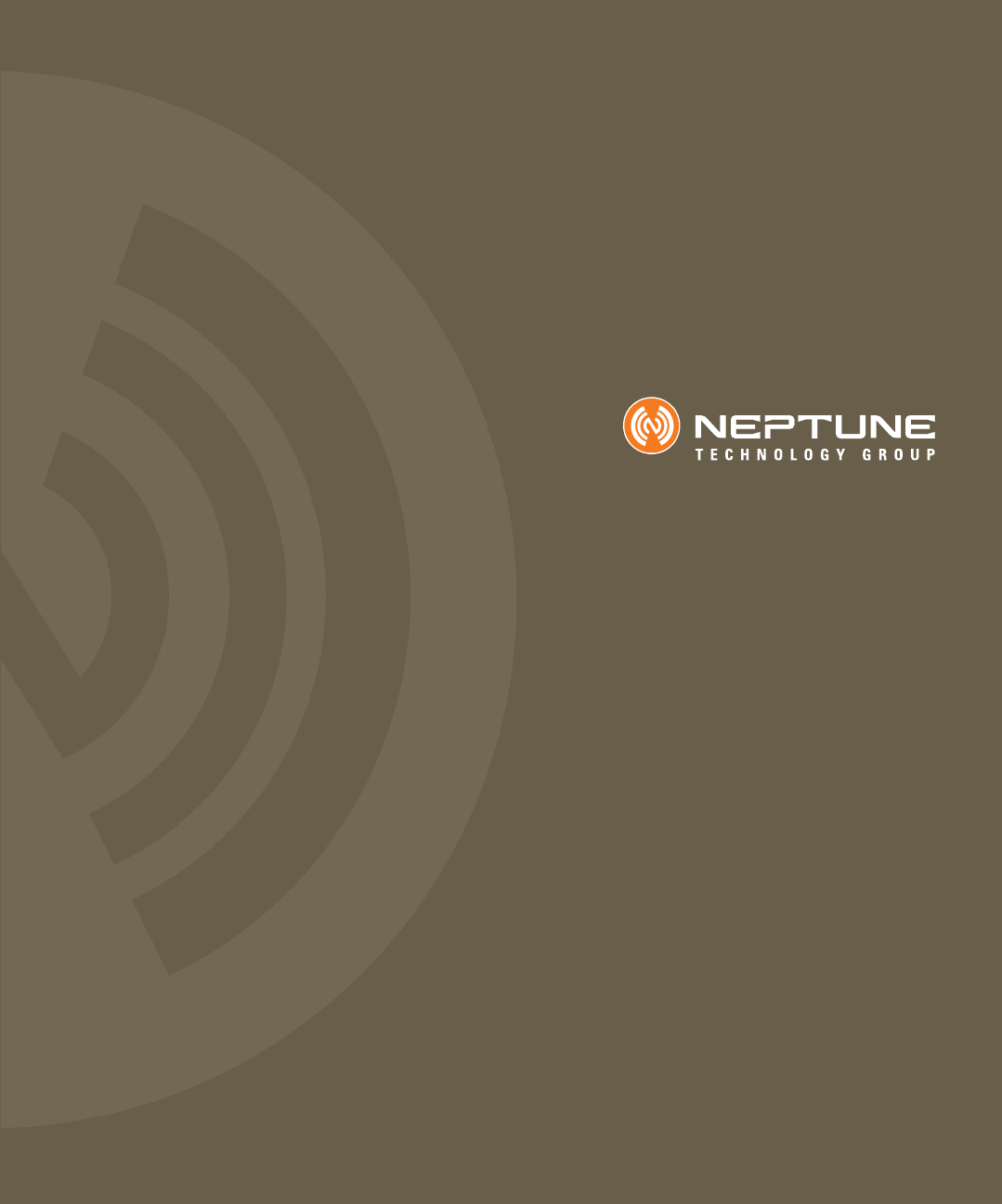
Neptune Handheld System User’s Manual
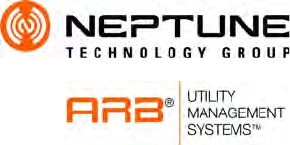
Neptune Handheld System User’s Manual

Proprietary Rights Notice
This manual is an unpublished work and contains the trade secrets and confidential
information of Neptune Technology Group Inc., which are not to be divulged to third
parties and may not be reproduced or transmitted in whole or part, in any form or by
any means, electronic or mechanical for any purpose, without the express written
permission of Neptune Technology Group Inc. All rights to designs or inventions
disclosed herein, including the right to manufacture, are reserved to
Neptune Technology Group Inc.
The information contained in this document is subject to change without notice.
Neptune reserves the right to change the product specifications at any time without
incurring any obligations.
Trademarks Used in This Manual
R900 is a registered trademark of Neptune Technology Group Inc. N_SIGHT R900
is a trademark of Neptune Technology Group Inc. R900 Belt Clip Receiver is a
trademark of Neptune Technology Group Inc. MRX920 is a trademark of
Neptune Technology Group Inc. ARB is a registered trademark of
Neptune Technology Group Inc.
Trimble Nomad s a registered trademark of Trimble Navigation Limited.
CE Net Windows, Windows 6.1, and Windows Mobile Device Center are registered
trademarks of Microsoft Corporation.
Other brands or product names are the trademarks or registered trademarks of their
respective holders.
FCC Conformity
CE5320B Handheld Computer
“NOTE: This equipment has been tested and found to comply with the limits for a Class
A digital device, pursuant to part 15 of the FCC rules. These limits are designed to
provide reasonable protection against harmful interference when the equipment is
operated in a commercial environment. This equipment generates, uses, and can
radiate radio frequency energy and, if not installed and used in accordance with the
instruction manual, may cause harmful interference to radio communications.
Operation of this equipment in a residential area is likely to cause harmful interference
in which case the user will be required to correct the interference at his own expense.”
Warning: Changes or modifications to this device not expressly
approved by Neptune Technology Group Inc. could void the user's
authority to operate the equipment.
Trimble Nomad Handheld Computer
U.S.A.
This device complies with Part 15 of the FCC Rules. It is tested to comply with FCC
standards for home or office use. Operation is subject to the following two conditions:
(1) this device may not cause harmful interference, and (2) this device must accept any
interference received, including interference that may cause undesired operation.
This equipment has been tested and found to comply with the limits for a Class B digital
device, pursuant to Part 15 of the FCC Rules. These limits are designed to provide
reasonable protection against harmful interference in a residential installation. This
equipment generates, uses and can radiate radio frequency energy and, if not installed
and used in accordance with the instructions, may cause harmful interference to radio
communications. However, there is no guarantee that interference will not occur in a
particular installation. If this equipment does cause harmful interference to radio or
television reception, which can be determined by turning the equipment off and on, the
user is encouraged to try to correct the interference by one or more of the following
measures:
• Reorient or relocate the receiving antenna.
• Increase the separation between the equipment and receiver.
• Connect the equipment to an outlet on a circuit different from that to which the
receiver is connected.
• Consult the dealer or an experienced radio/TV technician for help.
R900 Belt Clip Receiver
NOTE: This equipment has been tested and found to comply with the limits for a Class
B digital device, pursuant to part 15 of the FCC Rules. These limits are designed to
provide reasonable protection against harmful interference in a residential installation.
This equipment generates, uses and can radiate radio frequency energy and, if not
installed and used in accordance with the instructions, may cause harmful interference
to radio communications. However, there is no guarantee that interference will not
occur in a particular installation. If this equipment does cause harmful interference to
radio or television reception, which can be determined by turning the equipment off and
on, the user is encouraged to try to correct the interference by one or more of the
following measures
• Reorient or relocate the receiving antenna
• Increase the separation between the equipment and receiver.
• Connect the equipment into an outlet on a circuit different from that to which the
receiver is connected.
• Consult the dealer or an experienced radio/TV technician for help.

Neptune HR2650i
"NOTE: This equipment has been tested and found to comply with the limits for a Class
A digital device, pursuant to Part 15 of the FCC Rules. These limits are designed to
provide reasonable protection against harmful interference in a residential installation.
This equipment generates, uses and can radiate radio frequency energy and, if not
installed and used in accordance with the instructions, may cause harmful interference
to radio communications. However, there is no guarantee that interference will not
occur in a particular installation. If this equipment does cause harmful interference to
radio or television reception, which can be determined by turning the equipment off and
on, the user is encouraged to try to correct the interference by one or more of the
following measures:
• Increase the separation between the equipment and receiver.
• Connect the equipment into an outlet on a circuit different from that to which the
receiver is connected.
• Consult the dealer or an experienced radio/TV technician for help.”
RF Exposure (Intentional Radiators Only)
This device has been tested and complies with FCC SAR (Specific Absorption Rate)
RF exposure compliance requirements for body-worn operation.
This equipment complies with FCC radiation exposure limits set forth for an
uncontrolled environment. This equipment is in direct contact with the body of the user
under normal operating conditions. This transmitter must not be co-located or operating
in conjunction with any other antenna or transmitter.
Industry Canada
CE5320B Handheld Computer
This Class A digital apparatus meets all requirements of the Canadian Interference
Causing Equipment Regulations. Operation is subject to the following two conditions:
(1) this device may not cause harmful interference, and (2) this device must accept any
interference received, including interference that may cause undesired operation.
Cet appareillage numérique de la classe A répond à toutes les exigences de
l'interférence canadienne causant des règlements d'équipement. L'opération est
sujette aux deux conditions suivantes: (1) ce dispositif peut ne pas causer l'interférence
nocive, et (2) ce dispositif doit accepter n'importe quelle interférence reçue, y compris
l'interférence qui peut causer l'opération peu désirée.
Warning: Changes or modifications to this device not expressly
approved by Neptune Technology Group Inc., could void the user's
authority to operate the equipment.
Trimble Nomad
This digital apparatus does not exceed the Class B limits for radio noise emissions from
digital apparatus as set out in the radio interference regulations of the Canadian
Department of Communications.
Le présent appareil numérique n'émet pas de bruits radioélectriques dépassant les
limites applicables aux appareils numériques de Classe B prescrites dans le règlement
sur le brouillage radioélectrique édicté par le Ministère des Communications du
Canada.
R900 Belt Clip Receiver
This Class B digital apparatus meets all requirements of the Canadian Interference
Causing Equipment Regulations. Operation is subject to the following two conditions:
(1) this device may not cause harmful interference, and (2) this device must accept
any interference received, including interference that may cause undesired operation.
Cet appareillage numérique de la classe B répond à toutes les exigences de
l'interférence canadienne causant des règlements d'équipement. L'opération est
sujette aux deux conditions suivantes: (1) ce dispositif peut ne pas causer l'interférence
nocive, et (2) ce dispositif doit accepter n'importe quelle interférence reçue, y compris
l'interférence qui peut causer l'opération peu désirée.
Under Industry Canada regulations, this radio transmitter may only operate using an
antenna of a type and maximum (or lesser) gain approved for the transmitter by
Industry Canada. To reduce potential radio interference to other users, the antenna
type and its gain should be so chosen that the equivalent isotropically radiated power
(e.i.r.p.) is not more than that necessary for successful communication.
Conformément à la réglementation d'Industrie Canada, cet émetteur radio ne peut
fonctionner à l'aide d'une antenne d'un type et maximum (ou moins) Gain approuvé
pour l'émetteur par Industrie Canada. Pour réduire le risque d'interférence avec
d'autres utilisateurs, le type d'antenne et son gain doivent être choisis afin que la
puissance isotrope rayonnée équivalente n'est pas plus que ce qui est nécessaire pour
une communication réussie.
Neptune HR2650i
This Class A digital apparatus meets all requirements of the Canadian Interference
Causing Equipment Regulations. Operation is subject to the following two conditions:
(1) this device may not cause harmful interference, and (2) this device must accept any
interference received, including interference that may cause undesired operation.
Cet appareillage numérique de la classe A répond à toutes les exigences de
l'interférence canadienne causant des règlements d'équipement. L'opération est
sujette aux deux conditions suivantes: (1) ce dispositif peut ne pas causer l'interférence
nocive, et (2) ce dispositif doit accepter n'importe quelle interférence reçue, y compris
l'interférence qui peut causer l'opération peu désirée.
CE Conformity
The CE5320B meets the 89/336/EEC directive intent for Electromagnetic Compatibility
Compliance when used with appropriate accessories. These are Class B products. In a
domestic environment, these products may cause radio interference, in which case, the
user may be required to take adequate measures.
The compliance was demonstrated to the following specifications as listed in the official
Journal of the European Communities:
Copyright © 2005-2013
Neptune Technology Group Inc.
All Rights Reserved.
EN 50081-2, Emissions
EN 55022: Radiated, Class B
EN 55022: Conducted, Class B
EN 50082-2, Immunity
EN 61000-4-2: Electrostatic discharge
E N 6 10 00 -4 -3 : RF r ad ia te d
EN 61000-4-4: Fast transients
EN 61000-4-6: RF conducted
Neptune Handheld System
User’s Manual
Literature No. UM Handheld System
12.13
Part No. 11769-016
Neptune Technology Group Inc.
1600 Alabama Highway 229
Tallassee, AL 36078
Tel: (334) 283-6555
Fax: (334) 283-7293

Contents
N_SIGHT R900 User’s Manual for the Neptune Handheld System vii
1Introduction
Conventions Used in this Manual . . . . . . . . . . . . . . . . . . . . . . . . . . . . . . . . . . . . . . . . . . . . . .1-1
Screen Shots Used in this Manual . . . . . . . . . . . . . . . . . . . . . . . . . . . . . . . . . . . . . . . . . . . . .1-2
Differences in Screen Appearances. . . . . . . . . . . . . . . . . . . . . . . . . . . . . . . . . . . . . . . . . 1-2
Product Support within the United States . . . . . . . . . . . . . . . . . . . . . . . . . . . . . . . . . . . . . . . .1-3
Finding the Software Version Number . . . . . . . . . . . . . . . . . . . . . . . . . . . . . . . . . . . . . .1-3
When Not Logged In . . . . . . . . . . . . . . . . . . . . . . . . . . . . . . . . . . . . . . . . . . . . . . . . .1-4
When Logged On to N_SIGHT R900 . . . . . . . . . . . . . . . . . . . . . . . . . . . . . . . . . . . .1-4
Contacting Customer Support . . . . . . . . . . . . . . . . . . . . . . . . . . . . . . . . . . . . . . . . . . . . . . . . . 1-5
Finding Information within the Manual. . . . . . . . . . . . . . . . . . . . . . . . . . . . . . . . . . . . . . . . . . . 1-7
Where to Start . . . . . . . . . . . . . . . . . . . . . . . . . . . . . . . . . . . . . . . . . . . . . . . . . . . . . . . . . . . . . 1-7
Meter Readers . . . . . . . . . . . . . . . . . . . . . . . . . . . . . . . . . . . . . . . . . . . . . . . . . . . . . . . . .1-8
Operators . . . . . . . . . . . . . . . . . . . . . . . . . . . . . . . . . . . . . . . . . . . . . . . . . . . . . . . . . . . . . 1-9
2Overview of the Neptune Handheld System
Typical Meter Reading Process. . . . . . . . . . . . . . . . . . . . . . . . . . . . . . . . . . . . . . . . . . . . . . . .2-1
Daily Use of the Neptune Handheld System . . . . . . . . . . . . . . . . . . . . . . . . . . . . . . . . . . . . . .2-2
Meter Readers . . . . . . . . . . . . . . . . . . . . . . . . . . . . . . . . . . . . . . . . . . . . . . . . . . . . . . . . .2-3
Operators . . . . . . . . . . . . . . . . . . . . . . . . . . . . . . . . . . . . . . . . . . . . . . . . . . . . . . . . . . . . . 2-3
Basic Features of the CE5320. . . . . . . . . . . . . . . . . . . . . . . . . . . . . . . . . . . . . . . . . . . . . . . . .2-4
Operating Environment . . . . . . . . . . . . . . . . . . . . . . . . . . . . . . . . . . . . . . . . . . . . . . . . . .2-7
Rain and Water Resistance . . . . . . . . . . . . . . . . . . . . . . . . . . . . . . . . . . . . . . . . . . . . . . .2-7
Electromagnetic Resistance. . . . . . . . . . . . . . . . . . . . . . . . . . . . . . . . . . . . . . . . . . . . . . .2-7
Shock Resistance. . . . . . . . . . . . . . . . . . . . . . . . . . . . . . . . . . . . . . . . . . . . . . . . . . . . . . .2-8

viii N_SIGHT R900 User’s Manual for the Neptune Handheld System
Contents
Use of the CE5320. . . . . . . . . . . . . . . . . . . . . . . . . . . . . . . . . . . . . . . . . . . . . . . . . . . . . . . . . 2-8
Basic Features of the Nomad. . . . . . . . . . . . . . . . . . . . . . . . . . . . . . . . . . . . . . . . . . . . . . . . . 2-9
Operating Environment . . . . . . . . . . . . . . . . . . . . . . . . . . . . . . . . . . . . . . . . . . . . . . . . . 2-12
Rain and Water Resistance . . . . . . . . . . . . . . . . . . . . . . . . . . . . . . . . . . . . . . . . . . . . . 2-12
Electromagnetic Resistance . . . . . . . . . . . . . . . . . . . . . . . . . . . . . . . . . . . . . . . . . . . . . 2-13
Shock Resistance . . . . . . . . . . . . . . . . . . . . . . . . . . . . . . . . . . . . . . . . . . . . . . . . . . . . . 2-13
Use of the Nomad . . . . . . . . . . . . . . . . . . . . . . . . . . . . . . . . . . . . . . . . . . . . . . . . . . . . . . . . 2-13
The Display on the Handhelds . . . . . . . . . . . . . . . . . . . . . . . . . . . . . . . . . . . . . . . . . . . . . . 2-13
The Handheld Display. . . . . . . . . . . . . . . . . . . . . . . . . . . . . . . . . . . . . . . . . . . . . . . . . . 2-14
Menu Screens . . . . . . . . . . . . . . . . . . . . . . . . . . . . . . . . . . . . . . . . . . . . . . . . . . . . 2-15
Data-Entry Screens . . . . . . . . . . . . . . . . . . . . . . . . . . . . . . . . . . . . . . . . . . . . . . . . 2-16
Message Screens . . . . . . . . . . . . . . . . . . . . . . . . . . . . . . . . . . . . . . . . . . . . . . . . . 2-17
Navigating Through Screens. . . . . . . . . . . . . . . . . . . . . . . . . . . . . . . . . . . . . . . . . . . . . 2-17
Icon Bar . . . . . . . . . . . . . . . . . . . . . . . . . . . . . . . . . . . . . . . . . . . . . . . . . . . . . . . . . 2-19
3Using the CE5320 Handheld
Determining the System Configuration. . . . . . . . . . . . . . . . . . . . . . . . . . . . . . . . . . . . . . . . . . 3-1
Local and Remote Communications . . . . . . . . . . . . . . . . . . . . . . . . . . . . . . . . . . . . . . . . 3-2
Unpacking and Inspecting Equipment . . . . . . . . . . . . . . . . . . . . . . . . . . . . . . . . . . . . . . . . . . 3-2
Setting Up the CE5320. . . . . . . . . . . . . . . . . . . . . . . . . . . . . . . . . . . . . . . . . . . . . . . . . . . . . . 3-3
One CE5320 and a Communication Cradle . . . . . . . . . . . . . . . . . . . . . . . . . . . . . . . . . . 3-3
The Router. . . . . . . . . . . . . . . . . . . . . . . . . . . . . . . . . . . . . . . . . . . . . . . . . . . . . . . . 3-4
Connecting to the Host Computer and Power Supply. . . . . . . . . . . . . . . . . . . . . . . . . . . 3-5
Connecting the Router, CE Handheld Cradle, and Power Supplies . . . . . . . . . . . . 3-5
Configuring the CE5320 Handheld . . . . . . . . . . . . . . . . . . . . . . . . . . . . . . . . . . . . . . . . . 3-9
On the Host Computer. . . . . . . . . . . . . . . . . . . . . . . . . . . . . . . . . . . . . . . . . . . . . . . 3-9
On the CE5320 Handheld . . . . . . . . . . . . . . . . . . . . . . . . . . . . . . . . . . . . . . . . . . . . 3-9

Contents
N_SIGHT R900 User’s Manual for the Neptune Handheld System ix
The Display and Keyboard . . . . . . . . . . . . . . . . . . . . . . . . . . . . . . . . . . . . . . . . . . . . . . . . . . 3-11
Learning the Keyboard . . . . . . . . . . . . . . . . . . . . . . . . . . . . . . . . . . . . . . . . . . . . . .3-11
Function Keys . . . . . . . . . . . . . . . . . . . . . . . . . . . . . . . . . . . . . . . . . . . . . . . . . . . .3-13
Number Keys . . . . . . . . . . . . . . . . . . . . . . . . . . . . . . . . . . . . . . . . . . . . . . . . . . . . . 3-14
Direction Keys. . . . . . . . . . . . . . . . . . . . . . . . . . . . . . . . . . . . . . . . . . . . . . . . . . . . .3-14
Letter/Character Keys . . . . . . . . . . . . . . . . . . . . . . . . . . . . . . . . . . . . . . . . . . . . . . .3-15
Information Keys . . . . . . . . . . . . . . . . . . . . . . . . . . . . . . . . . . . . . . . . . . . . . . . . . .3-16
Quick Keys . . . . . . . . . . . . . . . . . . . . . . . . . . . . . . . . . . . . . . . . . . . . . . . . . . . . . . .3-19
Adjusting System Settings. . . . . . . . . . . . . . . . . . . . . . . . . . . . . . . . . . . . . . . . . . . . . . . . . . . 3-20
Calibrating the Stylus . . . . . . . . . . . . . . . . . . . . . . . . . . . . . . . . . . . . . . . . . . . . . . . . . . .3-20
Changing the Handheld Properties . . . . . . . . . . . . . . . . . . . . . . . . . . . . . . . . . . . . . . . . 3-22
Working with the Properties Screen . . . . . . . . . . . . . . . . . . . . . . . . . . . . . . . . . . . . 3-22
Configuring RF/Serial Properties . . . . . . . . . . . . . . . . . . . . . . . . . . . . . . . . . . . . . . . . . . 3-24
Logging In and Out of the N_SIGHT R900 . . . . . . . . . . . . . . . . . . . . . . . . . . . . . . . . . . . . . . 3-26
Logging Into N_SIGHT R900 on the CE5320 . . . . . . . . . . . . . . . . . . . . . . . . . . . . . . . . 3-26
Logging Out of N_SIGHT R900 . . . . . . . . . . . . . . . . . . . . . . . . . . . . . . . . . . . . . . . . . . .3-30
4Using the Nomad Handheld
Unpacking the Nomad. . . . . . . . . . . . . . . . . . . . . . . . . . . . . . . . . . . . . . . . . . . . . . . . . . . . . . . 4-1
Setting Up the Nomad . . . . . . . . . . . . . . . . . . . . . . . . . . . . . . . . . . . . . . . . . . . . . . . . . . . . . . . 4-3
One Nomad and a Communication Cradle . . . . . . . . . . . . . . . . . . . . . . . . . . . . . . . . . . .4-3
The Router . . . . . . . . . . . . . . . . . . . . . . . . . . . . . . . . . . . . . . . . . . . . . . . . . . . . . . . .4-4
Connecting to the Host Computer and Power Supply . . . . . . . . . . . . . . . . . . . . . . . . . . .4-4
Connecting the Router, Nomad Handheld Cradle, and Power Supplies. . . . . . . . . .4-5
Configuring the Nomad Handheld . . . . . . . . . . . . . . . . . . . . . . . . . . . . . . . . . . . . . . . . . .4-7
On the Host Computer . . . . . . . . . . . . . . . . . . . . . . . . . . . . . . . . . . . . . . . . . . . . . . .4-7
On the Nomad Handheld . . . . . . . . . . . . . . . . . . . . . . . . . . . . . . . . . . . . . . . . . . . . .4-7

x N_SIGHT R900 User’s Manual for the Neptune Handheld System
Contents
The Display and Keyboard. . . . . . . . . . . . . . . . . . . . . . . . . . . . . . . . . . . . . . . . . . . . . . . . . . . 4-9
Learning the Keyboard. . . . . . . . . . . . . . . . . . . . . . . . . . . . . . . . . . . . . . . . . . . . . . . 4-9
Buttons and Keys . . . . . . . . . . . . . . . . . . . . . . . . . . . . . . . . . . . . . . . . . . . . . . . . . . . . . 4-10
Buttons. . . . . . . . . . . . . . . . . . . . . . . . . . . . . . . . . . . . . . . . . . . . . . . . . . . . . . . . . . 4-11
Direction Buttons. . . . . . . . . . . . . . . . . . . . . . . . . . . . . . . . . . . . . . . . . . . . . . . . . . 4-12
Number Buttons . . . . . . . . . . . . . . . . . . . . . . . . . . . . . . . . . . . . . . . . . . . . . . . . . . 4-12
Nomad Screen Keyboard . . . . . . . . . . . . . . . . . . . . . . . . . . . . . . . . . . . . . . . . . . . . . . . 4-13
Changing the Size of the Keys. . . . . . . . . . . . . . . . . . . . . . . . . . . . . . . . . . . . . . . . 4-13
Large Keys. . . . . . . . . . . . . . . . . . . . . . . . . . . . . . . . . . . . . . . . . . . . . . . . . . . . . . . 4-14
Small Keys. . . . . . . . . . . . . . . . . . . . . . . . . . . . . . . . . . . . . . . . . . . . . . . . . . . . . . . 4-14
Lowercase Keys. . . . . . . . . . . . . . . . . . . . . . . . . . . . . . . . . . . . . . . . . . . . . . . . . . . 4-14
Uppercase Keys. . . . . . . . . . . . . . . . . . . . . . . . . . . . . . . . . . . . . . . . . . . . . . . . . . . 4-14
Numeric and Symbols Keys. . . . . . . . . . . . . . . . . . . . . . . . . . . . . . . . . . . . . . . . . . 4-15
Information Keys . . . . . . . . . . . . . . . . . . . . . . . . . . . . . . . . . . . . . . . . . . . . . . . . . . 4-15
Direction Keys . . . . . . . . . . . . . . . . . . . . . . . . . . . . . . . . . . . . . . . . . . . . . . . . . . . . 4-18
Combination Keys . . . . . . . . . . . . . . . . . . . . . . . . . . . . . . . . . . . . . . . . . . . . . . . . . 4-19
Adjusting System Settings . . . . . . . . . . . . . . . . . . . . . . . . . . . . . . . . . . . . . . . . . . . . . . . . . . 4-22
Calibrating the Stylus . . . . . . . . . . . . . . . . . . . . . . . . . . . . . . . . . . . . . . . . . . . . . . . . . . 4-23
Changing the Handheld Properties. . . . . . . . . . . . . . . . . . . . . . . . . . . . . . . . . . . . . . . . 4-26
Working with the Properties Screen. . . . . . . . . . . . . . . . . . . . . . . . . . . . . . . . . . . . 4-26
Configuring RF/Serial Properties . . . . . . . . . . . . . . . . . . . . . . . . . . . . . . . . . . . . . . . . . 4-28
Turning On and Off the Nomad . . . . . . . . . . . . . . . . . . . . . . . . . . . . . . . . . . . . . . . . . . . . . . 4-30
Turning the Nomad On . . . . . . . . . . . . . . . . . . . . . . . . . . . . . . . . . . . . . . . . . . . . . 4-30
Turning the Nomad Off . . . . . . . . . . . . . . . . . . . . . . . . . . . . . . . . . . . . . . . . . . . . . 4-30
Logging In and Out of the N_SIGHT R900. . . . . . . . . . . . . . . . . . . . . . . . . . . . . . . . . . . . . . 4-31
Logging Into N_SIGHT R900 on the Nomad. . . . . . . . . . . . . . . . . . . . . . . . . . . . . . . . . 4-31
Logging Out of N_SIGHT R900 . . . . . . . . . . . . . . . . . . . . . . . . . . . . . . . . . . . . . . . . . . 4-36

Contents
N_SIGHT R900 User’s Manual for the Neptune Handheld System xi
5Setting Up the R900 Belt Clip Receiver
R900 Belt Clip Receiver . . . . . . . . . . . . . . . . . . . . . . . . . . . . . . . . . . . . . . . . . . . . . . . . . . . . .5-1
R900 Belt Clip Receiver Overview. . . . . . . . . . . . . . . . . . . . . . . . . . . . . . . . . . . . . . . . . .5-1
Nomad Handheld and R900 Belt Clip Receiver . . . . . . . . . . . . . . . . . . . . . . . . . . . . . . . . . . .5-2
Unpacking and Inspecting Equipment. . . . . . . . . . . . . . . . . . . . . . . . . . . . . . . . . . . . . . . . . . . 5-2
R900 Belt Clip Receiver Components . . . . . . . . . . . . . . . . . . . . . . . . . . . . . . . . . . . . . . .5-3
Using the R900 Belt Clip Receiver . . . . . . . . . . . . . . . . . . . . . . . . . . . . . . . . . . . . . . . . . . . . . 5-4
Understanding the R900 Belt Clip Receiver Modes. . . . . . . . . . . . . . . . . . . . . . . . . . . . . 5-4
Accessing the R900 Belt Clip Receiver Status Screen . . . . . . . . . . . . . . . . . . . . . . . . . .5-7
Understanding the R900 Belt Clip Receiver LED Operating Modes . . . . . . . . . . . . . . . .5-8
Understanding the External Battery Charger Status . . . . . . . . . . . . . . . . . . . . . . . . . . .5-10
Pairing the Trimble Nomad to the R900 Belt Clip Receiver through the Bluetooth . . . . 5-10
Pairing the Trimble Nomad . . . . . . . . . . . . . . . . . . . . . . . . . . . . . . . . . . . . . . . . . . . 5-10
Using the R900 Belt Clip Receiver to Read a Route. . . . . . . . . . . . . . . . . . . . . . . . . . . . . . . 5-11
R900 Belt Clip Receiver Status Screen in N_SIGHT R900 . . . . . . . . . . . . . . . . . . . . . . 5-11
RF Performance Modes . . . . . . . . . . . . . . . . . . . . . . . . . . . . . . . . . . . . . . . . . . . . .5-12
Selecting the R900 Belt Clip Receiver Reading Mode . . . . . . . . . . . . . . . . . . . . . . 5-13
Using the R900 Belt Clip Receiver RF Test Mode . . . . . . . . . . . . . . . . . . . . . . . . . . . . .5-13
From the Login Screen . . . . . . . . . . . . . . . . . . . . . . . . . . . . . . . . . . . . . . . . . . . . . .5-13
From the Route Screen. . . . . . . . . . . . . . . . . . . . . . . . . . . . . . . . . . . . . . . . . . . . . .5-14
R900 Belt Clip Receiver SD Card Functionality . . . . . . . . . . . . . . . . . . . . . . . . . . . . . . .5-14
Updating R900 Belt Clip Receiver Firmware. . . . . . . . . . . . . . . . . . . . . . . . . . . . . . . . . . . . .5-15
How the Firmware Update Works . . . . . . . . . . . . . . . . . . . . . . . . . . . . . . . . . . . . . . . . . 5-16

xii N_SIGHT R900 User’s Manual for the Neptune Handheld System
Contents
6Gathering Route Data
The Reading Entry Screen. . . . . . . . . . . . . . . . . . . . . . . . . . . . . . . . . . . . . . . . . . . . . . . . . . . 6-2
Manually Collecting Meter Readings . . . . . . . . . . . . . . . . . . . . . . . . . . . . . . . . . . . . . . . . . . . 6-3
Entering a Reading . . . . . . . . . . . . . . . . . . . . . . . . . . . . . . . . . . . . . . . . . . . . . . . . . . . . . 6-3
Entering a Skip Code . . . . . . . . . . . . . . . . . . . . . . . . . . . . . . . . . . . . . . . . . . . . . . . . . . . 6-5
Entering Comment Codes. . . . . . . . . . . . . . . . . . . . . . . . . . . . . . . . . . . . . . . . . . . . . . . . 6-7
Adding Free-Form Notes. . . . . . . . . . . . . . . . . . . . . . . . . . . . . . . . . . . . . . . . . . . . . . . . . 6-9
Leaving a Reading Blank . . . . . . . . . . . . . . . . . . . . . . . . . . . . . . . . . . . . . . . . . . . . . . . 6-11
Collecting RR Readings . . . . . . . . . . . . . . . . . . . . . . . . . . . . . . . . . . . . . . . . . . . . . . . . . . . . 6-12
Collecting an RF Reading . . . . . . . . . . . . . . . . . . . . . . . . . . . . . . . . . . . . . . . . . . . . . . . 6-13
Working with Accounts. . . . . . . . . . . . . . . . . . . . . . . . . . . . . . . . . . . . . . . . . . . . . . . . . . . . . 6-14
Changing the Route Direction, Forward or Reverse . . . . . . . . . . . . . . . . . . . . . . . . . . . 6-14
Tagging an Account . . . . . . . . . . . . . . . . . . . . . . . . . . . . . . . . . . . . . . . . . . . . . . . . . . . 6-15
Finding Information . . . . . . . . . . . . . . . . . . . . . . . . . . . . . . . . . . . . . . . . . . . . . . . . . . . . 6-17
Validating Readings . . . . . . . . . . . . . . . . . . . . . . . . . . . . . . . . . . . . . . . . . . . . . . . . . . . . . . . 6-20
Hi/Low Fails. . . . . . . . . . . . . . . . . . . . . . . . . . . . . . . . . . . . . . . . . . . . . . . . . . . . . . . . . . 6-20
Removing a Reading . . . . . . . . . . . . . . . . . . . . . . . . . . . . . . . . . . . . . . . . . . . . . . . . . . . . . . 6-22
Clearing a Skip Code . . . . . . . . . . . . . . . . . . . . . . . . . . . . . . . . . . . . . . . . . . . . . . . . . . . . . . 6-24
Clearing a Comment Code, Customer Note, or Trouble Code. . . . . . . . . . . . . . . . . . . . . . . 6-26
Adding a New Meter to a Route. . . . . . . . . . . . . . . . . . . . . . . . . . . . . . . . . . . . . . . . . . . . . . 6-27
Correcting or Changing Meter Information. . . . . . . . . . . . . . . . . . . . . . . . . . . . . . . . . . . . . . 6-29
Finding and Displaying Reading-Entry Screens. . . . . . . . . . . . . . . . . . . . . . . . . . . . . . . . . . 6-31
Moving Through Reading Entry Screens . . . . . . . . . . . . . . . . . . . . . . . . . . . . . . . . . . . 6-32
Reviewing Additional Information for an Account . . . . . . . . . . . . . . . . . . . . . . . . . 6-32
Location or Hazard Codes . . . . . . . . . . . . . . . . . . . . . . . . . . . . . . . . . . . . . . . . . . . 6-32
Statistics for Loaded Routes . . . . . . . . . . . . . . . . . . . . . . . . . . . . . . . . . . . . . . . . . 6-34
Moving Around Routes . . . . . . . . . . . . . . . . . . . . . . . . . . . . . . . . . . . . . . . . . . . . . . . . . 6-35

Contents
N_SIGHT R900 User’s Manual for the Neptune Handheld System xiii
Resequencing Routes . . . . . . . . . . . . . . . . . . . . . . . . . . . . . . . . . . . . . . . . . . . . . . . . . . . . . . 6-37
Resequence an Order . . . . . . . . . . . . . . . . . . . . . . . . . . . . . . . . . . . . . . . . . . . . . . . . . . 6-37
Resequence While Collecting Readings . . . . . . . . . . . . . . . . . . . . . . . . . . . . . . . . . . . . 6-39
Confirming the Resequencing . . . . . . . . . . . . . . . . . . . . . . . . . . . . . . . . . . . . . . . . . . . . 6-39
7Communicating with the Host Computer
Exchanging Information. . . . . . . . . . . . . . . . . . . . . . . . . . . . . . . . . . . . . . . . . . . . . . . . . . . . . .7-1
Exiting the Software . . . . . . . . . . . . . . . . . . . . . . . . . . . . . . . . . . . . . . . . . . . . . . . . . . . . . 7-1
Sending and Receiving . . . . . . . . . . . . . . . . . . . . . . . . . . . . . . . . . . . . . . . . . . . . . . . . . .7-4
8Using the Field Programmer
Connecting the Mouse. . . . . . . . . . . . . . . . . . . . . . . . . . . . . . . . . . . . . . . . . . . . . . . . . . . . . . . 8-1
Connecting the Mouse to the CE5320 . . . . . . . . . . . . . . . . . . . . . . . . . . . . . . . . . . . . . . . 8-2
Connecting the Mouse to the Nomad. . . . . . . . . . . . . . . . . . . . . . . . . . . . . . . . . . . . . . . .8-4
Verifying the Handheld Recognizes the Mouse . . . . . . . . . . . . . . . . . . . . . . . . . . . . . . . .8-6
Starting Field Programmer . . . . . . . . . . . . . . . . . . . . . . . . . . . . . . . . . . . . . . . . . . . . . . . . . . .8-6
Changing Your Password. . . . . . . . . . . . . . . . . . . . . . . . . . . . . . . . . . . . . . . . . . . . . . . . .8-8
Programming the ProRead . . . . . . . . . . . . . . . . . . . . . . . . . . . . . . . . . . . . . . . . . . . . . . . . . . .8-9
Configuring the ProRead . . . . . . . . . . . . . . . . . . . . . . . . . . . . . . . . . . . . . . . . . . . . . . . . .8-9
Querying the ProRead. . . . . . . . . . . . . . . . . . . . . . . . . . . . . . . . . . . . . . . . . . . . . . . . . . . . . . 8-14
Reading the ProRead Register . . . . . . . . . . . . . . . . . . . . . . . . . . . . . . . . . . . . . . . . . . . . . . . 8-15
Viewing Software and Firmware Information . . . . . . . . . . . . . . . . . . . . . . . . . . . . . . . . .8-17
Programming the R900G Endpoint . . . . . . . . . . . . . . . . . . . . . . . . . . . . . . . . . . . . . . . . . . . . 8-18
Configuring Gas . . . . . . . . . . . . . . . . . . . . . . . . . . . . . . . . . . . . . . . . . . . . . . . . . . . . . . .8-18
Collecting the Initial Reading . . . . . . . . . . . . . . . . . . . . . . . . . . . . . . . . . . . . . . . . . . . . .8-19
Querying the R900G Endpoint . . . . . . . . . . . . . . . . . . . . . . . . . . . . . . . . . . . . . . . . . . . . 8-21

xiv N_SIGHT R900 User’s Manual for the Neptune Handheld System
Contents
Using Command Gas. . . . . . . . . . . . . . . . . . . . . . . . . . . . . . . . . . . . . . . . . . . . . . . . . . . . . . 8-23
Reading the R900G Endpoint Register . . . . . . . . . . . . . . . . . . . . . . . . . . . . . . . . . . . . . . . . 8-24
Viewing Software and Firmware Information . . . . . . . . . . . . . . . . . . . . . . . . . . . . . . . . 8-25
Networking Two Registers . . . . . . . . . . . . . . . . . . . . . . . . . . . . . . . . . . . . . . . . . . . . . . . . . . 8-26
Programming Registers . . . . . . . . . . . . . . . . . . . . . . . . . . . . . . . . . . . . . . . . . . . . . . . . 8-26
Programming the Network Primary Register . . . . . . . . . . . . . . . . . . . . . . . . . . . . . 8-26
Programming the Network Secondary Register. . . . . . . . . . . . . . . . . . . . . . . . . . . 8-27
Network Wiring . . . . . . . . . . . . . . . . . . . . . . . . . . . . . . . . . . . . . . . . . . . . . . . . . . . . . . . 8-27
Wiring the Registers. . . . . . . . . . . . . . . . . . . . . . . . . . . . . . . . . . . . . . . . . . . . . . . . 8-28
Managing Formats . . . . . . . . . . . . . . . . . . . . . . . . . . . . . . . . . . . . . . . . . . . . . . . . . . . . . . . . 8-28
Managing Formats for ProRead Registers . . . . . . . . . . . . . . . . . . . . . . . . . . . . . . . . . . 8-28
Selecting ProRead Preferences. . . . . . . . . . . . . . . . . . . . . . . . . . . . . . . . . . . . . . . 8-29
Selecting a ProRead Format . . . . . . . . . . . . . . . . . . . . . . . . . . . . . . . . . . . . . . . . . 8-31
Editing a ProRead Format . . . . . . . . . . . . . . . . . . . . . . . . . . . . . . . . . . . . . . . . . . . 8-32
Using the New ProRead Format . . . . . . . . . . . . . . . . . . . . . . . . . . . . . . . . . . . . . . 8-34
Deleting a Format for ProRead Registers . . . . . . . . . . . . . . . . . . . . . . . . . . . . . . . 8-34
Creating a New ProRead Format. . . . . . . . . . . . . . . . . . . . . . . . . . . . . . . . . . . . . . 8-35
Using the Custom Format Screens . . . . . . . . . . . . . . . . . . . . . . . . . . . . . . . . . . . . 8-37
Saving the Custom ProRead Format. . . . . . . . . . . . . . . . . . . . . . . . . . . . . . . . . . . 8-39
Creating Formats for R900G Endpoints . . . . . . . . . . . . . . . . . . . . . . . . . . . . . . . . . . . . 8-39
Configuring Gas. . . . . . . . . . . . . . . . . . . . . . . . . . . . . . . . . . . . . . . . . . . . . . . . . . . 8-40
Selecting a Gas Format . . . . . . . . . . . . . . . . . . . . . . . . . . . . . . . . . . . . . . . . . . . . . 8-41
Adding or Editing a Gas Format . . . . . . . . . . . . . . . . . . . . . . . . . . . . . . . . . . . . . . . . . . 8-43
Using the Gas Format . . . . . . . . . . . . . . . . . . . . . . . . . . . . . . . . . . . . . . . . . . . . . . 8-48
Deleting a Format for R900G Endpoints . . . . . . . . . . . . . . . . . . . . . . . . . . . . . . . . 8-48

Contents
N_SIGHT R900 User’s Manual for the Neptune Handheld System xv
9Maintaining and Repairing the Neptune Handheld System
Recommended Maintenance. . . . . . . . . . . . . . . . . . . . . . . . . . . . . . . . . . . . . . . . . . . . . . . . . .9-1
Maintaining the CE5320 . . . . . . . . . . . . . . . . . . . . . . . . . . . . . . . . . . . . . . . . . . . . . . . . . . . . . 9-1
Cleaning the CE5320 . . . . . . . . . . . . . . . . . . . . . . . . . . . . . . . . . . . . . . . . . . . . . . . . . . . .9-1
Storing the CE5320 . . . . . . . . . . . . . . . . . . . . . . . . . . . . . . . . . . . . . . . . . . . . . . . . . . . . .9-2
Short-term Storage. . . . . . . . . . . . . . . . . . . . . . . . . . . . . . . . . . . . . . . . . . . . . . . . . . . . . .9-2
Long-term Storage . . . . . . . . . . . . . . . . . . . . . . . . . . . . . . . . . . . . . . . . . . . . . . . . . . . . . .9-2
Checking the Battery Status. . . . . . . . . . . . . . . . . . . . . . . . . . . . . . . . . . . . . . . . . . . . . . . 9-3
Transporting the CE5320 . . . . . . . . . . . . . . . . . . . . . . . . . . . . . . . . . . . . . . . . . . . . . . . . . 9-4
Repairing the CE5320. . . . . . . . . . . . . . . . . . . . . . . . . . . . . . . . . . . . . . . . . . . . . . . . . . . . . . . 9-4
Recharging the Battery. . . . . . . . . . . . . . . . . . . . . . . . . . . . . . . . . . . . . . . . . . . . . . . . . . . 9-5
Calibrating the CE5320 Battery . . . . . . . . . . . . . . . . . . . . . . . . . . . . . . . . . . . . . . . . . . . .9-5
Replacing the Battery. . . . . . . . . . . . . . . . . . . . . . . . . . . . . . . . . . . . . . . . . . . . . . . . . . . .9-9
Removing or Replacing the Handstrap . . . . . . . . . . . . . . . . . . . . . . . . . . . . . . . . . . . . .9-11
Equipment. . . . . . . . . . . . . . . . . . . . . . . . . . . . . . . . . . . . . . . . . . . . . . . . . . . . . . . .9-11
Removing . . . . . . . . . . . . . . . . . . . . . . . . . . . . . . . . . . . . . . . . . . . . . . . . . . . . . . . . 9-11
Replacing . . . . . . . . . . . . . . . . . . . . . . . . . . . . . . . . . . . . . . . . . . . . . . . . . . . . . . . . 9-13
Maintaining the Nomad . . . . . . . . . . . . . . . . . . . . . . . . . . . . . . . . . . . . . . . . . . . . . . . . . . . . .9-14
Battery Life . . . . . . . . . . . . . . . . . . . . . . . . . . . . . . . . . . . . . . . . . . . . . . . . . . . . . . . . . . . 9-14
Tips for Extending the Battery Life . . . . . . . . . . . . . . . . . . . . . . . . . . . . . . . . . . . . .9-14
Charging the Battery . . . . . . . . . . . . . . . . . . . . . . . . . . . . . . . . . . . . . . . . . . . . . . . . . . .9-15
Checking the Battery Status. . . . . . . . . . . . . . . . . . . . . . . . . . . . . . . . . . . . . . . . . . . . . . 9-15
Replacing the Battery. . . . . . . . . . . . . . . . . . . . . . . . . . . . . . . . . . . . . . . . . . . . . . . . . . . 9-16
Calibrating the Nomad Battery . . . . . . . . . . . . . . . . . . . . . . . . . . . . . . . . . . . . . . . . . . . . 9-17
Notification LEDs . . . . . . . . . . . . . . . . . . . . . . . . . . . . . . . . . . . . . . . . . . . . . . . . . . . . . . 9-18
Maintaining the R900 Belt Clip Receiver. . . . . . . . . . . . . . . . . . . . . . . . . . . . . . . . . . . . . . . . 9-19
Recommended Maintenance . . . . . . . . . . . . . . . . . . . . . . . . . . . . . . . . . . . . . . . . . . . . .9-19
Battery Life . . . . . . . . . . . . . . . . . . . . . . . . . . . . . . . . . . . . . . . . . . . . . . . . . . . . . . . . . . . 9-19
Tips for Extending the Battery Life . . . . . . . . . . . . . . . . . . . . . . . . . . . . . . . . . . . . .9-20

xvi N_SIGHT R900 User’s Manual for the Neptune Handheld System
Contents
Charging the Battery. . . . . . . . . . . . . . . . . . . . . . . . . . . . . . . . . . . . . . . . . . . . . . . . . . . 9-20
Using the USB Port . . . . . . . . . . . . . . . . . . . . . . . . . . . . . . . . . . . . . . . . . . . . . . . . 9-20
Charging Considerations . . . . . . . . . . . . . . . . . . . . . . . . . . . . . . . . . . . . . . . . . . . . 9-21
Using the Charger. . . . . . . . . . . . . . . . . . . . . . . . . . . . . . . . . . . . . . . . . . . . . . . . . . . . . 9-22
Replacing the R900 Belt Clip Receiver Battery. . . . . . . . . . . . . . . . . . . . . . . . . . . . . . . 9-23
Removing the Battery . . . . . . . . . . . . . . . . . . . . . . . . . . . . . . . . . . . . . . . . . . . . . . 9-23
Replacing the Battery. . . . . . . . . . . . . . . . . . . . . . . . . . . . . . . . . . . . . . . . . . . . . . . 9-24
LED Status Indication . . . . . . . . . . . . . . . . . . . . . . . . . . . . . . . . . . . . . . . . . . . . . . . . . . 9-25
Checking the Battery Status . . . . . . . . . . . . . . . . . . . . . . . . . . . . . . . . . . . . . . . . . . . . . 9-26
Recommended Spare Parts. . . . . . . . . . . . . . . . . . . . . . . . . . . . . . . . . . . . . . . . . . . . . . . . . 9-26
Ordering Parts. . . . . . . . . . . . . . . . . . . . . . . . . . . . . . . . . . . . . . . . . . . . . . . . . . . . . . . . 9-26
CE5320 Spare Parts . . . . . . . . . . . . . . . . . . . . . . . . . . . . . . . . . . . . . . . . . . . . . . . 9-26
Nomad Spare Parts . . . . . . . . . . . . . . . . . . . . . . . . . . . . . . . . . . . . . . . . . . . . . . . . 9-26
R900 Belt Clip Receiver Spare Parts. . . . . . . . . . . . . . . . . . . . . . . . . . . . . . . . . . . 9-27
Returning your Neptune Handheld System . . . . . . . . . . . . . . . . . . . . . . . . . . . . . . . . . . . . . 9-28
10 Troubleshooting
Troubleshooting the Handheld . . . . . . . . . . . . . . . . . . . . . . . . . . . . . . . . . . . . . . . . . . . . . . . 10-1
Basic Tasks for the CE5320B Handheld. . . . . . . . . . . . . . . . . . . . . . . . . . . . . . . . . . . . 10-2
Basic Tasks for the Nomad Handheld. . . . . . . . . . . . . . . . . . . . . . . . . . . . . . . . . . . . . . 10-4
Reading-Entry Tasks. . . . . . . . . . . . . . . . . . . . . . . . . . . . . . . . . . . . . . . . . . . . . . . . . . . 10-5
Communication Tasks. . . . . . . . . . . . . . . . . . . . . . . . . . . . . . . . . . . . . . . . . . . . . . . . . . 10-6
Starting the N_SIGHT R900 Program. . . . . . . . . . . . . . . . . . . . . . . . . . . . . . . . . . . . . . 10-6
Loading Data Initially. . . . . . . . . . . . . . . . . . . . . . . . . . . . . . . . . . . . . . . . . . . . . . . . . . . 10-6
Missing Route Files . . . . . . . . . . . . . . . . . . . . . . . . . . . . . . . . . . . . . . . . . . . . . . . . 10-7
Resetting the CE5320B . . . . . . . . . . . . . . . . . . . . . . . . . . . . . . . . . . . . . . . . . . . . . . 10-7
Rebooting the CE5320B . . . . . . . . . . . . . . . . . . . . . . . . . . . . . . . . . . . . . . . . . . . . . 10-9
Rebooting When Logged into a Route in N_SIGHT R900. . . . . . . . . . . . . . . . . . . 10-9
Rebooting When Logged off N_SIGHT R900 . . . . . . . . . . . . . . . . . . . . . . . . . . . 10-11

Contents
N_SIGHT R900 User’s Manual for the Neptune Handheld System xvii
A Changing Volume Settings 1
Adjusting Customized Sounds. . . . . . . . . . . . . . . . . . . . . . . . . . . . . . . . . . . . . . . . . . . . . . . . .A-1
Changing the Volume Setting on the CE5320 . . . . . . . . . . . . . . . . . . . . . . . . . . . . . . . . .A-1
Changing the Volume Setting on the Nomad. . . . . . . . . . . . . . . . . . . . . . . . . . . . . . . . . .A-5
B Tokens List for Custom Format Screen 1
C Pressure Configuration Factor Indexes 1
Available Formats . . . . . . . . . . . . . . . . . . . . . . . . . . . . . . . . . . . . . . . . . . . . . . . . . . . . . . . . . .C-1
Glossary
Index

Notes:
xviii N_SIGHT R900 User’s Manual for the Neptune Handheld System
Contents

N_SIGHT R900 User’s Manual for the Neptune Handheld System xix
Figures
Figure Title Page
1.1 Sample Screens on the Neptune Handheld System . . . . . . . . . . . . . . . . . . . . . . . . . 1-3
1.2 Login Screens on the Neptune Handheld System . . . . . . . . . . . . . . . . . . . . . . . . . . . 1-4
1.3 Screen Information . . . . . . . . . . . . . . . . . . . . . . . . . . . . . . . . . . . . . . . . . . . . . . . . . . . . . . . . . 1-5
1.4 Customer Support . . . . . . . . . . . . . . . . . . . . . . . . . . . . . . . . . . . . . . . . . . . . . . . . . . . . . . . . . 1-6
2.1 Typical Meter Reading Process . . . . . . . . . . . . . . . . . . . . . . . . . . . . . . . . . . . . . . . . . . . . . 2-2
2.2 CE5320B Handheld Features . . . . . . . . . . . . . . . . . . . . . . . . . . . . . . . . . . . . . . . . . . . . . . 2-4
2.3 Back of CE5320 Handheld . . . . . . . . . . . . . . . . . . . . . . . . . . . . . . . . . . . . . . . . . . . . . . . . . 2-6
2.4 Nomad Handheld Features . . . . . . . . . . . . . . . . . . . . . . . . . . . . . . . . . . . . . . . . . . . . . . . . . 2-9
2.5 Back of Nomad Handheld . . . . . . . . . . . . . . . . . . . . . . . . . . . . . . . . . . . . . . . . . . . . . . . . . 2-11
2.6 Menu and Data-Entry Screen . . . . . . . . . . . . . . . . . . . . . . . . . . . . . . . . . . . . . . . . . . . . . . 2-14
2.7 Message Screens . . . . . . . . . . . . . . . . . . . . . . . . . . . . . . . . . . . . . . . . . . . . . . . . . . . . . . . . . 2-15
2.8 Meter Position within Route . . . . . . . . . . . . . . . . . . . . . . . . . . . . . . . . . . . . . . . . . . . . . . . 2-16
2.9 Navigating Screens . . . . . . . . . . . . . . . . . . . . . . . . . . . . . . . . . . . . . . . . . . . . . . . . . . . . . . . 2-18
2.10 Search Screen . . . . . . . . . . . . . . . . . . . . . . . . . . . . . . . . . . . . . . . . . . . . . . . . . . . . . . . . . . . . 2-20
2.11 GoTo Screen . . . . . . . . . . . . . . . . . . . . . . . . . . . . . . . . . . . . . . . . . . . . . . . . . . . . . . . . . . . . . 2-21
3.1 Cradle and Charging Kit . . . . . . . . . . . . . . . . . . . . . . . . . . . . . . . . . . . . . . . . . . . . . . . . . . . . 3-3
3.2 Cradle, Router, and Cables Needed . . . . . . . . . . . . . . . . . . . . . . . . . . . . . . . . . . . . . . . . 3-4
3.3 Connecting RJ-45 Ethernet Cable to Router, Port 1 . . . . . . . . . . . . . . . . . . . . . . . . . . 3-6
3.4 Connecting the Power Cable to the Communications Cradle . . . . . . . . . . . . . . . . . 3-6
3.5 Connecting the Ethernet RJ-45 Cable to the Cradle . . . . . . . . . . . . . . . . . . . . . . . . . 3-7
3.6 Network Cable Connection . . . . . . . . . . . . . . . . . . . . . . . . . . . . . . . . . . . . . . . . . . . . . . . . . 3-7
3.7 Connecting Multiple Handheld Cradles to Router . . . . . . . . . . . . . . . . . . . . . . . . . . . . 3-8
3.8 N_SIGHT R900 Main Menu . . . . . . . . . . . . . . . . . . . . . . . . . . . . . . . . . . . . . . . . . . . . . . . 3-10
3.9 N_SIGHT R900 Admin Menu . . . . . . . . . . . . . . . . . . . . . . . . . . . . . . . . . . . . . . . . . . . . . . 3-10
3.10 Learning the Keyboard . . . . . . . . . . . . . . . . . . . . . . . . . . . . . . . . . . . . . . . . . . . . . . . . . . . . 3-12
3.11 N_SIGHT R900 Main Menu . . . . . . . . . . . . . . . . . . . . . . . . . . . . . . . . . . . . . . . . . . . . . . . 3-21
3.12 N_SIGHT R900 Stylus Calibration Screen . . . . . . . . . . . . . . . . . . . . . . . . . . . . . . . . . 3-21
3.13 Stylus at Another Location on Screen . . . . . . . . . . . . . . . . . . . . . . . . . . . . . . . . . . . . . . 3-22
3.14 Handheld Properties Screen . . . . . . . . . . . . . . . . . . . . . . . . . . . . . . . . . . . . . . . . . . . . . . . 3-23
3.15 N_SIGHT R900 F1 Menu . . . . . . . . . . . . . . . . . . . . . . . . . . . . . . . . . . . . . . . . . . . . . . . . . 3-25
3.16 N_SIGHT R900 System Menu . . . . . . . . . . . . . . . . . . . . . . . . . . . . . . . . . . . . . . . . . . . . . 3-25

Figures
xx N_SIGHT R900 User’s Manual for the Neptune Handheld System
Figure Title Page
3.17 RF/Serial Properties Screen . . . . . . . . . . . . . . . . . . . . . . . . . . . . . . . . . . . . . . . . . . . . . . 3-26
3.18 N_SIGHT R900 Message Area . . . . . . . . . . . . . . . . . . . . . . . . . . . . . . . . . . . . . . . . . . . . 3-27
3.19 N_SIGHT R900 Clock Error Screen . . . . . . . . . . . . . . . . . . . . . . . . . . . . . . . . . . . . . . . 3-27
3.20 N_SIGHT R900 Set Date / Time Screen . . . . . . . . . . . . . . . . . . . . . . . . . . . . . . . . . . . 3-28
3.21 N_SIGHT R900 Handheld Login Screen . . . . . . . . . . . . . . . . . . . . . . . . . . . . . . . . . . . 3-28
3.22 N_SIGHT R900 Select Route Screen . . . . . . . . . . . . . . . . . . . . . . . . . . . . . . . . . . . . . . 3-29
3.23 N_SIGHT R900 Initializing Message . . . . . . . . . . . . . . . . . . . . . . . . . . . . . . . . . . . . . . . 3-29
3.24 N_SIGHT R900 Reading Entry Screen . . . . . . . . . . . . . . . . . . . . . . . . . . . . . . . . . . . . 3-30
4.1 Nomad and Cradle Charger . . . . . . . . . . . . . . . . . . . . . . . . . . . . . . . . . . . . . . . . . . . . . . . . 4-3
4.2 Connecting RJ-45 Ethernet Cable to Router, Port 1 . . . . . . . . . . . . . . . . . . . . . . . . . 4-5
4.3 Nomad Communications Cradle Connections . . . . . . . . . . . . . . . . . . . . . . . . . . . . . . . 4-6
4.4 Network Cable Connection . . . . . . . . . . . . . . . . . . . . . . . . . . . . . . . . . . . . . . . . . . . . . . . . . 4-6
4.5 N_SIGHT R900 Main Menu . . . . . . . . . . . . . . . . . . . . . . . . . . . . . . . . . . . . . . . . . . . . . . . . 4-7
4.6 N_SIGHT R900 Admin Menu . . . . . . . . . . . . . . . . . . . . . . . . . . . . . . . . . . . . . . . . . . . . . . 4-8
4.7 Learning the Keyboard . . . . . . . . . . . . . . . . . . . . . . . . . . . . . . . . . . . . . . . . . . . . . . . . . . . . 4-10
4.8 Nomad Large Keyboard . . . . . . . . . . . . . . . . . . . . . . . . . . . . . . . . . . . . . . . . . . . . . . . . . . 4-14
4.9 Nomad Small Keyboard . . . . . . . . . . . . . . . . . . . . . . . . . . . . . . . . . . . . . . . . . . . . . . . . . . . 4-14
4.10 Nomad Lowercase Keyboard . . . . . . . . . . . . . . . . . . . . . . . . . . . . . . . . . . . . . . . . . . . . . 4-14
4.11 Nomad Uppercase Keyboard . . . . . . . . . . . . . . . . . . . . . . . . . . . . . . . . . . . . . . . . . . . . . 4-15
4.12 Nomad Numeric and Symbols Keyboard . . . . . . . . . . . . . . . . . . . . . . . . . . . . . . . . . . . 4-15
4.13 N_SIGHT R900 Main Menu . . . . . . . . . . . . . . . . . . . . . . . . . . . . . . . . . . . . . . . . . . . . . . . 4-23
4.14 N_SIGHT R900 Stylus Calibration Screen . . . . . . . . . . . . . . . . . . . . . . . . . . . . . . . . . 4-24
4.15 Stylus at Another Location on Screen . . . . . . . . . . . . . . . . . . . . . . . . . . . . . . . . . . . . . 4-25
4.16 Handheld Properties Screen . . . . . . . . . . . . . . . . . . . . . . . . . . . . . . . . . . . . . . . . . . . . . . 4-26
4.17 N_SIGHT R900 F1 Menu . . . . . . . . . . . . . . . . . . . . . . . . . . . . . . . . . . . . . . . . . . . . . . . . . 4-28
4.18 N_SIGHT R900 System Menu . . . . . . . . . . . . . . . . . . . . . . . . . . . . . . . . . . . . . . . . . . . . 4-29
4.19 RF/Serial Properties Screen . . . . . . . . . . . . . . . . . . . . . . . . . . . . . . . . . . . . . . . . . . . . . . 4-29
4.20 N_SIGHT R900 Message Area . . . . . . . . . . . . . . . . . . . . . . . . . . . . . . . . . . . . . . . . . . . . 4-32
4.21 N_SIGHT R900 Clock Error Screen . . . . . . . . . . . . . . . . . . . . . . . . . . . . . . . . . . . . . . . 4-33
4.22 N_SIGHT R900 Set Date / Time Screen . . . . . . . . . . . . . . . . . . . . . . . . . . . . . . . . . . . 4-33
4.23 N_SIGHT R900 Handheld Login Screen . . . . . . . . . . . . . . . . . . . . . . . . . . . . . . . . . . . 4-34
4.24 N_SIGHT R900 Select Route Screen . . . . . . . . . . . . . . . . . . . . . . . . . . . . . . . . . . . . . . 4-35

Figures
N_SIGHT R900 User’s Manual for the Neptune Handheld System xxi
Figure Title Page
4.25 N_SIGHT R900 Initializing Message . . . . . . . . . . . . . . . . . . . . . . . . . . . . . . . . . . . . . . . 4-35
4.26 N_SIGHT R900 Reading Entry Screen . . . . . . . . . . . . . . . . . . . . . . . . . . . . . . . . . . . . . 4-36
5.1 Meter Reading Cycle . . . . . . . . . . . . . . . . . . . . . . . . . . . . . . . . . . . . . . . . . . . . . . . . . . . . . . . 5-2
5.2 R900 Belt Clip Receiver Components . . . . . . . . . . . . . . . . . . . . . . . . . . . . . . . . . . . . . . . 5-3
5.3 R900 Belt Clip Receiver Status Screen . . . . . . . . . . . . . . . . . . . . . . . . . . . . . . . . . . . . 5-11
5.4 R900 Belt Clip Receiver RF Mode Screen . . . . . . . . . . . . . . . . . . . . . . . . . . . . . . . . . . 5-13
5.5 R900 BCR RF Mode Screen from Route . . . . . . . . . . . . . . . . . . . . . . . . . . . . . . . . . . . 5-14
5.6 Tab within N_SIGHT R900 Utilities . . . . . . . . . . . . . . . . . . . . . . . . . . . . . . . . . . . . . . . . 5-15
5.7 R900 Belt Clip Receiver Firmware Tab with Update Options . . . . . . . . . . . . . . . . 5-16
6.1 N_SIGHT R900 Reading Entry Screen . . . . . . . . . . . . . . . . . . . . . . . . . . . . . . . . . . . . . . 6-2
6.2 N_SIGHT R900 Reading Entry Field . . . . . . . . . . . . . . . . . . . . . . . . . . . . . . . . . . . . . . . . 6-4
6.3 N_SIGHT R900 Skip Order Screen . . . . . . . . . . . . . . . . . . . . . . . . . . . . . . . . . . . . . . . . . 6-5
6.4 N_SIGHT R900 Skip Order Reason Codes . . . . . . . . . . . . . . . . . . . . . . . . . . . . . . . . . 6-6
6.5 N_SIGHT R900 Skipped Read . . . . . . . . . . . . . . . . . . . . . . . . . . . . . . . . . . . . . . . . . . . . . 6-6
6.6 N_SIGHT R900 Coded Notes Screen . . . . . . . . . . . . . . . . . . . . . . . . . . . . . . . . . . . . . . . 6-7
6.7 Drop-down Selection List of Coded Notes . . . . . . . . . . . . . . . . . . . . . . . . . . . . . . . . . . . 6-8
6.8 N_SIGHT R900 Comment Code . . . . . . . . . . . . . . . . . . . . . . . . . . . . . . . . . . . . . . . . . . . . 6-8
6.9 Viewing Comment Codes . . . . . . . . . . . . . . . . . . . . . . . . . . . . . . . . . . . . . . . . . . . . . . . . . . 6-9
6.10 N_SIGHT R900 Free Form Notes Screen . . . . . . . . . . . . . . . . . . . . . . . . . . . . . . . . . . 6-10
6.11 Leaving a Meter Reading Blank . . . . . . . . . . . . . . . . . . . . . . . . . . . . . . . . . . . . . . . . . . . 6-11
6.12 N_SIGHT R900 Manual Reading Screen . . . . . . . . . . . . . . . . . . . . . . . . . . . . . . . . . . . 6-12
6.13 N_SIGHT R900 RF Reading Screen . . . . . . . . . . . . . . . . . . . . . . . . . . . . . . . . . . . . . . . 6-13
6.14 Left to Right Route Direction Icon . . . . . . . . . . . . . . . . . . . . . . . . . . . . . . . . . . . . . . . . . . 6-14
6.15 Right to Left Route Direction Icon . . . . . . . . . . . . . . . . . . . . . . . . . . . . . . . . . . . . . . . . . . 6-15
6.16 Tag Account Icon . . . . . . . . . . . . . . . . . . . . . . . . . . . . . . . . . . . . . . . . . . . . . . . . . . . . . . . . . 6-16
6.17 Tagged Account . . . . . . . . . . . . . . . . . . . . . . . . . . . . . . . . . . . . . . . . . . . . . . . . . . . . . . . . . . 6-16
6.18 N_SIGHT R900 Find Order Screen . . . . . . . . . . . . . . . . . . . . . . . . . . . . . . . . . . . . . . . . 6-17
6.19 Search Display Fields . . . . . . . . . . . . . . . . . . . . . . . . . . . . . . . . . . . . . . . . . . . . . . . . . . . . . 6-18
6.20 Search Screen Enter Multiple Values . . . . . . . . . . . . . . . . . . . . . . . . . . . . . . . . . . . . . . 6-18
6.21 Search Screen Multiple Values to Match . . . . . . . . . . . . . . . . . . . . . . . . . . . . . . . . . . . 6-19
6.22 Reading Outside High/Low Range . . . . . . . . . . . . . . . . . . . . . . . . . . . . . . . . . . . . . . . . . 6-20
6.23 N_SIGHT R900 Hi / Lo / No / Inact Screen . . . . . . . . . . . . . . . . . . . . . . . . . . . . . . . . . 6-21

Figures
xxii N_SIGHT R900 User’s Manual for the Neptune Handheld System
Figure Title Page
6.24 Reading to be Cleared . . . . . . . . . . . . . . . . . . . . . . . . . . . . . . . . . . . . . . . . . . . . . . . . . . . . 6-22
6.25 N_SIGHT R900 Reset Order Screen . . . . . . . . . . . . . . . . . . . . . . . . . . . . . . . . . . . . . . 6-23
6.26 Reset Reading . . . . . . . . . . . . . . . . . . . . . . . . . . . . . . . . . . . . . . . . . . . . . . . . . . . . . . . . . . . 6-23
6.27 Reading to be Unskipped . . . . . . . . . . . . . . . . . . . . . . . . . . . . . . . . . . . . . . . . . . . . . . . . . 6-24
6.28 N_SIGHT R900 Undo Skipped Order Screen . . . . . . . . . . . . . . . . . . . . . . . . . . . . . . 6-25
6.29 Reading Field after Unskipped . . . . . . . . . . . . . . . . . . . . . . . . . . . . . . . . . . . . . . . . . . . . 6-25
6.30 Screen Showing Code Attached . . . . . . . . . . . . . . . . . . . . . . . . . . . . . . . . . . . . . . . . . . . 6-26
6.31 Screen Where Code Was Entered . . . . . . . . . . . . . . . . . . . . . . . . . . . . . . . . . . . . . . . . . 6-27
6.32 N_SIGHT R900 Meter Process Menu . . . . . . . . . . . . . . . . . . . . . . . . . . . . . . . . . . . . . 6-28
6.33 N_SIGHT R900 New Meter Screen . . . . . . . . . . . . . . . . . . . . . . . . . . . . . . . . . . . . . . . . 6-28
6.34 Meter Information to Change . . . . . . . . . . . . . . . . . . . . . . . . . . . . . . . . . . . . . . . . . . . . . . 6-29
6.35 N_SIGHT R900 Meter Process Menu . . . . . . . . . . . . . . . . . . . . . . . . . . . . . . . . . . . . . 6-30
6.36 N_SIGHT R900 Change Meter Info Screen . . . . . . . . . . . . . . . . . . . . . . . . . . . . . . . . 6-30
6.37 Additional Meter Information to View . . . . . . . . . . . . . . . . . . . . . . . . . . . . . . . . . . . . . . 6-33
6.38 Location and Hazard Codes Screen . . . . . . . . . . . . . . . . . . . . . . . . . . . . . . . . . . . . . . . 6-33
6.39 For Statistics for Loaded Routes . . . . . . . . . . . . . . . . . . . . . . . . . . . . . . . . . . . . . . . . . . 6-34
6.40 Statistics for Loaded Routes Screen . . . . . . . . . . . . . . . . . . . . . . . . . . . . . . . . . . . . . . . 6-35
6.41 N_SIGHT R900 GoTo Screen . . . . . . . . . . . . . . . . . . . . . . . . . . . . . . . . . . . . . . . . . . . . . 6-36
6.42 Account to Resequence . . . . . . . . . . . . . . . . . . . . . . . . . . . . . . . . . . . . . . . . . . . . . . . . . . 6-37
6.43 Resequence Screen . . . . . . . . . . . . . . . . . . . . . . . . . . . . . . . . . . . . . . . . . . . . . . . . . . . . . . 6-38
6.44 Inline Resequencing Screen . . . . . . . . . . . . . . . . . . . . . . . . . . . . . . . . . . . . . . . . . . . . . . 6-39
6.45 Confirm Resequencing Screen . . . . . . . . . . . . . . . . . . . . . . . . . . . . . . . . . . . . . . . . . . . . 6-40
7.1 Confirm Resequencing Screen . . . . . . . . . . . . . . . . . . . . . . . . . . . . . . . . . . . . . . . . . . . . . 7-2
7.2 N_SIGHT R900 Handheld Logout Screen . . . . . . . . . . . . . . . . . . . . . . . . . . . . . . . . . . 7-3
7.3 Hold Routes Screen . . . . . . . . . . . . . . . . . . . . . . . . . . . . . . . . . . . . . . . . . . . . . . . . . . . . . . . 7-3
7.4 N_SIGHT R900 Login Screen . . . . . . . . . . . . . . . . . . . . . . . . . . . . . . . . . . . . . . . . . . . . . . 7-4
7.5 Synchronize Button . . . . . . . . . . . . . . . . . . . . . . . . . . . . . . . . . . . . . . . . . . . . . . . . . . . . . . . . 7-5
8.1 Field Programmer Mouse for the CE5320 . . . . . . . . . . . . . . . . . . . . . . . . . . . . . . . . . . . 8-2
8.2 Connecting Mouse to CE5320 . . . . . . . . . . . . . . . . . . . . . . . . . . . . . . . . . . . . . . . . . . . . . 8-3
8.3 Field Programmer Mouse for the Nomad . . . . . . . . . . . . . . . . . . . . . . . . . . . . . . . . . . . 8-4
8.4 Connecting Mouse to Nomad . . . . . . . . . . . . . . . . . . . . . . . . . . . . . . . . . . . . . . . . . . . . . . 8-5
8.5 Field Programmer Menu . . . . . . . . . . . . . . . . . . . . . . . . . . . . . . . . . . . . . . . . . . . . . . . . . . . 8-7

Figures
N_SIGHT R900 User’s Manual for the Neptune Handheld System xxiii
Figure Title Page
8.6 Field Programmer Password Screen . . . . . . . . . . . . . . . . . . . . . . . . . . . . . . . . . . . . . . . . 8-7
8.7 Change Password Screen . . . . . . . . . . . . . . . . . . . . . . . . . . . . . . . . . . . . . . . . . . . . . . . . . . 8-8
8.8 ProRead Configuration Screen . . . . . . . . . . . . . . . . . . . . . . . . . . . . . . . . . . . . . . . . . . . . 8-10
8.9 Format Name Selection List . . . . . . . . . . . . . . . . . . . . . . . . . . . . . . . . . . . . . . . . . . . . . . . 8-10
8.10 Otr Selection List . . . . . . . . . . . . . . . . . . . . . . . . . . . . . . . . . . . . . . . . . . . . . . . . . . . . . . . . . 8-11
8.11 Program Result -- Pass Screen . . . . . . . . . . . . . . . . . . . . . . . . . . . . . . . . . . . . . . . . . . . . 8-12
8.12 ProRead Program Details Screen . . . . . . . . . . . . . . . . . . . . . . . . . . . . . . . . . . . . . . . . . . 8-13
8.13 ProRead Query Screen . . . . . . . . . . . . . . . . . . . . . . . . . . . . . . . . . . . . . . . . . . . . . . . . . . . 8-14
8.14 ProRead Query Results . . . . . . . . . . . . . . . . . . . . . . . . . . . . . . . . . . . . . . . . . . . . . . . . . . . 8-15
8.15 ProRead Read Screen . . . . . . . . . . . . . . . . . . . . . . . . . . . . . . . . . . . . . . . . . . . . . . . . . . . . 8-16
8.16 ProRead Reading Result Screen . . . . . . . . . . . . . . . . . . . . . . . . . . . . . . . . . . . . . . . . . . 8-16
8.17 ProRead Software and Firmware Information . . . . . . . . . . . . . . . . . . . . . . . . . . . . . . . 8-17
8.18 Gas Meter Configuration Screen . . . . . . . . . . . . . . . . . . . . . . . . . . . . . . . . . . . . . . . . . . . 8-18
8.19 Gas Program Screen . . . . . . . . . . . . . . . . . . . . . . . . . . . . . . . . . . . . . . . . . . . . . . . . . . . . . 8-19
8.20 Format Name Selection List . . . . . . . . . . . . . . . . . . . . . . . . . . . . . . . . . . . . . . . . . . . . . . . 8-19
8.21 Program Result – Sending Data . . . . . . . . . . . . . . . . . . . . . . . . . . . . . . . . . . . . . . . . . . . 8-20
8.22 Program Result – Pass Screen . . . . . . . . . . . . . . . . . . . . . . . . . . . . . . . . . . . . . . . . . . . . 8-20
8.23 Gas Query Screen . . . . . . . . . . . . . . . . . . . . . . . . . . . . . . . . . . . . . . . . . . . . . . . . . . . . . . . . 8-21
8.24 Gas Query Results . . . . . . . . . . . . . . . . . . . . . . . . . . . . . . . . . . . . . . . . . . . . . . . . . . . . . . . . 8-22
8.25 Command Gas Screen . . . . . . . . . . . . . . . . . . . . . . . . . . . . . . . . . . . . . . . . . . . . . . . . . . . . 8-23
8.26 Gas Read Screen . . . . . . . . . . . . . . . . . . . . . . . . . . . . . . . . . . . . . . . . . . . . . . . . . . . . . . . . . 8-24
8.27 Gas Reading Result Screen . . . . . . . . . . . . . . . . . . . . . . . . . . . . . . . . . . . . . . . . . . . . . . . 8-25
8.28 Gas Software and Firmware Information . . . . . . . . . . . . . . . . . . . . . . . . . . . . . . . . . . . 8-26
8.29 Field Programmer Menu . . . . . . . . . . . . . . . . . . . . . . . . . . . . . . . . . . . . . . . . . . . . . . . . . . 8-29
8.30 ProRead Preferences Screen . . . . . . . . . . . . . . . . . . . . . . . . . . . . . . . . . . . . . . . . . . . . . 8-30
8.31 Select Formats Screen . . . . . . . . . . . . . . . . . . . . . . . . . . . . . . . . . . . . . . . . . . . . . . . . . . . . 8-31
8.32 ProRead New Format Screen . . . . . . . . . . . . . . . . . . . . . . . . . . . . . . . . . . . . . . . . . . . . . 8-32
8.33 Default ProRead New Format Screen . . . . . . . . . . . . . . . . . . . . . . . . . . . . . . . . . . . . . . 8-35
8.34 New Button Available . . . . . . . . . . . . . . . . . . . . . . . . . . . . . . . . . . . . . . . . . . . . . . . . . . . . . 8-36
8.35 Custom Format 1 Screen . . . . . . . . . . . . . . . . . . . . . . . . . . . . . . . . . . . . . . . . . . . . . . . . . . 8-37
8.36 Custom Format 2 Screen . . . . . . . . . . . . . . . . . . . . . . . . . . . . . . . . . . . . . . . . . . . . . . . . . . 8-38
8.37 Configure Gas Password Screen . . . . . . . . . . . . . . . . . . . . . . . . . . . . . . . . . . . . . . . . . . 8-40

Figures
xxiv N_SIGHT R900 User’s Manual for the Neptune Handheld System
Figure Title Page
8.38 Gas New Format Screen . . . . . . . . . . . . . . . . . . . . . . . . . . . . . . . . . . . . . . . . . . . . . . . . . . 8-41
8.39 Gas New Format Selection List . . . . . . . . . . . . . . . . . . . . . . . . . . . . . . . . . . . . . . . . . . . 8-43
8.40 Gas Values Shown on New Format Screen . . . . . . . . . . . . . . . . . . . . . . . . . . . . . . . . 8-44
8.41 Gas New Format Screen – Blank . . . . . . . . . . . . . . . . . . . . . . . . . . . . . . . . . . . . . . . . . . 8-47
9.1 Battery Status Indicator on CE5320 . . . . . . . . . . . . . . . . . . . . . . . . . . . . . . . . . . . . . . . . 9-3
9.2 Handheld Battery Information . . . . . . . . . . . . . . . . . . . . . . . . . . . . . . . . . . . . . . . . . . . . . . 9-6
9.3 N_SIGHT R900 Main Menu . . . . . . . . . . . . . . . . . . . . . . . . . . . . . . . . . . . . . . . . . . . . . . . . 9-7
9.4 N_SIGHT R900 Admin Menu . . . . . . . . . . . . . . . . . . . . . . . . . . . . . . . . . . . . . . . . . . . . . . 9-7
9.5 N_SIGHT R900 Calibrate Battery Screen . . . . . . . . . . . . . . . . . . . . . . . . . . . . . . . . . . . 9-8
9.6 Remove the Captive Screws . . . . . . . . . . . . . . . . . . . . . . . . . . . . . . . . . . . . . . . . . . . . . . . 9-9
9.7 Inserting the Battery . . . . . . . . . . . . . . . . . . . . . . . . . . . . . . . . . . . . . . . . . . . . . . . . . . . . . . 9-10
9.8 Removing Screw From Back Panel . . . . . . . . . . . . . . . . . . . . . . . . . . . . . . . . . . . . . . . . 9-11
9.9 Removing the Captive Screws . . . . . . . . . . . . . . . . . . . . . . . . . . . . . . . . . . . . . . . . . . . . 9-12
9.10 Opening the Velcro Closure . . . . . . . . . . . . . . . . . . . . . . . . . . . . . . . . . . . . . . . . . . . . . . . 9-13
9.11 Battery Status Indicator on Nomad . . . . . . . . . . . . . . . . . . . . . . . . . . . . . . . . . . . . . . . . 9-15
9.12 Changing the Nomad Battery . . . . . . . . . . . . . . . . . . . . . . . . . . . . . . . . . . . . . . . . . . . . . 9-16
9.13 External Battery Charger . . . . . . . . . . . . . . . . . . . . . . . . . . . . . . . . . . . . . . . . . . . . . . . . . . 9-22
9.14 R900 Belt Clip Receiver Side View . . . . . . . . . . . . . . . . . . . . . . . . . . . . . . . . . . . . . . . . 9-23
9.15 Latch Direction to Open . . . . . . . . . . . . . . . . . . . . . . . . . . . . . . . . . . . . . . . . . . . . . . . . . . . 9-23
9.16 Battery Inside Compartment . . . . . . . . . . . . . . . . . . . . . . . . . . . . . . . . . . . . . . . . . . . . . . 9-24
9.17 R900 Belt Clip Receiver Battery Inside Compartment . . . . . . . . . . . . . . . . . . . . . . 9-25
10.1 N_SIGHT R900 Login Screen . . . . . . . . . . . . . . . . . . . . . . . . . . . . . . . . . . . . . . . . . . . . . 10-7
10.2 N_SIGHT R900 Main Menu . . . . . . . . . . . . . . . . . . . . . . . . . . . . . . . . . . . . . . . . . . . . . . . 10-8
10.3 N_SIGHT R900 Admin Menu . . . . . . . . . . . . . . . . . . . . . . . . . . . . . . . . . . . . . . . . . . . . . 10-8
10.4 Reset Warning Message . . . . . . . . . . . . . . . . . . . . . . . . . . . . . . . . . . . . . . . . . . . . . . . . . . 10-9
10.5 N_SIGHT R900 F1 Menu . . . . . . . . . . . . . . . . . . . . . . . . . . . . . . . . . . . . . . . . . . . . . . . . 10-10
10.6 N_SIGHT R900 Handheld Menu . . . . . . . . . . . . . . . . . . . . . . . . . . . . . . . . . . . . . . . . . 10-10
10.7 Reboot Handheld Screen . . . . . . . . . . . . . . . . . . . . . . . . . . . . . . . . . . . . . . . . . . . . . . . . 10-11
A.1 N_SIGHT R900 Main Menu . . . . . . . . . . . . . . . . . . . . . . . . . . . . . . . . . . . . . . . . . . . . . . . . A-1
A.2 N_SIGHT R900 Admin Menu . . . . . . . . . . . . . . . . . . . . . . . . . . . . . . . . . . . . . . . . . . . . . . A-2
A.3 CE.Net Windows Explorer Screen . . . . . . . . . . . . . . . . . . . . . . . . . . . . . . . . . . . . . . . . . . A-2
A.4 Windows CE Main Screen . . . . . . . . . . . . . . . . . . . . . . . . . . . . . . . . . . . . . . . . . . . . . . . . . A-3

Figures
N_SIGHT R900 User’s Manual for the Neptune Handheld System xxv
Figure Title Page
A.5 Selecting Control Panel . . . . . . . . . . . . . . . . . . . . . . . . . . . . . . . . . . . . . . . . . . . . . . . . . . . . A-3
A.6 Windows Control Panel Menu . . . . . . . . . . . . . . . . . . . . . . . . . . . . . . . . . . . . . . . . . . . . . . A-3
A.7 Volume & Sounds Properties Screen . . . . . . . . . . . . . . . . . . . . . . . . . . . . . . . . . . . . . . . A-4
A.8 Nomad Volume Control . . . . . . . . . . . . . . . . . . . . . . . . . . . . . . . . . . . . . . . . . . . . . . . . . . . . A-6
A.9 Nomad Scrollbar and Radio Buttons . . . . . . . . . . . . . . . . . . . . . . . . . . . . . . . . . . . . . . . . A-6

xxvi N_SIGHT R900 User’s Manual for the Neptune Handheld System
Notes:
Figures

N_SIGHT R900 User’s Manual for the Neptune Handheld System xxvii
Tables
Table Title Page
2.1 N_SIGHT R900 Display Icons . . . . . . . . . . . . . . . . . . . . . . . . . . . . . . . . . . 2-19
4.1 Nomad Functionality . . . . . . . . . . . . . . . . . . . . . . . . . . . . . . . . . . . . . . . . . . 4-20
5.1 R900 Belt Clip Receiver Power . . . . . . . . . . . . . . . . . . . . . . . . . . . . . . . . . . 5-4
5.2 R900 Belt Clip Receiver Modes . . . . . . . . . . . . . . . . . . . . . . . . . . . . . . . . . . 5-5
5.3 R900 Belt Clip Receiver Software Functions . . . . . . . . . . . . . . . . . . . . . . . . 5-7
5.4 R900 Belt Clip Receiver LED Operating Modes . . . . . . . . . . . . . . . . . . . . . . 5-8
5.5 External Battery Charger LED . . . . . . . . . . . . . . . . . . . . . . . . . . . . . . . . . . 5-10
7.6 Meter Input Drive Rotation . . . . . . . . . . . . . . . . . . . . . . . . . . . . . . . . . . . . . 8-45
9.1 Calibration Error Messages . . . . . . . . . . . . . . . . . . . . . . . . . . . . . . . . . . . . 9-18
9.2 Calibration Error Messages . . . . . . . . . . . . . . . . . . . . . . . . . . . . . . . . . . . . 9-18
8.3 Charging Considerations . . . . . . . . . . . . . . . . . . . . . . . . . . . . . . . . . . . . . . 9-21
9.4 LED Status Indicators . . . . . . . . . . . . . . . . . . . . . . . . . . . . . . . . . . . . . . . . . 9-25
8.5 CE5320 Part Numbers . . . . . . . . . . . . . . . . . . . . . . . . . . . . . . . . . . . . . . . . 9-26
9.6 Nomad Part Numbers . . . . . . . . . . . . . . . . . . . . . . . . . . . . . . . . . . . . . . . . . 9-27
8.7 R900 Belt Clip Receiver Part Numbers . . . . . . . . . . . . . . . . . . . . . . . . . . . 9-27
B.1 Custom Format Tokens . . . . . . . . . . . . . . . . . . . . . . . . . . . . . . . . . . . . . . . . B-1
C.1 Pressure Configuration Factor Index Table . . . . . . . . . . . . . . . . . . . . . . . . C-1

xxviii N_SIGHT R900 User’s Manual for the Neptune Handheld System
Notes:
Tables
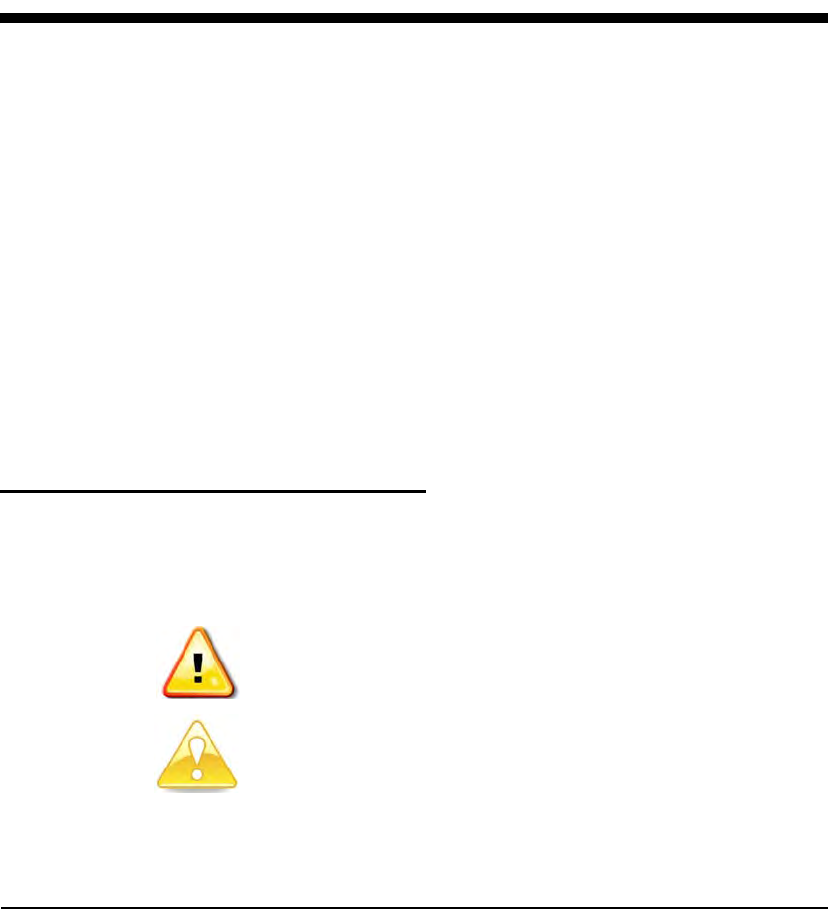
N_SIGHT R900 User’s Manual for the Neptune Handheld System 1-1
1 Introduction
The Neptune Handheld System User’s Manual describes how to use the
following components of the Neptune handheld system to collect route
data. It also explains how to exchange route and account data with the
host computer for the N_SIGHT™ R900® host software. Descriptions
for the following devices and procedures for using them are included in
this manual.
• CE5320 Handheld (CE5320)
• Trimble® Nomad® (Nomad)
• Neptune Field Programmer
• R900® Belt Clip Receiver (BCR)
This manual also describes how to maintain these devices, also referred
to as the Neptune handheld system.
Conventions Used in this Manual
This manual uses the following icons and typographic conventions to
identify special information.
The Warning icon identifies actions that can injure the user or
permanently damage the product.
The Caution icon identifies important information that is critical to
successfully operating N_SIGHT R900.
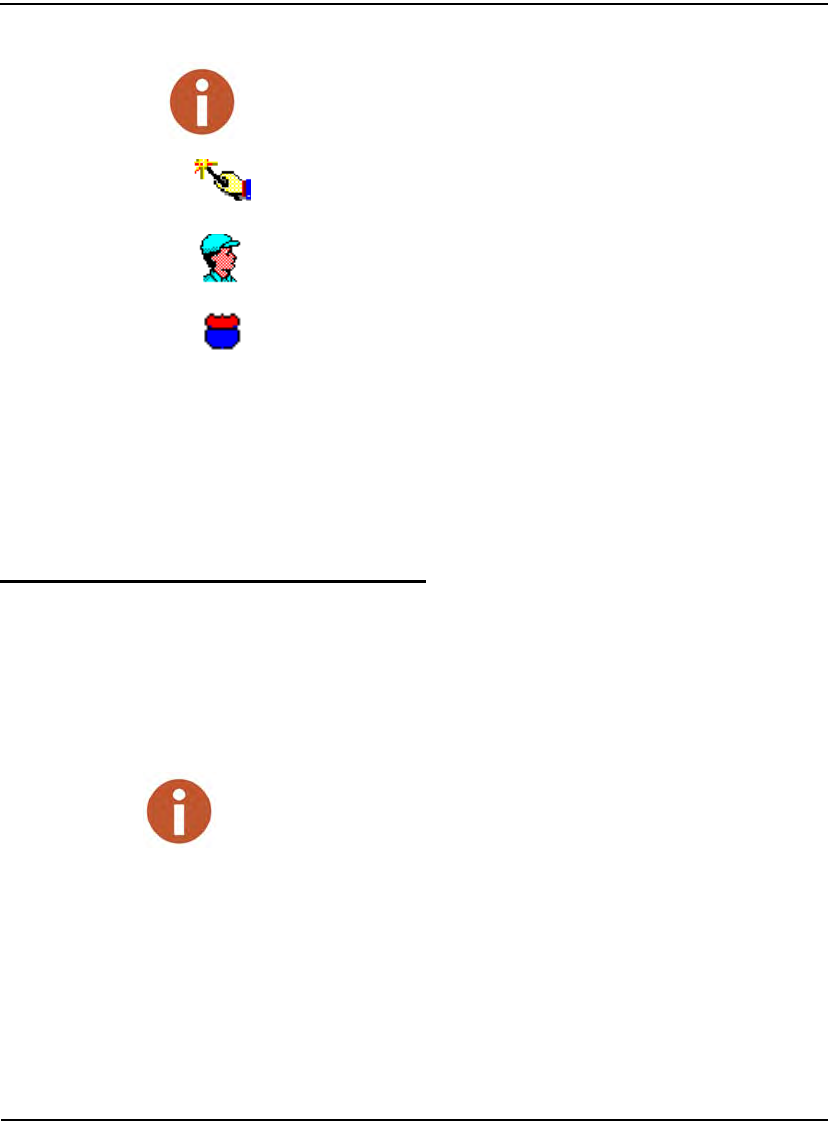
Introduction
1-2 N_SIGHT R900 User’s Manual for the Neptune Handheld System
Screen Shots Used in this Manual
In order to be consistent with the representation of all the screens
in this manual. the screens used in this guide are captured on the
Nomad. However, they appear very similarly on the other
handheld device.
Differences in Screen Appearances
The most predominant differences in the appearances of the screens on
both handheld devices are the following.
• CE5320 screens appear in a landscape or horizontal format.
• The Nomad screens appear in a portrait or vertical format.
The Note icon identifies information that clarifies a point within
the text.
The Setup icon identifies a part of the application program that
needs only periodic adjustment.
The Meter Reader icon identifies tasks that are usually
performed by a meter reader.
The Operator icon identifies tasks that are usually performed by
a N_SIGHT R900 operator.
Save data Messages that appear in the display of the handheld are in
Courier type.
Admin Keyboard entries are in Courier bold type.
Save As Menu titles and menu selections shown in the display of the
handheld are in bold type.
enter Keys that appear on the face of the handheld are in SMALL CAPS.
Except for the chapter dedicated to setting up and using the CE5320B, this
manual uses the Nomad screens. However, the CE5320B screens are very
similar.
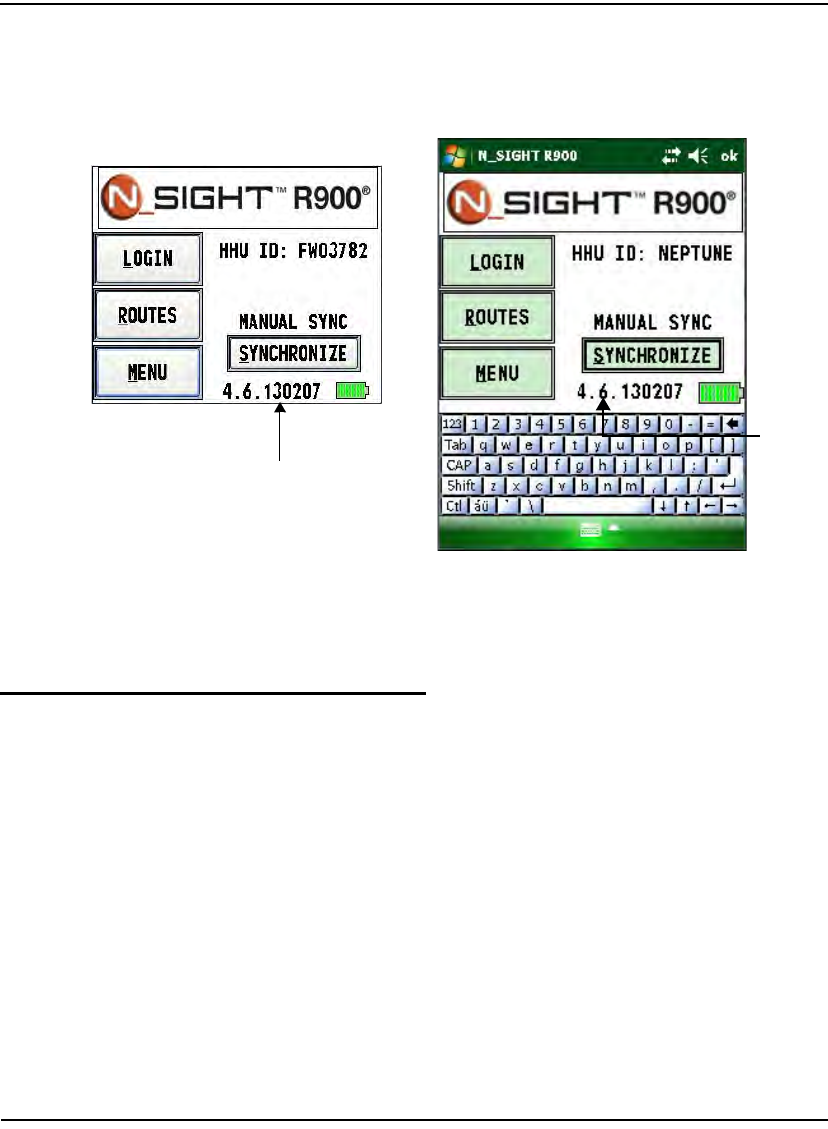
Introduction
N_SIGHT R900 User’s Manual for the Neptune Handheld System 1-3
Figure 1.1 demonstrates the differences in the screen appearances.
Figure 1.1 Sample Screens on the Neptune Handheld System
Although the style of the screens appear differently, the information on
both the CE5320B and the Nomad screens is identical.
Product Support within the United States
Neptune offers you different ways to obtain high-quality, responsive
technical support. However, before contacting Neptune, it is important
that you know the version number of the software that your handheld
uses. This information is useful to the support technician who helps you.
Finding the Software Version Number
The procedures for finding the software version number differ
depending on whether or you have logged on to N_SIGHT R900.
Version
Number
Version
Number
Sample CE5320 Screen Sample Nomad Handheld Screen
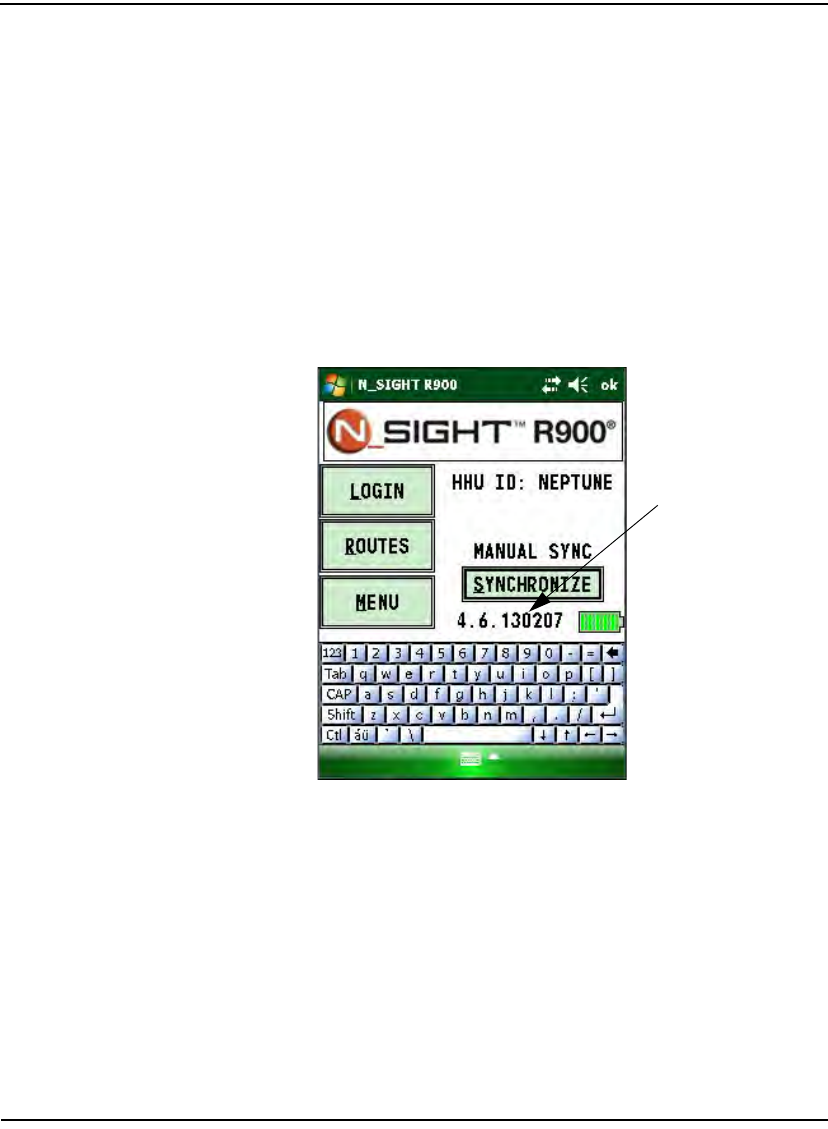
Introduction
1-4 N_SIGHT R900 User’s Manual for the Neptune Handheld System
When Not Logged In
If you have not yet logged on to N_SIGHT R900, complete the
following.
1 Turn ON the handheld.
The handheld initializes N_SIGHT R900, and this process can take
a few minutes.
2 Go to the Login screen.
The Login screen displays the version number at the bottom of the
screen as shown in Figure 1.3.
Figure 1.2 Login Screens on the Neptune Handheld System
When Logged On to N_SIGHT R900
When you have logged on to N_SIGHT R900, you can find the version
number by completing the following from any screen.
• From any N_SIGHT R900 screen, press Ctrl + I.
The Screen Information appears as shown in Figure 1.3.
Version
Number
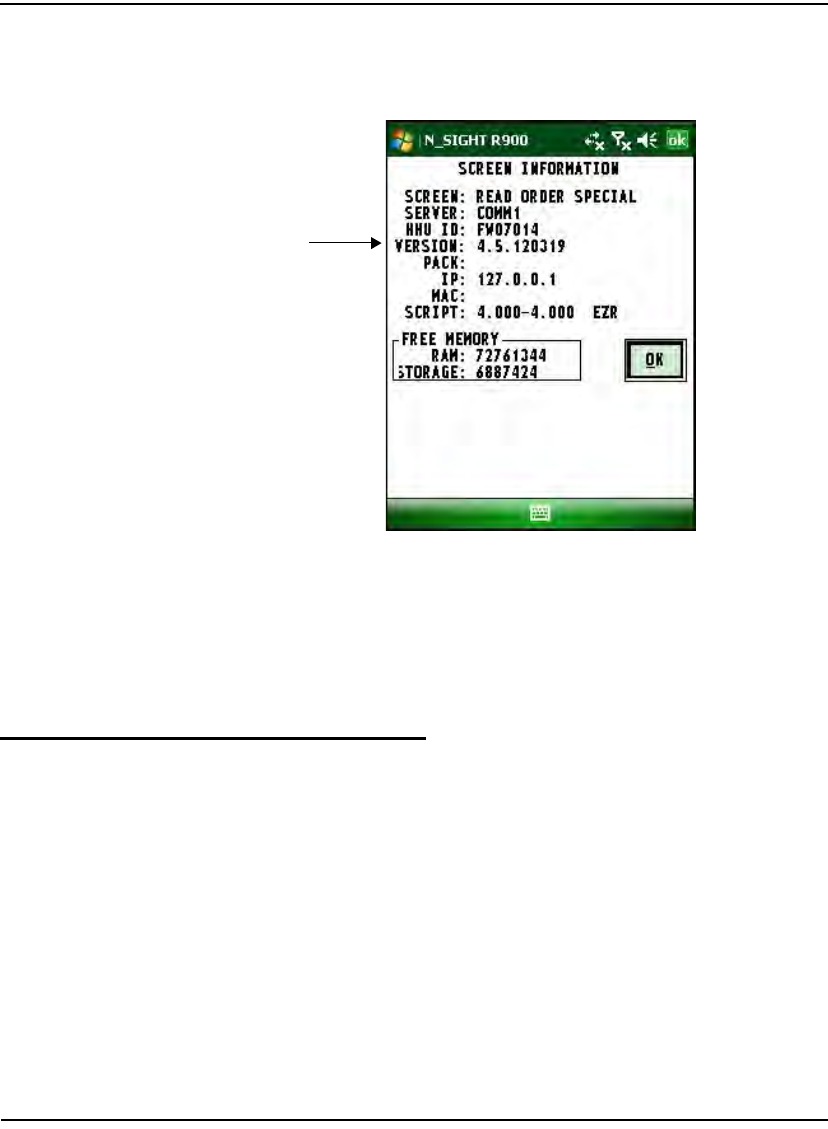
Introduction
N_SIGHT R900 User’s Manual for the Neptune Handheld System 1-5
Figure 1.3 Screen Information
• View the version number which appears directly below the
handheld ID on this screen.
This screen contains all the vital information you need to know
about the handheld.
Contacting Customer Support
Within North America, Neptune Customer Support is available Monday
through Friday, 8:00 AM to 7:00 PM Eastern Standard Time by
telephone, email, or fax.
To contact Customer Support by phone, call (800) 647-4832. You will
be directed to the appropriate team of specialists. These specialists are
dedicated to assisting you until the issue is resolved to your satisfaction.
Version
Number
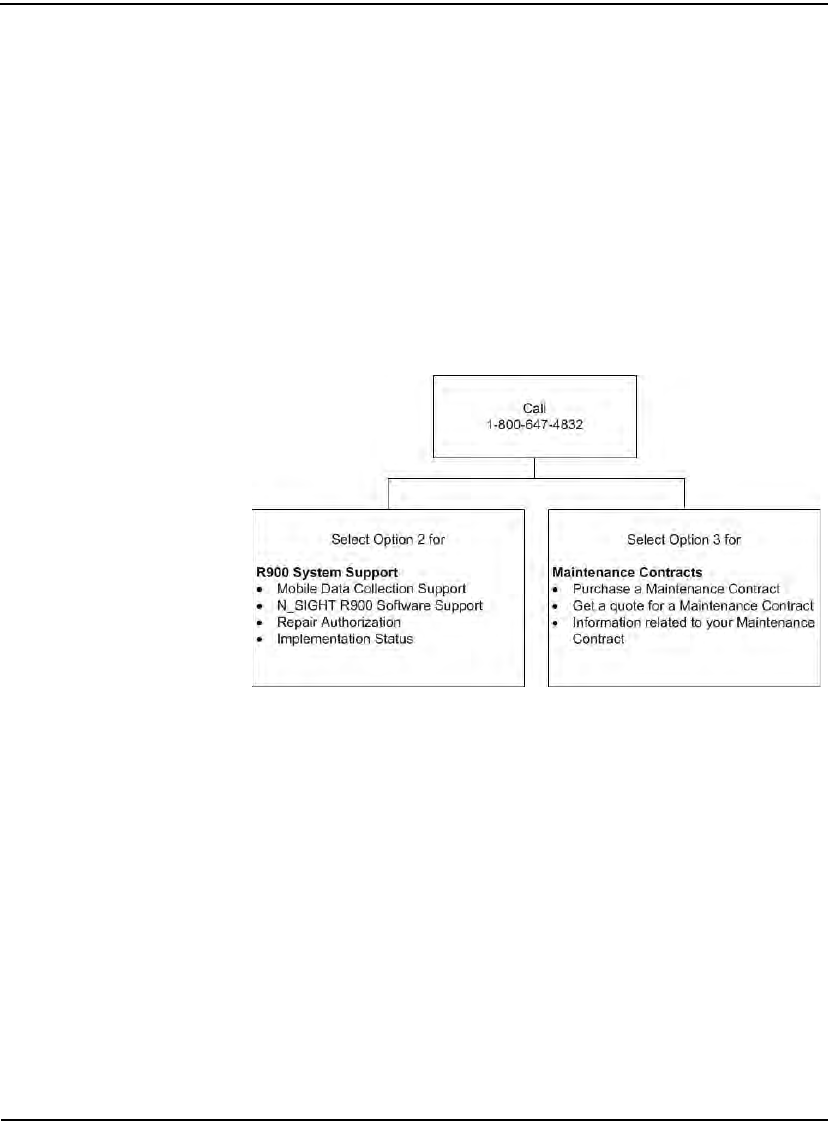
Introduction
1-6 N_SIGHT R900 User’s Manual for the Neptune Handheld System
When placing a call, be prepared to give the following information:
• The exact wording of any message that appears on the screen of the
computer or the handheld device
• A description of what happened and what you were doing when the
problem occurred
• A description of how you tried to solve the problem
• Your utility’s name
You will be directed according to the options shown in Figure 1.4.
Figure 1.4 Customer Support
To contact Customer Support by fax, send a description of your problem
to (334) 283-7497. Please include on the fax cover sheet the best time of
day for a Customer Support Specialist to contact you.
To contact Customer Support by e-mail, send your information to
hhsupp@neptunetg.com.
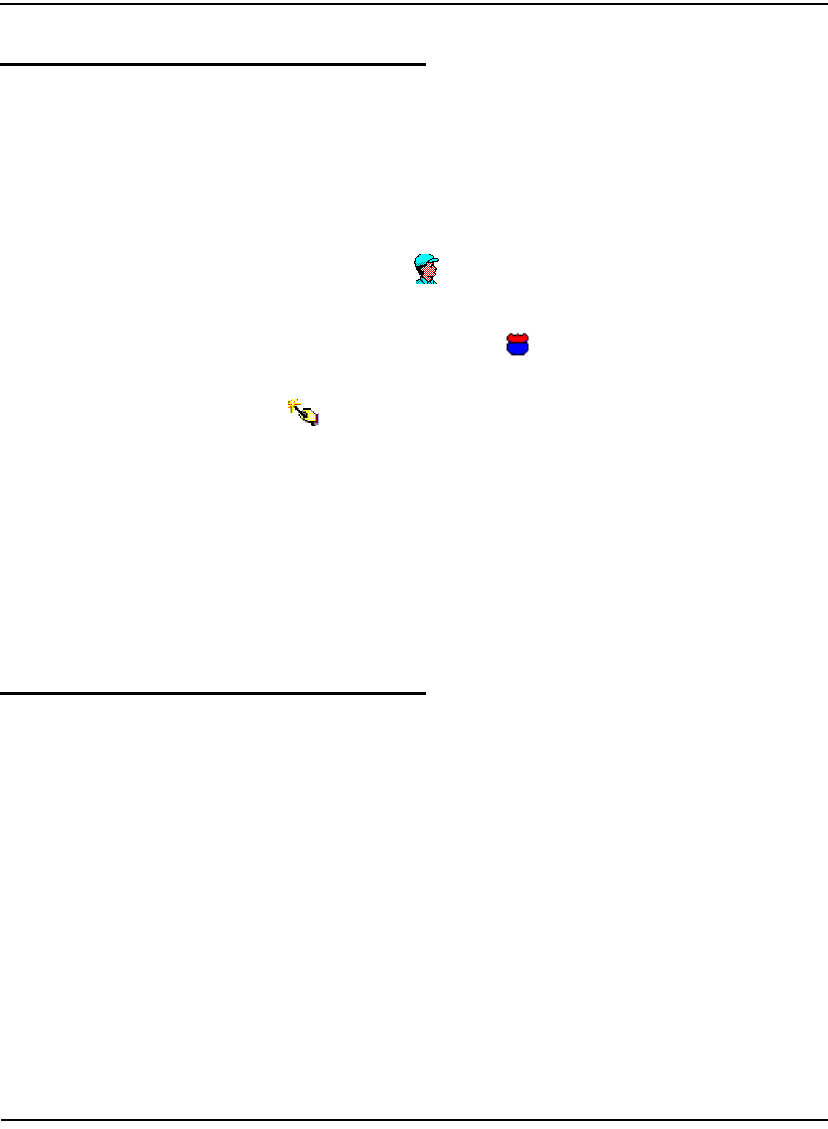
Introduction
N_SIGHT R900 User’s Manual for the Neptune Handheld System 1-7
Finding Information within the Manual
This manual is written for two basic types of users: meter readers and
operators. To help both types of users find the information they need,
this manual uses the following symbols to identify different types of
tasks:
• Tasks usually performed by meter readers are indicated by the
Meter Reader icon.
• Tasks usually performed by N_SIGHT R900 operators are
indicated by the Operator icon.
• Tasks that are performed occasionally are indicated by the Setup
icon.
In addition to looking for these symbols, use the following sections to
find information quickly:
• If you have a specific task or item in mind, look in the Index.
• Look through the Contents to find tasks and topics whose titles are
not familiar to you.
• If you are unsure of a term, look it up in the Glossary.
Where to Start
The best way for you to use this manual depends upon your
responsibilities in your company’s meter reading process and how
familiar you are with using a handheld computer.
•Meter readers typically gather meter readings and other
information about meters on a route. They most likely use the
Neptune handheld system to gather meter readings and route data
and to get route assignments.
•Operators typically manage the daily tasks of a meter reading
process. They most likely use a one of the Neptune handheld
devices to upload route data from it to their computer and to
download billing and customer information from their computer to
the handheld device.

Introduction
1-8 N_SIGHT R900 User’s Manual for the Neptune Handheld System
Meter Readers
If this is the first time that you have used the handheld, read one of the
following chapters to get a general understanding of how the display
and keys work.
You will probably find the following chapters of the manual most
useful.
•Chapter 2, "Overview of the Neptune Handheld System" describes
the basic features and functions of the handhelds; introduces you to
the Nomad handheld computer; how the handheld is incorporated
into the Neptune handheld system host software; and how it is used
by both meter readers and operators.
•Chapter 3, "Using the CE5320 Handheld" provides help to set up
and get started with your CE5320 handheld so that you can begin
collecting information from the field and exchanging information
with the host computer.
•Chapter 4, "Using the Nomad Handheld" provides help to set up
and get started with your Nomad handheld so that you can begin
collecting information from the field and exchanging information
with the host computer.
•Chapter 5, "Setting Up the R900 Belt Clip Receiver" provides basic
instructions for unpacking and inspecting the Belt Clip. It also gives
instructions for setting it up and becoming familiar with the display,
pairing it with the handheld, and usage.
•Chapter 6, "Gathering Route Data" provides instructions for using
the handheld device to collect meter readings and route data.
•Chapter 7, "Communicating with the Host Computer" provides
procedures for exchanging information with the host computer and
exiting the software.
•Chapter 8, "Using the Field Programmer" provides fundamental
instructions for operating the Field Programmer including how to
connect the mouse, programming the device, and operating the
Field Programmer.

Introduction
N_SIGHT R900 User’s Manual for the Neptune Handheld System 1-9
•Chapter 10, "Troubleshooting" helps you solve any issues or
problems that can occur when using the Neptune handheld system.
•Appendix A, "Changing Volume Settings" provides instructions for
adjusting customized sounds and the volume control setting.
•Appendix B, "Tokens List for Custom Format Screen" provides a
list of the tokens that are constants and special characters used with
the Field Programmer as part of a ProRead™ format.
•Appendix C, "Pressure Configuration Factor Indexes" provides a
list used for selecting gas formats available from American Meter,
Sensus, and Actaris when using the Field Programmer.
•"Glossary" provides a list of terms used in this manual that can be
useful when reading and learning how to use the handheld device
and software.
Operators
If this is the first time that you have used the CE5320, read Chapter 2,
"Overview of the Neptune Handheld System" to get a general
understanding of how the display and keys work. You will probably find
the following chapters of the manual most useful.
•Chapter 3, "Using the CE5320 Handheld" provides help to set up
and get started with your CE5320 handheld so that you can begin
collecting information from the field and exchanging information
with the host computer.
•Chapter 4, "Using the Nomad Handheld" provides help to set up
and get started with your Nomad handheld so that you can begin
collecting information from the field and exchanging information
with the host computer.
•Chapter 5, "Setting Up the R900 Belt Clip Receiver" provides basic
instructions for unpacking and inspecting the R900 BCR. It also
gives instructions for setting it up and becoming familiar with the
display, pairing it with the handheld, and usage.

Introduction
1-10 N_SIGHT R900 User’s Manual for the Neptune Handheld System
•Chapter 7, "Communicating with the Host Computer" provides
procedures for exchanging information with the host computer and
exiting the software.
•Chapter 9, "Maintaining and Repairing the Neptune Handheld
System" provides instructions for maintaining and repairing the
CE5320, the Nomad, and the R900 BCR and includes
recommended spare parts. It also gives instructions for packing and
shipping a device to Neptune should you ever need to return any
unit for repair.
•Chapter 10, "Troubleshooting" helps you to solve any issues or
problems that can occur when using the Neptune handheld system.
•Appendix A, "Changing Volume Settings" provides instructions for
adjusting customized sounds and the volume control setting.
•"Glossary" provides a list of terms used in this manual that can be
useful when reading and learning how to use the handheld device
and software.
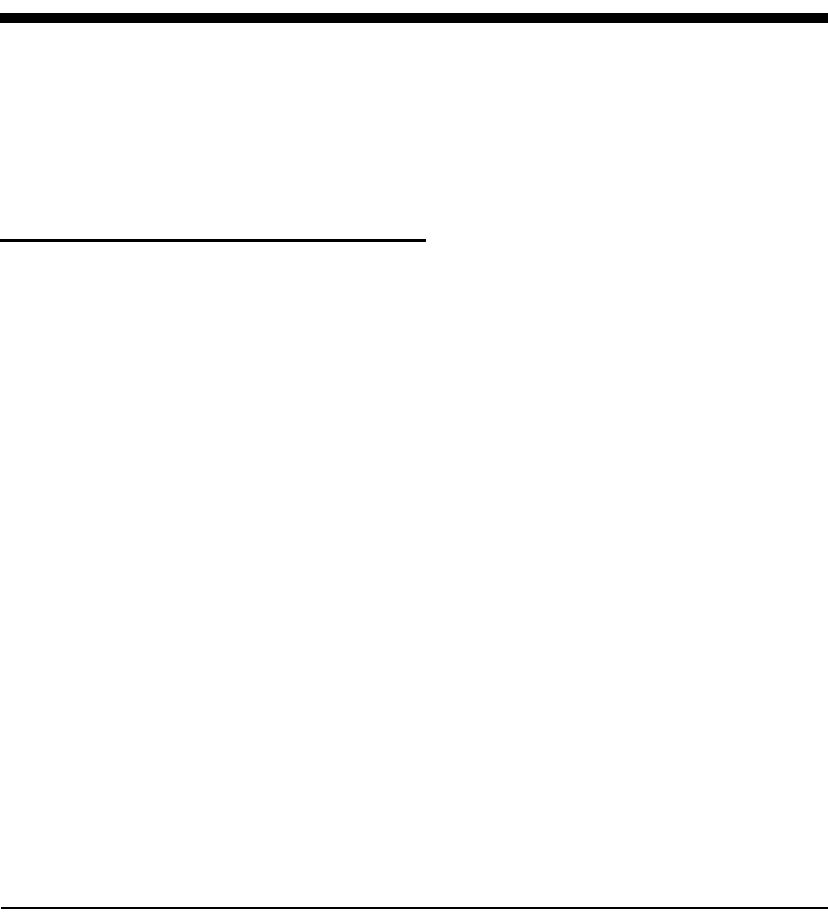
N_SIGHT R900 User’s Manual for the Neptune Handheld System 2-1
2 Overview of the Neptune Handheld System
This chapter is designed to introduce you to the Neptune handheld
system handheld computer. It will explain how the handheld is
incorporated into the N_SIGHT R900 host software, and how it will be
used by both meter readers and operators. It will also help you become
familiar with the basic features and functions the handheld computer
offers.
Typical Meter Reading Process
By using the handheld computer in conjunction with N_SIGHT R900
software, the meter reading process has an effective tool in collecting
and distributing information that is critical to managing daily tasks.
Meter readers use the handheld to gather route information. Operators
use N_SIGHT R900 to collect route information from the handheld and
to collect billing information from the billing computer. Once this
information is stored on an operator’s computer, called the host
computer, operators use N_SIGHT R900 to make route assignments and
to send updated information to the handheld and to the billing computer.
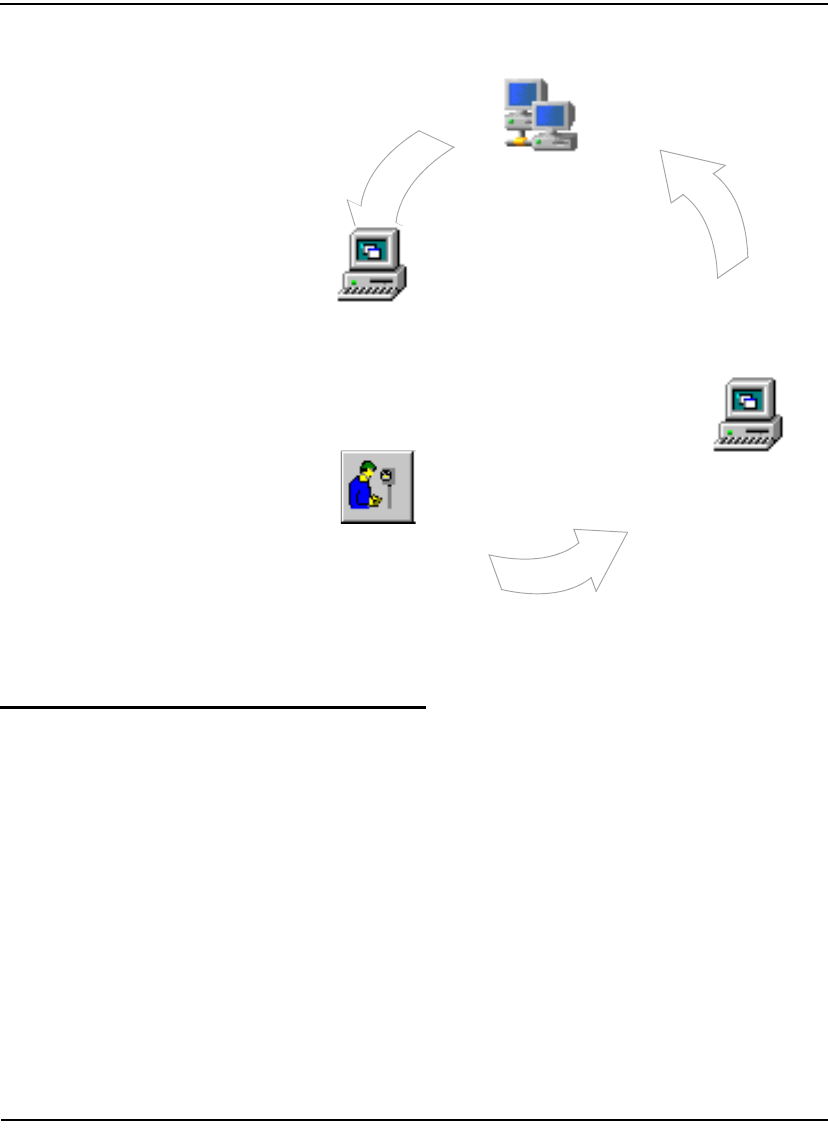
Overview of the Neptune Handheld System
2-2 N_SIGHT R900 User’s Manual for the Neptune Handheld System
Figure 2.1 Typical Meter Reading Process
Daily Use of the Neptune Handheld System
Because the Neptune handheld system helps users collect and pass on
different types of information needed by a meter reading process, how
you use it depends upon your responsibilities in your meter reading
process. The following topics describe how meter readers and operators
typically use the handheld to complete their work.
Transfer billing information to
the host computer.
Load routes onto meter
reading devices.
Collect meter readings and route
data using a handheld computer.
Post meter readings and route
data to customer accounts for
billing.
Transfer files containing
meter readings and route
data to the billing computer.
Upload meter readings and
route data from the handheld
computers to a host
computer.
Assign routes to meter readers.
1.
2.
3.
4.
7.
6.
5.
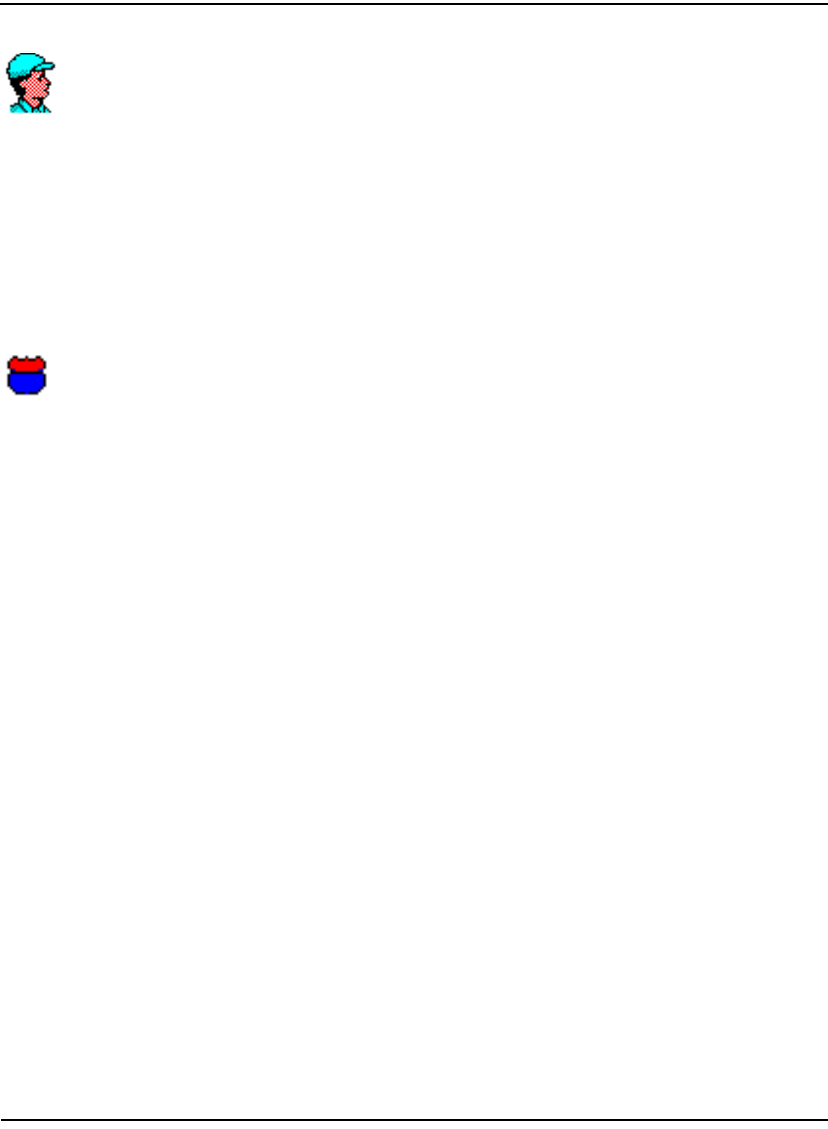
Overview of the Neptune Handheld System
N_SIGHT R900 User’s Manual for the Neptune Handheld System 2-3
Meter Readers
During a typical day, meter readers use the handheld to get route
assignments and to gather route data. Meter readers pick up a handheld
in the morning and review route assignments that were downloaded the
previous afternoon by an operator. Then, they use it to gather meter
readings and other data from the assigned routes. After they complete
their routes, meter readers return the handheld to the office where an
operator uploads the readings and route data onto the computer and then
downloads route assignments and other data to it.
Operators
Typically, operators connect the handheld so that it can communicate
with their computer. Once the handheld is connected, operators set up
the software so that it can exchange information with their computer,
called the host computer.
During a typical day, operators make route assignments and collect
billing information from the billing computer. Toward the end of the
day, after meter readers complete their routes and return the handhelds
to the office, operators exchange information with them. During a
typical information exchange, route data is unloaded from the handheld
at the same time that the next day’s assignments and updated billing
information are loaded to it.
The operator makes sure that the handheld is fully charged and ready for
use by a meter reader.
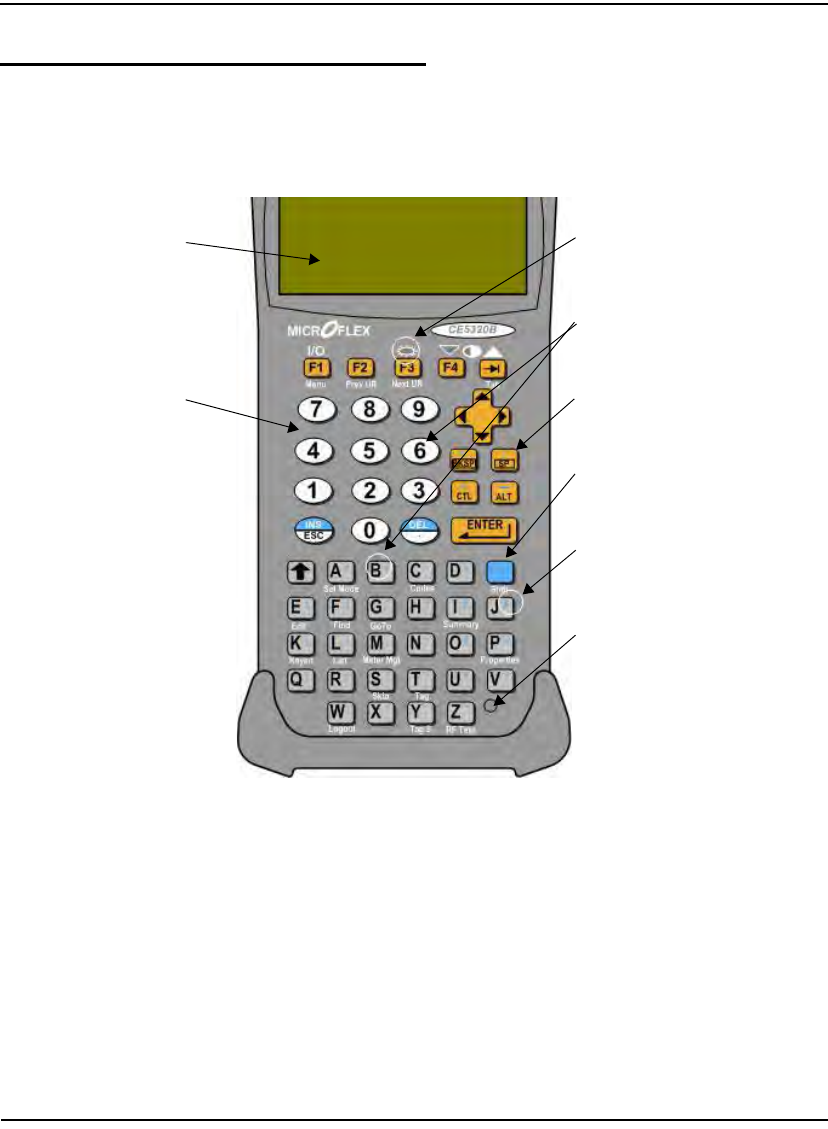
Overview of the Neptune Handheld System
2-4 N_SIGHT R900 User’s Manual for the Neptune Handheld System
Basic Features of the CE5320
In addition to an environmental seal that protects the unit from dust, dirt,
and water, the CE5320 includes the following features:
Figure 2.2 CE5320B Handheld Features
•Display—shows up to 33 lines of text and allows touch-screen
entry. In addition, you have the option of backlighting the display
so that information is visible in low light.
•Keyboard—uses 51 multifunctional keys that include letter,
number, character, task, and menu keys. The tactile design of the
keys and the tone that sounds when a key is pressed help to reduce
errors. In addition, if you have the Keyboard Backlight option, the
keys can be illuminated making them easy to read in low light.
Display
Keyboard
Battery status light
Keyboard functions
Alphanumeric keys
Editing functions
Blue key
Special characters
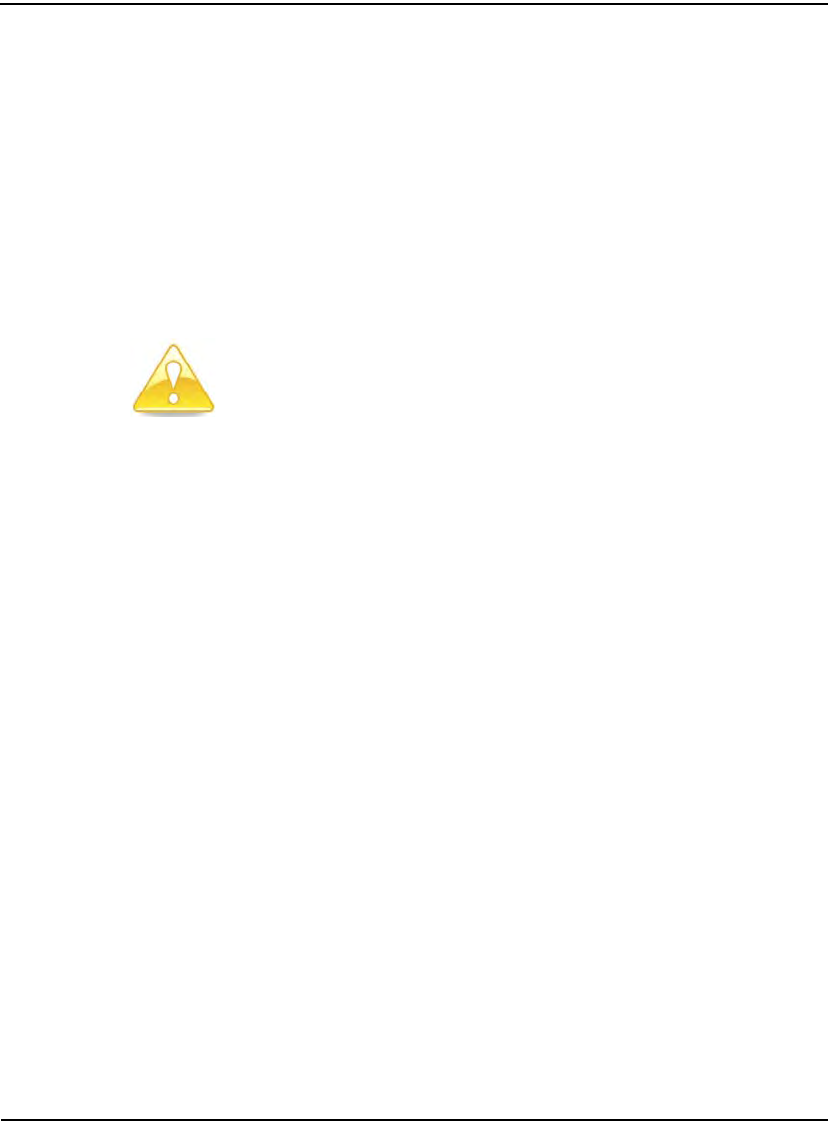
Overview of the Neptune Handheld System
N_SIGHT R900 User’s Manual for the Neptune Handheld System 2-5
•Ethernet Communication Port—an RJ-45 Ethernet connector on
the cradle allows you to connect the CE5320 using an RJ-45
Ethernet cable to a variety of devices. This capability provides for
route assignments and route data to be sent to the CE5320, and
meter readings and route information to be retrieved from it.
•Battery Status Light—lets you know when the battery is fully
charged. If the light is red, the battery needs recharging and if the
light is green, the battery is charged and the handheld is operational.
Do not attempt to remove the back panel of the CE5320. Attempting to
repair the unit on your own voids the warranty by breaking the warranty
label which covers a screw on the back of the unit. If the CE5320 does
not function, contact a Neptune support technician for assistance. For
help in contacting Neptune, refer to the topic “Contacting Customer
Support,” on page 1-5.
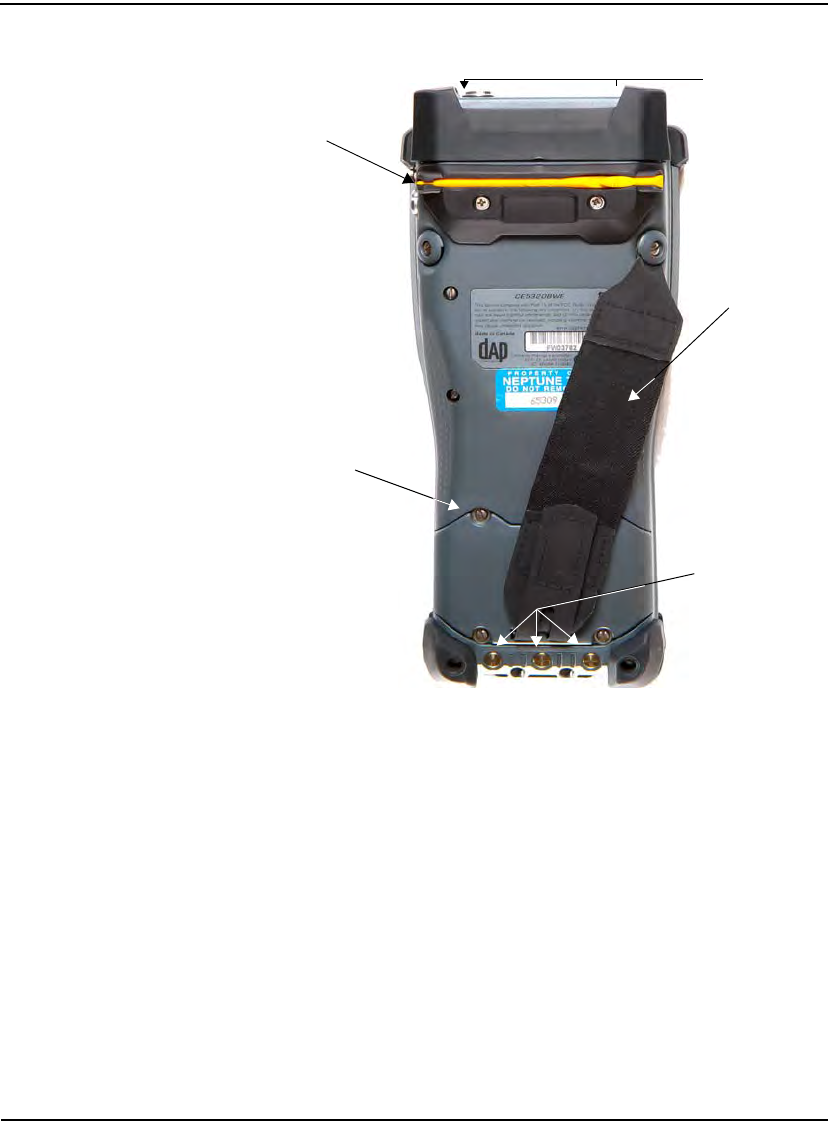
Overview of the Neptune Handheld System
2-6 N_SIGHT R900 User’s Manual for the Neptune Handheld System
Figure 2.3 Back of CE5320 Handheld
•Handstrap—makes it easy to carry the CE5320.
•Stylus—allows for ease of use for the touch screen on the CE5320.
•Battery Compartment—holds a lithium-ion battery pack that is
rated for a usage up to 500 charge cycles or 2 years - whichever
occurs first.
•Battery Recharge Contacts—recharges the battery when the
CE5320 rests in a communication cradle.
Cover
Handstrap
Battery
compartment
Battery recharge
contacts
Stylus
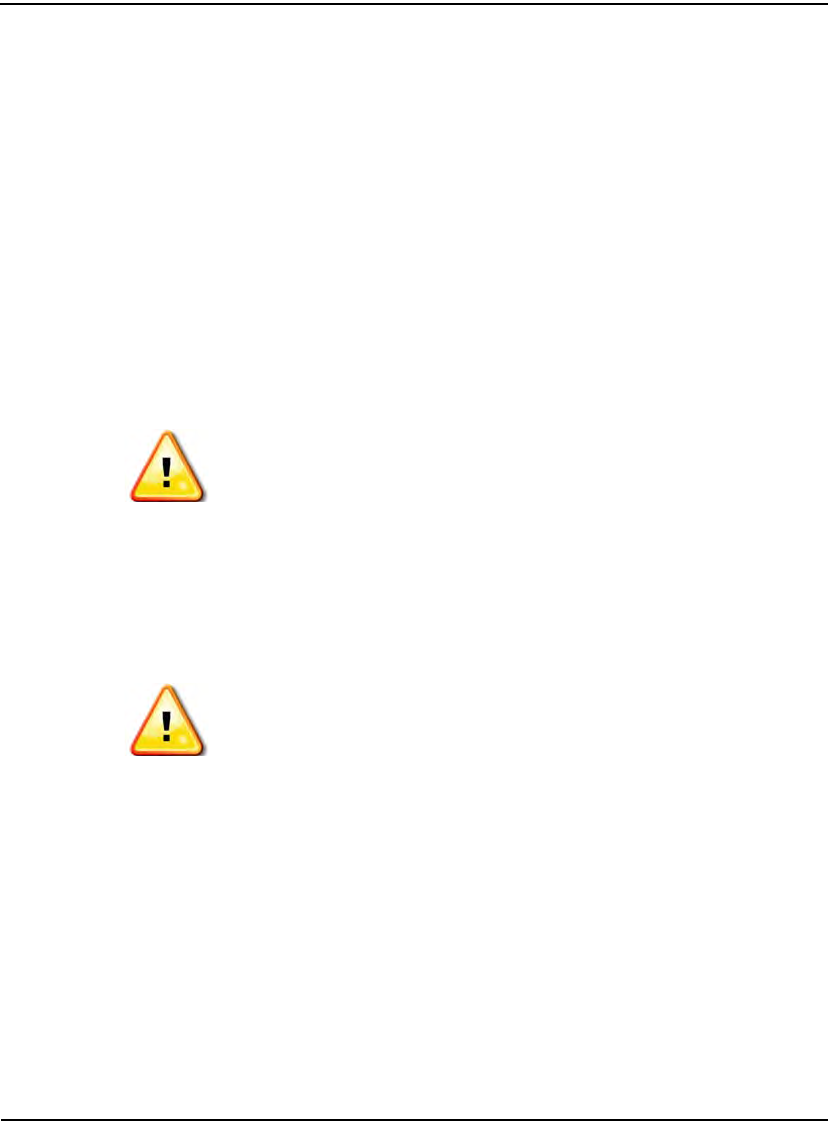
Overview of the Neptune Handheld System
N_SIGHT R900 User’s Manual for the Neptune Handheld System 2-7
The CE5320 also offers the following:
•Suspend Mode—puts the CE5320B into a low-power state.
•Manual Off Feature—allows operators to turn the CE5320 off
immediately.
•Automatic Return Feature—shows the information that was last
in the display after the handheld is turned off manually or
automatically.
•Customized Sounds—can be used as warning signals or as a
prompt.
Operating Environment
The recommended temperature range for operating the CE5320 is from
-20°C to +50°C (-4°F to +122°F). Short exposure to temperatures lower
or higher than these can cause the display to turn very dark or very light
until the unit returns to the recommended operating temperature range.
Rain and Water Resistance
The handheld withstands exposure to rain without allowing water to
seep inside the unit. It is designed to endure occasional immersions, and
the unit floats making it easy to retrieve if dropped in water.
Electromagnetic Resistance
The CE5320 performs well in most common environments where
electromagnetic fields are present. Examples of these environments
include areas near power-transmission lines, electric motors,
transformers, compressors, and low-power radio transmitters.
Performance can be degraded when using a communication cable, a
peripheral, such as a printer, or a battery charger under these conditions.
Long exposure to temperatures below -20°C (-4°F) can damage the display.
Prolonged exposure to temperatures above 50°C (122°F) will damage the
battery and above 60°C (140°F) can permanently damage the unit.
Water resistance can be impaired if the door of the battery compartment or top
cover is improperly closed or if the gaskets have deteriorated.

Overview of the Neptune Handheld System
2-8 N_SIGHT R900 User’s Manual for the Neptune Handheld System
Shock Resistance
When the unit is operated within the specified temperature range, it can
withstand occasional drops from up to two meters (six feet) onto a hard
surface.
Use of the CE5320
To set up and begin using your CE5320 handheld, go to “Using the
CE5320 Handheld,” on page 3-1.
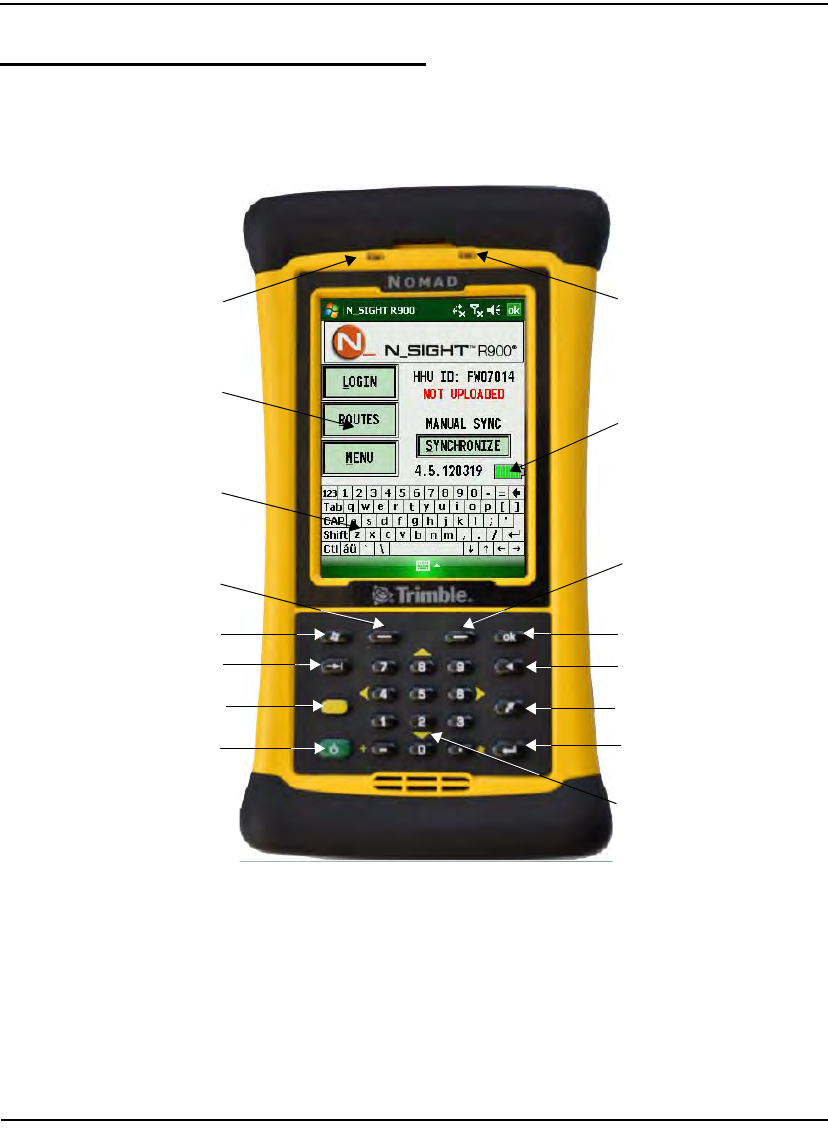
Overview of the Neptune Handheld System
N_SIGHT R900 User’s Manual for the Neptune Handheld System 2-9
Basic Features of the Nomad
In addition to an environmental seal that protects the unit from dust, dirt,
and water, the Nomad includes the following features.
Figure 2.4 Nomad Handheld Features
•Display—shows up to 33 lines of text and allows touch-screen
entry. In addition, you have the option of backlighting the display
so that information is visible in low light.
•Keyboard—uses 51 multifunctional keys that include letter,
number, character, task, and menu keys. The tactile design of the
keys and the tone that sounds when a key is pressed help to reduce
Display
Keyboard
Battery status indicator
Left application soft key
Function key
Start
Tab
Power
OK
Backspace
Today
Notification LED
Right application soft key
Enter
Arrow keys (used with
function key)
Charging LED
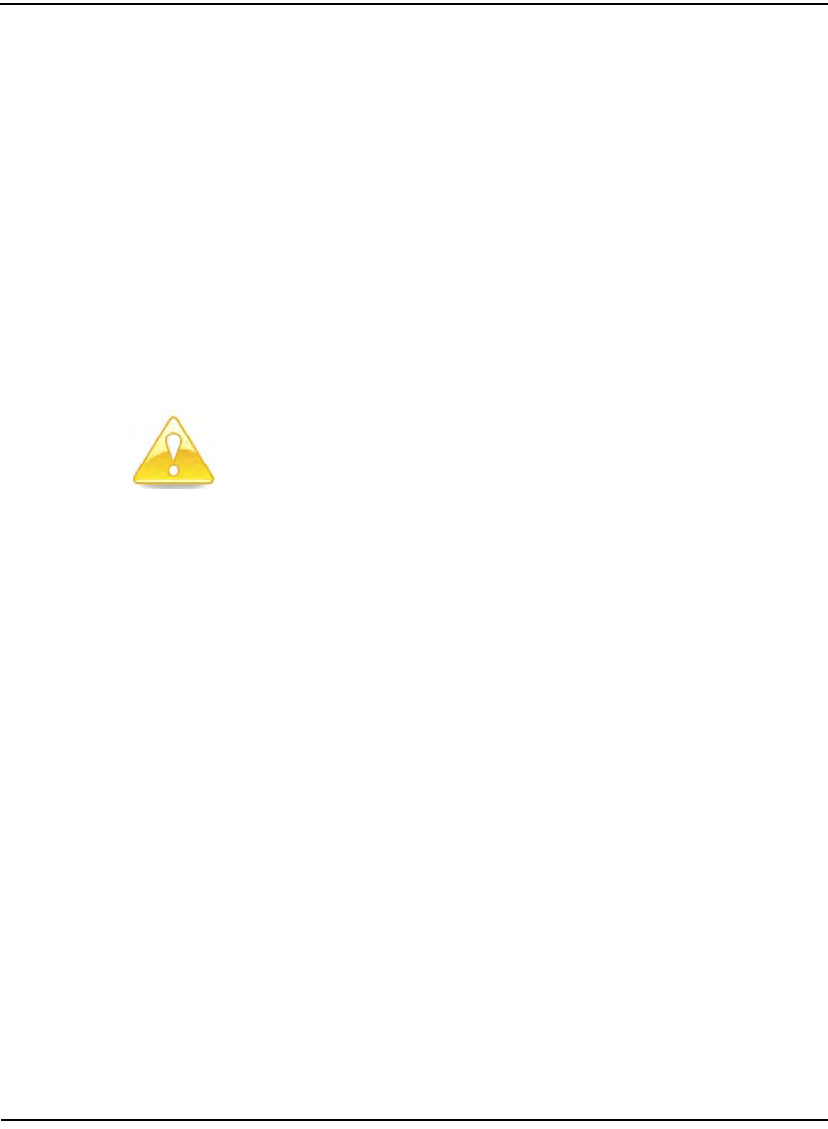
Overview of the Neptune Handheld System
2-10 N_SIGHT R900 User’s Manual for the Neptune Handheld System
errors. In addition, if you have the Keyboard Backlight option, the
keys can be illuminated making them easy to read in low light.
•Ethernet Communication Port—an RJ-45 Ethernet connector on
the cradle allows you to connect the Nomad using an Ethernet cable
to a variety of devices. This capability provides for route
assignments and route data to be sent to the Nomad, and meter
readings and route information to be retrieved from it.
•Battery Status Light—lets you know when the battery is fully
charged. If the light is red, the battery needs recharging and if the
light is green, the battery is charged and the handheld is operational.
Do not attempt to remove the back panel of the Nomad. Attempting to
repair the unit on your own voids the warranty by breaking the warranty
label which covers a screw on the back of the unit. If the Nomad does
not function, contact a Neptune support technician for assistance. For
help in contacting Neptune, refer to the topic “Contacting Customer
Support,” on page 1-5.
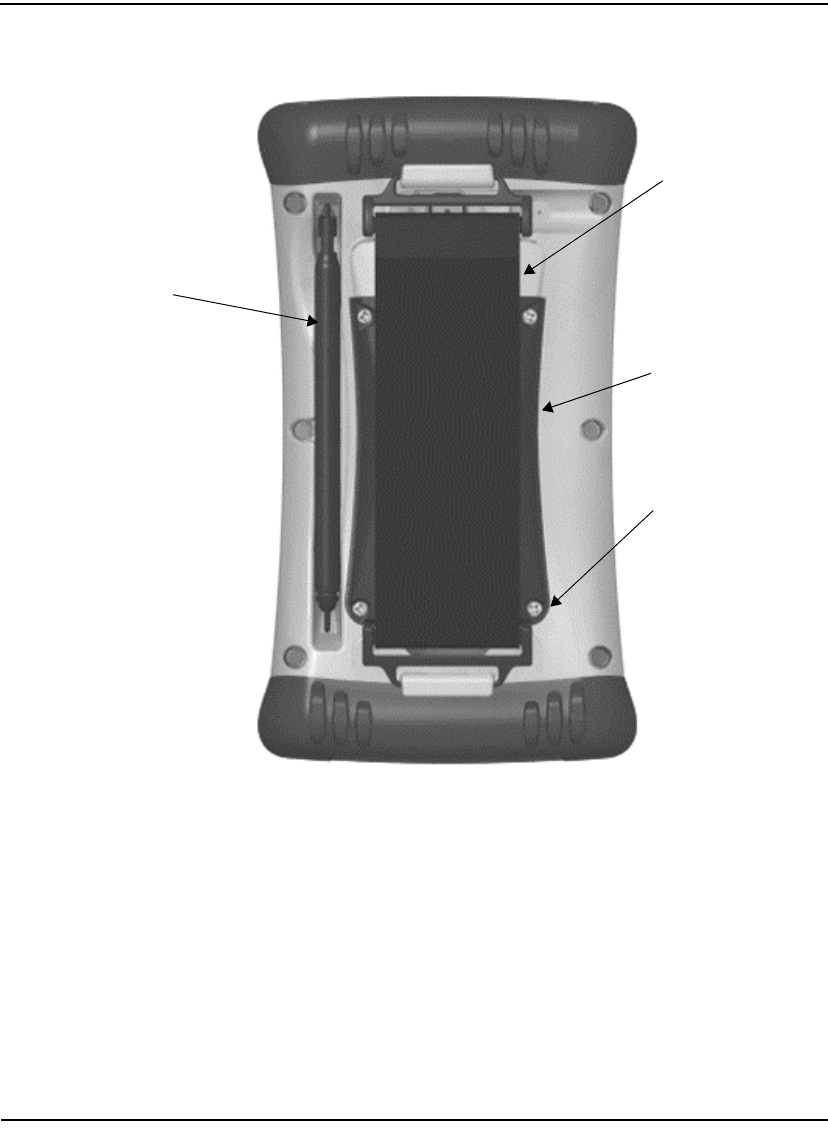
Overview of the Neptune Handheld System
N_SIGHT R900 User’s Manual for the Neptune Handheld System 2-11
Figure 2.5 Back of Nomad Handheld
•Handstrap—makes it easy to carry the Nomad.
•Battery Compartment—holds a lithium-ion battery pack that is
rated for up to 500 charge cycles or 2 years - whichever occurs first.
•Stylus—makes is easy to use the touchscreen display. Can be
calibrated for the user’s own personal touch.
Handstrap
Stylus
Battery door screws
Battery
compartment
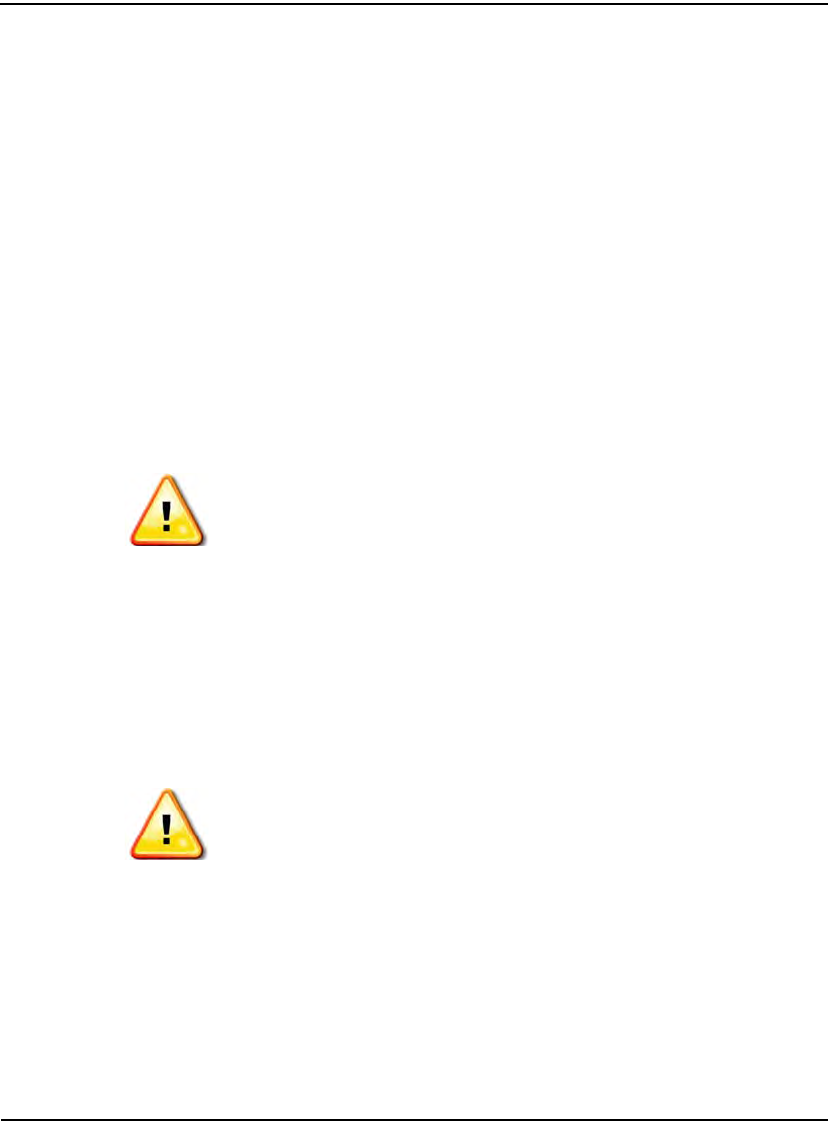
Overview of the Neptune Handheld System
2-12 N_SIGHT R900 User’s Manual for the Neptune Handheld System
The Nomad also offers the following:
•Suspend Mode—puts the Nomad into a low-power state.
•Manual Off Feature—allows operators to turn the Nomad off
immediately.
•Automatic Return Feature—shows the information that was last
in the display after the handheld is turned off manually or
automatically.
•Customized Sounds—can be used as warning signals or as a
prompt.
Operating Environment
The recommended temperature range for operating the Nomad is from -
-30C to 60C (-22F to 140F). Short exposure to temperatures lower or
higher than these can cause the display to turn very dark or very light
until the unit returns to the recommended operating temperature range.
Rain and Water Resistance
The handheld withstands exposure to rain without allowing water to
seep inside the unit. It is designed to endure occasional immersions, and
the unit floats making it easy to retrieve if dropped in water.
The Trimble Nomad has gone through multiple tests and meets MIL-STD-810F
military standards. Long exposure to temperatures below -20°C (-4°F) can
damage the display. Prolonged exposure to temperatures above 50°C (122°F)
will damage the battery and above 60°C (140°F) can permanently damage the
unit.
Water resistance can be impaired if the door of the battery compartment or top
cover is improperly closed or if the gaskets have deteriorated.
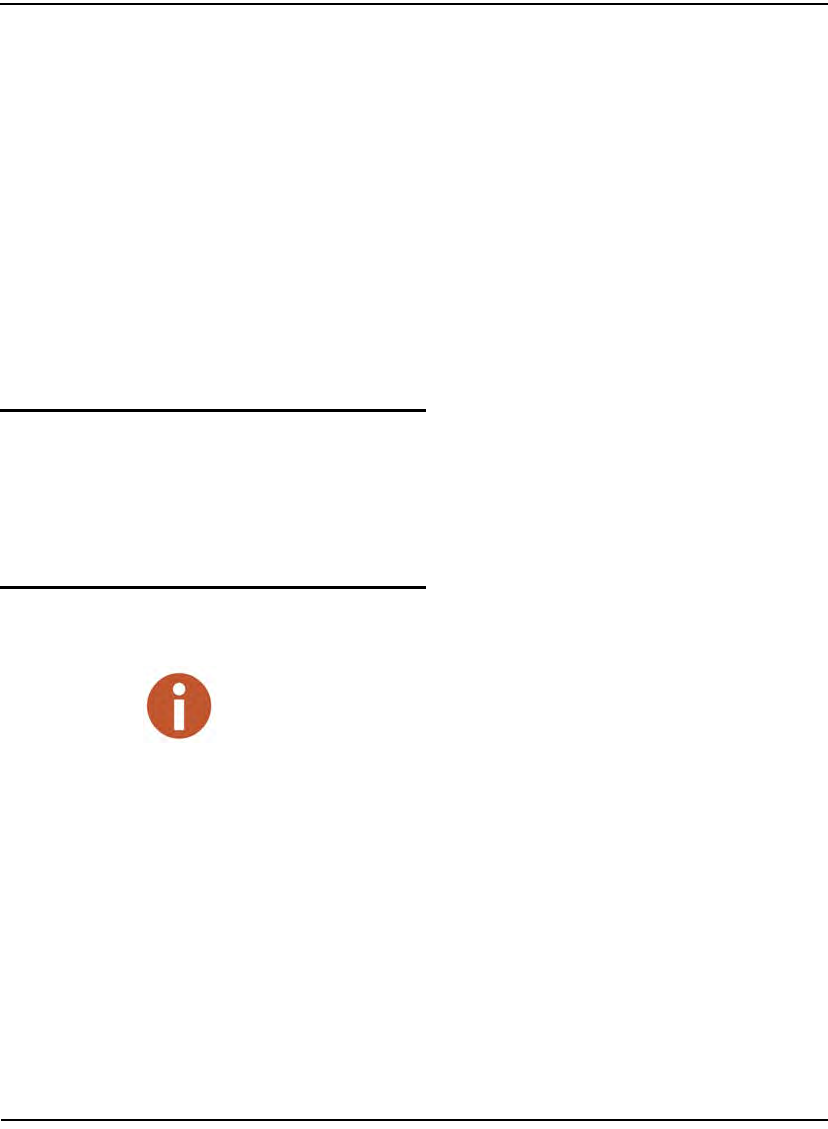
Overview of the Neptune Handheld System
N_SIGHT R900 User’s Manual for the Neptune Handheld System 2-13
Electromagnetic Resistance
The Nomad performs well in most common environments where
electromagnetic fields are present. Examples of these environments
include areas near power-transmission lines, electric motors,
transformers, compressors, and low-power radio transmitters.
Performance can be degraded when using a communication cable, a
peripheral, such as a printer, or a battery charger under these conditions.
Shock Resistance
When the unit is operated within the specified temperature range, it can
withstand occasional drops from up to 1.22 meters (4 feet) onto a hard
surface.
Use of the Nomad
To set up and begin using your Nomad handheld, go to “Using the
Nomad Handheld,” on page 4-1.
The Display on the Handhelds
This section describes the display on the Neptune handheld system.
• The types of information that are shown in the display of the
handheld.
• An overview of how to use the screens to access different types of
information.
Except for the chapter dedicated to setting up and using the CE5320B, this
manual uses the Nomad screens. However, the CE5320B screens are very
similar.
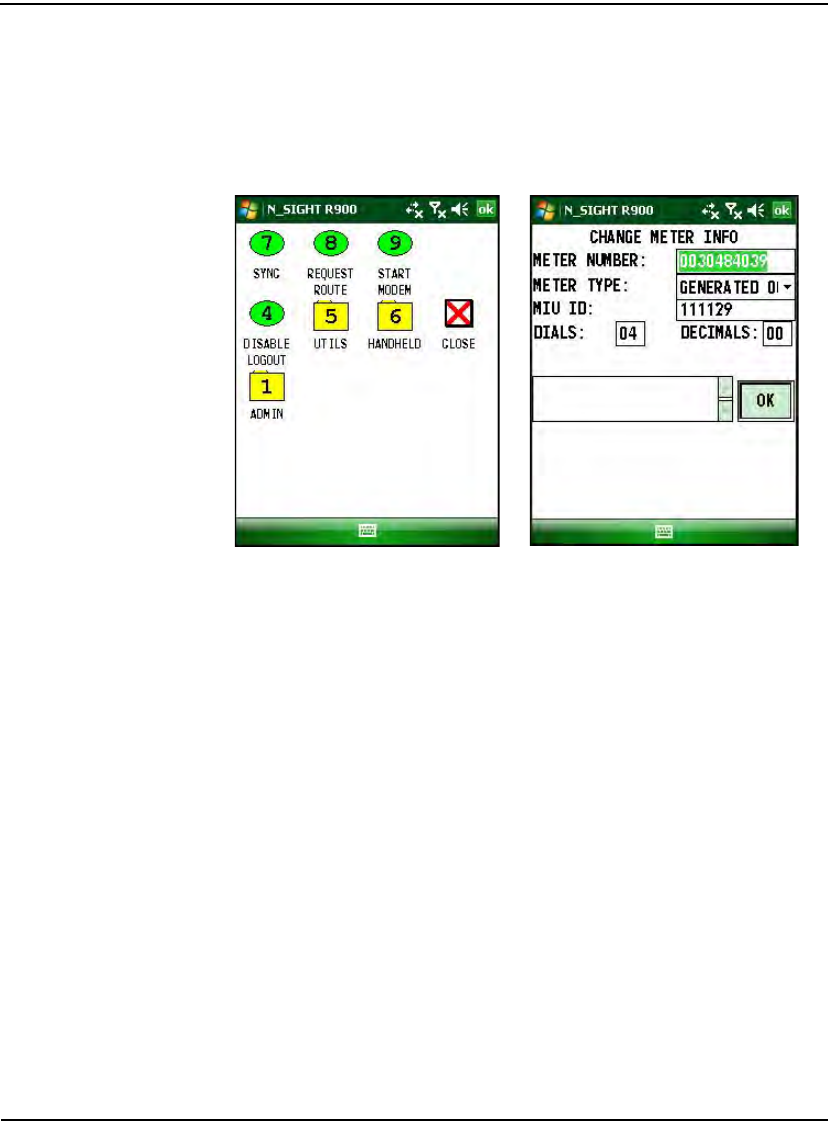
Overview of the Neptune Handheld System
2-14 N_SIGHT R900 User’s Manual for the Neptune Handheld System
The Handheld Display
Information in the display of the handheld is shown in three formats:
menu screens, data-entry screens, and message screens.
Figure 2.6 Menu and Data-Entry Screen
Menu screens allow you to
choose from the icon options. Data-entry screens prompts
you to select or enter data,
such as the meter number.
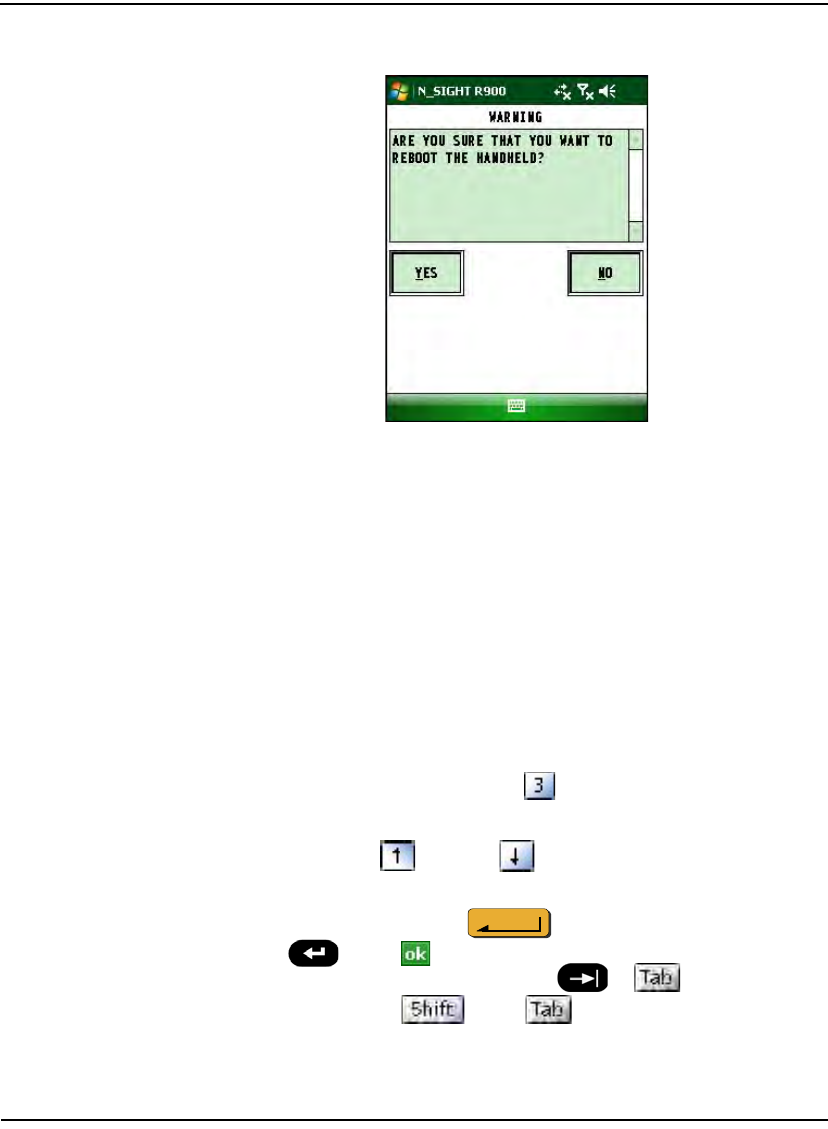
Overview of the Neptune Handheld System
N_SIGHT R900 User’s Manual for the Neptune Handheld System 2-15
Figure 2.7 Message Screens
Menu Screens
Menu screens typically display a list of options within a box and prompt
you to select one. To select an option from a menu screen, do one of the
following:
• From the keypad, press the key whose number corresponds to the
item that you want to select. For example, if the menu displays a list
of trouble codes and the code that you want to select is number 3 in
the list, then press the THREE key on the keyboard or keypad.
Your selection appears in the display.
•Use the UP or DOWN key to move up or down the list
until the item that you want is highlighted.
Then press the ENTER key on the CE5320 or the ENTER
key or on the Nomad. Your selection appears in the
display. You can also use the TAB or to move forward,
and the SHIFT + TAB to move backward.
Message screens display information or prompt you to make a
selection. They also can tell you how to exit the current screen or how
to access other screens.
ENTER
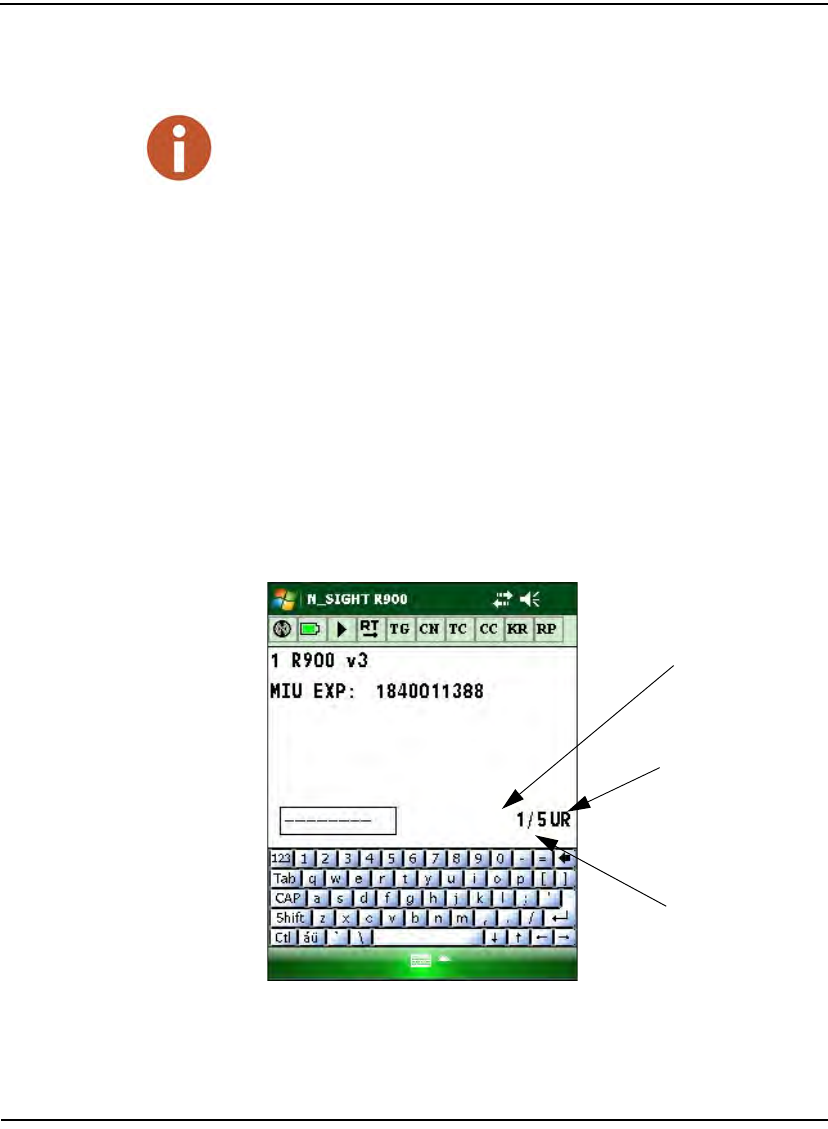
Overview of the Neptune Handheld System
2-16 N_SIGHT R900 User’s Manual for the Neptune Handheld System
The procedures in this manual will instruct you to follow one or the
other method. Use the method most comfortable for you.
Data-Entry Screens
Typically, data-entry screens prompt you to enter information.
Whenever a data-entry screen is displayed, the handheld automatically
disables inappropriate keys. For example, when prompted to enter a
meter reading, it allows you to enter numbers only. However, if you are
prompted to enter a new trouble code, it enables the letter and number
keys because codes can use letters and numbers.
On each of the reading-entry screens the meter reader can tell the
position of the meter within the route. See Figure 2.8 on Page 2-16.
Figure 2.8 Meter Position within Route
A key that can be used to select an item from a list is called a hot key.
Meter
position
Number of accounts
within route
UR = unread

Overview of the Neptune Handheld System
N_SIGHT R900 User’s Manual for the Neptune Handheld System 2-17
In this example, the number 1/5show us that the position of this meter is
1 out of 5 accounts contained on the route.
The reader can use and to navigate to other accounts on the
route.
Message Screens
Typically, message screens display messages as well as instructions for
exiting the message screen. For example, when a message, such as
Return handheld to office by 4pm to download
routes, is displayed, the instruction Press ESC key is also shown
to tell you how to exit the message screen. Sometimes you can be given
options for accessing other screens that contain information related to
the message shown in the display.
Some message screens only display information such as the number of
the meter whose reading-entry screen is shown. Because the
information displayed in message screens is linked to a particular meter
or route, pressing any key from this screen always returns you to the
reading-entry screen of the meter or route to which the message
belongs.
Navigating Through Screens
There are two primary screens meter readers and operators use that give
them access to the screens they need: the Reading-Entry screen (a data-
entry screen) and the F1 Menu (a menu screen).
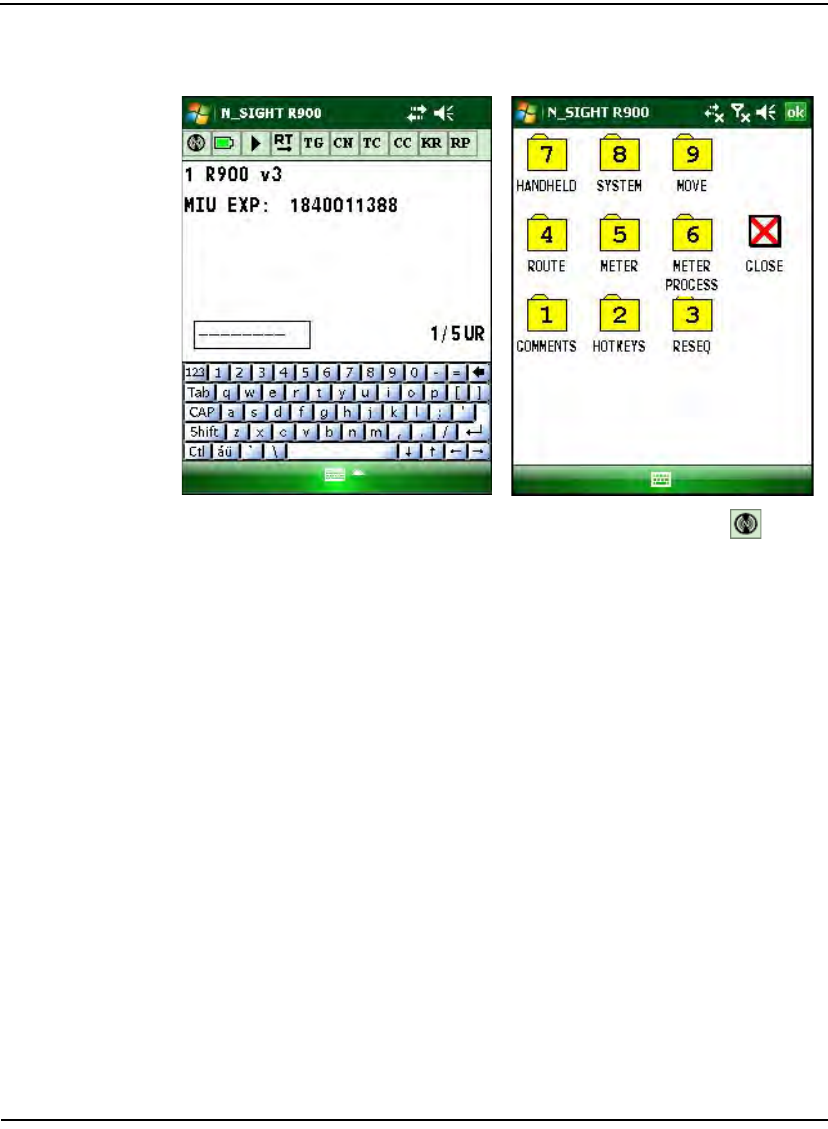
Overview of the Neptune Handheld System
2-18 N_SIGHT R900 User’s Manual for the Neptune Handheld System
Figure 2.9 Navigating Screens
You can display a reading-entry screen after routes have been
downloaded to the handheld by logging into the route. From the F1
menu or the Start key menu, you can access other screens, configure
probes, and check or change settings that control how the CE5320 and
Nomad exchanges information with the host computer.
To display screens that allow you to view or change information about a
meter or route, you must first
You can now make changes from the current meter you are on from the
Reading Entry screen and make changes to the route as well.
Generally, meter-readers use the
reading-entry screen to access
information they need to perform
their tasks.
Meter readers also use the Start
key or the F1 menu to access
information and functions they need to
perform their tasks.
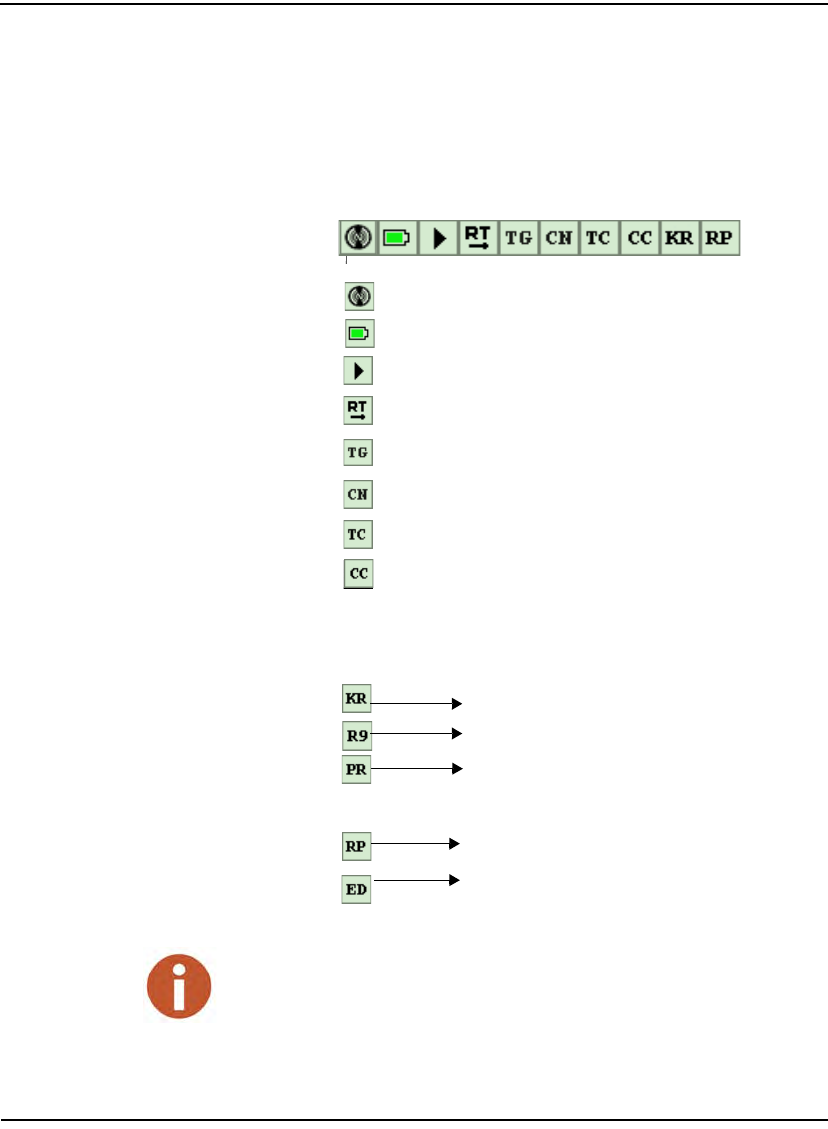
Overview of the Neptune Handheld System
N_SIGHT R900 User’s Manual for the Neptune Handheld System 2-19
Icon Bar
The icon bar allows you to work with the Reading Entry screens. It
appears at the top of the screen similar to the one shown in Table 2.1.
Table 2.1 N_SIGHT R900 Display Icons
Display Icons
Main menu
Battery indicator
Next unread account
Route direction: points
Tag account
Customer notes
Trouble codes
Comment Code
Cycles between one of these icon
displays
depending on the reading:
Keyed Read (Manual)
R900
Probe
Changes per type of account:
Read parameters (manual accounts)
Edit (radio and probe accounts)
If an icon appears as gray rather than black, it means that this icon is not available.
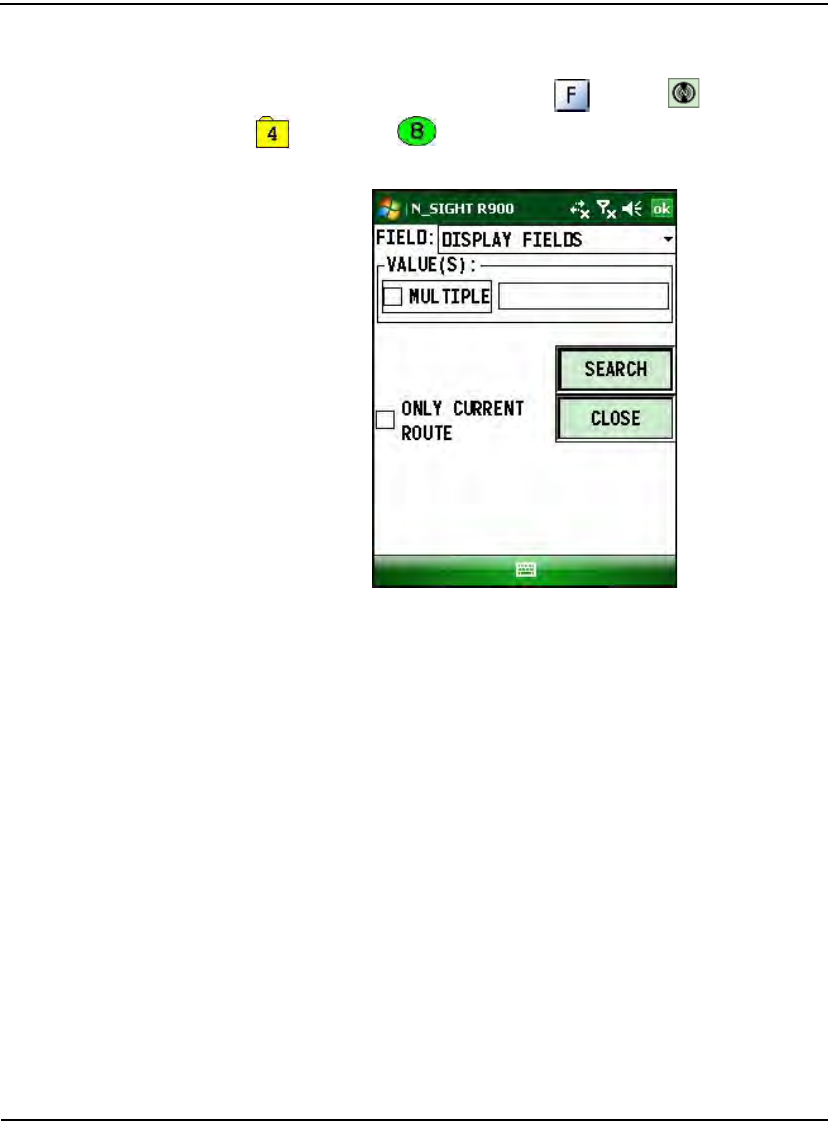
Overview of the Neptune Handheld System
2-20 N_SIGHT R900 User’s Manual for the Neptune Handheld System
While you are on a reading entry screen, if you want to search to find a
specific account, you must first press or press Start, then
Route, then Find Order.to display the Search screen.
Figure 2.10 Search Screen
You can then select which field to search through, then enter the search
criteria to locate a specific account or group of accounts.
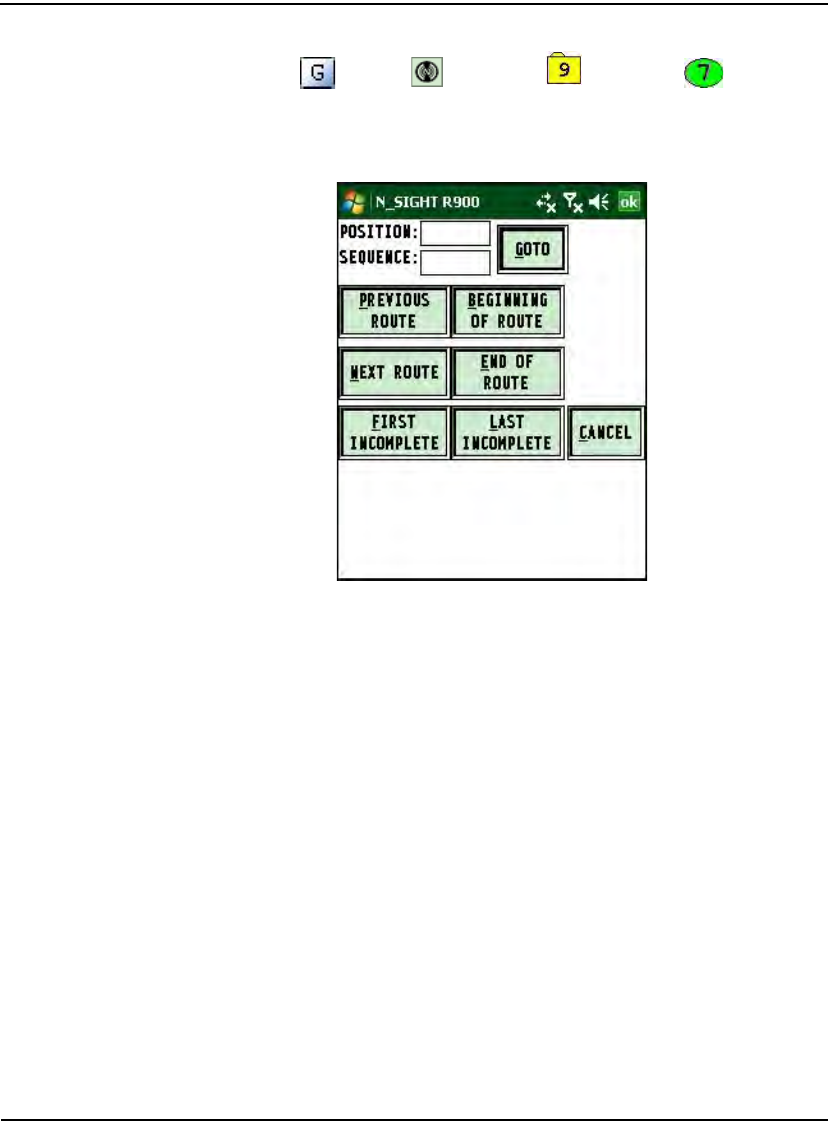
Overview of the Neptune Handheld System
N_SIGHT R900 User’s Manual for the Neptune Handheld System 2-21
Press or click Start, then Move, then GoTo to
quickly maneuver through a route, such as going to the beginning of a
route or to the end of a route to display the GoTo screen. The handheld
goes to that point.
Figure 2.11 GoTo Screen
On this screen you can go to the following points on a route:
• Position of the meter within the route
• Sequence number of the meter
• Previous route
• Next route
• Beginning of the route
• End of the route
• First incomplete read
• Last incomplete read

Overview of the Neptune Handheld System
Notes
2-22 N_SIGHT R900 User’s Manual for the Neptune Handheld System
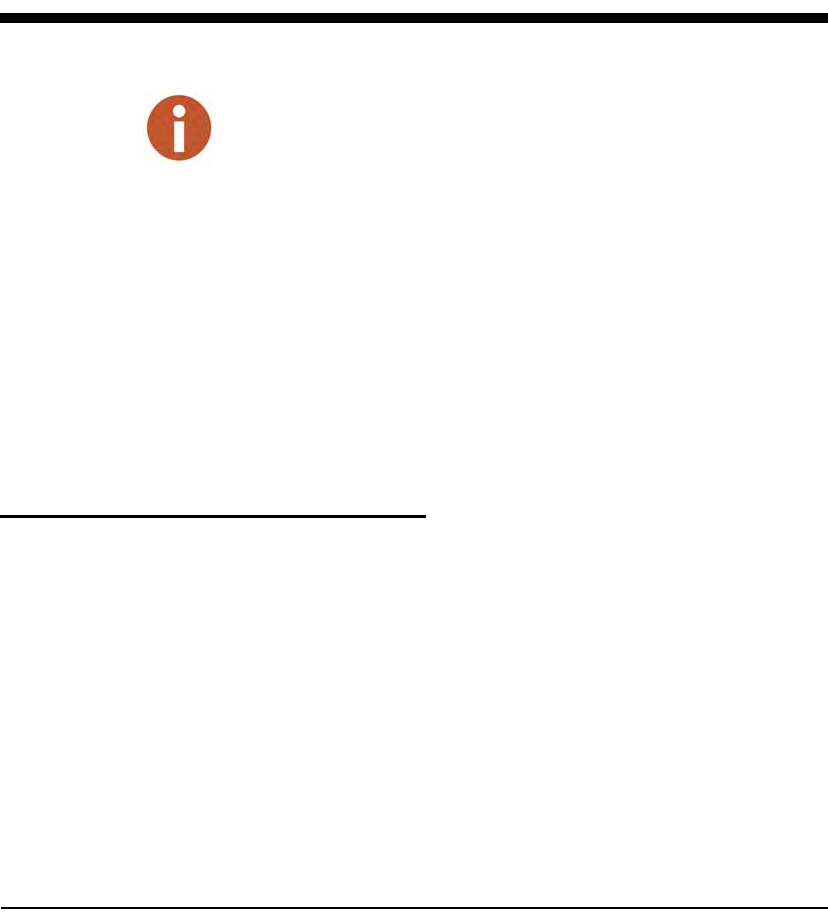
N_SIGHT R900 User’s Manual for the Neptune Handheld System 3-1
3 Using the CE5320 Handheld
This chapter provides basic instructions for unpacking and inspecting
the CE5320 handheld. It also gives instructions for setting up the
CE5320 handheld and becoming familiar with the keyboard and display.
This chapter also provide help to get started with your CE5320 handheld
so that you can begin collecting information from the field and
exchanging information with the host computer.
In addition, this chapter gives procedures for changing the system
settings, which affects how the handheld displays and accesses data.
Although these settings are preset by Neptune to meet the needs of most
meter reading processes, you can change some of the settings so that
they better suit your needs.
Determining the System Configuration
Although the handheld requires no installation, you do need to connect
the unit to a power supply to charge its battery and to a host computer to
allow it to communicate. How you make these connections depends
upon how you have configured your meter reading system.
The CE5320 handheld has one basic system configuration that is used
for local communications. A communication cradle is the most
commonly used method to charge and exchange data with a handheld.
See “Setting Up the CE5320,” on page 3-3. With this configuration,
If you want to set up and configure the Nomad handheld, see “Using the Nomad
Handheld,” on page 4-1
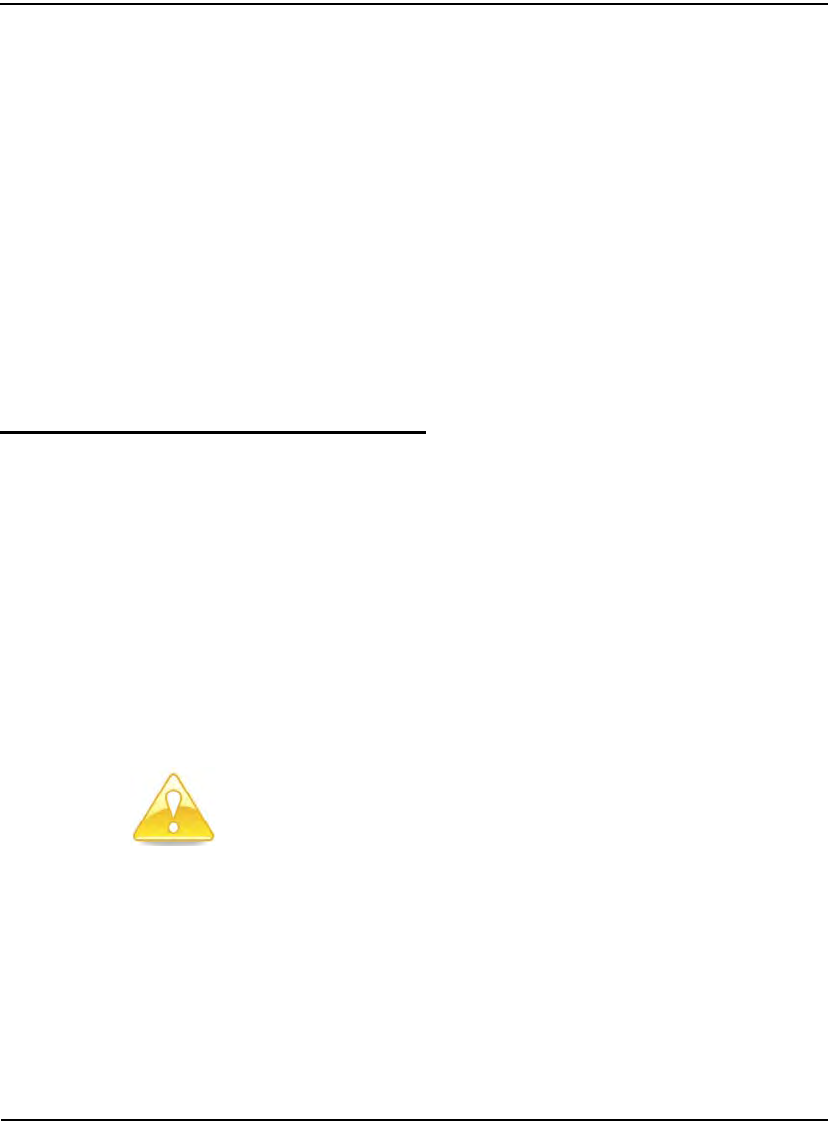
Using the CE5320 Handheld
3-2 N_SIGHT R900 User’s Manual for the Neptune Handheld System
whenever the handheld is placed in a communication cradle, its battery
begins recharging, and it is ready to exchange data with the host
computer.
Local and Remote Communications
The configuration previously described is used for local operations,
where the handheld and its communications equipment are directly
connected to the host computer. The cradle can also be used for remote
operations where the handheld and its communications equipment are in
an office remote from the host computer. In this situation, the remote
units are connected through the Internet to the host computer by an
Ethernet cable. After the connection is established, only the software on
the host computer and on the handheld need to be set up to manage a
communications exchange.
Unpacking and Inspecting Equipment
Besides using normal care, you need no special instructions to unpack
the handheld or the equipment that you purchased with it.
Check that you have received all the items you need for the type of
system configuration that you are using and inspect the items for
shipping damage. If you detect any damage, return the damaged
equipment to Neptune. Instructions for shipping the handheld to
Neptune are given in “Returning your Neptune Handheld System,” on
page 9-28 of this manual.
Save the packing box that was used to ship the handheld. Should you ever
need to ship the handheld, you need to repack the unit in its original shipping
box. The handling involved in land and air transport often subjects the
handheld to impact beyond that which occurs during normal use. The packing
box is designed to absorb shocks and protect the handheld during shipping.
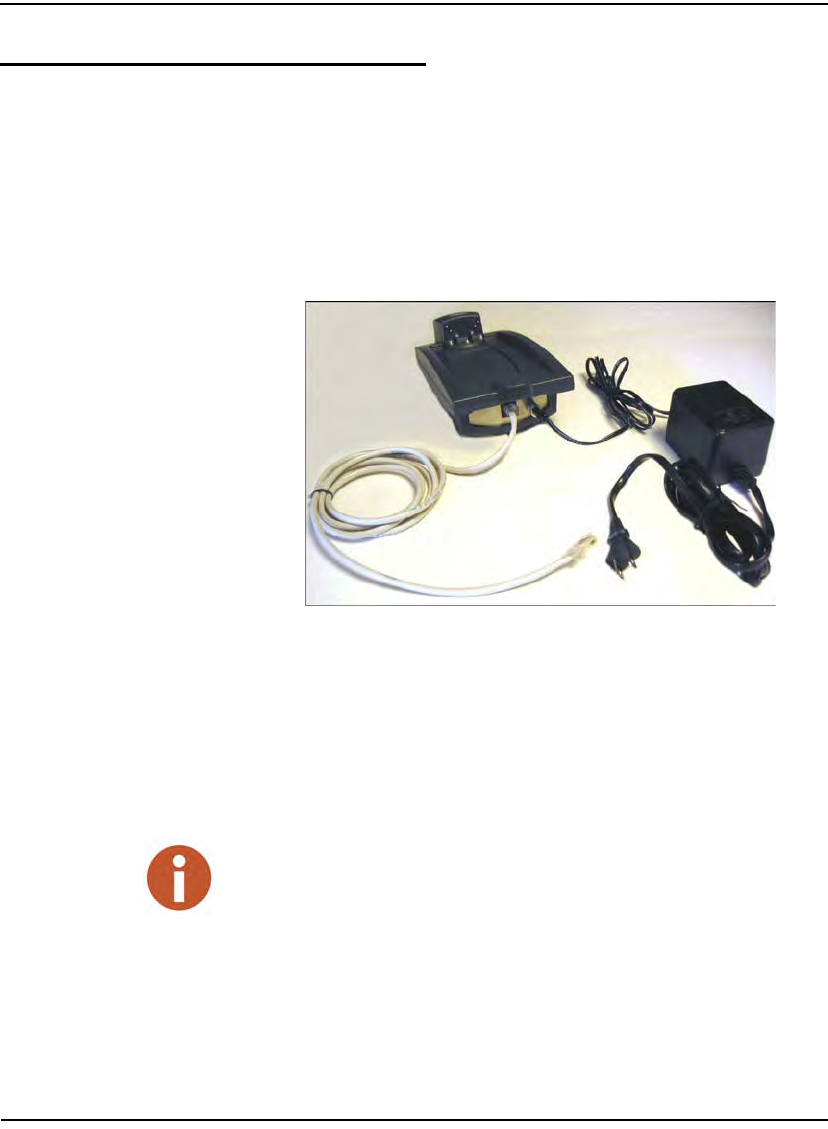
Using the CE5320 Handheld
N_SIGHT R900 User’s Manual for the Neptune Handheld System 3-3
Setting Up the CE5320
The following section describes how to set up your CE5320 so that you
can begin using it.
One CE5320 and a Communication Cradle
If you are using a communication cradle to power and exchange
information with one handheld at a time, check that you have received
the following items.
Figure 3.1 Cradle and Charging Kit
• One CE5320 handheld computer.
• A cradle-charging kit, which is required for operation and is usually
ordered with the unit. It includes an AC adapter/battery charger
cable.
An Ethernet cable is required for communication; however, it is not included
in the kit.
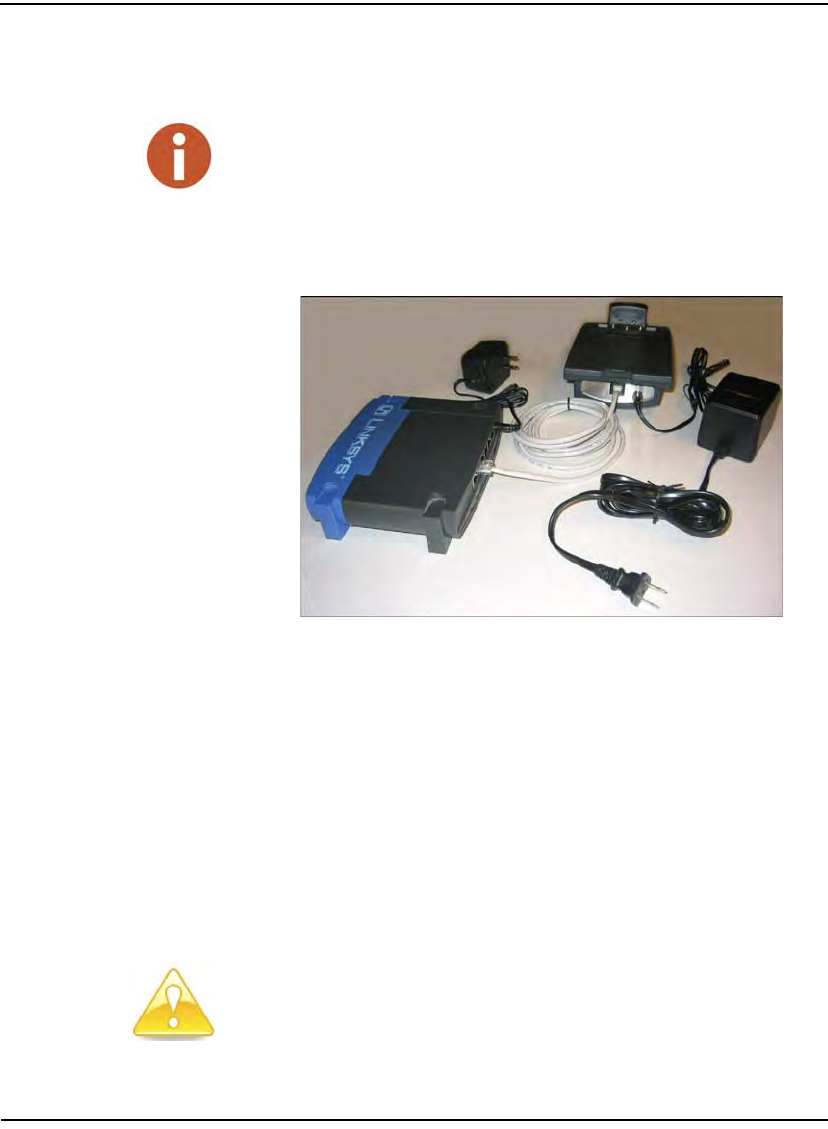
Using the CE5320 Handheld
3-4 N_SIGHT R900 User’s Manual for the Neptune Handheld System
The Router
If you are using a router to link cradles to exchange information with
more than one CE5320 at a time, check that you have the following
items.
Figure 3.2 Cradle, Router, and Cables Needed
• One or more CE5320 handheld computers.
• One communication cradle for each CE5320.
• One AC adapter/battery charger cable.
• One RJ45 Ethernet cable for each communication cradle.
• One RJ45 Ethernet cable to connect the router to the Personal
Computer (PC).
• One AC power supply cable.
It is important that the router you use has the capability to work as a switch.
In order for the Communications function to work properly, a stan-
dard RJ45 Ethernet cable must be used.
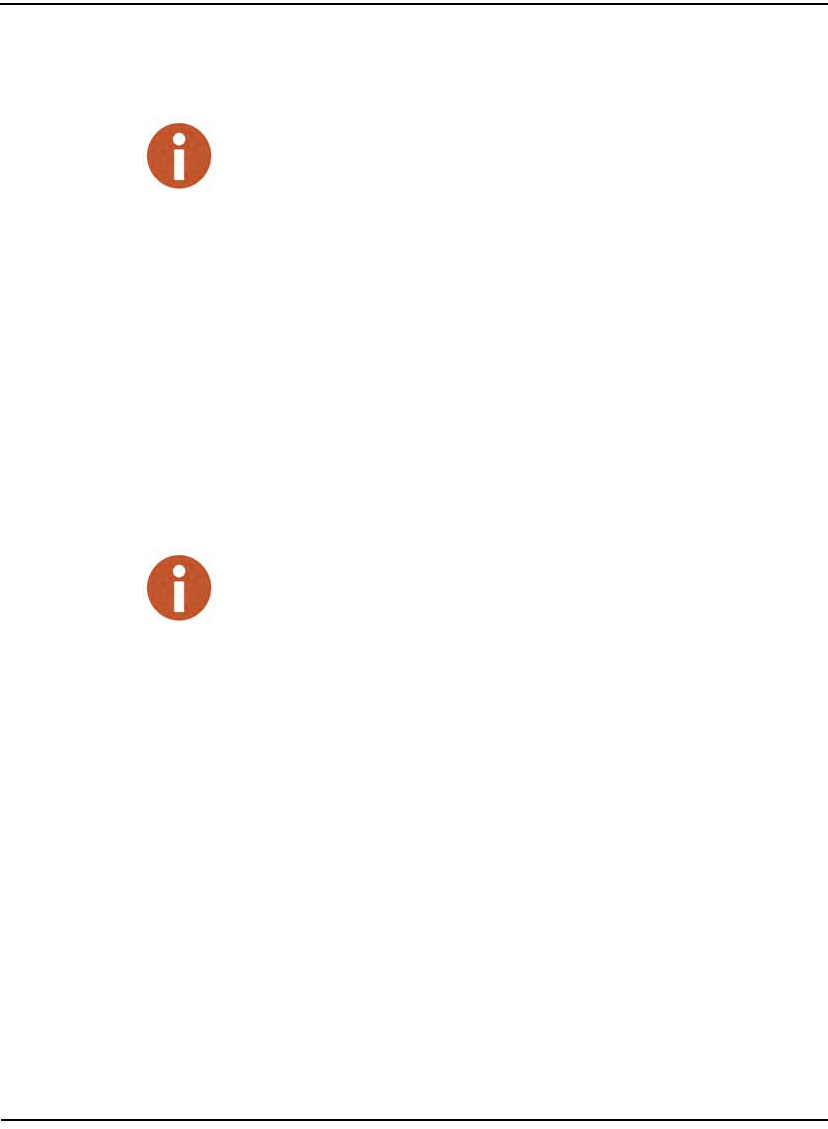
Using the CE5320 Handheld
N_SIGHT R900 User’s Manual for the Neptune Handheld System 3-5
Connecting to the Host Computer and Power Supply
The procedures in this chapter describe how to connect the CE5320 to
the host computer so that it can exchange information with the host. The
procedures also describe how to connect a power supply to the
communications cradle so that you can recharge the battery. Complete
the following procedures to connect the equipment you have.
Connecting the Router, CE Handheld Cradle, and Power
Supplies
You need no special tools to connect the devices that were shipped with
your handheld. Follow this procedure to connect the router,
communication cradles, and power supplies.
1 If you have not already done so, make sure that you have all of the
equipment you need. If necessary, refer to the preceding section
“Unpacking and Inspecting Equipment,” on page 3-2.
2 With the host computer OFF, connect the power supply to the
router.
This configuration is for handhelds not connected to a system network. If you
are connected to a system network, see the network specialist or your System
Administrator for assistance.
It is important that the router you use has the capability to work as a switch.
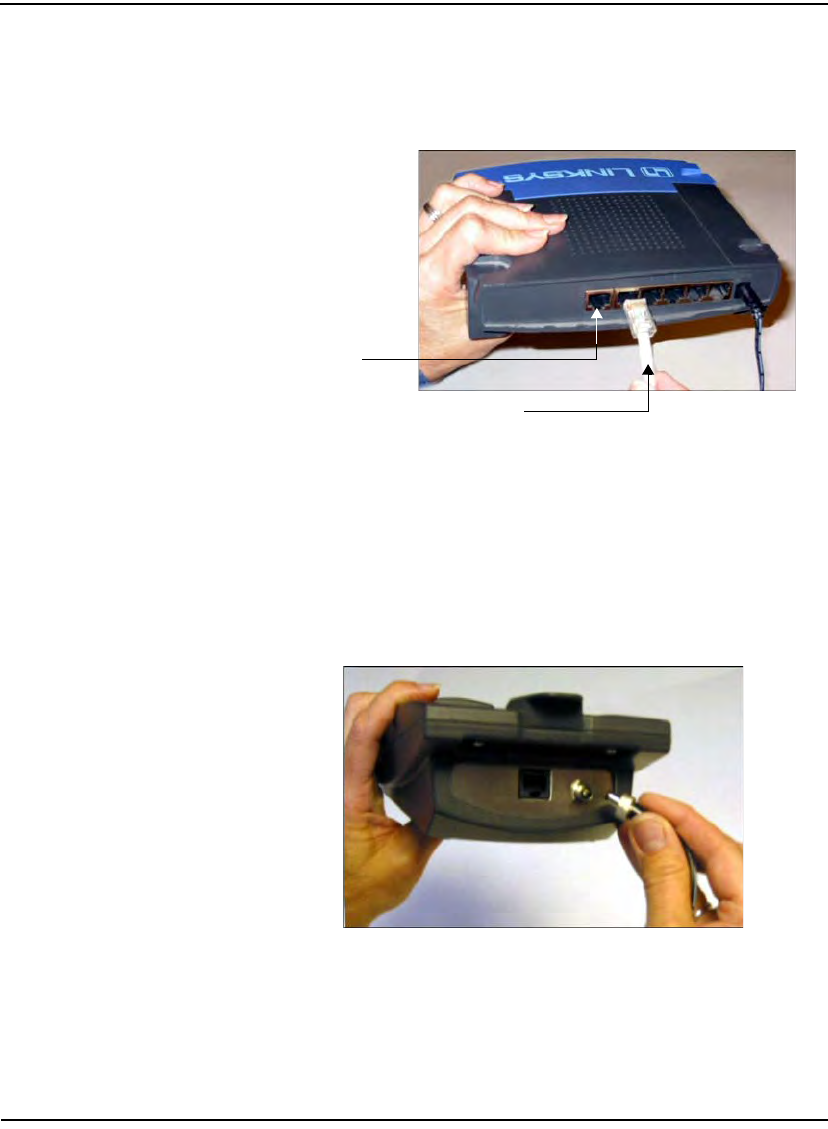
Using the CE5320 Handheld
3-6 N_SIGHT R900 User’s Manual for the Neptune Handheld System
3 Leaving the far left port empty, connect one end of the RJ-45
Ethernet cable into one of the four slots in the router. See Figure
3.3.
Figure 3.3 Connecting RJ-45 Ethernet Cable to Router, Port 1
4 Connect the other end of the Ethernet cable to the host computer.
5 Push the single-hole connector of the 110V AC adapter/battery
charger onto the single-prong connector on the back of the
communication cradle.
Secure the connector by turning its grooved lock-nut clockwise
until you feel resistance. See Figure 3.4.
Figure 3.4 Connecting the Power Cable to the Communications Cradle
6 Connect the other end of the AC adapter/battery charger into a
power source.
Always leave far left
port empty
RJ-45 Ethernet cable
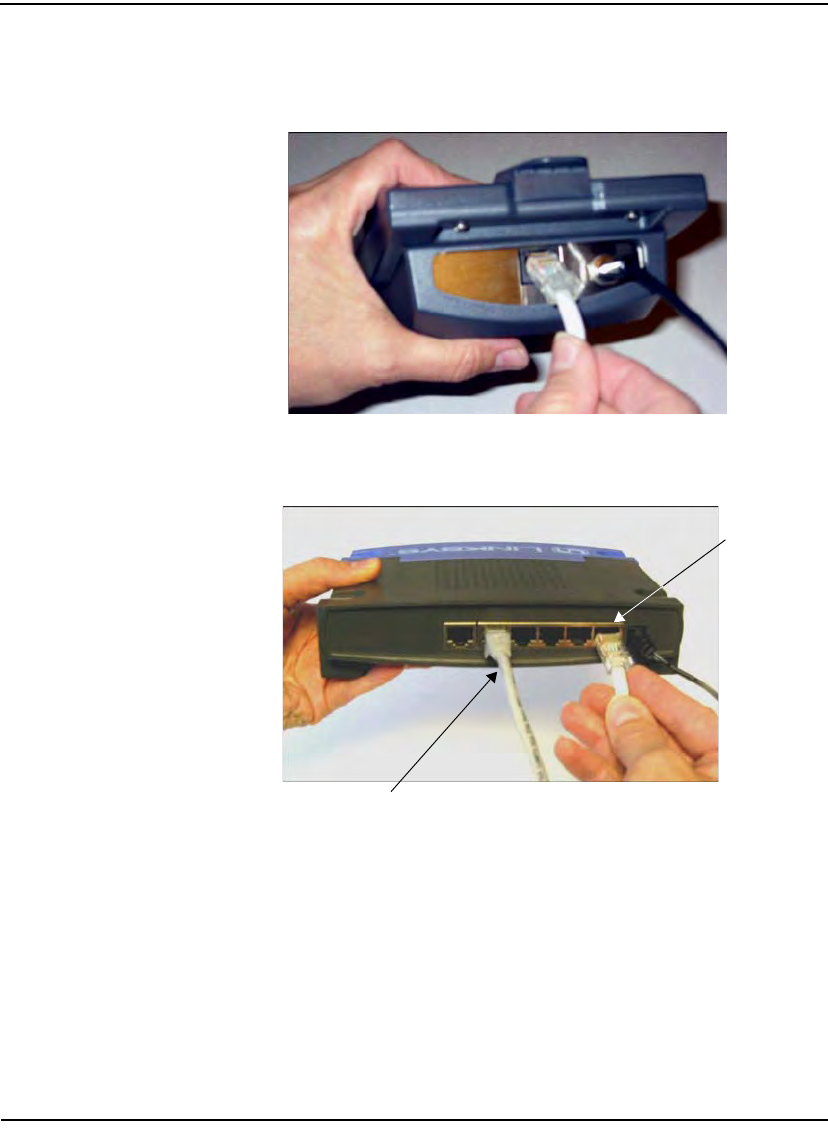
Using the CE5320 Handheld
N_SIGHT R900 User’s Manual for the Neptune Handheld System 3-7
7 With an additional Ethernet cable, insert one of its connectors into
the back of the cradle and the other the other end into the back of
the router. See Figure 3.5.
Figure 3.5 Connecting the Ethernet RJ-45 Cable to the Cradle
8 Connect the network cable to the single router.
Figure 3.6 Network Cable Connection
RJ-45 Ethernet cable to host computer
Network cable
from cradle
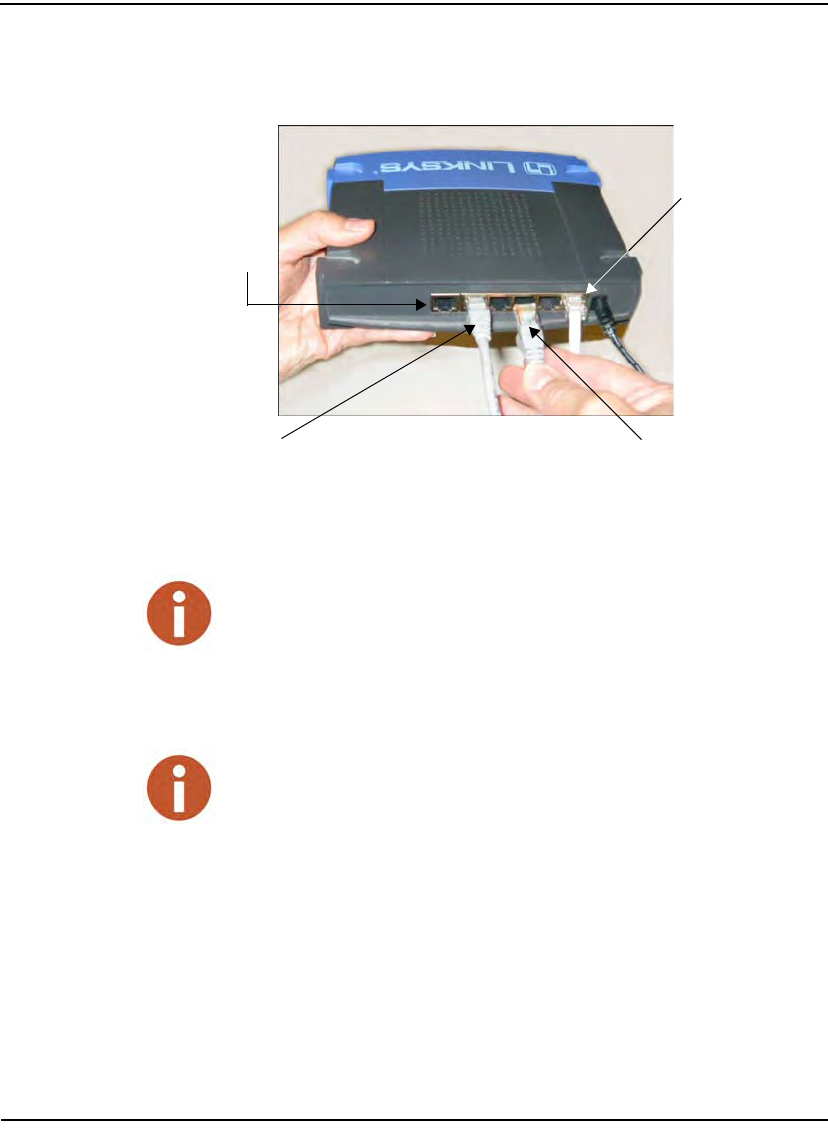
Using the CE5320 Handheld
3-8 N_SIGHT R900 User’s Manual for the Neptune Handheld System
9 To connect additional cradles to a router, repeat steps 7 and 8, using
the available ports on the router. See Figure 3.7.
Figure 3.7 Connecting Multiple Handheld Cradles to Router
Network cable from
cradle 1
RJ-45 Ethernet cable to another
handheld cradle or another router
Always leave far
left port empty
RJ-45 Ethernet cable to
host computer
Port number 1 is always reserved for the network cable, and the port marked
Internet is always kept empty.
You can connect another router to the main router you are using by
connecting one end of an additional Ethernet cable into an open port on the
main router and the other end to an open port on the additional router.

Using the CE5320 Handheld
N_SIGHT R900 User’s Manual for the Neptune Handheld System 3-9
Configuring the CE5320 Handheld
On the Host Computer
1 On the Host Computer, right-click on My Computer.
2 Select Properties
3Click Computer Name.
4 Record the computer name for the Host Computer here:
___________________________________________________
5Click Start, then Run.
6Type CMD and press Enter.
A DOS window appears.
7Type ipconfig and press Enter.
8 Write the IP address here: _____________________________
9Type exit and press Enter to close the DOS window.
On the CE5320 Handheld
1On the N_SIGHT R900 Login screen, press M or touch Menu.
Before proceeding with this section, you must complete the information for the
handhelds in two tables within the N_SIGHT R900 host software: Handhelds
and Reader ID. Refer to the N_SIGHT R900 Online HTML Help for the steps
to complete this information in these tables.
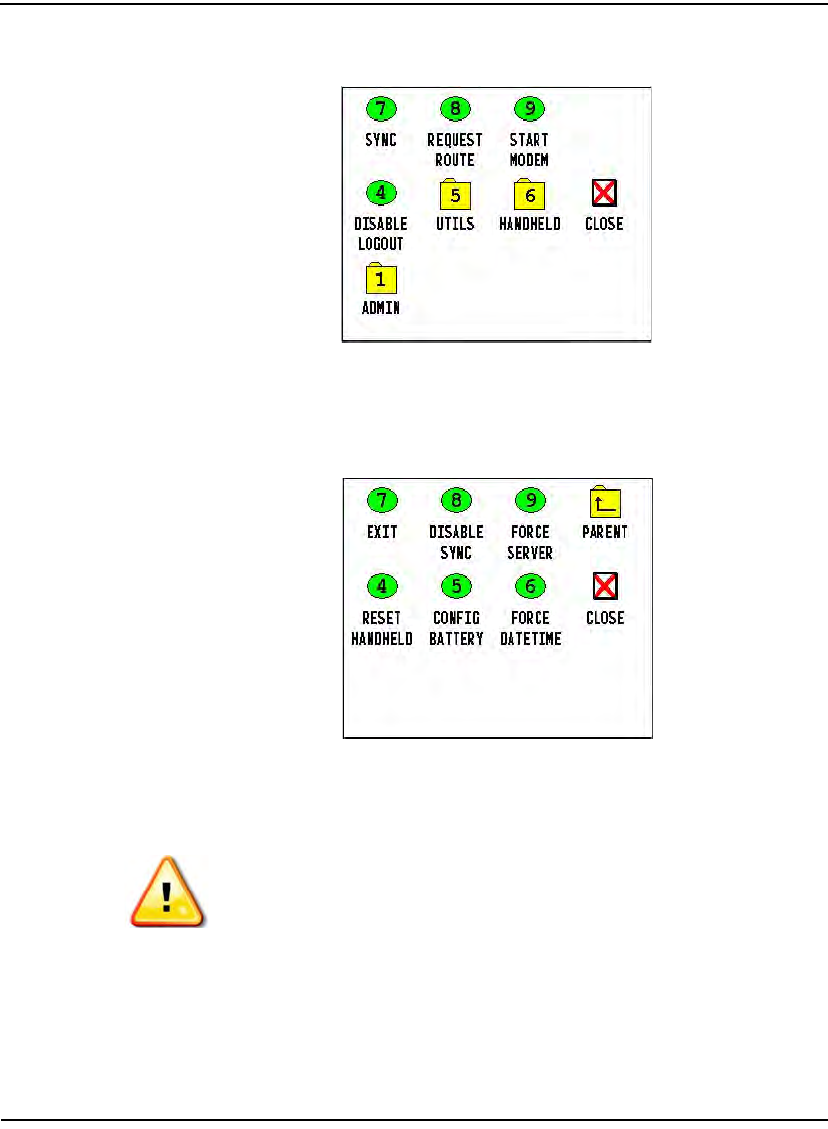
Using the CE5320 Handheld
3-10 N_SIGHT R900 User’s Manual for the Neptune Handheld System
The N_SIGHT R900 Main Menu screen appears.
Figure 3.8 N_SIGHT R900 Main Menu
2 Select 1, Admin.
The Admin Menu appears as illustrated in Figure 3.9.
Figure 3.9 N_SIGHT R900 Admin Menu
3 Select 4, Reset Handheld.
4Click Yes.
5 Leave the password field blank, or if required, type BUBBA.
6Click OK.
Do not press Reset Handheld if the handheld is not in the communica-
tions cradle.
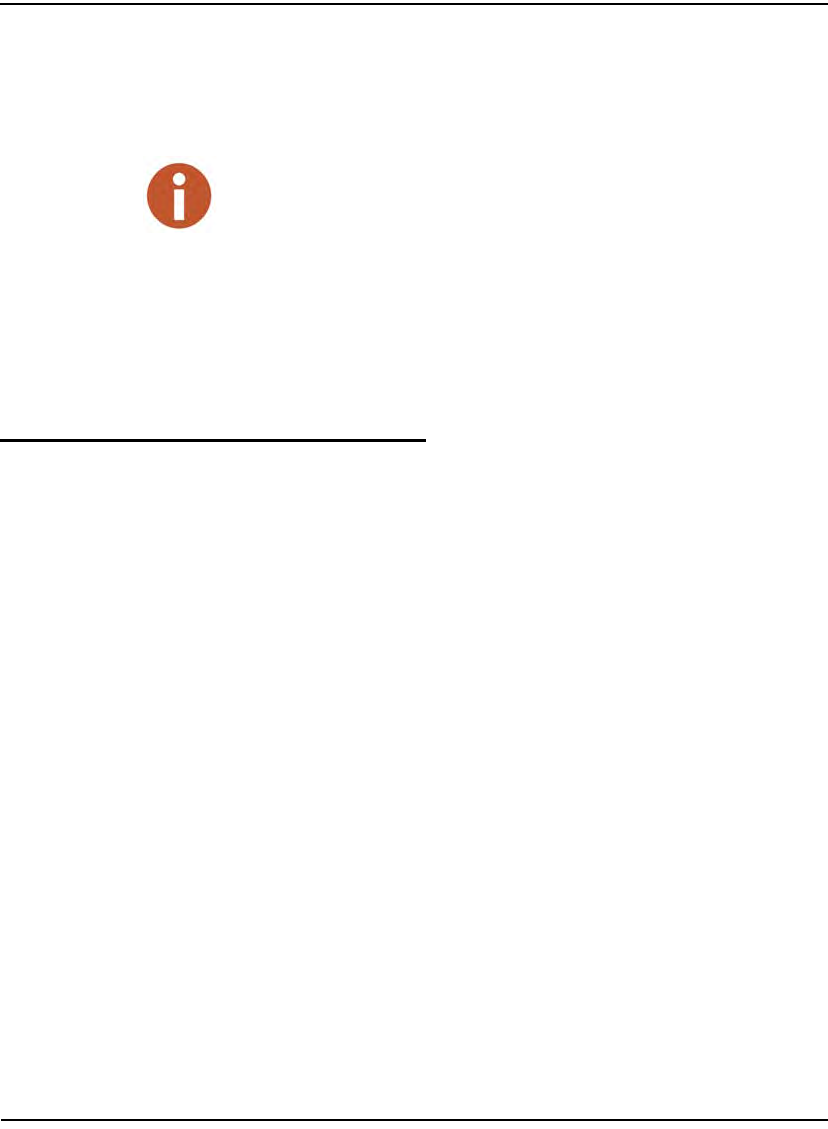
Using the CE5320 Handheld
N_SIGHT R900 User’s Manual for the Neptune Handheld System 3-11
The Communications Configuration screen appears.
7 Tab to the HHU ID field, and type the ID of the handheld.
8 Type the IP address in the Server Name field.
9 Be sure the Port is 25100.
10 Touch Connect or OK.
The N_SIGHT R900 Login screen appears.
The Display and Keyboard
This section describes the display and keyboard on the CE5320.
• The types of information that are shown in the display of the
handheld.
• An overview of how to use the keys to access different types of
information.
Learning the Keyboard
The CE5320 handheld uses 51 keys to give you access to all the stored
information and to allow you to enter new data. Most keys perform
more than one function.
The HHU ID number is located on the back of the CE5320 handheld under
the top part of the strap. It must also match exactly with what has been
entered in the host software for that particular handheld.
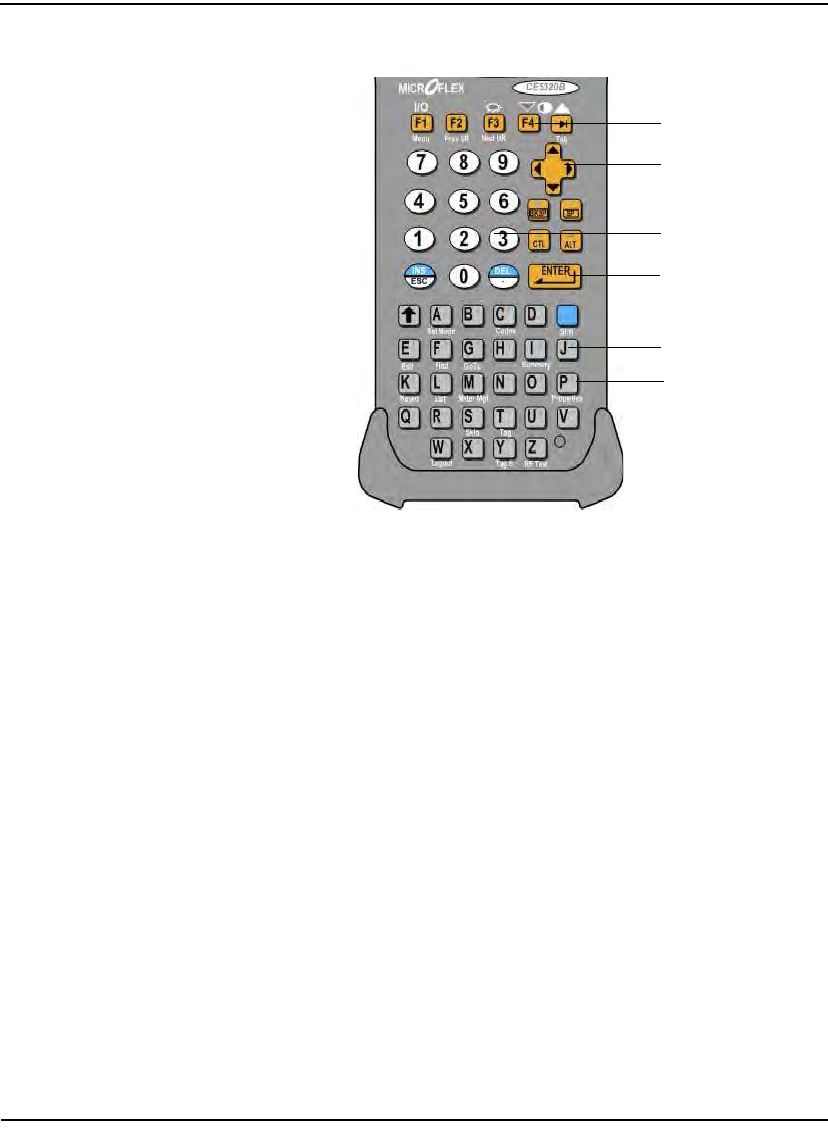
Using the CE5320 Handheld
3-12 N_SIGHT R900 User’s Manual for the Neptune Handheld System
Figure 3.10 Learning the Keyboard
•Function Keys or Hot Keys—allow you to perform special tasks
quickly.
•Direction Keys—allow you to move up or down a list of items and
to move forward or backward in a data-entry space or through the
meters of a route.
•Number Keys—allow you to enter a number in the display or to
select an item from a list of items shown.
•Quick Keys—allow you to execute a task quickly by pressing
certain keys at once or in a particular order.
•Letter/Character Keys—allow you to enter a letter or character in
a screen or to select an item from a list of items shown.
•Information Keys—allow you to enter, change, or view
information about a meter or a route.
Function keys
Direction keys
Number keys
Quick keys
Letter/character keys
Information keys
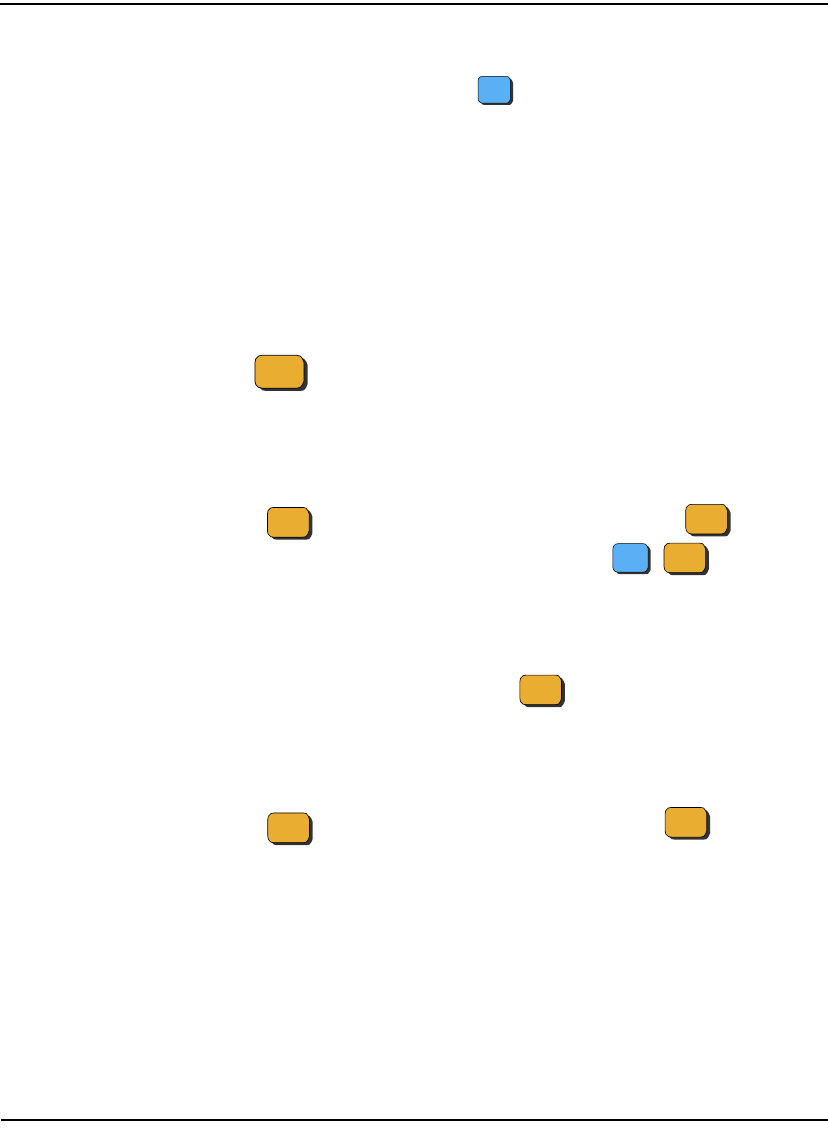
Using the CE5320 Handheld
N_SIGHT R900 User’s Manual for the Neptune Handheld System 3-13
To help you perform handheld tasks, the keyboard is color coded. For
example, by using the BLUE key in conjunction with keys that have
blue characters printed on them, you can enter a character, such as “?”
or “#”. Keys with black numbers or letters are single-entry keys. To
enter the number or letter, simply press the key with the corresponding
number or letter. Keys that have information printed in white above
them allow you to enter or change specific information about a meter or
route.
Because the CE5320 automatically disables inappropriate keys, the type
of task that you can perform from the keyboard depends upon the type
of menu that is displayed.
Function Keys
The function keys on the CE5320 are the top row of yellow keys that are
labeled with an F (for function) and a number. Function keys allow you
to perform special tasks quickly.
If the unit is powered off, pressing will power
it on and pressing BLUE while the unit
is on, will turn it off. The Help feature is not yet
supported.
In addition, allows you to access the Main
Menu for N_SIGHT R900, where you can access
the functions available to you while using the
CE5320 handheld.
While reading a route, pressing accesses the
previous incomplete reading.
F1
F1
F1
F1
F1
F2
F2
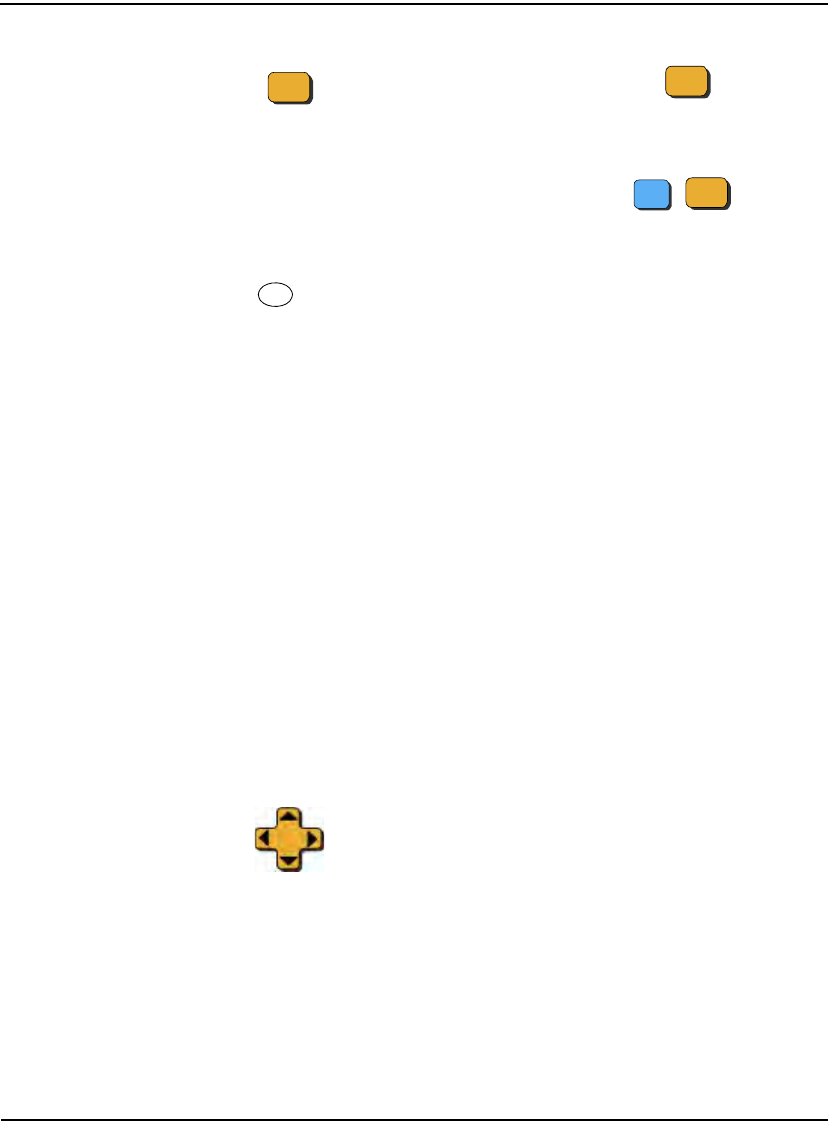
Using the CE5320 Handheld
3-14 N_SIGHT R900 User’s Manual for the Neptune Handheld System
Number Keys
The number keys on the handheld are used most often for entering
readings. Because entering readings is the primary function of users, the
number keys are larger than other keys and are placed near the top of the
keypad. Number keys enable you to complete one of two tasks:
• Enter a number in the display, such as for a reading.
• Select an item by pressing the number key that corresponds to a
numbered item in a list of items.
The type of task that you can perform using a number key depends upon
the type of screen that is displayed.
•Menu Screen—select a numbered item from the list by pressing
the key whose number corresponds to the item that you want to
select. (When used this way, the number key is called a hotkey.)
•Data-Entry Screen—enter a number in the data-entry screen by
pressing the key with the number that you want to appear in the
field.
Direction Keys
The direction keys on the handheld are used to move up or down
through a list of items displayed in a menu screen and to move forward
or backward within a data-entry space or through the meters of a route.
Pressing the direction key up or down displays additional screens for the
account, such as an account-specific hazard.
While reading a route, pressing accesses the
next incomplete reading.
In addition, pressing BLUE while the
unit is on accesses the backlight.
F3
F3
F3
3
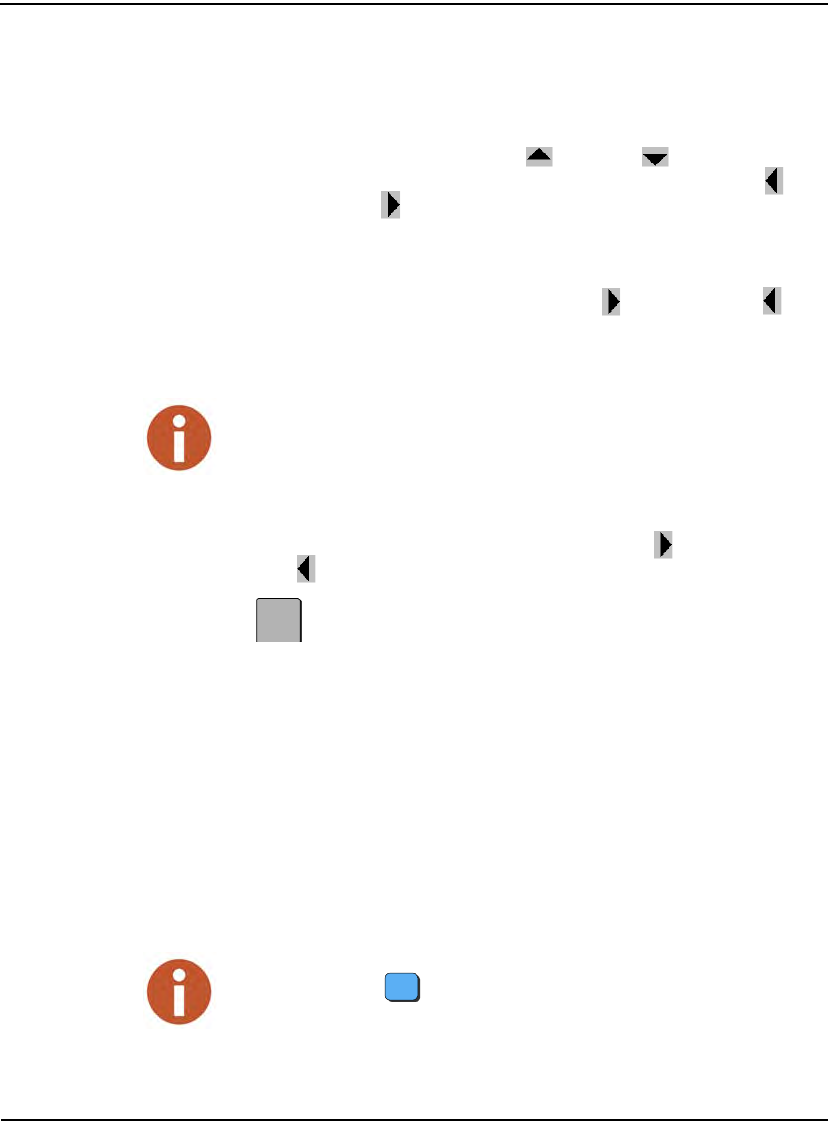
Using the CE5320 Handheld
N_SIGHT R900 User’s Manual for the Neptune Handheld System 3-15
The type of task that you can perform using a number key depends upon
the type of screen displayed.
•Menu Screen—highlights a numbered item in the list of items
displayed by pressing the UP or DOWN key to move
through the list of items. You can also use the BACKWARD or
FORWARD keys to jump to the first or last item in the menu. As
you reach an item, it becomes highlighted.
•Data-Entry Screen—moves forward or backward within a data-
entry space by pressing the FORWARD or BACKWARD key
to move forward or backward within the space.
• Reading-Entry Screen—display the reading-entry screen of the next
or previous meter by pressing the FORWARD or BACKWARD
key.
Letter/Character Keys
The letter/character keys on the handheld are the keys that are labeled
with the letters of the alphabet and with special characters, which are
printed in blue to the right of each letter. Letter/character keys enable
you to complete one of three tasks:
• Enter a letter in a data-entry screen.
• Enter a character in a data-entry screen.
• Select an item by pressing the key whose letter corresponds to the
item that you want to select.
Moving over existing letters or numbers will not erase them.
A<
Use the color coding to remember which keys to use with character keys:
press the BLUE key followed by a letter/character key (characters are
shown in blue on these keys) to display the character in the screen.
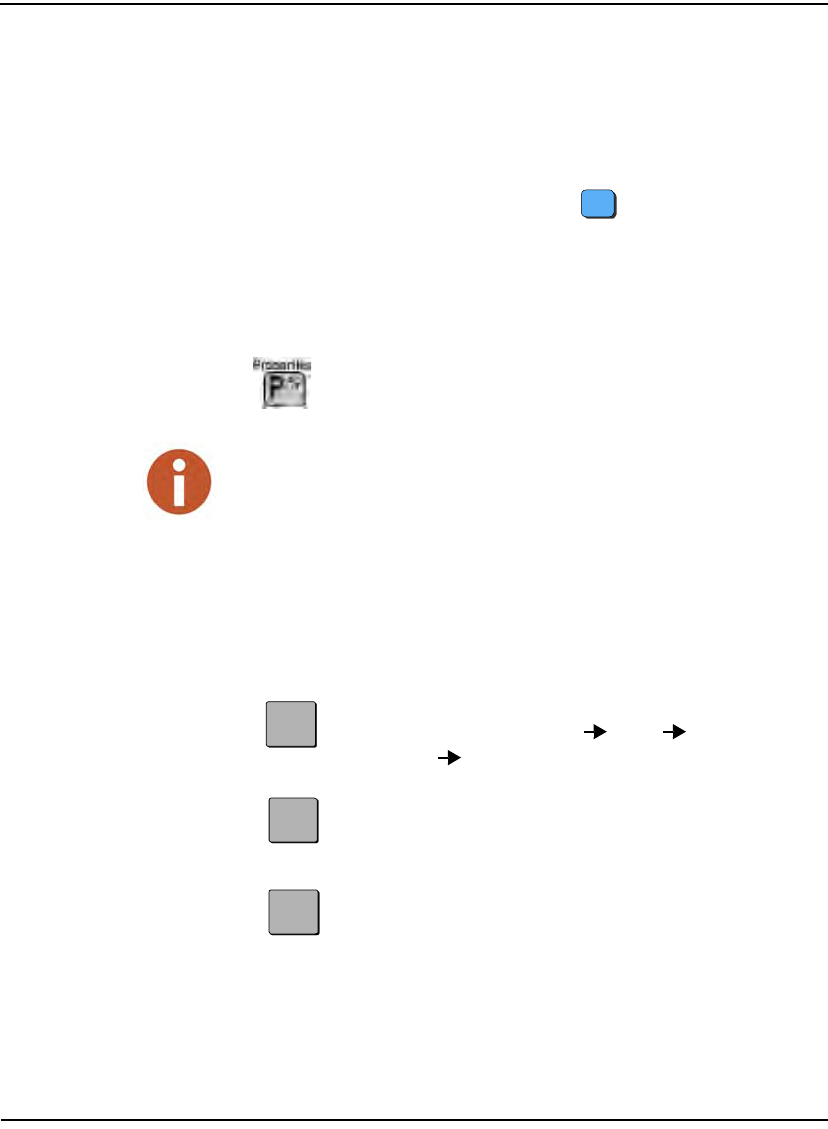
Using the CE5320 Handheld
3-16 N_SIGHT R900 User’s Manual for the Neptune Handheld System
•Menu Screen—select an item from the list by pressing the key
whose letter corresponds to the item that you want to select. (When
used this way, the letter/character key is called a hotkey.)
•Data-Entry Screen—enter a letter in the data-entry screen by
pressing the key of the letter that you want to appear in the data-
entry screen or by pressing the BLUE key followed by the letter
you want to appear in the display.
•Reading-Entry Screen—perform a function by pressing the key
over which the name of the function is printed in white (detailed
next).
Information Keys
The information keys on the handheld are the letter/character keys that
have information printed in white above them. You can enter, change, or
view the following information about a meter or a route by pressing the
appropriate key whenever a reading-entry screen is shown in the
display.
Information keys only work when logged into the handheld (Production
Mode).
Toggles between the Automatic Meter Reading
(AMR) mode: R900 Keyed Advantage
R300.
Accesses the Codes menu allowing you to enter
trouble codes or customer notes depending upon
the type of import file you are using.
Allows you to turn the Edit mode ON. In edit mode,
you can type information on screens that allow text
entry.
A<
C=
E[
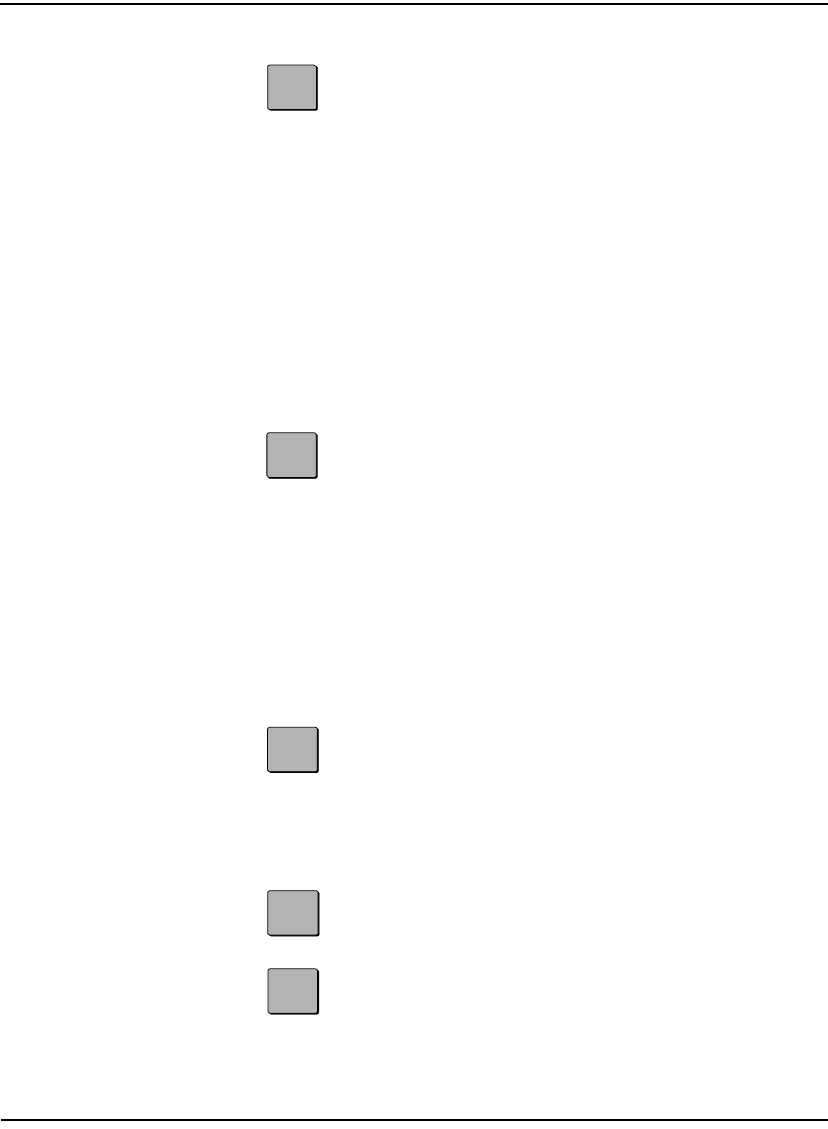
Using the CE5320 Handheld
N_SIGHT R900 User’s Manual for the Neptune Handheld System 3-17
Allows you to access the Search screen where you
can select criteria to look for information you need:
• Coded note
•Route
• Meter number
•Name
• Meter type
• Account status
• Sequence number
• Skip code
• Instruction code
• Account number
• Constant
•Tag
Allows you to access the GoTo screen. On this
screen, you can access the following information for
a meter or a route:
• Position of the meter within the route
• Sequence number of the meter
• Previous route
• Next route
• Beginning of the route
• End of the route
• First incomplete read
• Last incomplete read
Allows you to view summary information about the
route. When pressed with the CTL key, this key
allows you to view screen information for the
handheld, such as the version number, Internet
Protocol (IP) Address, Random Access Memory
(RAM), and storage.
Allows you to enter a reading manually.
Allow you enter List mode where the account
addresses are presented in list form, a convenient
way to browse through the accounts.
F]
G"
I@
K{
L}
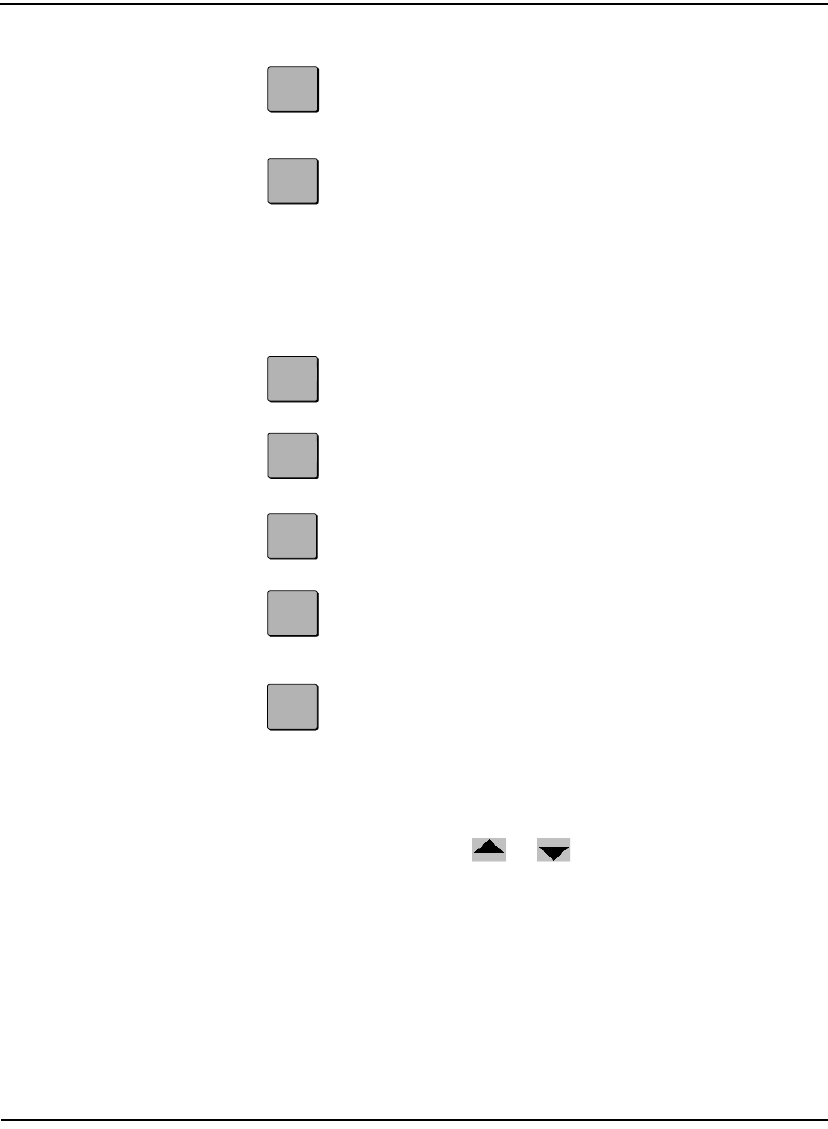
Using the CE5320 Handheld
3-18 N_SIGHT R900 User’s Manual for the Neptune Handheld System
You can use these keys only when a reading-entry screen is displayed.
For example, if the you need more information about this meter,
pressing the INFORMATION or keys while reading the account,
will take you to additional information. Once you display the
information you need, pressing these keys again returns you to meter’s
reading-entry screen.
Allows you to access the Meter Menu where you
can skip a reading, change meter information, and
enter information for a found meter.
Allows you to view the Properties information for the
handheld:
• Read direction
• Route dir
• Battery key clicks
•Date
•Time
Allows you to skip the reading for this account.
Allows you to tag the account, so that you can come
back to it later.
Allows you to log out of N_SIGHT R900 after
completing the required information.
Allows you to search for the accounts already
tagged.
Allows you to perform an RF test.
M:
P%
S’
T–
W;
Y`
Z´
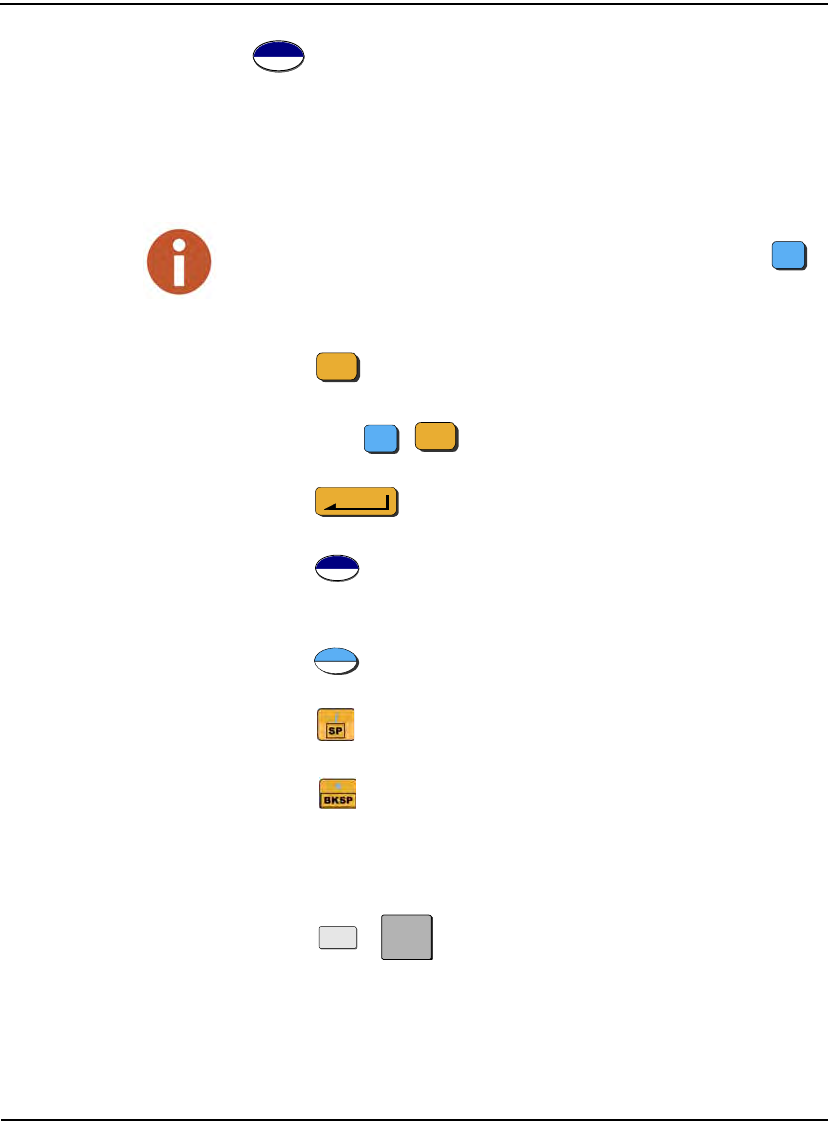
Using the CE5320 Handheld
N_SIGHT R900 User’s Manual for the Neptune Handheld System 3-19
Quick Keys
By pressing specific keys at once, or in a particular order, you can
execute a task quickly. Certain quick key tasks can be performed no
matter what type of screen is shown. The following table summarizes
tasks that you can perform using quick keys.
DEL
.
Use the color coding to remember which keys to use with quick keys that have
two functions: to activate the function printed in blue, press the BLUE
key first, and then press the key with a function printed in blue.
Press
To turn on the CE5320.
Press BLUE ,
To turn off the CE5320.
Press To enter a reading or select an item
from a menu screen.
Press To enter a decimal point. (This is
typically required only by “floating
point” meters.)
Press To return to the preceding screen.
Press To enter a space when entering a
special message or other data.
Press To erase a letter, number, or
character that you have entered.
As you backspace over each letter,
number, or character, each is
erased.
Press +
To show meter information on the
screen.
F1
F1
ENTER
DEL
.
DEL
.
ESC
INS
CTL
ALT
I@
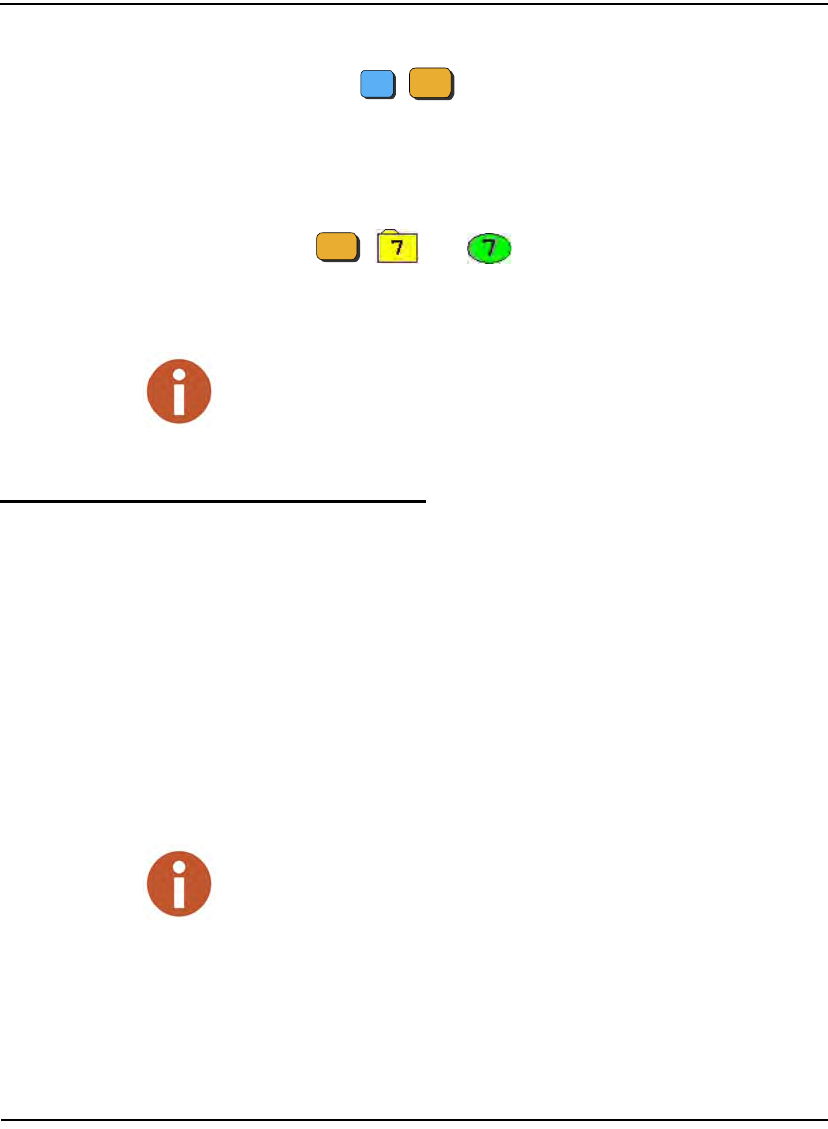
Using the CE5320 Handheld
3-20 N_SIGHT R900 User’s Manual for the Neptune Handheld System
Adjusting System Settings
System settings affect how the handheld displays and accesses data.
Although these settings are factory-set to meet the needs of most meter
reading processes, you can change some of the settings so that they
better suit your needs. These settings are typically set once and never
changed; however, you can adjust these settings any time.
Calibrating the Stylus
The CE5320 handheld has a touchscreen display that uses a stylus for
ease-of-use. Because each person’s touch differs, it is important to
calibrate the stylus to the touchscreen for the user’s own personal touch.
To calibrate the stylus, complete the following procedure.
1On the N_SIGHT R900 Login screen, press M or touch Menu.
Press BLUE , To backlight the display and the
keys, if your CE5320 Handheld has
the keyboard backlight option.
Pressing these keys again will turn
off the backlight. These keys work
as a toggle.
Press , , then To reboot the CE5320 Handheld.
F3
F1
Backlighting can drain the battery rapidly. To conserve the battery, use this
feature only in low light.
If you do not press a key within 45 seconds of activating this feature, the
CE5320 automatically deactivates the backlight to conserve battery power.
All functions are available without the stylus by using keyboard.
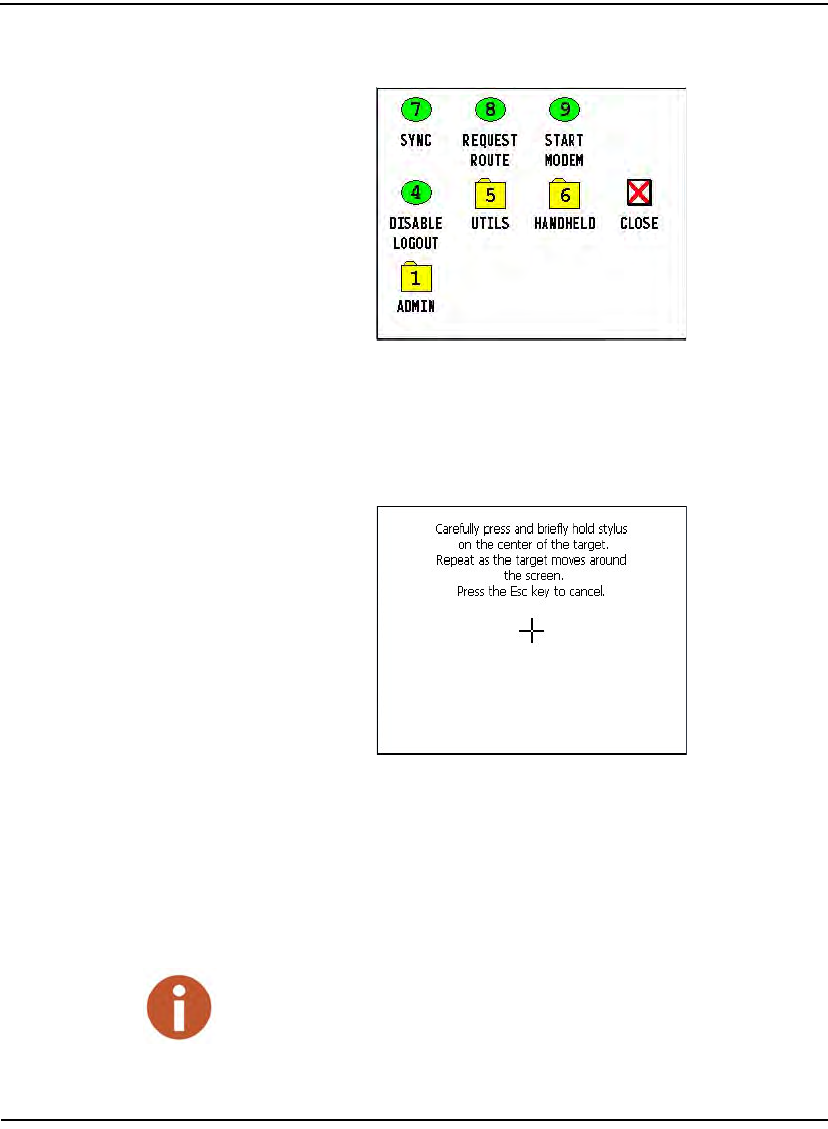
Using the CE5320 Handheld
N_SIGHT R900 User’s Manual for the Neptune Handheld System 3-21
The N_SIGHT R900 Main Menu screen appears.
Figure 3.11 N_SIGHT R900 Main Menu
2 Press 6 or touch item 6: Handheld.
3 Press 9 or touch 9: Stylus.
The Stylus Calibration screen appears like Figure 3.12.
Figure 3.12 N_SIGHT R900 Stylus Calibration Screen
Calibration is simply done by touching the center of the cross with
the stylus for a couple of seconds. When the cross moves to another
place, repeat the operation.
4 Hold your stylus on the cross until it moves.
Remember just to touch the screen; there is no need to press hard or to
punch it.
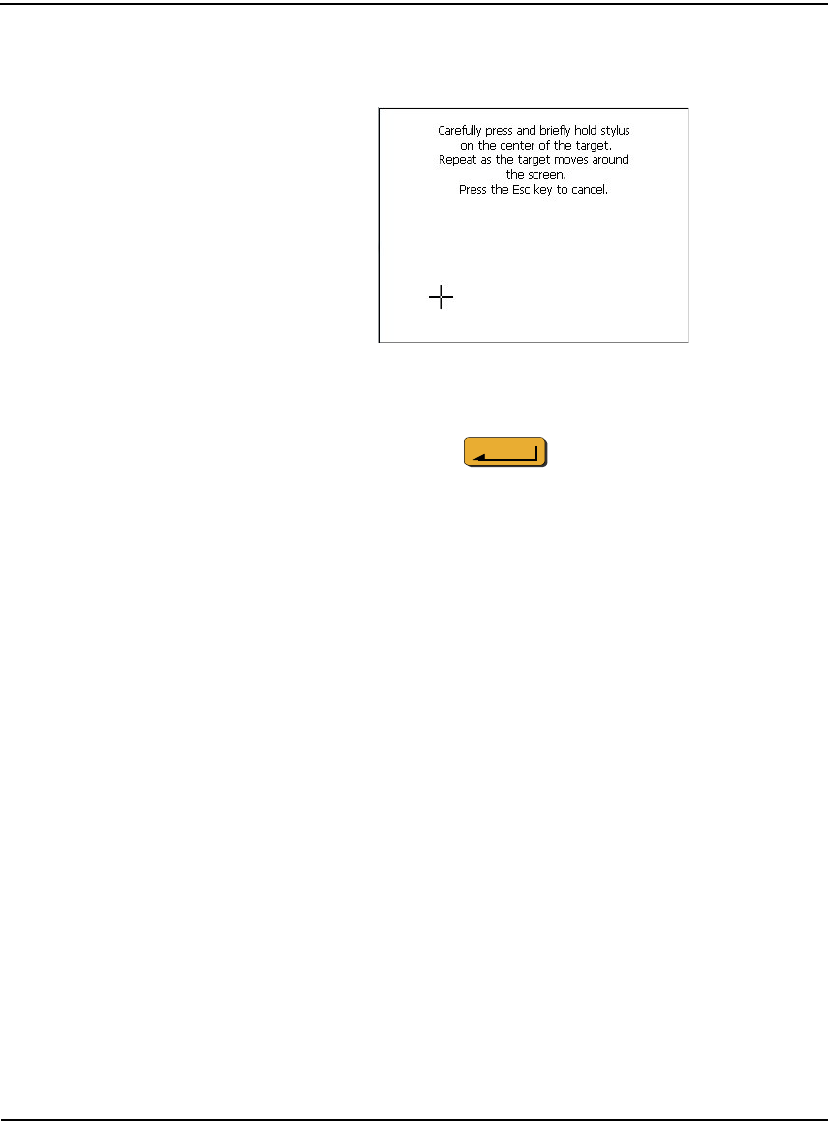
Using the CE5320 Handheld
3-22 N_SIGHT R900 User’s Manual for the Neptune Handheld System
The cross moves to another location on the screen similar to that
illustrated in Figure 3.13.
Figure 3.13 Stylus at Another Location on Screen
5 Repeat holding the stylus on the cross until it moves.
6 When finished, press .
The handheld returns to N_SIGHT R900 Main Login screen.
Changing the Handheld Properties
The section allows you to adjust or change the following properties for
the handheld:
• Key clicks
• Reading entry direction
• Route direction
Working with the Properties Screen
To access the Properties screen, complete these steps.
ENTER
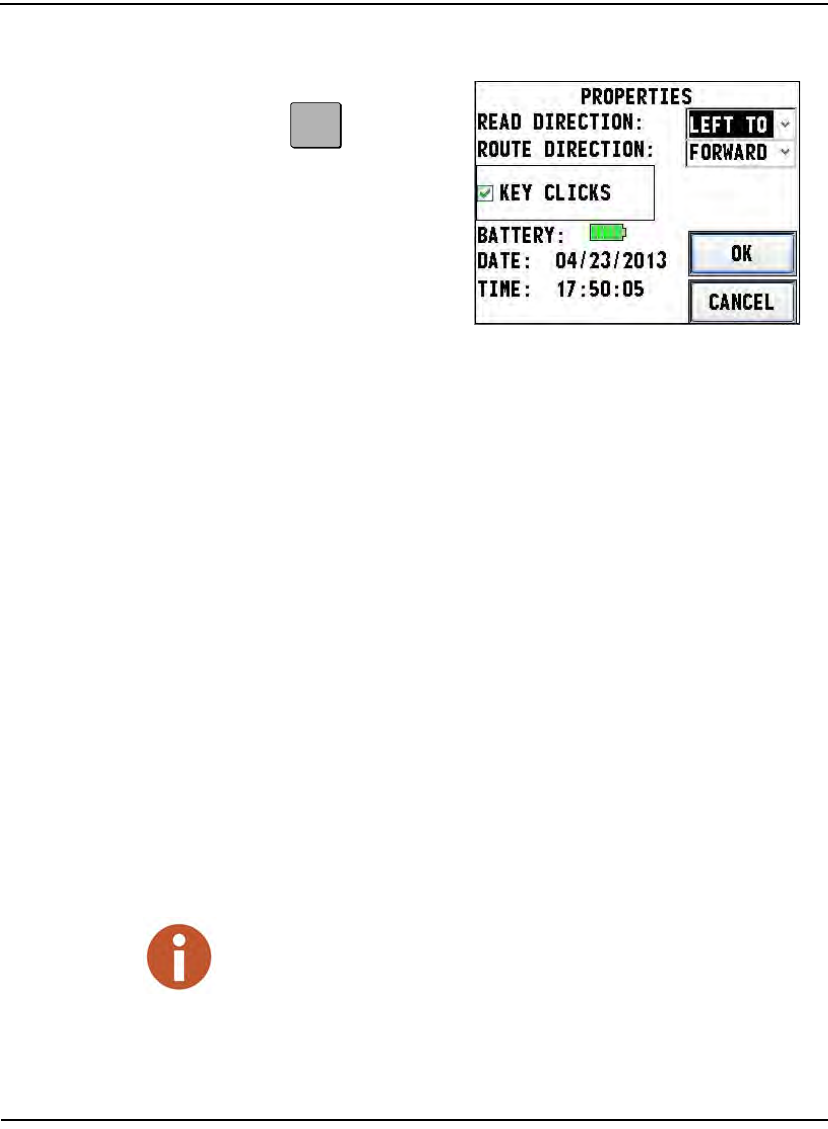
Using the CE5320 Handheld
N_SIGHT R900 User’s Manual for the Neptune Handheld System 3-23
1On any reading
entry screen, press
.
The Properties
screen appear as
illustrated in
Figure 3.14.
Figure 3.14 Handheld Properties Screen
2 Do one or both of the following:
• Proceed to “Changing the Reading Entry Direction,” in the
next section.
• Change the “Changing the Route Read Direction,” on page
3-24.
Changing the Reading Entry Direction
As you enter a reading in the handheld, each number can be displayed
from right to left or from left to right.
3In the Read Dir field, touch the down arrow and do one of the
following:
• Select LEFT TO RIGHT if you want the number to begin
from the left.
• Select RIGHT TO LEFT if you want the number to begin
from the right.
These setting toggle between Left to Right or Right to Left
according to the current setting.
P%
This procedure affects only accounts whose directions have not been set by
the host computer. If the reading-entry direction of an account has been set
by the host computer, the host setting replaces your setting.

Using the CE5320 Handheld
3-24 N_SIGHT R900 User’s Manual for the Neptune Handheld System
Changing the Route Read Direction
The handheld typically displays meters of a route from the first meter to
the last meter. However, you can change the order that meters are
displayed so that they are shown from the last meter to the first meter.
4In the Route Dir field, touch the down arrow and do one of the
following:
• Select FORWARD if you want the readings to advance to the
next unread account in the route.
• Select BACKWARD if you want to change the directions of
the readings to go backward to the previous unread account in
the route.
These settings toggles between Forward or Backward according to
the current setting.
Turning Key Clicks On and Off
The Key Clicks feature allows you to control how the handheld
responds when you press a key. When this feature is ON, the handheld
beeps whenever you press a key. Turning the Key Clicks feature on can
help you reduce errors by making sure that you press each key fully. If
you do not press a key fully, the handheld does not acknowledge your
entry. You can turn the Key Clicks feature on or off at any time.
5 Do one of the following:
• Select the checkbox to enable Key Clicks.
• Leave the checkbox empty to disable the Key Clicks.
These settings toggles between on (checked) or off (unchecked)
according to the current setting.
6 Touch OK to save your settings.
You return to the reading-entry screen or your previous screen.
Configuring RF/Serial Properties
Depending on the type of accounts on your route, you may have to
configure the RF antenna, the type of probe, or serial properties you are
using. Follow this procedure to configure or change the RF antenna, the
type of probe, or serial properties.
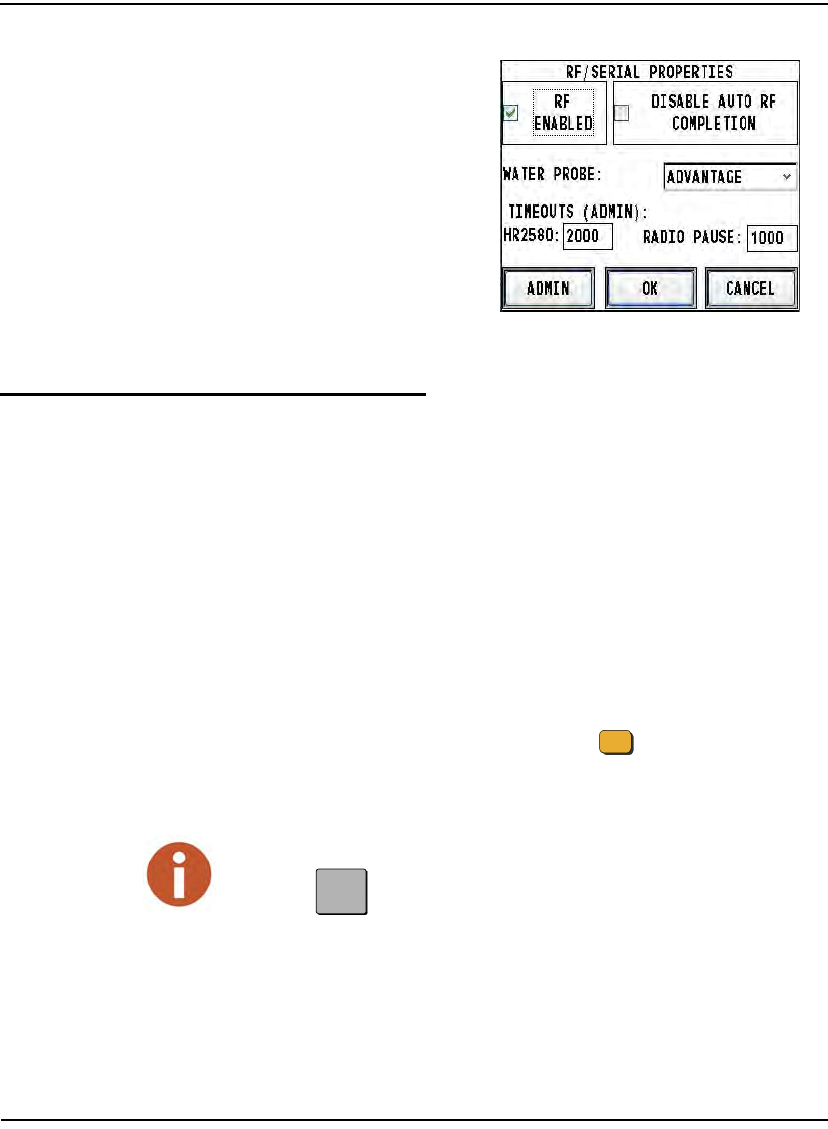
Using the CE5320 Handheld
3-26 N_SIGHT R900 User’s Manual for the Neptune Handheld System
The RF/Serial
Properties screen
appears as illustrated
in Figure 3.17.
Figure 3.17 RF/Serial Properties Screen
Logging In and Out of the N_SIGHT R900
This section explains how to log into N_SIGHT R900 on the handheld
to access the screens needed to complete meter reading tasks.
Logging Into N_SIGHT R900 on the CE5320
After you have loaded a route, or after you have exchanged meter
readings and route data with the host computer, you need to log into
N_SIGHT R900 on the handheld. Signing on gives you access to the
screens you need to collect and exchange route and meter data.
Complete the following steps to log into N_SIGHT R900 on the
CE5320.
1 If you have not already done so, press turn on the CE5320.
F1
If you see the message Not Uploaded, this means the handheld has
been loaded but not yet been unloaded. This is normal if a new route was just
loaded to the handheld.
Touch or Synchronize to start Communications. For more
information, refer to “Communicating with the Host Computer,” on page 7-1.
S’
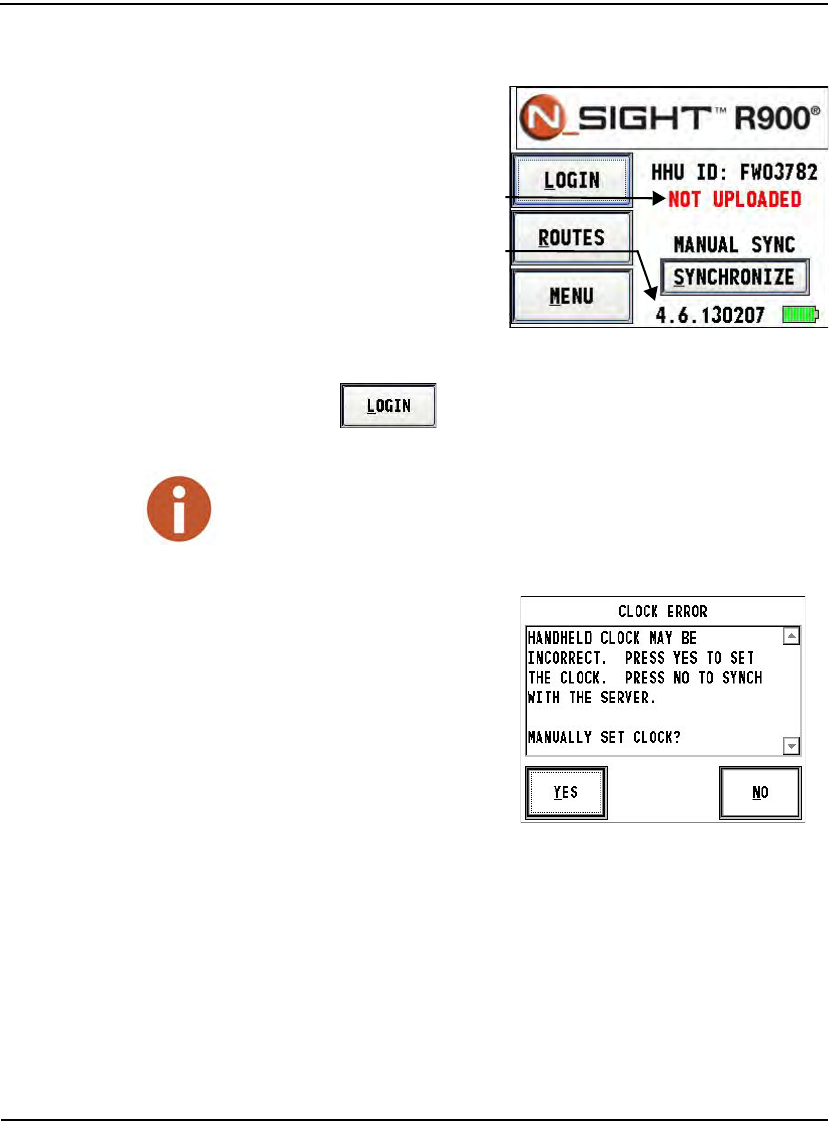
Using the CE5320 Handheld
N_SIGHT R900 User’s Manual for the Neptune Handheld System 3-27
You can see a message
like the one illustrated in
Figure 3.18.
Figure 3.18 N_SIGHT R900 Message Area
2Click .
A Clock Error screen
appears, prompting you
to log on to manually set
the clock, as illustrated in
Figure 3.19.
Figure 3.19 N_SIGHT R900 Clock Error Screen
Version number
Message area
There may be times when the Clock Error screen appears when you are
attempting to log in. When this screen appears, continue with the following
steps.
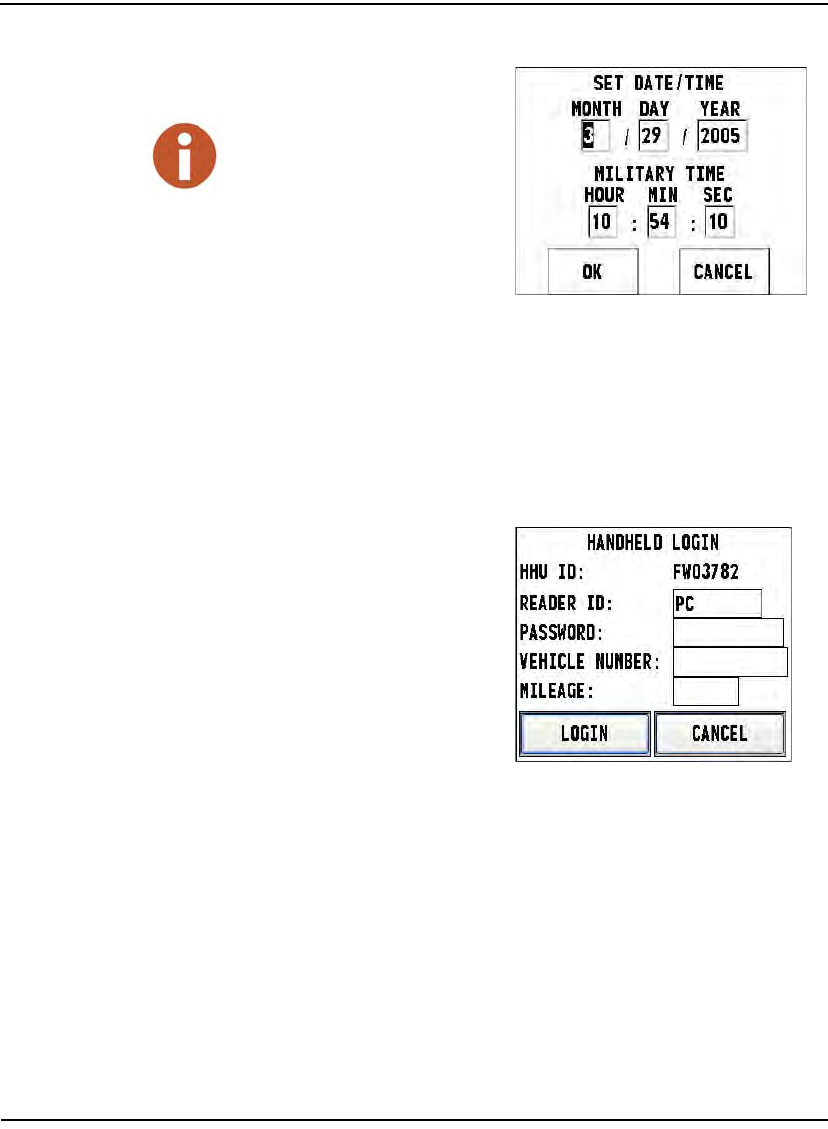
Using the CE5320 Handheld
3-28 N_SIGHT R900 User’s Manual for the Neptune Handheld System
3Click Yes.
After you click Yes, the
Set Date/Time screen
appears as illustrated in
Figure 3.20.
Figure 3.20 N_SIGHT R900 Set Date / Time Screen
4 If applicable, make any changes to the date and time.
The correct date and time to use is the date and time that the
handheld last synchronized.
5 When the date and time
are accurate, click OK.
The Handheld Login
screen appears as
illustrated in Figure 3.22.
Figure 3.21 N_SIGHT R900 Handheld Login Screen
The Reader ID field displays the information contained in the
N_SIGHT R900 software.
6 Complete the following information as applicable:
•Password (Determined by N_SIGHT R900 setup)
•Vehicle # (Optional)
•Mileage (Optional)
If you answer NO to the
clock error message, the
Login screen appears again.
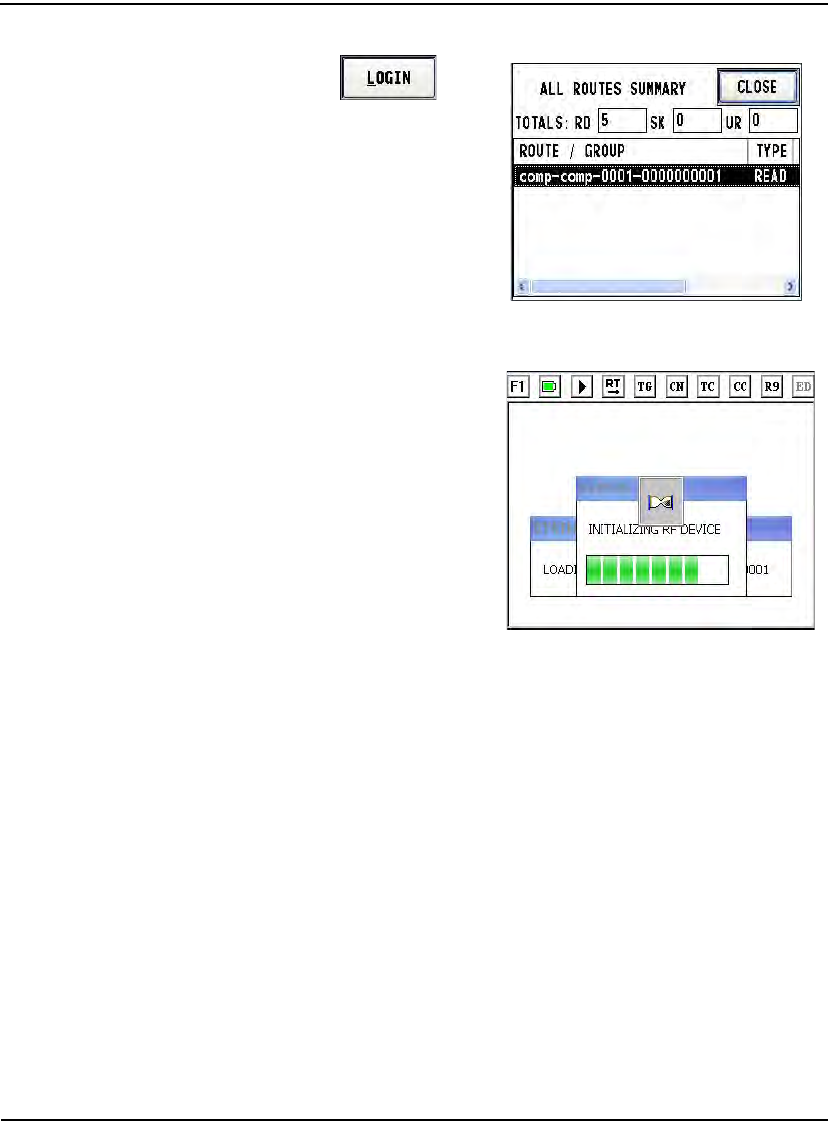
Using the CE5320 Handheld
N_SIGHT R900 User’s Manual for the Neptune Handheld System 3-29
7Click .
The Select Route screen
appears as illustrated in
Figure 3.22.
Figure 3.22 N_SIGHT R900 Select Route Screen
8Highlight the route you
want, and click OK.
A message appears
similar to the one
illustrated in Figure
3.23.
Figure 3.23 N_SIGHT R900 Initializing Message
When the software has finished initializing, a Reading Entry screen
indicating that the sign on process is complete and that the unit is
ready for use in collecting readings. See Figure 3.24.
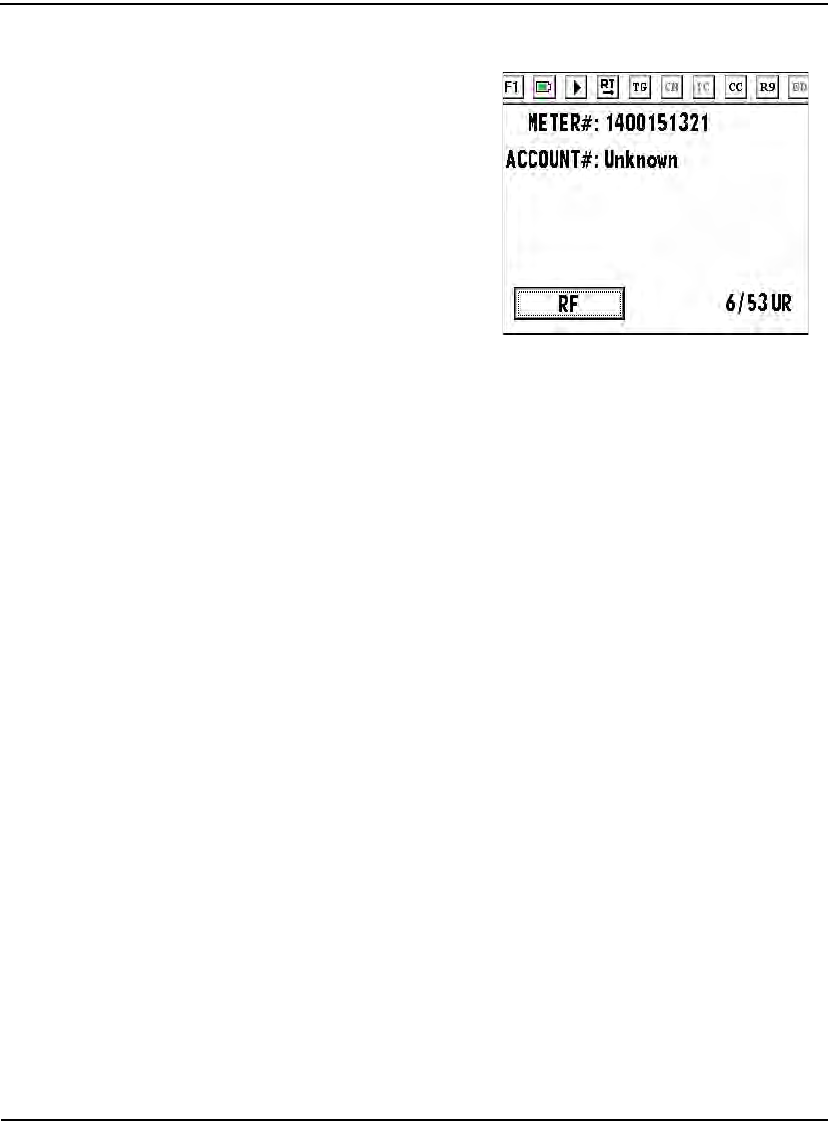
Using the CE5320 Handheld
3-30 N_SIGHT R900 User’s Manual for the Neptune Handheld System
For assistance in using
the CE5320 to collect
meter readings, refer to
“Gathering Route
Data,” on page 6-1.
Figure 3.24 N_SIGHT R900 Reading Entry Screen
Logging Out of N_SIGHT R900
The only time that you need to log out of N_SIGHT R900 on the
handheld is just before you begin exchanging information with the host
computer. Logging out gives you access to the communication features
of the handheld. Instructions for logging out on the handheld are
included in the procedures that describe how to exchange information
with the host computer. For more information, see “Exiting the
Software,” on page 7-1.
If you allow the handheld to remain inactive for the factory-set delay of
45 seconds or for the delay time specified by the host computer, it turns
off automatically. After this period of inactivity, the screen of the
handheld goes blank and the unit turns off to conserve the battery.
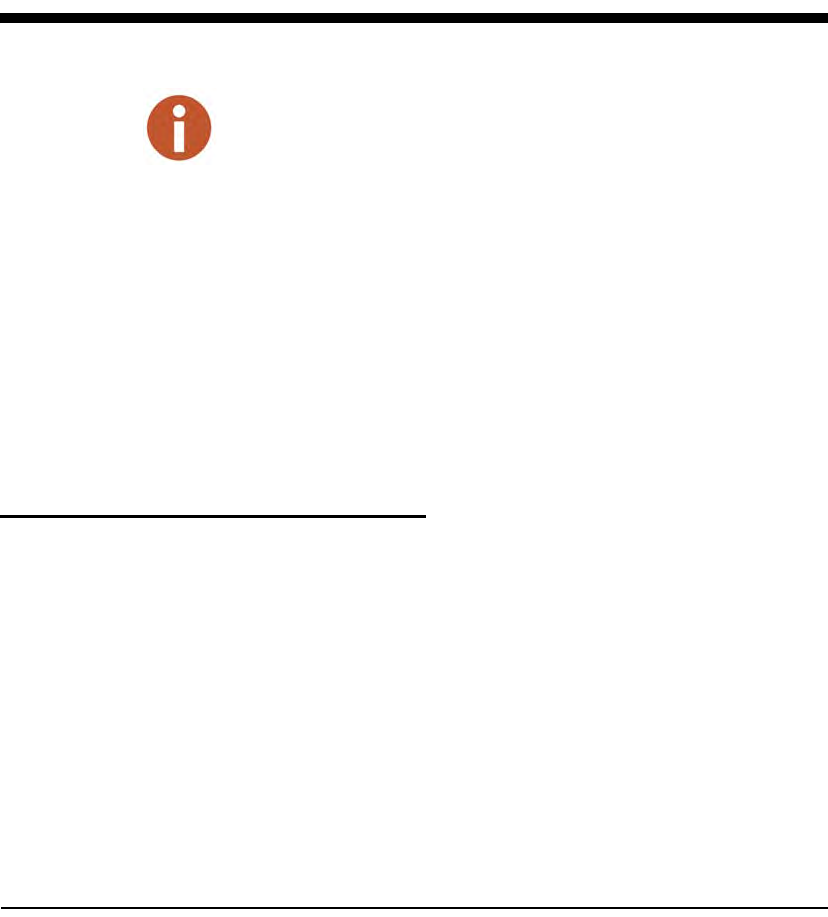
N_SIGHT R900 User’s Manual for the Neptune Handheld System 4-1
4 Using the Nomad Handheld
This chapter provides basic instructions for unpacking and inspecting
the Nomad. It also gives instructions for setting up the Nomad and
becoming familiar with the keyboard and display. This chapter also
provides help to get started with your Nomad, so that you can begin
collecting information from the field and exchange information with the
host computer.
In addition, this chapter gives procedures for changing the system
settings, which affects how the handheld displays and accesses data.
Although these settings are preset by Neptune to meet the needs of most
meter reading processes, you can change some of the settings so that
they better suit your needs.
Unpacking the Nomad
Besides using normal care, you need no special instructions to unpack
the handheld or the equipment that you purchased with it.
Check that you have received all the items you need and inspect the
items for shipping damage. If you detect any damage, return the
damaged equipment to Neptune. Instructions for shipping the handheld
to Neptune are given in “Returning your Neptune Handheld System,”
on page 9-28 of this manual.
If you want to set up and configure the CE5320 handheld, see “Using the CE5320
Handheld,” on page 3-1.

Using the Nomad Handheld
4-2 N_SIGHT R900 User’s Manual for the Neptune Handheld System
Inside the box with the Nomad is an Orientation Guide that exhibits the
contents:
•Hand strap
•Battery
• Trimble Nomad getting started disk
• AC adapter
• USB cable
• Stylus
• Screen protectors
• 4GB SD card (also included in the box)
The Guide shows you how to do the following:
• Install the battery
• Attach the hand strap
• Insert the SD card
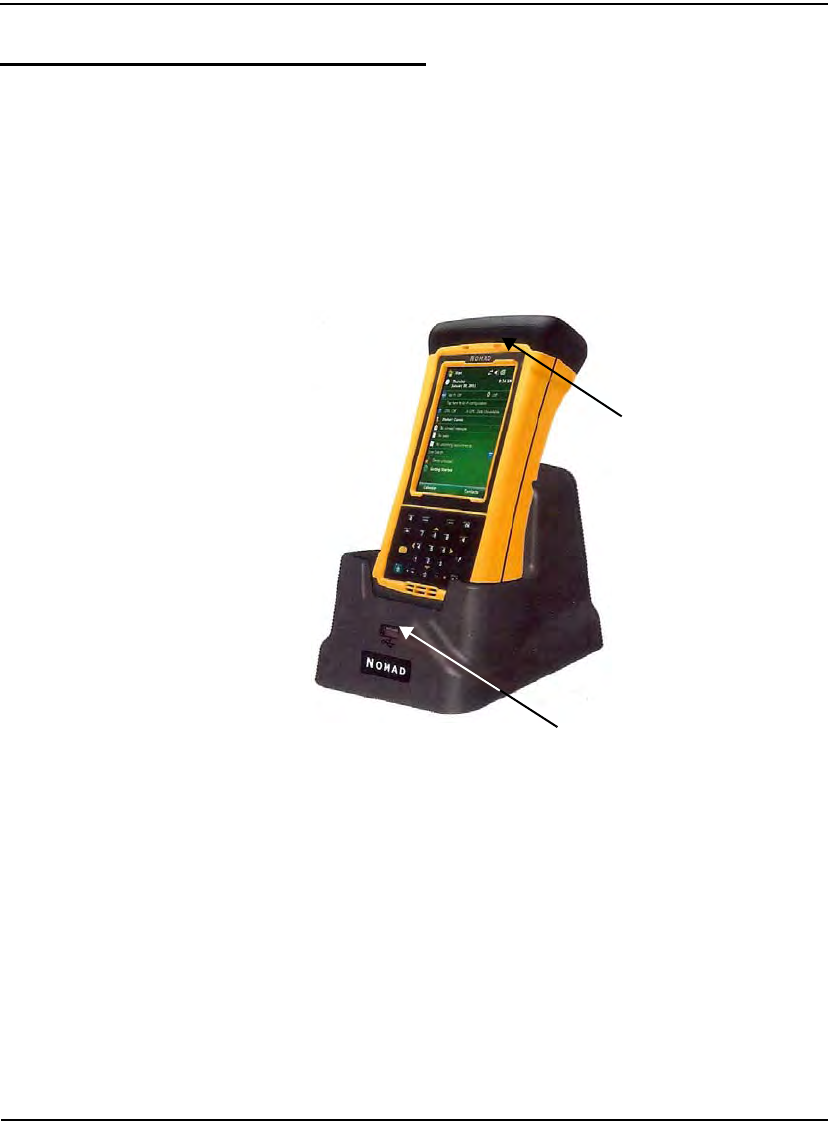
Using the Nomad Handheld
N_SIGHT R900 User’s Manual for the Neptune Handheld System 4-3
Setting Up the Nomad
The following section describes how to set up your Nomad so that you
can begin using it.
One Nomad and a Communication Cradle
If you are using a communication cradle to power and exchange
information with one handheld at a time, check that you have received
the following items.
Figure 4.1 Nomad and Cradle Charger
• One Nomad handheld computer.
• The charger that is included with the Nomad can be used to power
the Communications Cradle. If you want a separate charger, you
can order it as an accessory.
Battery LED
USB host
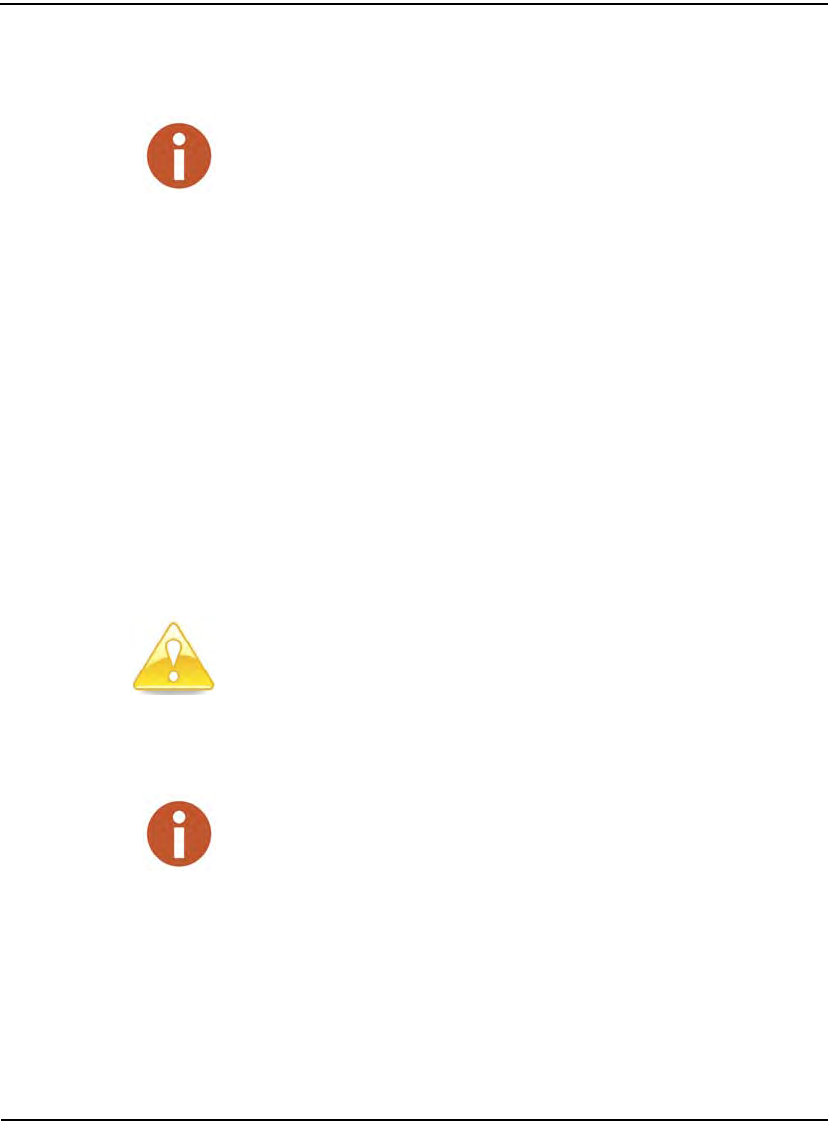
Using the Nomad Handheld
4-4 N_SIGHT R900 User’s Manual for the Neptune Handheld System
The Router
If you are using a router to link cradles to exchange information with
more than one Nomad at a time, check that you have the following
items:
• One or more Nomad handheld computers.
• One communication cradle for each Nomad.
• One AC adapter/battery charger cable for each cradle.
• One RJ45 Ethernet cable for each communication cradle.
• One RJ45 Ethernet cable to connect the router to the PC.
• One router/switch with one AC power supply cable.
Connecting to the Host Computer and Power Supply
The procedures in this chapter describe how to connect the Nomad to
the host computer so that it can exchange information with the host. The
procedures also describe how to connect a power supply to the
communications cradle so that you can recharge the battery. Complete
the following procedures to connect the equipment you have.
It is important that the router you use has the capability to work as a switch.
In order for the Communications function to work properly, a stan-
dard RJ45 Ethernet cable must be used.
This configuration is for handhelds not connected to a system network. If you
are connected to a system network, see the network specialist or your system
administrator for assistance.
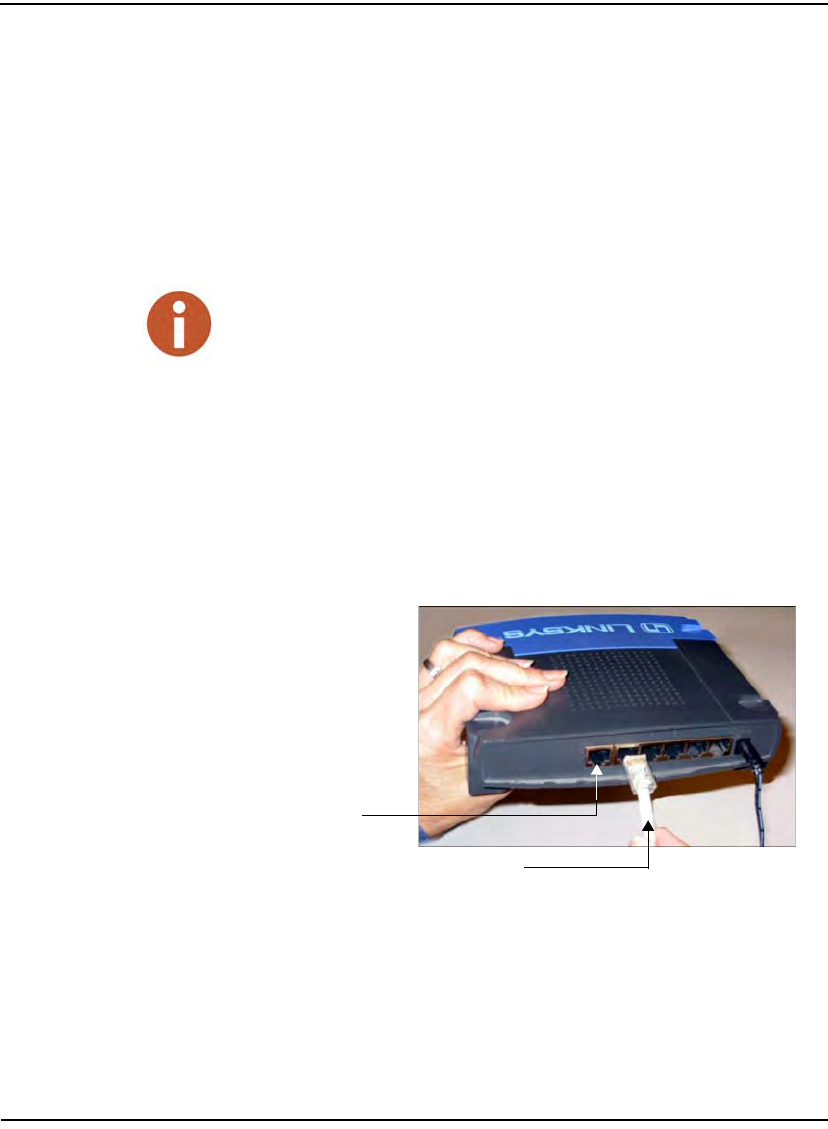
Using the Nomad Handheld
N_SIGHT R900 User’s Manual for the Neptune Handheld System 4-5
You need no special tools to connect the devices that were shipped with
your handheld.
Connecting the Router, Nomad Handheld Cradle, and Power
Supplies
Follow this procedure to connect the router, communication cradles, and
power supplies.
1 If you have not already done so, make sure that you have all of the
equipment you need. If necessary, refer to the preceding section
“Unpacking the Nomad,” on page 4-1.
2 With the host computer OFF, connect the power supply to the
router.
3 Leaving the far left port empty, connect one end of the RJ-45 Ether-
net cable into one of the four slots in the router. See Figure 4.2.
Figure 4.2 Connecting RJ-45 Ethernet Cable to Router, Port 1
4 Connect the other end of the Ethernet cable to the host computer.
5 Push the single-hole connector of the 110V AC adapter/battery
charger onto the single-prong connector on the back of the commu-
nication cradle.
You need a network switch or it is important that the router you use has the
capability to work as a switch.
Always leave far left
port empty
RJ-45 Ethernet cable
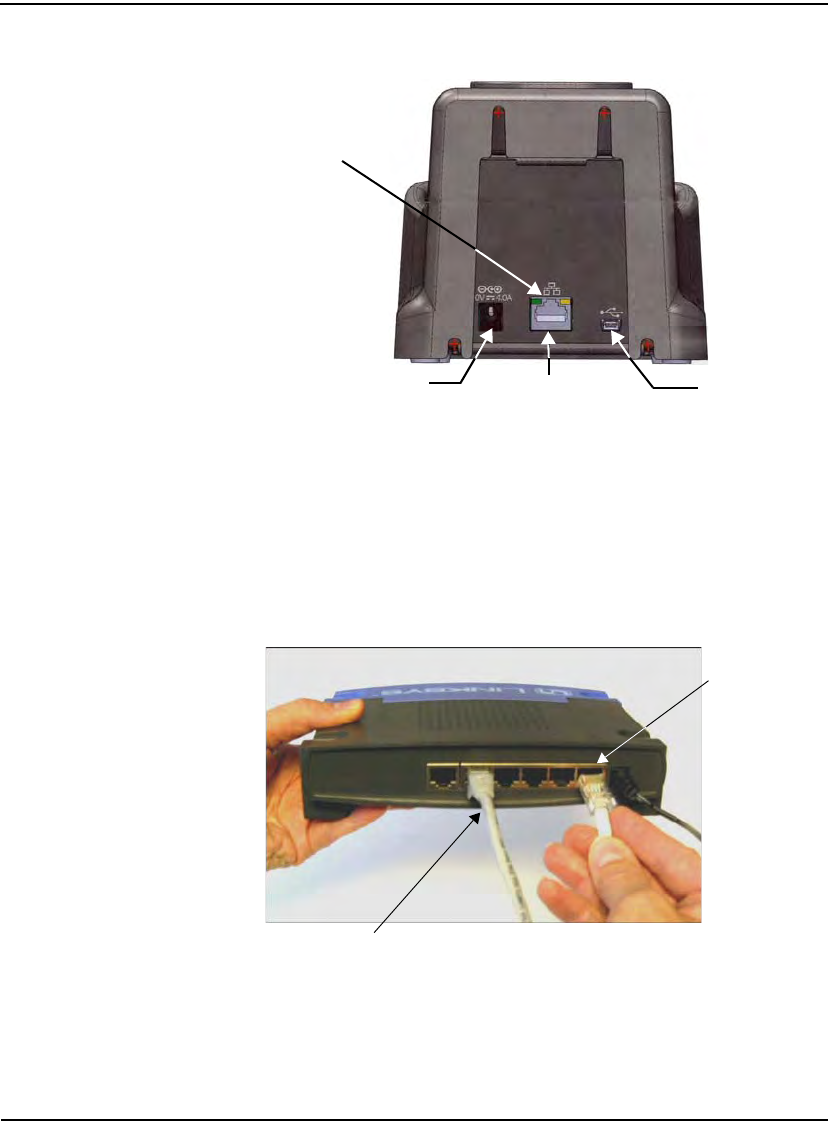
Using the Nomad Handheld
4-6 N_SIGHT R900 User’s Manual for the Neptune Handheld System
Figure 4.3 Nomad Communications Cradle Connections
6 Connect the other end of the AC adapter/battery charger into a
power source. See Figure 4.3.
7 With an additional Ethernet cable, insert one of its connectors into
the back of the cradle and the other into the back of the router. See
Figure 4.3.
8 Connect the network cable to the single router.
Figure 4.4 Network Cable Connection
Power input RJ45 Ethernet USB client
Ethernet
connection/
data transfer
RJ-45 Ethernet cable to the host comput-
Network cable
from the cradle
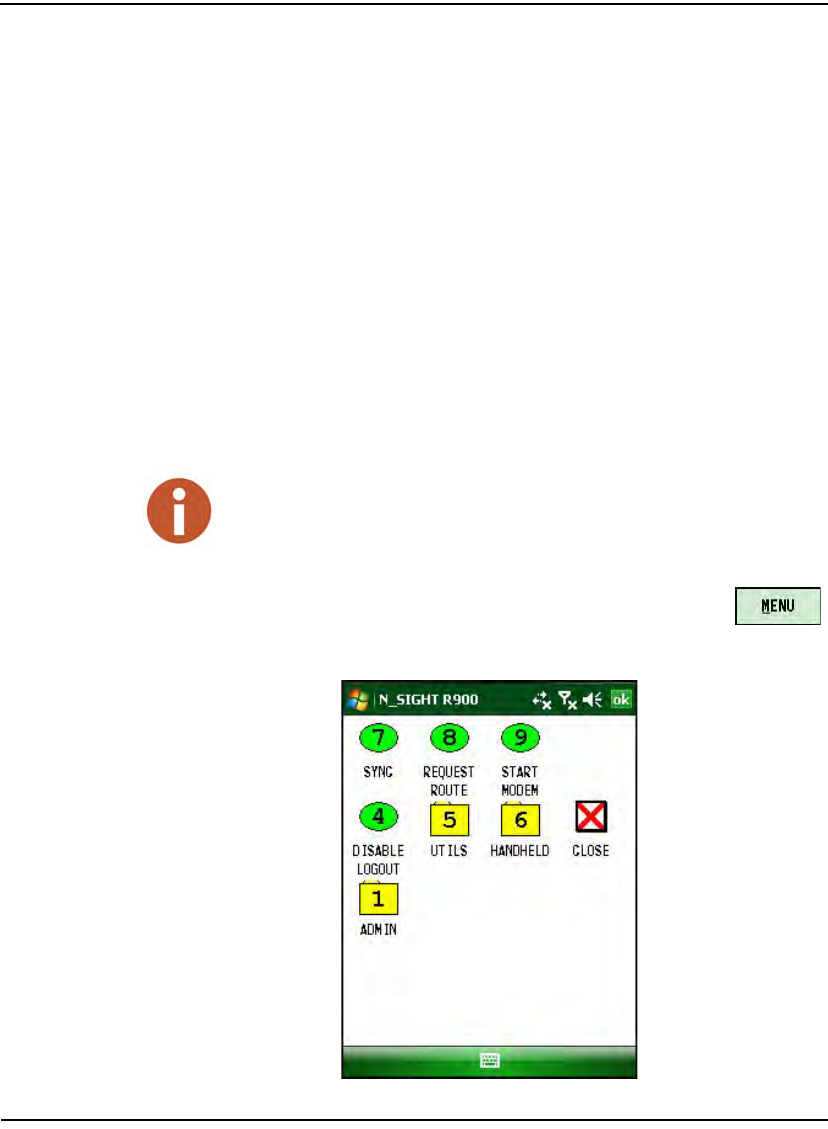
Using the Nomad Handheld
N_SIGHT R900 User’s Manual for the Neptune Handheld System 4-7
Configuring the Nomad Handheld
On the Host Computer
1 On the host computer, click Start.
2Type CMD and press Enter.
A DOS window appears.
3Type ipconfig and press Enter.
4 Write the IP address here: _____________________________
5Type exit and press Enter to close the DOS window.
On the Nomad Handheld
1On the N_SIGHT R900 Login screen, press M or touch .
The N_SIGHT R900 Main Menu screen appears.
Figure 4.5 N_SIGHT R900 Main Menu
Before proceeding with this section, you must complete the information for the
handhelds in two tables within the N_SIGHT R900 host software: Handhelds
and Reader ID. Refer to the N_SIGHT R900 Online HTML Help for the steps
to complete this information in these tables.
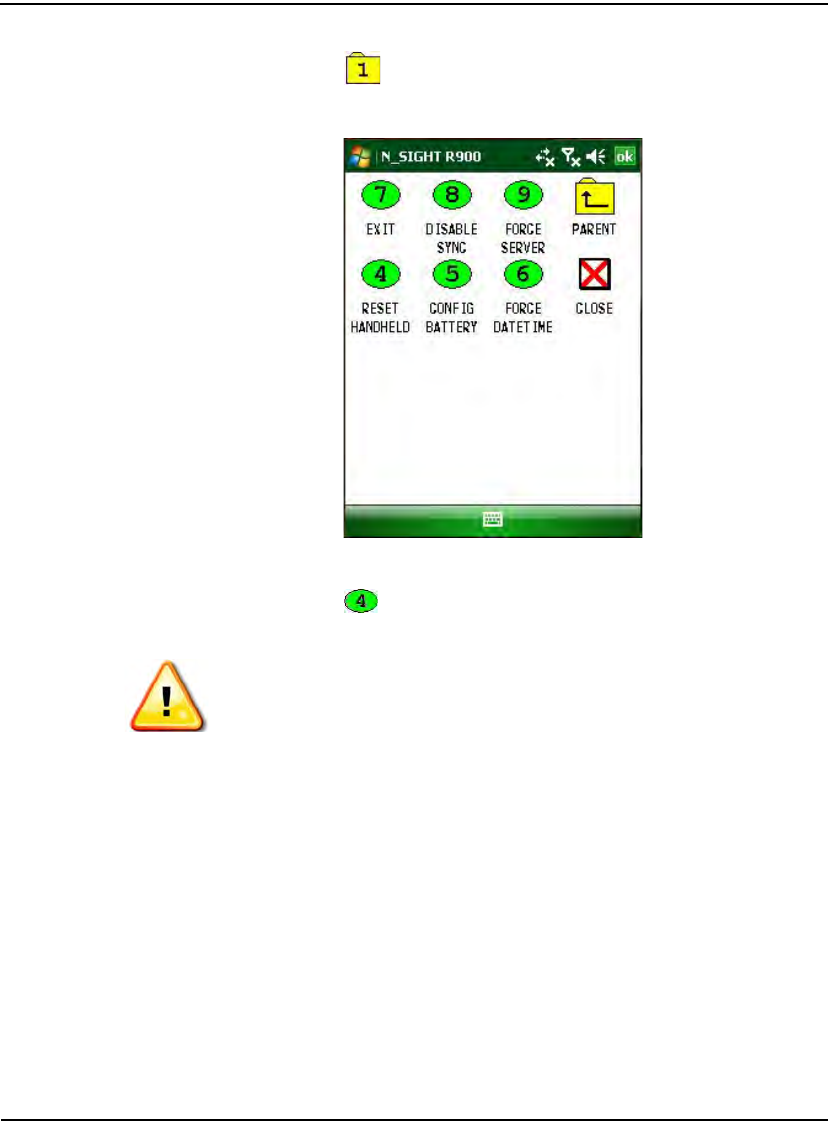
Using the Nomad Handheld
4-8 N_SIGHT R900 User’s Manual for the Neptune Handheld System
2 Select , Admin.
The Admin Menu appears as illustrated in Figure 4.6.
Figure 4.6 N_SIGHT R900 Admin Menu
3 Select , Reset Handheld.
4Click Yes.
5 Leave the password field blank, or if required, type BUBBA.
6Click OK.
The Communications Configuration screen appears.
Do not press Reset Handheld if the handheld is not in the communica-
tions cradle.
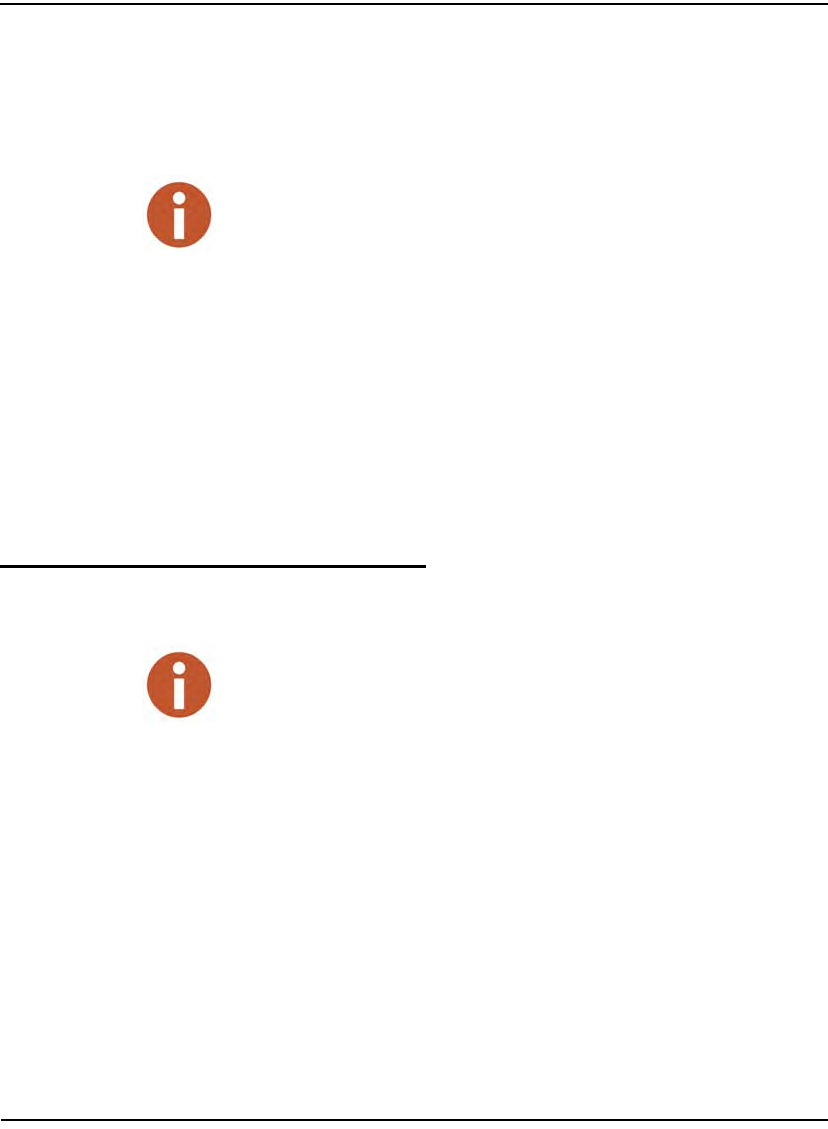
Using the Nomad Handheld
N_SIGHT R900 User’s Manual for the Neptune Handheld System 4-9
7 Tab to the HHU ID field, and type the ID of the handheld.
8 Type the IP address of the PC which you want the Nomad to
synchronize within the Server Name field.
9 Be sure the Port is 25101.
10 Click OK.
The handheld resets, and the N_SIGHT R900 Login screen
appears.
The Display and Keyboard
This section describes the display and keyboard on the Nomad.
• The types of information that are shown in the display of the
handheld.
• An overview of how to use the keys to access different types of
information.
Learning the Keyboard
The Nomad handheld uses 51 keys to give you access to all the stored
information and to allow you to enter new data. Most keys perform
more than one function.
The HHU ID for the Nomad can be found four ways:
• On the outside of the box in which the Nomad is packaged.
• In the battery compartment on the right side.
• Navigate to Windows Icon, Settings, System Tab at bottom of the
screen, and then scroll to System Information and Info Tab at bottom of
screen.
• Navigate to Windows Icon, Settings, System Tab at bottom of the
screen and click About then Device ID at the bottom of the screen.
If the message DB Uninitialized flashes on the screen press Synchronize
once more to complete Database Synchronization
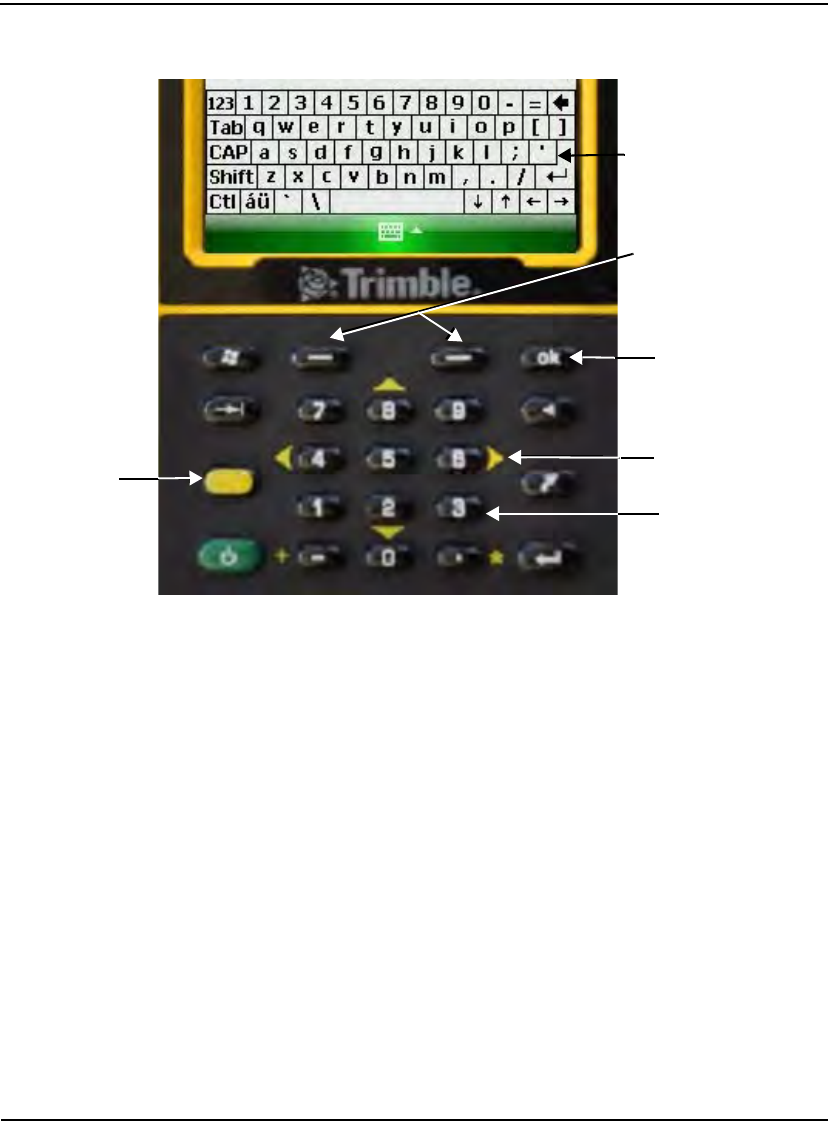
Using the Nomad Handheld
4-10 N_SIGHT R900 User’s Manual for the Neptune Handheld System
Figure 4.7 Learning the Keyboard
Buttons and Keys
In addition to an environmental seal that protects the unit from dust, dirt,
and water, the Nomad includes the following features.
•Function Button—allows you to perform special tasks quickly.,
such as navigate through a screen when you use the yellow arrow
keys
•Direction Buttons—allow you to navigate and move up or down a
list of items and to move forward or backward in a data-entry space
or through the meters of a route.
•Number Buttons—allow you to access accounts while reading
meters.
Function key
Direction keys
Number keys
Quick keys
Letter/character keys
Application soft keys
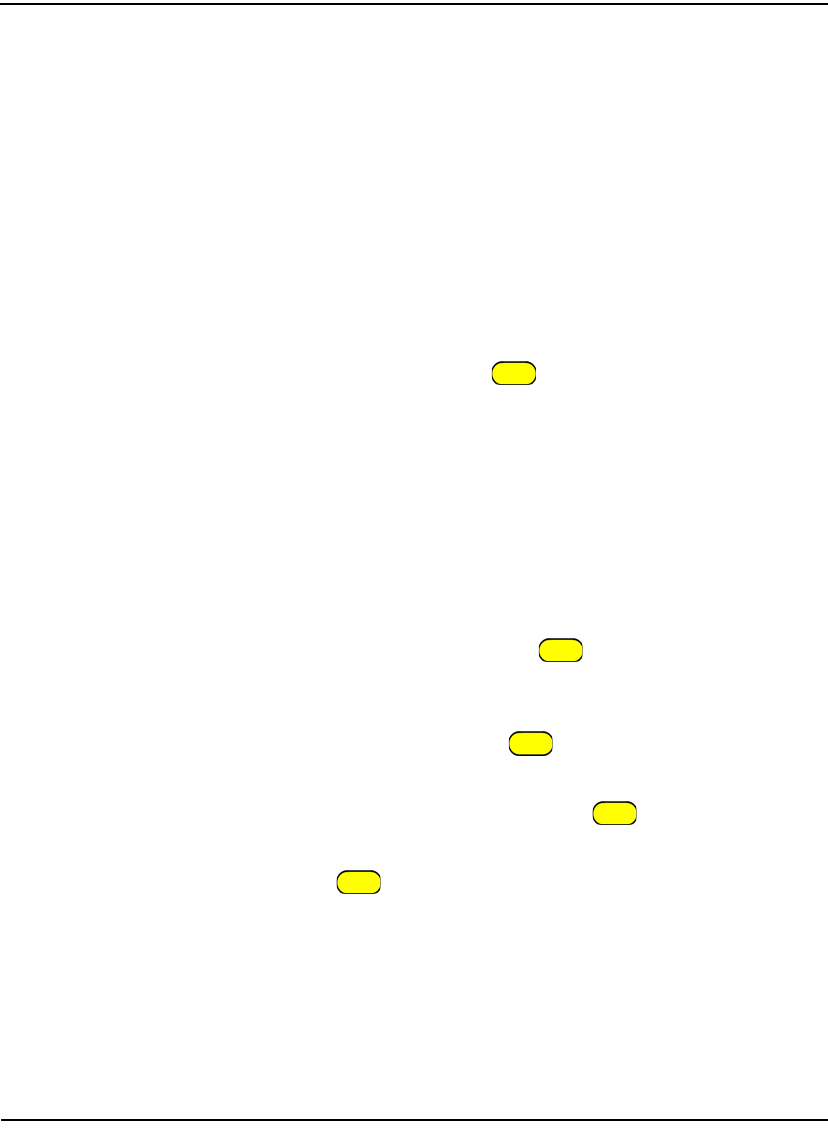
Using the Nomad Handheld
N_SIGHT R900 User’s Manual for the Neptune Handheld System 4-11
•Letter/Character Keys—allow you to enter a letter or character in
a screen or to select an item from a list of items shown.
•Application Soft Buttons—allow you to enter, change, or view
information about a meter or a route.
•Combination Keys—allow you to execute a task quickly by
pressing certain keys at once or in a particular order.
Buttons
To help you perform handheld tasks, the keyboard is color coded. For
example, by using the yellow function button in conjunction with
keys that are marked in yellow, you can navigate around a screen.
Buttons with white numbers or symbols are single-entry keys. To enter
the number, simply press the button with the corresponding number or
letter.
Function Button
Because the Nomad automatically disables inappropriate buttons, the
type of task that you can perform from the keyboard depends upon the
type of menu that is displayed.
On the numeric keypad, the yellow function button (clicky key
sounds) accesses the tasks in yellow, including the navigation arrows.
Several settings can be changed under Keyboard Options.
Auto release: Press and release to access a yellow task for one
use. It then goes back to the original key tasks.
Manual release: This is the default. Press to toggle it on and off.
Yellow tasks remain active until the function key is pressed again.
Disabled: must be held down while pressing any other key to
access the yellow task.
Play Sticky Key Sounds: To disable clicky key sounds, remove the
check in the box.
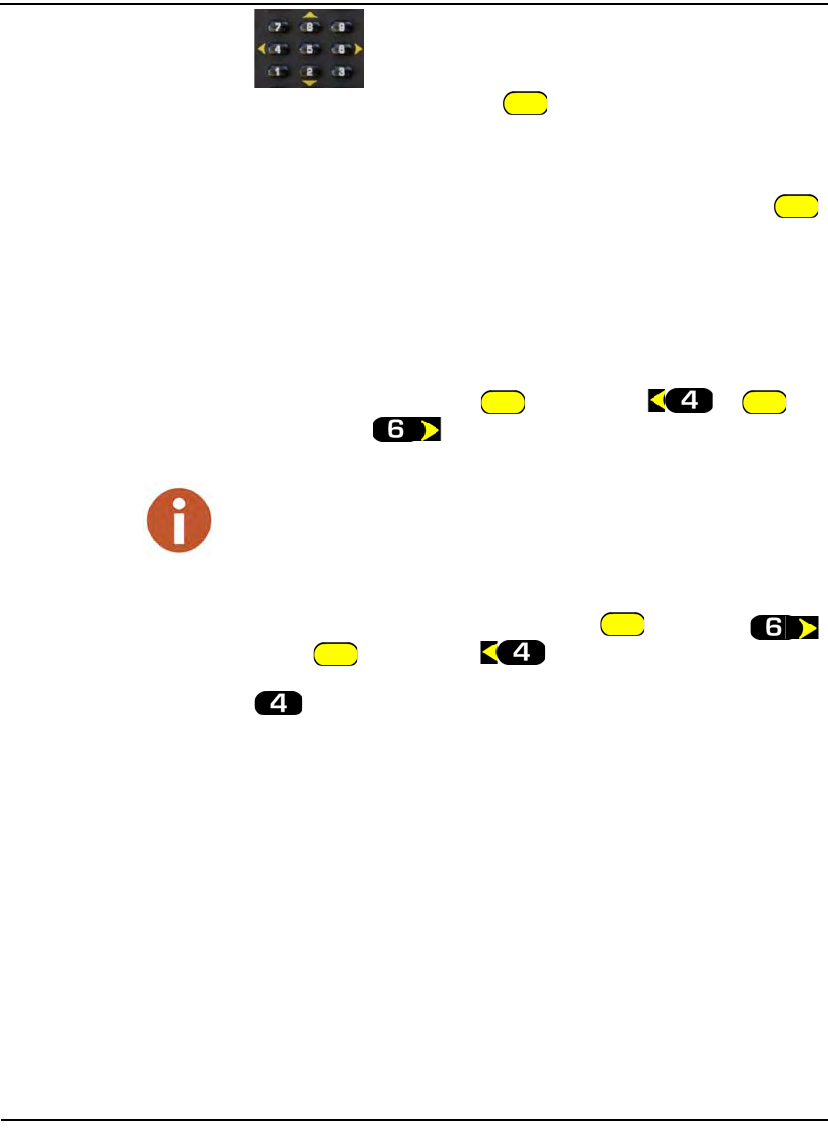
Using the Nomad Handheld
4-12 N_SIGHT R900 User’s Manual for the Neptune Handheld System
Direction Buttons
In conjunction with the yellow function button, the yellow
direction arrows are enabled by the number buttons closest to them. You
can use these buttons on the handheld to move up or down through a list
of items displayed in a menu screen, and to move forward or backward
within a data-entry space or through the meters of a route. Using
and pressing the arrow/number button up or down displays additional
screens for the account.
The type of task that you can perform using an arrow/number button
depends upon the type of screen displayed.
•Data-Entry Screen—moves forward or backward within a data-
entry space by pressing + BACKWARD or +
FORWARD buttons.
•Reading-Entry Screen—displays the reading-entry screen of the
next or previous meter by pressing the + FORWARD
or + BACKWARD buttons.
Number Buttons
The number buttons on the handheld are used most often for entering
readings. Because entering readings is the primary function of users, the
number buttons are smaller than the other buttons and are placed in the
center of the keypad. Number buttons enable you to complete one of
two tasks:
• Enter a number in the display, such as for a reading.
• Select an item by pressing the number key that corresponds to a
numbered item in a list of items.
Moving over existing letters or numbers will not erase them.
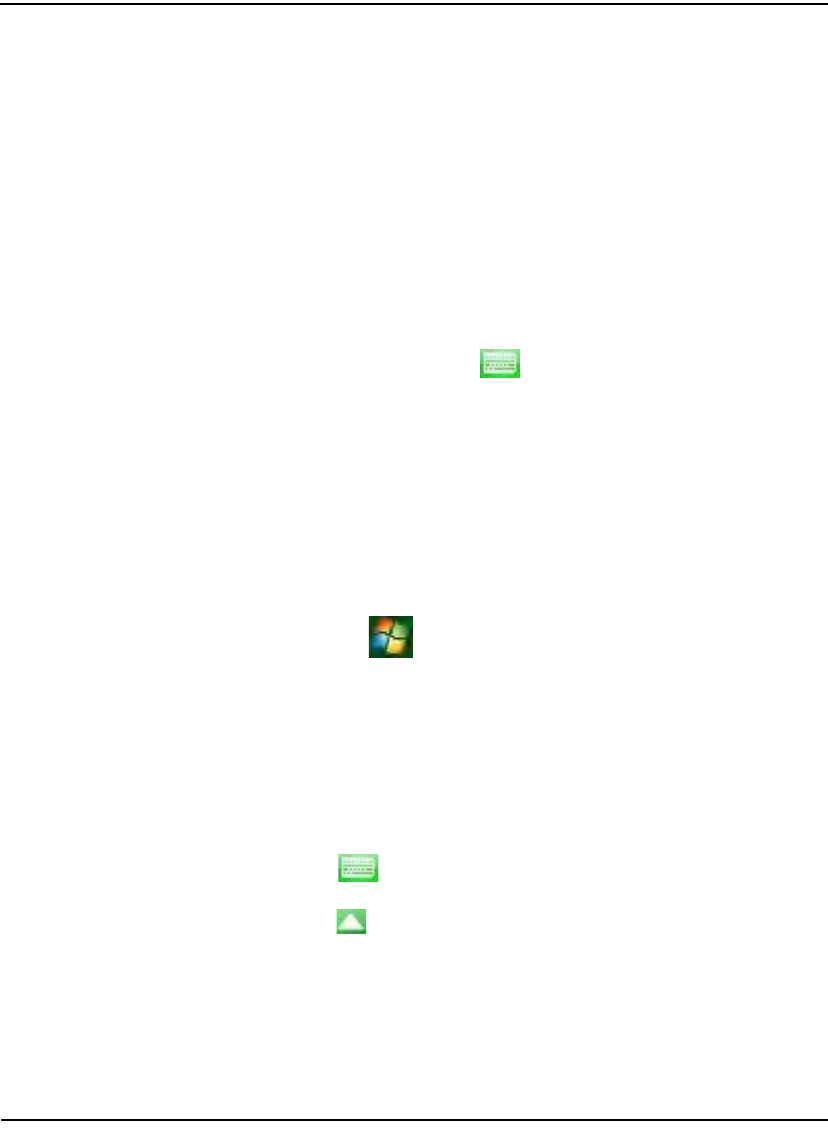
Using the Nomad Handheld
N_SIGHT R900 User’s Manual for the Neptune Handheld System 4-13
The type of task that you can perform using a number key depends upon
the type of screen that is displayed.
•Menu Screen—select a numbered item from the list by pressing
the key whose number corresponds to the item that you want to
select. (When used this way, the number key is called a hotkey.)
•Data-Entry Screen—enter a number in the data-entry screen by
pressing the key with the number that you want to appear in the
field.
Nomad Screen Keyboard
When you tap the keyboard icon located at the bottom of the
screen, an on-screen keyboard appears with 60 keys to use. There are
three views of this keyboard.
Changing the Size of the Keys
There are two ways you can change the size of the keys that display on
the screen keyboard.
Using the Windows Icon.
1 Click the at the top left of the screen.
2Click Settings, and then click Input.
3 Select Large Keys. (The default is Small Keys.)
4Click OK.
Using the Keyboard Icon.
1Click at the bottom center of the screen.
2Click to the right of the Icon.
3Click Options.
4 Select Large or Small Keys. See Figure 4.8 and Figure 4.9 on
Page 4-14.
5Click OK.
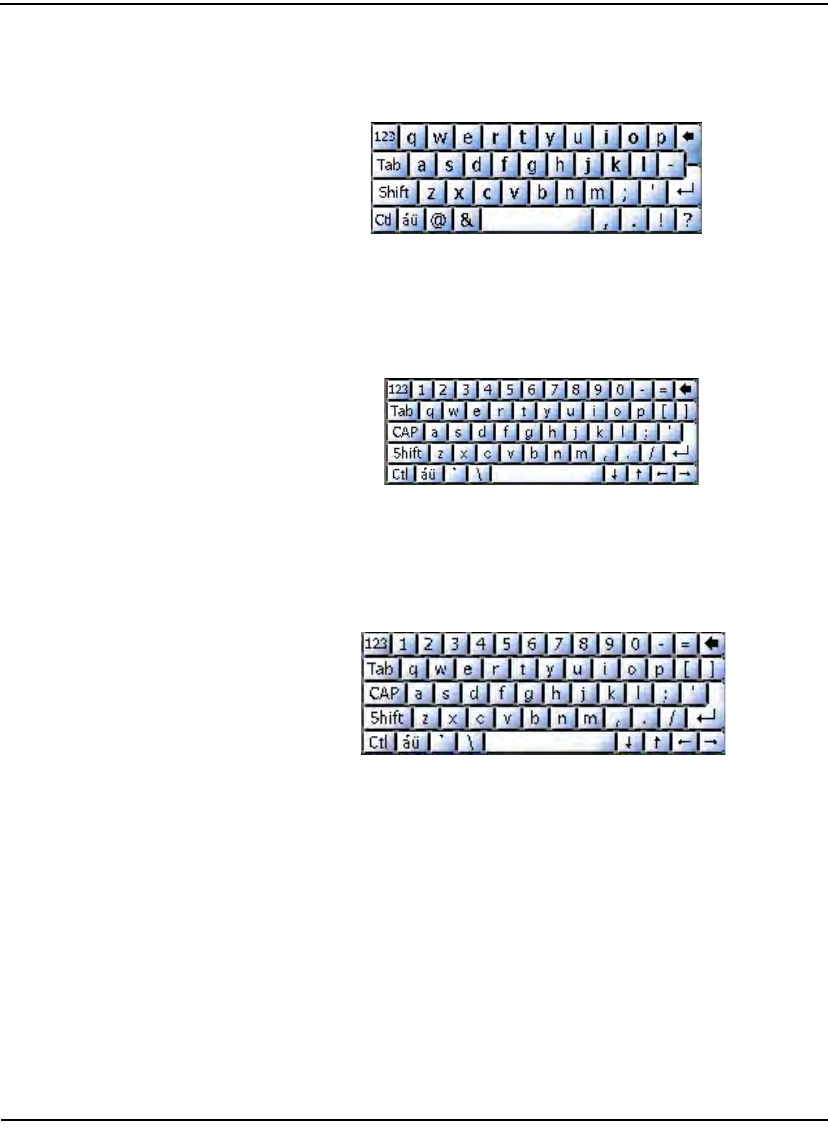
Using the Nomad Handheld
4-14 N_SIGHT R900 User’s Manual for the Neptune Handheld System
Large Keys
The following figure illustrates the large keyboard.
Figure 4.8 Nomad Large Keyboard
Small Keys
The following figure illustrates the small keyboard.
Figure 4.9 Nomad Small Keyboard
Lowercase Keys
The following figure illustrates the lowercase QWERTY keyboard.
Figure 4.10 Nomad Lowercase Keyboard
Uppercase Keys
The following figure illustrates the uppercase QWERTY keyboard.
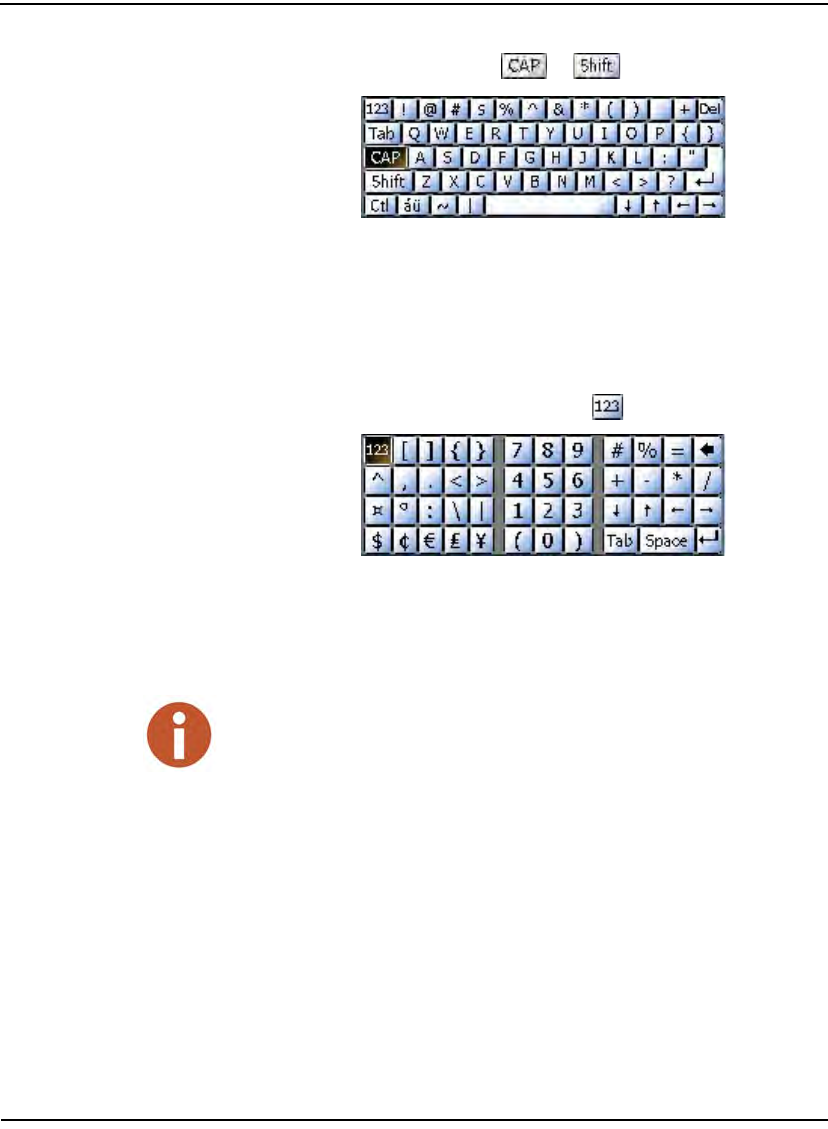
Using the Nomad Handheld
N_SIGHT R900 User’s Manual for the Neptune Handheld System 4-15
To use the uppercase keys, tap or .
Figure 4.11 Nomad Uppercase Keyboard
Numeric and Symbols Keys
The following figure illustrates the keyboard with numeric and symbols
keys.
To use the numeric and symbols keys, tap .
Figure 4.12 Nomad Numeric and Symbols Keyboard
Information Keys
The information keys on the handheld screen are the letter/character
keys that allow you to perform specific tasks while in N_SIGHT R900.
You can enter, change, or view the following information about a meter
or a route by pressing the appropriate key whenever you are logged into
a route and a reading-entry screen is shown in the display.
Information keys only work when logged into the handheld (Production
Mode).
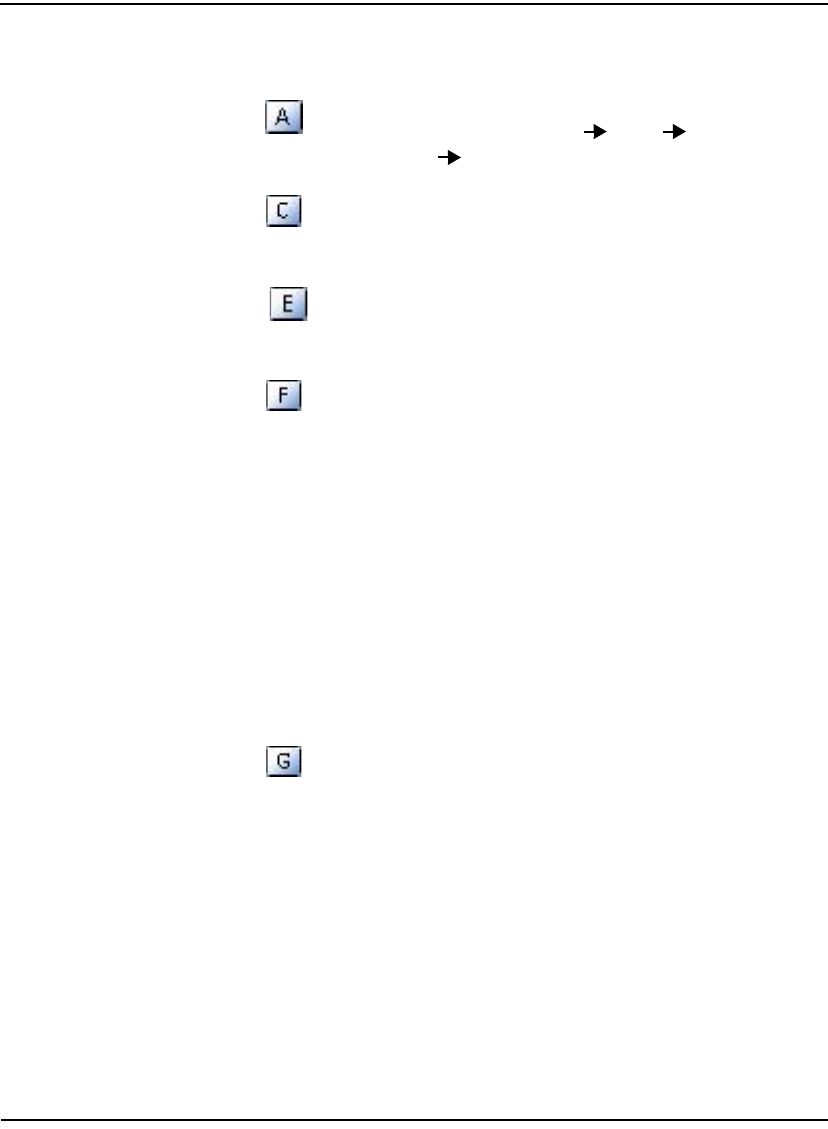
Using the Nomad Handheld
4-16 N_SIGHT R900 User’s Manual for the Neptune Handheld System
Toggles between the Automatic Meter Reading
(AMR) mode: R900 Keyed Advantage
R300.
Accesses the Codes menu, allowing you to enter
trouble codes or customer notes depending upon
the type of import file you are using.
Allows you to turn the Edit mode ON. In edit mode,
you can type information on screens that allow text
entry.
Allows you to access the Search screen where you
can select criteria to look for information you need:
• Coded note
•Route
• Meter number
•Name
• Meter type
• Account status
• Sequence number
• Skip code
• Instruction code
• Account number
• Constant
•Tag
Allows you to access the GoTo screen. On this
screen, you can access the following information for
a meter or a route:
• Position of the meter within the route
• Sequence number of the meter
• Previous route
• Next route
• Beginning of the route
• End of the route
• First incomplete read
• Last incomplete read
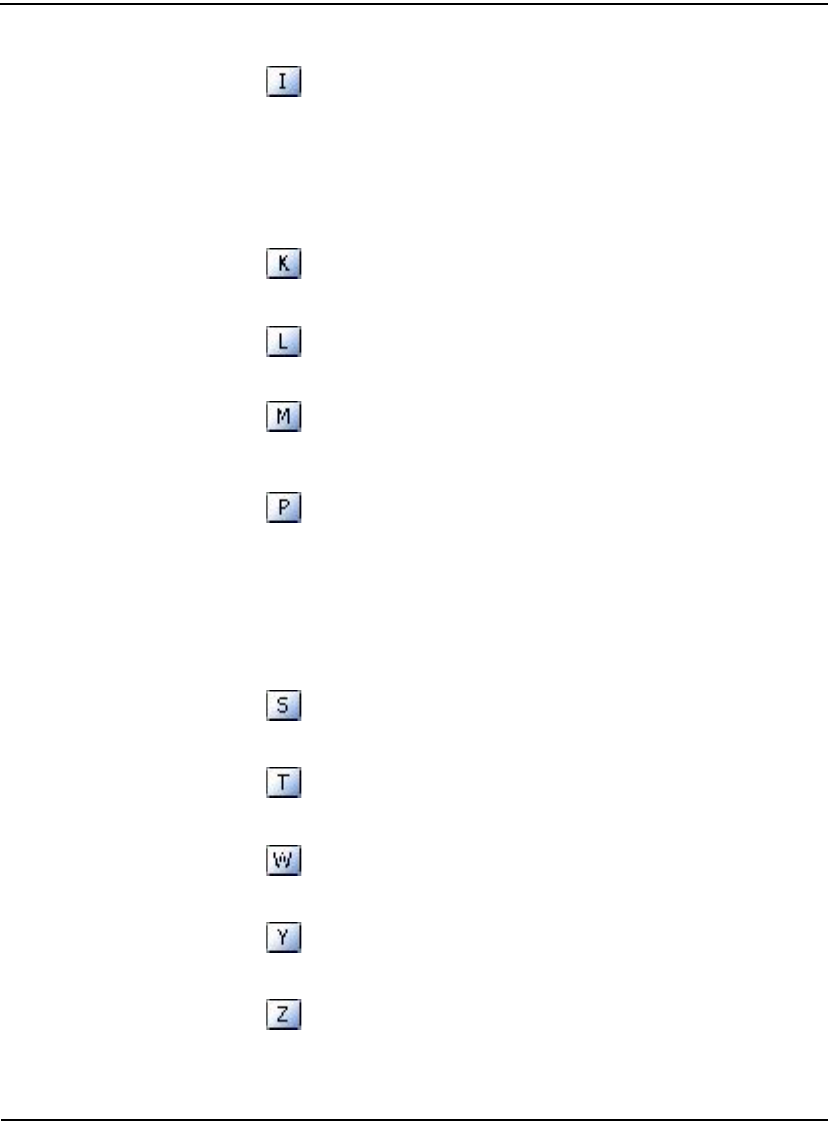
Using the Nomad Handheld
N_SIGHT R900 User’s Manual for the Neptune Handheld System 4-17
Allows you to view summary information about the
route. When pressed with the CTL key, this key
allows you to view screen information for the
handheld, such as the version number, Internet
Protocol (IP) Address, Random Access Memory
(RAM), and storage.
Allows you to enter a reading manually.
Allows you enter List mode where the account
addresses are presented in list form, a convenient
way to browse through the accounts.
Allows you to access the Meter Menu where you
can skip a reading, change meter information, and
enter information for a found meter.
Allows you to view the Properties information for the
handheld:
• Read direction
• Route dir
• Battery key clicks
•Date
•Time
Allows you to skip the reading for this account.
Allows you to tag the account so that you can come
back to it later.
Allows you to log out of N_SIGHT R900 after
completing the required information.
Allows you to search for the accounts already
tagged.
Allows you to perform an RF test.
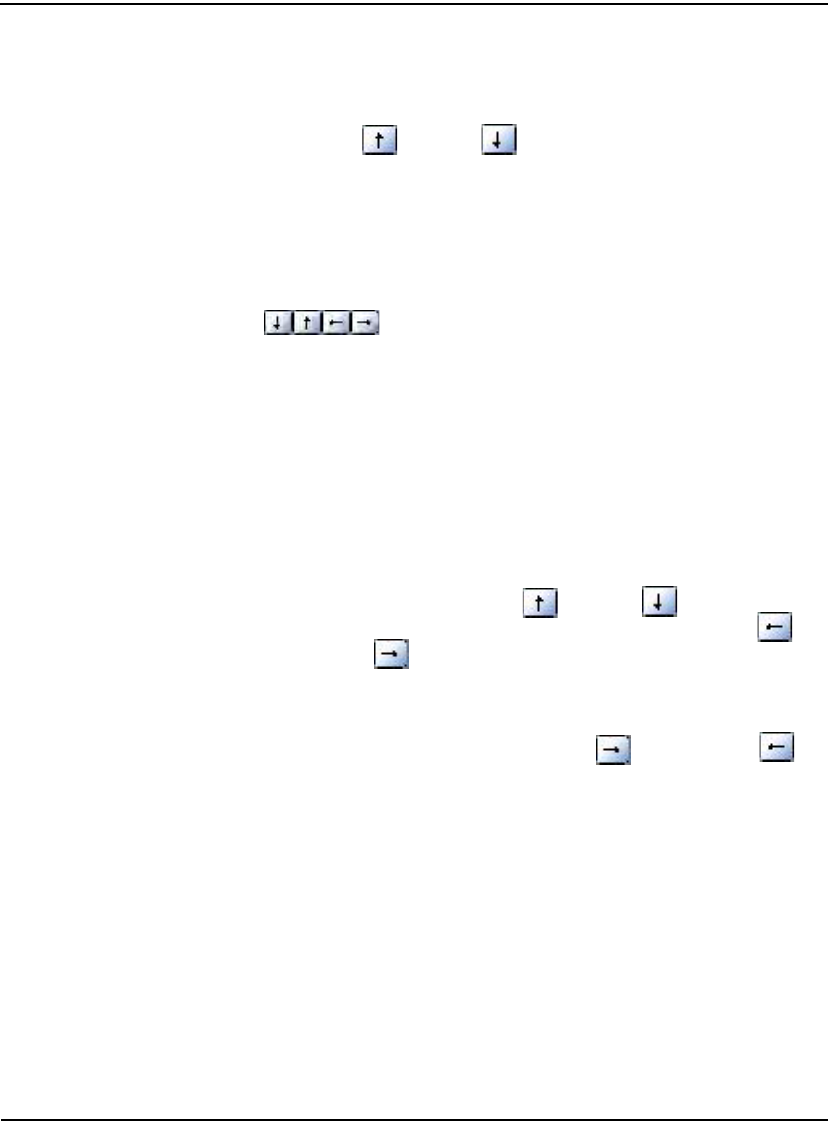
Using the Nomad Handheld
4-18 N_SIGHT R900 User’s Manual for the Neptune Handheld System
You can use these keys when a reading-entry screen is displayed. For
example, if the you need to find more information about this meter, do
the following:
Press UP or DOWN keys while reading the account.
This takes you to additional information. Once you display the
information you need, pressing these keys again returns you to meter’s
reading-entry screen.
Direction Keys
The direction keys on the handheld are used to move up or down
through a list of items displayed in a menu screen and to move forward
or backward within a data-entry space or through the meters of a route.
Pressing the direction key up or down displays additional screens for the
account, such as an account-specific hazard.
The type of task that you can perform using a number key depends upon
the type of screen displayed.
•Menu Screen—highlights a numbered item in the list of items
displayed by pressing the UP or DOWN keys to move
through the list of items. You can also use the BACKWARD or
FORWARD keys to jump to the first or last item in the menu. As
you reach an item, it becomes highlighted.
•Data-Entry Screen—moves forward or backward within a data-
entry space by pressing the FORWARD or BACKWARD
keys to move forward or backward within the space.
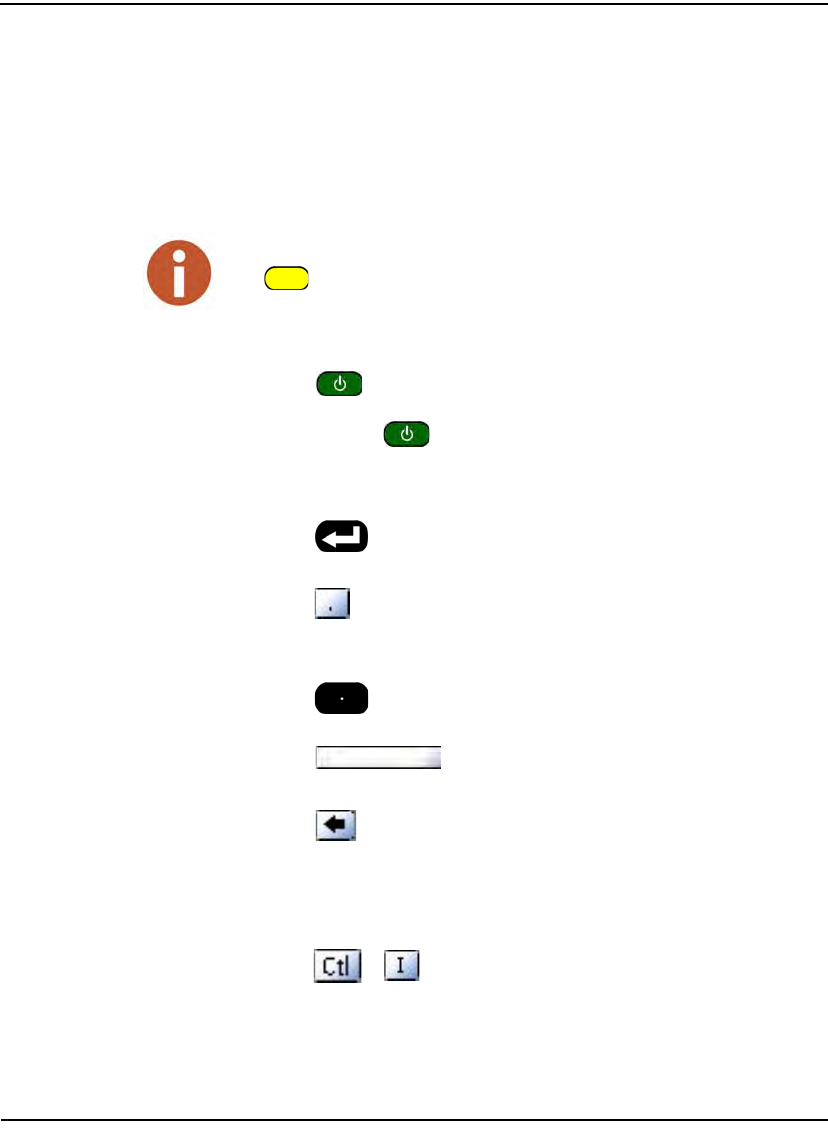
Using the Nomad Handheld
N_SIGHT R900 User’s Manual for the Neptune Handheld System 4-19
Combination Keys
By pressing specific keys at once, or in a particular order, you can
execute a task quickly. Certain quick key tasks can be performed no
matter what type of screen is shown. The following table summarizes
tasks that you can perform using quick keys.
Use the color coding to remember which keys to use with quick keys that have
two functions: to activate the function printed in yellow, press the YELLOW
function button first and then press the key with a function printed in
yellow.
Press once. To turn on the Nomad.
Press and hold for five
seconds, then release. Choose
Shut Down.
To turn off the Nomad.
Press To enter a reading or select an item
from a menu screen.
Press To enter a decimal point. (This is
typically required only by “floating
point” meters.)
Press To return to the preceding screen.
Press To enter a space when entering a
special message or other data.
Press To erase a letter, number, or
character that you have entered.
As you backspace over each letter,
number, or character, each is
erased.
Press +
To show meter information on the
screen.
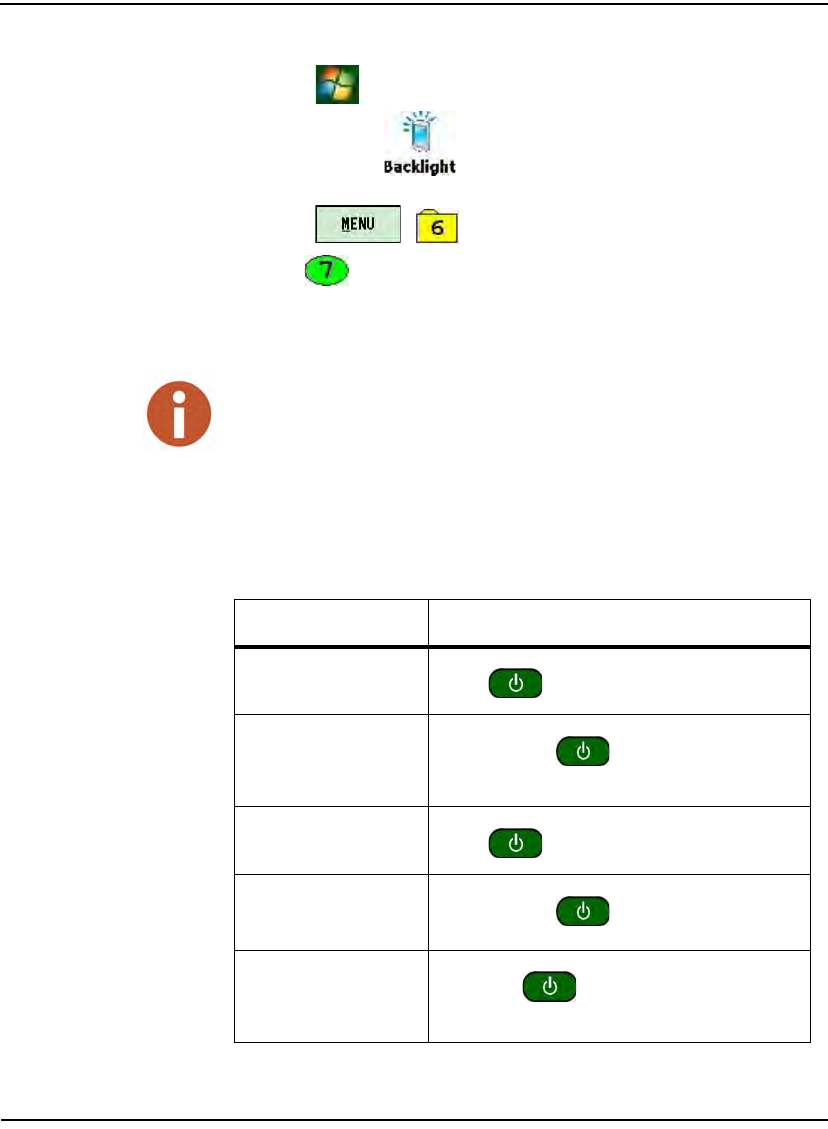
Using the Nomad Handheld
4-20 N_SIGHT R900 User’s Manual for the Neptune Handheld System
Table 4.1 Nomad Functionality
Press , PROGRAMS,
SYSTEM TAB,
To minimize the amount of time the
backlight stays on and dim it to only
as bright as required to view the
display.
Press , ,
then
To perform a soft reboot of the
Nomad handheld.
Backlighting can drain the battery rapidly. To conserve the battery, use this
feature only in low light.
If you do not press a key within 45 seconds of activating this feature, the
Nomad automatically deactivates the backlight to conserve battery power.
Function Explanation
Power ON Press once.
Power OFF Press and hold for five seconds, then
release. Choose Shut down.
Turn screen OFF Press once.
Turn backlight
ON/OFF Press and hold for two seconds
Reboot Hold down for five seconds, then release.
Choose Reset.
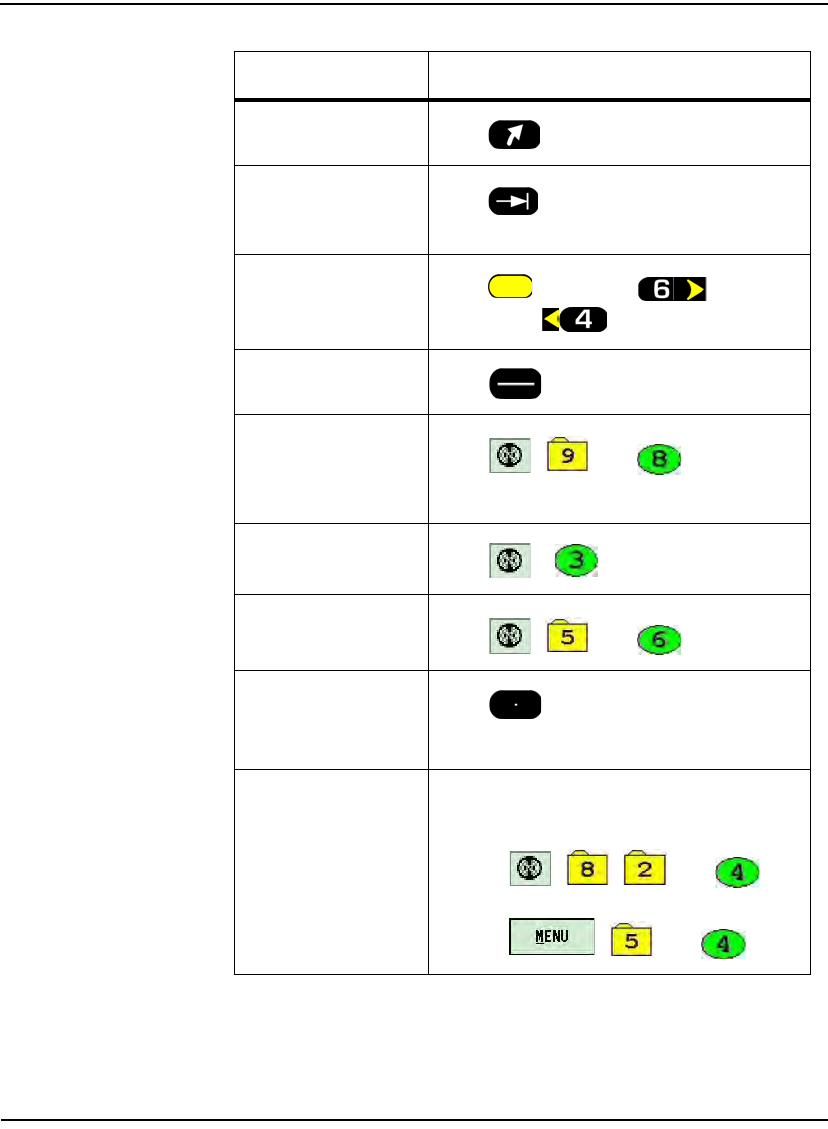
Using the Nomad Handheld
N_SIGHT R900 User’s Manual for the Neptune Handheld System 4-21
Today Press to escape from any screen.
Tab Press to advance to the next field on the
screen.
Next and previous
account Press + FORWARD or
BACKWARD
Next unread Press .
Previous unread Press , , then .
Resequence Press + .
Reset order/
delete read Press , , then .
Previous menu/
back Press .
Field Programmer Do one of the following:
• Logged into route:
Tap , , , then .
• Not logged in route:
Tap , , then .
Function Explanation

Using the Nomad Handheld
4-22 N_SIGHT R900 User’s Manual for the Neptune Handheld System
Adjusting System Settings
System settings affect how the handheld displays and accesses data.
Although these settings are factory-set to meet the needs of most meter
reading processes, you can change some of the settings so that they
better suit your needs. These settings are typically set once and never
changed; however, you can adjust these settings any time.
Data Logger Do one of the following:
• Logged into route:
Tap , , , then .
• Not logged in route:
Tap , , then .
Bluetooth Pairing
(with the R900 Belt
Clip Receiver)
Do the following:
1 Power on the R900 BCR by pressing
for two seconds on the R900 Belt Clip
Receiver.
2Tap , , on the
Nomad.
3 Click .
4 Select the Belt Clip in the drop-down selec-
tion list.
5 Click .
Function Explanation
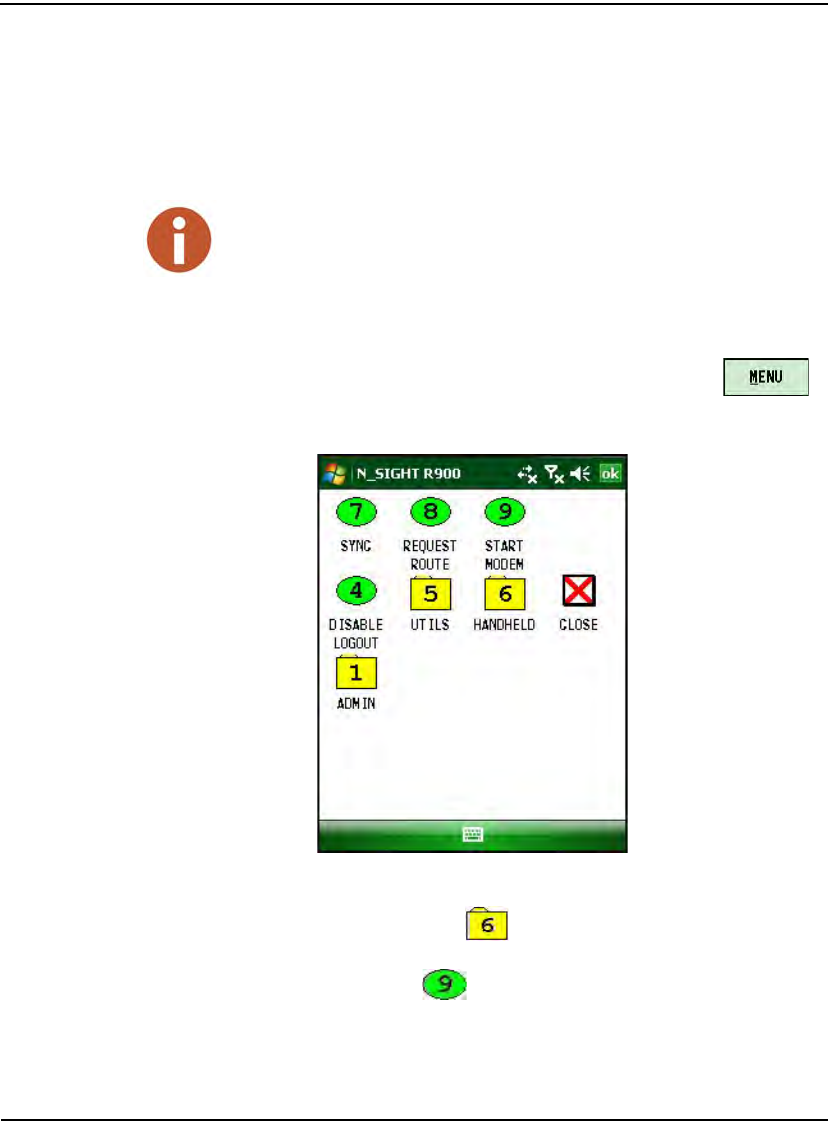
Using the Nomad Handheld
N_SIGHT R900 User’s Manual for the Neptune Handheld System 4-23
Calibrating the Stylus
The Nomad handheld has a touchscreen display that uses a stylus for
ease-of-use. Because each person’s touch differs, it is important to
calibrate the stylus to the touchscreen for the user’s own personal touch.
To calibrate the stylus, complete the following procedure.
1 On the N_SIGHT R900 Login screen, tap M or touch .
The N_SIGHT R900 Main Menu screen appears.
Figure 4.13 N_SIGHT R900 Main Menu
2 Press 6 or touch item Handheld.
3 Press 9 or touch Stylus.
All functions are available without the stylus by using keyboard.
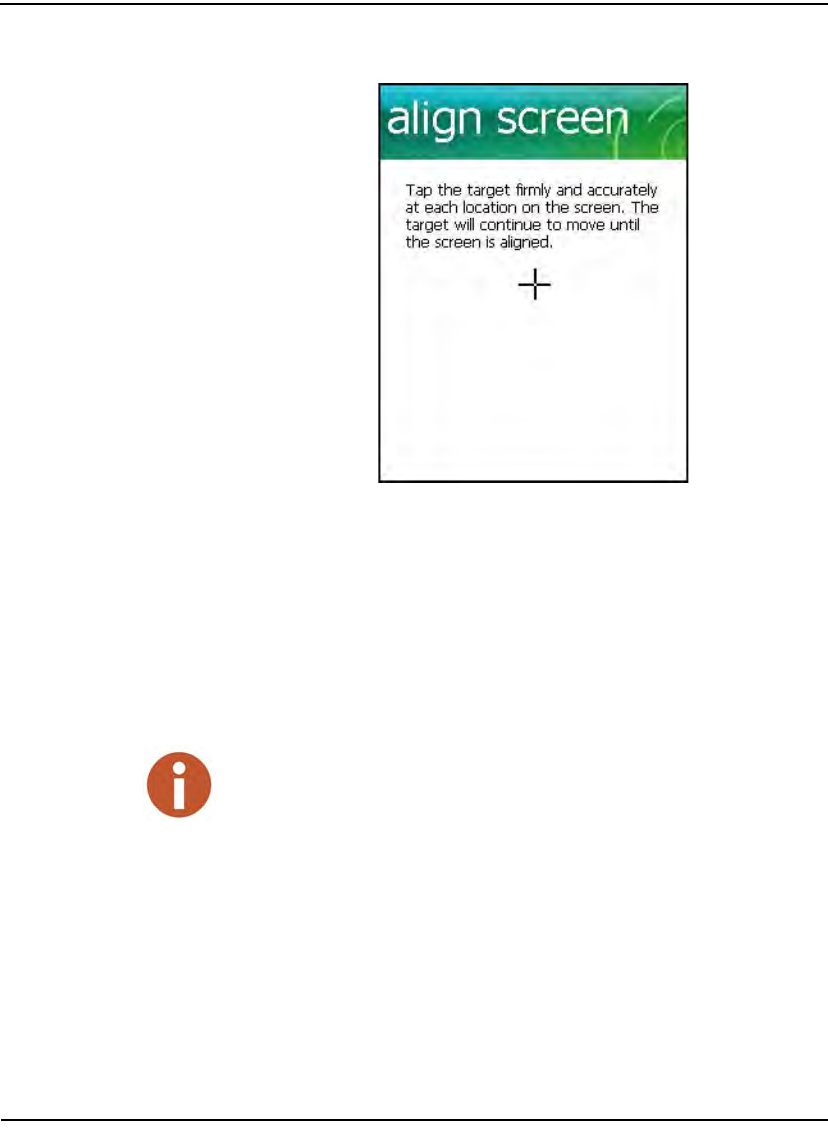
Using the Nomad Handheld
4-24 N_SIGHT R900 User’s Manual for the Neptune Handheld System
The Stylus Calibration screen appears like Figure 4.14.
Figure 4.14 N_SIGHT R900 Stylus Calibration Screen
Calibration is simply done by touching the center of the target with
the stylus for a couple of seconds and releasing. When the target
moves to another place, repeat the operation.
4 Press the stylus on the center of the target until it moves, and then
release.
Once released the target moves to the next corner of the screen.
Remember just to touch the screen; there is no need to press hard or to
punch it.
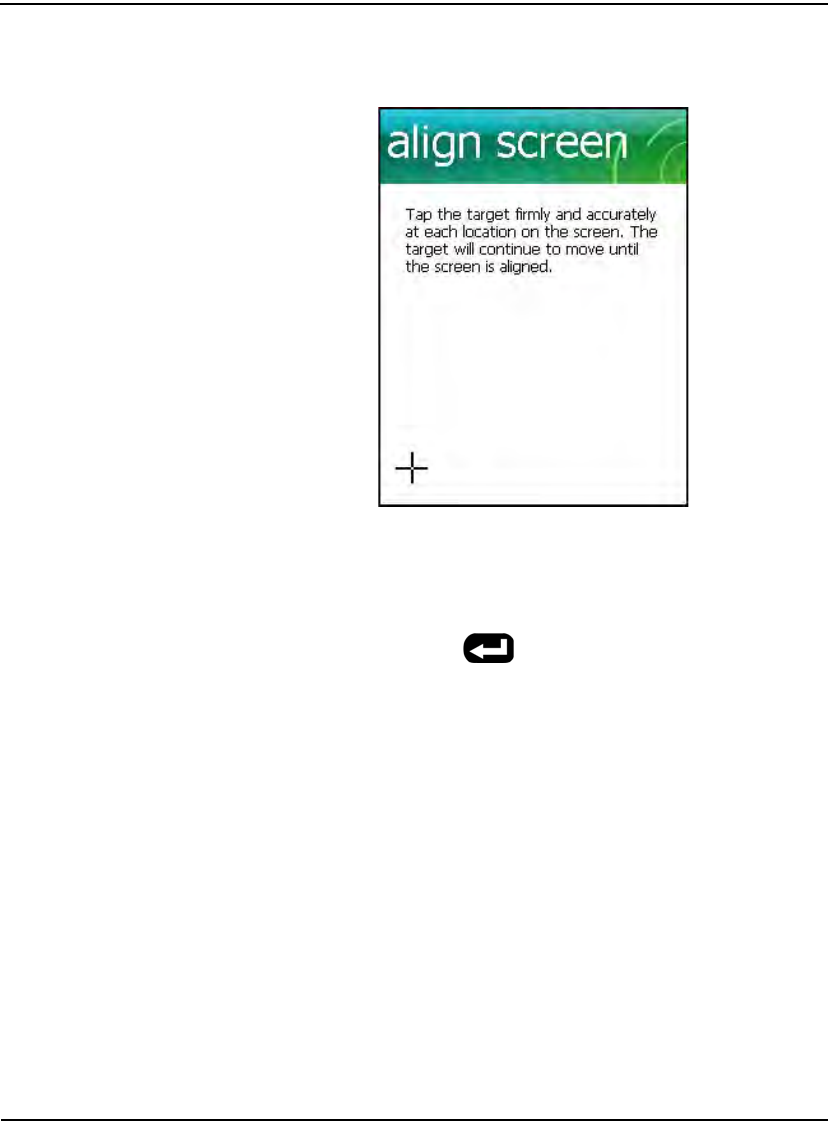
Using the Nomad Handheld
N_SIGHT R900 User’s Manual for the Neptune Handheld System 4-25
The target moves to another location on the screen similar to that
illustrated in Figure 4.15.
Figure 4.15 Stylus at Another Location on Screen
5 Repeat pressing the stylus on the center of the target until it moves,
and then release.
6 When finished, press .
The handheld returns to N_SIGHT R900 Main Login screen.

Using the Nomad Handheld
4-26 N_SIGHT R900 User’s Manual for the Neptune Handheld System
Changing the Handheld Properties
The section allows you to adjust or change the following properties for
the handheld:
• Key clicks
• Reading entry direction
• Route direction
Working with the Properties Screen
To access the Properties screen, complete these steps:
1On any reading
entry screen, press
on the
expandable key-
pad.
The Properties
screen appear as
illustrated in
Figure 4.16.
Figure 4.16 Handheld Properties Screen

Using the Nomad Handheld
N_SIGHT R900 User’s Manual for the Neptune Handheld System 4-27
Changing the Reading Entry Direction
As you enter a reading in the handheld, each number can be displayed
from right to left or from left to right.
2In the Read Dir field, touch the down arrow and do one of the
following:
• Select LEFT TO RIGHT if you want the number to begin
from the left.
• Select RIGHT TO LEFT if you want the number to begin
from the right.
These setting toggle between Left to Right or Right to Left
according to the current setting.
Changing the Route Read Direction
The handheld typically displays meters of a route from the first meter to
the last meter. However, you can change the order that meters are
displayed so that they are shown from the last meter to the first meter.
3In the Route Dir field, touch the down arrow and do one of the fol-
lowing:
• Select FORWARD if you want the readings to advance to the
next unread account in the route.
• Select BACKWARD if you want to change the directions of
the readings to go backward to the previous unread account in
the route.
These settings toggles between Forward or Backward according to
the current setting.
Turning Key Clicks On and Off
The Key Clicks feature allows you to control how the handheld
responds when you press a key. When this feature is ON, the handheld
beeps whenever you press a key. Turning the Key Clicks feature on can
This procedure affects only accounts whose directions have not been set by
the host computer. If the reading-entry direction of an account has been set
by the host computer, the host setting replaces your setting.
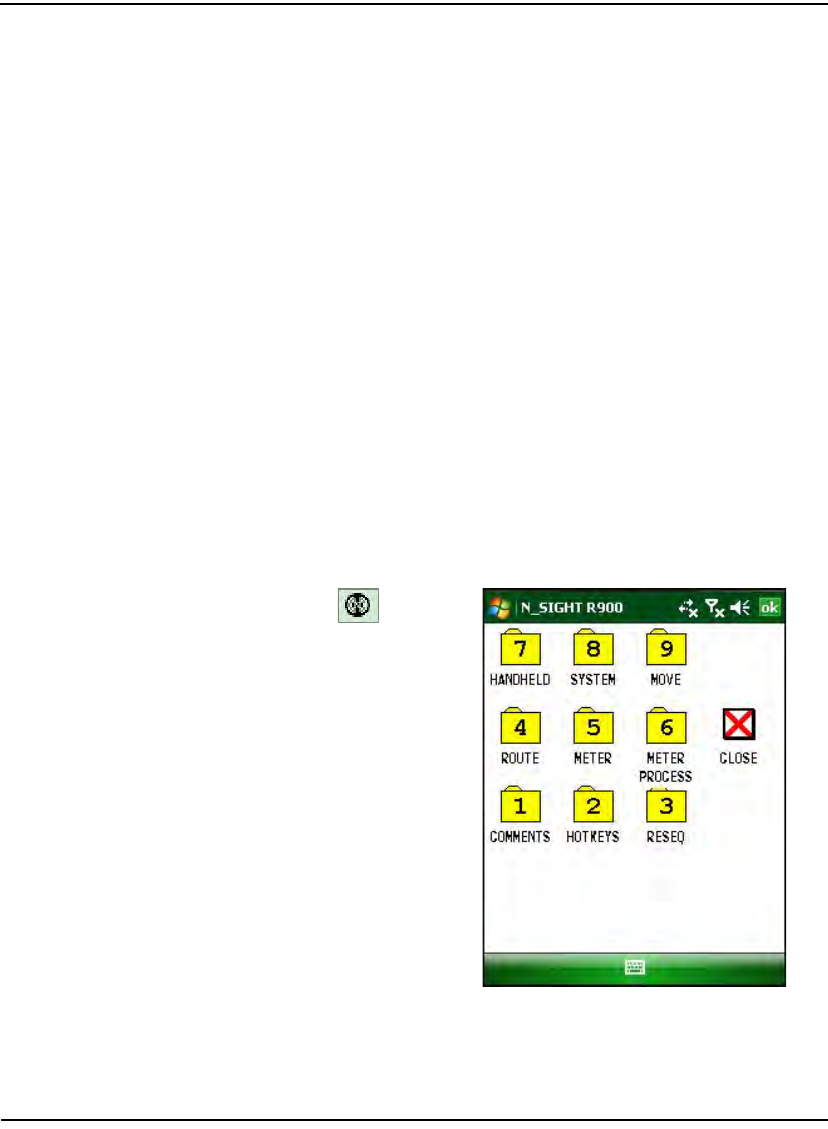
Using the Nomad Handheld
4-28 N_SIGHT R900 User’s Manual for the Neptune Handheld System
help you reduce errors by making sure that you press each key fully. If
you do not press a key fully, the handheld does not acknowledge your
entry. You can turn the Key Clicks feature on or off at any time.
4 Do one of the following:
• Select the check box to enable Key Clicks.
• Leave the check box empty to disable the Key Clicks.
These settings toggle between on (checked) or off (unchecked)
according to the current setting.
5 Touch OK to save your settings.
You return to the reading-entry screen or your previous screen.
Configuring RF/Serial Properties
Depending on the type of accounts on your route, you may have to
configure the RF antenna, the type of probe, or serial properties you are
using. Follow this procedure to configure or change the RF antenna, the
type of probe, or serial properties.
1Press .
The System
Menu appears as
illustrated in
Figure 4.17.
Figure 4.17 N_SIGHT R900 F1 Menu
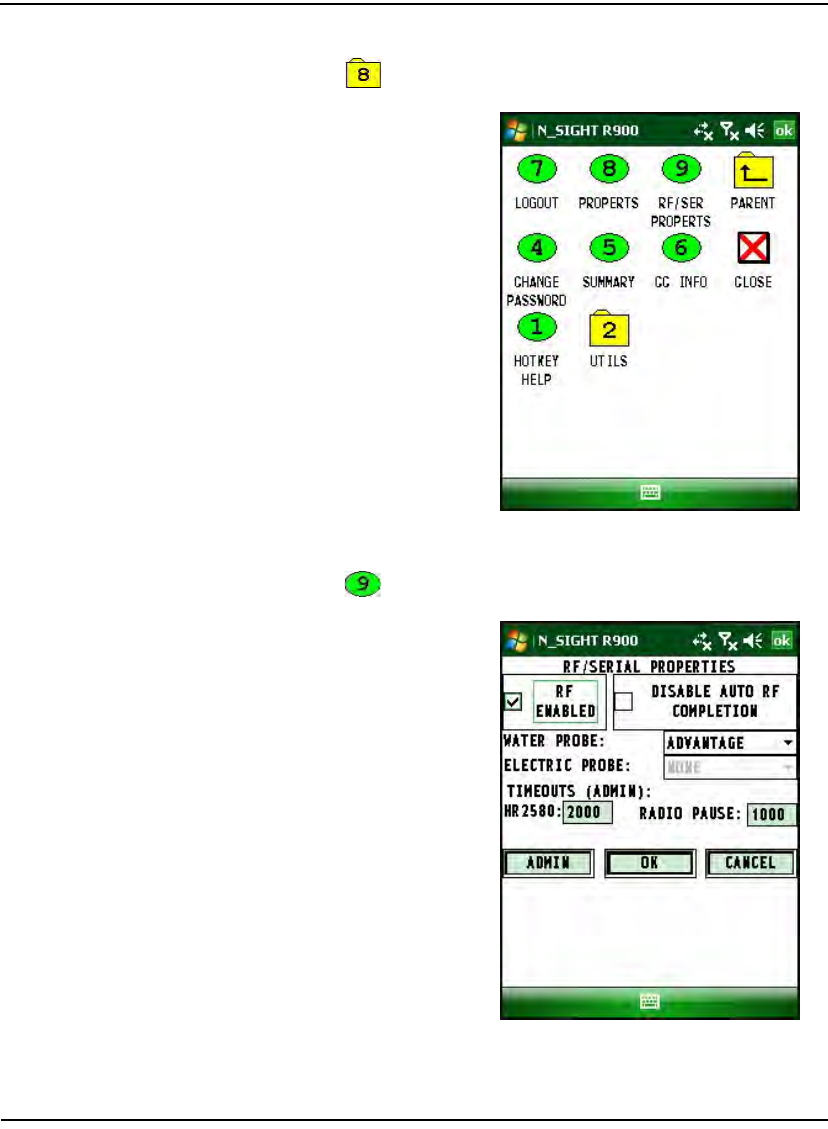
Using the Nomad Handheld
N_SIGHT R900 User’s Manual for the Neptune Handheld System 4-29
2 Touch .
The System Menu
appears as illustrated
in Figure 4.18.
Figure 4.18 N_SIGHT R900 System Menu
3 Touch .
The RF/Serial
Properties screen
appears as illustrated
in Figure 4.19.
Figure 4.19 RF/Serial Properties Screen
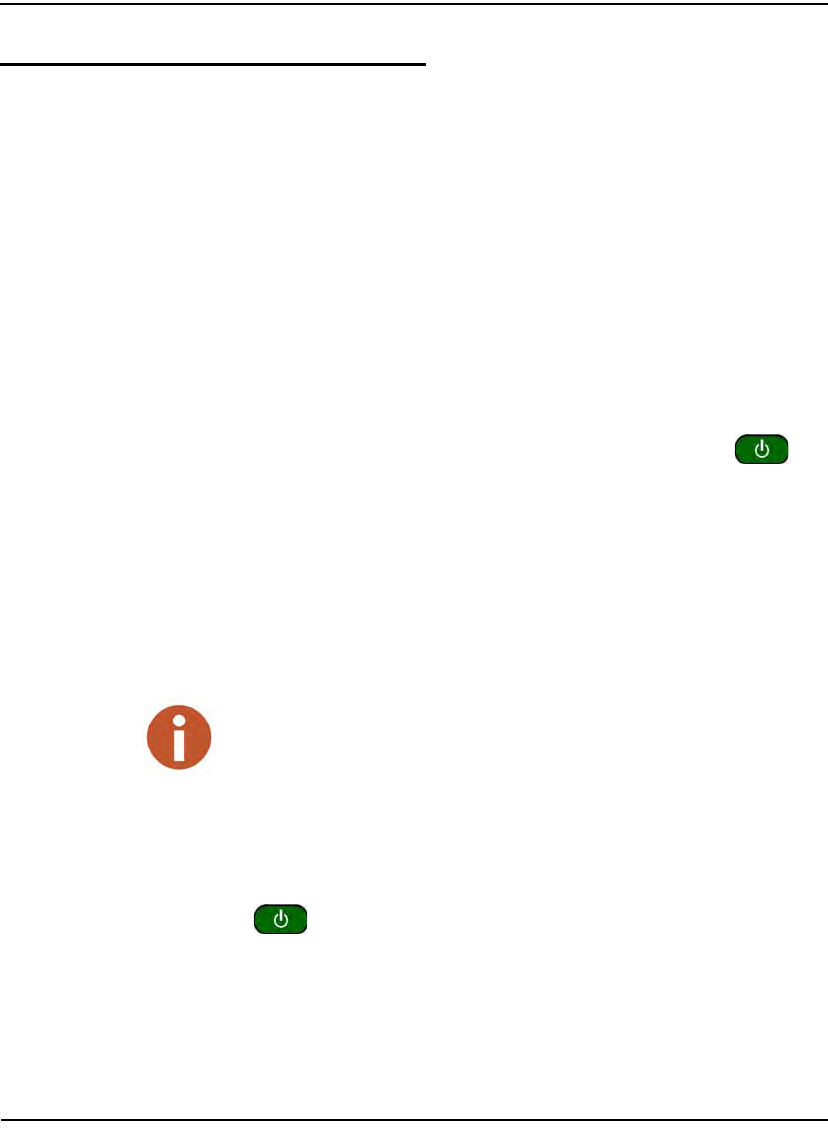
Using the Nomad Handheld
4-30 N_SIGHT R900 User’s Manual for the Neptune Handheld System
Turning On and Off the Nomad
This section explains how to turn the handheld on and off, and then how
to sign on to access the screens needed to complete meter reading tasks.
Whenever the handheld is in a communication cradle, it is on. This is
because, when connected properly, the cradle supplies power. However,
once the handheld is taken out of the cradle, the unit runs on its battery.
When powered by the battery, you can manually turn on the handheld
and you can turn it off automatically or manually.
Use the following procedures to turn the handheld on or to turn it off
manually.
Turning the Nomad On
Turn on the Nomad Handheld by pressing and releasing the
button. The Nomad shows a menu, data-entry, or message screen
depending upon the last activity performed with the unit.
One of the most convenient features is suspend/resume. There is no
waiting for the unit to boot up every time it is turned on. (This does not
occur the first time the unit is powered ON.)
Turning the Nomad Off
Manually turn off the handheld by pressing and holding down the
button for five seconds, then release. Choose Shut Down. The
display goes blank indicating that the handheld is off.
A message indicating low battery can appear on the battery LED located on
right side of the unit. For a new Nomad, be sure to connect the plug to the
power cord and attach to the power supply. The unit will be charged in about
4.5 hours. Neptune recommends that you fully charge the unit prior to your
first use.
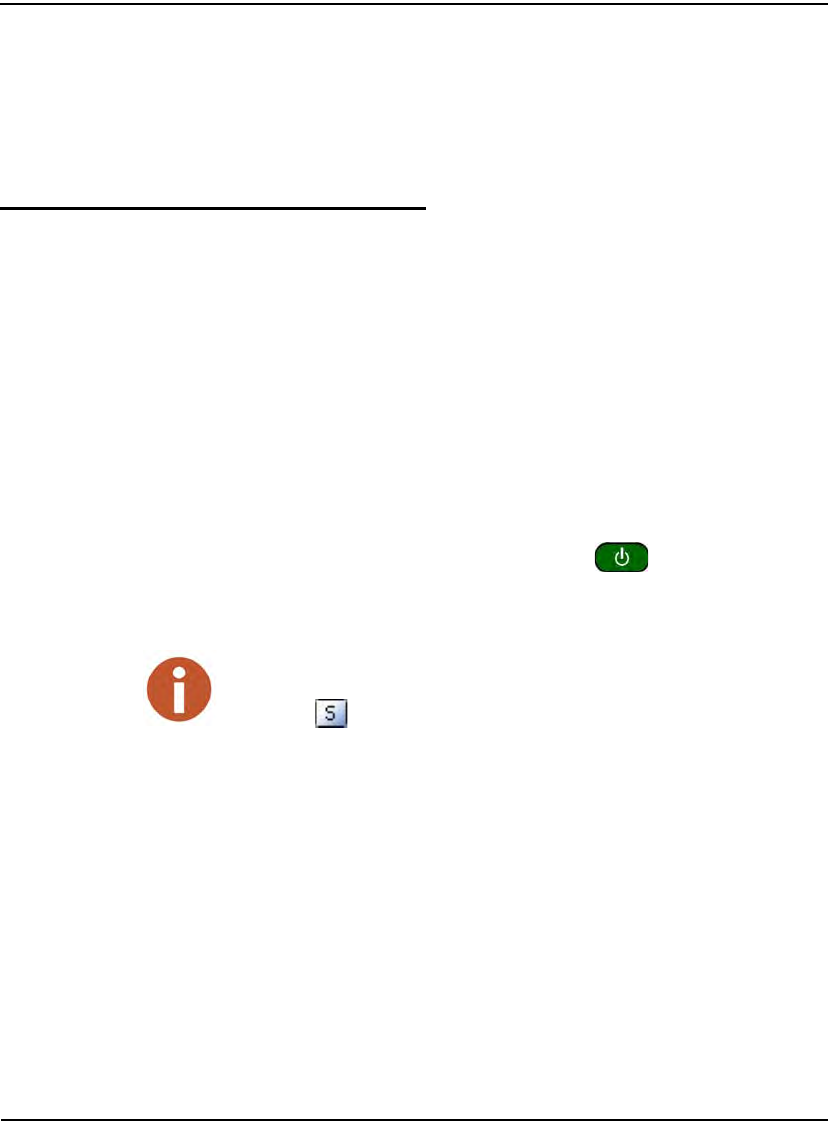
Using the Nomad Handheld
N_SIGHT R900 User’s Manual for the Neptune Handheld System 4-31
If you allow the handheld to remain inactive for the factory-set delay of
45 seconds or for the delay time specified by the host computer, it turns
off automatically. After this period of inactivity, the screen of the
handheld goes blank and the unit turns off to conserve the battery. Just
tap the screen to use the Nomad again.
Logging In and Out of the N_SIGHT R900
This section explains how to log into N_SIGHT R900 on the handheld
to access the screens needed to complete meter reading tasks.
Logging Into N_SIGHT R900 on the Nomad
After you have loaded a route, or after you have exchanged meter
readings and route data with the host computer, you need to log into
N_SIGHT R900 on the handheld. Signing on gives you access to the
screens you need to collect and exchange route and meter data.
Complete the following steps to log into N_SIGHT R900 on the
Nomad.
1 If you have not already done so, press to turn on the Nomad.
If you see the message Not Uploaded, this means the handheld has
been loaded but has not yet been uploaded. This is normal if a new route was
just loaded to the handheld.
Touch or Synchronize to start Communications. For more information,
refer to “Communicating with the Host Computer,” on page 7-1.
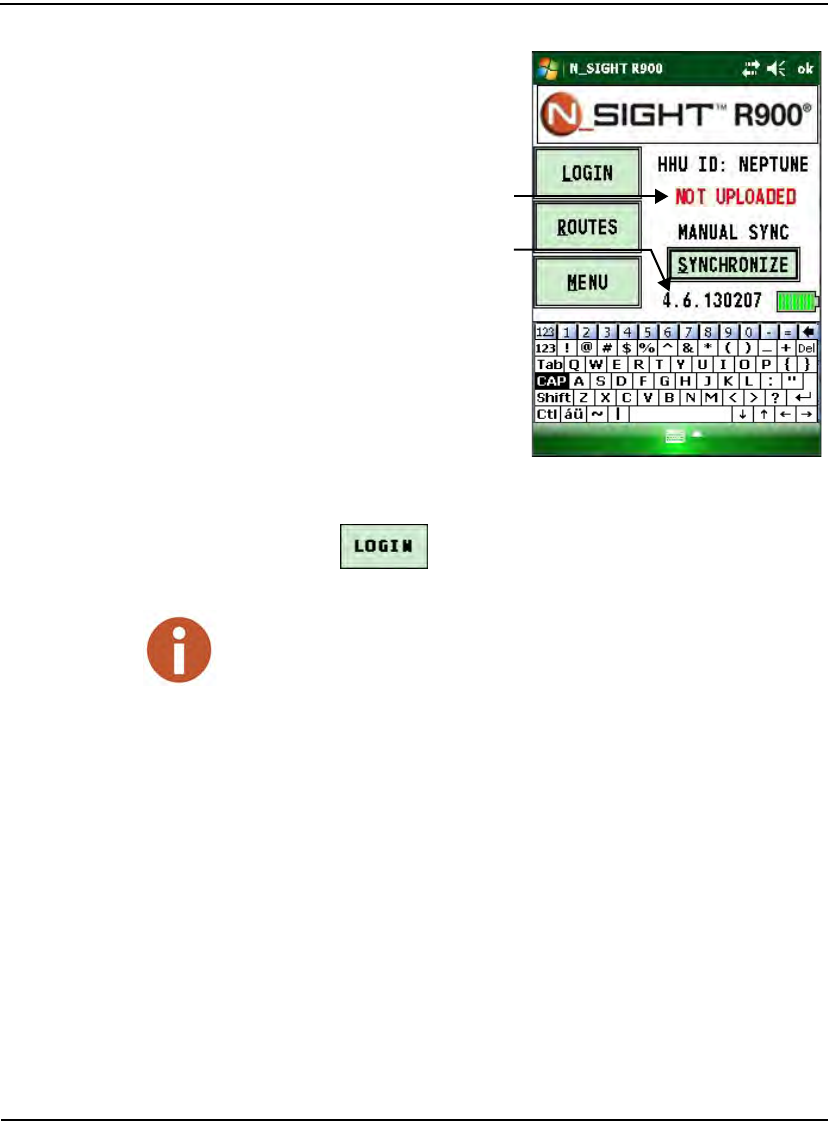
Using the Nomad Handheld
4-32 N_SIGHT R900 User’s Manual for the Neptune Handheld System
You can see a message
like the one illustrated in
Figure 4.20.
Figure 4.20 N_SIGHT R900 Message Area
2Click .
Version number
Message area
There may be times that the Clock Error screen appears when you are
attempting to log in. When this screen appears, continue with the following
steps.
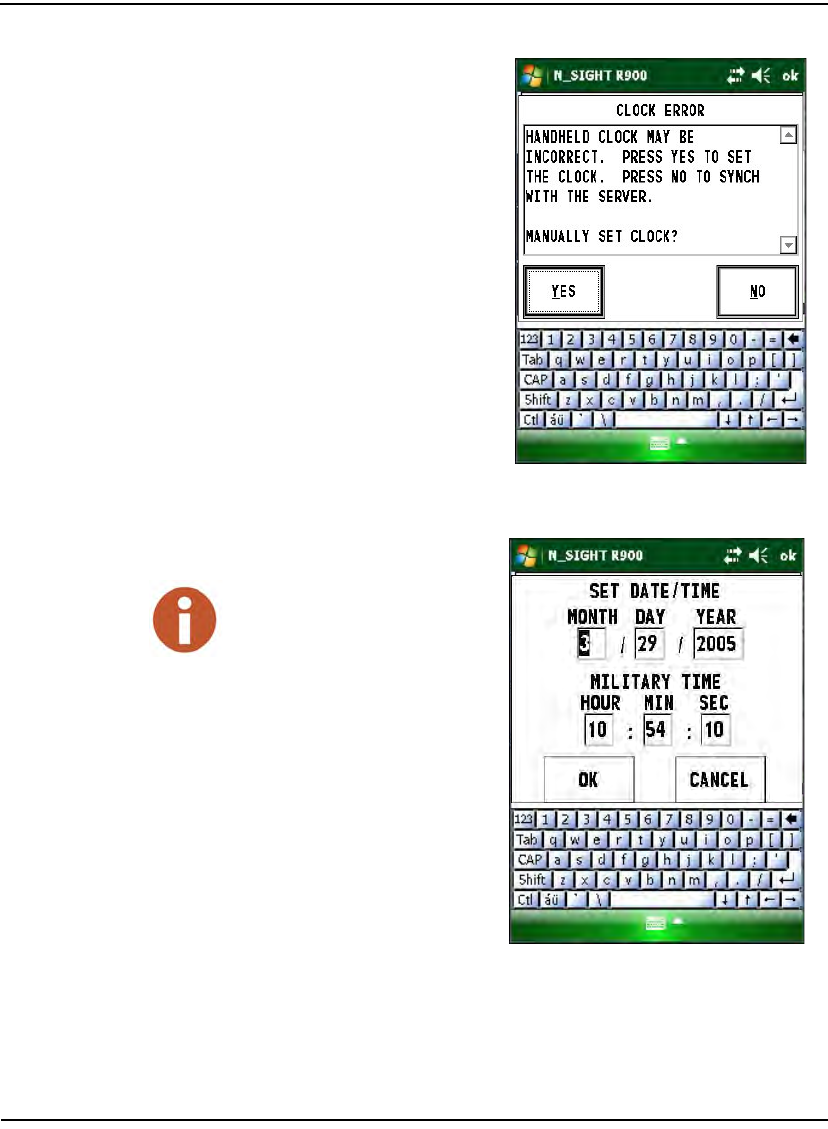
Using the Nomad Handheld
N_SIGHT R900 User’s Manual for the Neptune Handheld System 4-33
A Clock Error screen
appears, prompting you to
log on and manually set
the clock, as illustrated in
Figure 4.21.
Figure 4.21 N_SIGHT R900 Clock Error Screen
3Click Yes.
After you click Yes, the
Set Date/Time screen
appears as illustrated in
Figure 4.22.
Figure 4.22 N_SIGHT R900 Set Date / Time Screen
If you answer NO to the
clock error message, the
Login screen appears again.
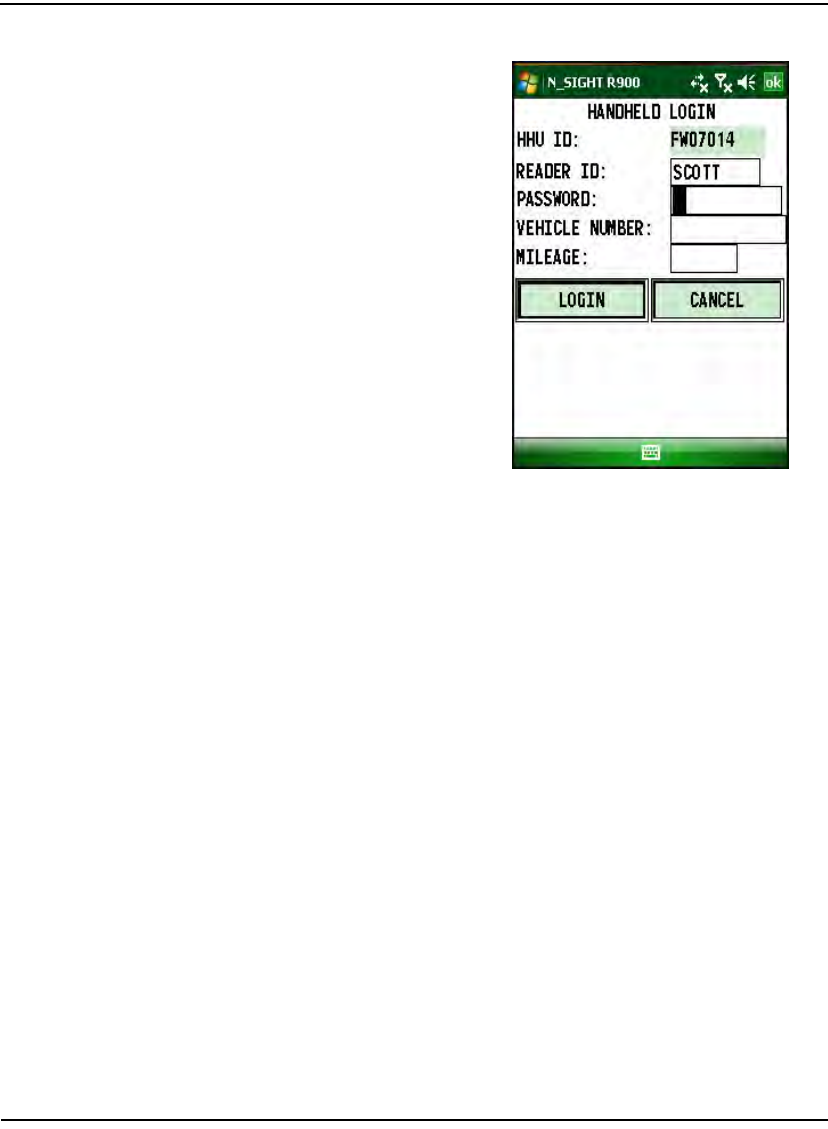
Using the Nomad Handheld
4-34 N_SIGHT R900 User’s Manual for the Neptune Handheld System
4 If applicable, make any
changes to the date and
time.
The correct date and time
to use is the date and time
that the handheld last
synchronized.
5 When the date and time
are accurate, click OK.
The Handheld Login
screen appears as
illustrated in Figure 4.24.
Figure 4.23 N_SIGHT R900 Handheld Login Screen
The Reader ID field displays the information contained in the
N_SIGHT R900 system.
6 Complete the following information as applicable:
•Password (Determined by N_SIGHT R900 setup)
•Vehicle # (Optional)
•Mileage (Optional)
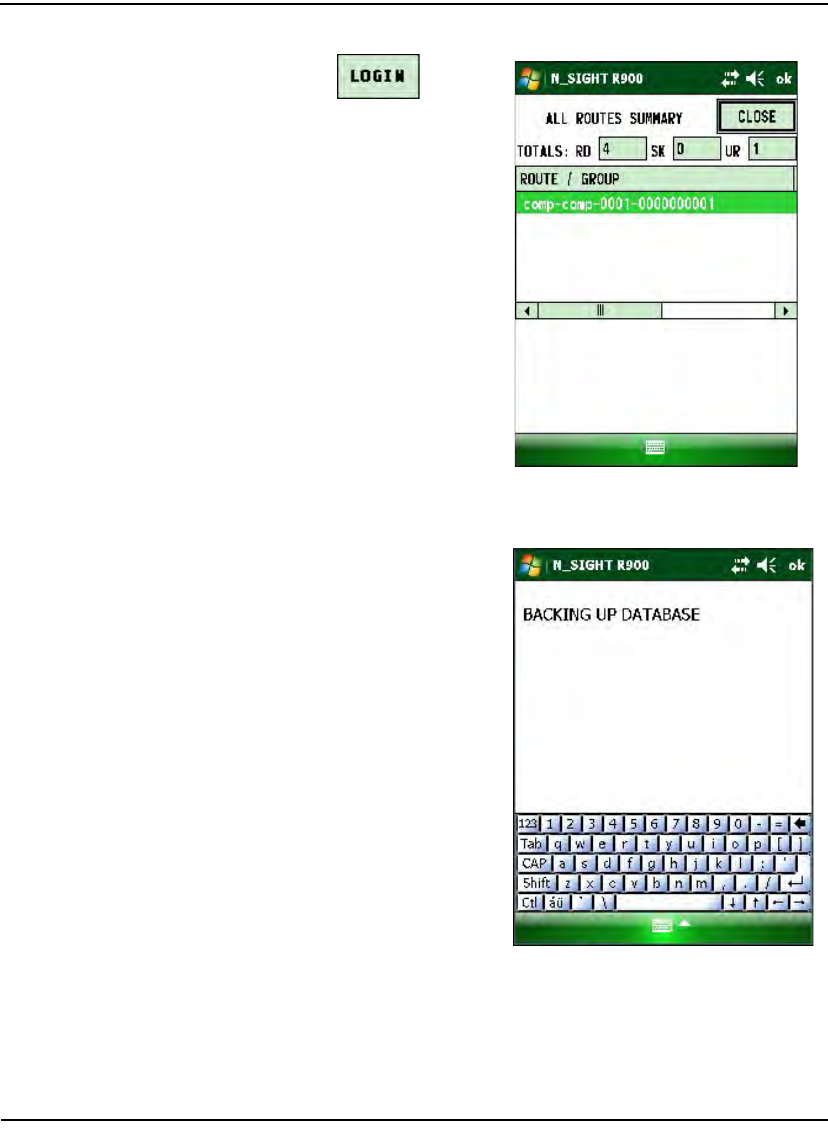
Using the Nomad Handheld
N_SIGHT R900 User’s Manual for the Neptune Handheld System 4-35
7Click .
The Select Route screen
appears as illustrated in
Figure 4.24.
Figure 4.24 N_SIGHT R900 Select Route Screen
8Highlight the route you
want, and click OK.
A message appears
similar to the one
illustrated in Figure 4.25.
Figure 4.25 N_SIGHT R900 Initializing Message
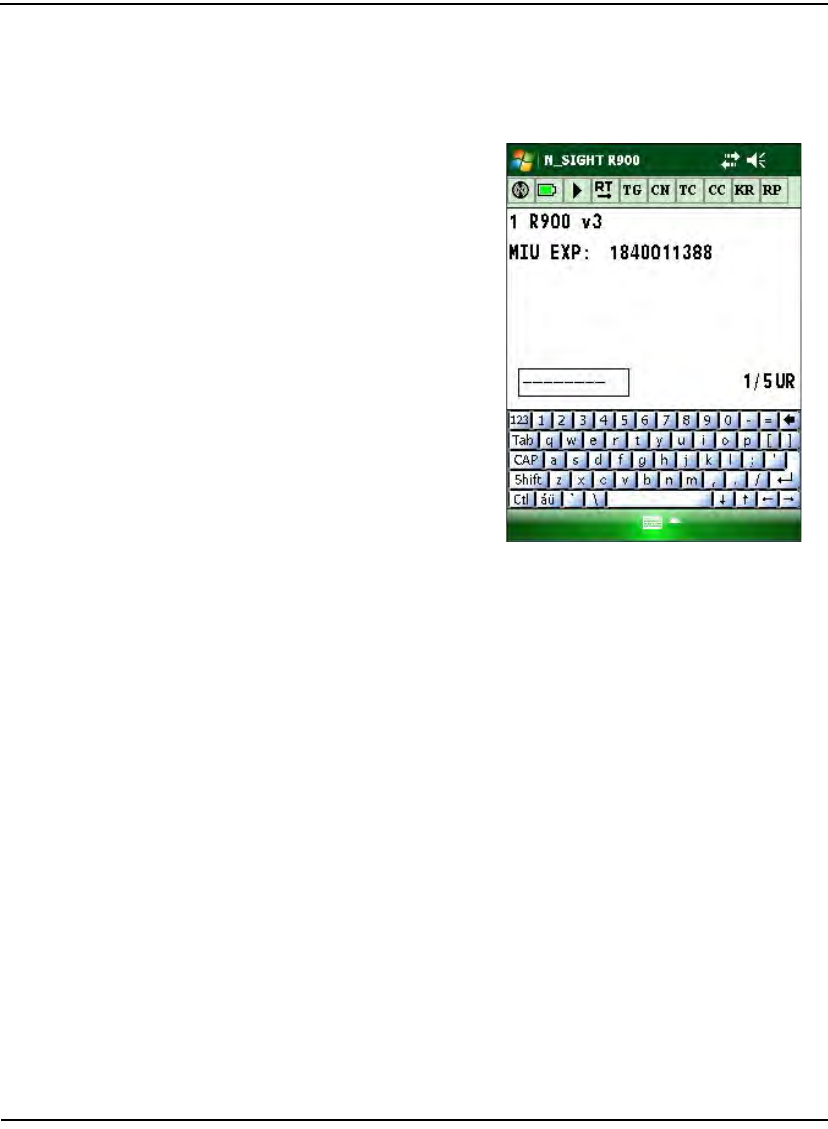
Using the Nomad Handheld
4-36 N_SIGHT R900 User’s Manual for the Neptune Handheld System
When the software has finished initializing a Reading Entry screen
indicating that the sign on process is complete and that the unit is
ready for use in collecting readings. See Figure 4.26.
For assistance in using
the Nomad to collect
meter readings, refer to
Figure 6 on Page 6-1.
Figure 4.26 N_SIGHT R900 Reading Entry Screen
Logging Out of N_SIGHT R900
The only time that you need to log out of N_SIGHT R900 on the
handheld is just before you begin exchanging information with the host
computer. Logging out gives you access to the communication features
of the handheld. Because logging out of N_SIGHT R900, instructions
for logging out on the handheld are included in the procedures that
describe how to exchange information with the host computer. For more
information, see “Exiting the Software,” on page 7-1.
If you allow the handheld to remain inactive for the factory-set delay of
45 seconds or for the delay time specified by the host computer, it turns
off automatically. After this period of inactivity, the screen of the
handheld goes blank and the unit turns off to conserve the battery.

N_SIGHT R900 User’s Manual for the Neptune Handheld System 5-1
5 Setting Up the R900 Belt Clip Receiver
R900 Belt Clip Receiver
This section introduces you to the R900® Belt Clip Receiver
(R900 BCR). It will explain how the R900 BCR is incorporated into the
N_SIGHT R900 host software, and how it will be used by both meter
readers and operators. It will also help you become familiar with the
basic features and functions the handheld computer offers.
This chapter provides basic instructions for unpacking and inspecting
the R900 BCR. It also gives instructions for setting up the R900 BCR,
becoming familiar with the display, pairing it with the handheld, and
usage.
R900 Belt Clip Receiver Overview
The R900 BCR is a software-defined receiver capable of simultaneously
receiving R900, Advantage, and Pocket Pro Reader RF transmissions.
The R900 BCR collects readings and then transfers these readings to the
handheld through the Bluetooth connection. The R900 BCR also has the
capability to receive and store R900 readings that can be imported into
the billing system without the use of a handheld. Because the
R900 BCR is software-defined, you can apply firmware updates in
order to keep your R900 BCR current with new products introduced to
the market.
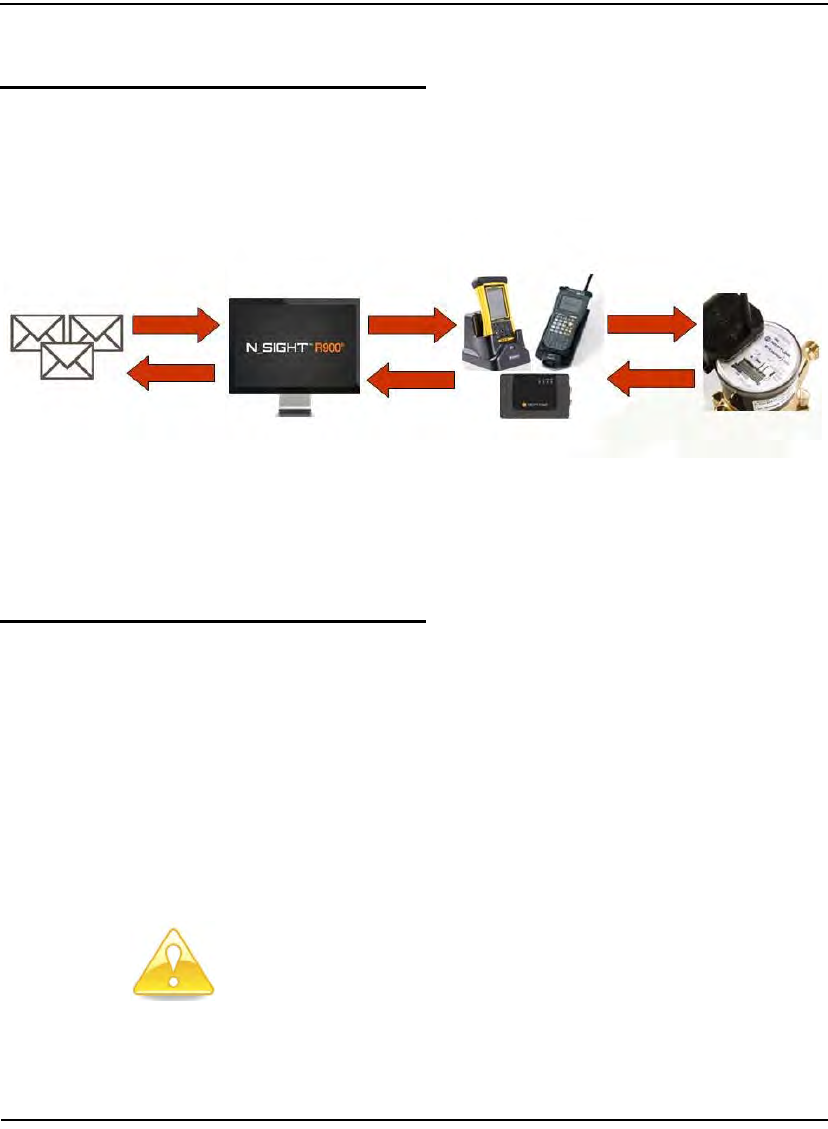
Setting Up the R900 Belt Clip Receiver
5-2 N_SIGHT R900 User’s Manual for the Neptune Handheld System
Nomad Handheld and R900 Belt Clip Receiver
The Trimble® Nomad® (Nomad) handheld utilizes Bluetooth
connectivity to Neptune’s R900 BCR to receive the meter readings.
Figure 5.1 Meter Reading Cycle
Unpacking and Inspecting Equipment
Besides using normal care, you need no special instructions to unpack
the handheld or the equipment that you purchased with it.
Check that you have received all the items you need for the type of
system configuration that you are using and inspect the items for
shipping damage. If you detect any damage, return the damaged
equipment to Neptune. Instructions for shipping the handheld to
Neptune are given in “Returning your R900 Belt Clip Receiver,” on
page 2-7 of this manual.
CIS/billing
software Host
management
software
Field
data collection
hardware
RF AMR
endpoint
Save the packing box that was used to ship the handheld. Should you ever
need to ship the handheld, you need to repack the unit in its original shipping
box. The handling involved in land and air transport often subjects the
handheld to impact beyond that which occurs during normal use. The packing
box is designed to absorb shocks and protect the handheld device during
shipping.
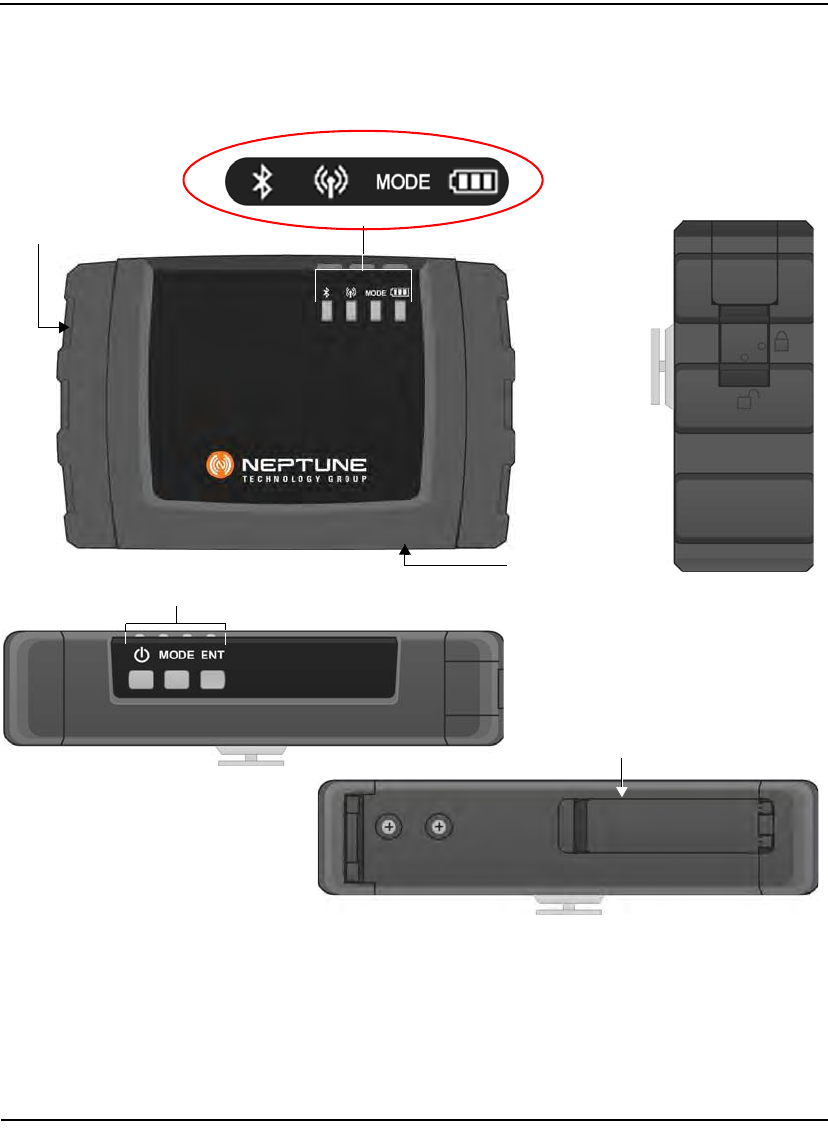
Setting Up the R900 Belt Clip Receiver
N_SIGHT R900 User’s Manual for the Neptune Handheld System 5-3
R900 Belt Clip Receiver Components
Figure 5.2 shows the basic components of the R900 BCR.
Figure 5.2 R900 Belt Clip Receiver Components
LEDs
SD/USB
Battery door
Power buttons
SD card/battery door
Side view
Side view
Top view
Front view
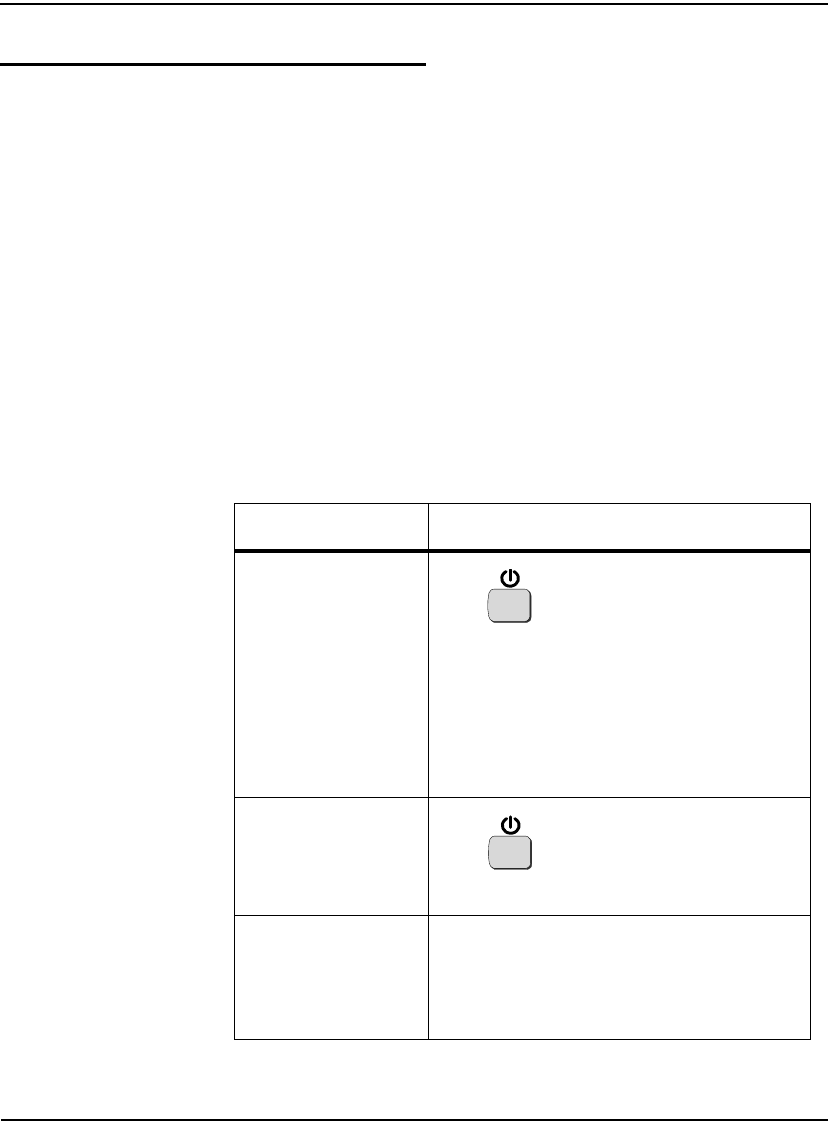
Setting Up the R900 Belt Clip Receiver
5-4 N_SIGHT R900 User’s Manual for the Neptune Handheld System
Using the R900 Belt Clip Receiver
The following section explains how to use the R900 BCR.
Understanding the R900 Belt Clip Receiver Modes
The following tables describe the R900 BCR modes of operation. You
change modes on the R900 BCR with a combination of the Mode and
Enter buttons. To cycle through available modes, you press the Mode
button. The Mode indicator will flash with the color for the mode to
enter. To enter the Mode, you press the Enter button within two seconds
of pressing the Mode button. If entered, the Mode indicator displays the
newly-entered mode. If you do not press Enter within two seconds, the
R900 BCR stays in the previous mode. This combination of Mode and
the Enter button is done to prevent accidental mode changes during
operation.
Table 5.1 R900 Belt Clip Receiver Power
Function Explanation
Power ON
Press for two seconds. The backlight turns
orange when the power is applied.
The unit takes approximately one minute to fully
boot. The Mode and RF lights are white during
most of boot-up. The unit is fully booted when the
Mode and Enter light turn off and the Mode LED
displays the previous mode of operation
Power OFF
Press for two seconds.The mode and RF
lights blink until off.
Setting Date/Time The R900 BCR synchronizes the time with the
Nomad when the two are paired. The time on the
R900 BCR defaults to the time from the last
Nomad synchronization.
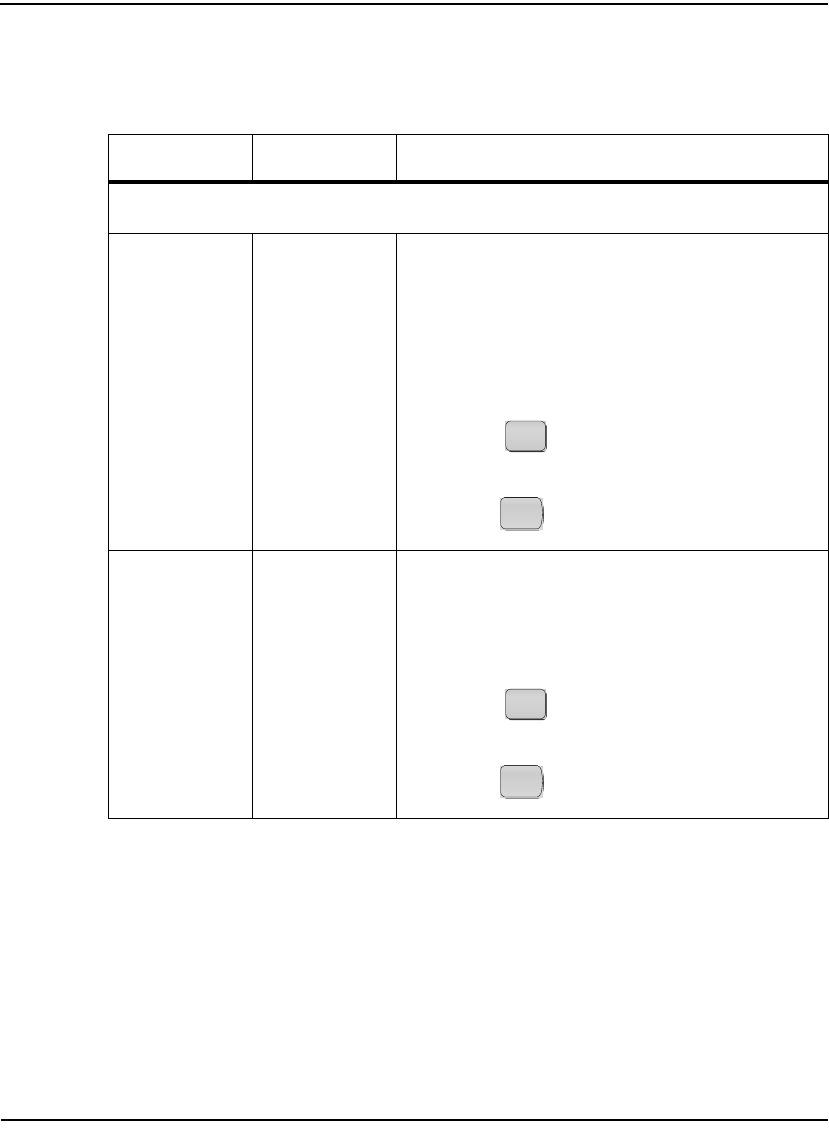
Setting Up the R900 Belt Clip Receiver
N_SIGHT R900 User’s Manual for the Neptune Handheld System 5-5
Table 5.2 R900 Belt Clip Receiver Modes
Function LED Color Explanation
Reading Modes
Normal (Green) Normal Mode is used to connect through Bluetooth to
a host device. Selection between Route (filtered) and
RF Test (unfiltered) is made in the host device
software.
To enter this mode from other modes.
1 Press until the Mode LED flashes green.
2Press , and the Mode LED turns green.
Unattended (Yellow) Unfiltered Operations Mode can operate using the
battery or when connected to vehicle power.
To enter this mode with battery power:
1 Press until Mode LED is yellow.
2P
ress .
continued on next page
MODE
ENT
MODE
ENT
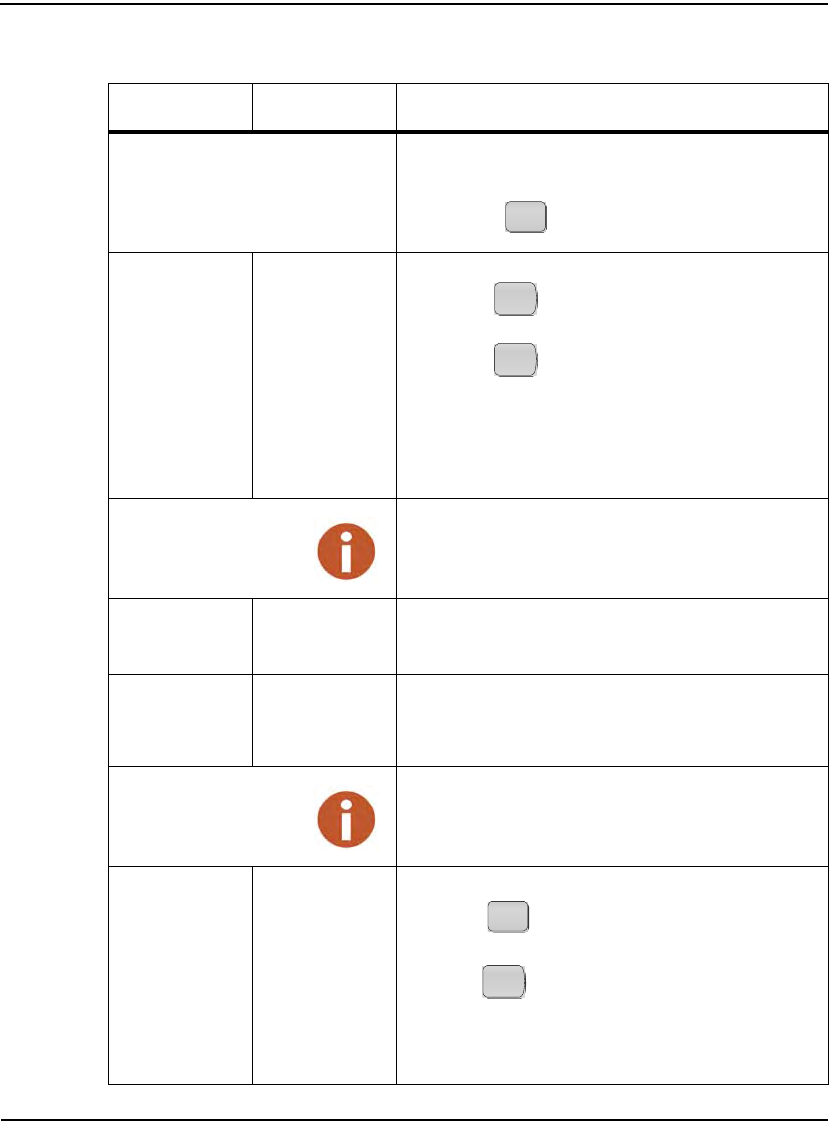
Setting Up the R900 Belt Clip Receiver
5-6 N_SIGHT R900 User’s Manual for the Neptune Handheld System
To enter from when connected to vehicle power:
1 Press until the Mode LED is yellow.
2 Press and release.
3Press again and hold for five seconds, then
release.
The Mode LED is Magenta.
4 Connect the USB.
The USB charger must be capable of suppling 1A of
current.
USB mass
storage (White) The SD card appears as an external drive to the PC.
To enter this mode:
1 Connect the USB to the R900 BCR and to the PC.
The USB must be connected before the unit can enter
the USB mass storage mode.
2 Press until Mode LED flashes white.
3P
ress .
The SD Card now shows as an external drive
attached to the PC.
Table 5.2 R900 Belt Clip Receiver Modes
Function LED Color Explanation
MODE
ENT
ENT
MODE
ENT
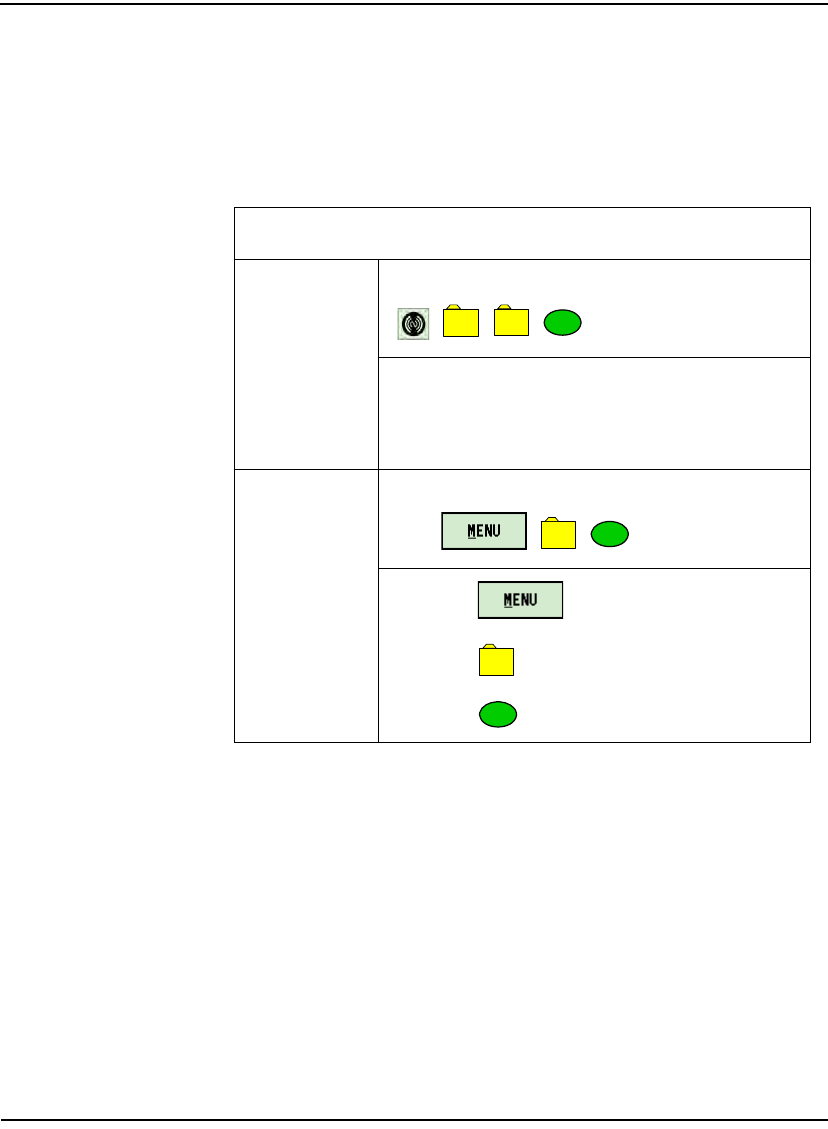
Setting Up the R900 Belt Clip Receiver
N_SIGHT R900 User’s Manual for the Neptune Handheld System 5-7
Accessing the R900 Belt Clip Receiver Status Screen
The R900 BCR must first be set to Normal Mode to access the
R900 BCR Status screen. The following tables explains how to access
the status screen on the handheld.
Table 5.3 R900 Belt Clip Receiver Software Functions
Accessing R900 Belt Clip Receiver Status Screen
While in route Neptune Key, System, UTILS, AMR Status =
, , ,
1 Select Advanced Options.
2Select the check box.
3 Select Belt Clip Status.
From the
Synchronize
screen
TAB twice, UTILS, Belt Clip Status =
Click , , .
1 Select .
2Select Utils.
3 Select Belt Clip Status.
8
2
8
5
8
5
8
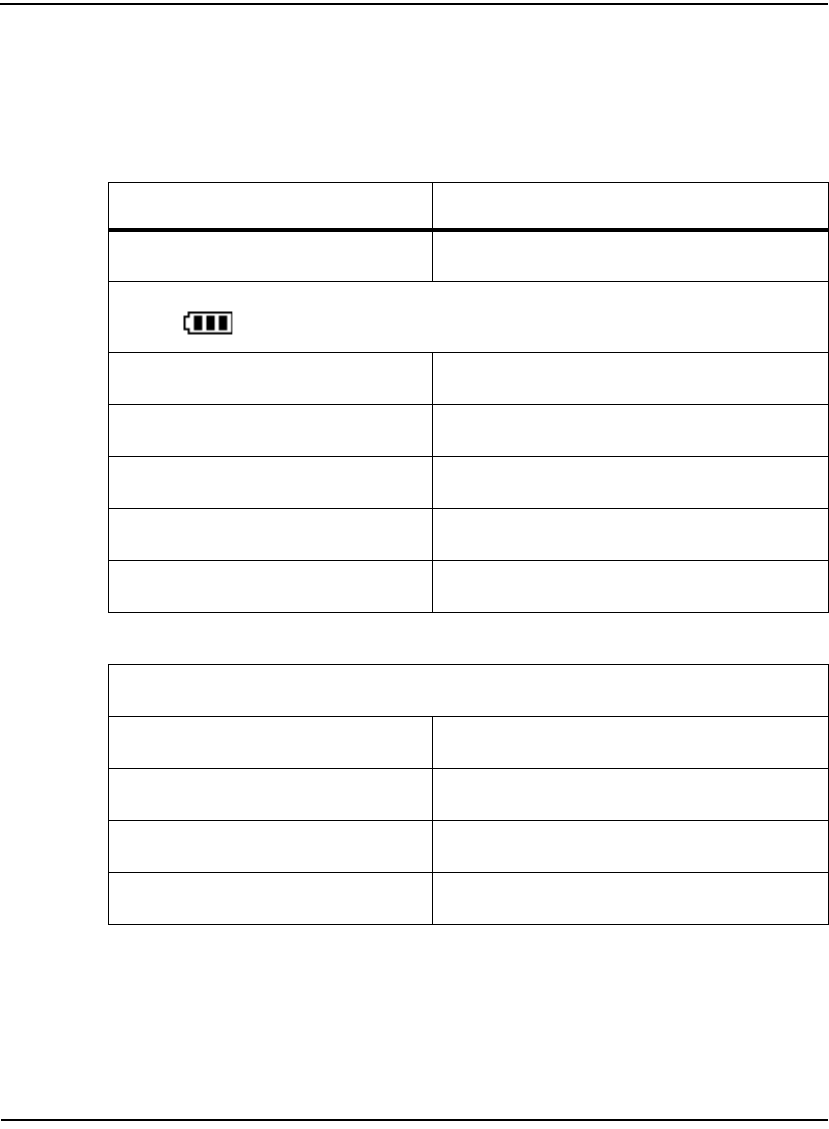
Setting Up the R900 Belt Clip Receiver
5-8 N_SIGHT R900 User’s Manual for the Neptune Handheld System
Understanding the R900 Belt Clip Receiver LED Operating Modes
To help you better interpret the different colors for the flashing Mode
LED, refer to the following table.
Table 5.4 R900 Belt Clip Receiver LED Operating Modes
State LED Colors
Unit powered OFF No color; LEDs off.
Power
On-Battery 100% – 31% Green
On-Battery 30% – 16% Yellow
On-Battery 15% – 6% Red
On-Battery 5% – Critical Flashes red
Battery – Charging Flashes yellow
Mode
Normal mode Green
Unattended mode Yellow
Installed mode Magenta
Mass storage mode White
continued on next page
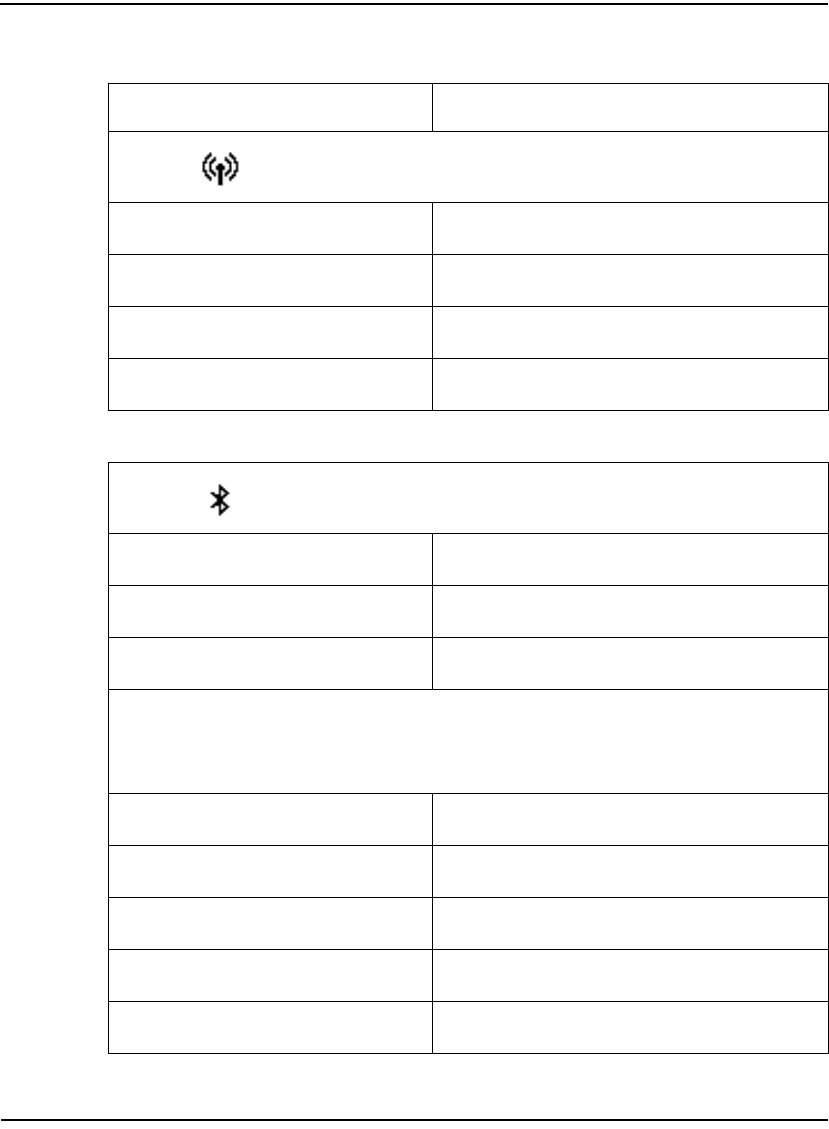
Setting Up the R900 Belt Clip Receiver
N_SIGHT R900 User’s Manual for the Neptune Handheld System 5-9
RF Mode
No reading being received Off
Receive R900/ERT packet Flashes green when receiving
Receive Advantage packet Flashes cyan when receiving
No reading received in two + minutes Solid red
Bluetooth
Not Connected Off
Pairing Flashes blue
Connected Blue
Error Codes
Temperature error Bluetooth and Power LED flash red five times
Hardware error Bluetooth and Power LED are solid red
Battery error Power LED flashes red and yellow
Cannot power on - battery too low Power LED flashes red three times
SD card error Mode LED is solid red
Table 5.4 R900 Belt Clip Receiver LED Operating Modes
State LED Colors
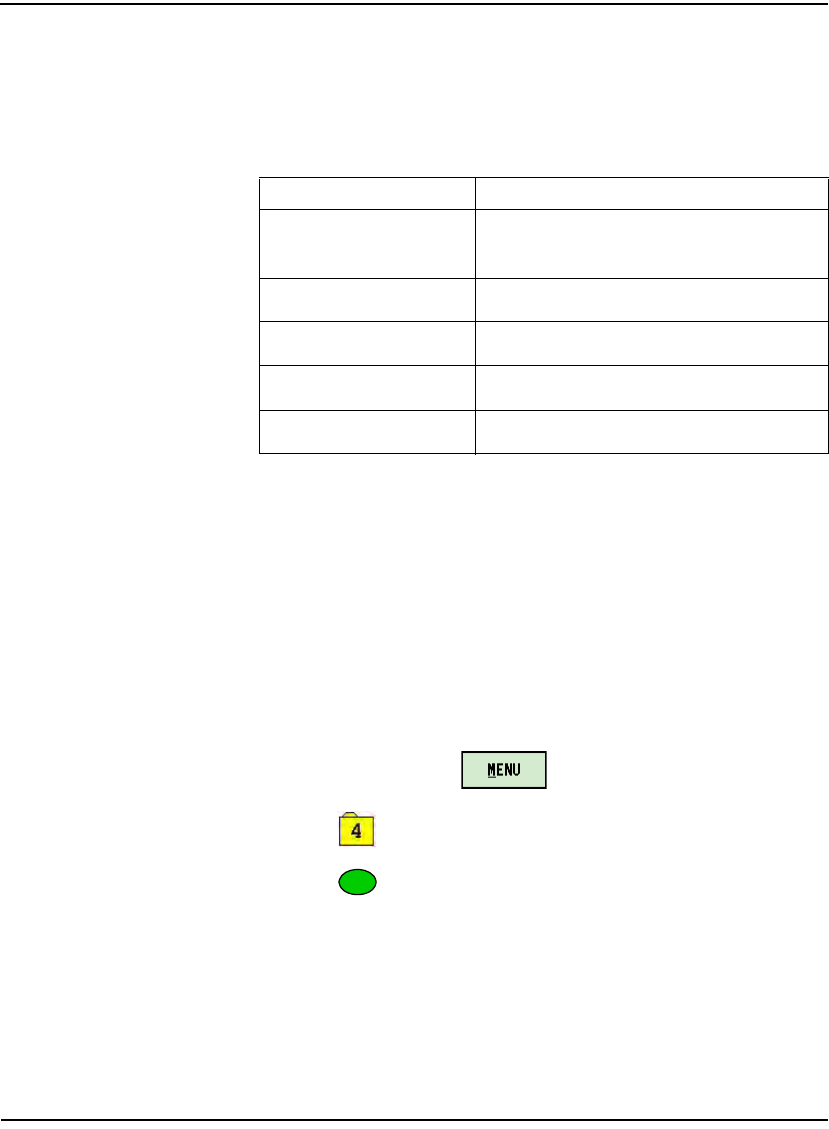
Setting Up the R900 Belt Clip Receiver
5-10 N_SIGHT R900 User’s Manual for the Neptune Handheld System
Understanding the External Battery Charger Status
Refer to the following table for a description of the external battery
LED.
Pairing the Trimble Nomad to the R900 Belt Clip Receiver through the Bluetooth
Complete these steps only if you are pairing the Nomad to the
R900 BCR for the first time.
Pairing the Trimble Nomad
To pair the Nomad to the R900 BCR, complete the following steps.
1 Power ON the R900 BCR and set to Normal Node, if not already
set. See “Understanding the R900 Belt Clip Receiver LED Operat-
ing Modes,” on page 5-8.
2 On the Nomad, click .
3Click – UTILS.
4Click – Belt Clip Status.
The AMR Connection screen appears. The R900 BCR is visible in
the Broadcasting Device drop-down selection list.
5 Choose the device from the drop-down selection list and click
Bluetooth.
Table 5.5 External Battery Charger LED
LED Indicates
Red, yellow, green or
OFF Startup initialization when applying power
OFF No battery inserted
Yellow Battery charging
Solid green Battery charged successfully
Red Error condition
8
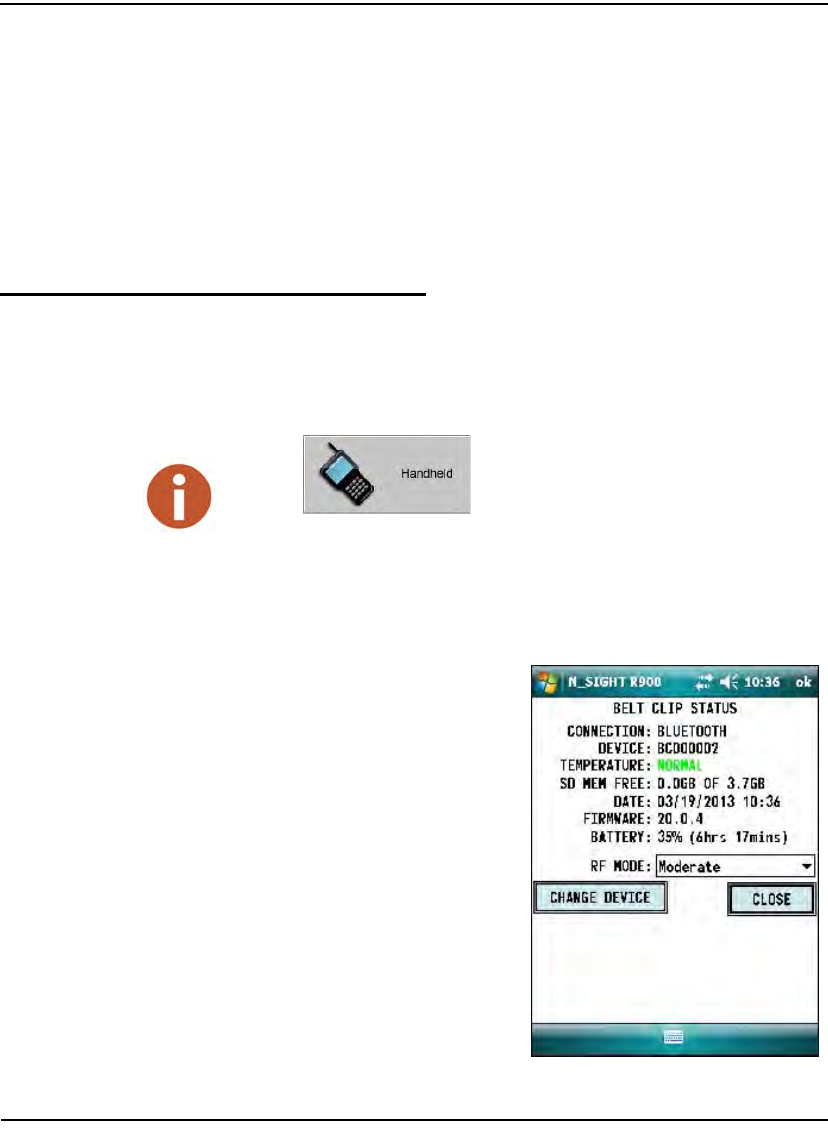
Setting Up the R900 Belt Clip Receiver
N_SIGHT R900 User’s Manual for the Neptune Handheld System 5-11
The R900 Belt Clip Receiver Status screen now displays the device
details.
• If you have previously paired a device, go to the R900 BCR
Status screen and not the AMR Connection screen.
• If you want to Change Devices, you can click this option on
the bottom of the R900 BCR Status screen.
You then see the AMR Connection screen and can choose the
device from the drop-down selection list.
Using the R900 Belt Clip Receiver to Read a Route
To begin reading a route using the R900 BCR, you first need to load a
route to the Nomad. See “Loading and Unloading Data for Handhelds”
in the N_SIGHT™ R900® Online Help.
Once the route is loaded and the pairing is complete, you can log in and
the unit can receive readings from the R900 BCR.
R900 Belt Clip Receiver Status Screen in N_SIGHT R900
While the Nomad and the
R900 BCR are paired, you
can access a screen showing
the status of the R900 BCR.
You can see a message like
the one illustrated in Figure
5.3.
Figure 5.3 R900 Belt Clip Receiver Status Screen
Click to load a route when you are working in the N_SIGHT
R900 host software.Press F1 to see the instructions for loading a route to a handheld.

Setting Up the R900 Belt Clip Receiver
5-12 N_SIGHT R900 User’s Manual for the Neptune Handheld System
The following information appears on this screen.
RF Performance Modes
This Mode can be changed from the R900 BCR Status screen. The unit
has three options for the RF performance during a reading:
Connection Displays the type of connection used to pair
the R900 BCR, such as Bluetooth
Device Displays the name of the R900 BCR
Temperature Displays the temperature of the R900 BCR,
such as normal.
SD MEM Free Displays the amount of available memory
for the SD card.
Date Displays the date and time as follows:
• Date: MM/DD/YYYY
• Time: HH:MM
Firmware Displays the version of the firmware on the
R900 BCR
Battery Displays the available battery percentages
RF Mode Allows you to change the reading mode for
the R900 BCR by clicking the drop-down
selection list.
•Efficiency –reduced RF performance
and best battery life
•Moderate – default RF performance
•Performance – best RF performance
and decreased battery life
1Efficiency Reduces RF performance* and best battery
life
2ModerateDefault RF performance*
2Performance Best RF performance* and decreased
battery life
*RF performance refers specifically to the throughput of the receiver
which can impact the speed with which readings are processed in
high density areas. Range is not impacted by these modes.
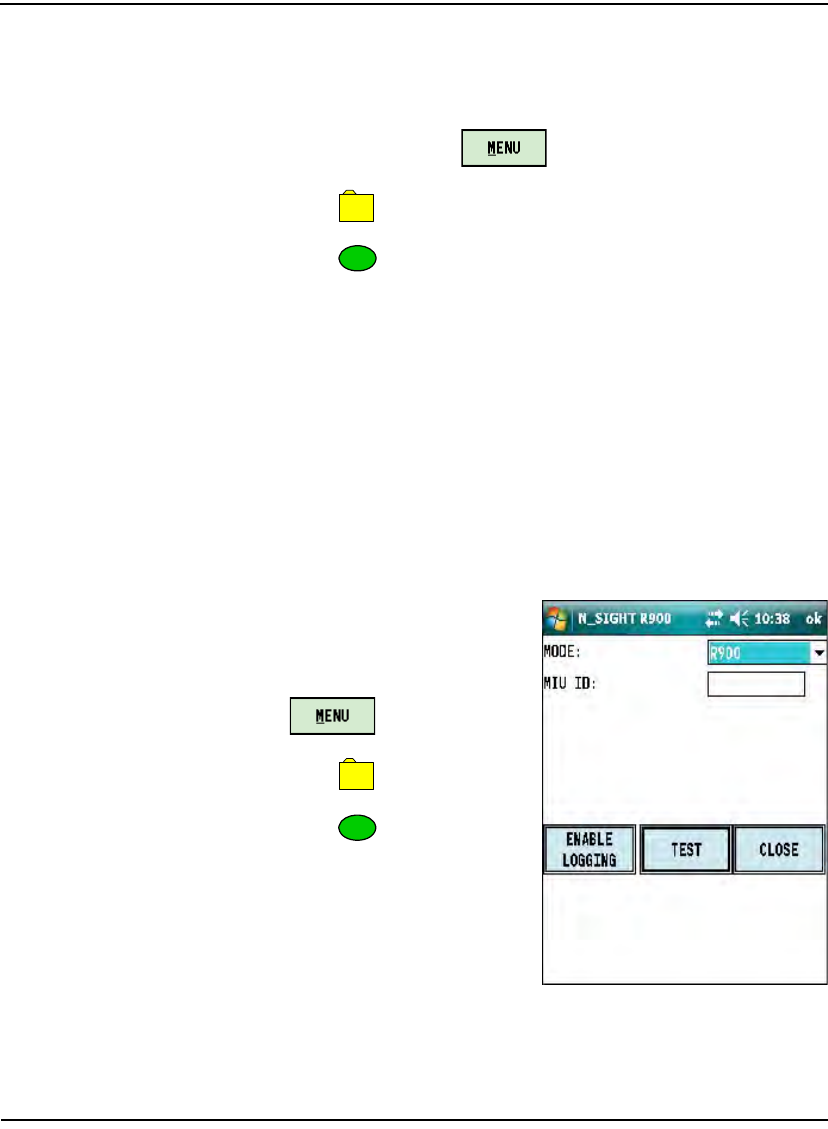
Setting Up the R900 Belt Clip Receiver
N_SIGHT R900 User’s Manual for the Neptune Handheld System 5-13
Selecting the R900 Belt Clip Receiver Reading Mode
To choose the reading mode, complete the following steps.
1 On the Nomad, click .
2Click –Utilities.
3Cl
ick –R900 Belt Clip Receiver Status.
The R900 Belt Clip Receiver Status screen appears.
4 Tap the drop-down selection list for RF Mode and you can choose
the reading mode. See the modes listed above.
Using the R900 Belt Clip Receiver RF Test Mode
RF Test Mode allows the R900 BCR to go into a continuous receive
mode and listens for any and all R900 transmissions.
From the Login Screen
To access RF Test Mode from the
Login screen, complete the
following steps.
1 On the Nomad, click
.
2Click –Utilities.
3Click –RF Test.
The RF Test Mode screen
appears as illustrated in Figure
5.4.
Figure 5.4 R900 Belt Clip Receiver RF Mode Screen
5
8
5
7
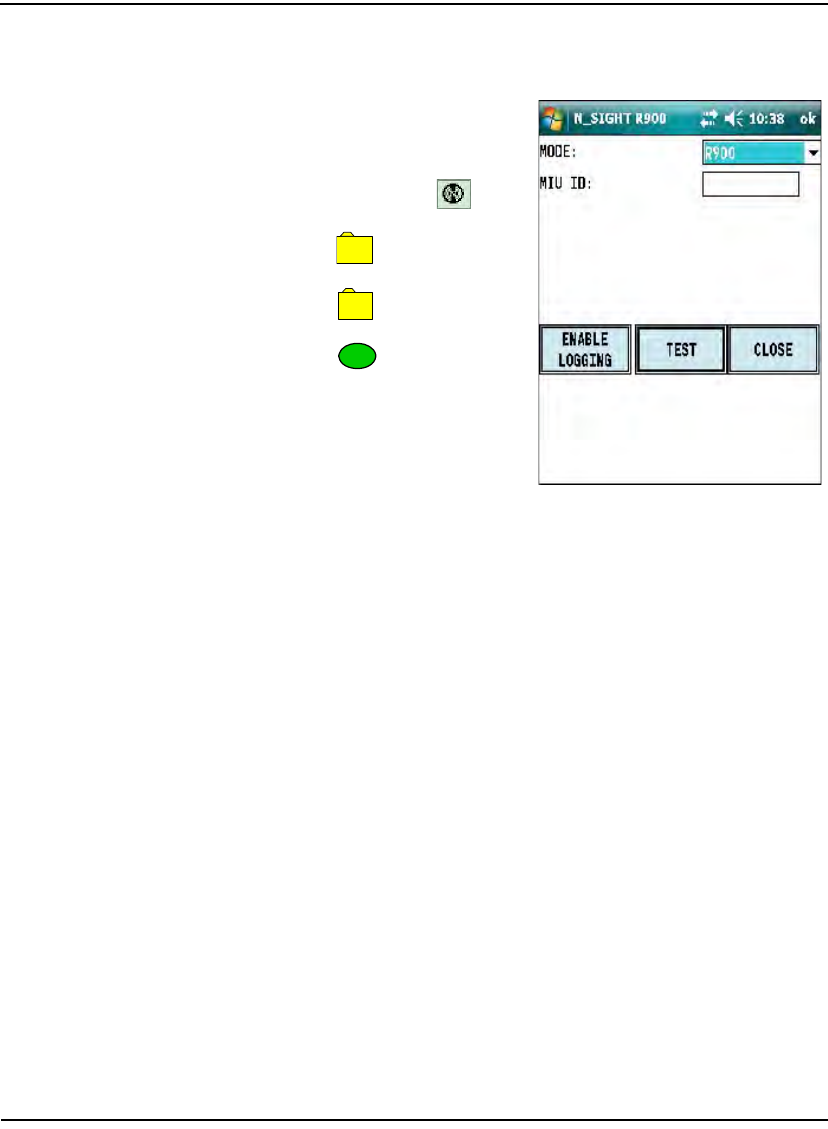
Setting Up the R900 Belt Clip Receiver
5-14 N_SIGHT R900 User’s Manual for the Neptune Handheld System
From the Route Screen
To access RF Test Mode from
the Route screen, complete the
following steps.
1 In the route, click .
2Click – System.
3Click – Utilities.
4Click – RF Test.
The RF Test Mode screen
appears as illustrated in Figure
5.4.
Figure 5.5 R900 BCR RF Mode Screen from Route
R900 Belt Clip Receiver SD Card Functionality
Any data that is read by the R900 BCR and sent to the handheld is
stored on its internal SD card.
The SD card also handles the firmware updates explained in “Using the
R900 Belt Clip Receiver,” on page 5-4.
8
2
7
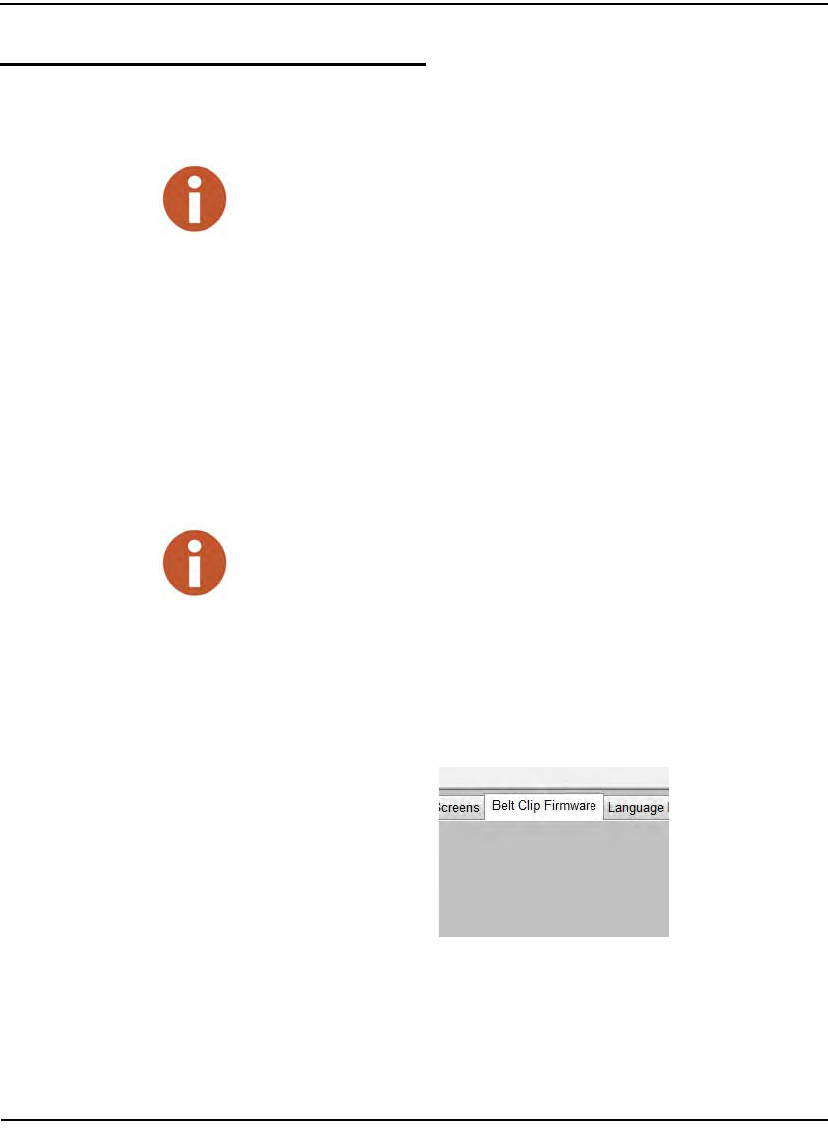
Setting Up the R900 Belt Clip Receiver
N_SIGHT R900 User’s Manual for the Neptune Handheld System 5-15
Updating R900 Belt Clip Receiver Firmware
When there is an update to the R900 BCR firmware, it is available from
Neptune through the web updates in the N_SIGHT R900 software, or it
can be obtained from Neptune Customer Support through email or direct
upload to an FTP site.
With either choice for receiving the firmware update; the firmware is
updated in the N_SIGHT R900 database and then sent to the R900 BCR
through the USB transfer cable or saved to the SD card and installed on
the R900 BCR.
To update the R900 BCR firmware, complete the following steps.
1 Connect the R900 BCR to the PC and place in Mass Storage Mode.
2 In the N_SIGHT R900 host software, select Utilities.
3 Select the Beltclip Firmware tab.
Figure 5.6 Tab within N_SIGHT R900 Utilities
You cannot update multiple R900 BCRs at once; they must be updated individually.
To update the R900 BCR firmware update with the USB cable, the R900 BCR must
first be connected to the PC and be in Mass Storage Mode. To update through the SD
Card, the Firmware Update File can be transferred to the SD card by using an SD Card
Reader
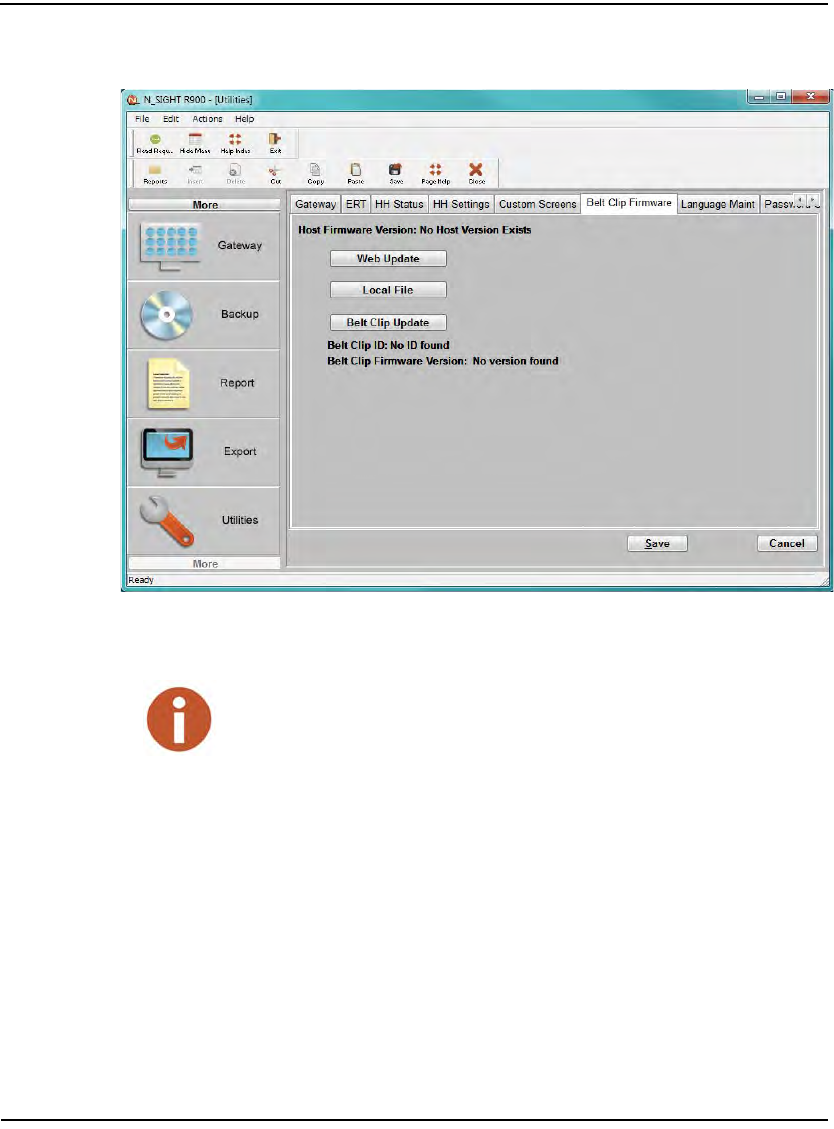
Setting Up the R900 Belt Clip Receiver
5-16 N_SIGHT R900 User’s Manual for the Neptune Handheld System
Figure 5.7 R900 Belt Clip Receiver Firmware Tab with Update Options
How the Firmware Update Works
The following explains how the firmware update works.
Web Update—looks to the Neptune servers for an updated version of
R900 BCR firmware and downloads it to the database
Local File—allows you to import updated firmware from a thumb
drive, network drive, or FTP site into the database
Belt Clip Update—locates the updated firmware file after the updated
firmware has been downloaded and sends it to the R900 BCR through
the USB transfer cable
The Web Update and Local File buttons perform the same task of updating the
database with the updated firmware version depending on where the updated
firmware file is located.

N_SIGHT R900 User’s Manual for the Neptune Handheld System 6-1
6 Gathering Route Data
This chapter provides instructions for using the handheld to collect
meter readings and route data. The procedures in this chapter assume
that route assignments have already been loaded onto the handheld.
When using this chapter, keep in mind that a sample reading-entry
screen is shown throughout the manual. The reading-entry screen of
your handheld may not resemble the one shown here. This
inconsistency is caused when the N_SIGHT R900 operator customizes
the screen so that it better suits the needs of your company.
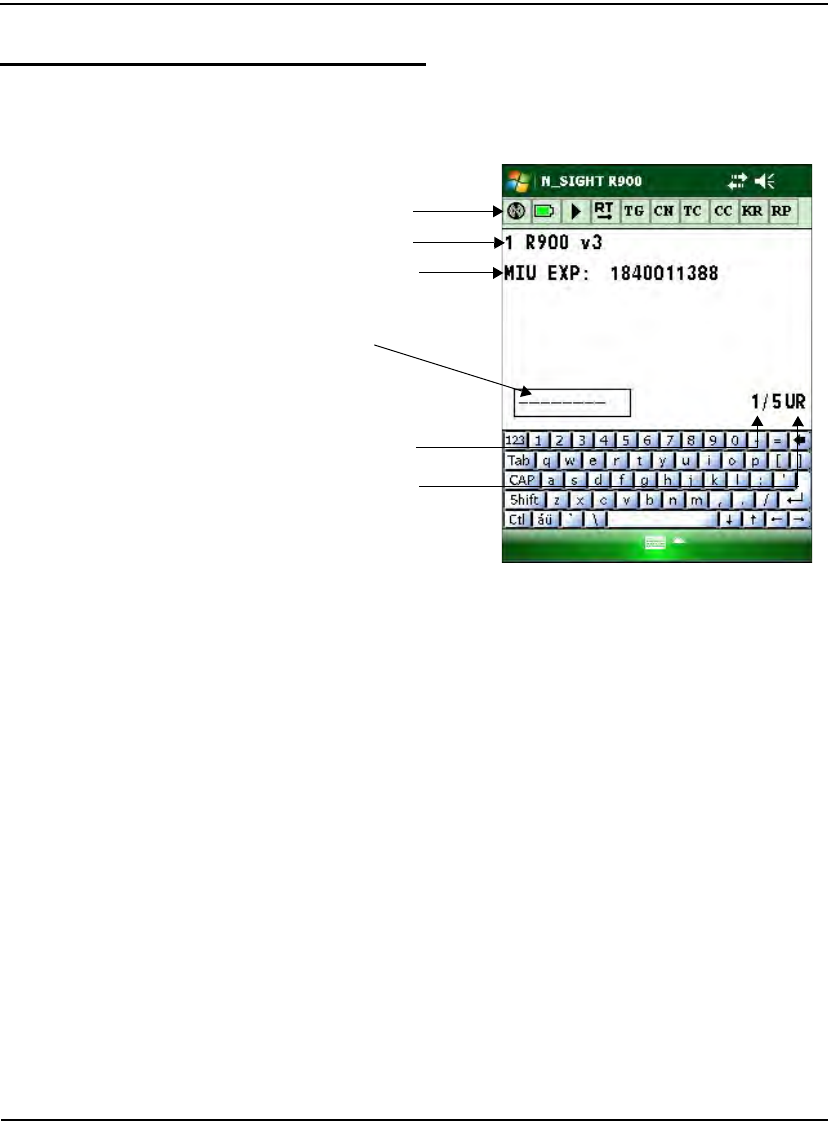
Gathering Route Data
6-2 N_SIGHT R900 User’s Manual for the Neptune Handheld System
The Reading Entry Screen
The following illustration shows the N_SIGHT R900 Reading Entry
screen.
Figure 6.1 N_SIGHT R900 Reading Entry Screen
Meter number
Icon bar
Account number
Location in route
Read entry
Status of account
(UR = unread)
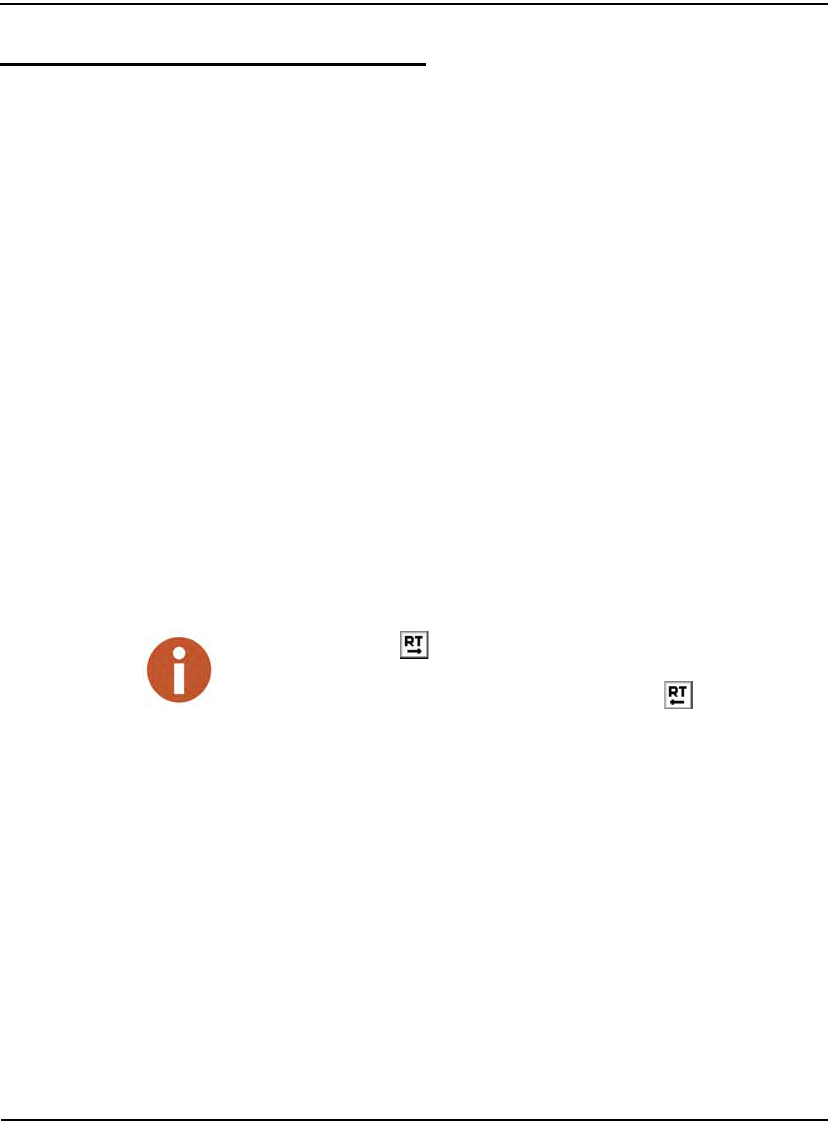
Gathering Route Data
N_SIGHT R900 User’s Manual for the Neptune Handheld System 6-3
Manually Collecting Meter Readings
When using the CE5320 to collect meter readings, typically you need to
enter only the reading for each meter. However, sometimes you may
need to also enter a trouble code or comment concerning conditions at
the account. Additionally, you may “skip” an account by inserting a
“skip code” and indicating why you skipped the account. The
procedures in this topic give you the information you need to manually
collect or skip readings:
•“Entering a Reading,” which follows
•"Entering a Skip Code" on page 5
•"Entering Comment Codes" on page 7
•"Adding Free-Form Notes" on page 9
Entering a Reading
Follow this procedure to enter a meter reading in the handheld.
1 If you have not already done so, first log into N_SIGHT R900 on
the handheld, so that a reading-entry screen is appears in the dis-
play. See Figure 6.1 on Page 6-2.
For help with this task, refer to “Logging Into N_SIGHT R900 on
the CE5320,” on page 3-26 or “Logging Into N_SIGHT R900 on
the Nomad,” on page 4-31.
If this is the first time that you have accessed a route, the reading-entry
screen of the first meter in the route appears in the display. If the read
direction is set for , “Left to Right,” then after the reading for the first
meter is taken the screen advances to the second meter in the route. By
clicking this icon, you can change the read direction to , “Right to Left.”
The read direction toggles between these two read directions.
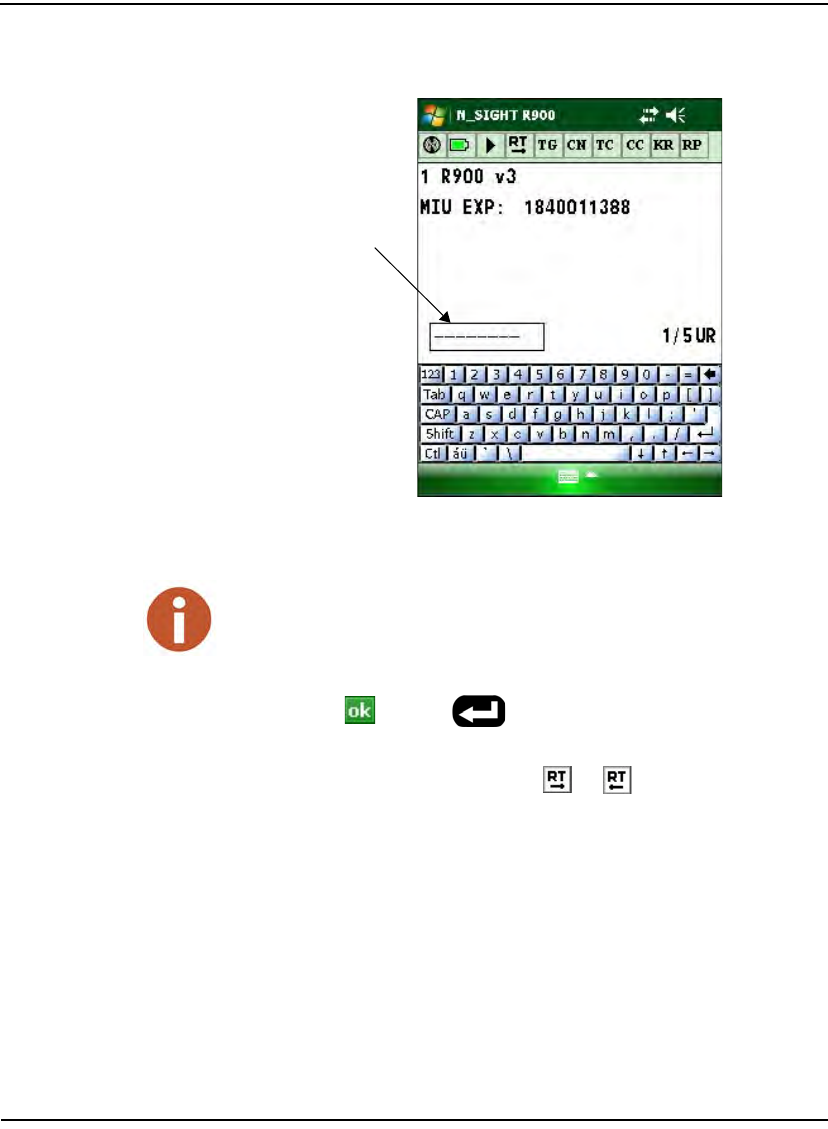
Gathering Route Data
6-4 N_SIGHT R900 User’s Manual for the Neptune Handheld System
2 Using the number keys, enter the reading in the space provided.
Figure 6.2 N_SIGHT R900 Reading Entry Field
3 Touch or press .
The N_SIGHT R900 software displays the next meter in the route,
according to the route direction or . Touching this icon and
temporarily change the direction for the route. However, to change
it for future uses, refer to the procedure for “Changing the Route
Direction, Forward or Reverse,” on page 6-14.
4 Continue entering readings for each meter until you have com-
pleted all routes assigned to you.
As you complete each route, a message appears in the display to let
you know that you have completed the route and are moving to a
new one. Follow the instructions shown in the display to access the
reading-entry screen of the next route.
Reading entry field
The number of hyphens in the reading entry field indicate the number of
reading digits required.
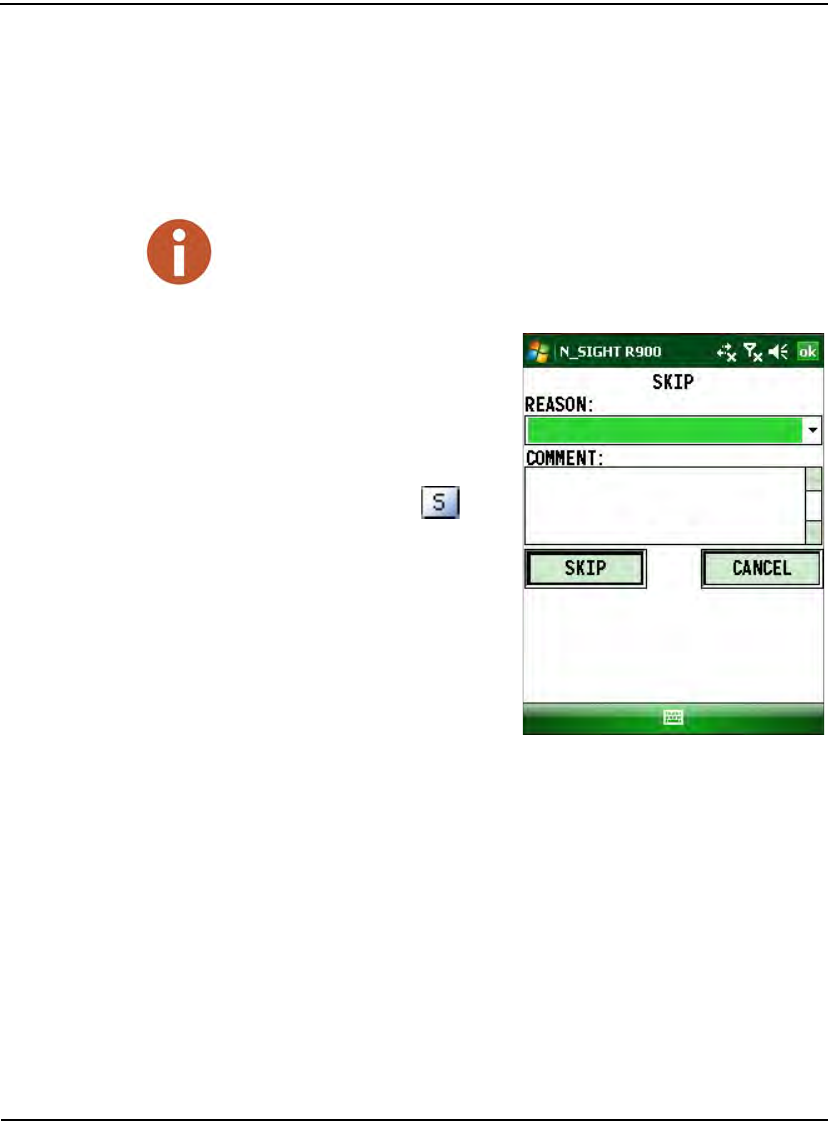
Gathering Route Data
N_SIGHT R900 User’s Manual for the Neptune Handheld System 6-5
Entering a Skip Code
In some cases, you may be unable to collect a reading. If you are unable
to collect a reading, you can enter a skip code, giving the reason that the
reading could not be obtained.
Follow this procedure to enter
a skip code instead of a
reading.
1 From the reading-entry
screen of the meter for
which you want to enter a
skip code, press on
the CE5320 keypad or the
Nomad screen keypad.
A screen appears
prompting you to enter a
skip code in place of the
reading. See Figure 6.3.
Figure 6.3 N_SIGHT R900 Skip Order Screen
In the V4 file format, screens can appear differently depending on the file format you
are using. For example, you could have either Coded Notes or Comment Codes.
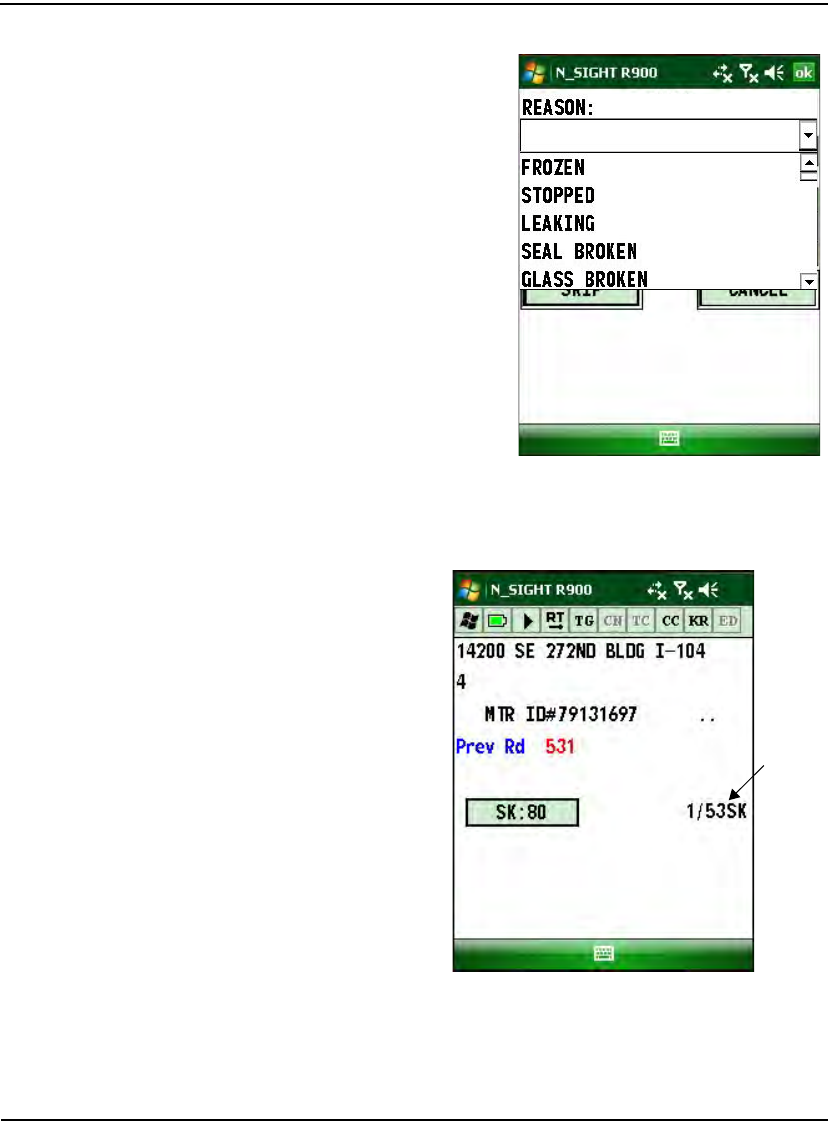
Gathering Route Data
6-6 N_SIGHT R900 User’s Manual for the Neptune Handheld System
2Click the drop-down selec-
tion list as illustrated in
Figure 6.4 to choose the
appropriate reason code.
Figure 6.4 N_SIGHT R900 Skip Order Reason Codes
The actual codes that are available to you are determined by the
host operator.
3In Comment, type
any notes for this
account.
4Click Skip.
The account is
marked as
skipped, as
illustrated in
Figure 6.5. The
N_SIGHT R900
software displays
the next meter in
the route.
Figure 6.5 N_SIGHT R900 Skipped Read
5 Continue entering readings within this route.
Skipped
read
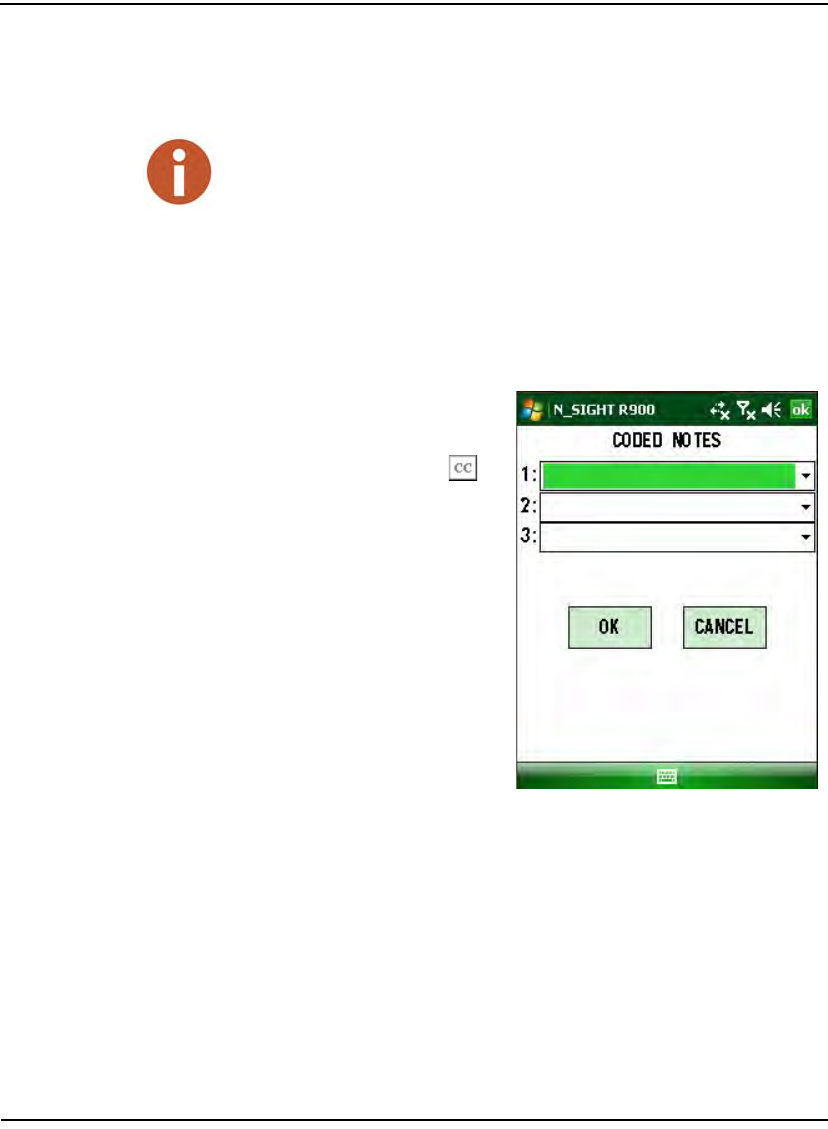
Gathering Route Data
N_SIGHT R900 User’s Manual for the Neptune Handheld System 6-7
Entering Comment Codes
In some cases, you may need to enter a comment code (a coded note) for
trouble or another reason for a meter. For example, if the glass is broken
or the seal is broken, the meter is leaking or frozen, or has a bad dial. If
you notice trouble while collecting a reading, you can enter a trouble
code. Follow this procedure to enter a trouble code.
1From the reading-entry
screen of the meter for
which you want to enter a
trouble code, touch .
A Coded Notes screen
appears prompting you to
enter coded notes. See
Figure 6.6.
Figure 6.6 N_SIGHT R900 Coded Notes Screen
In the V4 file format, screens can appear differently depending on the file format you
are using. For example, you could have either Coded Notes or Comment Codes.
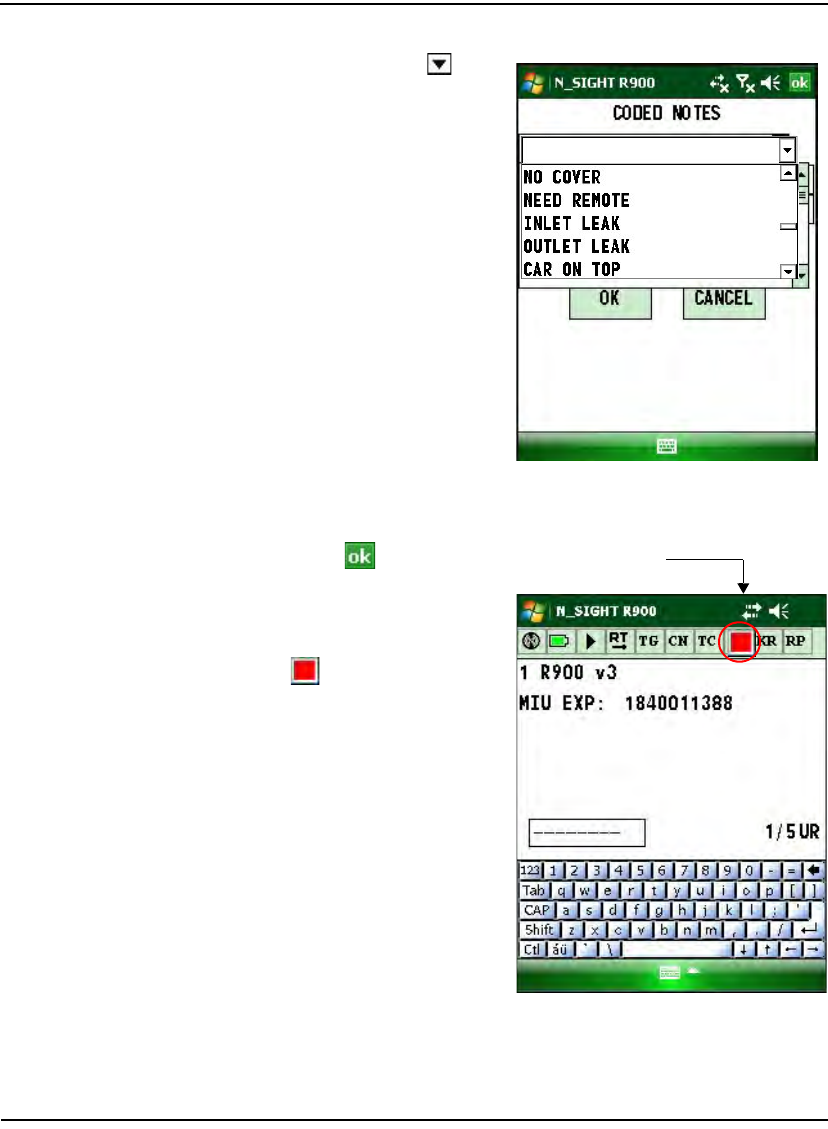
Gathering Route Data
6-8 N_SIGHT R900 User’s Manual for the Neptune Handheld System
2Touch the DOWN
arrow to view the list of
codes, as illustrated in Fig-
ure 6.7.
3 Select the appropriate
code for the trouble found.
4 Select one or two addi-
tional codes, if applicable.
Figure 6.7 Drop-down Selection List of
Coded Notes
1. Touch to save the
trouble codes associated
with the meter.
The icon changes to
, as illustrated in
Figure 6.8 to show that
there is a comment code
attached to this account.
This works as a toggle.
Figure 6.8 N_SIGHT R900 Comment Code
Marked Comment Code
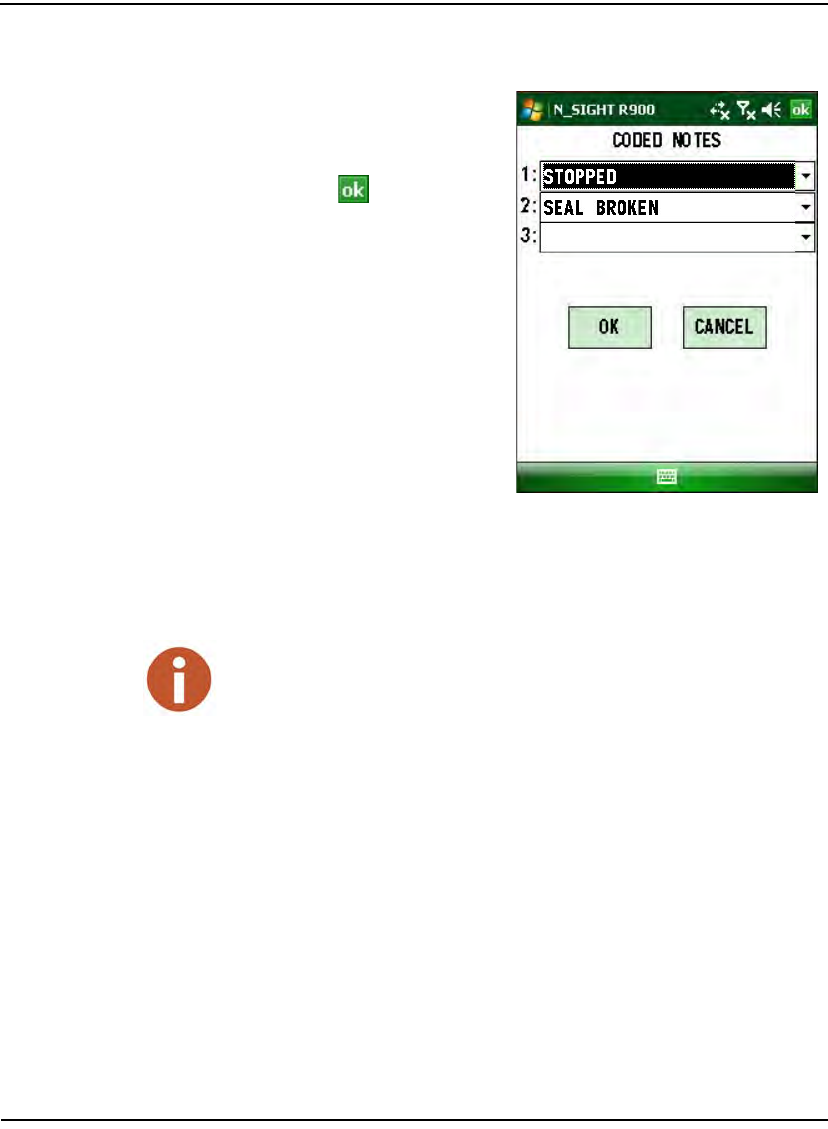
Gathering Route Data
N_SIGHT R900 User’s Manual for the Neptune Handheld System 6-9
5To view the trouble codes
entered for this account,
click the red icon.
6Click to return to the
Route.
7 Continue entering read-
ings within this route.
Figure 6.9 Viewing Comment Codes
Adding Free-Form Notes
In some cases, you might want to add some free-form notes to inform
your office about a change to an account. When the N_SIGHT R900
operator uploads data from your handheld, your message is sent to the
N_SIGHT R900 host software and may also be sent to your company’s
billing computer. You can also use this feature to create reminders for
yourself. For example, you might use this feature to specify the exact
location of a meter. Follow this procedure to enter a special message.
Note to Pat! After you load the V2 format, this changes to Customer Notes and the
appearance also change.
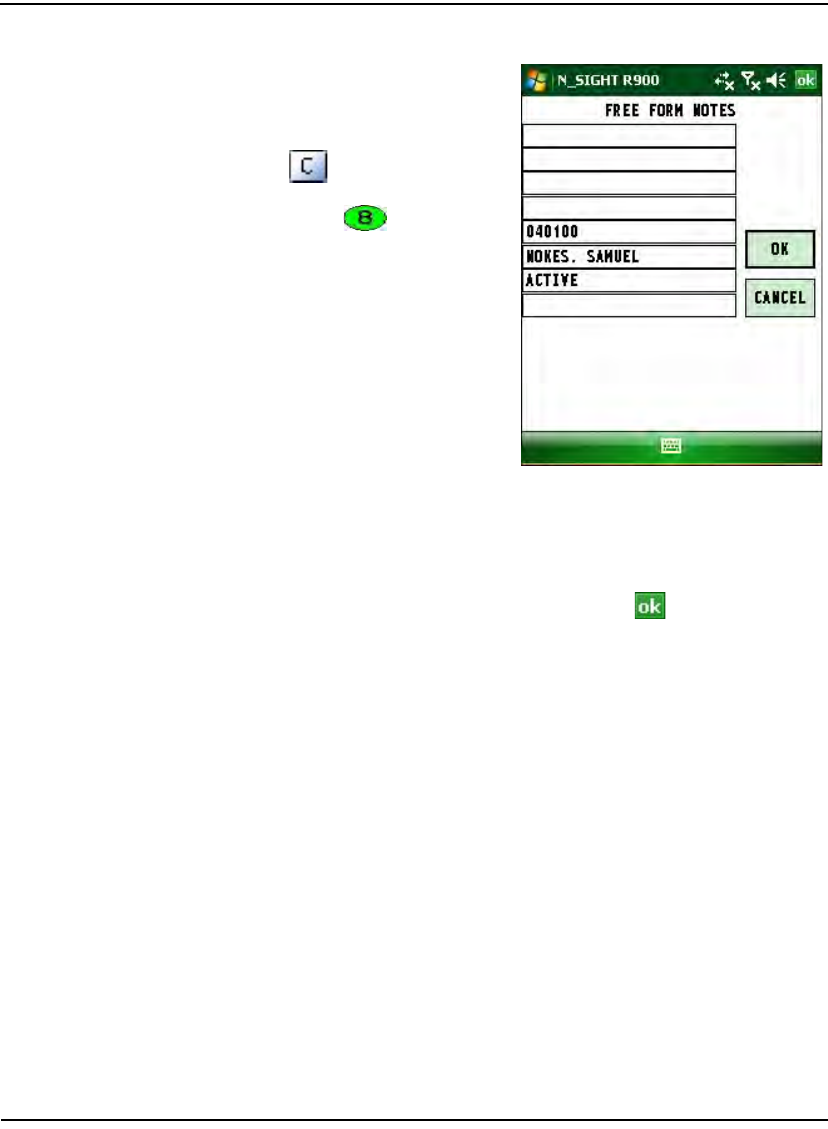
Gathering Route Data
6-10 N_SIGHT R900 User’s Manual for the Neptune Handheld System
1From the reading entry
screen of the meter for
which you want to enter
free-form notes, press
.
2 Touch .
A screen appears
prompting you to enter a
free-form notes. See
Figure 6.10.
Figure 6.10 N_SIGHT R900 Free Form Notes Screen
3 Begin typing your note in the first blank line.
4 At the end of the line, tab to the second line to continue.
5 When you’ve completed your notes, touch .
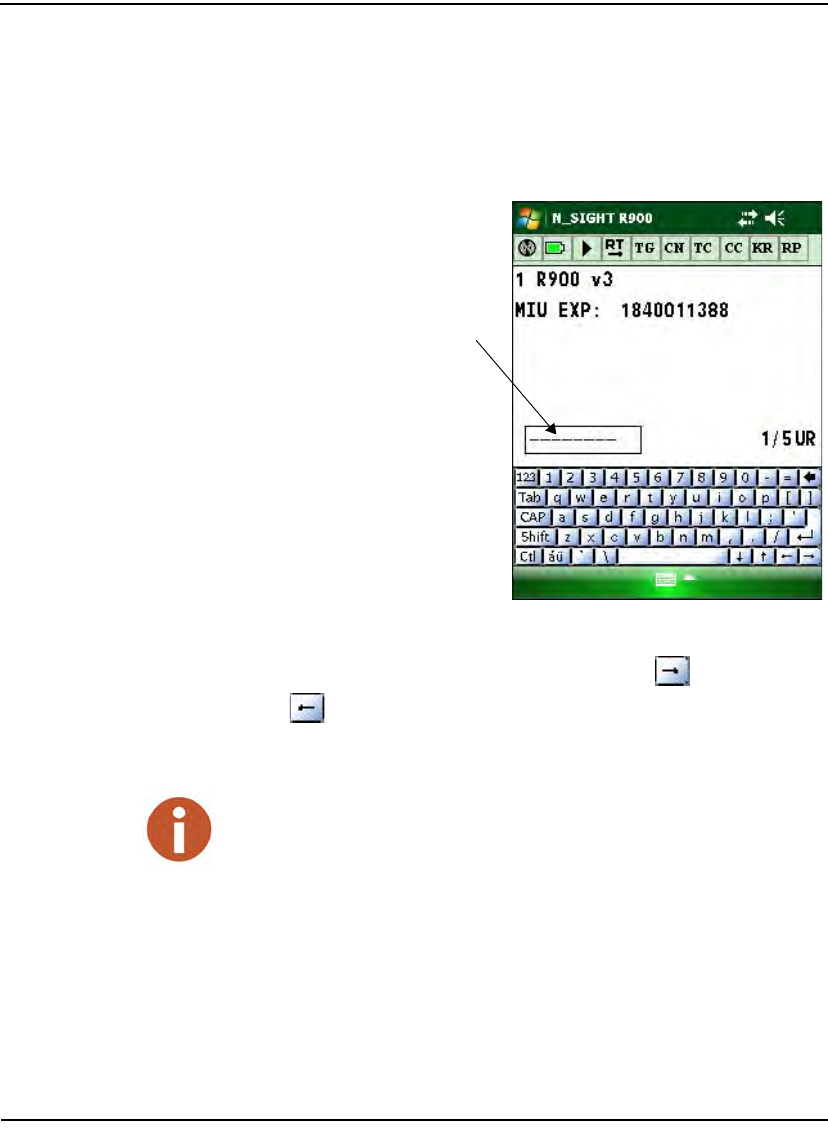
Gathering Route Data
N_SIGHT R900 User’s Manual for the Neptune Handheld System 6-11
Leaving a Reading Blank
In some cases, you need to leave a reading blank. For example, if a
meter’s reading is to be estimated by your company’s billing computer.
Follow this procedure to skip over a meter without entering a reading or
a skip code.
1Access the read-
ing entry screen of
the meter you
want to skip.
Figure 6.11 Leaving a Meter Reading Blank
2 Using the direction keys, press the FORWARD or BACKWARD
key to display the next meter in the route without entering a
reading.
The next meter in the route appears in the display.
Blank
read
Your ability to use this feature can be restricted by your company. In such
cases, the handheld will inform you that you must enter either a reading or a
skip code.
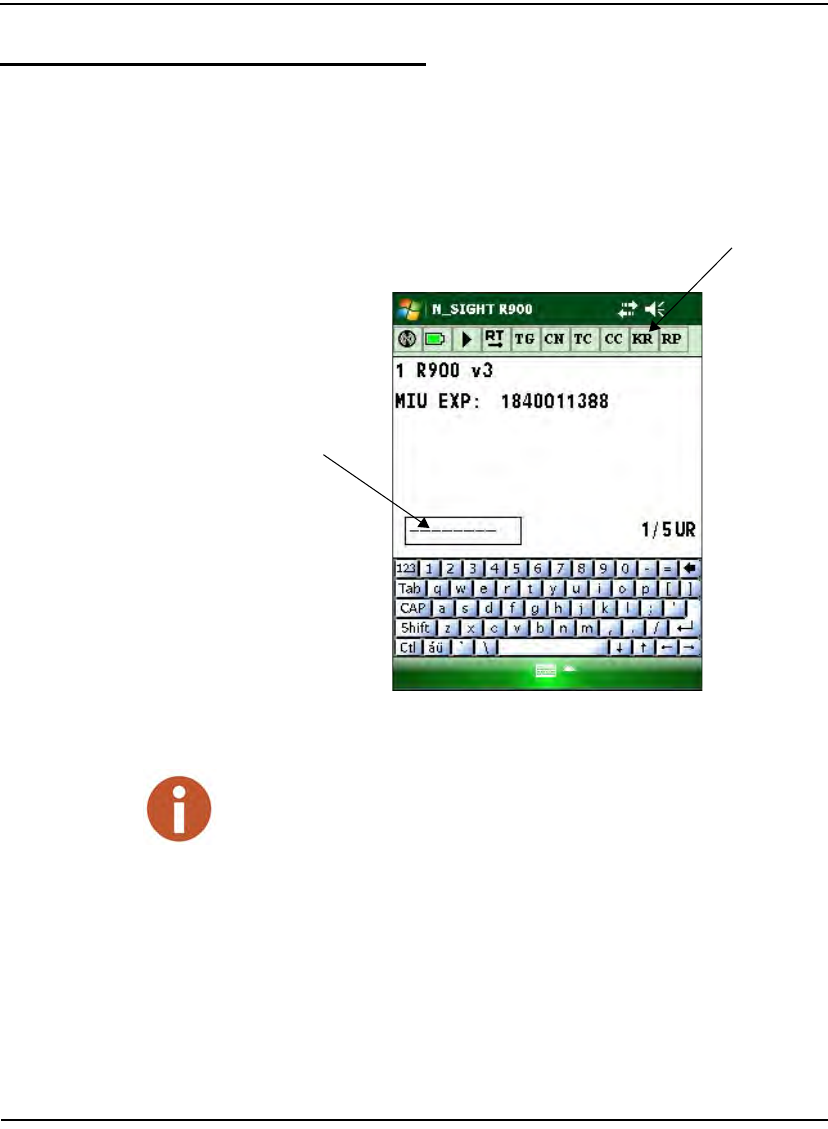
Gathering Route Data
6-12 N_SIGHT R900 User’s Manual for the Neptune Handheld System
Collecting RR Readings
When you receive your Neptune handheld, it is factory-set to collect
readings manually using the keyboard. When you begin readings
manually, the handheld screen appears similar to the one illustrated in
Figure 6.12.
Figure 6.12 N_SIGHT R900 Manual Reading Screen
Manual keyed read
Manual
entry
While on a keyed account or an R900 account the handheld reads R900s
within range, holds these reads in a buffer, and distributes them to the correct
accounts in the route once an R900 account appears on the display.
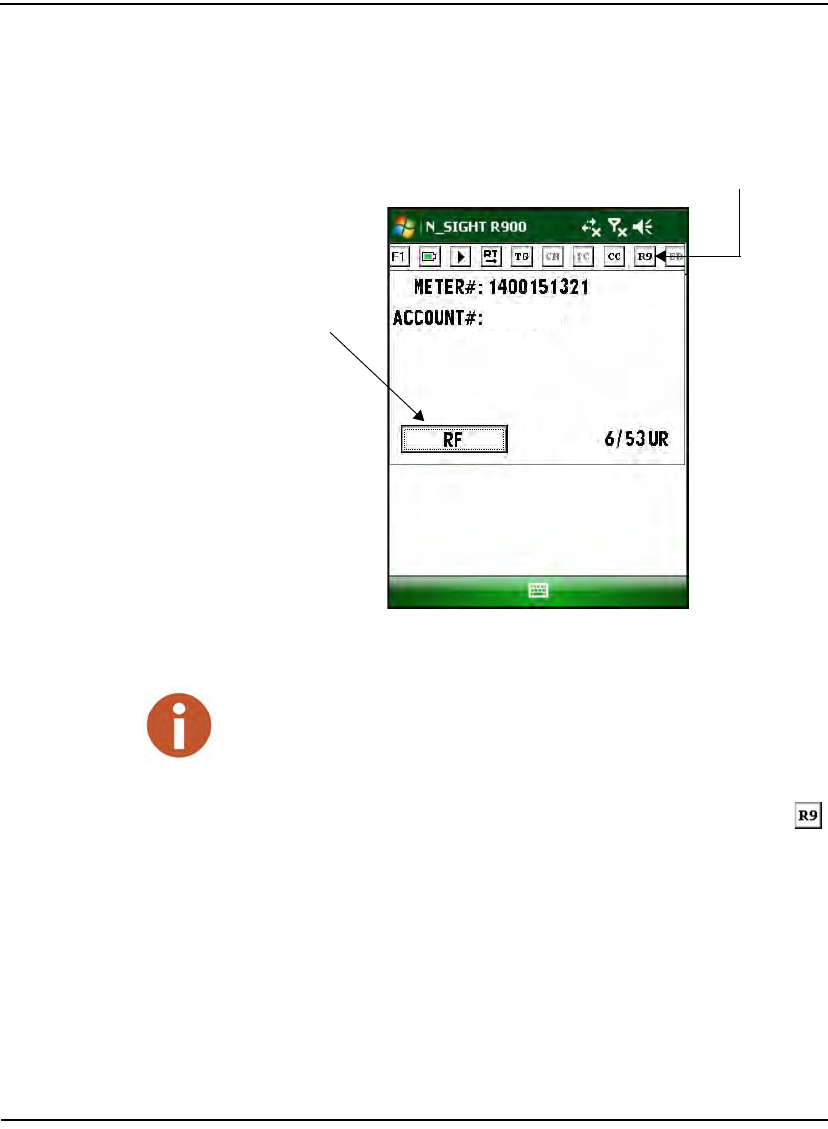
Gathering Route Data
N_SIGHT R900 User’s Manual for the Neptune Handheld System 6-13
Collecting an RF Reading
When you approach an RF account while collecting meter readings on a
route, the screen similar to the one illustrated in Figure 6.13 appears.
Figure 6.13 N_SIGHT R900 RF Reading Screen
If the account you are reading is an R900 account, the reading icon
at the top right of the screen displays as R9. If the account is an R300
account, the reading icon displays as R3. See Figure 6.13.
At an RF account, the unit is ready to receive a reading transmitted from
an RF transmitter, like an R900. If the account is set up properly and the
RF transmitter is transmitting properly, you should receive a reading for
the account once you are in range of the transmitter.
357 FOREST COURT
RF entry
RF read; If current account is
R300, R3 displays.
While on a Keyed account or an R900 account, the handheld collects R900
meter readings in the background.
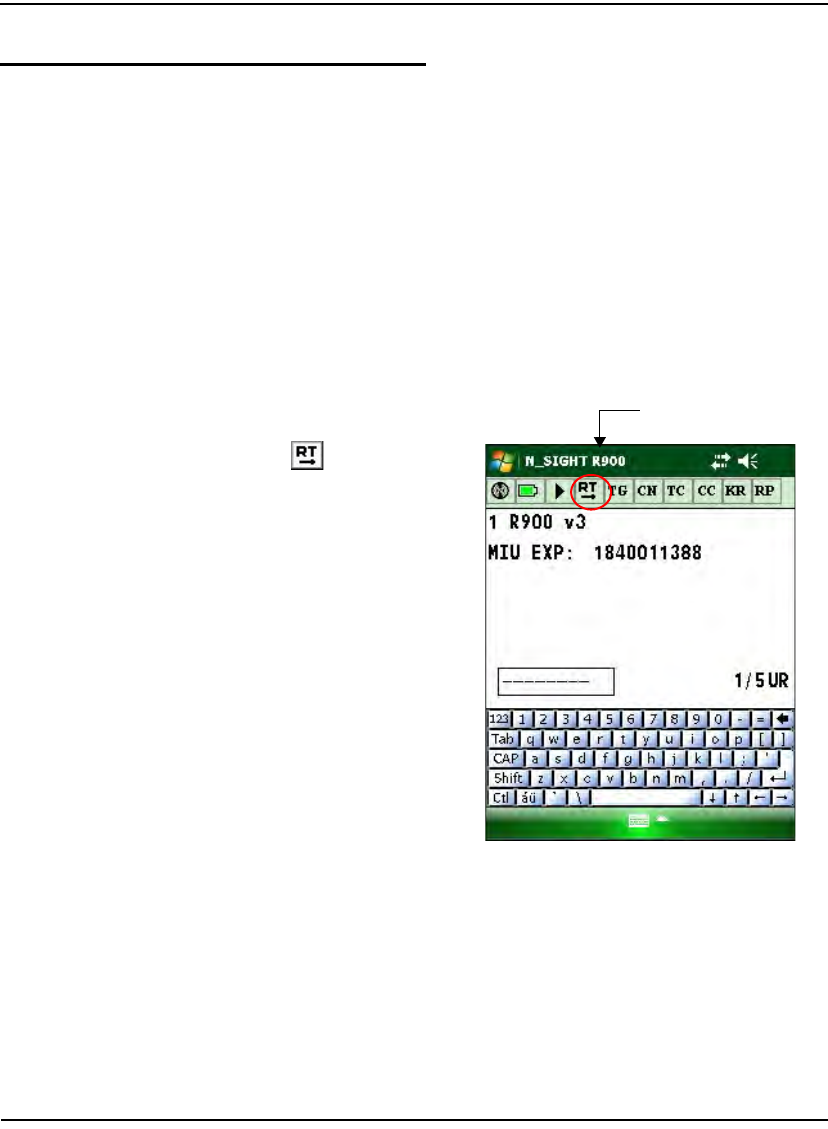
Gathering Route Data
6-14 N_SIGHT R900 User’s Manual for the Neptune Handheld System
Working with Accounts
While you are reading meters and when you are working with accounts,
there are certain tasks that you need to perform to help you with your
data collection.
Changing the Route Direction, Forward or Reverse
This icon is used for changing the Route Direction from a Forward
direction (advancing from account 1 to account 2) to reverse direction
(advancing from account 2 to account 1) as readings are being recording
in the handheld.
On the Reading
Entry screen, click
.
Figure 6.14 Left to Right Route Direction Icon
Right route direction icon
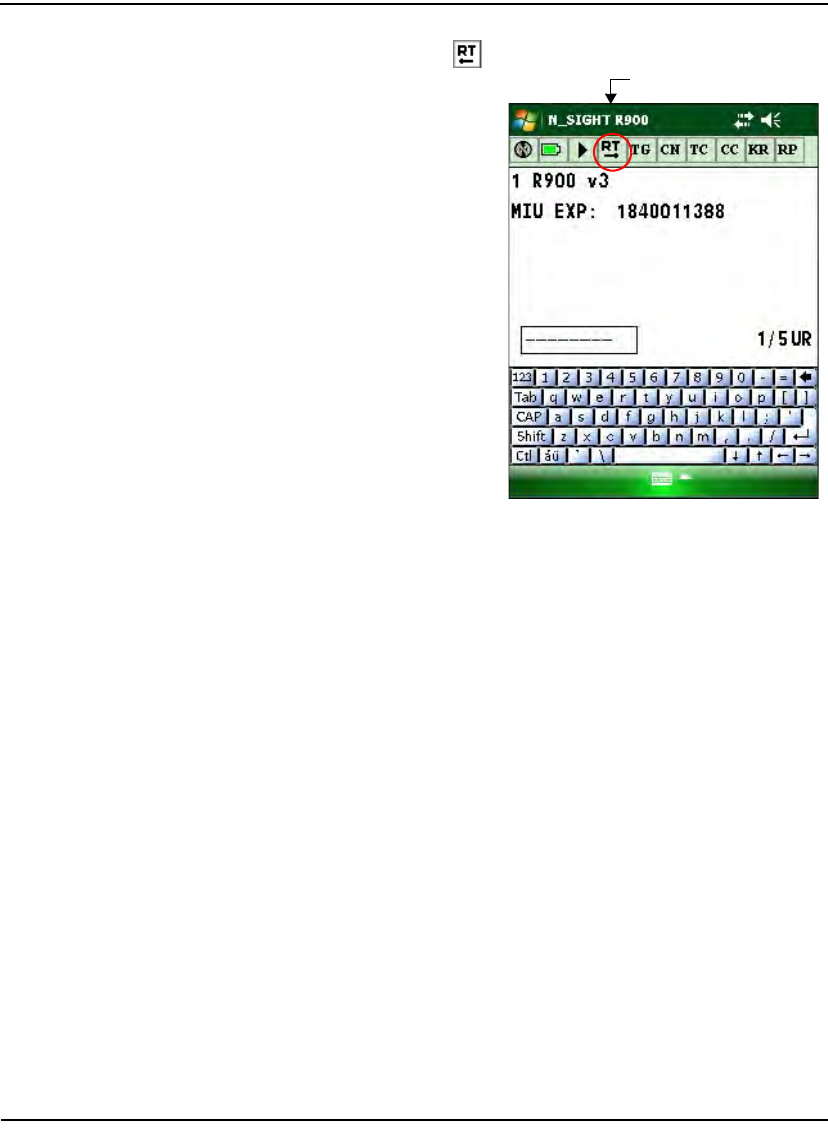
Gathering Route Data
N_SIGHT R900 User’s Manual for the Neptune Handheld System 6-15
The icon changes to ,
as illustrated in Figure
6.15. This works as a
toggle between the two
read directions, forward
and reverse.
Figure 6.15 Right to Left Route Direction Icon
Tagging an Account
While you are reading meters, there may be a need to tag an account and
come back to it later. Follow this procedure to tag or untag accounts
within the route for which you want to complete the readings later on.
Left route direction icon
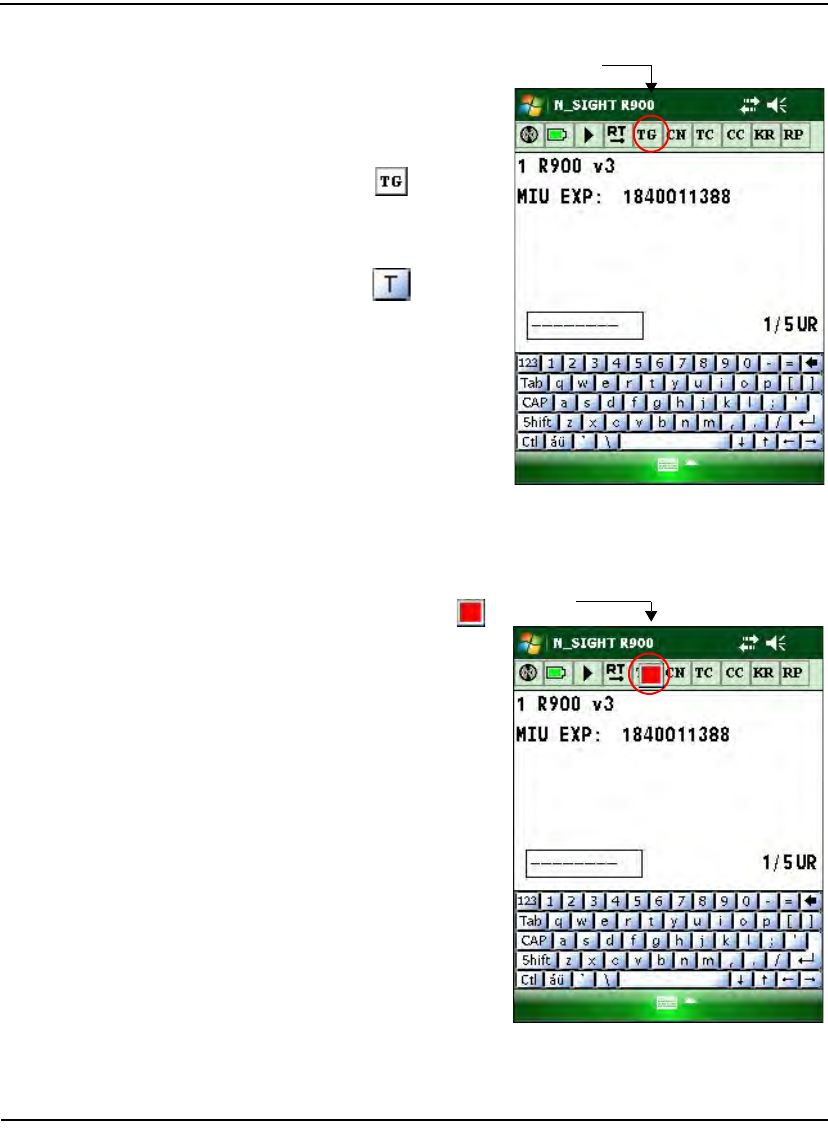
Gathering Route Data
6-16 N_SIGHT R900 User’s Manual for the Neptune Handheld System
1On the Reading
Entry screen, do
one of the follow-
ing:
•Click .
or
• Press .
Figure 6.16 Tag Account Icon
The icon changes to ,
as illustrated in Figure
6.17. This works as a
toggle between tagged
and untagged accounts.
Figure 6.17 Tagged Account
Tag account icon
Tag icon
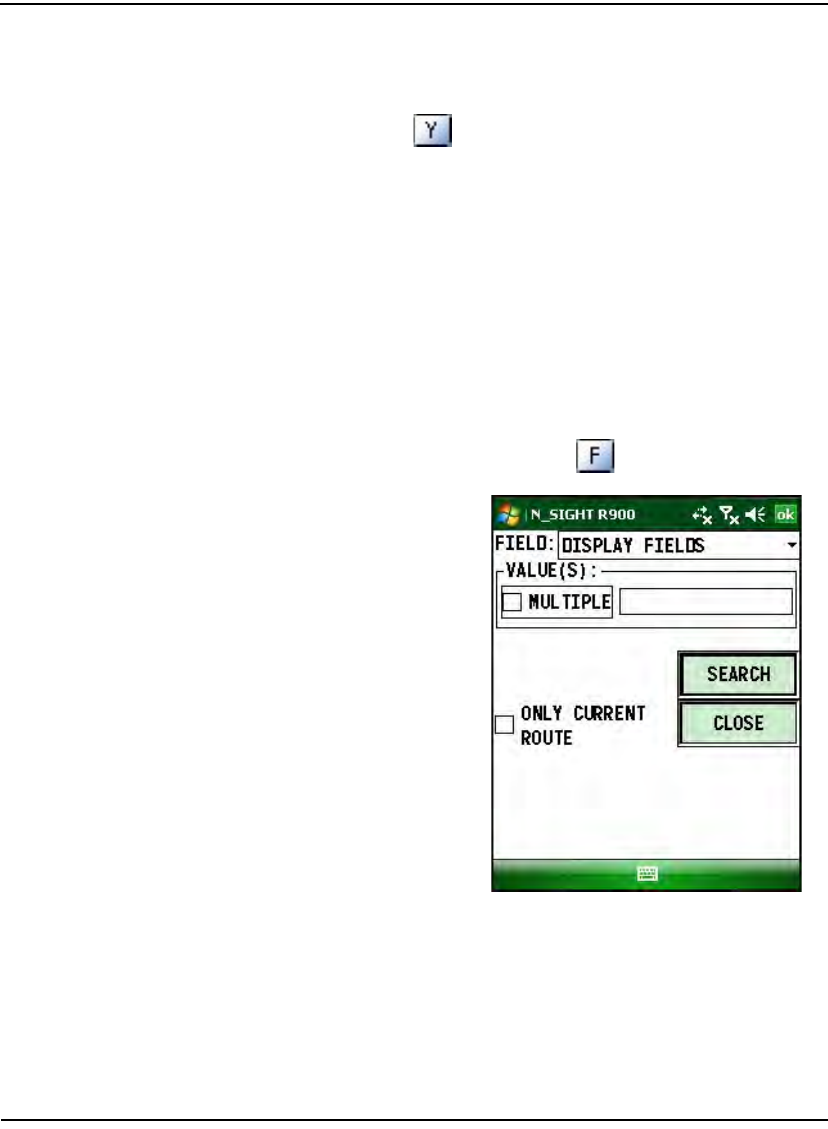
Gathering Route Data
N_SIGHT R900 User’s Manual for the Neptune Handheld System 6-17
2 Continue entering readings within this route.
3 To search the tagged accounts so that you can complete the readings
for them, press .
Finding Information
When you are reading meters and need to find an account, an address, a
meter number, or some other information, you can easily do so by using
the N_SIGHT R900 Find function. If you already know specific
information about a meter, such as its meter number, you can quickly
display that meter by using the search function. When you use the
search feature, the handheld searches for the specific information that
you enter. When the software finds a meter whose data matches the
information you entered, that meter appears in the display. Follow this
procedure to find the information you need.
1 On the Reading Entry screen, press .
The Find Order
screen appears as
illustrated in Figure
6.18.
Figure 6.18 N_SIGHT R900 Find Order Screen
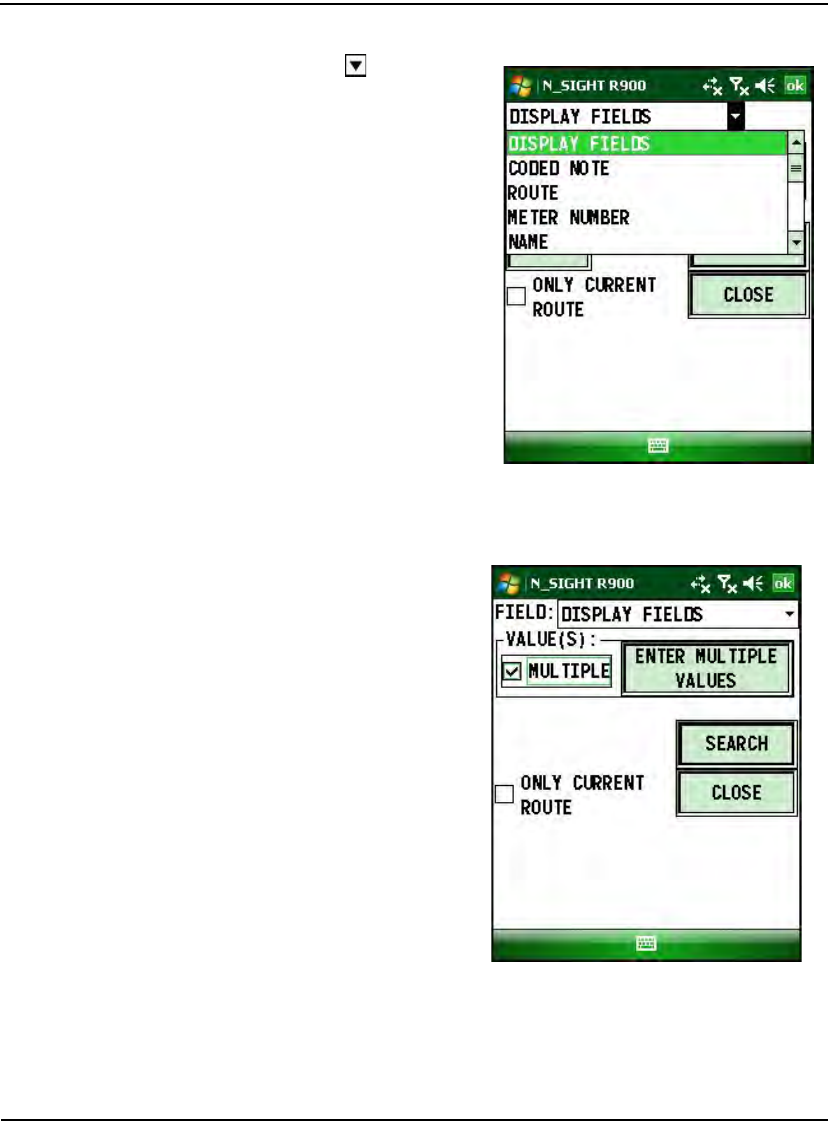
Gathering Route Data
6-18 N_SIGHT R900 User’s Manual for the Neptune Handheld System
2 Touch .
The list of fields
displays for you to
select the type of
information you
want to find. See
Figure 6.19.
Figure 6.19 Search Display Fields
3Select Multiple to
enter more than one
value for the search.
See Figure 6.20.
Figure 6.20 Search Screen Enter Multiple Values
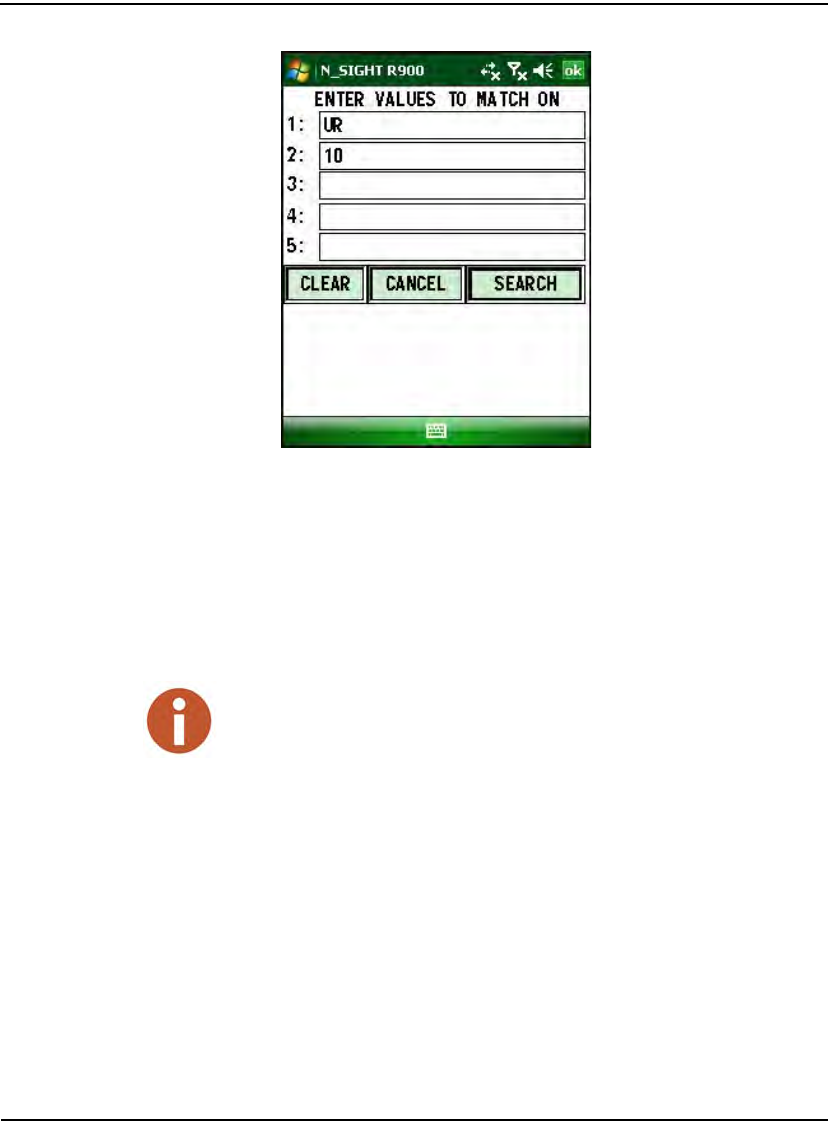
Gathering Route Data
N_SIGHT R900 User’s Manual for the Neptune Handheld System 6-19
Figure 6.21 Search Screen Multiple Values to Match
4 Touch the field for the information you want to find.
Your selection appears in the field.
5 Type a value for the information you want to find in the Value field,
if applicable.
6 If you selected more than one route when you logged into
N_SIGHT R900, do one of the following:
• Touch Only Current Route if you only want to search within
the current route to find the information.
• Leave the Only Current Route checkbox empty if you want
to search within all the routes you selected when you logged
into N_SIGHT R900.
You can find information within only the current route, or within any of the
routes you selected when you logged into N_SIGHT R900. The field named
Display Fields are typically where your address information is located. Use
Display Fields as your address search field.
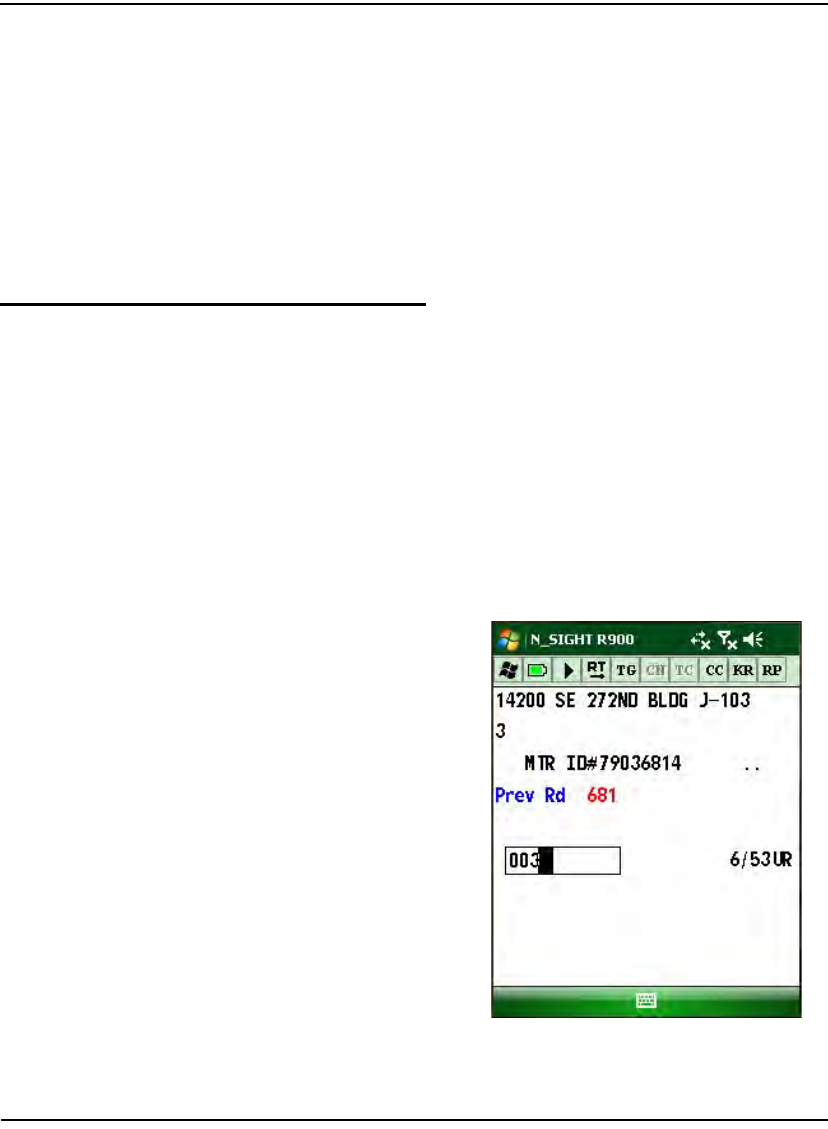
Gathering Route Data
6-20 N_SIGHT R900 User’s Manual for the Neptune Handheld System
7 Touch one of the following to begin your search.
•Search> if you want to search forward in the route
•<Search is you want to search backward in the route
If only one exact match to your entered search criteria is found, it is
displayed. If multiple accounts match your entered criteria, they
will appear in a list form. You should browse the list and select the
desired account.
Validating Readings
If the audit feature has been set on the host computer, the handheld
validates each reading you enter against the high/low range selected for
the audit feature.
Hi/Low Fails
If the reading falls within the high/low range, the handheld accepts the
reading and advances to the next meter in the route. If the reading is
outside the high/low range, the handheld does not accept the reading
and the Hi /Lo/No/Inact Check screen appears. Use this procedure to
complete a reading that falls outside the high/low range.
1On the reading entry
screen, enter the
reading that falls
outside the high/low
range. See Figure
6.22.
Figure 6.22 Reading Outside High/Low Range
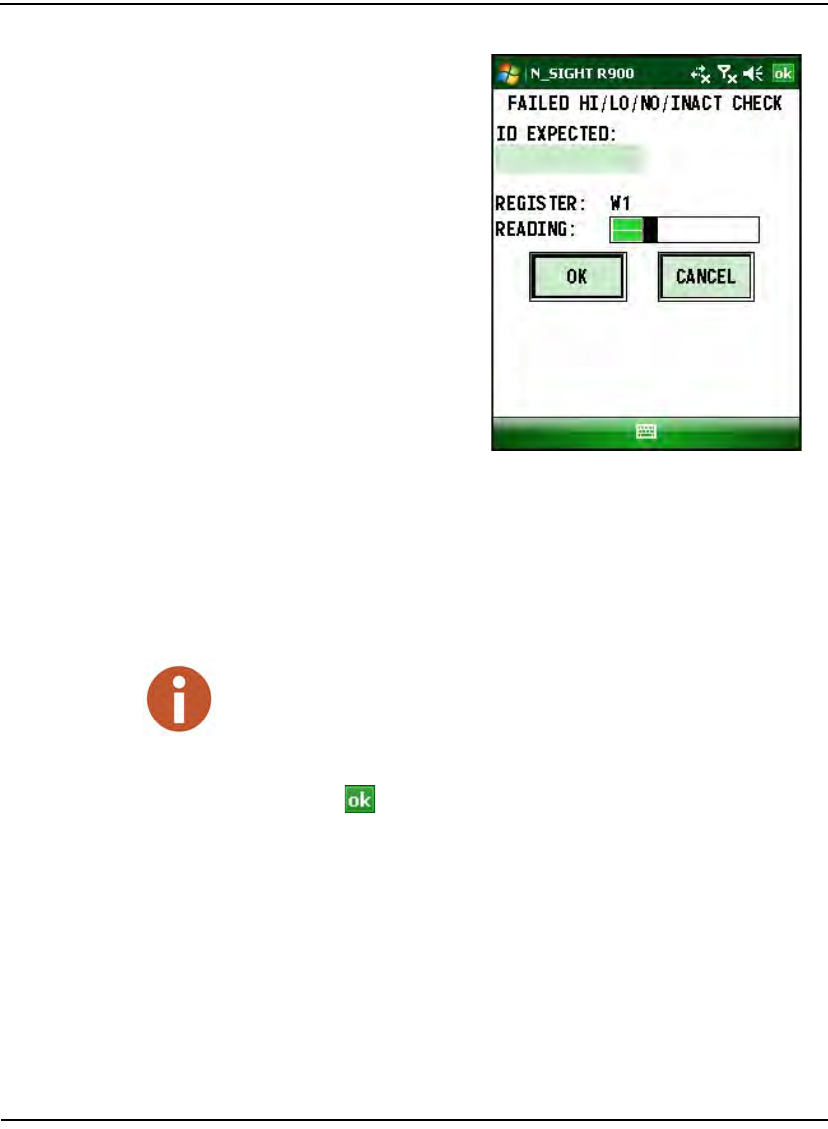
Gathering Route Data
N_SIGHT R900 User’s Manual for the Neptune Handheld System 6-21
The handheld
sounds and the
Hi/Lo/No/Inact
Check screen
appears as
illustrated in Figure
6.23.
Figure 6.23 N_SIGHT R900 Hi / Lo / No / Inact Screen
N_SIGHT R900 wants you to be sure that you entered the number
correctly.
2 If you are sure this is the correct reading, then enter the numbers
again on the Hi/Lo/No/Inact Check screen.
3 Touch .
The reading is accepted as the next account appears.
You must enter the same digits in the reading to pass the high/low audit
during the second attempt. If a different reading is entered during the second
attempt, the system will fail the audit. This failure mode will continue until you
enter the same reading digits twice.
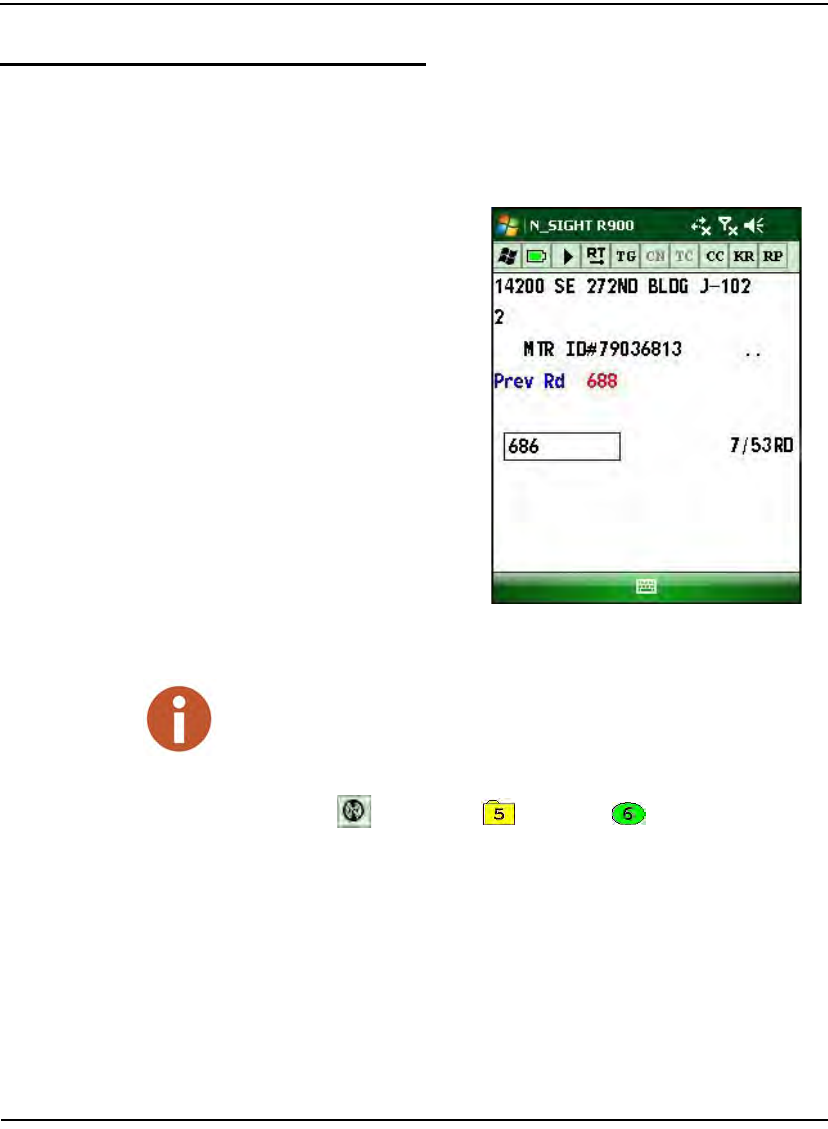
Gathering Route Data
6-22 N_SIGHT R900 User’s Manual for the Neptune Handheld System
Removing a Reading
In some cases, you may need to clear or delete a reading. For example,
if you make a mistake entering a reading and need to enter it again.
Follow this procedure to clear an existing reading from the handheld.
1Display the reading
entry screen of the
meter whose read-
ing you want to
clear. See Figure
6.24.
Figure 6.24 Reading to be Cleared
2 Press . Then touch , and touch .
You can only clear or reset readings for the same day. If you completed
readings for a previous day, you cannot reset the readings.
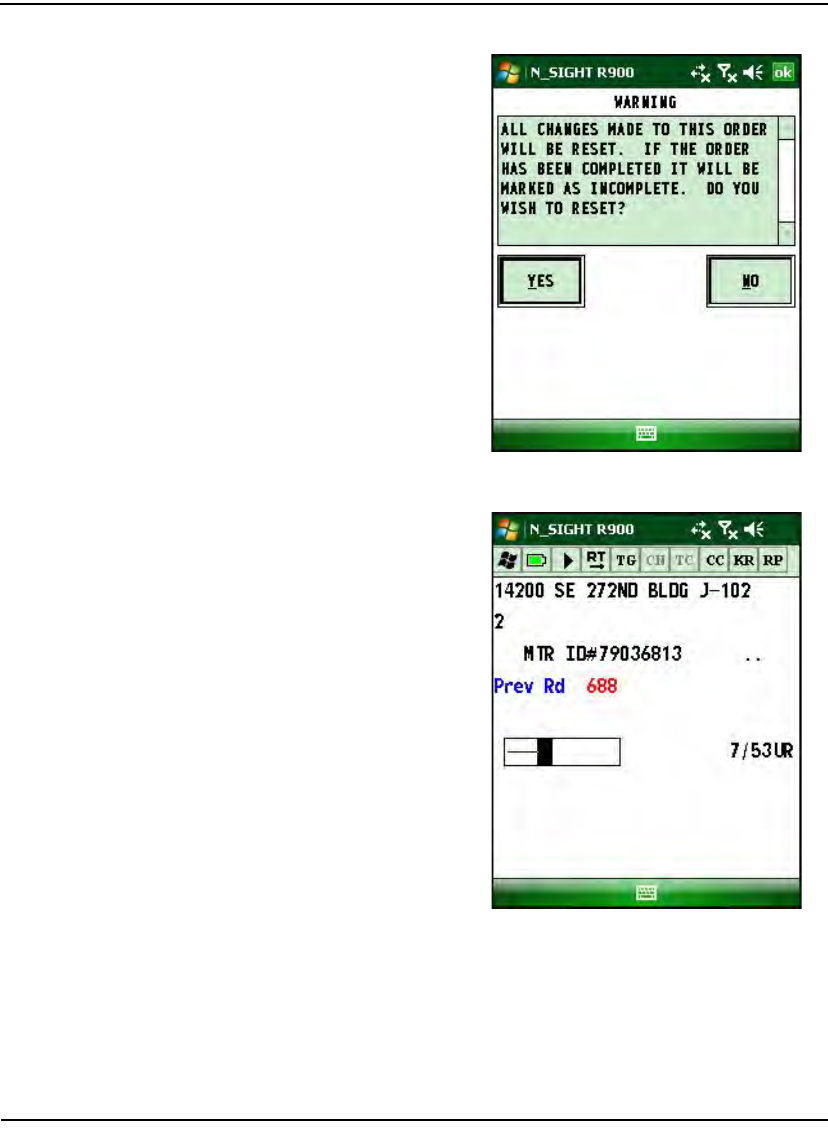
Gathering Route Data
N_SIGHT R900 User’s Manual for the Neptune Handheld System 6-23
The Reset Order
screen appears as
illustrated in Figure
6.25.
Figure 6.25 N_SIGHT R900 Reset Order Screen
3Press Y or touch Yes
to reset the reading.
Figure 6.26 Reset Reading
The reading is then reset back to UR (unread).
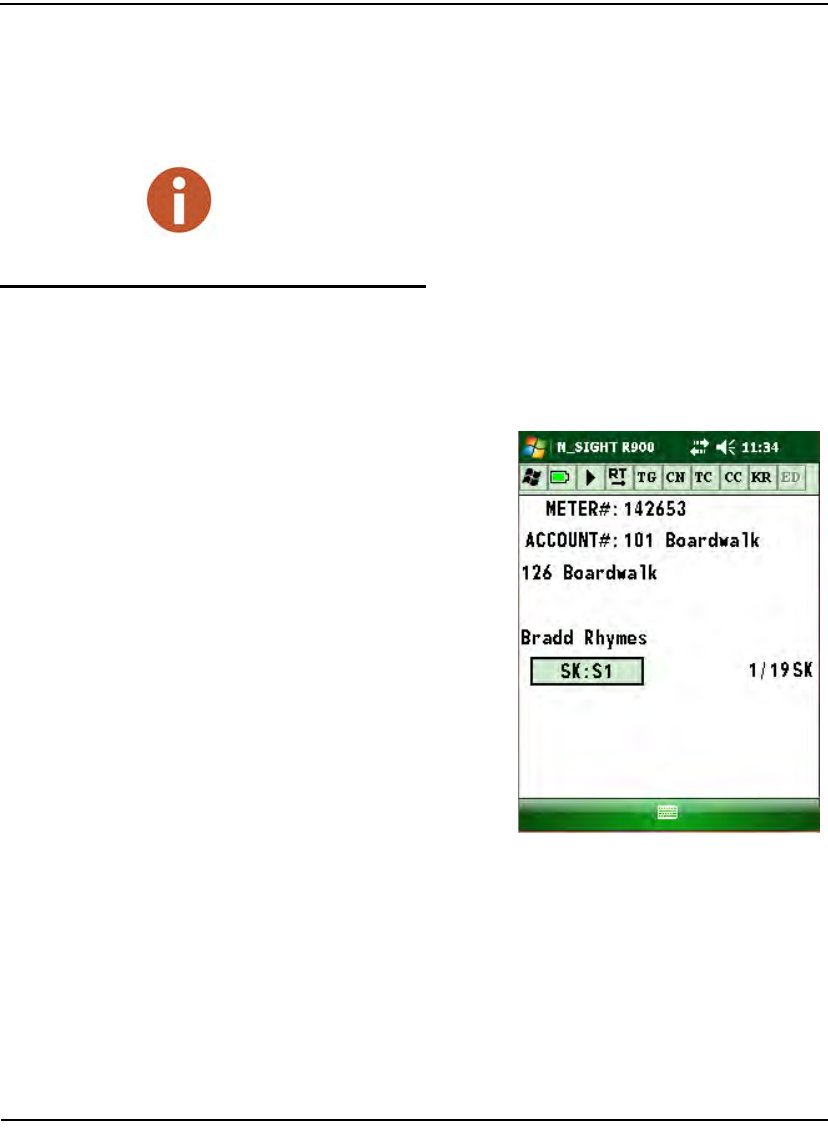
Gathering Route Data
6-24 N_SIGHT R900 User’s Manual for the Neptune Handheld System
You can now enter a new reading or skip code, or leave the reading
blank and display the reading entry screen of the next meter on the
route.
Clearing a Skip Code
In some cases, you may need to clear a skip code. For example, if you
can now revisit the account you skipped and enter the reading. Follow
this procedure to unskip a skip code from the handheld.
1Display the reading entry
screen of the meter whose
reading you skipped. See
Figure 6.27.
Figure 6.27 Reading to be Unskipped
2 Touch Unskip.
If you reset a created found meter account, the found meter account is
cleared in its entirety.
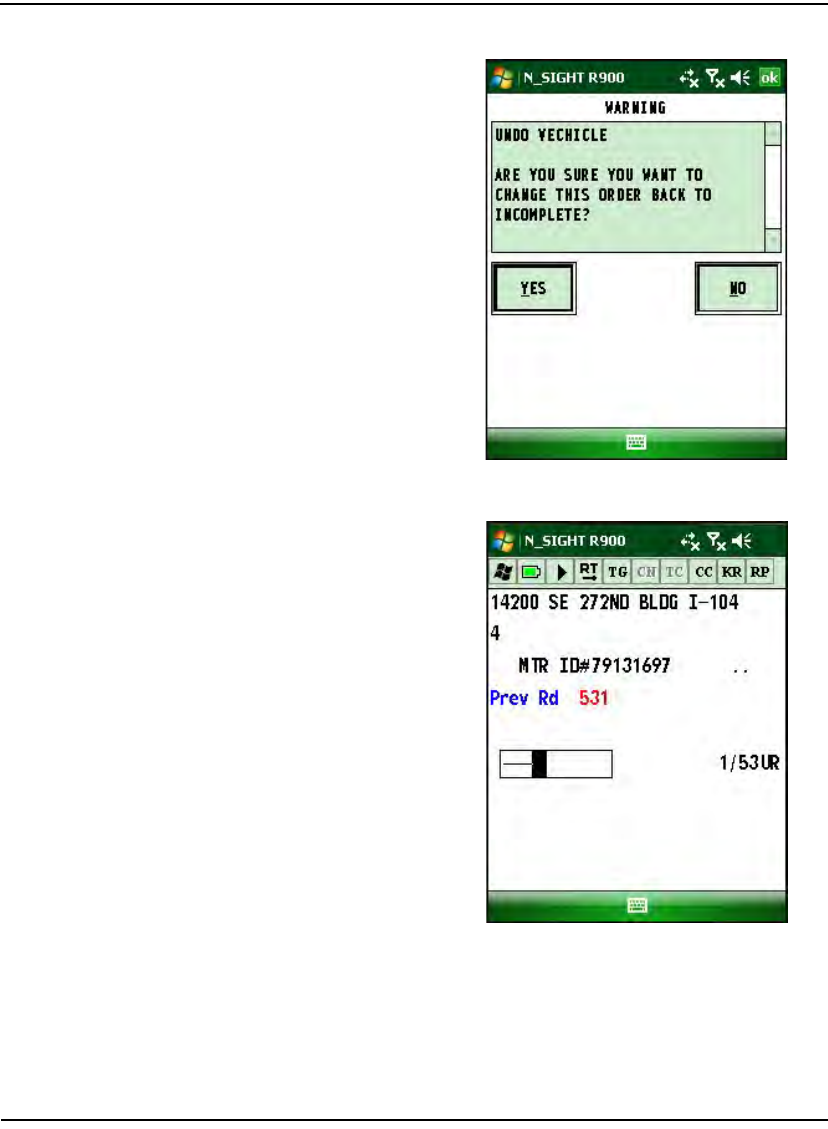
Gathering Route Data
N_SIGHT R900 User’s Manual for the Neptune Handheld System 6-25
The Undo Skipped
Order screen appears
as illustrated in Figure
6.28.
Figure 6.28 N_SIGHT R900 Undo Skipped Order Screen
3Press Y or touch Yes
to unskip the reading.
The reading is then
reset back to UR
(unread) as illustrated
in Figure 6.29.
Figure 6.29 Reading Field after Unskipped
You can now continue with a new reading, or leave the reading
blank and display the reading entry screen of the next meter on the
route.
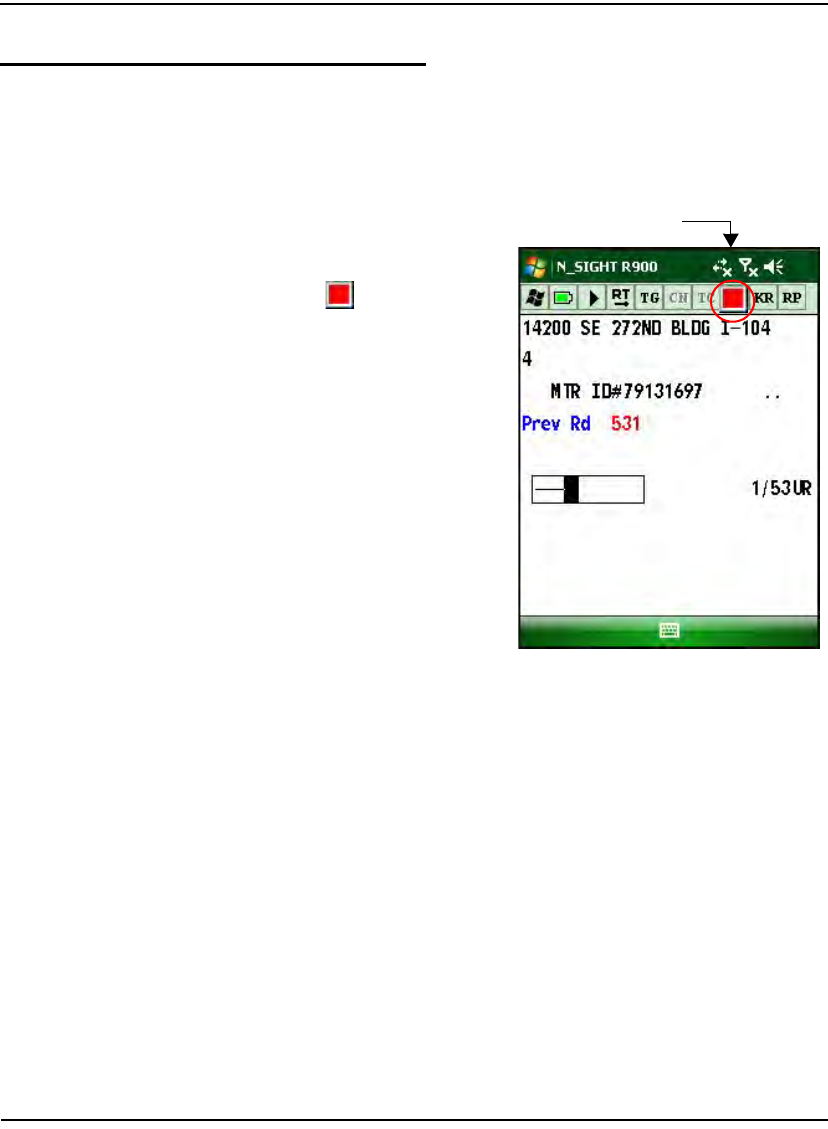
Gathering Route Data
6-26 N_SIGHT R900 User’s Manual for the Neptune Handheld System
Clearing a Comment Code, Customer Note, or Trouble Code
In some cases, you may need to clear a code that you’ve entered for a
comment code, customer note, or a trouble code. Follow this procedure
to clear the code you entered on the handheld.
1Identify the account that
has the code or note you
want to clear.
The icon, as
illustrated in Figure 6.30,
shows that there is a code
or note attached to this
account.
Figure 6.30 Screen Showing Code Attached
Marked comment code
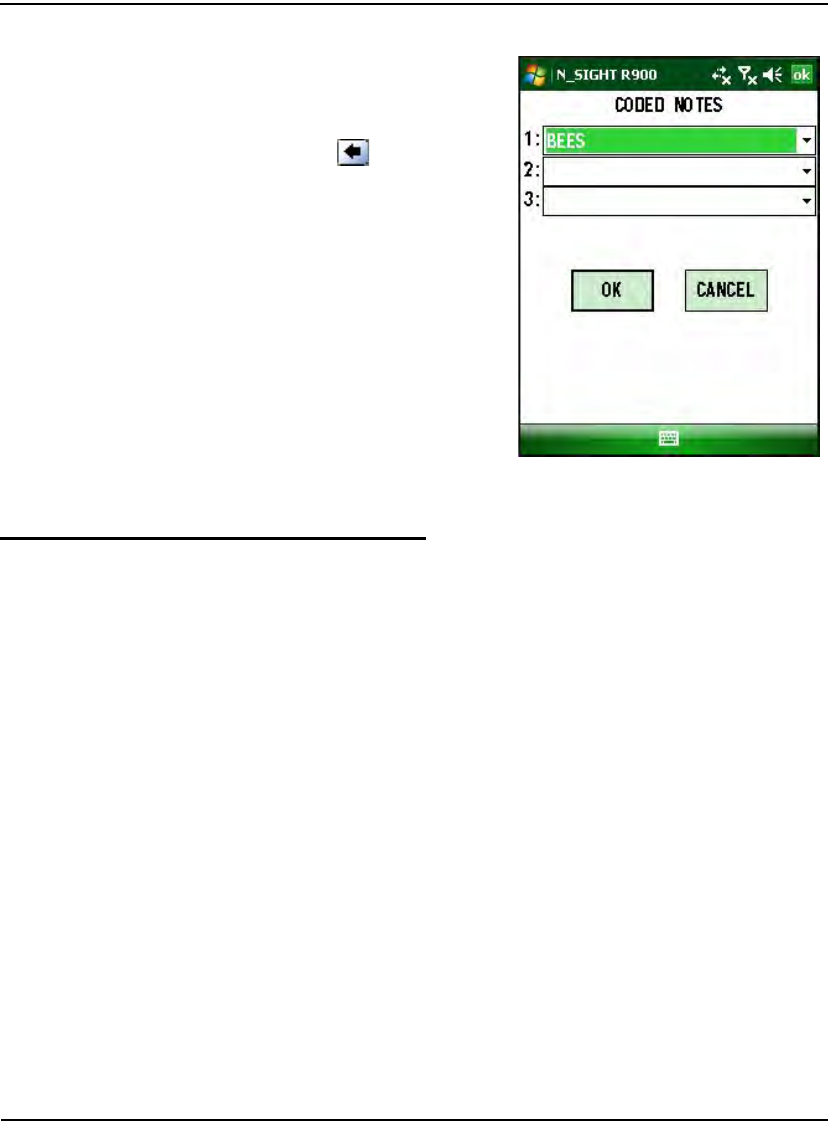
Gathering Route Data
N_SIGHT R900 User’s Manual for the Neptune Handheld System 6-27
2Go to the screen where
you entered the code or
note. See Figure 6.31.
3 Press .
The code or note is then
cleared from this account.
Figure 6.31 Screen Where Code Was Entered
Adding a New Meter to a Route
If you find a meter on your route that has not yet been loaded on the
handheld, you can add the new meter and information about it to the
current route. Follow this procedure to add a new meter to an existing
route.
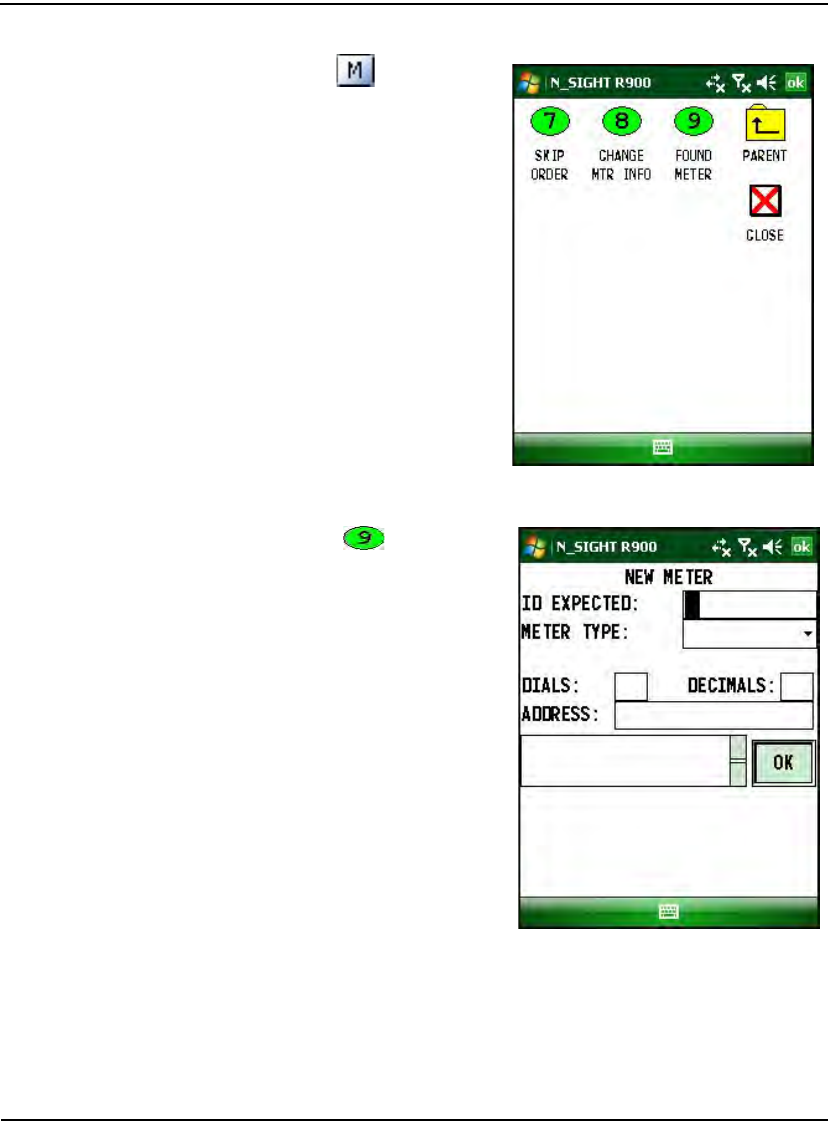
Gathering Route Data
6-28 N_SIGHT R900 User’s Manual for the Neptune Handheld System
1Press .
The Meter Process
Menu appears as
illustrated in Figure 6.32.
Figure 6.32 N_SIGHT R900 Meter Process Menu
2Touch .
The New Meter screen
appears as illustrated in
Figure 6.33.
Figure 6.33 N_SIGHT R900 New Meter Screen
3 Using the letter and number keys, type the meter number for the
new meter in the ID EXP field.
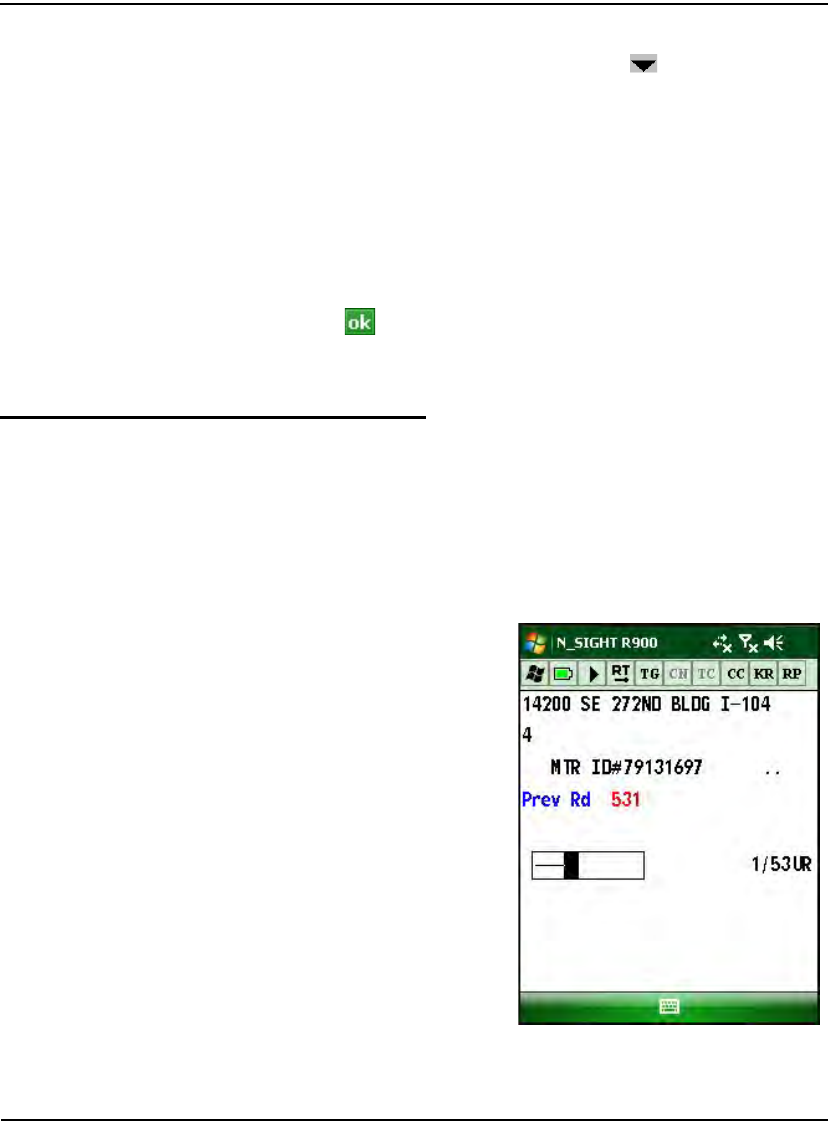
Gathering Route Data
N_SIGHT R900 User’s Manual for the Neptune Handheld System 6-29
4In the MTR TYPE field, touch the DOWN arrow and select the
type of meter just found.
5 Touch the DIALS field, and enter the number of dials that the new
meter uses.
6 Touch the DECIMALS field, and enter the number of decimals
that the meter uses.
7 Touch the ADDRESS field, and type the address for the account.
8 Touch the notes field and type any notes, if applicable.
9 Touch to add the found meter.
The found meter is now added to the route.
Correcting or Changing Meter Information
Depending upon the options selected by the host operator, you can
correct or change some information that was loaded from the host
computer. Follow this procedure to access the Change Meter Info
screen so that you can change information about a meter.
Follow this procedure to correct meter information.
1Make sure that the meter
whose data you want to
change is shown in the dis-
play.
Figure 6.34 Meter Information to Change
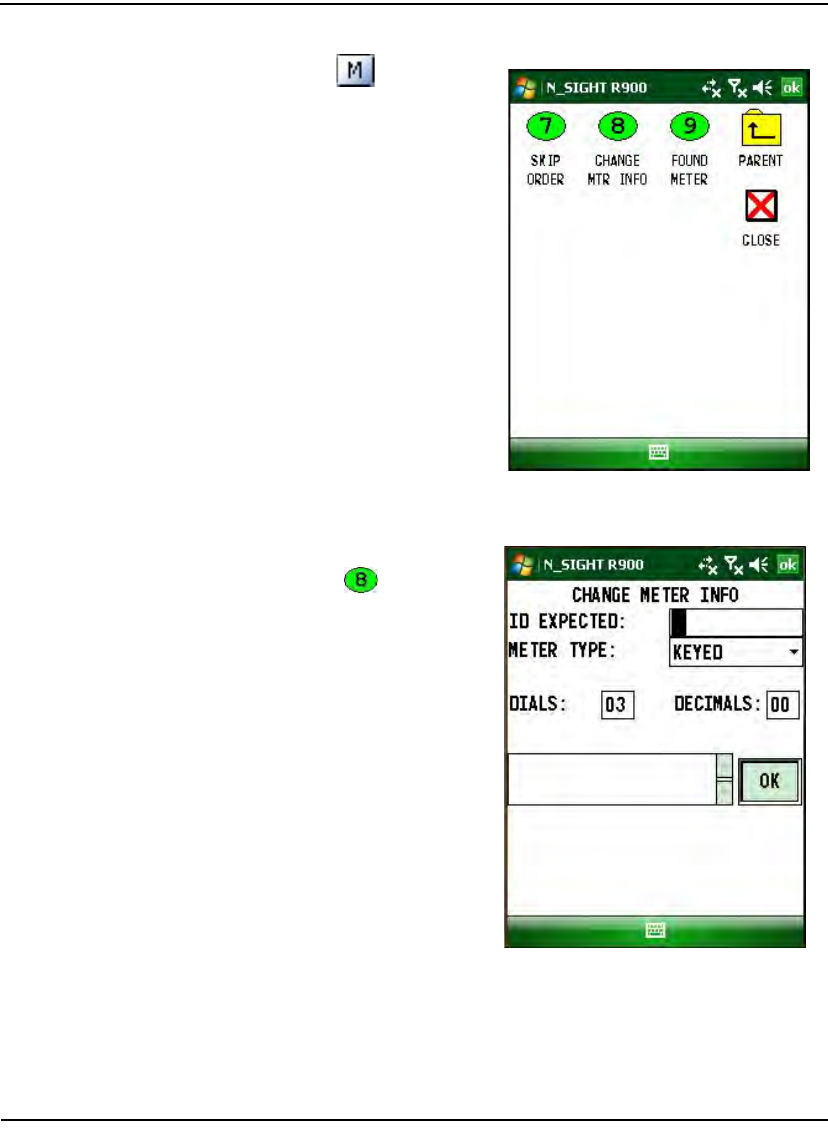
Gathering Route Data
6-30 N_SIGHT R900 User’s Manual for the Neptune Handheld System
2Press .
The Meter Process
Menu appears as
illustrated in Figure 6.35.
Figure 6.35 N_SIGHT R900 Meter Process Menu
3 Touch .
The Change Meter Info
screen appears as
illustrated in Figure 6.36.
Figure 6.36 N_SIGHT R900 Change Meter Info Screen

Gathering Route Data
N_SIGHT R900 User’s Manual for the Neptune Handheld System 6-31
4 Correct any of the following information.
• Using the letter and number keys, correct the meter number in
the ID EXP field, if applicable.
•In the MTR TYPE field, touch the arrow, and select the
type of meter just found, if applicable.
• Touch the DIALS field, and enter the number of dials that the
new meter uses, if applicable.
• Touch the DECIMALS field, and enter the number of deci-
mals that the meter uses, if applicable.
• Touch the notes field and type any notes, if applicable.
5 Touch to accept the changes you made to the meter.
The changes made to the meter is reflected in the current route with
which you are working.
Finding and Displaying Reading-Entry Screens
The procedures in this section explain how to move within a single
route, change routes, search for specific meters, and use the bookmark
feature. The following tasks are explained in this section.
•“Moving Through Reading Entry Screens,” on page 6-32
•“Moving Around Routes,” on page 6-35
You will need to print these changes in a standard report. Usually, when the
information is transferred from N_SIGHT R900 to the billing system, this
information is not updated by the billing system.
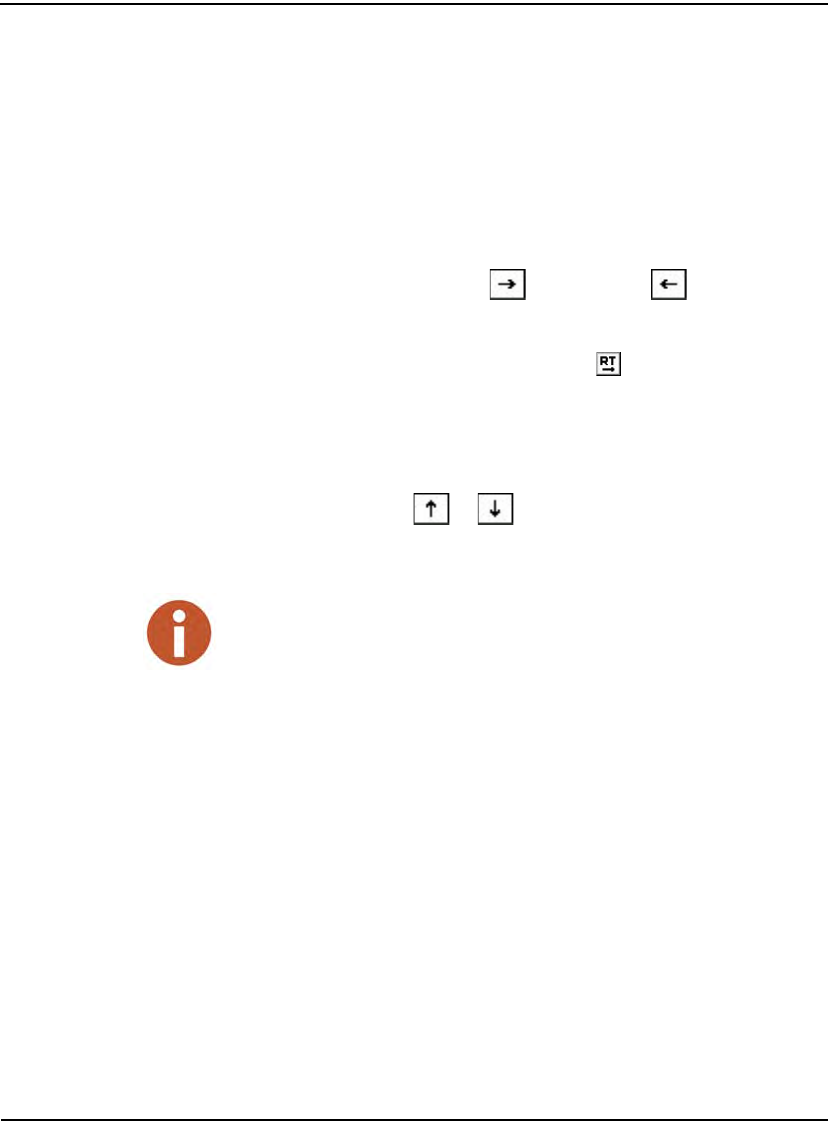
Gathering Route Data
6-32 N_SIGHT R900 User’s Manual for the Neptune Handheld System
Moving Through Reading Entry Screens
The handheld moves from one reading-entry screen to the next in one of
two ways:
• When reading meters, the N_SIGHT R900 software automatically
advances to next meter in the route after you enter a reading or a
skip code for the current meter on the route. See “Entering a
Reading,” on page 6-3.
• you can move FORWARD or BACKWARD when you are on
the reading entry screen to display the next meter or previous meter
in the route without entering a reading. The key that you press
depends upon the route direction icon that you establish. Refer
to “Entering a Reading,” on page 6-3.
Reviewing Additional Information for an Account
Each reading entry screen has two additional screens you can view by
simply pressing the or arrow keys. These screens contain
location and hazard codes, and the statistics for the loaded routes.
Location or Hazard Codes
To view location or hazard codes, follow this procedure.
Continually pressing the up or down arrow keys while on an account cycles
between the three available screens, the Main Reading screen, the Hazard
screen and the Route Statistics screen.
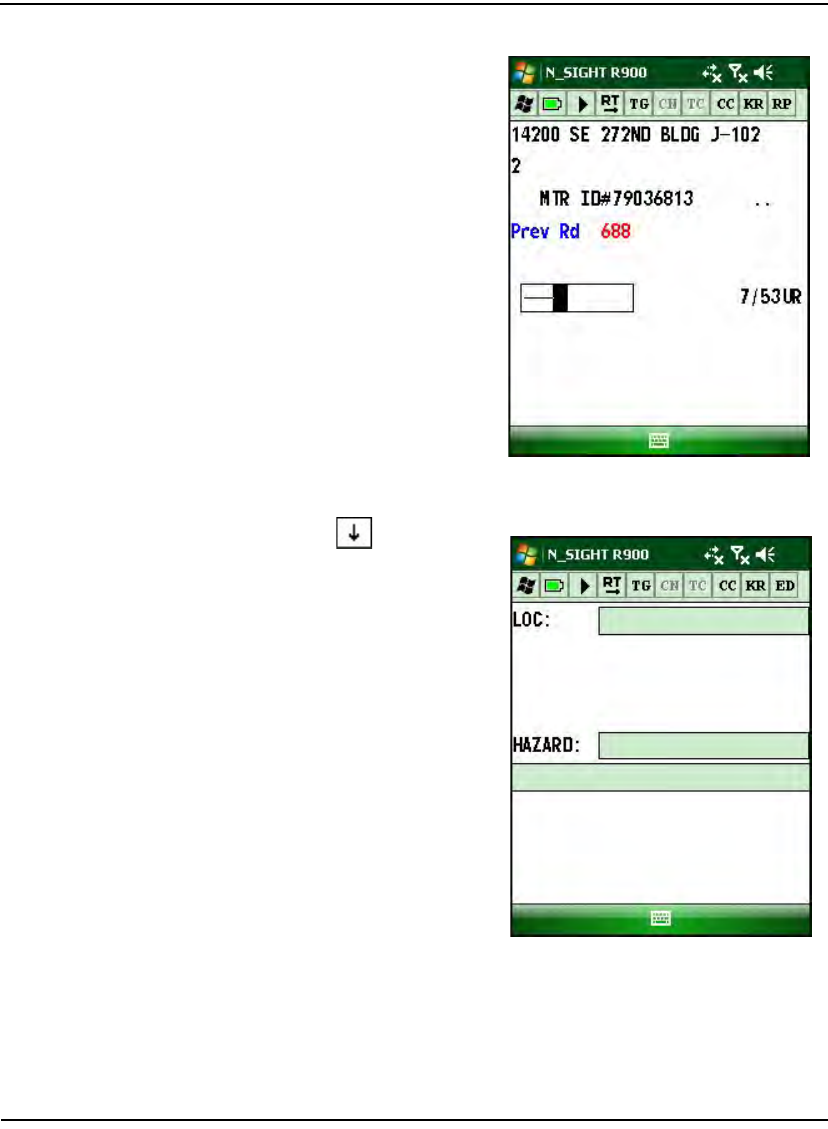
Gathering Route Data
N_SIGHT R900 User’s Manual for the Neptune Handheld System 6-33
1Make sure that the meter
for which you want to
view additional infor-
mation is shown in the
display.
Figure 6.37 Additional Meter Information to View
2Press twice.
The Location and
Hazard Codes screen
appears as illustrated in
Figure 6.38.
Figure 6.38 Location and Hazard Codes Screen
You can view two location codes and two hazard codes for each
account.
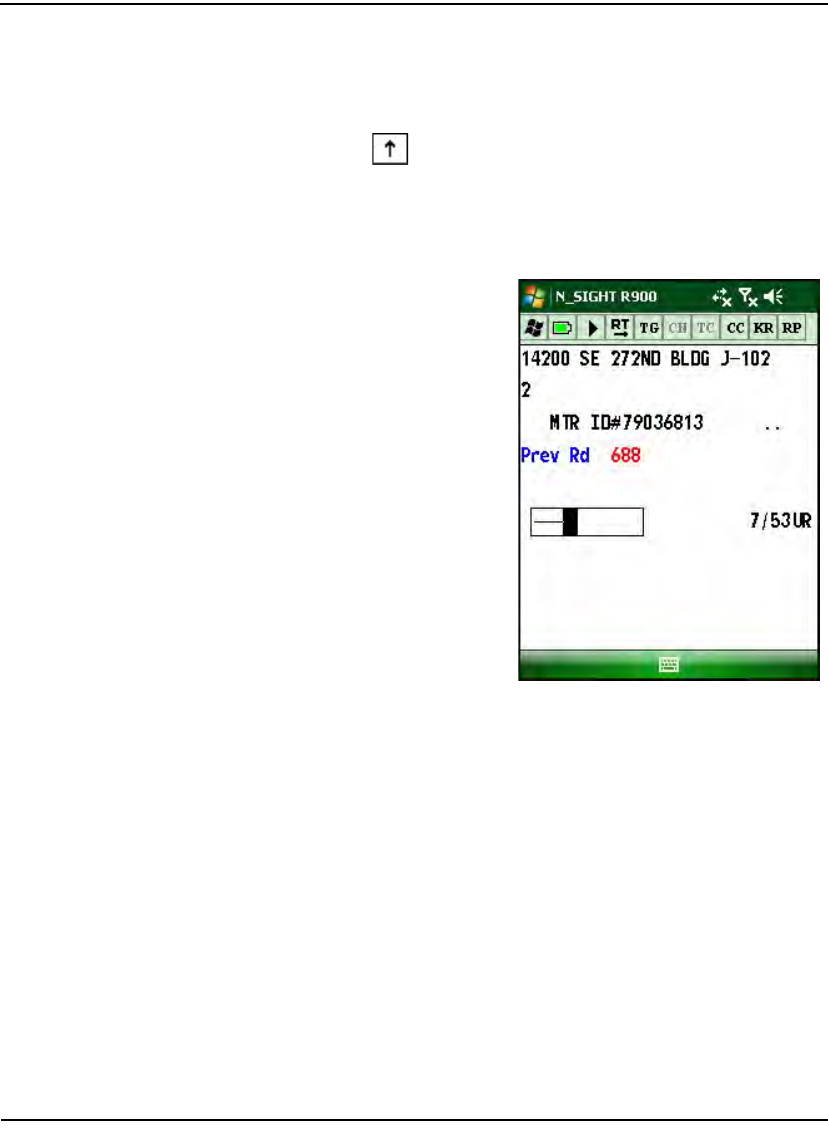
Gathering Route Data
6-34 N_SIGHT R900 User’s Manual for the Neptune Handheld System
3 When finished viewing these codes, do one of the following.
• Press Esc to return to the Reading Entry screen.
• Press to view the Statistics for Loaded Routes screen.
Statistics for Loaded Routes
To view statistics for loaded routes, follow this procedure.
1Make sure that the meter
for which you want to
view statistics for loaded
routes is shown in the dis-
play.
Figure 6.39 For Statistics for Loaded Routes
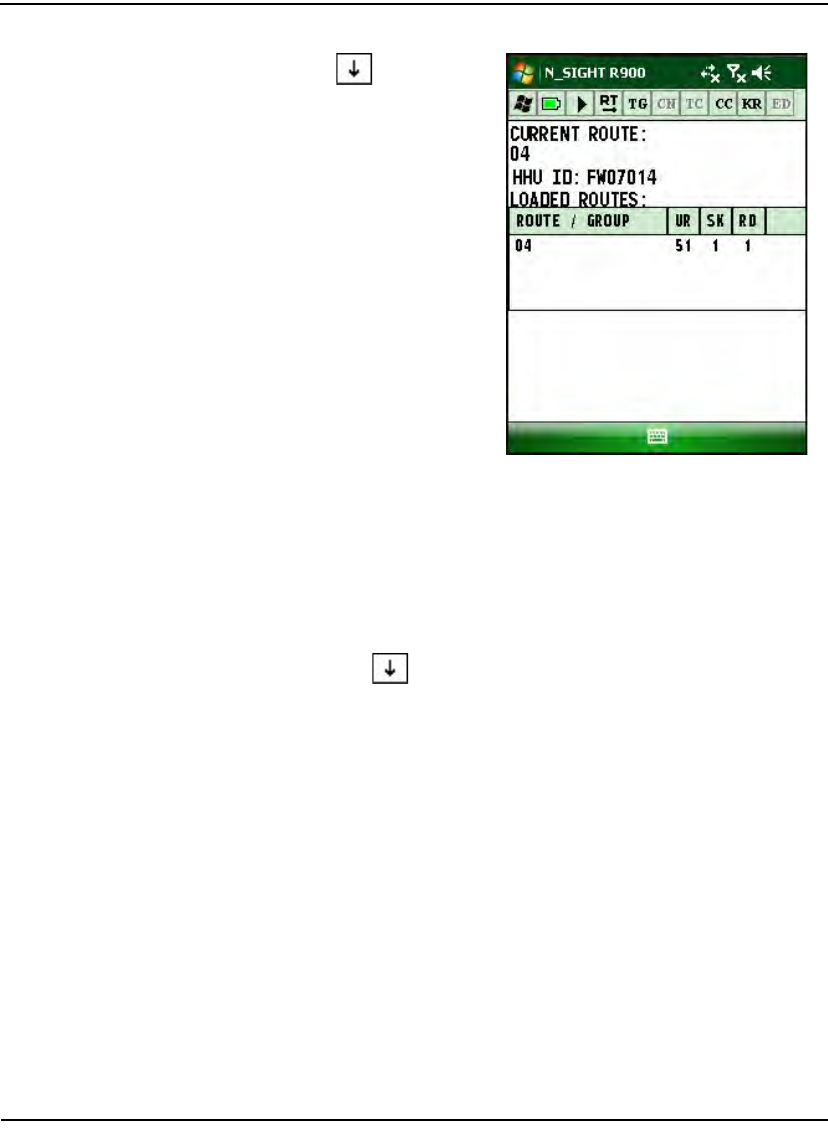
Gathering Route Data
N_SIGHT R900 User’s Manual for the Neptune Handheld System 6-35
2Press .
The Statistics for
Loaded Routes screen
appears as illustrated in
Figure 6.40.
Figure 6.40 Statistics for Loaded Routes Screen
You can view the number of unread accounts, skipped accounts,
and read accounts for each of the loaded routes.
3 When finished viewing these statistics, do one of the following.
• Press Esc to return to the Reading Entry screen.
• Press again to view the Location and Hazard Codes
screen.
Moving Around Routes
While reading meters, you can move around within the current route, or
another route if you selected it at the time you logged in. The GoTo
feature allows you to go to the:
• Previous or next route, if selected at login
• Beginning or end of the current route
• First or last incomplete account in the route
Use the following procedure to move around within a route as well as to
move from one route to another.
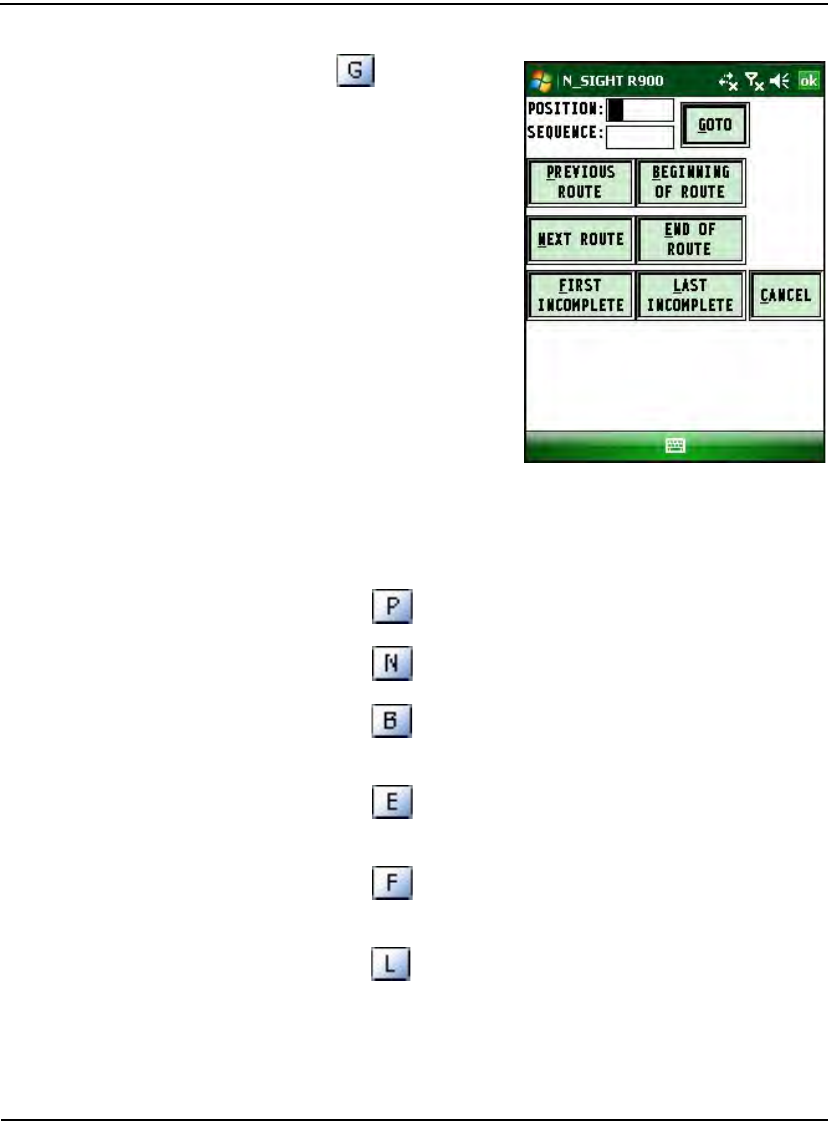
Gathering Route Data
6-36 N_SIGHT R900 User’s Manual for the Neptune Handheld System
1Press .
The GoTo screen appears
as illustrated in Figure
6.41.
Figure 6.41 N_SIGHT R900 GoTo Screen
2 On this screen, do one of the following to move to where you want
to go.
• Press or touch Prev Route to go to the previous route.
• Press or touch Next Route to go to the next route.
• Press or touch Beg of Route to go to the beginning of the
current route.
• Press or touch End of Route to go to the end of the cur-
rent route.
• Press or First Incompl to go to the first incomplete
within the route.
• Press or Last Incompl to go to the last incomplete within
the route.
3 Depending upon your selection, N_SIGHT R900 moves to the
account you chose.
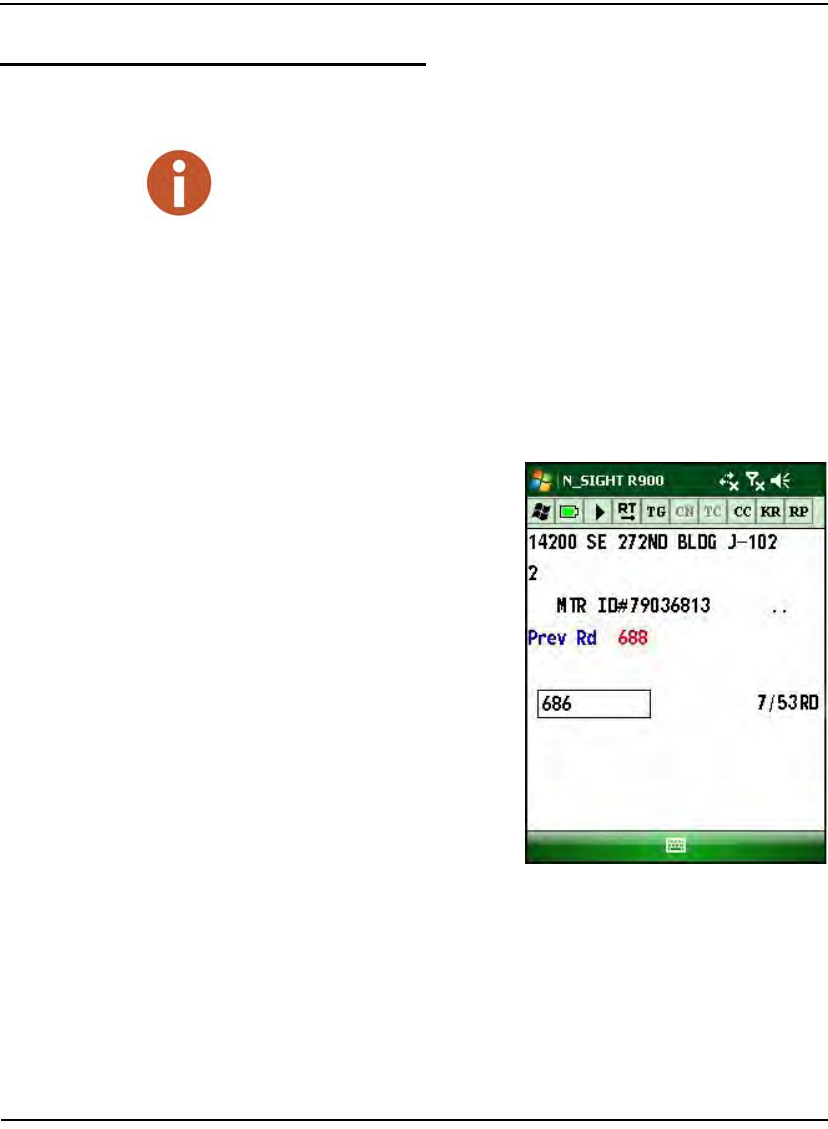
Gathering Route Data
N_SIGHT R900 User’s Manual for the Neptune Handheld System 6-37
Resequencing Routes
Resequencing allows you to sort meters by the sequence numbers or by
the timestamp of when readings were collected. Whenever you exit the
N_SIGHT R900 software, you are given the option to resequence.
However, you can resequence while you are reading meters on your
route. Complete the following procedures to resequence your route.
Resequence an Order
Follow this procedure to resequence an order.
1Display the reading entry
screen that you want to
resequence. See Figure
6.42.
Figure 6.42 Account to Resequence
Before selecting to resequence a route, you should confirm with your Utility
Office Manager that your billing system can accept the route in a
resequenced order.
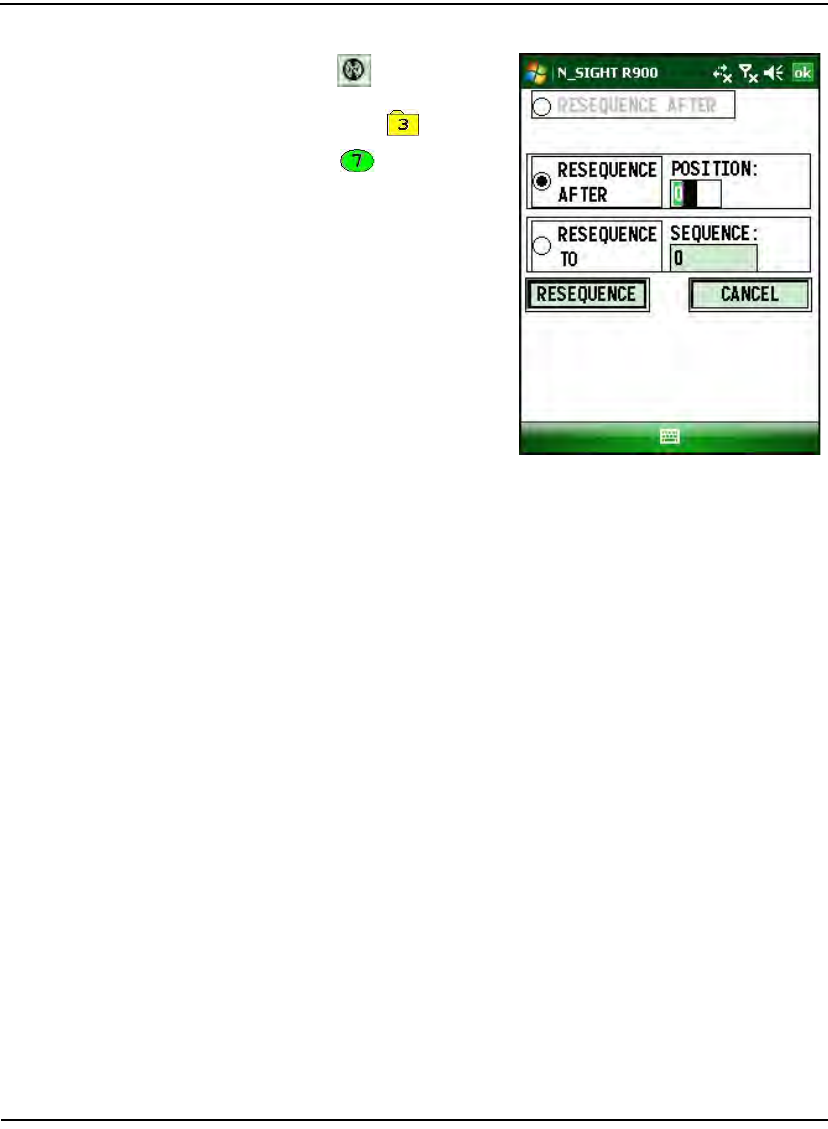
Gathering Route Data
6-38 N_SIGHT R900 User’s Manual for the Neptune Handheld System
2Press .
3 Then touch , and
touch .
The Resequence screen
appears as illustrated in
Figure 6.43.
Figure 6.43 Resequence Screen
4 Make your selections for the following.
•Resequence After – if you want the account to resequence
after the current account
•Reseq After – if you want to specify a certain position in the
route.
•Resequence To – if you want to resequence all account to a
certain position in the route.
5 Press Resequence after you make your selection.
The resequencing is completed for you.
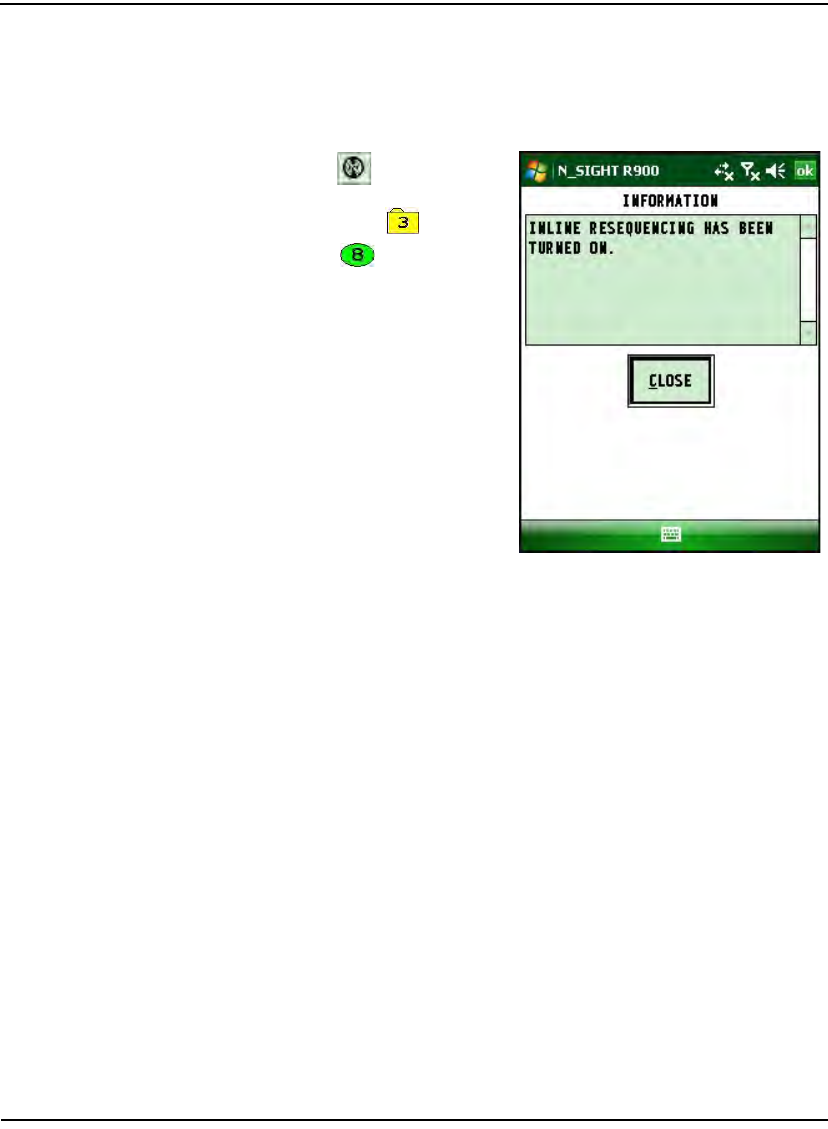
Gathering Route Data
N_SIGHT R900 User’s Manual for the Neptune Handheld System 6-39
Resequence While Collecting Readings
Follow this procedure to turn on or off resequencing while collecting
readings.
1Press .
2 Then touch , and
touch .
The Resequencing screen
appears as illustrated in
Figure 6.44.
Figure 6.44 Inline Resequencing Screen
This function works as a toggle either on or off. Use this screen to
turn it on or off, when applicable.
Confirming the Resequencing
When you exit the N_SIGHT R900 software you must first confirm the
resequencing for the routes you have just read. Three options are
available to you.
• Timestamp resequencing
• Accept resequencing
• Reject resequencing
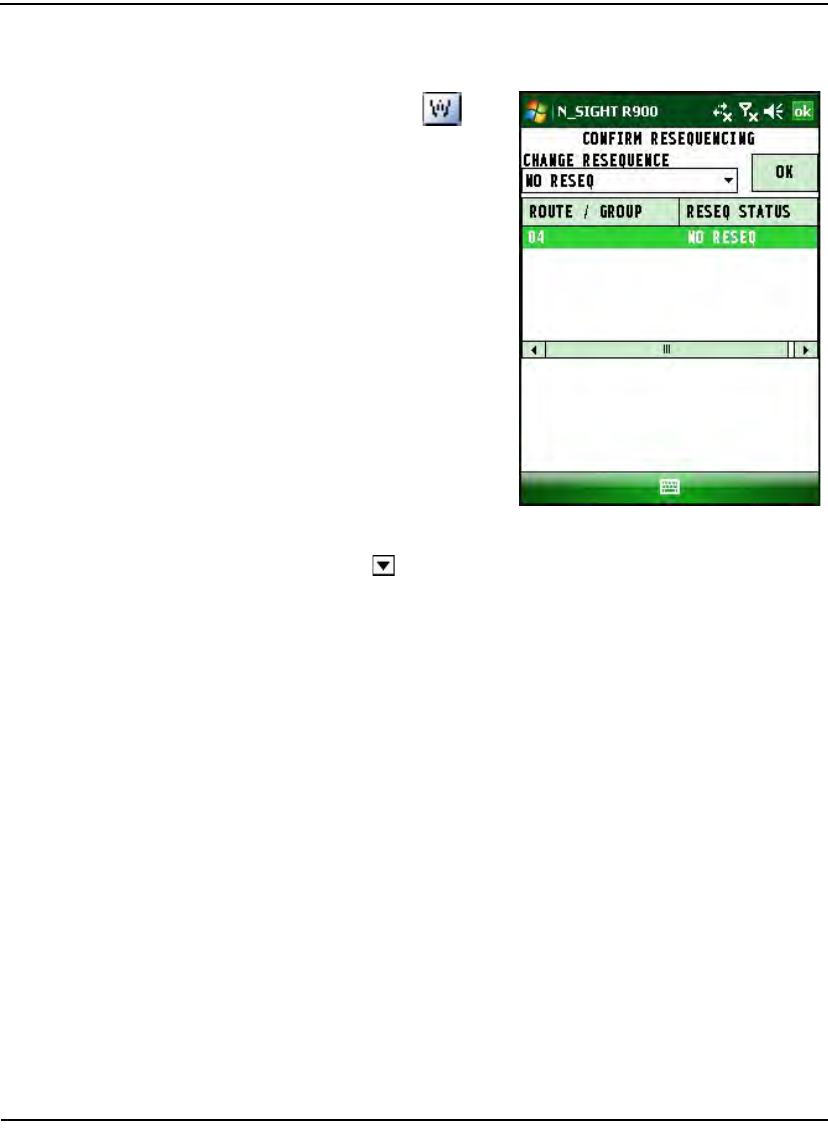
Gathering Route Data
6-40 N_SIGHT R900 User’s Manual for the Neptune Handheld System
Follow this procedure to confirm resequencing.
1When you press to
exit the N_SIGHT R900
software, the Confirm
Resequencing screen
appears as illustrated in
Figure 6.45.
Figure 6.45 Confirm Resequencing Screen
2 Touch the to select one of the following options.
• Timestamp Reseq
• Accept Reseq
• Reject Reseq
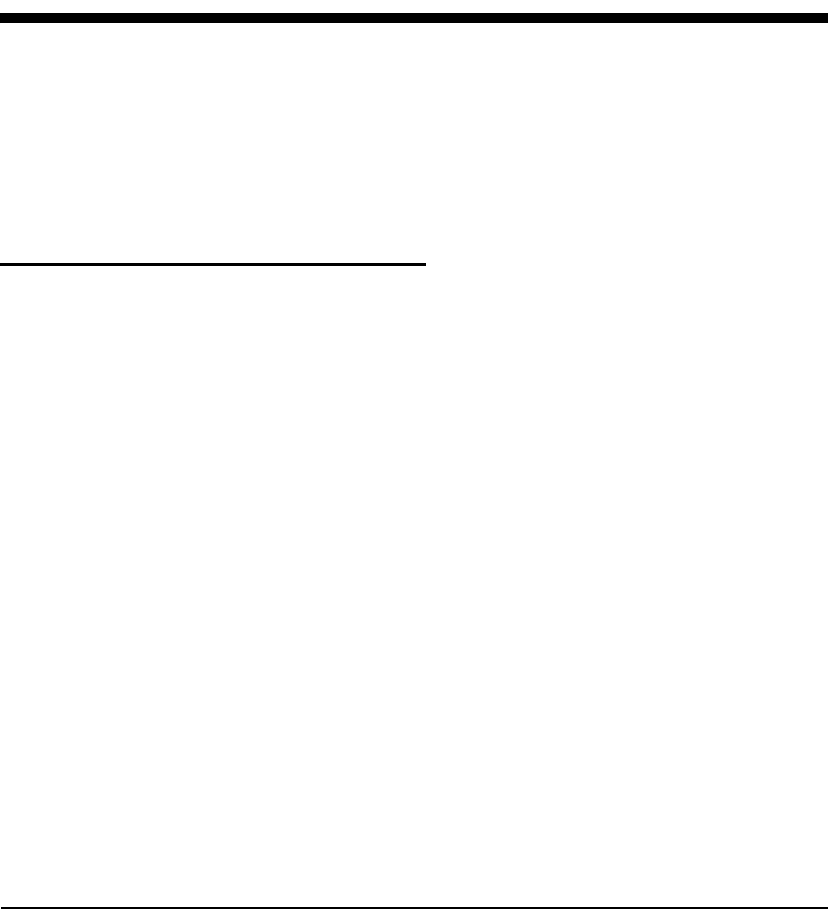
N_SIGHT R900 User’s Manual for the Neptune Handheld System 7-1
7 Communicating with the Host Computer
Once the software for the Neptune handheld system is set up and the
hardware is connected as described in either “Setting Up the CE5320,”
on page 3-3 or “Setting Up the Nomad,” on page 4-3, use the procedures
of this chapter to exchange information with the host computer. During
a typical information exchange, assignments and other route data, such
as code tables, are sent to the handheld, and meter readings and route
information are sent to the host.
Exchanging Information
There are several methods you can use to exchange information with the
host computer. The method for exchanging information is called
synchronize.
Synchronize—initiates a two-way communication between the
handheld and the host computer in which the handheld sends
information to the host computer and also receives information from the
host computer.
Exiting the Software
When you have completed all the reads in your routes, you exit the
software, and upload the route information to the N_SIGHT R900 host
software. To exit the software, complete the following procedure.
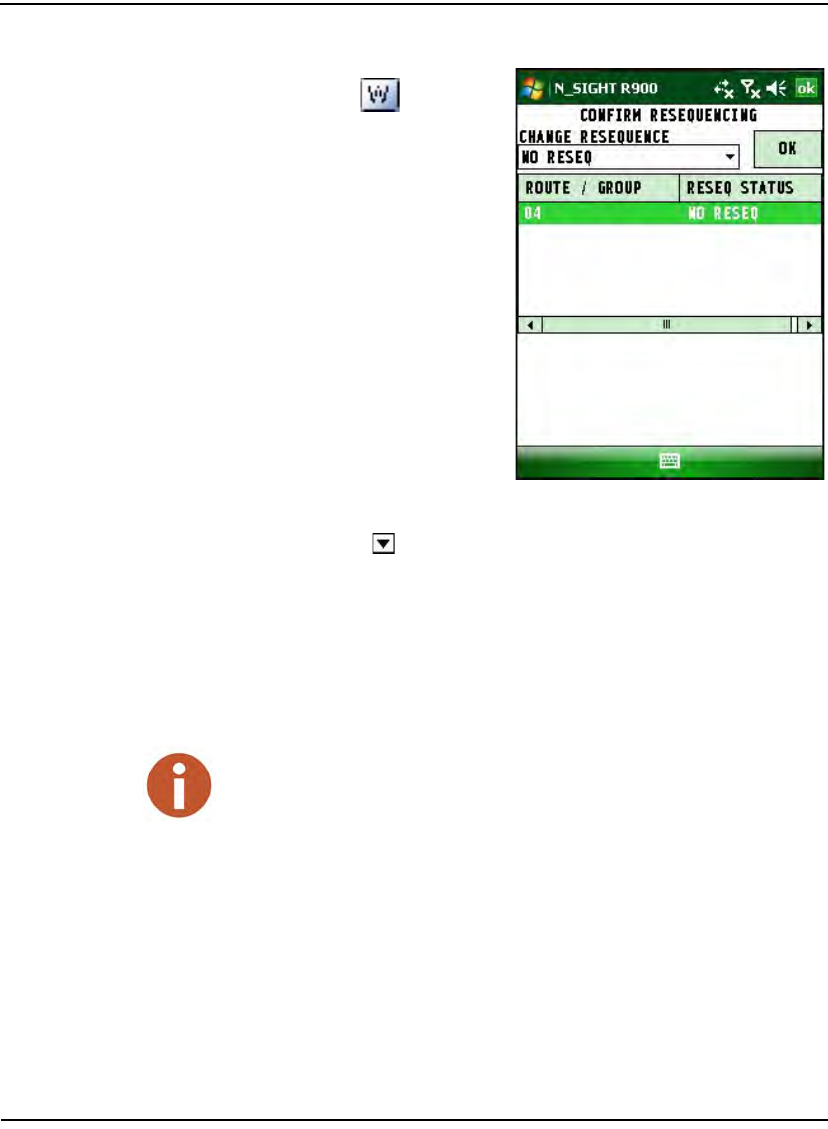
Communicating with the Host Computer
7-2 N_SIGHT R900 User’s Manual for the Neptune Handheld System
1Exit N_SIGHT R900 by
pressing .
The Confirm
Resequencing screen
appears as illustrated in
Figure 7.1.
Figure 7.1 Confirm Resequencing Screen
2 Touch the in the Change Reseq Status to select one of the fol-
lowing options, if applicable:
• Timestamp Reseq
• Accept Reseq
• Reject Reseq
If you have more than one route, select the next route, and repeat step 2.
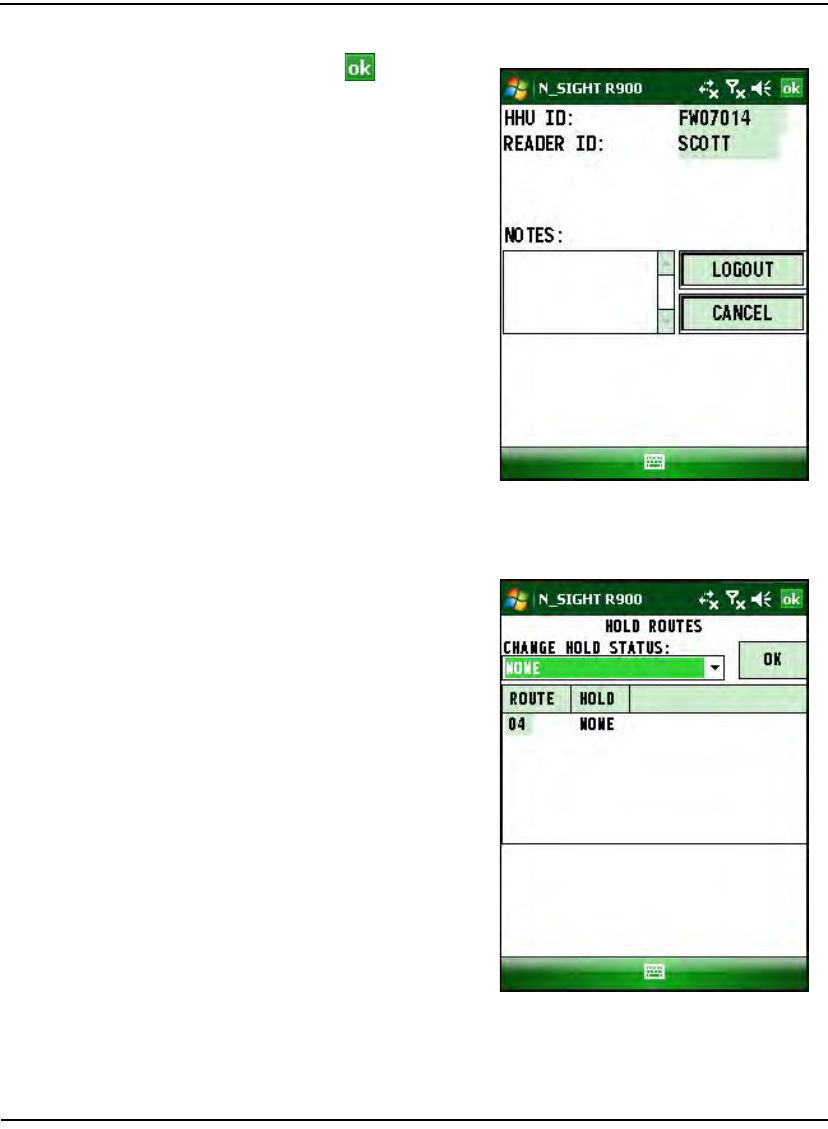
Communicating with the Host Computer
N_SIGHT R900 User’s Manual for the Neptune Handheld System 7-3
3Touch to confirm
your resequencing
choice.
The Handheld Logout
screen appears as
illustrated in Figure 7.2.
Figure 7.2 N_SIGHT R900 Handheld Logout Screen
4 Type any notes, if applicable.
5Touch Logout.
The Hold Routes screen
appears as illustrated in
Figure 7.3.
Figure 7.3 Hold Routes Screen
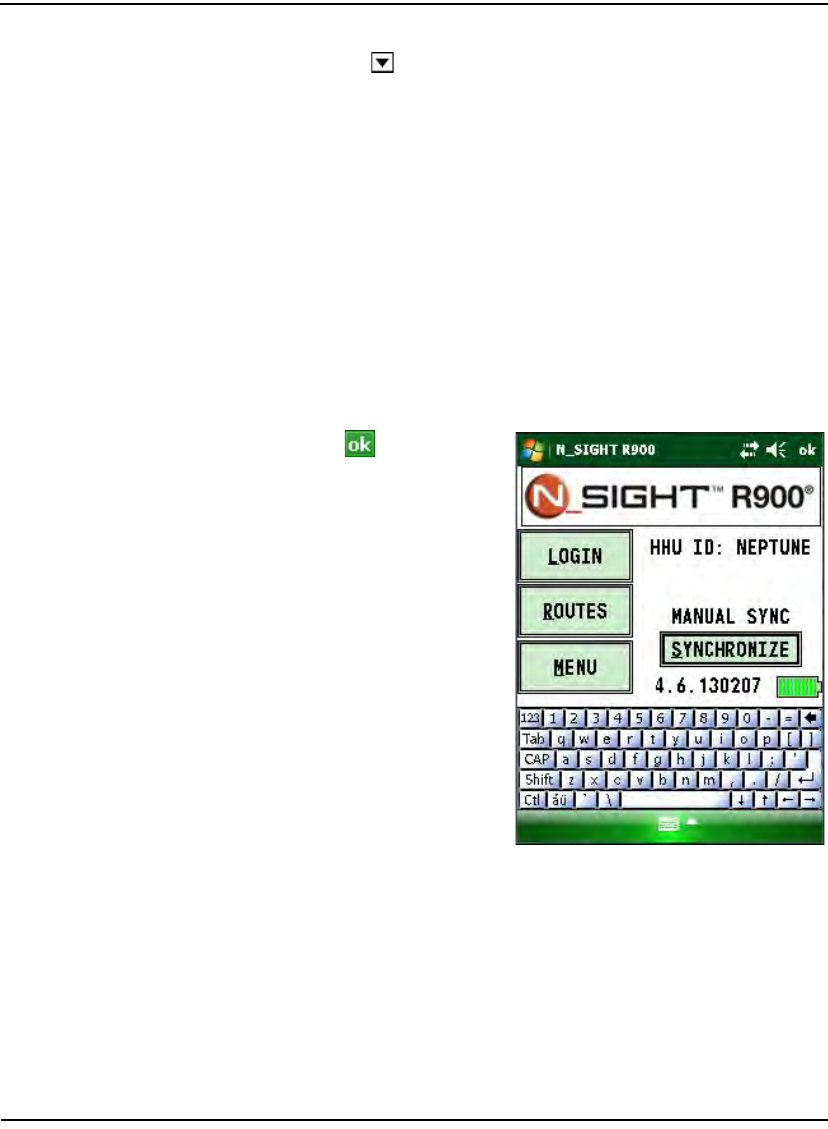
Communicating with the Host Computer
7-4 N_SIGHT R900 User’s Manual for the Neptune Handheld System
6 Touch the in Change Hold Status to select one of the following
options, if applicable.
All of these hold functions determine which accounts are left in the
handheld after the route is uploaded.
7 Select the route to hold, if applicable.
8Touch .
The N_SIGHT R900
Login screen appears as
illustrated in Figure 7.4.
Figure 7.4 N_SIGHT R900 Login Screen
Sending and Receiving
When ready to communicate or synchronize with the host computer, use
this procedure to send and receive information. Follow this procedure
for each handheld that you are using.
None Hold none of the accounts in the handheld.
Unread/Skipped Hold all unread accounts and all skipped
accounts in the handheld.
Unread Hold only the unread accounts in the handheld.
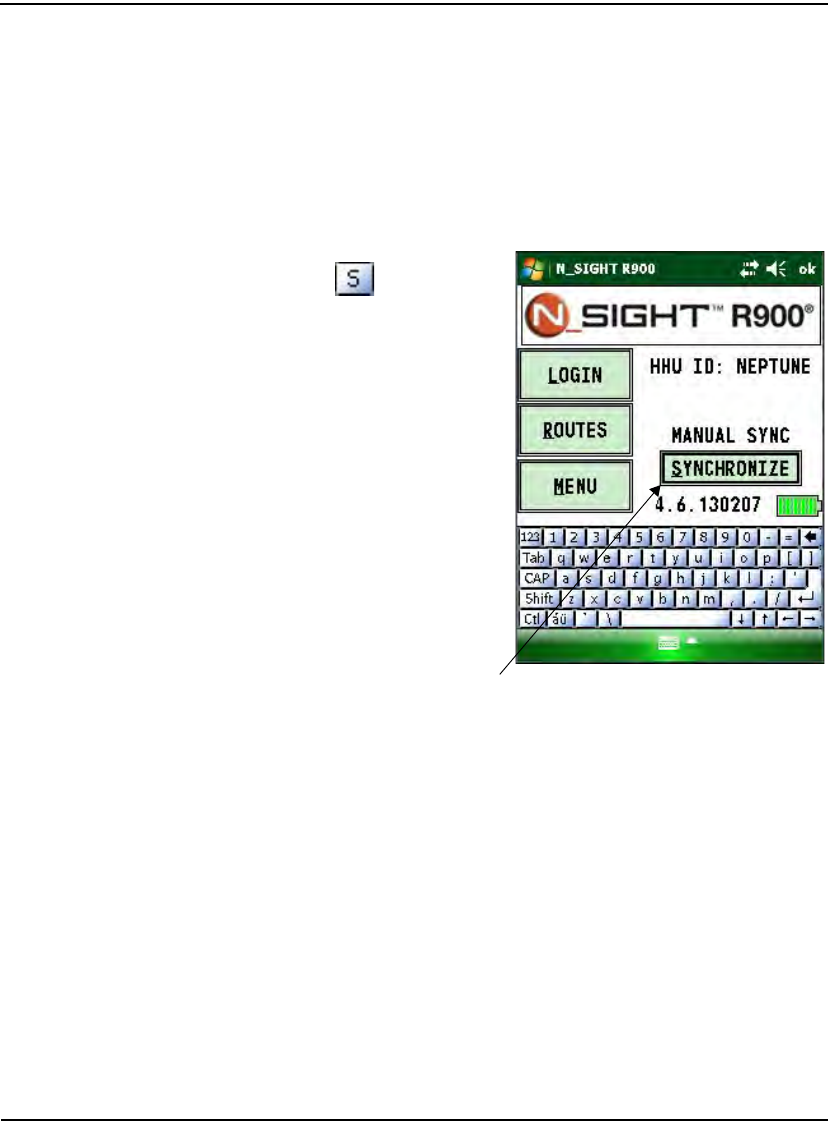
Communicating with the Host Computer
N_SIGHT R900 User’s Manual for the Neptune Handheld System 7-5
1 Do one of the following.
• Place the CE5320B handheld in the cradle by sliding it bottom
first into the cradle.
• Place the Nomad handheld into the Charging/Communications
Cradle or connect the Nomad to the PC with the USB Cable.
2On the N_SIGHT
R900 Login screen,
press or touch
Synchronize.
Figure 7.5 Synchronize Button
If your handheld system is set to AutoSync, the handheld will
indicate with the audible message "Connected" when it is starting
the communications process.
When the handheld is removed from the Cradle, it will indicate
with the audible message "Disconnected" (regardless of sync
mode).
The hour glass appears on the screen to show that the
communications process in underway.
Touch Synchronize to start communications. An X
appears until Network Connection is established

Communicating with the Host Computer
Notes:
7-6 N_SIGHT R900 User’s Manual for the Neptune Handheld System

N_SIGHT R900 User’s Manual for the Neptune Handheld System 8-1
8 Using the Field Programmer
This chapter provides fundamental instructions for operating the
Field Programmer including how to connect the mouse to the CE5320
and the Nomad handheld devices, programming the device, and more.
This chapter contains basic features of the Field Programmer and it also
gives instructions for setting it up, so that it can be used to collect
information from the field.
Connecting the Mouse
The Field Programmer mouse, when connected to the to the CE5320 or
the Nomad handhelds, allows you to query or program a ProRead
register by using one of the following methods.
• Touch-read
• Use of the alligator clip to connect red, green, and black wires.
It also allows you to program an R900G endpoint through an infrared
programming LED.
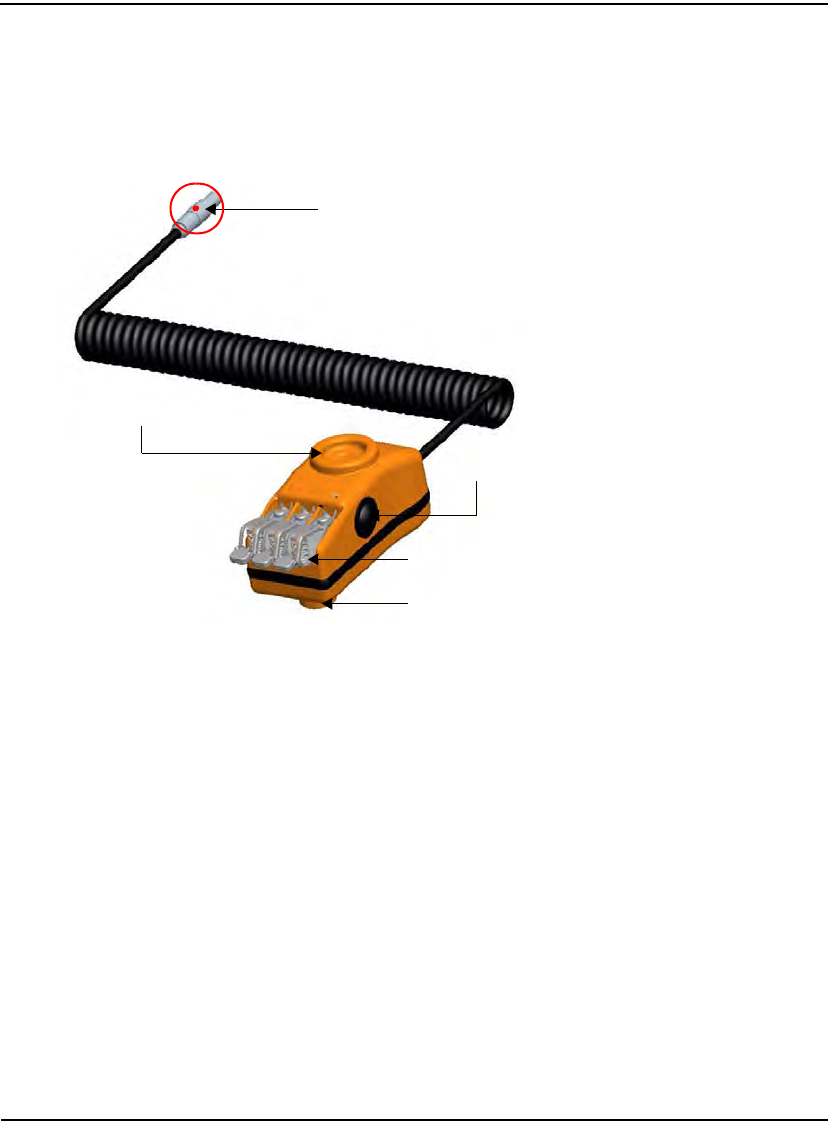
Using the Field Programmer
8-2 N_SIGHT R900 User’s Manual for the Neptune Handheld System
Connecting the Mouse to the CE5320
The following illustration displays some of the features of the mouse
that connects to the CE5320.
Figure 8.1 Field Programmer Mouse for the CE5320
To connect the mouse to the CE5320, complete the following steps.
1 Locate the small red dot at the end of the mouse connector cable.
See Figure 8.1.
2 Locate the small red mark on the port at the right of the display on
the Field Programmer. See Figure 8.2 on page 8-3.
3 Push the mouse connector into the lemo port, lining up the red
marks.
Touch-read inductive coupling
Small red dot on mouse connector
IR Programming LED for R900G endpoint
Programming button
Alligator clips to connect red, green, and black wires on register
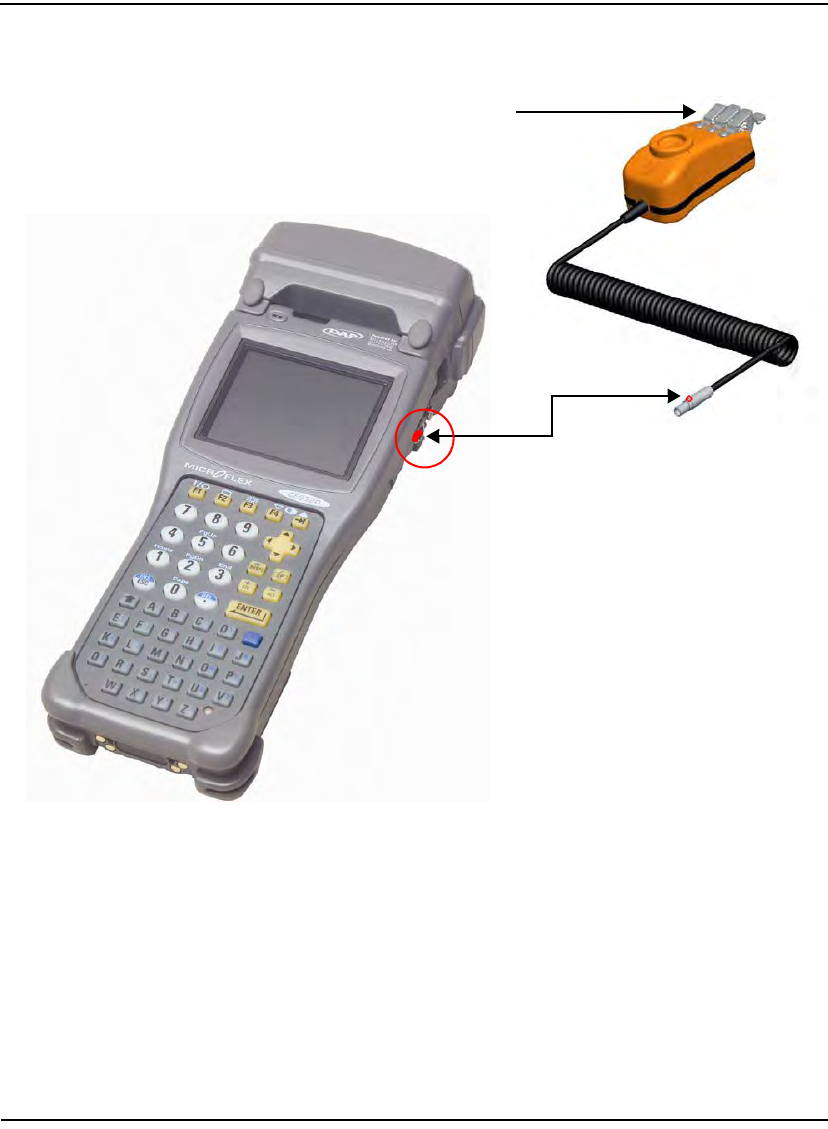
Using the Field Programmer
N_SIGHT R900 User’s Manual for the Neptune Handheld System 8-3
Figure 8.2 Connecting Mouse to CE5320
Alligator clips to connect red,
green, and black wires on register
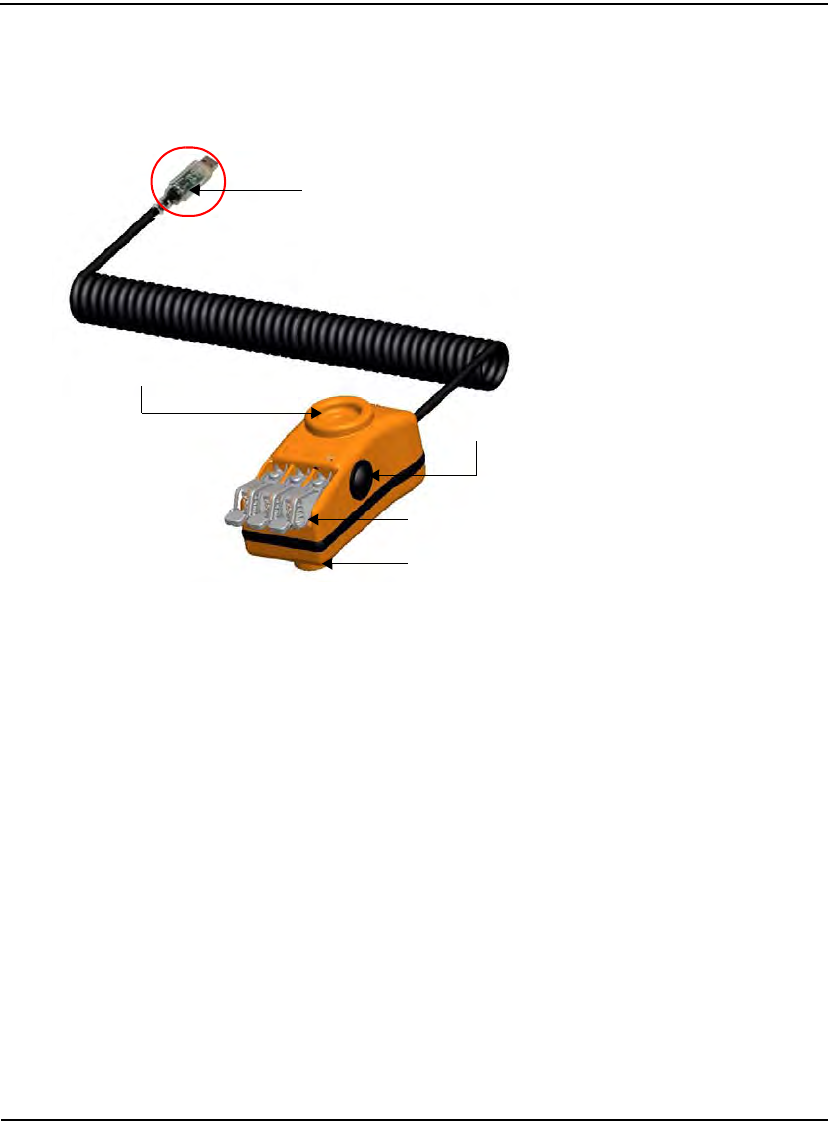
Using the Field Programmer
8-4 N_SIGHT R900 User’s Manual for the Neptune Handheld System
Connecting the Mouse to the Nomad
The following illustration displays some of the features of the mouse
Figure 8.3 Field Programmer Mouse for the Nomad
To connect the mouse to the Nomad Field Programmer, complete the
following steps.
1 Locate the USB connector at the end of the mouse cable. See Figure
8.3.
2 Locate the USB port on the bottom of the Nomad. See Figure 8.4
on page 8-5.
3 Push the USB connector into the USB port.
Touch-read inductive coupling
IR Programming LED for R900G endpoint
Programming button
Alligator clips to connect red, green, and black wires on register
USB mouse connector
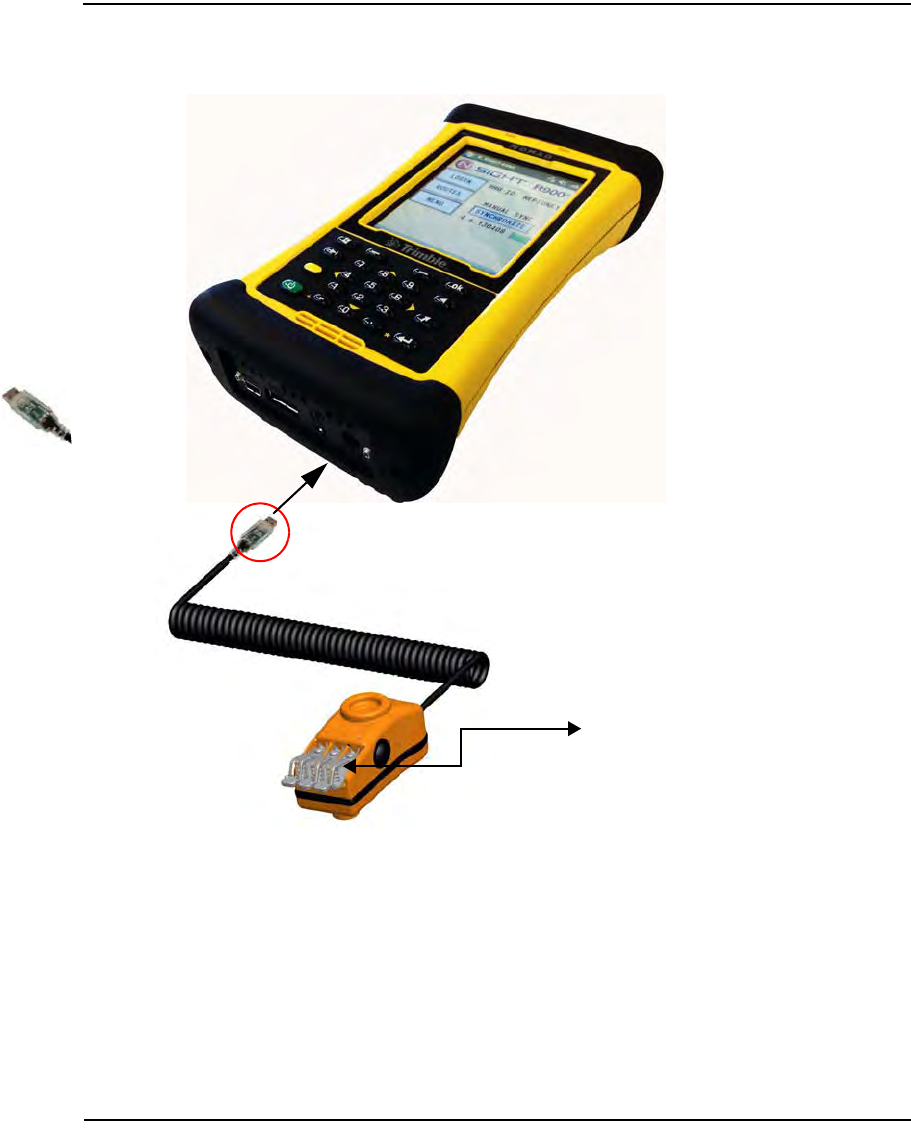
Using the Field Programmer
N_SIGHT R900 User’s Manual for the Neptune Handheld System 8-5
Figure 8.4 Connecting Mouse to Nomad
Alligator clips to connect red, green,
and black wires on register
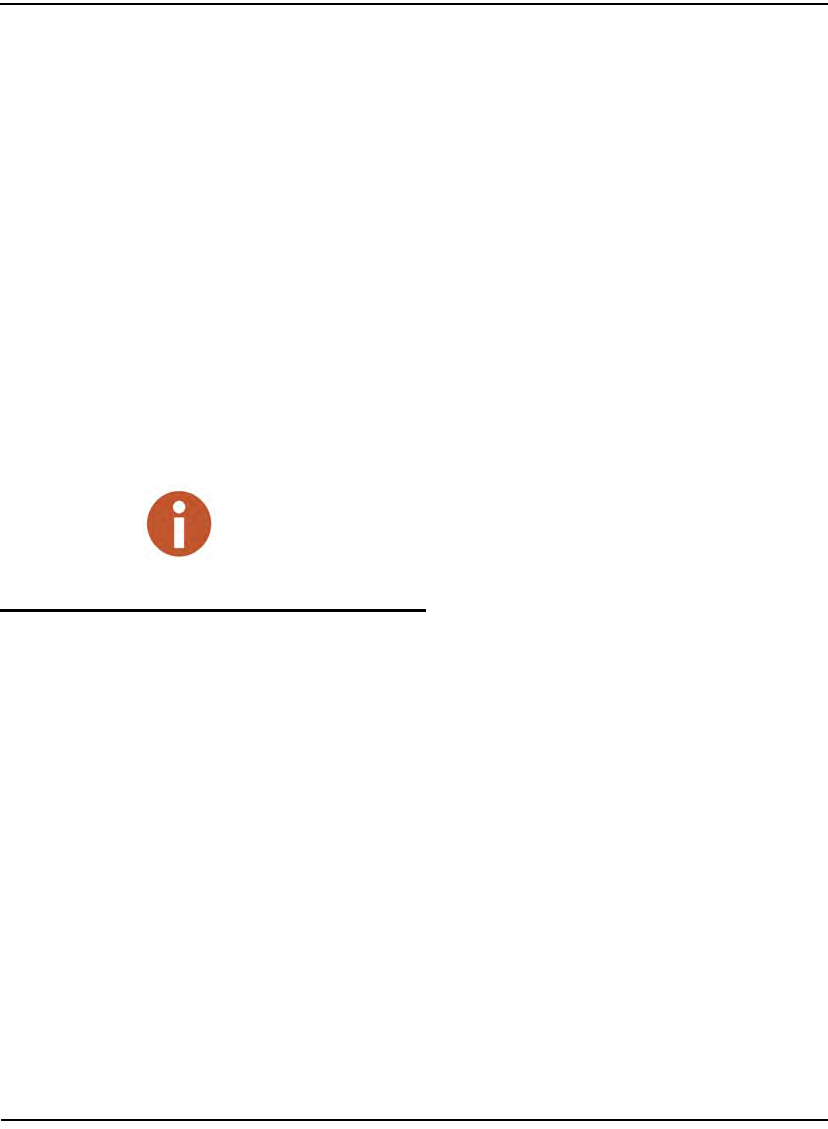
Using the Field Programmer
8-6 N_SIGHT R900 User’s Manual for the Neptune Handheld System
Verifying the Handheld Recognizes the Mouse
If the handheld does not recognize the mouse, complete the following
steps.
1 Exit the NHPSProSys software. See “Exiting the Software,” on
page 7-1.
2 Verify that the mouse and/or receiver are connected to the handheld
device.
3 Run InstallEngine_HH.exe and wait for it to finish.
4 Restart the handheld using the Software Reset located in Options
in the CE window.
5 When the handheld is running, select NHPSProSys.exe.
6 Verify that the program recognizes the mouse or receiver.
Starting Field Programmer
To start the Field Programmer, complete the following steps.
This can take some time for the handheld to check for the mouse. Wait at
least 30 seconds for the handheld to recognize the mouse.
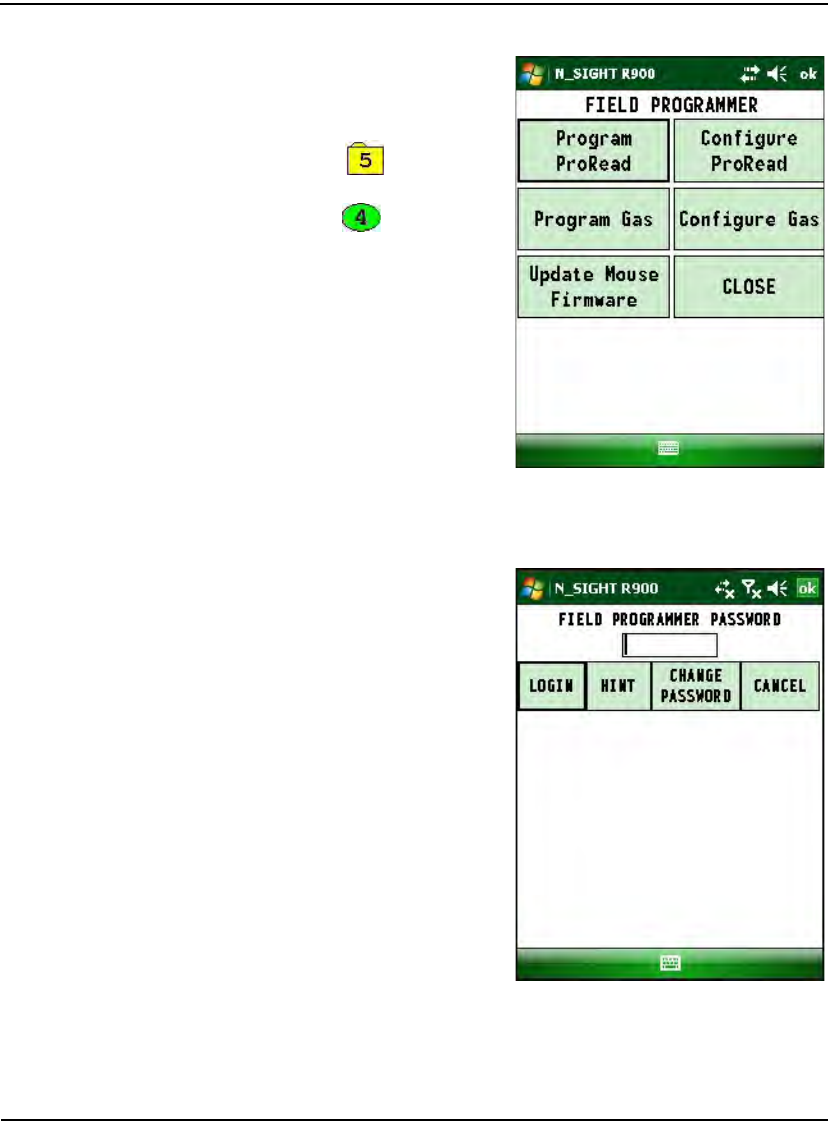
Using the Field Programmer
N_SIGHT R900 User’s Manual for the Neptune Handheld System 8-7
1From the N_SIGHT R900
Login screen, touch
Menu.
2 Touch .
3 Select ,
Field Programmer.
The Field Programmer
Menu appears.
Figure 8.5 Field Programmer Menu
4 Touch the option you
want to use.
• Program Pro Read
• Configure ProRead
• Program Gas
• Configure Gas
The Field Programmer
Password screen appears.
Figure 8.6 Field Programmer Password Screen
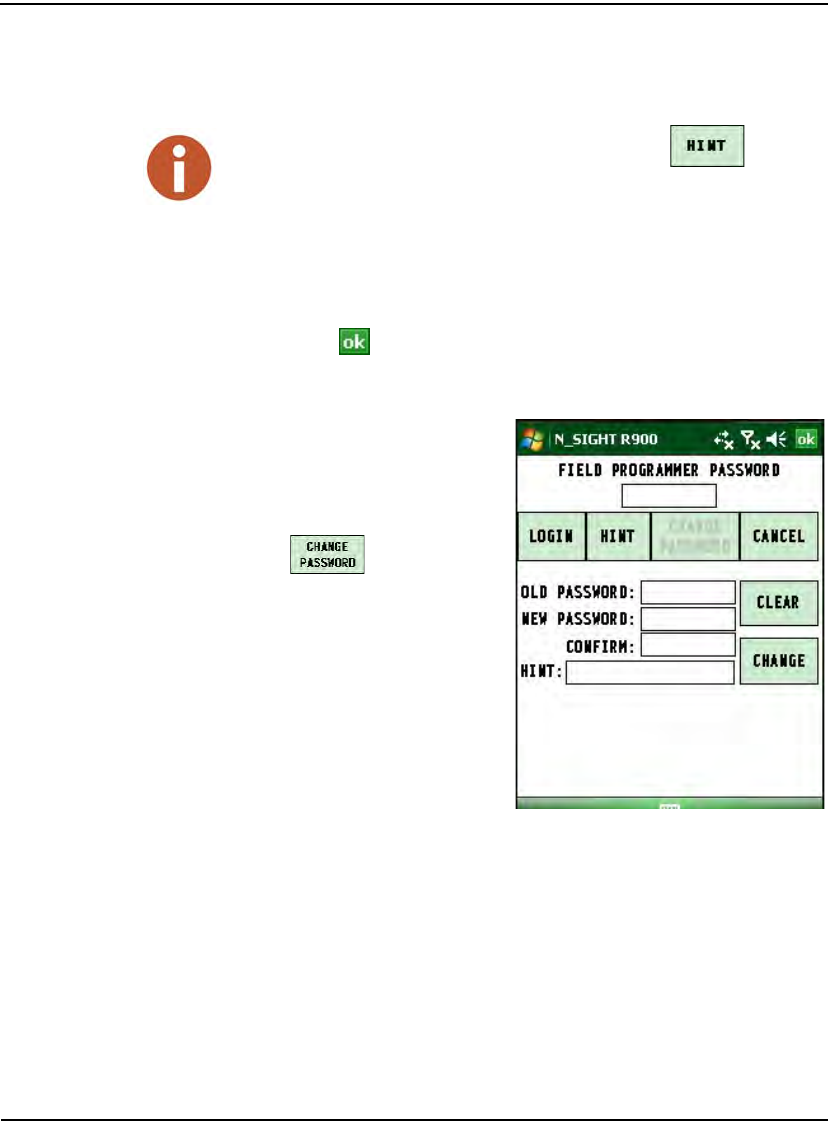
Using the Field Programmer
8-8 N_SIGHT R900 User’s Manual for the Neptune Handheld System
5 Type your password.
On this screen, you can also change your password as described in
“Changing Your Password,” on page 8-8 or you can cancel logging
in to the system
6Click .
Changing Your Password
Complete the following steps
to change your password.
1 On the Field Programmer
Password screen, touch
.
The Change Password
screen appears. See
Figure 8.7.
Figure 8.7 Change Password Screen
2In Old Password, type the old password.
3In New Password, type your new password.
If you cannot remember your password, you can touch or click to display
a clue.
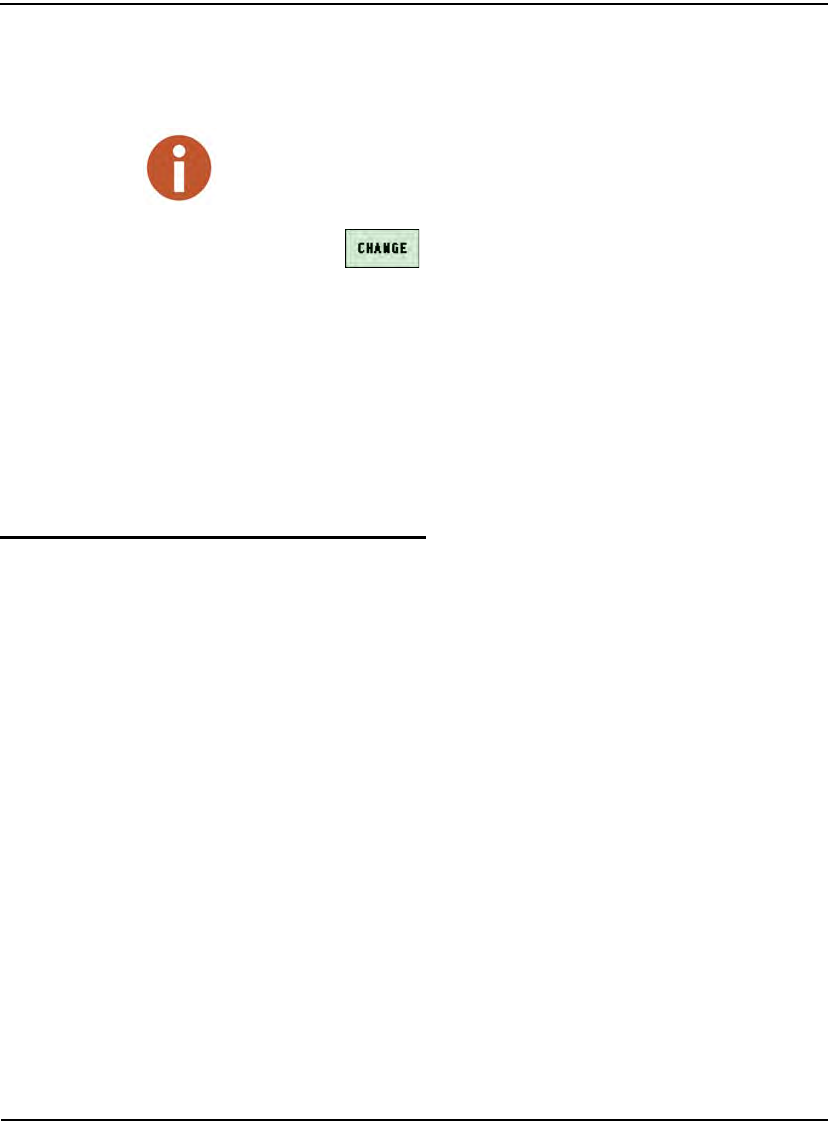
Using the Field Programmer
N_SIGHT R900 User’s Manual for the Neptune Handheld System 8-9
4In Confirm, type your new password again.
5 Touch .
Your password is now changed.
Programming the ProRead
The first time you use the Field Programmer software after the
installation, you need to configure both the ProRead and the gas
functionality.
Congfiguring the ProRead
To program the ProRead, use the Neptune Field Programmer and
complete the following steps.
What you enter in New Password and Confirm must match in order for you to change
the password. If they do not, you will receive an error message.
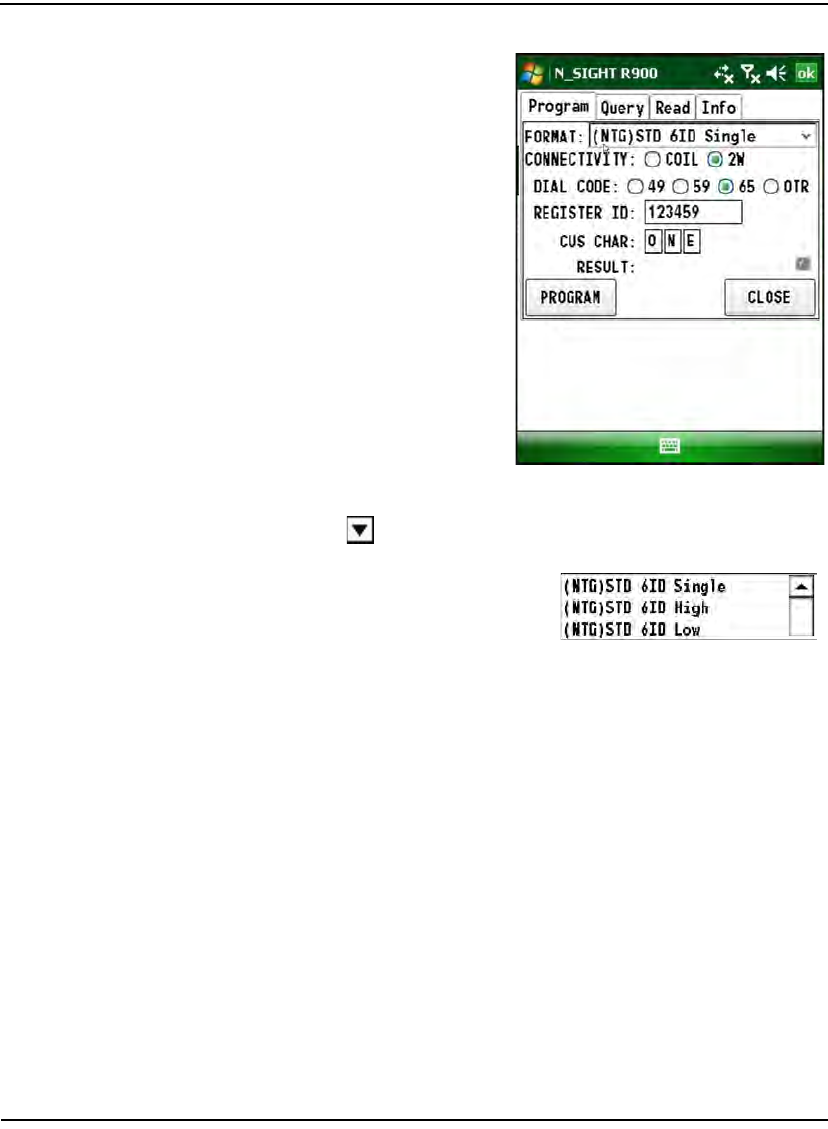
Using the Field Programmer
8-10 N_SIGHT R900 User’s Manual for the Neptune Handheld System
1Select Program ProRead
from the
Field Programmer
Menu. See “Starting
Field Programmer,” on
page 8-6.
The ProRead
Programming screen
appears. See Figure 8.8.
Figure 8.8 ProRead Configuration Screen
2 Touch for Format Name.
A selection list similar to Figure
8.9 appears.
Figure 8.9 Format Name Selection List
3 Touch or click the format you want, and double click or press
Enter.
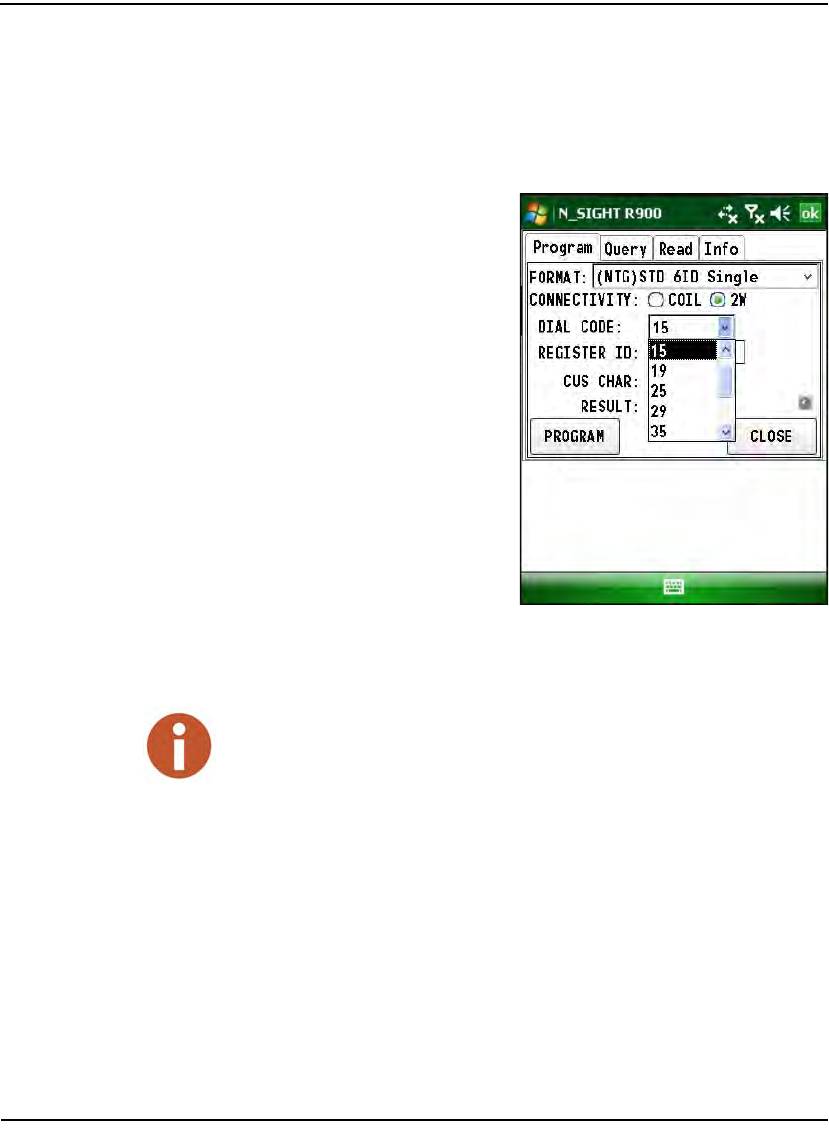
Using the Field Programmer
N_SIGHT R900 User’s Manual for the Neptune Handheld System 8-11
4 For Connectivity, touch one of the following.
•Coil – if you are using the touchpad
•2W – (2-wire) if you are using the alligator clip
5For Dial Code, touch one
of the following to adjust
the number of meter read-
ing digits returned from
the register to a reading
device:
•49
•59
•65
•otr – to choose
another value from a
selection list. See
Figure 8.10. (To return
to the screen from this
list, select None.)
Figure 8.10 Otr Selection List
6In Register ID, type the ID or serial number of the register.
7 For Cus Char, enter the additional information you want to have
for that meter, such as size or location.
•M N L (upper case, alphanumeric)
•1 2 S (numeric digits.)
The water utility often requires modification so that a reading matches its standard
billing units, such as 1000s of gallons.
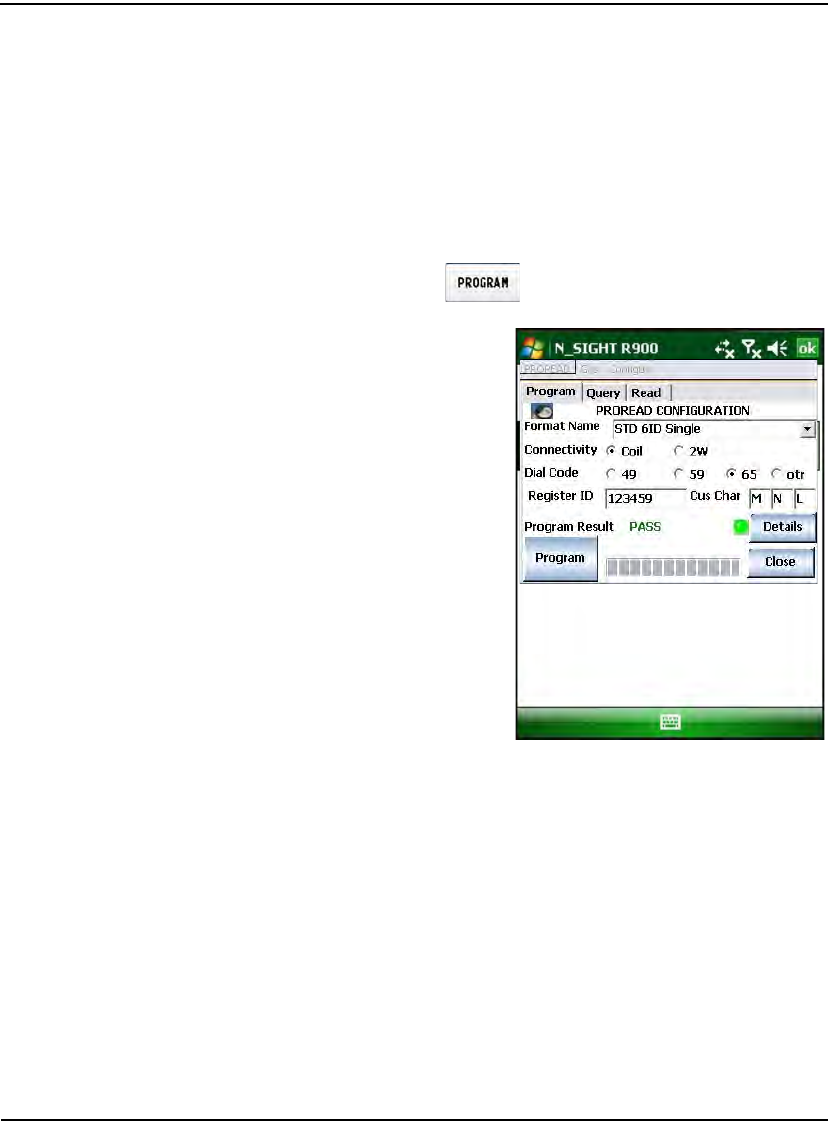
Using the Field Programmer
8-12 N_SIGHT R900 User’s Manual for the Neptune Handheld System
8 Connect in one of the following ways.
• For coil, align the mouse coil with the receptacle, then proceed
to step 9.
• For alligator clips, attach the clips to the corresponding wire
color, then proceed to step 9.
9 Start Programming in one of the following ways.
• Touch or click .
(This button can only
be used for
programming; it
cannot be used for
Read or Query.)
• Press the program
button on the mouse.
• Press Enter.
An audible tone signals
the Program Result.
•PASS
•FAIL
See Figure 8.11.
Figure 8.11 Program Result -- Pass Screen
10 If you want to view detailed information, touch or click Details.
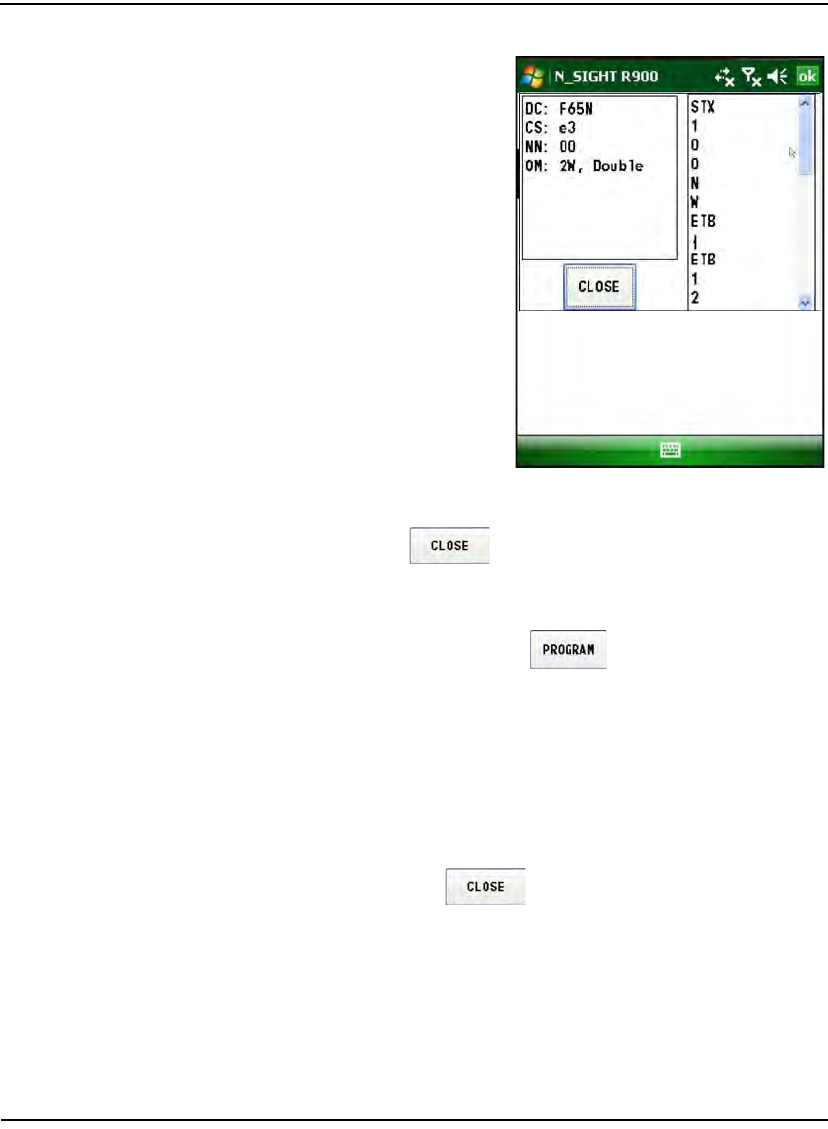
Using the Field Programmer
N_SIGHT R900 User’s Manual for the Neptune Handheld System 8-13
Details display the data in
raw format. See Figure
8.12.
Figure 8.12 ProRead Program Details Screen
11 Touch or click to return to the ProRead Configuration
screen.
12 You can program a similar register that can automatically generate
a new ID number by pressing again.
13 You can program a different type of register by repeating steps 1
through 10.
14 When finished programming, choose one of the following.
• Touch or click Read to take a reading.
• Touch or click Query to query the register.
• Touch or click to return to the main screen.
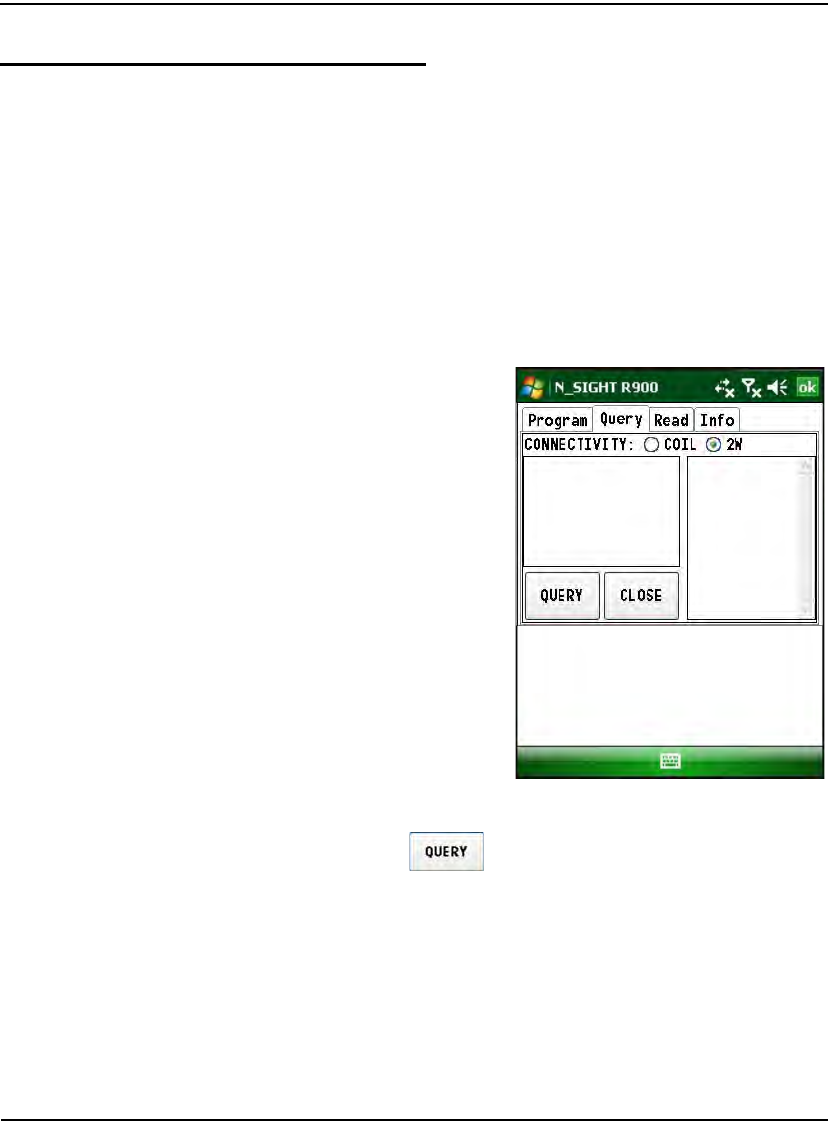
Using the Field Programmer
8-14 N_SIGHT R900 User’s Manual for the Neptune Handheld System
Querying the ProRead
Use the query function to determine the current programming
configuration of a ProRead register. You can determine the format type,
Dial Code setting, Network Numbers, ID number, and other important
settings from the query results. This information is especially critical
when using the Field Programmer to read registers, because the
programmer must first be configured with the proper settings before it
can read successfully.
To query a register, place the appropriate adapter on the register or
receptacle, and complete the following steps.
1Select Program ProRead
from the
Field Programmer
menu.
2 Select the Query tab.
The ProRead Query
screen appears. See
Figure 8.13.
Figure 8.13 ProRead Query Screen
3 Touch or click to perform a query.
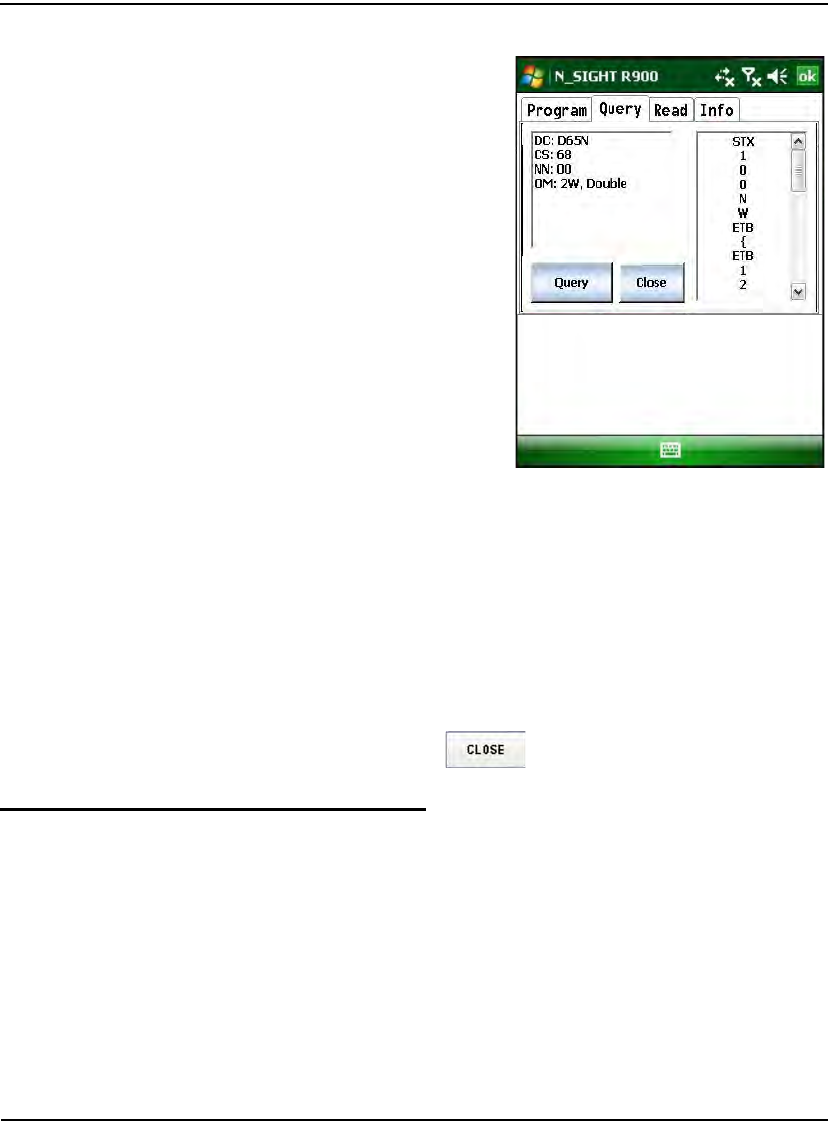
Using the Field Programmer
N_SIGHT R900 User’s Manual for the Neptune Handheld System 8-15
The query results appear
similar to that of Figure
8.14.
Figure 8.14 ProRead Query Results
The query results should confirm that the ProRead register is
programmer correctly.
4 Repeat steps 1 through 3 to query another register or choose one of
the following.
• Touch or click Read to take a reading.
• Touch or click Program to program the register.
• Touch or click to return to the main screen.
Reading the ProRead Register
The Field Programmer is designed to be used as a programming and
troubleshooting tool rather than a reading device. However, the
Field Programmer is capable of collecting readings.
To read a ProRead register, complete the following steps:
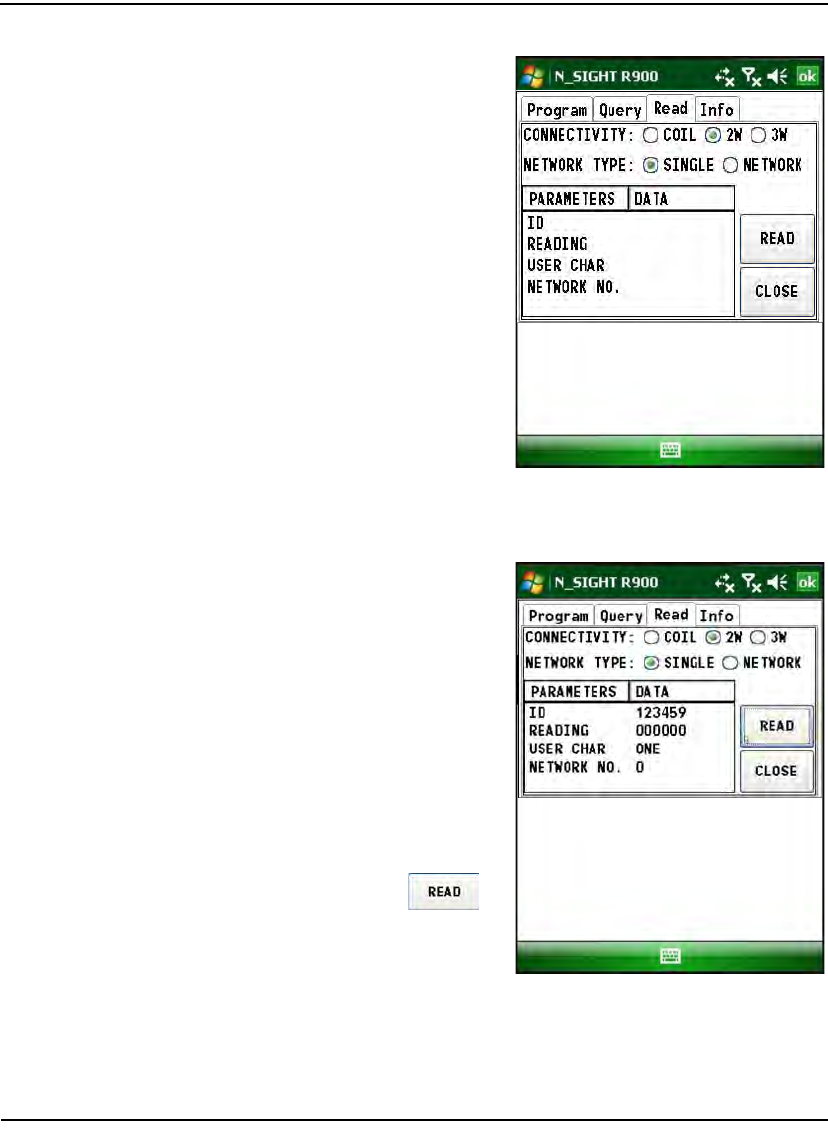
Using the Field Programmer
8-16 N_SIGHT R900 User’s Manual for the Neptune Handheld System
1Select ProRead from the
Field Programmer menu.
2 Select the Read tab.
The ProRead Read screen
appears. See Figure 8.15
Figure 8.15 ProRead Read Screen
3Select Network Type.
4 Select the Connectivity.
• Align the mouse with
the register. Touch or
click Coil to collect a
reading.
• Select 2W to use
without receptacle.
• Select 3W for pro-
grammed registers.
5 Touch or click
to collect the reading. See
Figure 8.16.
Figure 8.16 ProRead Reading Result Screen
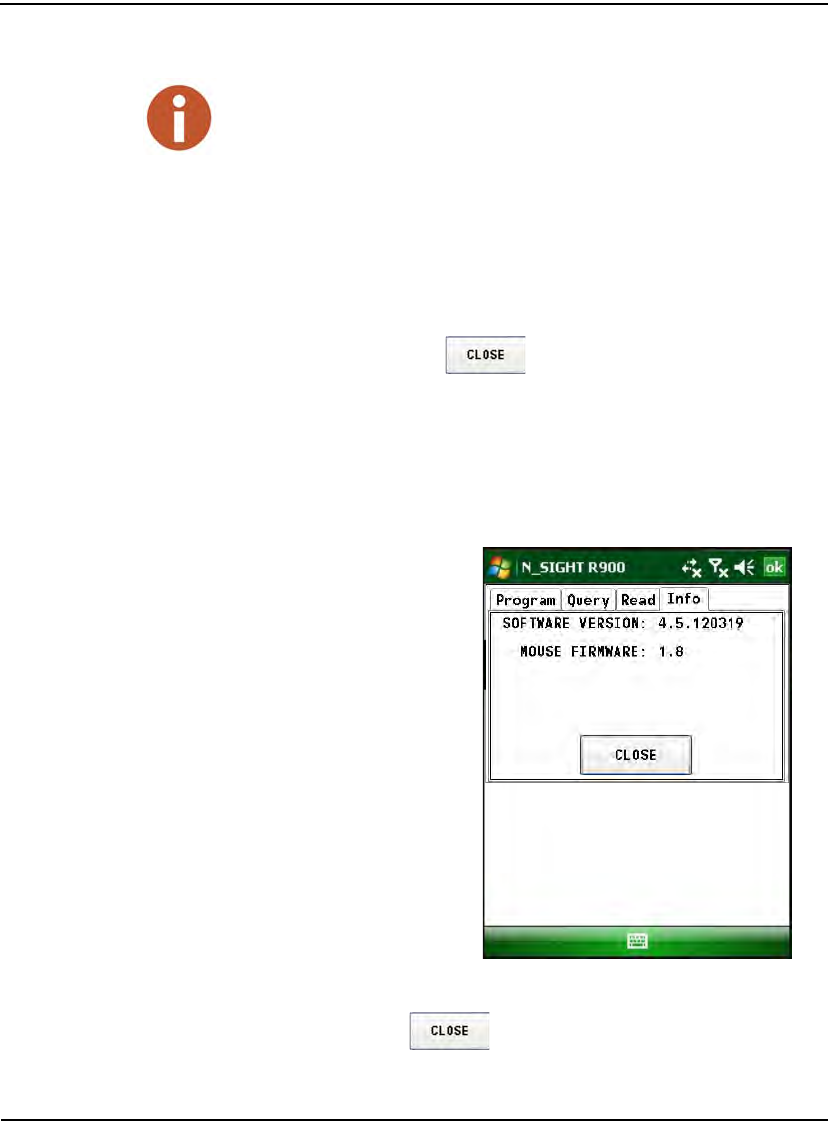
Using the Field Programmer
N_SIGHT R900 User’s Manual for the Neptune Handheld System 8-17
6 Repeat steps 1 through 5 to read another register, or choose one of
the following.
• Touch or click Program to program the register.
• Touch or click Query to query the register.
• Touch or click to return to the main screen.
Viewing Software and Firmware Information
It is important to know which version of the Field Programmer software
you are using when you contact Neptune Customer Support. To identify
the version of Field Programmer software or the firmware version of the
Field Programmer mouse you are using, complete the following steps.
1Select Program Pro-
Read from the
Field Programmer
menu.
2 Select the Info tab.
The software and
firmware information
appears. See Figure
8.17.
Figure 8.17 ProRead Software and Firmware Information
3 Touch or click to return to the Field Programmer Menu.
If an error message appears during a read attempt, it is most likely due to
improper format information.
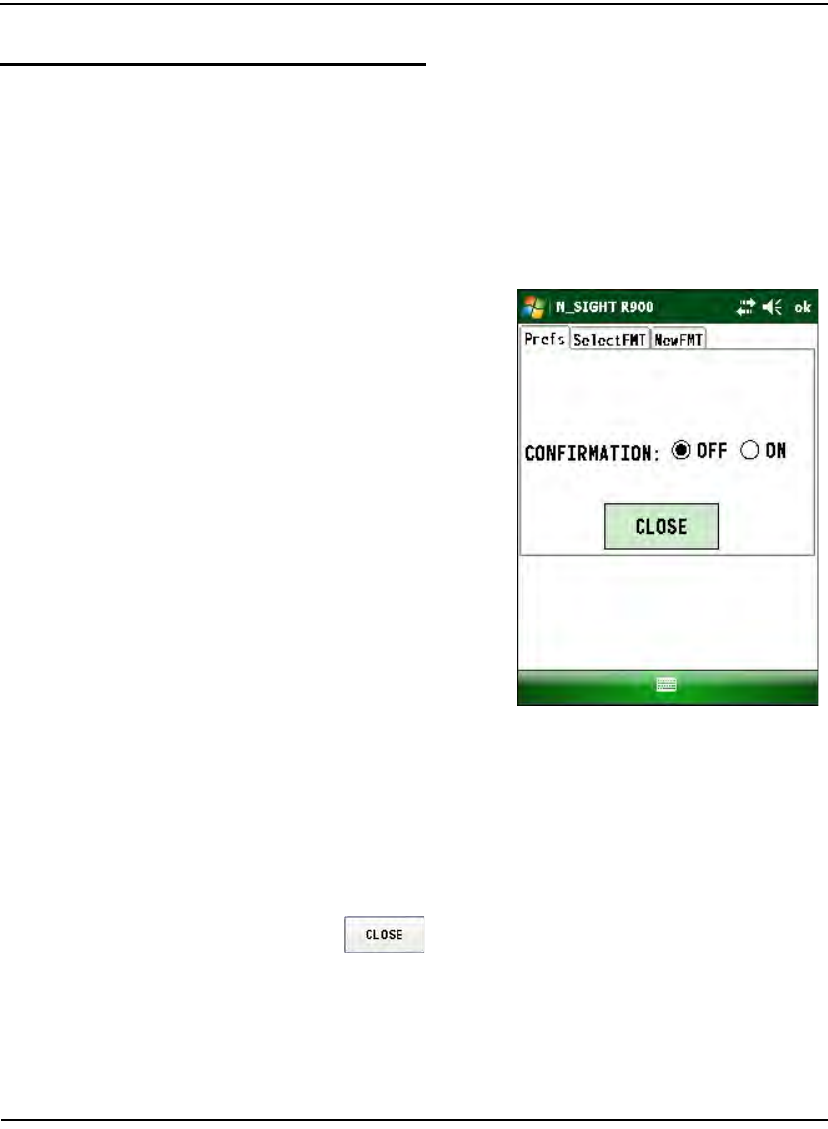
Using the Field Programmer
8-18 N_SIGHT R900 User’s Manual for the Neptune Handheld System
Programming the R900G Endpoint
You need to configure the gas functionality in the Field Programmer
software after the installation.
Configuring Gas
To program the R900G endpoint, use Neptune’s N_SIGHT R900 and
complete the following steps.
1Select Configure Gas
from the
Field Programmer
Menu. See “Starting
Field Programmer,” on
page 8-6.
2 When prompted, enter
your password. See
Figure 8.6 on page 8-7.
The Gas Preferences
screen appears as
illustrated in Figure 8.18.
Figure 8.18 Gas Meter Configuration Screen
3 Select one of the following for receiving a confirmation.
•OFF – to turn off some confirmation dialogs for actions.
•ON – to allow all confirmation dialogs for actions.
4 Touch to return to the Field Programmer Menu.
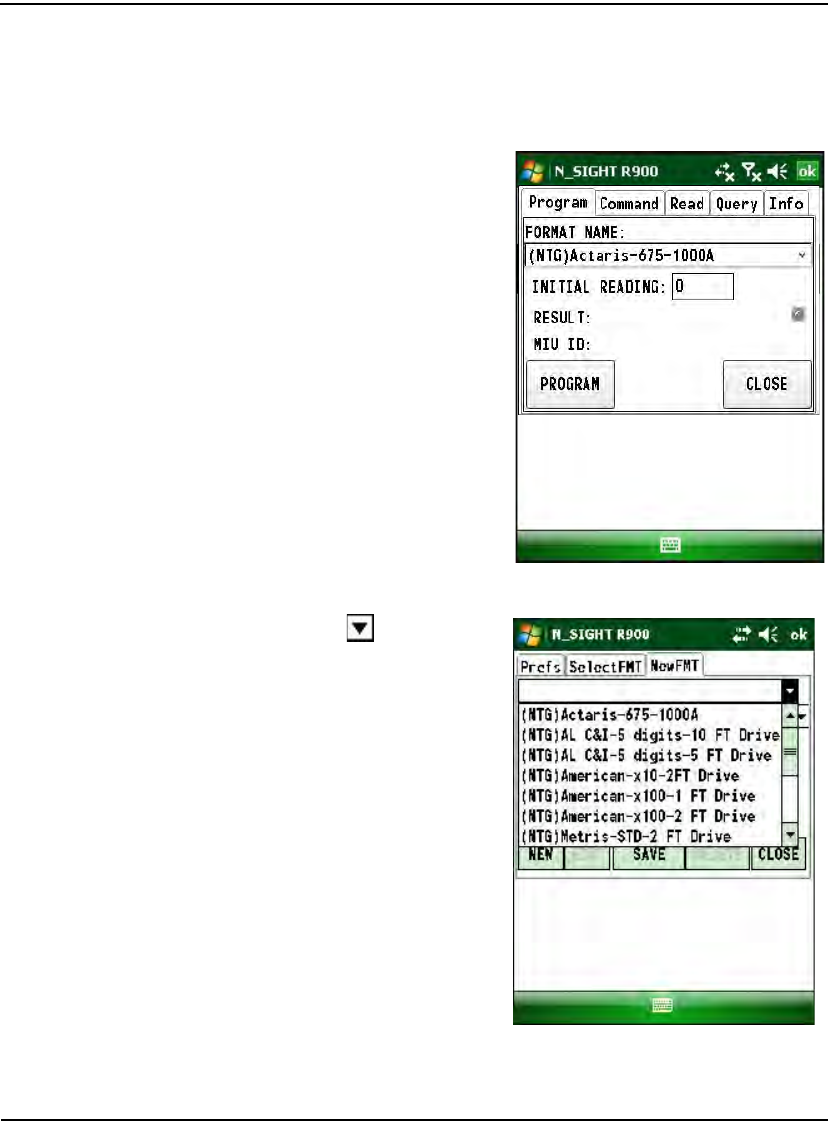
Using the Field Programmer
N_SIGHT R900 User’s Manual for the Neptune Handheld System 8-19
Collecting the Initial Reading
To use the Field Programmer for R900G endpoints, complete the
following steps.
1Select Program Gas
from the
Field Programmer
Menu.
The Program Gas screen
appears as illustrated in
Figure 8.19.
Figure 8.19 Gas Program Screen
2 Touch for Format
Name.
A selection list similar to
Figure 8.20 appears.
Figure 8.20 Format Name Selection List
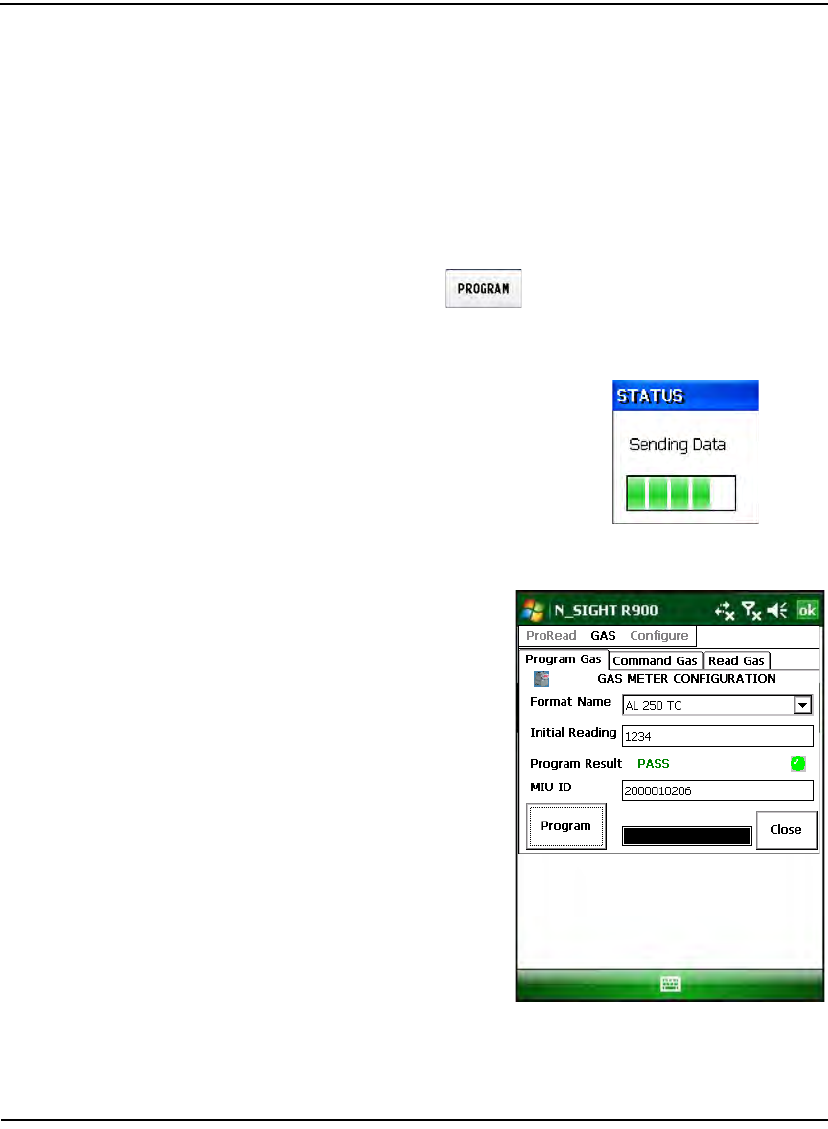
Using the Field Programmer
8-20 N_SIGHT R900 User’s Manual for the Neptune Handheld System
3 Touch or click the format you want and press Enter.
4 For Initial Reading, type a value.
5 Align the IR LED to Gas Programming post, and do one of the fol-
lowing to program gas:
• Press the program button on the mouse
• Press Enter.
• Touch or click .
(This button can only be used for programming; it cannot be
used for Read or Query.)
The Program Result area of the
screen displays that it is
Confirming Data, and a
progress bar at the bottom of
the screen shows you the
progress. See Figure 8.21.
Figure 8.21 Program Result – Sending Data
An audible tone signals
the Program Result.
•PASS
•FAIL
The MIU ID displays the
ID or serial number of the
MIU. See Figure 8.22.
Figure 8.22 Program Result – Pass Screen
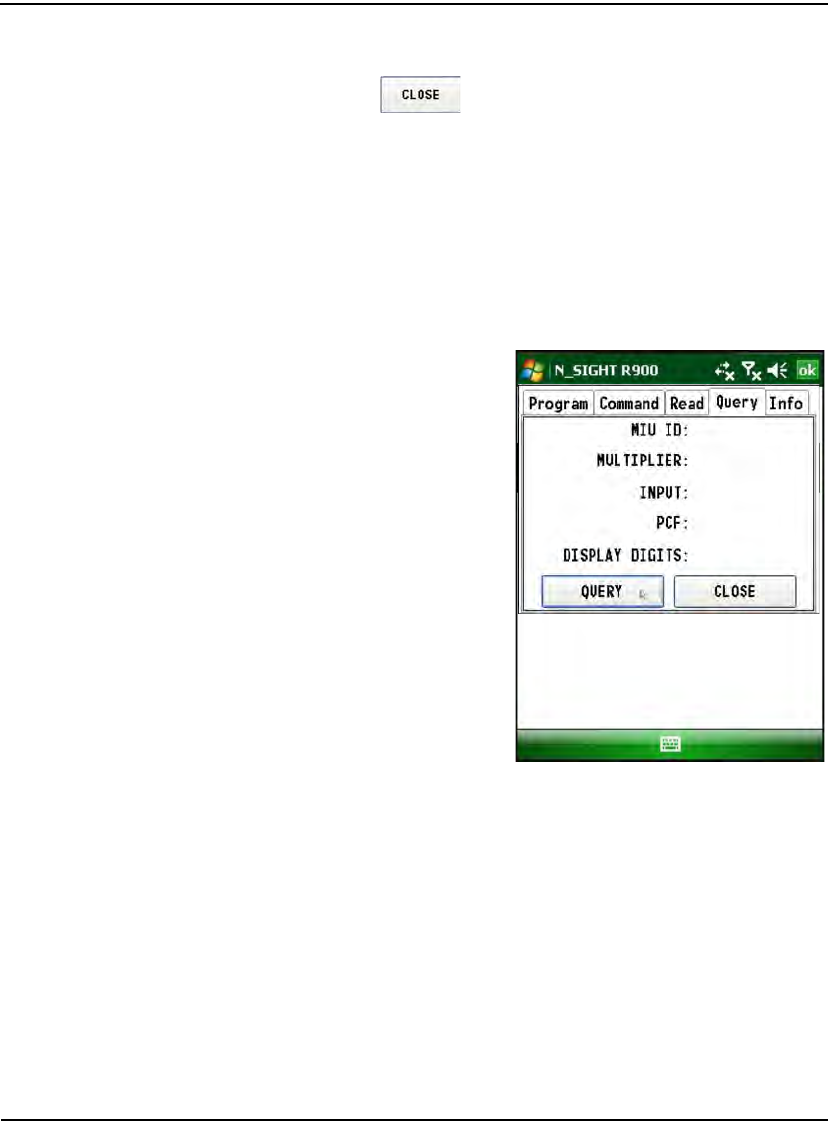
Using the Field Programmer
N_SIGHT R900 User’s Manual for the Neptune Handheld System 8-21
6 You can program another gas register by repeating steps 1 through
5, or touch to return to the main screen.
Querying the R900G Endpoint
Use the query function to check the current configuration of the R900G.
Perform a query after you program the endpoint, or anytime you want to
verify that the correct parameters are programmed in the unit.
To query an R900G endpoint, place the mouse on the R900G endpoint
and complete the following steps.
1Select Program Gas
from the
Field Programmer
Menu.
2 Select the Query tab.
The Gas Query screen
appears. See Figure 8.23.
Figure 8.23 Gas Query Screen
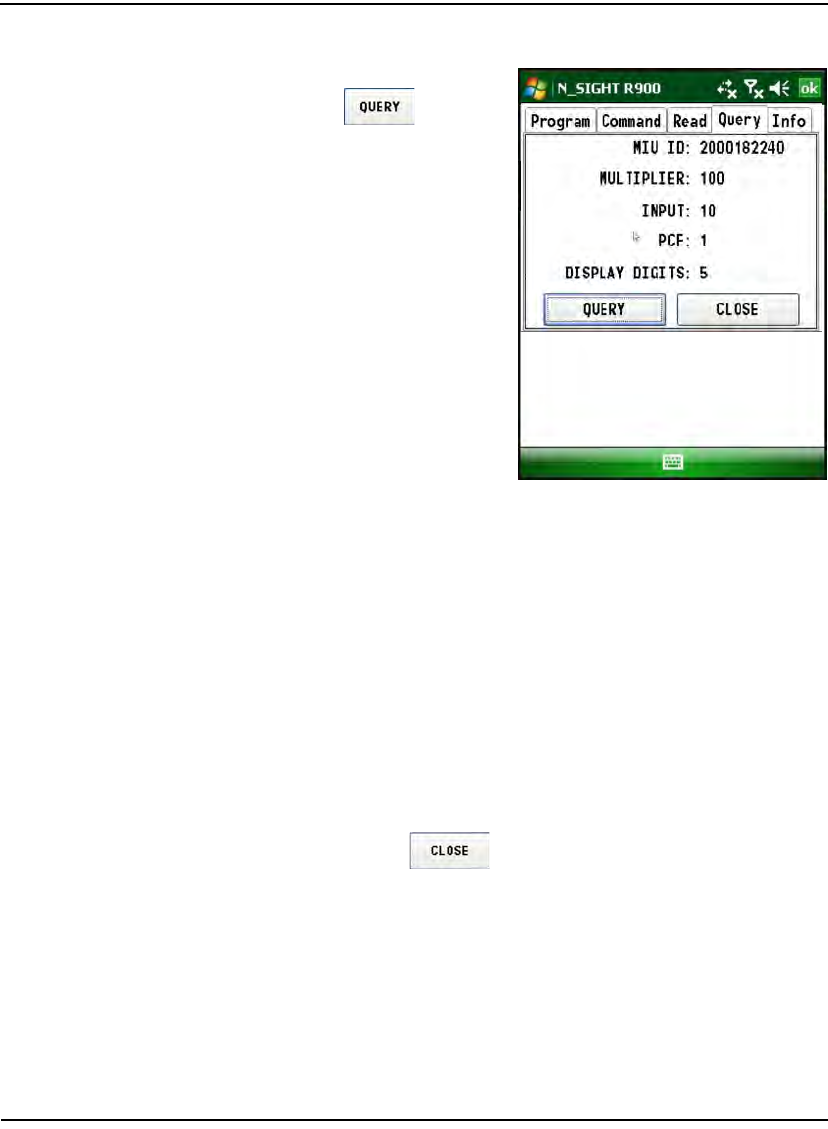
Using the Field Programmer
8-22 N_SIGHT R900 User’s Manual for the Neptune Handheld System
3 Touch .
The query results appear
similar to that of Figure
8.24.
Figure 8.24 Gas Query Results
The query results should confirm that the R900G endpoint is
programmed correctly.
4 Repeat steps 1 through 3 to query another endpoint or choose one
of the following:.
• Touch or click Read to take a reading.
• Touch or click Program to program the register.
• Touch or click Command to do the following:
- Place the R900G endpoint in Sleep mode.
- Refresh the data for the R900G endpoint.
- Wake up the R900G endpoint from sleep mode.
5 Touch or click to close the Gas Query tab return to the
main screen.
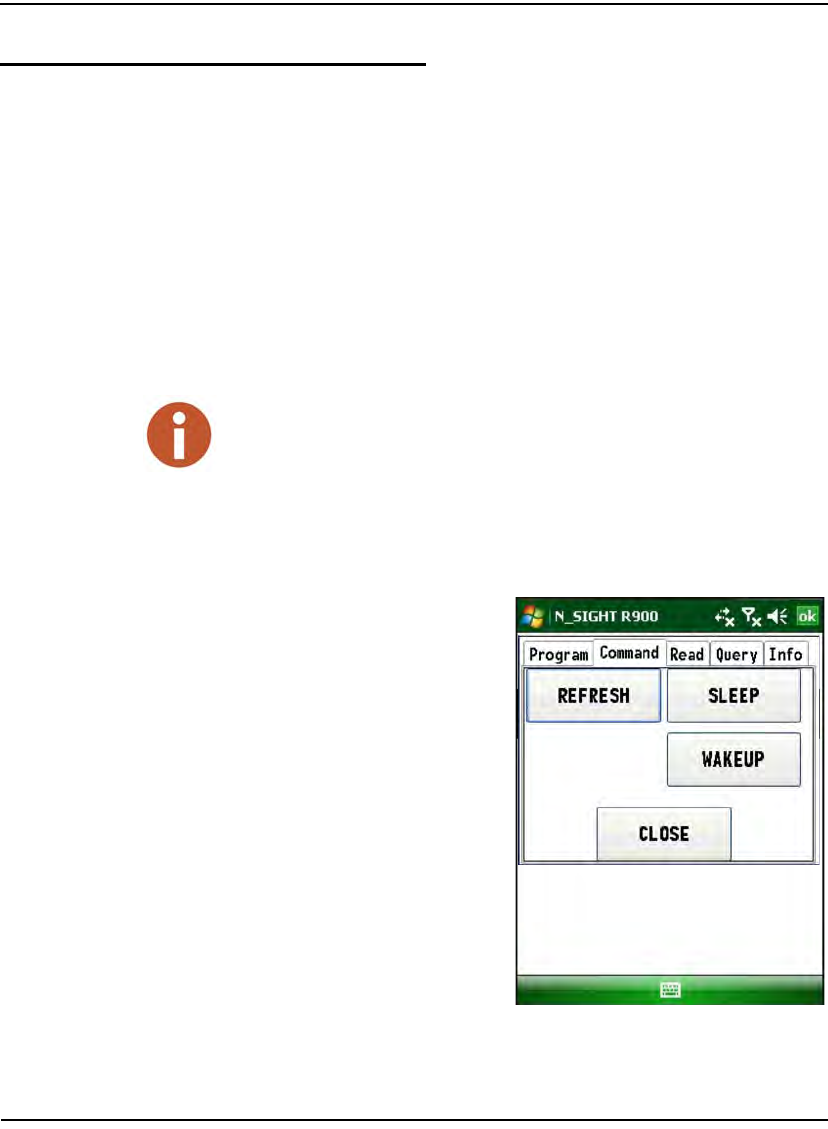
Using the Field Programmer
N_SIGHT R900 User’s Manual for the Neptune Handheld System 8-23
Using Command Gas
The Command Gas tab allows you to perform the following functions at
any time you are using the Field Programmer for gas functionality.
•Refresh the data for the R900G endpoint.
• Place the R900G endpoint in Sleep mode.
•Wake up the R900G endpoint from sleep mode.
•Close the Program Gas screen and return to the start screen.
To use Command Gas, complete the following instructions.
1 Start the Neptune Field Programmer software; refer to “Starting
Field Programmer,” on page 8-6.
2Select Program Gas
from the
Field Programmer
Menu.
3 Select Command.
The Command Gas
screen appears as
illustrated in Figure 8.25.
Figure 8.25 Command Gas Screen
In order to perform these commands, align the mouse with the unit.
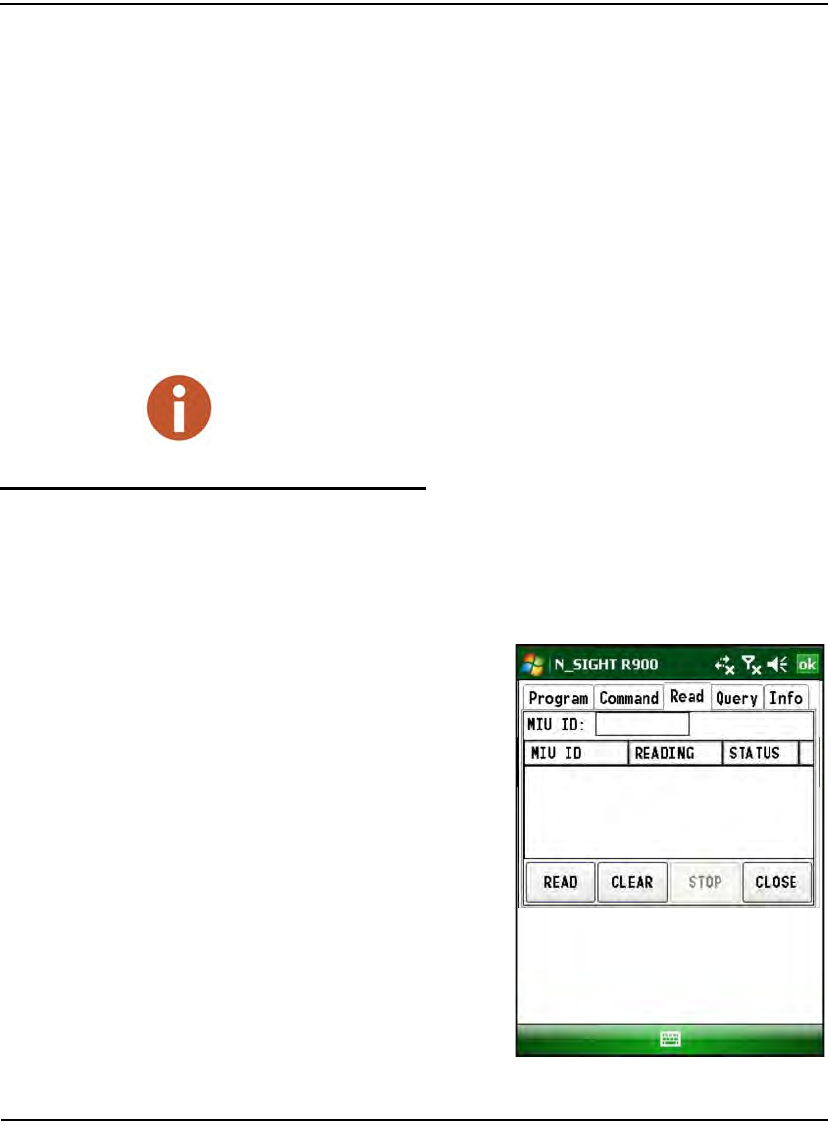
Using the Field Programmer
8-24 N_SIGHT R900 User’s Manual for the Neptune Handheld System
4 Do one of the following:
• Touch or click Refresh to force the R900G to transmit the
most current reading.
• Touch or click Sleep to place the R900G endpoint in sleep
mode to be used for shipping.
• Touch or click Wakeup to activate the R900G endpoint from
sleep mode.
•Click Close to exit the Program Gas screen and return to the
start screen.
Reading the R900G Endpoint Register
The Field Programmer is designed to be used as a programming and
troubleshooting tool rather than a reading device. However, the
Field Programmer is capable of collecting readings.
To read a gas register, com-
plete the following steps.
1 Select GAS from the
Neptune Programmer
System start screen.
2 Select the Read Gas tab.
The Gas Read screen
appears. See Figure 8.26.
Figure 8.26 Gas Read Screen
Any time you are using the Field Programmer gas program you can use the
functions on the Command Gas screen.
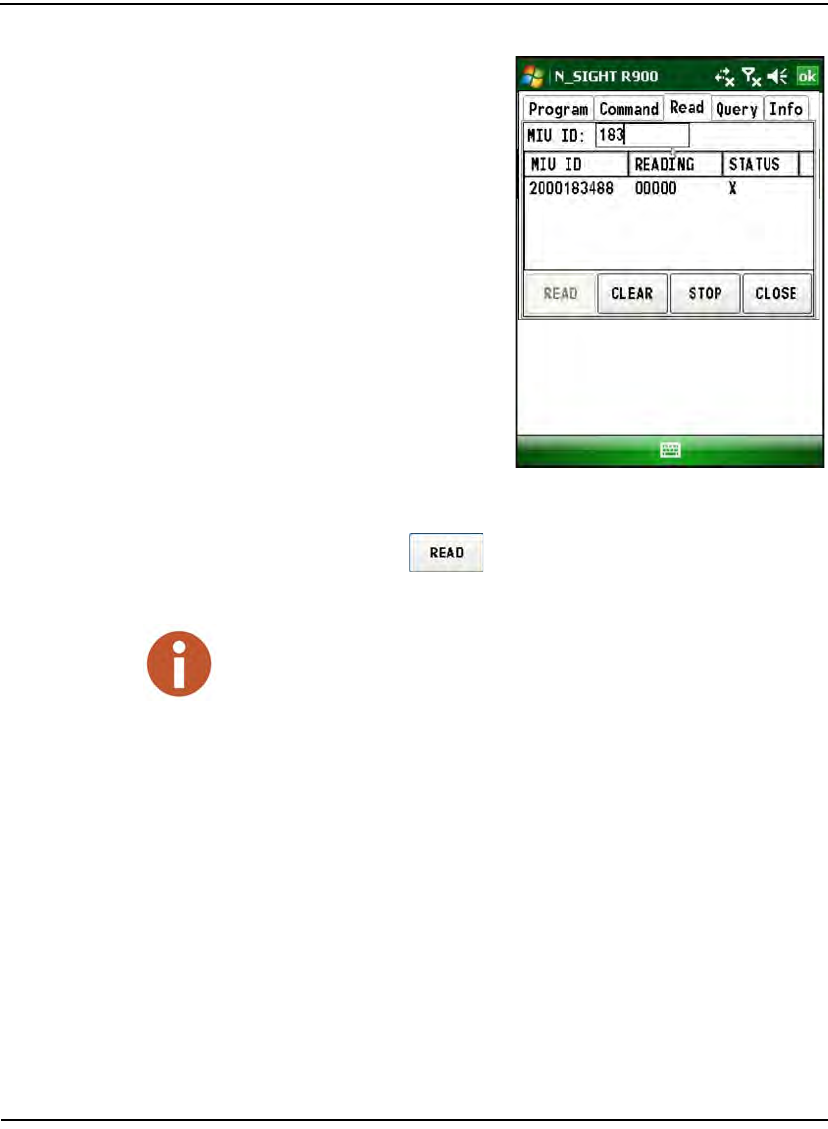
Using the Field Programmer
N_SIGHT R900 User’s Manual for the Neptune Handheld System 8-25
3Enter the MIU ID to read
a specific unit.
Leaving the MIU ID
blank allows you to
received all readings in a
range.
Figure 8.27 Gas Reading Result Screen
4 Touch or click on the Field Programmer to collect a read-
ing.
5 Press Clear to clear the reading and repeat steps 1 through 4 to read
another MIU.
Viewing Software and Firmware Information
It is important to know which version of the Field Programmer software
you are using when you contact Neptune Customer Support. To identify
the version of Field Programmer software or the firmware version of the
Field Programmer mouse you are using, complete the following steps.
If an error message appears during a read attempt, it is most likely due to
improper format information.

Using the Field Programmer
8-26 N_SIGHT R900 User’s Manual for the Neptune Handheld System
1Select Program Gas
from the
Field Programmer
menu.
2 Select the Info tab.
The software and
firmware information
appears. See Figure
8.28.
Figure 8.28 Gas Software and Firmware Information
3 Touch or click to return to the Field Programmer menu.
Networking Two Registers
The term Networking is used to refer to the process of connecting
multiple registers to a single receptacle.
Programming Registers
To network two registers, you must first program a primary register and
a secondary register.
Programming the Network Primary Register
To program the network primary register, complete the following steps.
You cannot program ProRead registers while connected together in a
network. You must program each register separately prior to making the
network connections.

Using the Field Programmer
N_SIGHT R900 User’s Manual for the Neptune Handheld System 8-27
1 Select the appropriate High Side programming format,
such as,
STD 8ID HIGH
2 Enter the following information.
• Dial Code
• User Characters
• ID Number
3 When you have properly entered all information, press PROG to
program the primary register.
Programming the Network Secondary Register
To program the network secondary register, complete the following
steps.
1 Select the appropriate Low Side programming format such as:
STD 8ID LOW
2 Enter the following information.
• Dial Code
• User Characters
• ID Number
3 When you have properly entered all information, press PROG to
program the secondary register.
4 Repeat for any additional secondary registers.
Network Wiring
After you properly program the registers for networking, they can then
be connected to the receptacle. Be sure to use weatherproof crimp
connectors for all wiring splices in order to prevent corrosion and other
moisture-related problems. Also, observe proper polarity when wiring
the registers, so that you interconnect all red terminals and interconnect
all black terminals.

Using the Field Programmer
8-28 N_SIGHT R900 User’s Manual for the Neptune Handheld System
Wiring the Registers
Refer to the following Neptune guides for complete instructions on
wiring the registers.
• E-Coder Quick Install Guide, Part Number 12563-001
• Encoder Quick Install Guide, Part Number 12572-001
Managing Formats
The Neptune Field Programmer allows you to manage formats for
programming ProRead registers and R900G endpoints.
Managing Formats for ProRead Registers
When you program a ProRead register, you can work with the format
you need. You can do the following:
• Set your preferences for the programming process.
• Select formats from the list of available formats supplied by
Neptune.
• Edit or create a new format that is added to the list of available
formats.
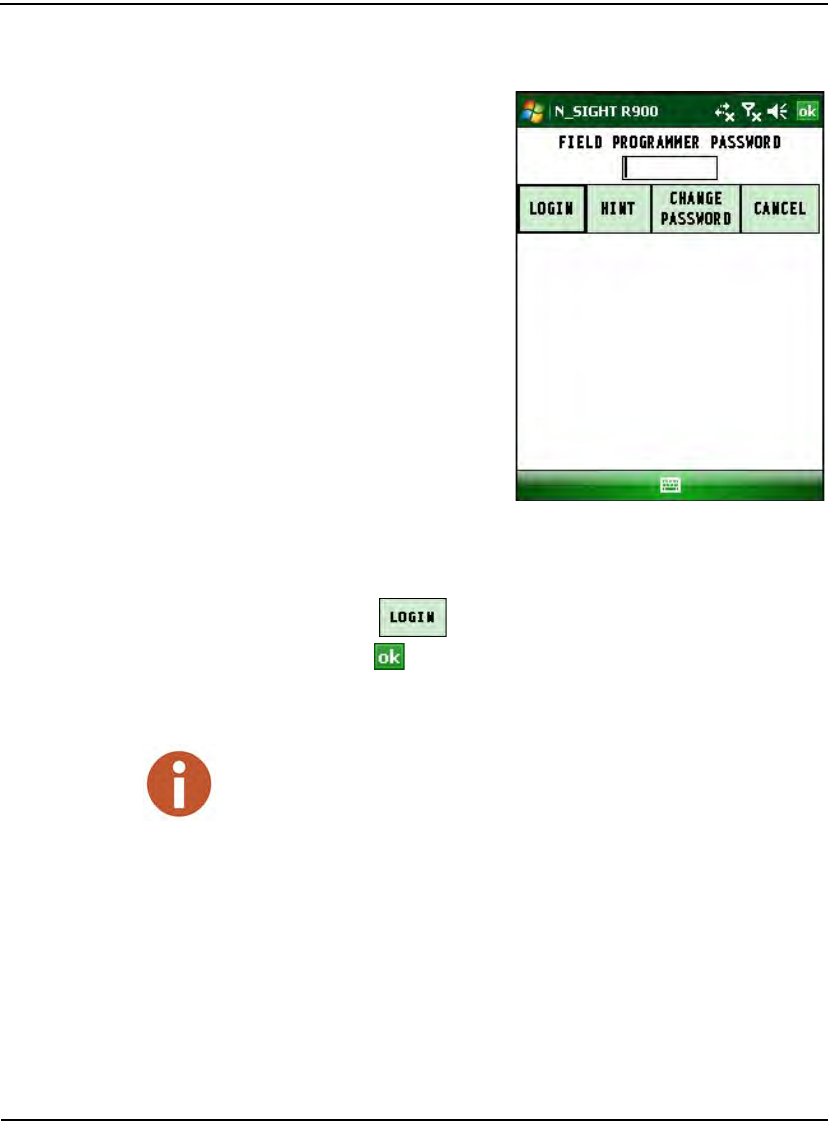
Using the Field Programmer
N_SIGHT R900 User’s Manual for the Neptune Handheld System 8-29
Selecting ProRead Preferences
To select preferences for
programming a ProRead
register, complete the
following steps.
1On the
Field Programmer
Menu, touch or click
Configure ProRead. See
Figure 8.29.
Figure 8.29 Field Programmer Menu
2 When the Field Programmer Password screen appears, type your
password and do one of the following.
• Touch .
• Click
•Press Enter.
On this screen, you can also change your password as described in
“Changing Your Password,” on page 8-8 or you can cancel logging
in to the system.
If you cannot remember your password, you can touch or click Hint to display
a clue.
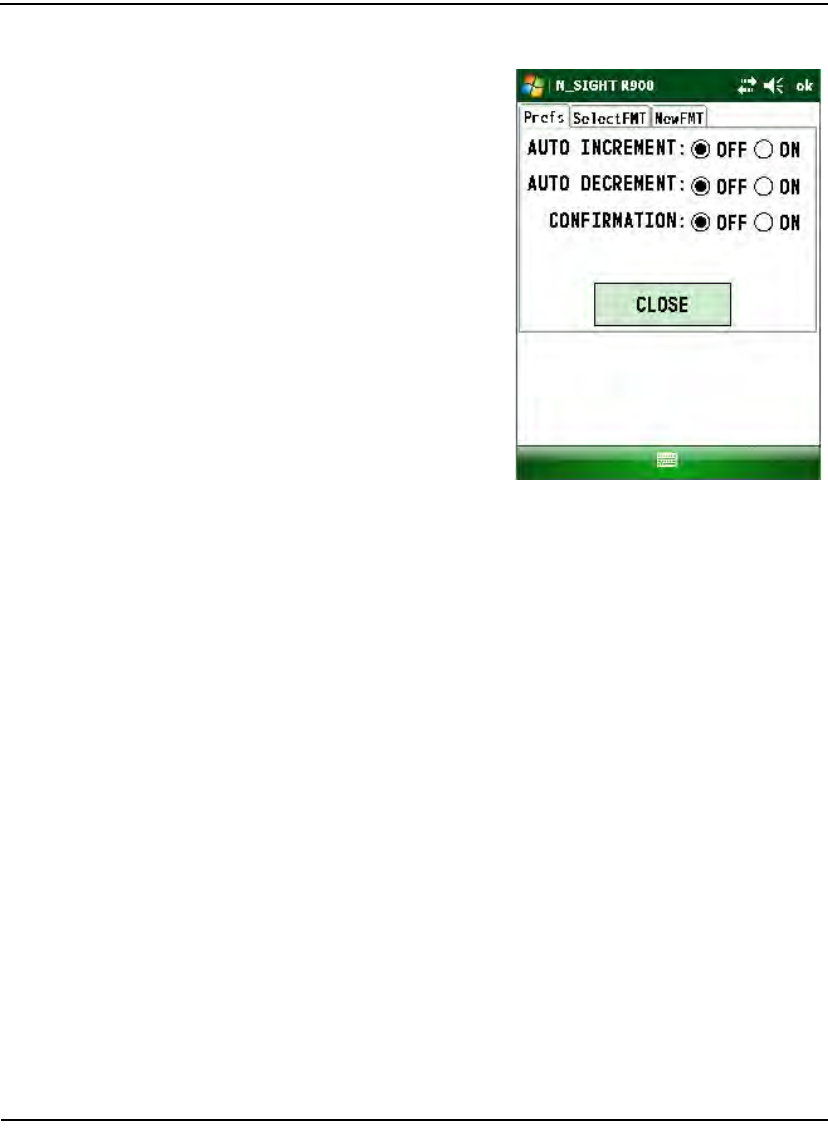
Using the Field Programmer
8-30 N_SIGHT R900 User’s Manual for the Neptune Handheld System
After entering your
password, the
Preferences screen
appears as illustrated in
Figure 8.30.
Figure 8.30 ProRead Preferences Screen
On this screen, select one for each of the following.
3 Do one of the following.
• Touch or click SelectFMT to select a format that is already
available for the Field Programmer.
• Touch or click NewFMT to create a new format and add it to
the list of available formats.
• Touch or click Close to close the ProRead configuration and
return to the previous screen.
Auto Increment Allows the system to automatically increment
the ID numbering by one digit.
Auto Decrement Allows the system to automatically decrement
the ID numbering by one digit.
Confirmation Allows additional dialog to confirm the action
to be performed.
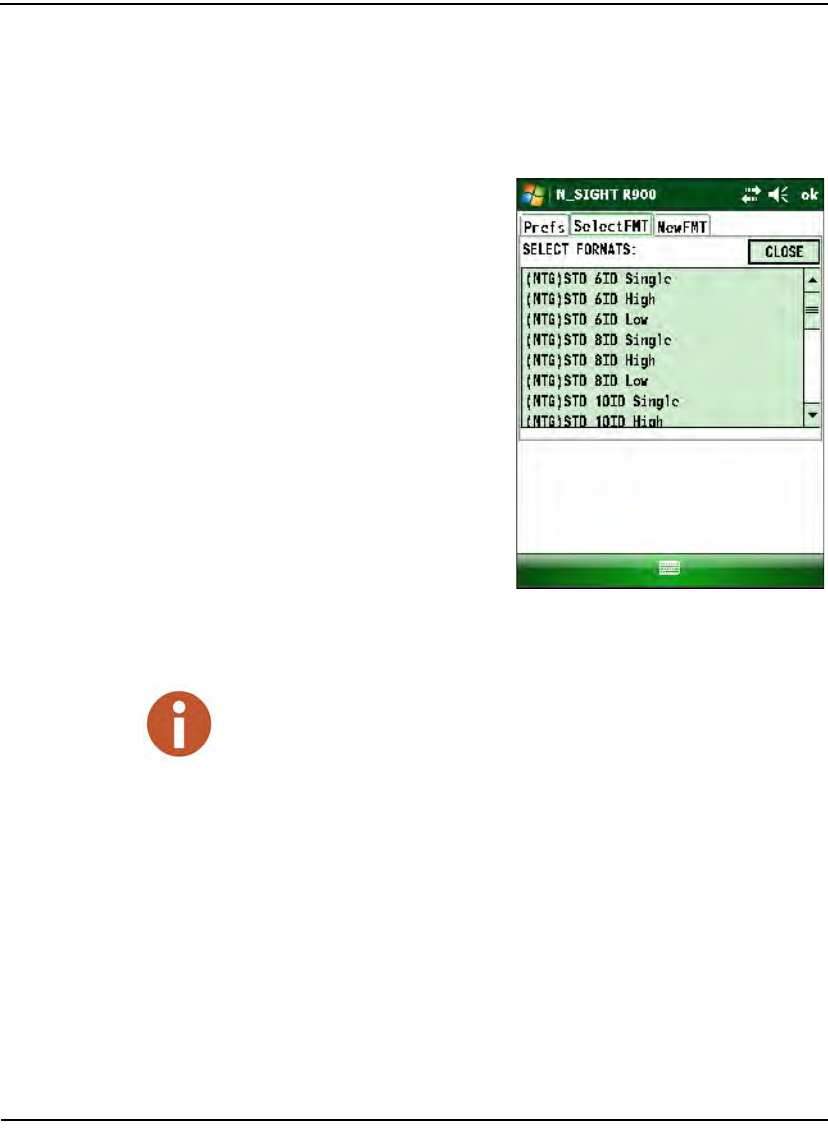
Using the Field Programmer
N_SIGHT R900 User’s Manual for the Neptune Handheld System 8-31
Selecting a ProRead Format
Selecting formats allows you to see a list of only the formats used by
your utility. This eliminates unused formats which makes it easier to
select formats and reduce errors.
To select the formats for
programming a ProRead
register, complete the
following steps.
1 Touch or click
SelectFMT to view the
available formats used for
programming ProRead
registers. See Figure 8.31.
Figure 8.31 Select Formats Screen
Most user-created formats are simple modifications to the Neptune standard
formats.
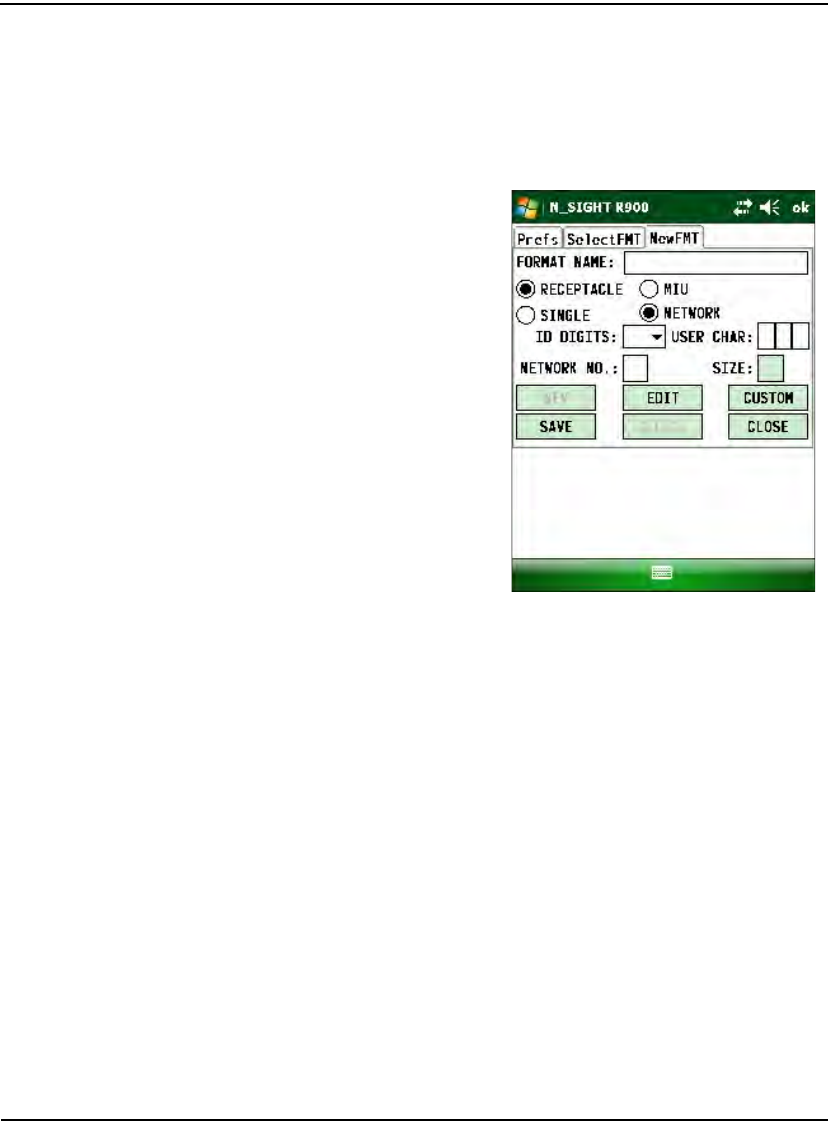
Using the Field Programmer
8-32 N_SIGHT R900 User’s Manual for the Neptune Handheld System
Editing a ProRead Format
To make changes to an existing format, complete the following steps.
1On the Field Programmer Menu, touch or click Configure Pro-
Read.
2Select NewFMT.
The New Format screen
appears as illustrated in
Figure 8.32.
Figure 8.32 ProRead New Format Screen
The following information appears.
•Available Formats display at the top of the screen (both stan-
dard and custom).
•User Selected shows the formats already selected.
3 On this screen, do any the following:
Add Allows you to select from the Available
Formats, and touch or click Add to place it in
the User Selected list.
Remove Allows you to select a format from the User
Selected list and touch or click Remove to
remove it.
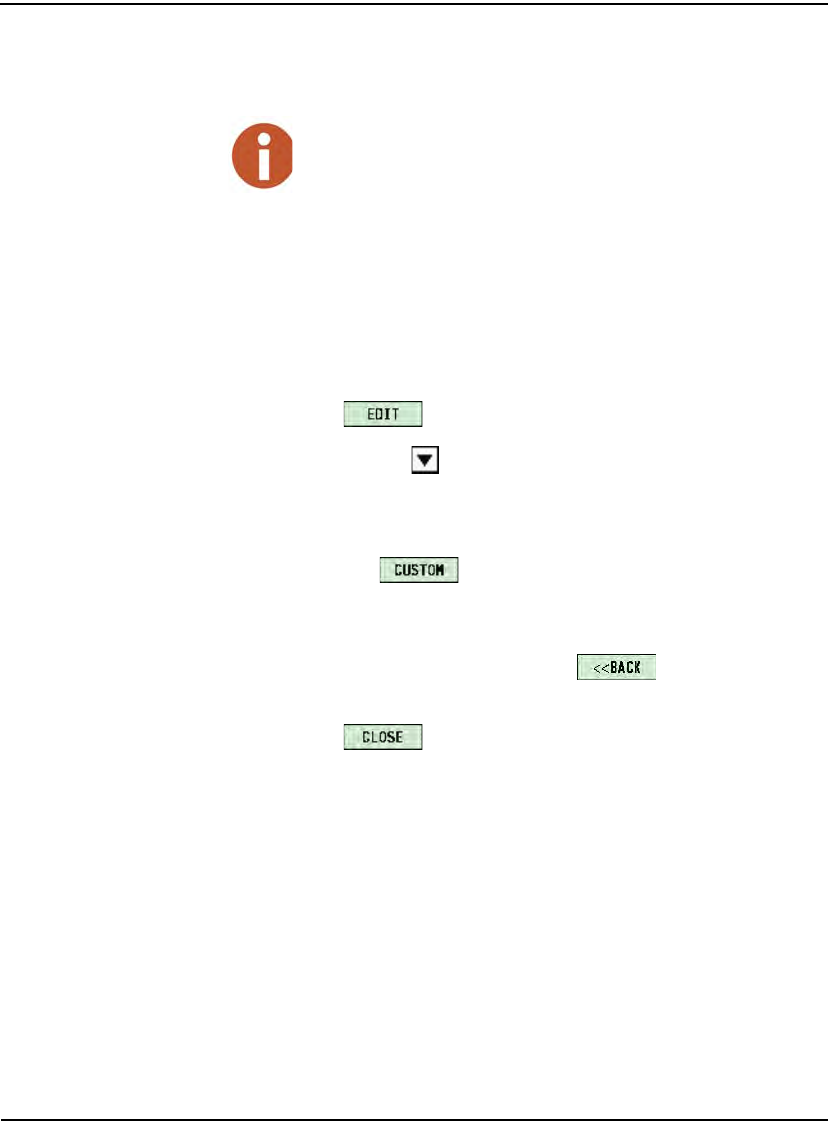
Using the Field Programmer
N_SIGHT R900 User’s Manual for the Neptune Handheld System 8-33
4 Touch .
5 Touch or click to select the format to edit from the list of avail-
able in Format Name.
6 Make any necessary changes on this screen, if applicable.
• Touch to make changes to Stop Bits, Clock Divisor,
or Tokens. See “Creating a New ProRead Format,” on page
8-35. (These changes are rarely needed.)
• From the Custom screen, touch twice to return to the
NewFMT screen.
7 Touch to save the changes for the new format created.
A confirmation dialog appears asking you if you want to save the
changes to the present format.
8 Touch or click Yes to save the format or No to cancel.
9 If you selected a standard format and made changes to it, you must
save it as a new format. Touch Save As.
A dialog appears asking you to enter a different name for the
format.
10 Touch Close, and then type the name of the new format in Format
Name.
Although you can remove a format from the User Selected list, it
remains in the Available Formats list.
Close Allows you to close the ProRead
Configuration and return to the previous
screen.
NewFMT Allows you to edit or create a ProRead
Format.
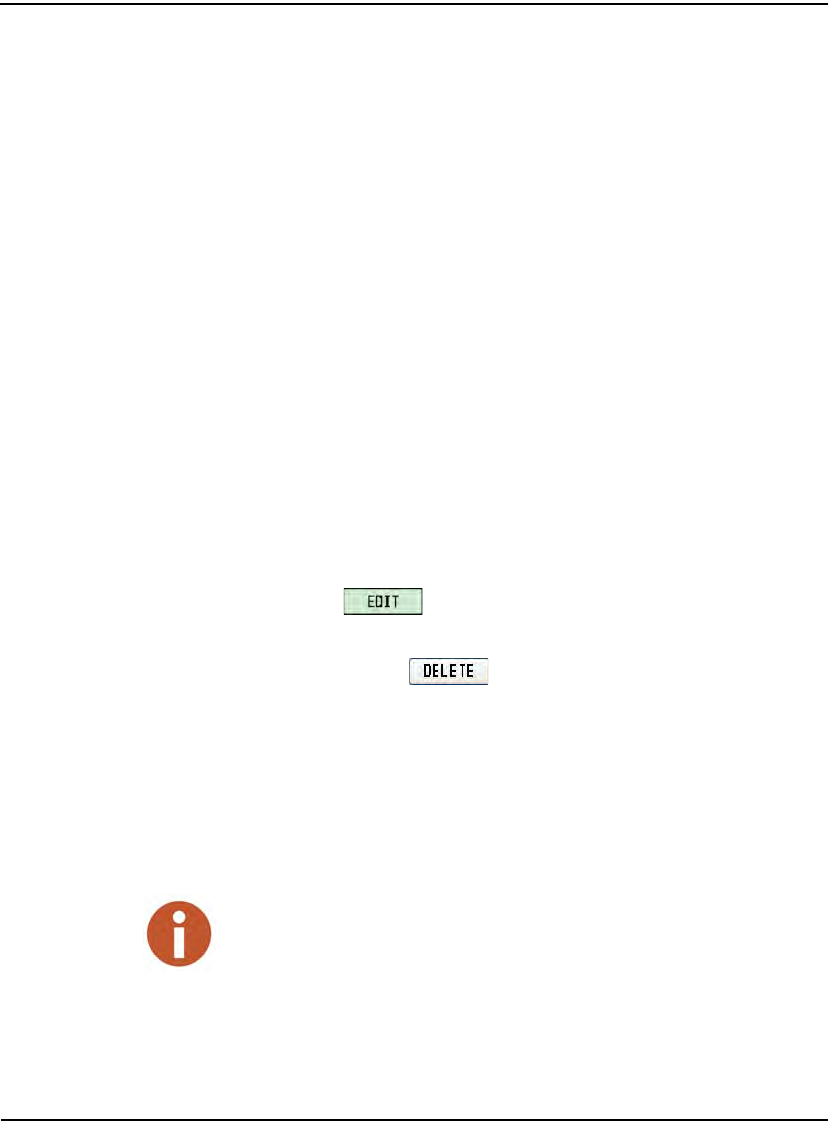
Using the Field Programmer
8-34 N_SIGHT R900 User’s Manual for the Neptune Handheld System
Using the New ProRead Format
To use the newly created format to program ProRead registers, complete
the following steps.
1 Select the SelectFMT tab.
2 Complete the steps outlined in “Selecting a ProRead Format,” on
page 8-31.
3 Refer to “Programming the ProRead,” on page 8-9 to program,
query, or read the ProRead register using the newly created format.
Deleting a Format for ProRead Registers
To delete a user-defined format used for programming ProRead
registers, complete the following steps.
1 Log in to the Field Programmer by completing steps 1 through 3 in
“Selecting ProRead Preferences,” beginning on page 8-29.
2 Select NewFMT.
The New Format screen appears as illustrated in Figure 8.32 on
page 8-32.
3 Touch since the NewFMT screen now defaults to New,
then shift the numbers to compensate.
4 Touch or click to delete the format from the list of avail-
able formats.
A confirmation dialog similar to the following appears asking if
you are sure you want to delete this file format.
5 Touch or click Yes to save the format or No to cancel.
The format is no longer available for selection on the
Field Programmer.
You cannot delete a standard format from the list of available formats.
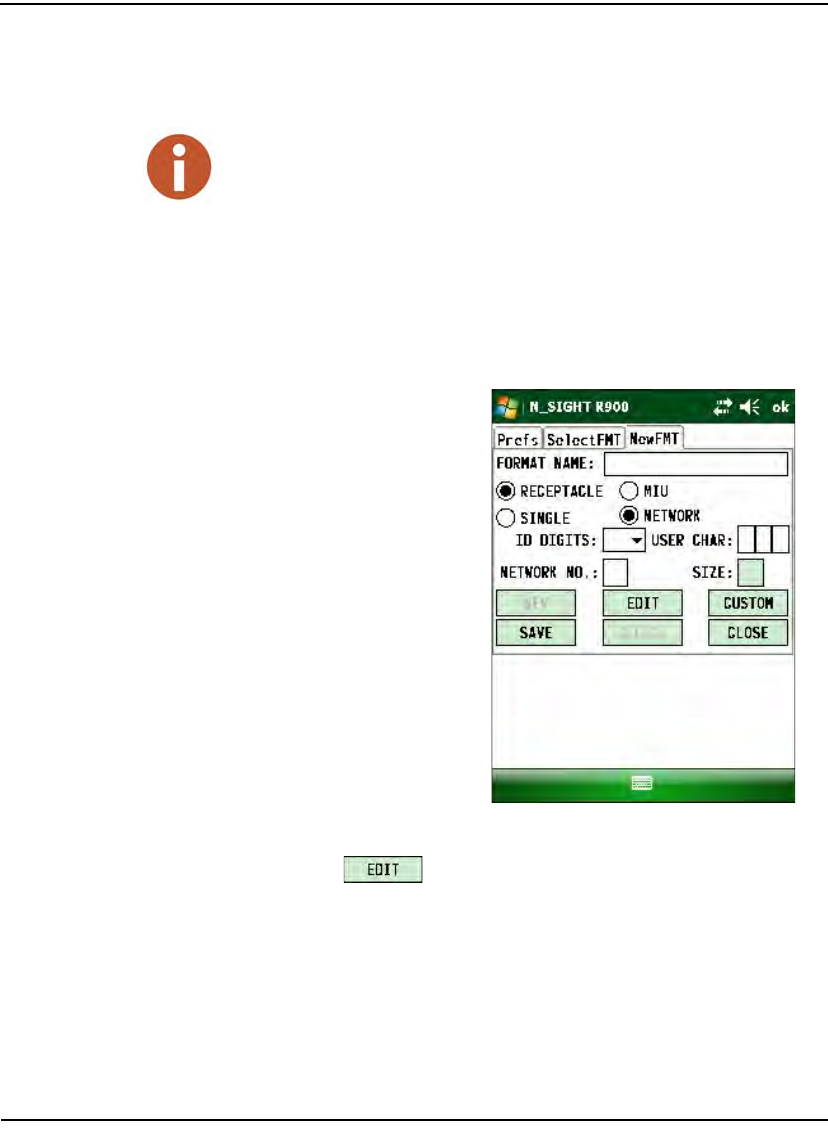
Using the Field Programmer
N_SIGHT R900 User’s Manual for the Neptune Handheld System 8-35
Creating a New ProRead Format
To create a new format and have it appear in the Available Formats list,
complete the following steps.
1On the Field Programmer Menu, touch or click Configure Pro-
Read.
2Select NewFMT.
The New Format
screen appears as
illustrated in Figure
8.33.
Figure 8.33 Default ProRead New Format Screen
3 Touch since the NewFMT screen now defaults to it.
There are very few cases where a new format is required. Creating a new
format requires detailed knowledge of the ProRead register and Neptune
data collectors. You should first see if you can edit an existing format before
creating a new format from scratch.
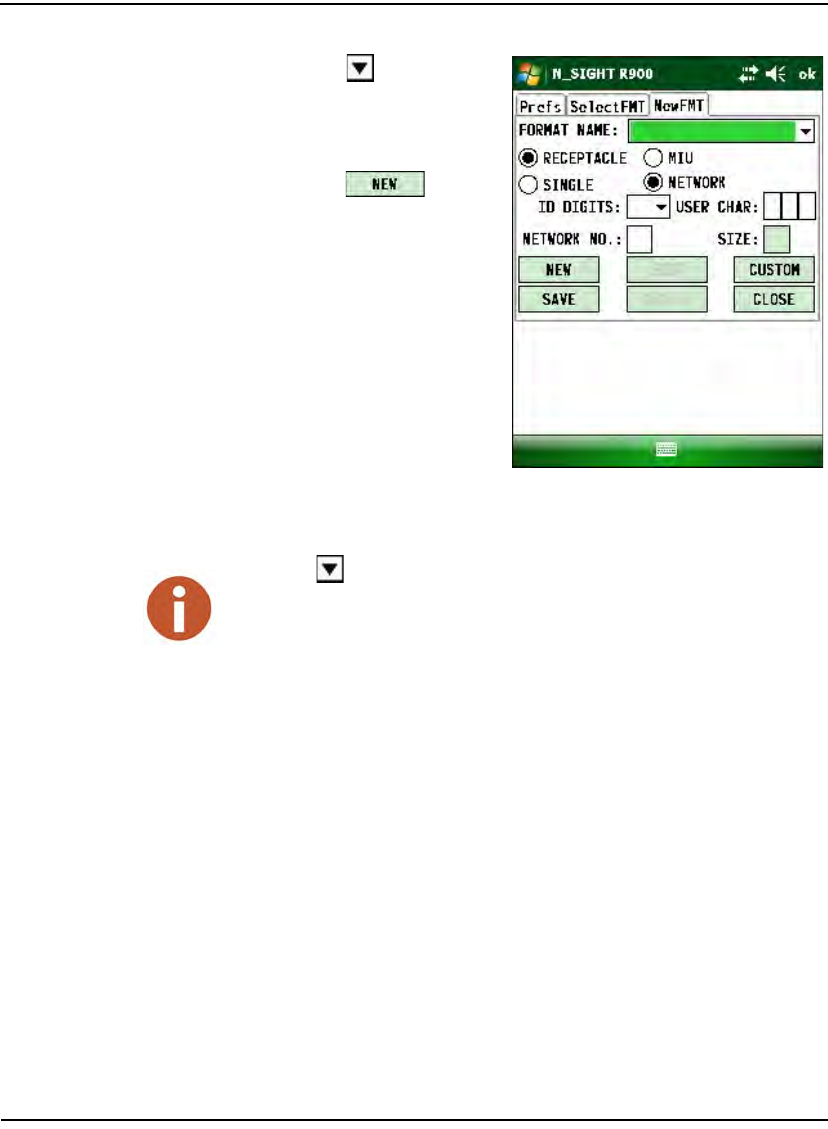
Using the Field Programmer
8-36 N_SIGHT R900 User’s Manual for the Neptune Handheld System
4Touch to select the
format to edit from the
list of available in For-
mat Name.
5 Touch .
See Figure 8.34.
Figure 8.34 New Button Available
6 Type a name that identifies the type of format you are creating in
Format Name. See “Editing a ProRead Format,” on page 8-32.
Select one of the following:
• Receptacle
•MIU
7 Select one of the following:
• Single
•Network
Touch to view a format from the list of available formats. The screen then
displays all the values associated with that format. You can select to copy this
format by clicking or touching Edit. To save the copied format as a new
format, touch or click Save As and give the format a new name.
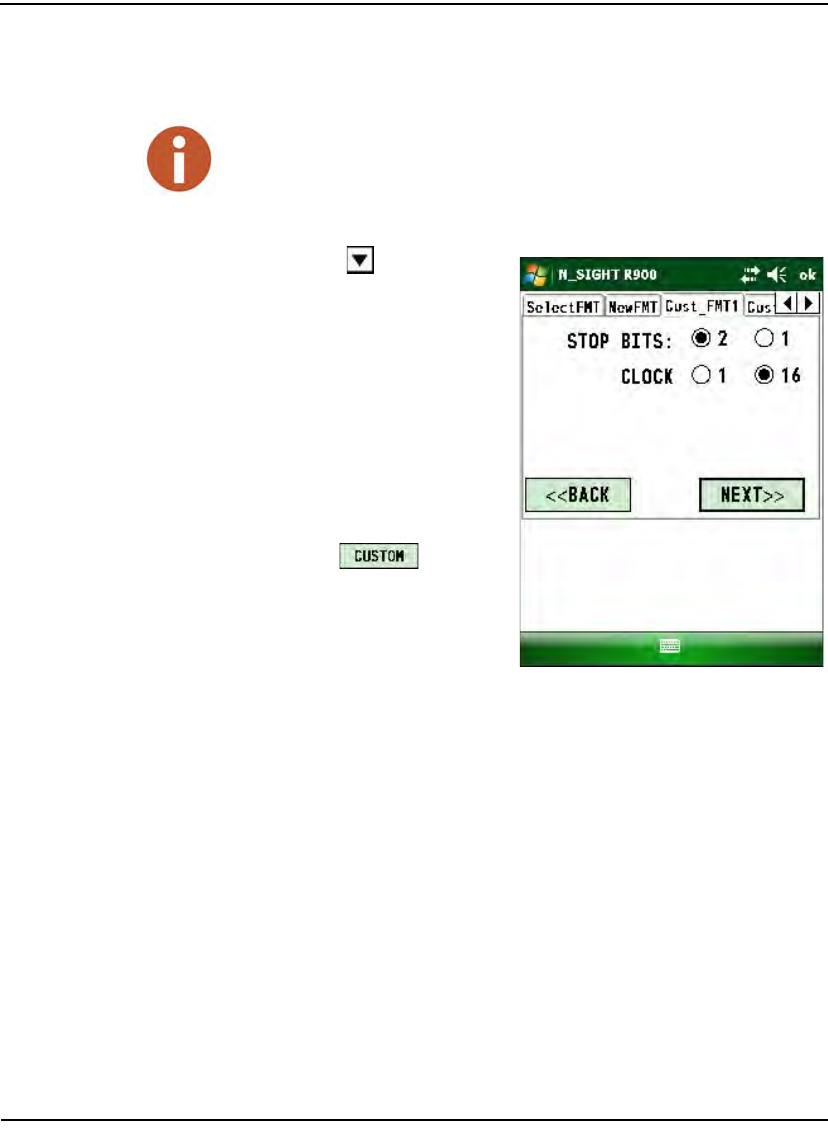
Using the Field Programmer
N_SIGHT R900 User’s Manual for the Neptune Handheld System 8-37
8Touch to select from
the list of available values
of 1 to 10 for ID Digits.
9 Type three alphanumeric
character for User Char.
10 Type the number for the
Network No.
11 Enter the size, if applica-
ble.
12 On the NewFMT screen,
select .
The Cus_FMT1 screen
appears as illustrated in
Figure 8.35.
Figure 8.35 Custom Format 1 Screen
Using the Custom Format Screens
Complete the following steps to use the custom format screens.
If Network is selected, you can enter the Network No. and Size. If the
network number is less than 99, the network size defaults to 0 and cannot be
edited. You can only configure the network size when the network number is
99.
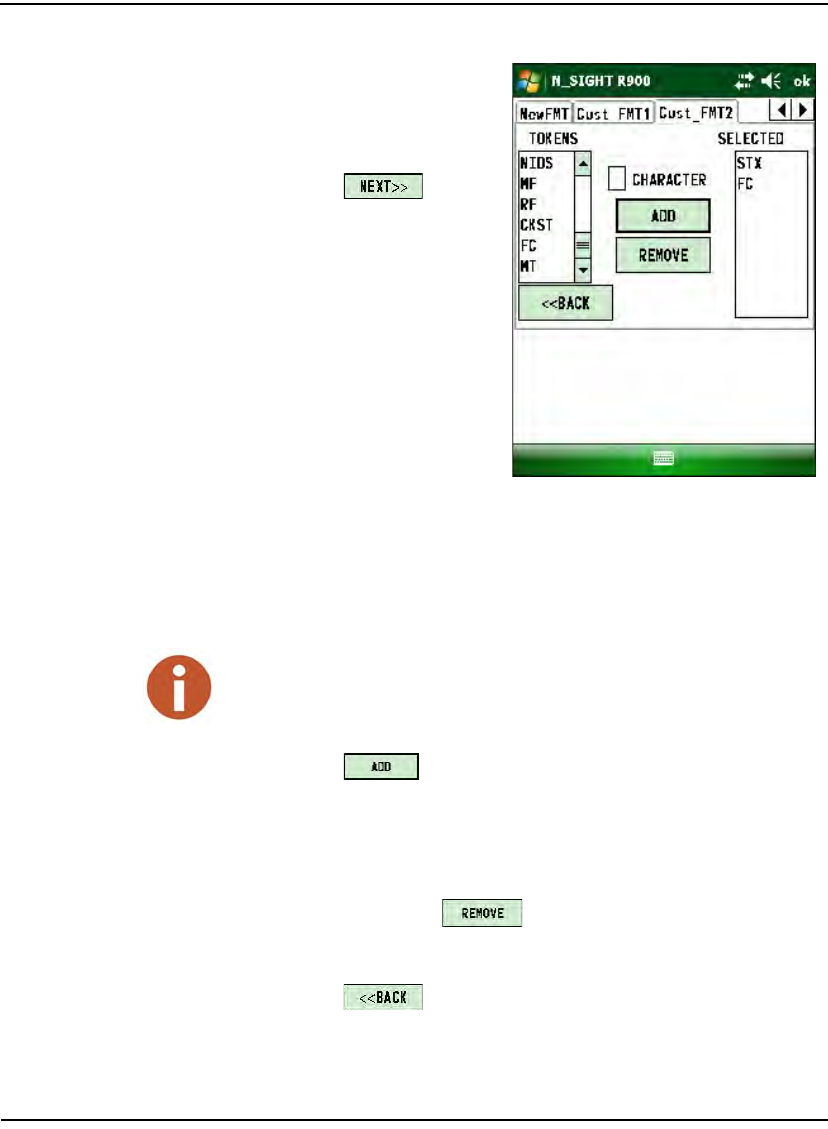
Using the Field Programmer
8-38 N_SIGHT R900 User’s Manual for the Neptune Handheld System
1Select 2 or 1 for Stop
Bits.
2 Select 1 or 16 for Clock
Divisor.
3 Touch or the
Cus_FMT2 tab.
The Cus_FMT2 screen
appears as illustrated in
Figure 8.36.
Figure 8.36 Custom Format 2 Screen
4 Type an alphanumeric character in Character, if applicable.
5 From the selection list of Tokens, touch the token you want to add
to the custom format.
6 Touch .
The token you selected now appears in the User Selected list.
7 Repeat steps 5 and 6 to add more characters and tokens.
8 If there is a character or token in the User Selected list that you no
longer need, touch .
The item is removed from the User Selected list.
9 Touch twice to return to the NewFMT screen.
For a list of tokens and their explanations, refer to Appendix B,Chapter ,
"Tokens List for Custom Format Screen" on page -1.

Using the Field Programmer
N_SIGHT R900 User’s Manual for the Neptune Handheld System 8-39
Saving the Custom ProRead Format
1 Touch or click to save the changes to the new format cre-
ated.
A confirmation dialog appears asking you to confirm the changes to
the present format.
2Click Yes to save the format, or No to cancel.
Creating Formats for R900G Endpoints
When you program an R900G endpoint, you have the flexibility to work
with the format you need by doing the following:
• Set your preferences for the type of endpoint you will be
programming.
• Select a format from the list of available formats supplied by
Neptune.
• Create a new format that is added to the list of available formats.
To select preferences for programming an R900G endpoint, complete
the following steps.
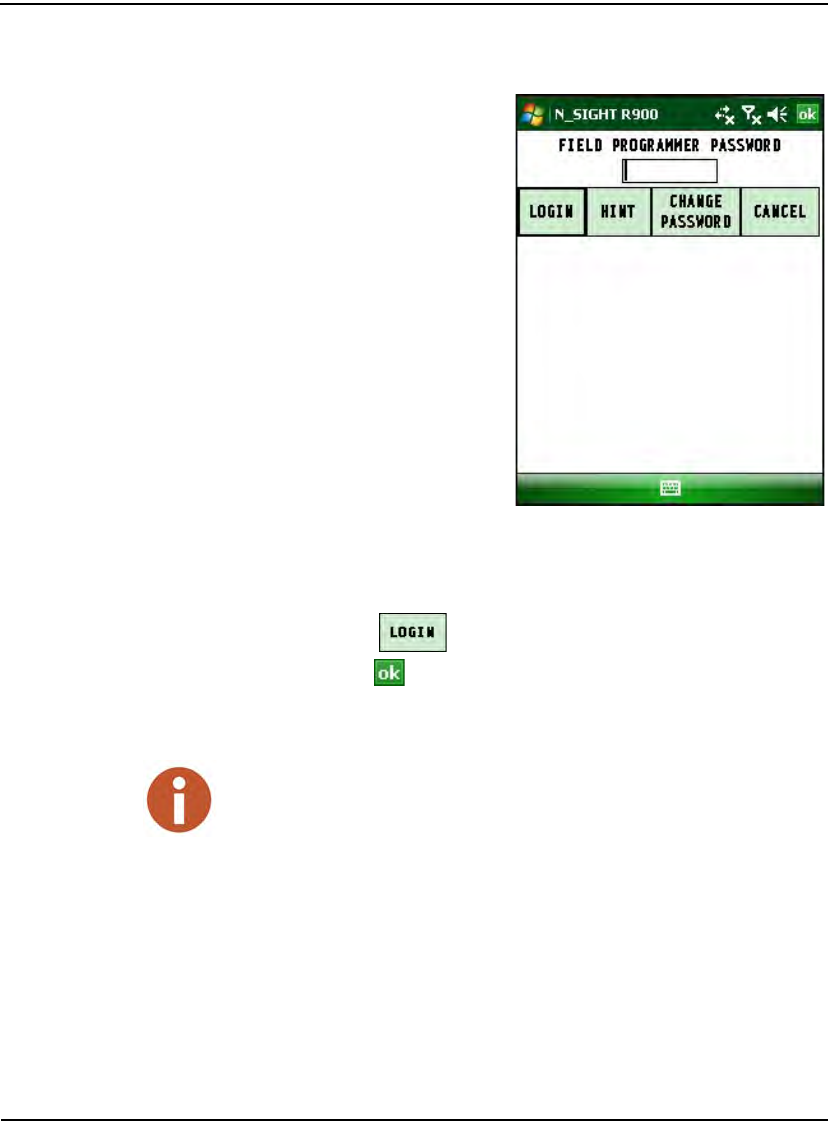
Using the Field Programmer
8-40 N_SIGHT R900 User’s Manual for the Neptune Handheld System
Configuring Gas
To select preferences for
programming a gas endpoint,
complete the following steps.
1On the
Field Programmer
Menu, touch or click
Configure Gas. See Fig-
ure 8.5 on page 8-7.
The Field Programmer
Password screen appears
as shown in Figure 8.37.
Figure 8.37 Configure Gas Password Screen
2On the Field Programmer Password screen, type your password
and do one of the following:
• Touch .
• Click
•Press Enter.
On this screen, you can also change your password as described in
“Changing Your Password,” on page 8-8 or you can cancel logging
in to the system
After entering your password, the Preferences screen appears as
illustrated in Figure 8.30.
3 Select your preferences as described in “Configuring Gas,” on page
8-18.
If you cannot remember your password, you can touch or click Hint to display
a clue.
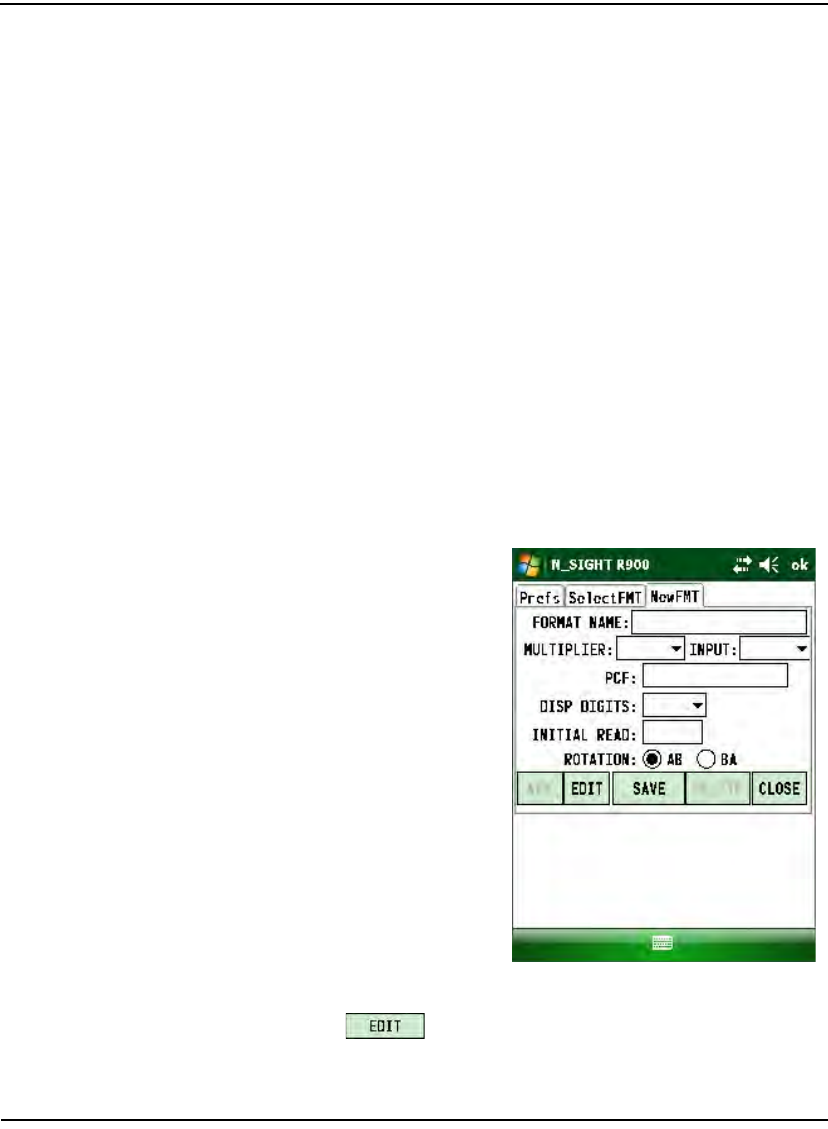
Using the Field Programmer
N_SIGHT R900 User’s Manual for the Neptune Handheld System 8-41
4 Do one of the following:
• Touch Close to close the gas configuration screen and return to
the previous screen.
• Touch SelectFMT to select a format that is already available
for the Field Programmer.
• Touch NewFMT to create a new format and add it to the list of
available formats.
Selecting a Gas Format
This feature allows an administrator to select formats that will be
available to field personnel for programming, as described in
“Programming the R900G Endpoint,” on page 8-18
To select a format for programming an R900G endpoint, complete the
following steps.
1 Select Configure Gas from the Field Programmer Menu. See
“Starting Field Programmer,” on page 7-4.
2When prompted, type
your password and press
Enter. See Figure 8.37
The Gas Preferences
screen appears as
illustrated in Figure 7.15.
3 Touch NewFMT.
The New Format screen
appears as illustrated in
Figure 8.38.
Figure 8.38 Gas New Format Screen
4 Touch .
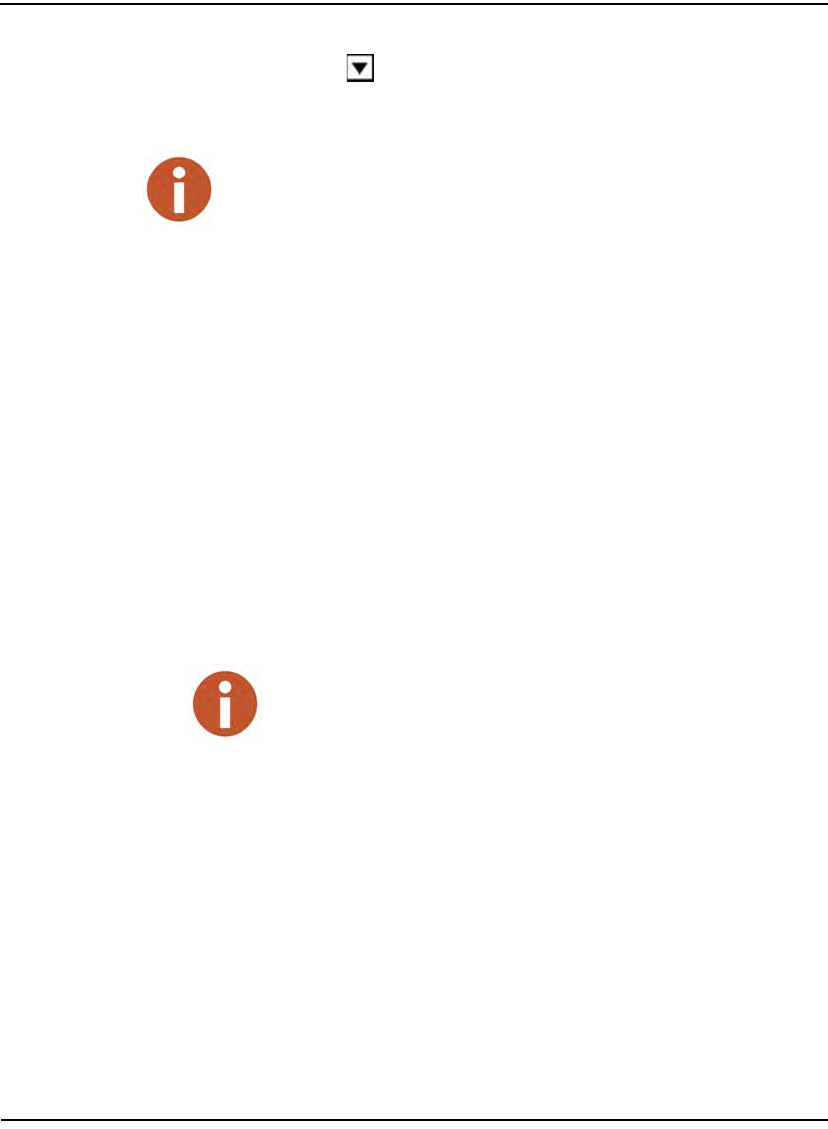
Using the Field Programmer
8-42 N_SIGHT R900 User’s Manual for the Neptune Handheld System
5 Touch to select a format from the list of available in Format
Name.
The following information appears:
•Available Formats display at the top of the screen.
•User Selected shows the formats already selected.
6 On this screen, do any the following by selecting the corresponding
button or tab.
The formats preceded by (NTG) are standard ProRead formats from
Neptune. The formats without (NTG) are custom formats defined by the user.
Add Allows you to select from the Available
Formats, and touch or click Add to place it in
the User Selected list.
Remove Allows you to select a format from the User
Selected list and touch or click Remove to
remove it from the User Selected list.
Although you can remove a format from the User Selected list, it
remains in the Available Formats list.
Close Allows you to close the Gas Configuration
screen and return to the previous screen.
NewFMT Allows you to add a new format for Gas
Configuration.
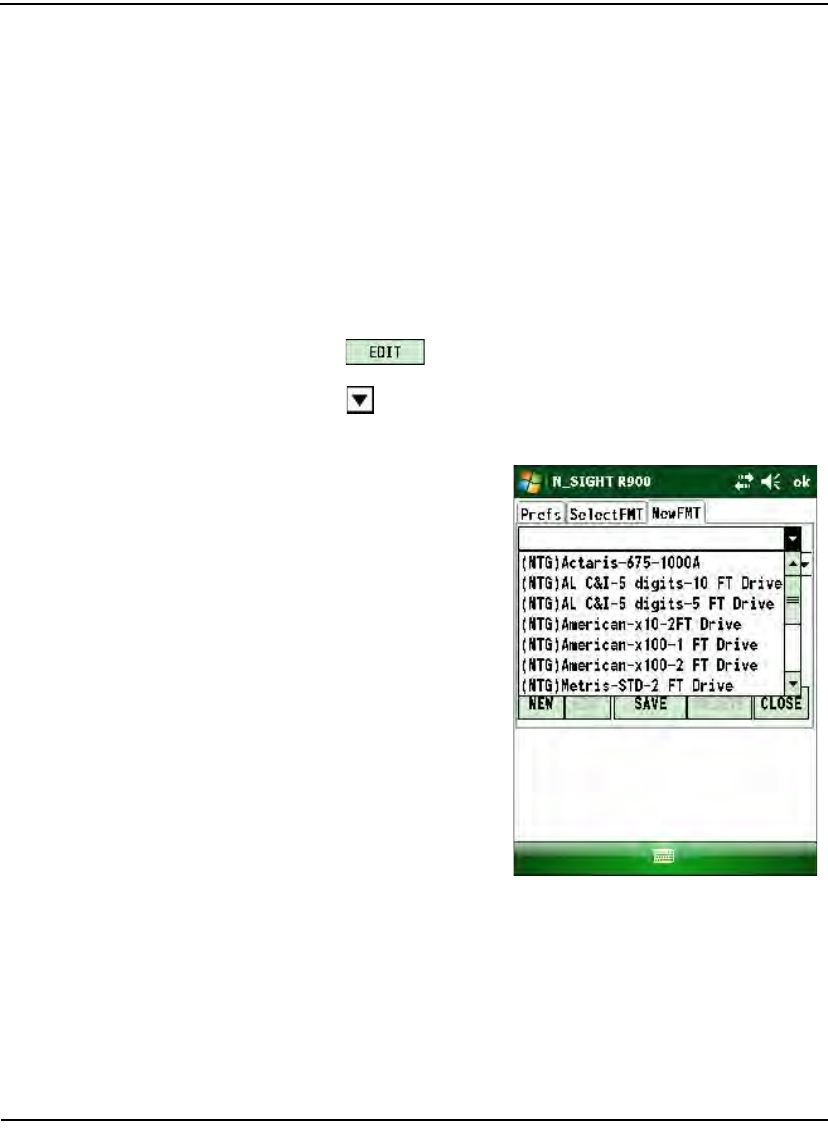
Using the Field Programmer
N_SIGHT R900 User’s Manual for the Neptune Handheld System 8-43
Adding or Editing a Gas Format
To add a new format and have it appear in the Available Formats list,
you can either edit an existing format, or add a new format.
Editing an Existing Gas Format
To edit an existing gas format, complete the following steps.
1 Touch NewFMT.
The New Format screen appears as illustrated in Figure 8.38 on
page 8-41.
2 Touch .
3 Touch in Format Name to select a format from the available
gas formats.
A selection list similar to
Figure 8.39 appears.
Figure 8.39 Gas New Format Selection List
4 Select the format you want from the available gas formats.
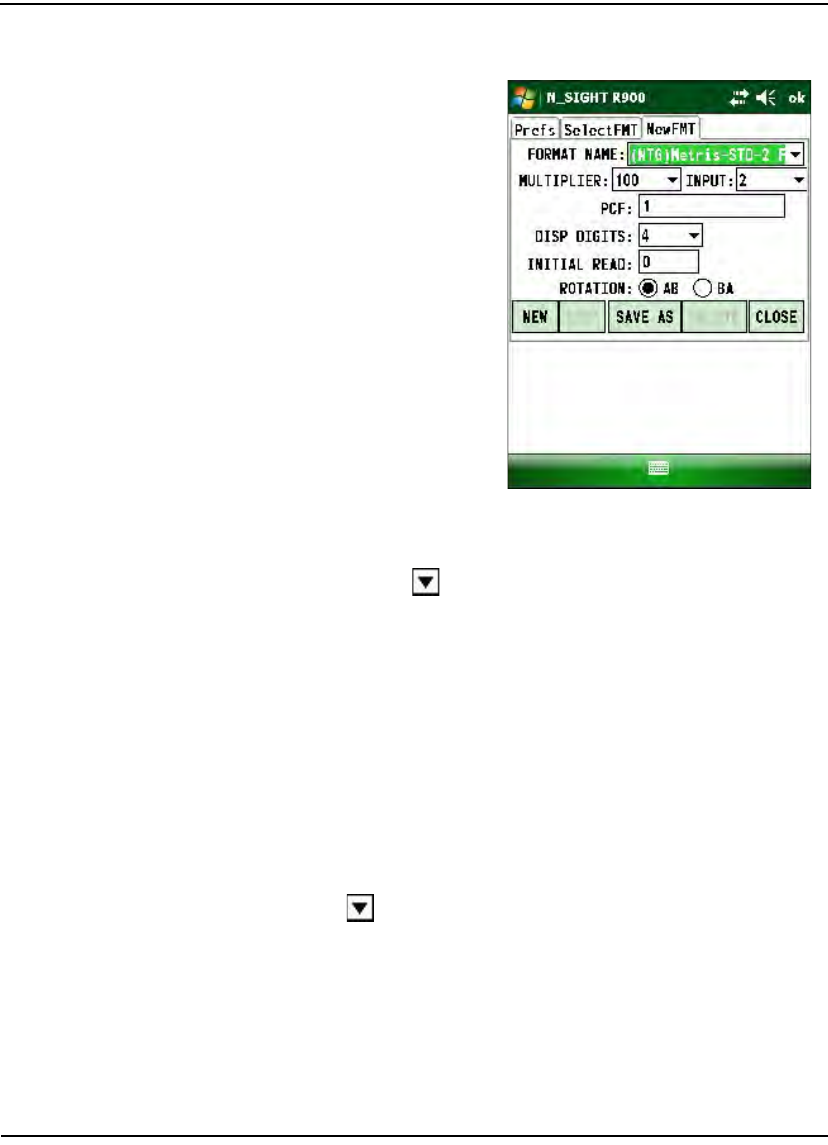
Using the Field Programmer
Notes:
8-44 N_SIGHT R900 User’s Manual for the Neptune Handheld System
After you select a
format, all the values
associated with it appear
as shown in Figure 8.40.
You can then make any
necessary changes.
Figure 8.40 Gas Values Shown on
New Format Screen
5 Touch or click in MULTIPLIER to select the correct value
from 0.01 to 1000 to be use for the format.
6 Type a value for INPUT to enter the input rate. This is controlled
by the index.
7 Type the 9-digit number for the Pressure Configuration Factor
index in PCF.
Refer to the listing of PCF indexes, refer to “Pressure Configuration
Factor Indexes,” in Appendix C.These are examples only. This list
does not include every index a utility has in its system. If there are
any questions about the correct pressure configuration factor,
contact the meter manufacturer.
8 Touch in DispDigits to select one of the following:
• 4 = Initial Reading will be in range of 0000 - 9999
• 5 = Initial Reading will be in range of 00000 - 99999
• 6 = Initial Reading will be in range of 000000 - 999999
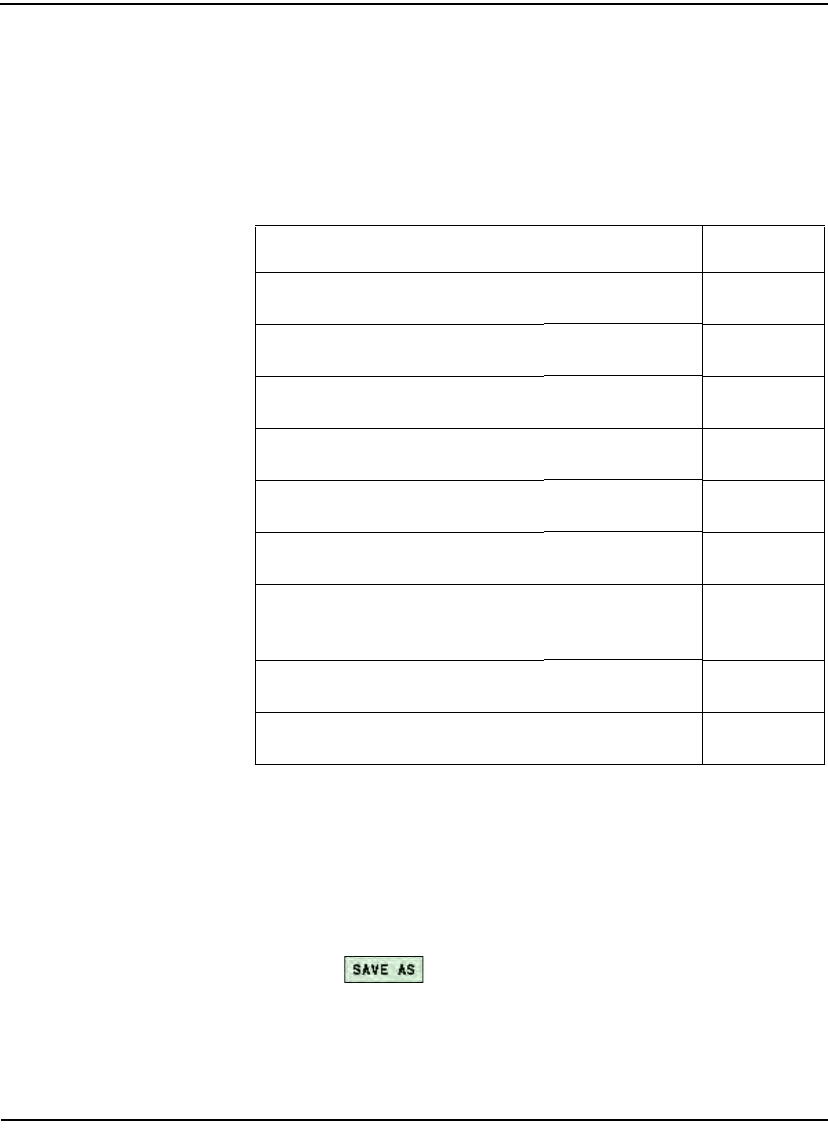
Using the Field Programmer
N_SIGHT R900 User’s Manual for the Neptune Handheld System 8-45
9 Type the actual meter reading in Initial Reading.
10 Select AB for clockwise rotation or BA for counter-clockwise rota-
tion. Use the table on “Meter Input Drive Rotation,” on page 8-45.
.
Saving the Format
To save the format and add it to the list of available formats, complete
the following steps.
1 Complete the steps for “Editing an Existing Gas Format,” on page
8-43.
2 Touch .
A dialog appears asking you to enter a different name for the
format.
Table 7.6 Meter Input Drive Rotation
Meter Rotation
American 250-630 12759-000 BA
Sensus R275 - #415 12821-XXX AB
Actaris Metris, 250, 400A 12861-000 AB
American AL800 - AL5000 12882-000 BA
Sensus #750 - #10000 12882-200 AB
Actaris 675A - 1000A 12882-100 BA
Dresser AMR adapter kit for
American BA
Instrument Drive - CW AB
Instrument Drive CCW BA
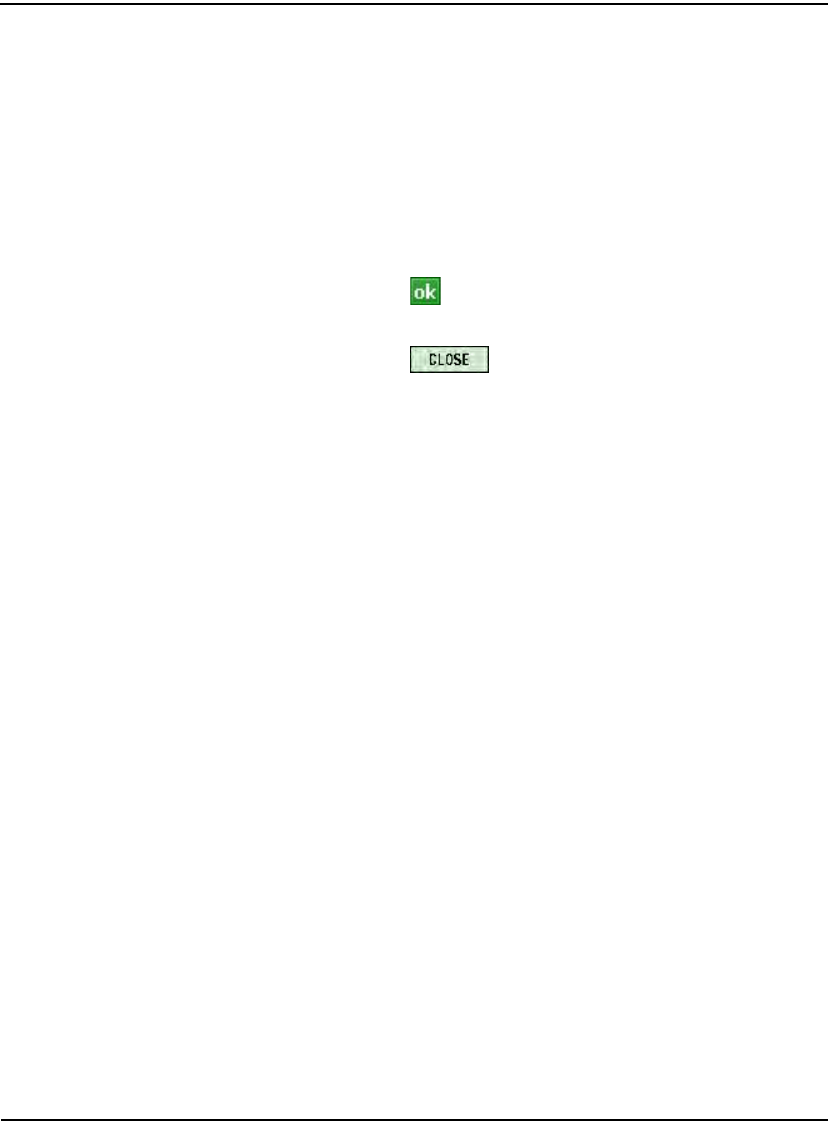
Using the Field Programmer
8-46 N_SIGHT R900 User’s Manual for the Neptune Handheld System
3 Touch or click Yes to save the changes to the new format or No to
cancel.
4 Type the name of the new format in Format Name.
If you selected a standard format, and made changes to it, you must
type a new name for the format.
A dialog appears asking you to enter a different name for the
format.
5 Touch or click , and type the name of the new format in For-
mat Name.
6 Touch or click .
The new format is saved to the list of available gas formats.
Adding a New Gas Format
To add a new gas format, complete the following steps.
1 Select Configure Gas from the Field Programmer Menu. See
Figure 8.5 on page 8-7.
2 When prompted, enter your password. See “Starting
Field Programmer,” on page 8-6.
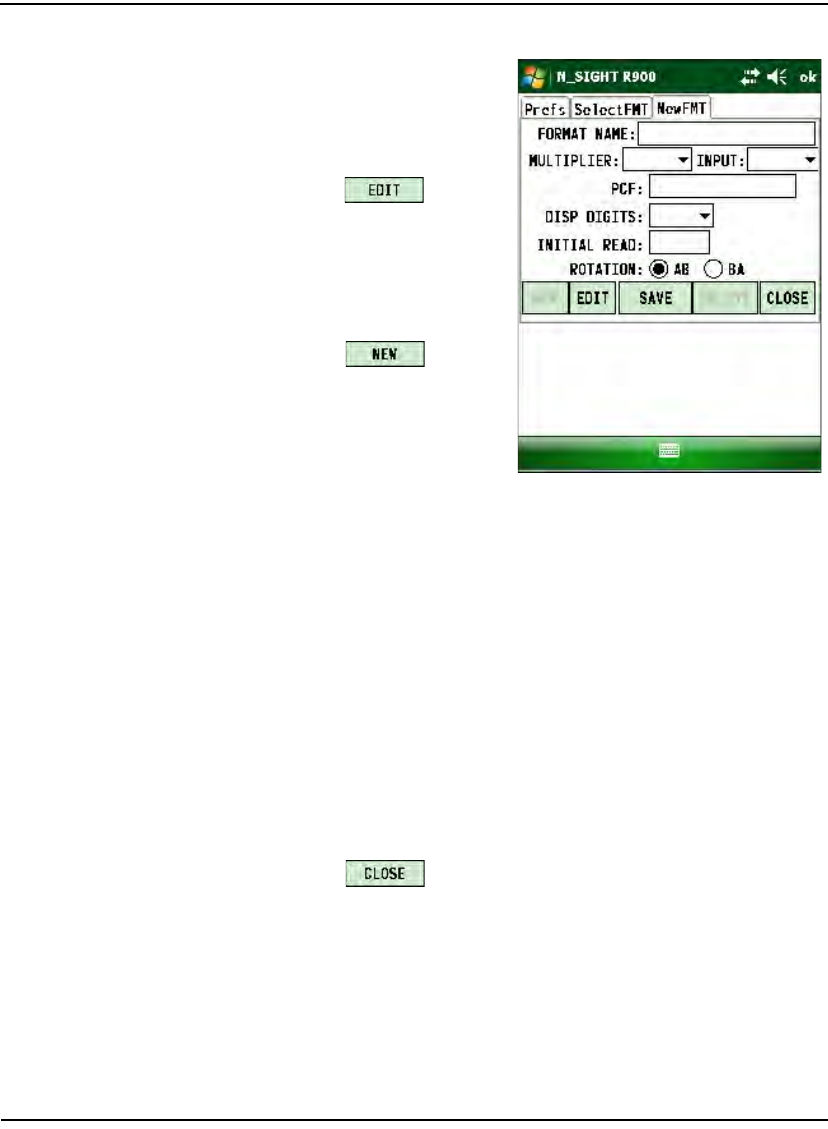
Using the Field Programmer
N_SIGHT R900 User’s Manual for the Neptune Handheld System 8-47
3Touch NewFMT.
The New Format screen
appears as illustrated in
Figure 8.38 on page 8-41.
4 Touch since the
NewFMT screen now
defaults to New to select
an existing format name.
See Figure 8.39 on page
8-43.
5 Touch .
The New Format screen
appears with the fields and
selections empty.
Figure 8.41 Gas New Format Screen – Blank
6 Type the name of the new format in Format Name.
7 Complete information for the following items, where applicable.
• Multiplier
• Input
•PCF See “Pressure Configuration Factor Indexes,” on page C-
1. Contact the meter manufacturer if you have any questions.
• DispDigits
• Initial Reading
• Rotation (see Table 7.6 on page 8-45.)
8 Touch .
A dialog appears asking you to enter a different name for the
format.
9 Touch or click Yes to save the changes to the new format or No to
cancel.
10 Type the name of the new format in Format Name.
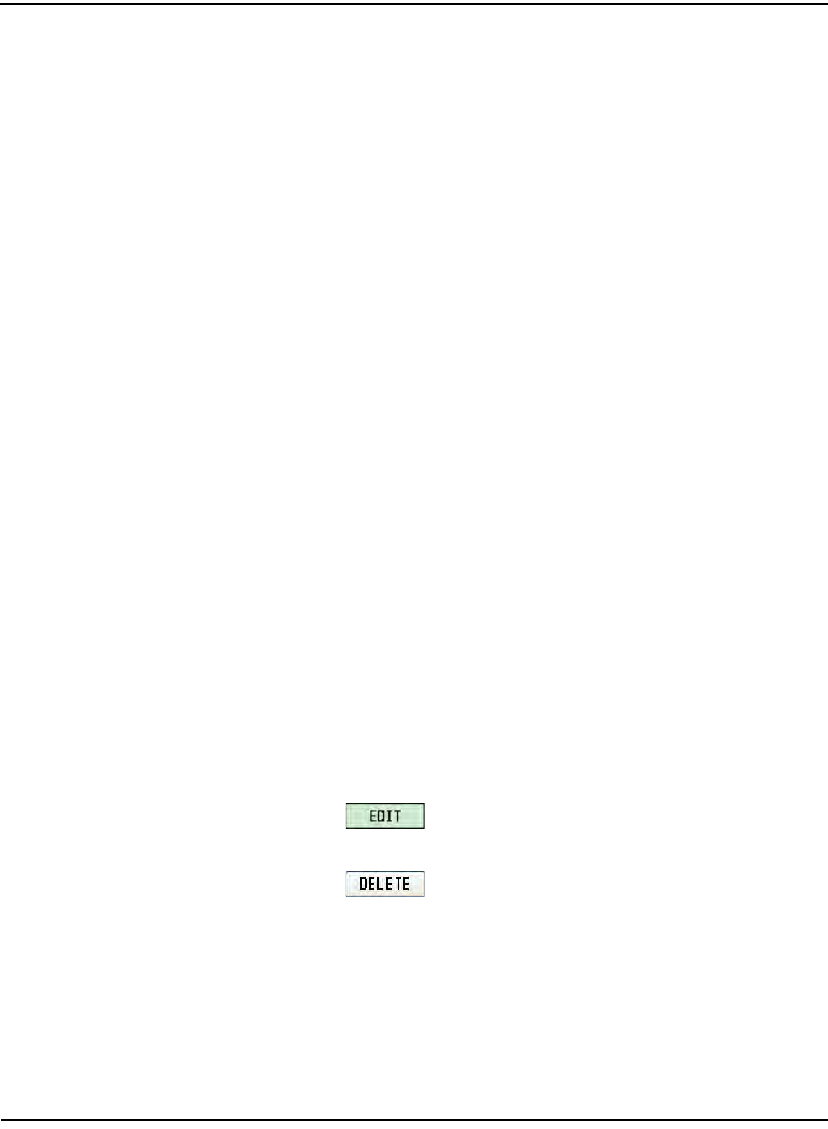
Using the Field Programmer
8-48 N_SIGHT R900 User’s Manual for the Neptune Handheld System
Using the Gas Format
To use the newly created gas format to program gas registers, complete
the following steps.
1 Select Configure Gas from the Field Programmer Menu. See
Figure 8.5 on page 8-7.
2 When prompted, enter your password. See “Starting
Field Programmer,” on page 8-6.
3 Select the SelectFMT tab.
4 Complete the steps outlined in “Selecting a Gas Format,” on page
8-41.
5 Refer to “Programming the R900G Endpoint,” on page 8-18 to pro-
gram or read the R900G endpoint using the newly created format.
Deleting a Format for R900G Endpoints
To delete a gas format used for programming R900G endpoints,
complete the following steps.
1 Select Configure Gas from the Field Programmer Menu. See
Figure 8.5 on page 8-7.
2 When prompted, enter your password. See “Starting
Field Programmer,” on page 8-6.
3 Select NewFMT.
The New Format screen appears as illustrated in Figure 8.39 on
page 8-43.
4 Touch since the NewFMT screen now defaults to New,
then shift the numbers to compensate.
5 Touch to delete the format from the list of available for-
mat.
A confirmation dialog asking you to confirm the deletion.

Using the Field Programmer
N_SIGHT R900 User’s Manual for the Neptune Handheld System 8-49
6 Touch or click Yes to save the format or No to cancel.
The format is no longer available for selection on the
Field Programmer.
You cannot delete a standard format from the list of available formats. You
can only delete user defined formats.

Using the Field Programmer
Notes:
8-50 N_SIGHT R900 User’s Manual for the Neptune Handheld System
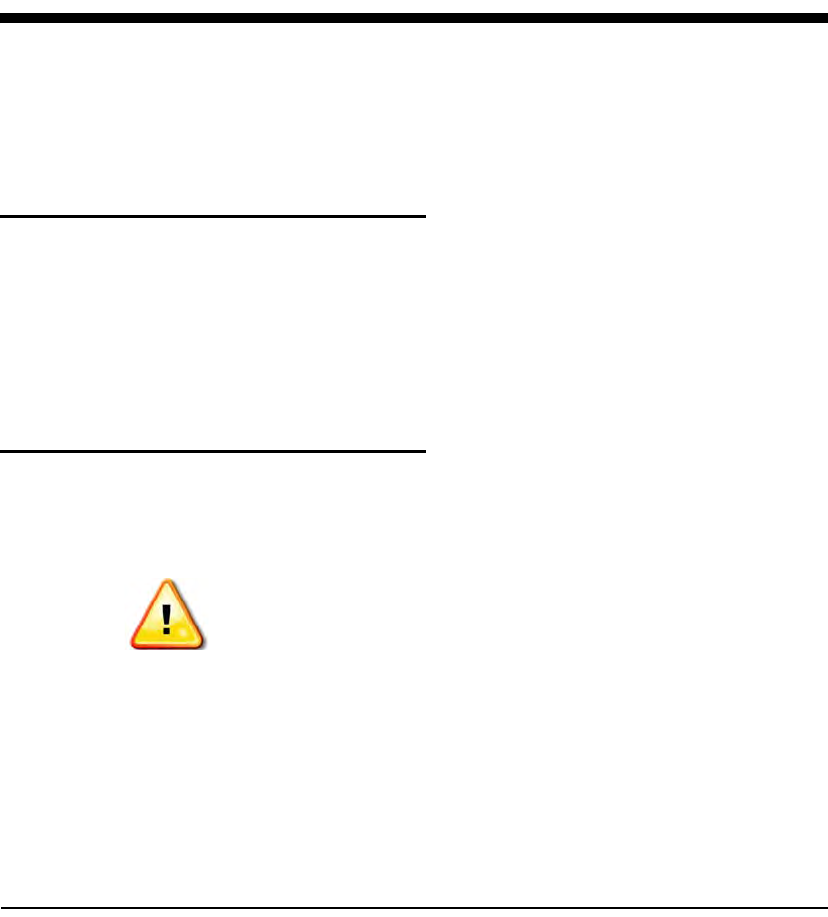
N_SIGHT R900 User’s Manual for the Neptune Handheld System 9-1
9 Maintaining and Repairing the Neptune Handheld System
This chapter provides instructions for maintaining and repairing the
CE5320, the Nomad, and the R900 Belt Clip Receiver, and includes
recommended spare parts. This chapter also gives instructions for
packing and shipping the Neptune handheld system to Neptune should
you ever need to return any unit for repair.
Recommended Maintenance
The CE5320 and the Nomad require little maintenance. Only occasional
cleaning of these handhelds or replacement of their batteries and
handstrap are required. If you store the CE5320 for one week or more,
there are some precautions you need to take to keep it in good working
order. Also, when carrying or shipping either handheld, follow the
precautions given in this chapter.
Maintaining the CE5320
Cleaning the CE5320
If you do not want the handstrap to become wet during cleaning, remove
the strap. Or, if you want to clean the strap, leave it on. Clean the
CE5320 and its handstrap, using a soft cloth and mild soap. Do not use
abrasives which can damage the finish and scratch the display making it
hard to see the information shown.
Before cleaning the handheld, make sure that the top cover door and battery
compartment are correctly closed. Otherwise, water can seep into those
compartments and damage the unit.
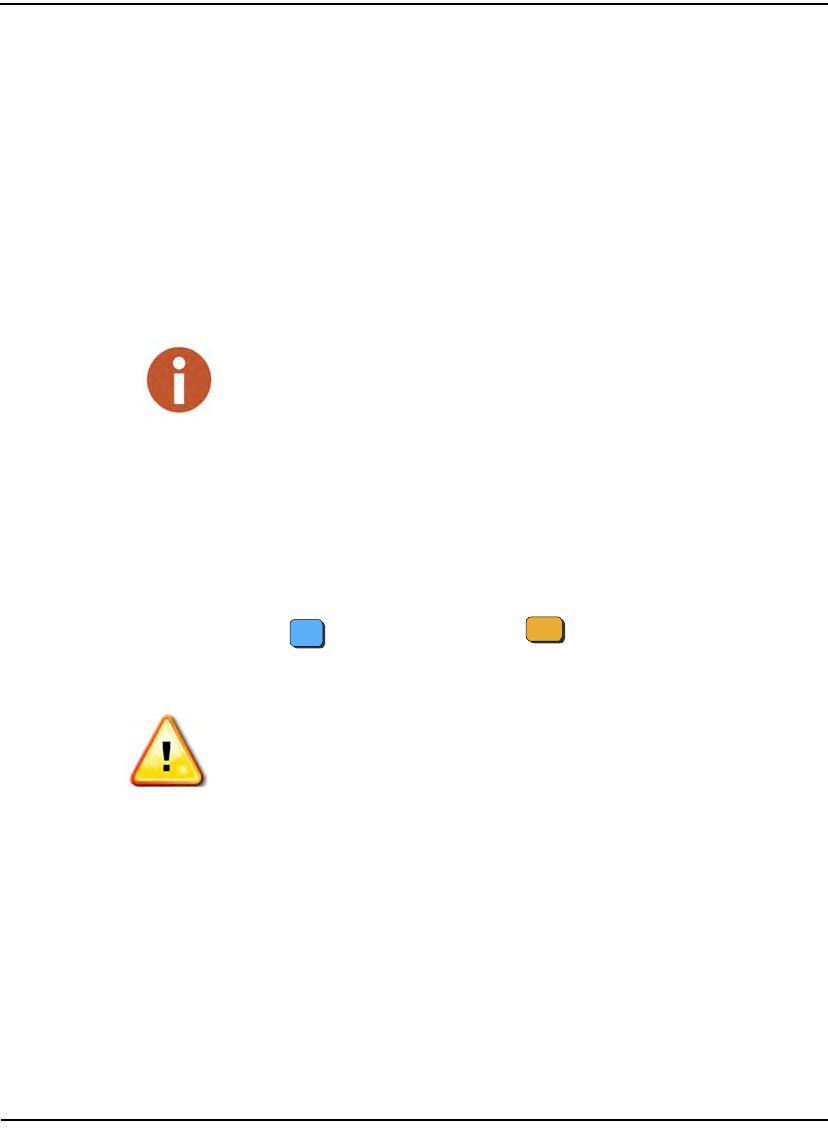
Maintaining and Repairing the Neptune Handheld System
9-2 N_SIGHT R900 User’s Manual for the Neptune Handheld System
Storing the CE5320
If you intend to store the CE5320 for more than one week, there are
precautions you need to take to ensure that the unit functions properly
when you are ready to use it:
• If you are storing the CE5320 for one to three weeks, refer to
“Short-term Storage,” on this page.
• If you are storing the CE5320 for longer than three weeks, refer to
“Long-term Storage,” on this page.
Short-term Storage
Follow these steps to store the CE5320 for one to three weeks.
1 Fully recharge the CE5320. For help with this task, refer to the pro-
cedure “Recharging the Battery,” on page 9-5.
2 After the CE5320 is fully charged, turn it off by pressing the BLUE
key followed by the I/O key.
3 Store the CE5320 at a temperature of 3°C to 25°C (55°F to 77°F).
Long-term Storage
To store the CE5320 for longer than three weeks, keep both the CE5320
and the battery at a temperature of 13°C to 25°C (55°F to 77°F).
To clean the display, Neptune recommends using pre-moistened lens cloths
typically used for cleaning lenses and computer screens. These lens cloths
can be found at any store that carries eyeglasses or computer supplies.
F1
When not in use, put the CE5320 in the cradle to charge at least one 24-hour
period out of each week.
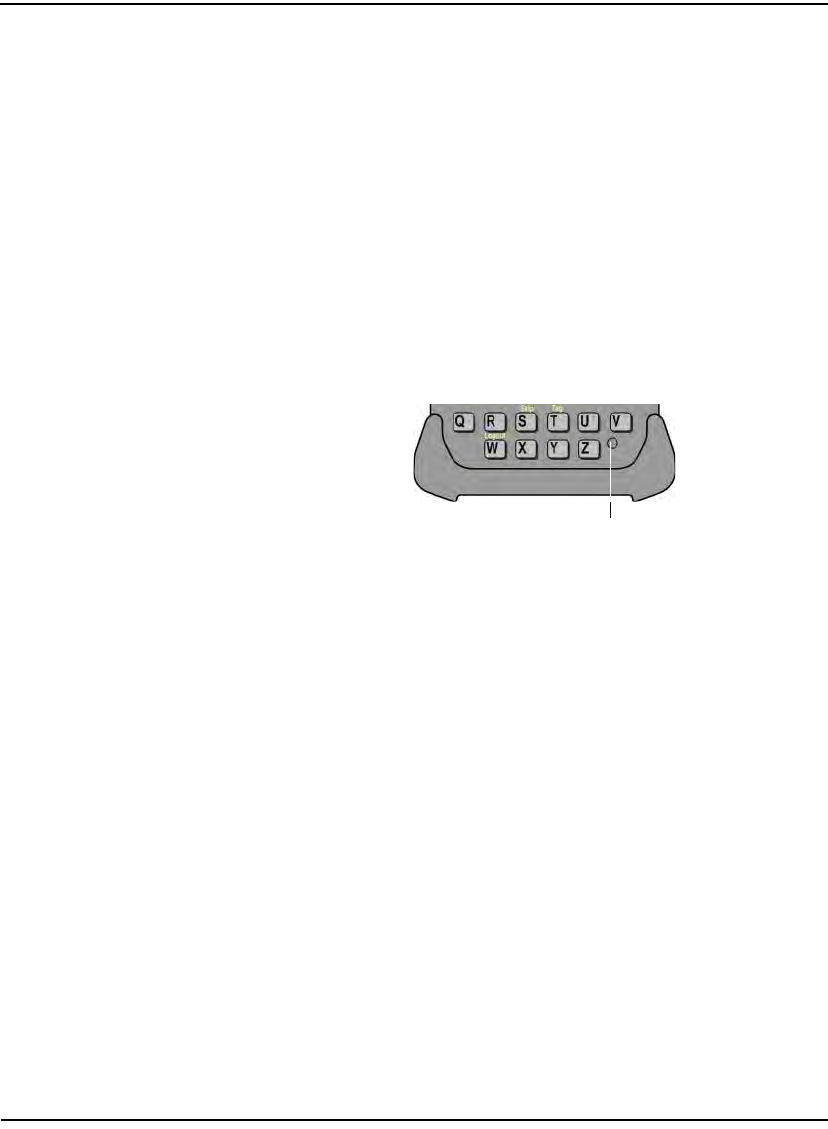
Maintaining and Repairing the Neptune Handheld System
N_SIGHT R900 User’s Manual for the Neptune Handheld System 9-3
To prepare the CE5320 for use after long-term storage, use one of the
following methods:
•Typical method—to ensure that the battery is fully charged, allow
the CE5320 to recharge at least 24 hours.
•Quick method—if your company routinely recharges the CE5320
each business day, allow the CE5320 to recharge for 12 hours.
Checking the Battery Status
To check the status of the battery, place the CE5320 in a communication
cradle. Then, check the battery indicator in the
bottom-right corner of the unit, shown in Figure 9.1, and refer to
the following list.
Figure 9.1 Battery Status Indicator on CE5320
•Red—the battery is low and is charging.
•Green—the battery is fully charged.
•Yellow—the temperature of the battery is too high or too low to be
recharged. When this occurs, the charging system is disabled. The
battery can be recharged when it reaches a temperature of 0ºC to
45ºC (32ºF to 113ºF).
•No color—the charging device (communication cradle) is not
receiving power.
battery status indicator
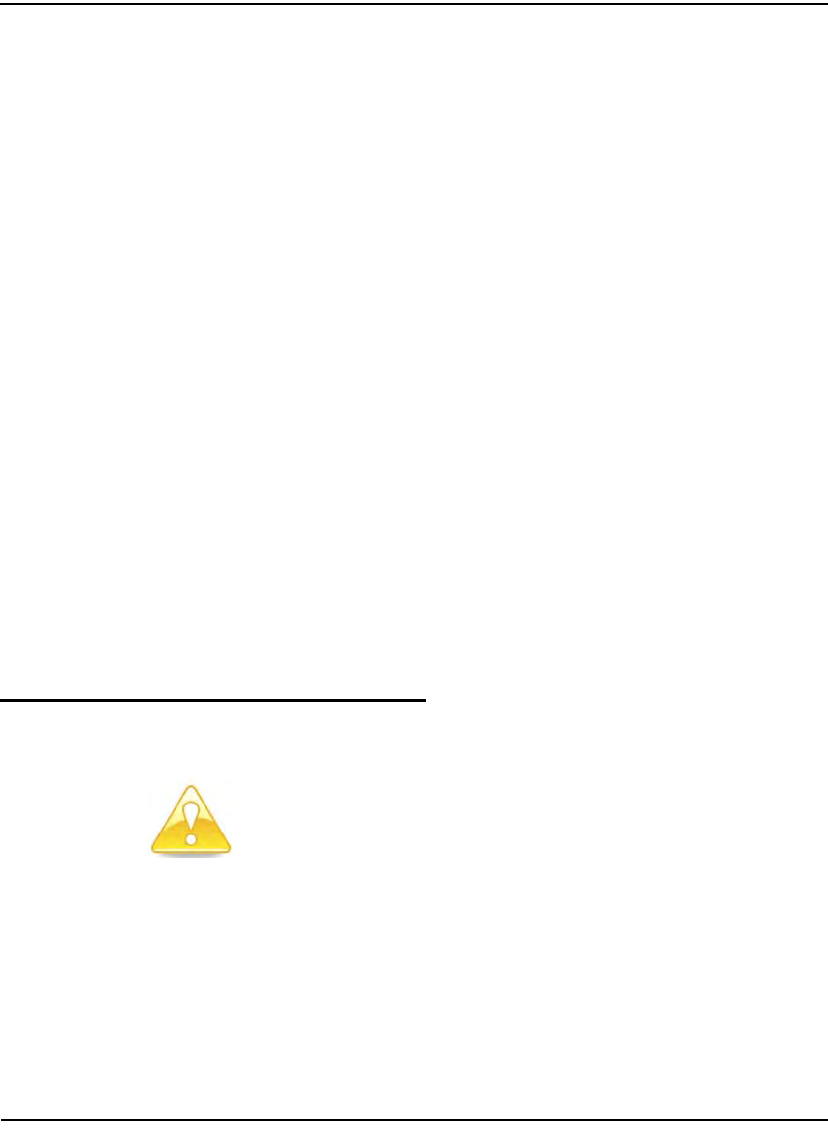
Maintaining and Repairing the Neptune Handheld System
9-4 N_SIGHT R900 User’s Manual for the Neptune Handheld System
Transporting the CE5320
When transporting the CE5320, keep the following precautions in mind:
• The recommended temperature range for operating the CE5320 is
from -30°C to +50°C (-22°F to 122°F). Short exposure to
temperatures lower or higher than these can cause the display to
turn very dark or very light until the unit returns to the
recommended operating temperature range. This usually occurs if
the CE5320 is left in a vehicle during a hot or cold day.
• The CE5320 can withstand occasional drops from up to two meters
(six feet) onto a hard surface when the unit is operated within the
specified temperature range.
• The CE5320 withstands exposure to rain without allowing water to
seep inside the unit. It is designed to endure occasional immersions.
The unit floats making it easy to retrieve if dropped in water.
• The CE5320 performs well in most environments where
electromagnetic fields are present. Examples of these environments
include areas near power-transmission lines, electric motors,
transformers, compressors, and low-power radio transmitters.
Performance can be degraded when using a communication cable; a
peripheral, such as a printer; or a battery charger under these
conditions.
Repairing the CE5320
Refer to the following procedures to repair the CE5320. Do not attempt
to perform repairs other than those described in this chapter. Opening
the back panel of the CE5320 voids your warranty.
Do not attempt to remove the back panel of the CE5320. Attempting to repair
the unit on your own voids the warranty by breaking the warranty label which
covers a screw on the back panel of the unit.
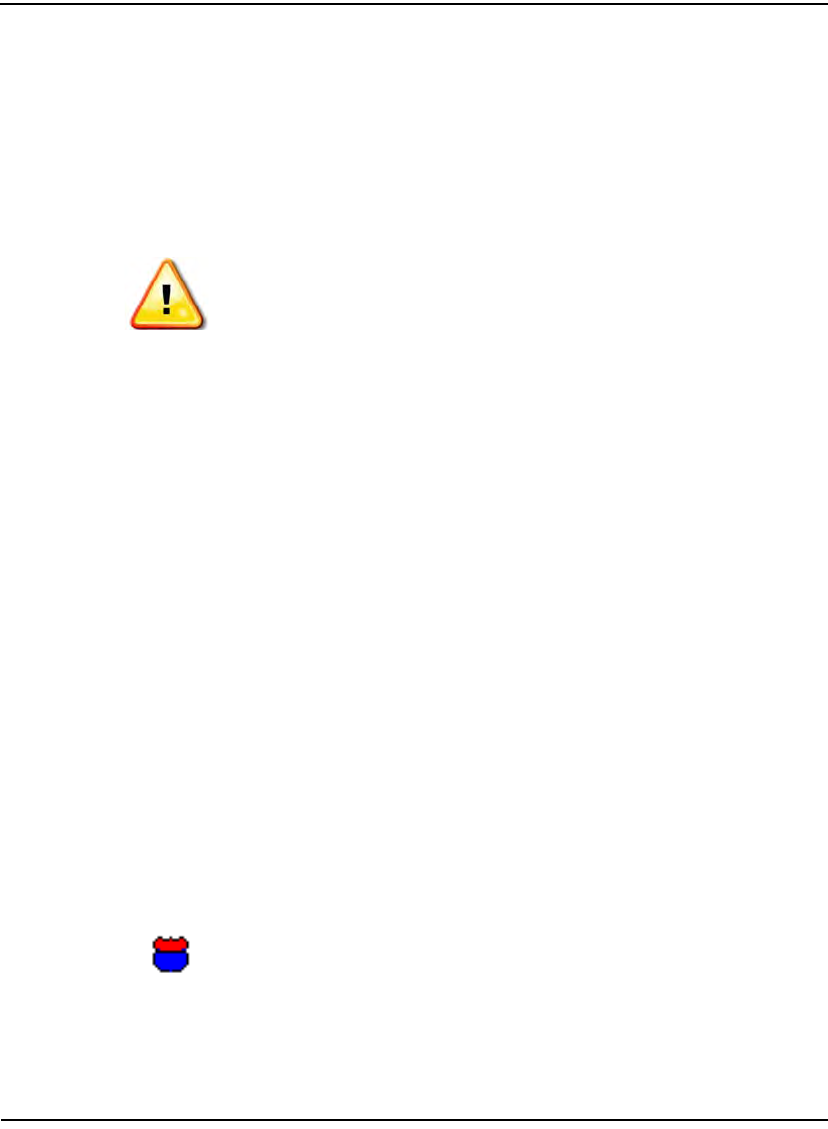
Maintaining and Repairing the Neptune Handheld System
N_SIGHT R900 User’s Manual for the Neptune Handheld System 9-5
Recharging the Battery
The CE5320 uses a high-quality, lithium ion battery. It can be recharged
more than 500 times. When used under normal conditions, the battery
should last about 24 months, although its life is reduced by repeated or
prolonged total discharges.
Follow this procedure to recharge the battery.
1 Make sure that the communication cradle, router, or Ethernet cables
are connected as described in Chapter 3.
2 Place the CE5320 in a communication cradle.
3 Check the battery indicator in the bottom right corner of the
CE5320 to see if the unit is charged. Refer to the following list to
recharge the battery.
•Red—the battery is low. Recharge the battery by allowing the
CE5320 to remain in the cradle until the indicator turns green.
If the CE5320 has been used under normal conditions, recharg-
ing usually takes about three hours.
•Green—the battery is fully charged. Remove the CE5320 from
the cradle.
•Yellow—the temperature of the battery is too high or too low
to be recharged. When this occurs, the charging system is dis-
abled. Wait for the battery of the CE5320 to reach a tempera-
ture of 0ºC to 45ºC (32ºF to 113ºF). Then, place the CE5320 in
the cradle. The battery indicator should now turn red.
Calibrating the CE5320 Battery
When the handheld first arrives from the factory, the battery must be
fully charged before use. The battery in the CE5320 has been calibrated
at the factory; however, you may want to periodically calibrate the
battery to maintain the accuracy of battery status indicators. Neptune
recommends calibrating the battery if the battery is deeply discharged, if
it is replaced with a new battery, or once every three months.
Do not attempt to recharge the battery if the CE5320 is not within a
temperature of 0ºC to 45ºC (32ºF to 113ºF). Doing so can damage the battery.
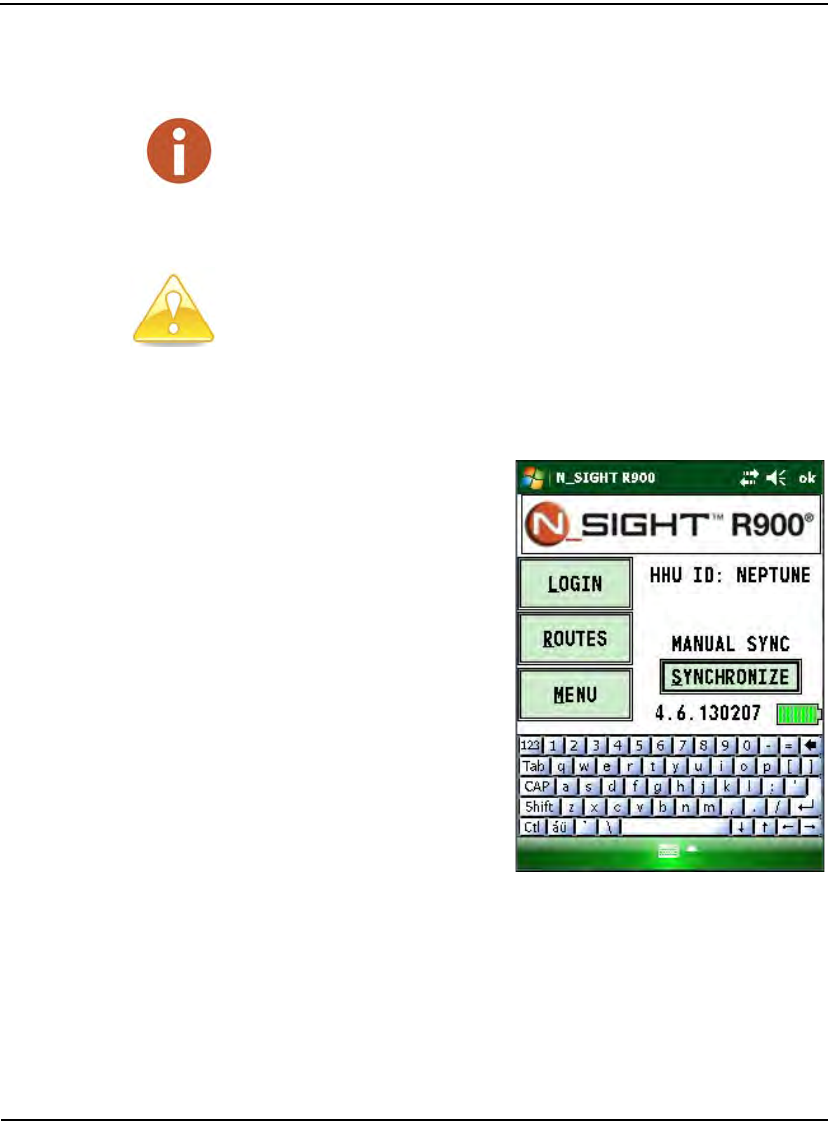
Maintaining and Repairing the Neptune Handheld System
9-6 N_SIGHT R900 User’s Manual for the Neptune Handheld System
.
Follow this procedure to display the Battery Management function.
1 With the handheld out of the cradle, turn it ON.
2Go to the N_SIGHT R900
Login screen.
The N_SIGHT R900
Login screen appears with
the Battery Manager
status information on the
display, as illustrated in
Figure 9.2.
Figure 9.2 Handheld Battery Information
The battery status indicator, located at the bottom right of the handheld
keyboard as shown in Figure 9.1 on Page 9-3, changes color to notify the
meter reader of the battery charge status. A red light indicates that the battery
is low while a green light indicates that the battery is fully charged.
This procedure could take up to 16 hours to complete. Be sure the hand-
held can be available for that amount of time before beginning the cali-
bration.
ON BATTERY 87%
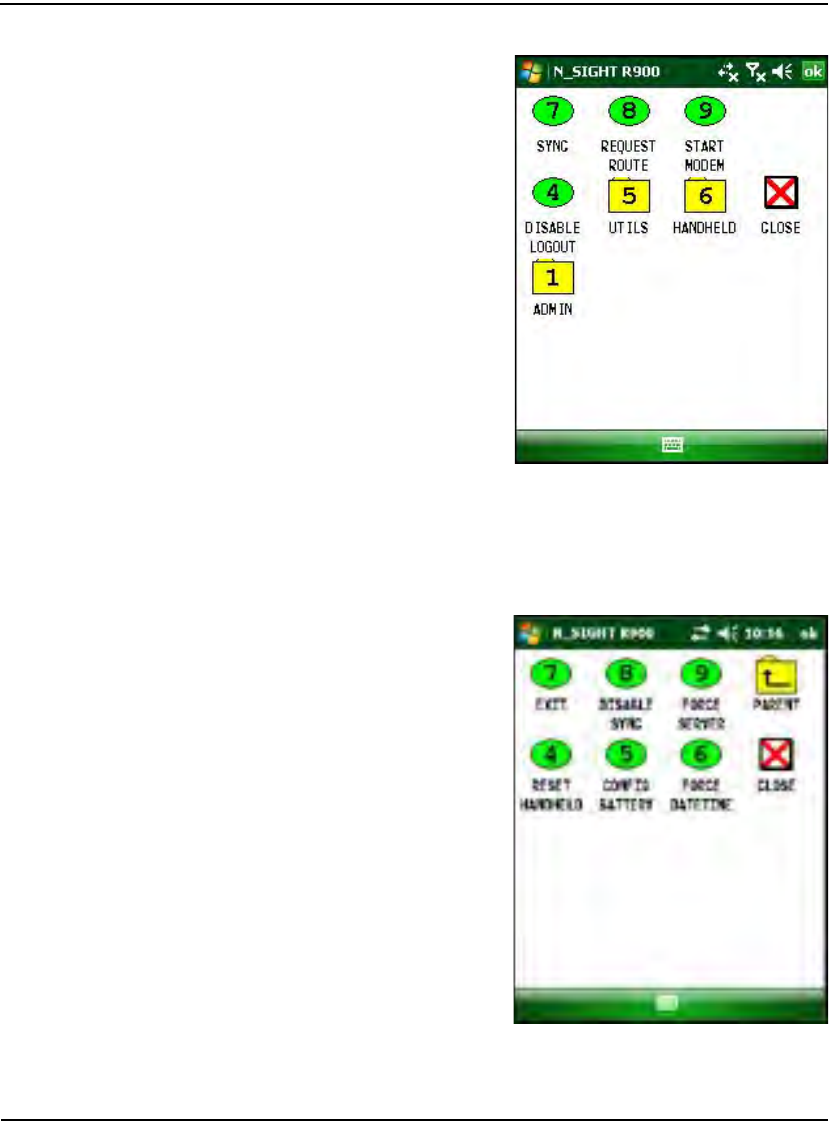
Maintaining and Repairing the Neptune Handheld System
N_SIGHT R900 User’s Manual for the Neptune Handheld System 9-7
3Place the handheld in the
cradle.
4 On the N_SIGHT R900
Login screen, press M or
touch Menu.
The N_SIGHT R900
Main Menu screen
appears.
Figure 9.3 N_SIGHT R900 Main Menu
5 Press 1 or touch Admin.
The Admin Menu
appears.
Figure 9.4 N_SIGHT R900 Admin Menu
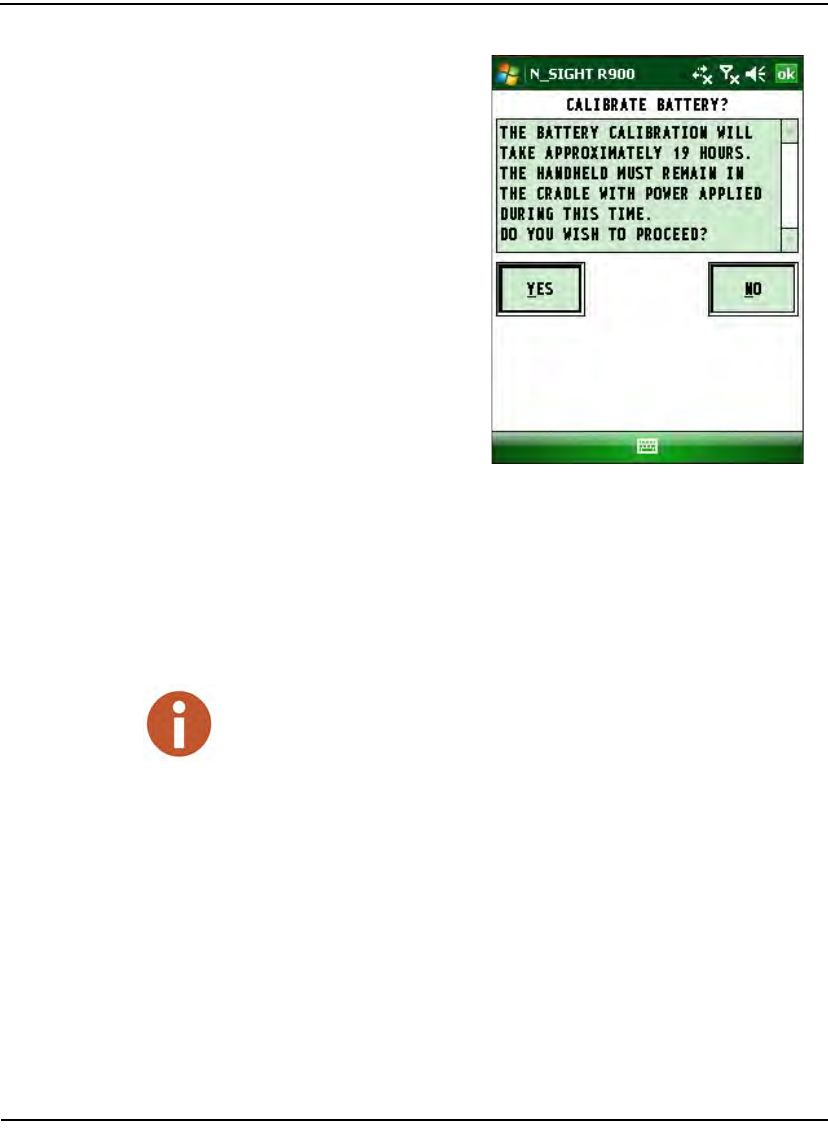
Maintaining and Repairing the Neptune Handheld System
9-8 N_SIGHT R900 User’s Manual for the Neptune Handheld System
6Press 5 or touch Config
Battery.
The Calibrate Battery
screen appears.
Figure 9.5 N_SIGHT R900 Calibrate Battery Screen
7 Press Y or touch Yes.
8 Type your password when prompted.
The battery calibration begins and will take approximately 24 hours
to complete.
After the battery has been calibrated, the battery status indicator blinks a
red light when the battery level is depleted to 10% of its full capacity.
This means that if a battery lasts for 15 hours on full charge, the
indicator light begins blinking 90 minutes before Low Battery
Warning appears and the handheld runs out of battery power.
This feature can be used by meter readers in the field to warn them
ahead of the final message that appears on the display.
Neptune recommends calibrating the battery if the battery is deeply
discharged, if it is replaced with a new battery, or once every three months.
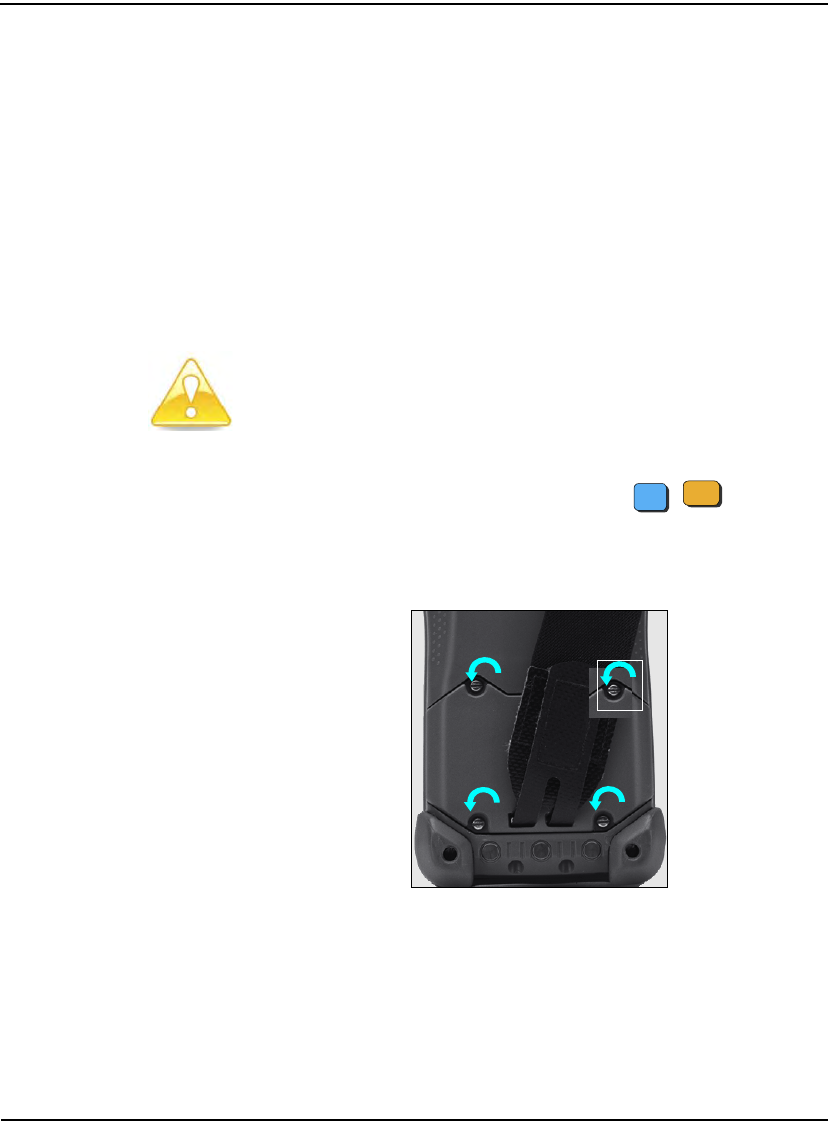
Maintaining and Repairing the Neptune Handheld System
N_SIGHT R900 User’s Manual for the Neptune Handheld System 9-9
Replacing the Battery
If you find that the battery does not last for eight hours after having been
recharged, you need to replace it.
To replace the battery, you need the following equipment:
• One small, flat-blade screwdriver
• One lithium-ion replacement battery, part number 8136-015
Follow this procedure to remove the battery from the CE5320 and
replace it with a new one.
1 Turn the CE5320 off by pressing the BLUE , .
2 Using a small, flat-blade screwdriver, turn each of the four captive
screws that secure the door of the battery compartment counter-
clockwise to loosen them. See Figure 9.6.
Figure 9.6 Remove the Captive Screws
3 Lift the door from the back panel.
Do not attempt to remove the battery while the CE5320 is turned on.
Otherwise, data can be lost.
F1
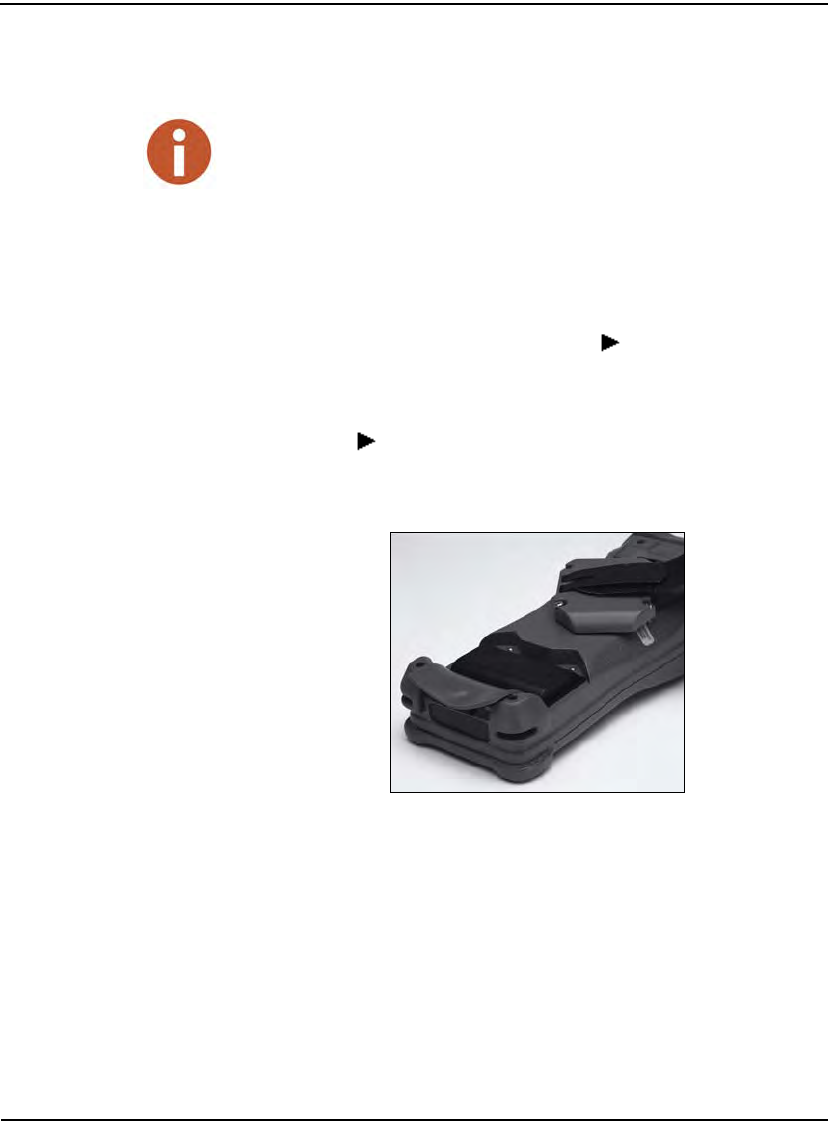
Maintaining and Repairing the Neptune Handheld System
9-10 N_SIGHT R900 User’s Manual for the Neptune Handheld System
To install a new battery, use the following procedure.
1 Fold the foam flap back and remove the old battery.
2 Position the new battery over the compartment so that the label of
the battery faces down and the arrow ( ) on the top of the battery
points to the right.
3 Lower the left side of the battery — the side that is across from the
arrow ( ) — into the battery compartment.
4 Then, lower the rest of the battery into the compartment, pushing
firmly until the battery is fully seated as shown in Figure 9.7.
Figure 9.7 Inserting the Battery
5 Fold the protective foam flap over the battery and replace the door
of the battery compartment.
6 Secure the door of the battery compartment to the back panel of the
CE5320 by turning each of the four captive screws clockwise until
you feel some resistance.
Because the CE5320 uses captive screws, you cannot remove the screws,
but can only loosen them until they detach from the back panel.
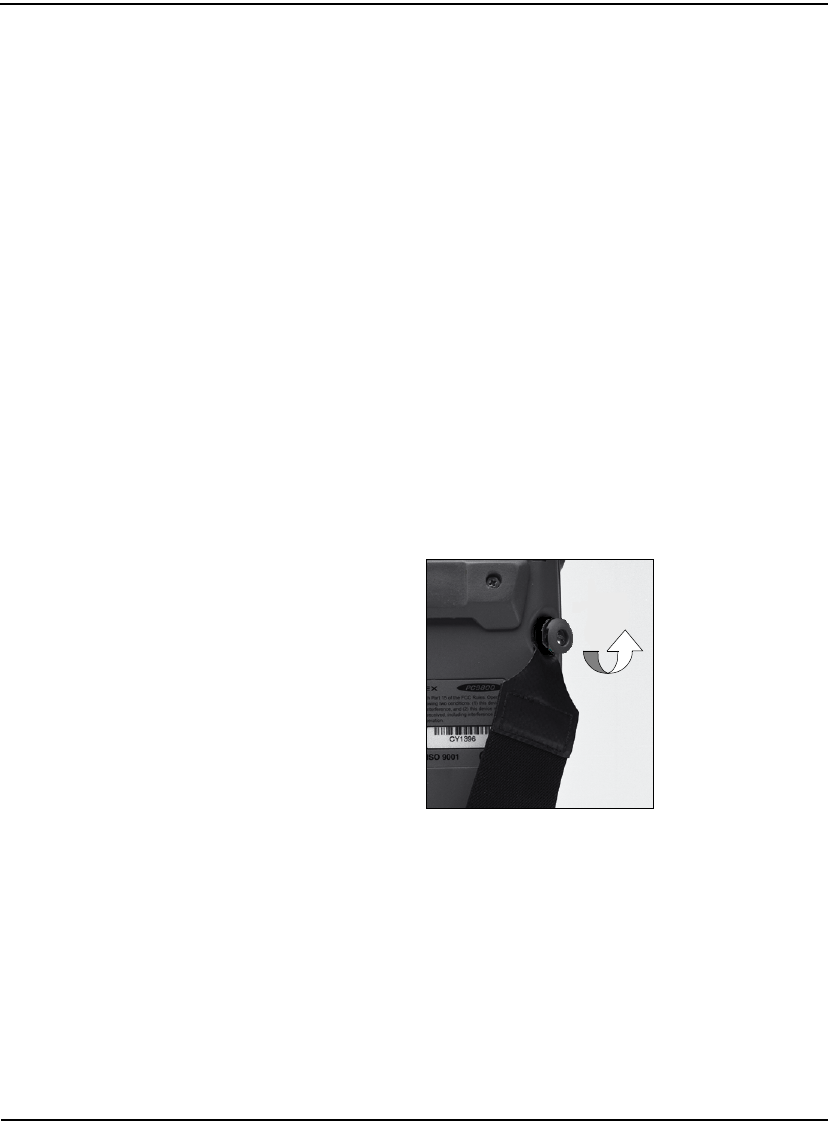
Maintaining and Repairing the Neptune Handheld System
N_SIGHT R900 User’s Manual for the Neptune Handheld System 9-11
Removing or Replacing the Handstrap
Follow this procedure to remove the handstrap for cleaning or to install
a new handstrap.
Equipment
To remove or replace the handstrap, you need the following equipment:
• One small, flat-blade screwdriver
• If you are replacing the handstrap, one replacement handstrap
(package of 4), part no. 12249-012
Removing
Follow this procedure to remove the handstrap from the CE5320 for
cleaning or replacement.
1 Using a small, flat-bladed screwdriver, turn the single screw that
secures the handstrap to the top of the back panel counterclockwise
to remove it. See Figure 9.8.
Figure 9.8 Removing Screw From Back Panel
2 Remove the plastic washer.
3 Keep the screw and washer. You can use them later to install the
new handstrap.
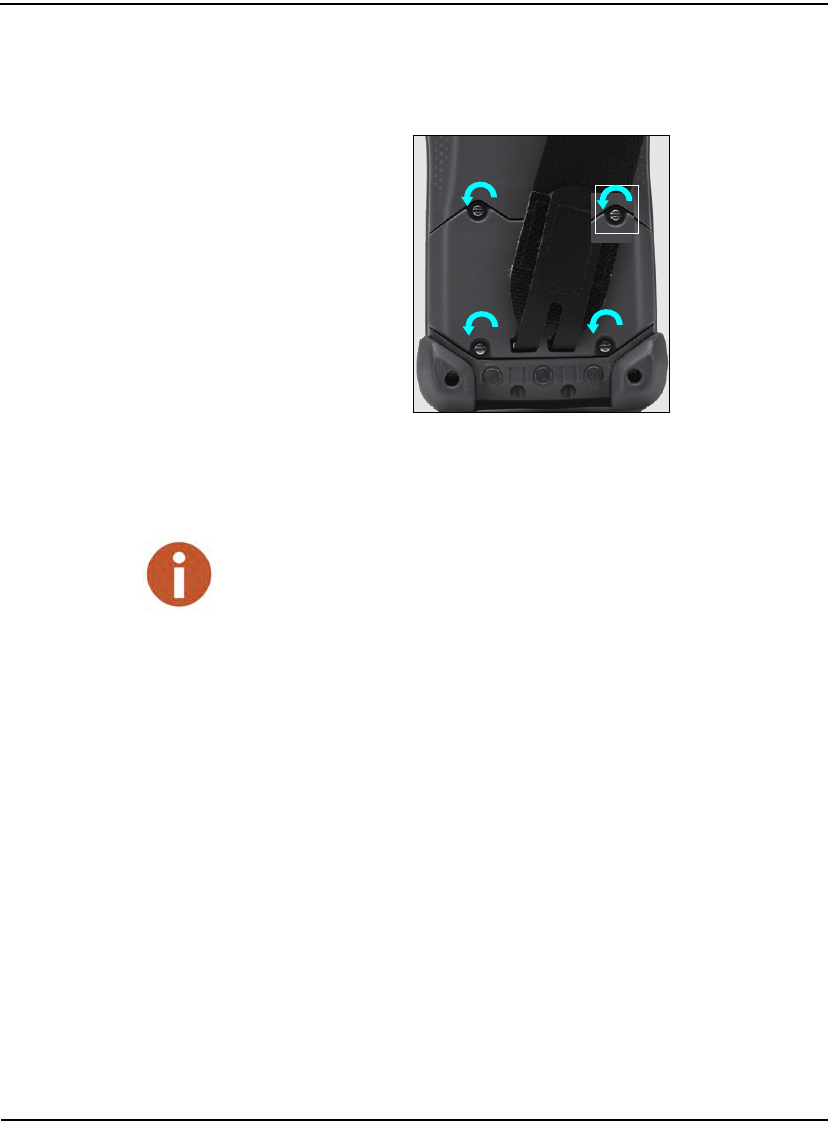
Maintaining and Repairing the Neptune Handheld System
9-12 N_SIGHT R900 User’s Manual for the Neptune Handheld System
4 Using a small, flat-blade screwdriver, turn each of the four captive
screws that secure the door of the battery compartment counter-
clockwise to loosen them. See Figure 9.9.
Figure 9.9 Removing the Captive Screws
5 Lift the door from the back panel.
6 Remove the handstrap from the door of the battery compartment by
removing the small metal pin that holds the handstrap in place. You
can find it easier to perform this operation by opening the hand-
strap’s Velcro™ closure, shown in Figure 9.10, and pushing a por-
tion of the handstrap through the two holes in the door of the
battery compartment, loosening the metal pin. See Figure 9.10 on
Page 9-13.
Because the CE5320 uses captive screws, you cannot remove the screws,
but can only loosen them until they detach from the back panel.
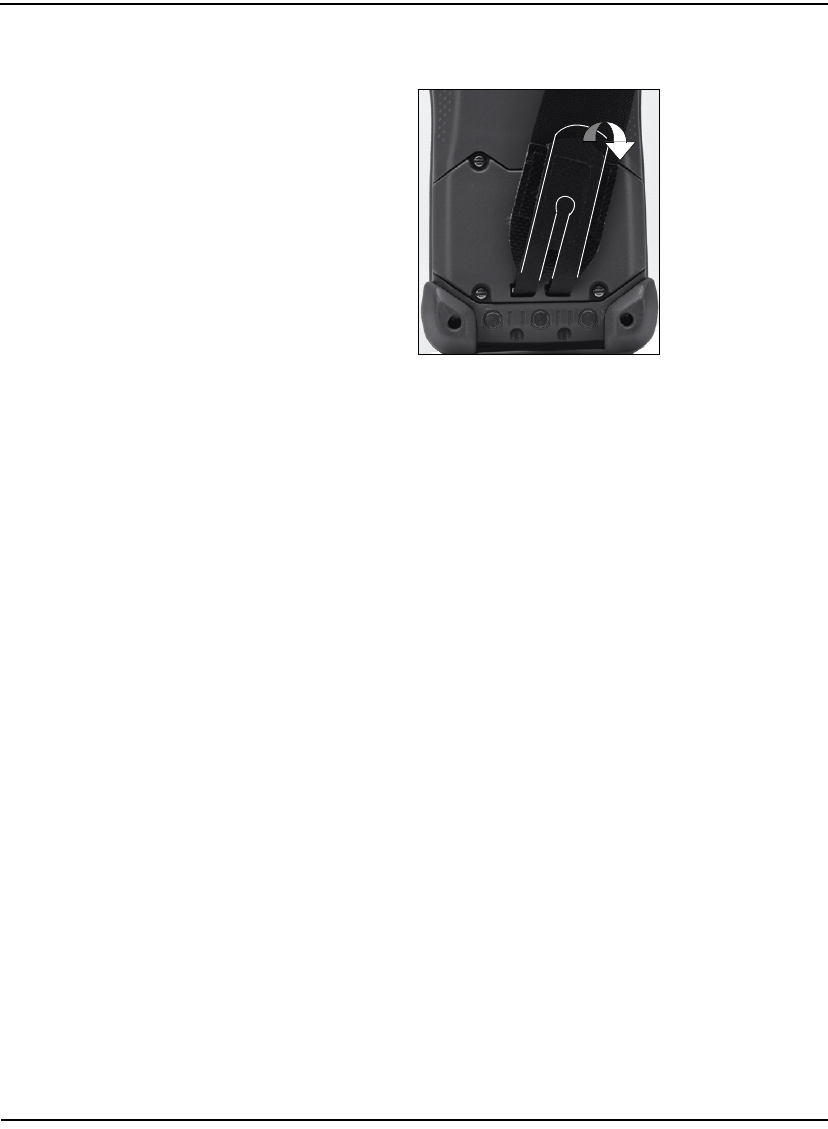
Maintaining and Repairing the Neptune Handheld System
N_SIGHT R900 User’s Manual for the Neptune Handheld System 9-13
Figure 9.10 Opening the Velcro Closure
Replacing
To replace the existing strap or to install a new one, use the following
procedure.
1 Fold the slotted end of the handstrap back to form a hinge and
loosely secure the Velcro closure.
2 Hold the door of the battery compartment so that the screws face
you. Then, push the slotted ends of the handstrap through the two
holes on the door.
3 Turn the door over so that the inside of the door is facing you, and
slide the small metal pin that you removed earlier through the slots
of the handstrap. If you have difficulty inserting the pin, try loosen-
ing the Velcro tab and pushing more of the handstrap through the
holes on the door.
4 Fold the protective foam flap over the battery and replace the door
of the battery compartment.
5 Secure the door of the battery compartment to the back panel of the
CE5320 by turning each of the four captive screws clockwise until
you feel some resistance.

Maintaining and Repairing the Neptune Handheld System
9-14 N_SIGHT R900 User’s Manual for the Neptune Handheld System
6 Align the hole in the other end of the handstrap with the screw hole
on the back panel of the CE5320. Then, replace the plastic washer
and screw that you removed earlier.
7 Tighten the screw by turning it clockwise until you feel some resis-
tance.
8 Secure the Velcro closure, adjusting its tightness to your preference.
Maintaining the Nomad
Battery Life
The lithium-ion battery life is dependent upon the usage and operating
environment.
Tips for Extending the Battery Life
•Keypad backlight: The default is OFF. Using this backlight could
reduce your battery life by up to 25%. Display backlight: Tap Start
| Settings | System | Backlight to minimize the amount of time the
backlight stays on, and dim it to only as bright as required to view
the display.
•WiFi, Bluetooth, camera, or barcode scanner: If your unit comes
with any of these options installed, use ONLY when necessary.
Turn off when not needed. Minimize the Flash intensity and the use
of the flashlight.
•Cold temperatures: Keep the unit as warm as possible. If feasible,
keep it inside your coat or a vehicle when not in use.
•GPS: Ensure that the GPS-aware applications that communicate
with the GPS are closed when not in use.
•Expansion ports: Select low-power consumption CF and SD cards
and use them only when necessary.
•Auto features: Tap Start | Settings | System | Power | Advanced.
To conserve battery power, specify your unit to turn off in a short
time if not in use.
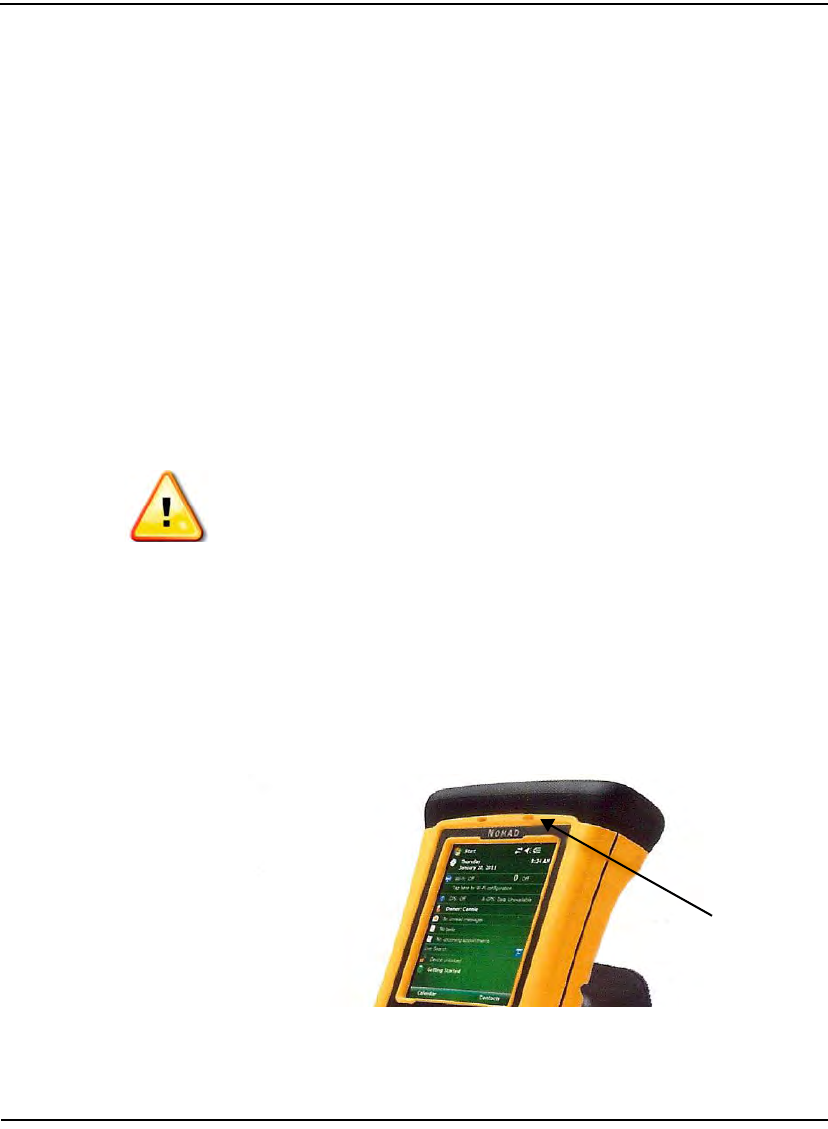
Maintaining and Repairing the Neptune Handheld System
N_SIGHT R900 User’s Manual for the Neptune Handheld System 9-15
Other factors that may have some impact on battery life include heavy
usage of the Bluetooth radio and heavy processing by the CPU, but
these factors are typically less significant.
Charging the Battery
You can charge the battery in the unit or apart from the unit with an
external battery charger (sold separately as an accessory). Connect the
power adapter for your country to the power cord and attach to the
power supply. Plug into an electrical outlet and plug the barrel end of
the power supply into the unit. The unit will be charged in about 4.5
hours.
A full charge is indicated by the battery LED (right side of the unit)
turning green. The recommended temperature range for charging is
between +32 °F and +113 °F (0 °C and +45 °C). If the battery
temperature is outside of this range, the battery will not charge.
Checking the Battery Status
To check the status of the battery, place the Nomad in a communication
cradle. Then, check the battery indicator in the upper right portion of the
unit, shown in Figure 9.11.
Figure 9.11 Battery Status Indicator on Nomad
Be sure to only use the power supply included with your unit. Use of
other adapters may void the product warranty.
Battery LED
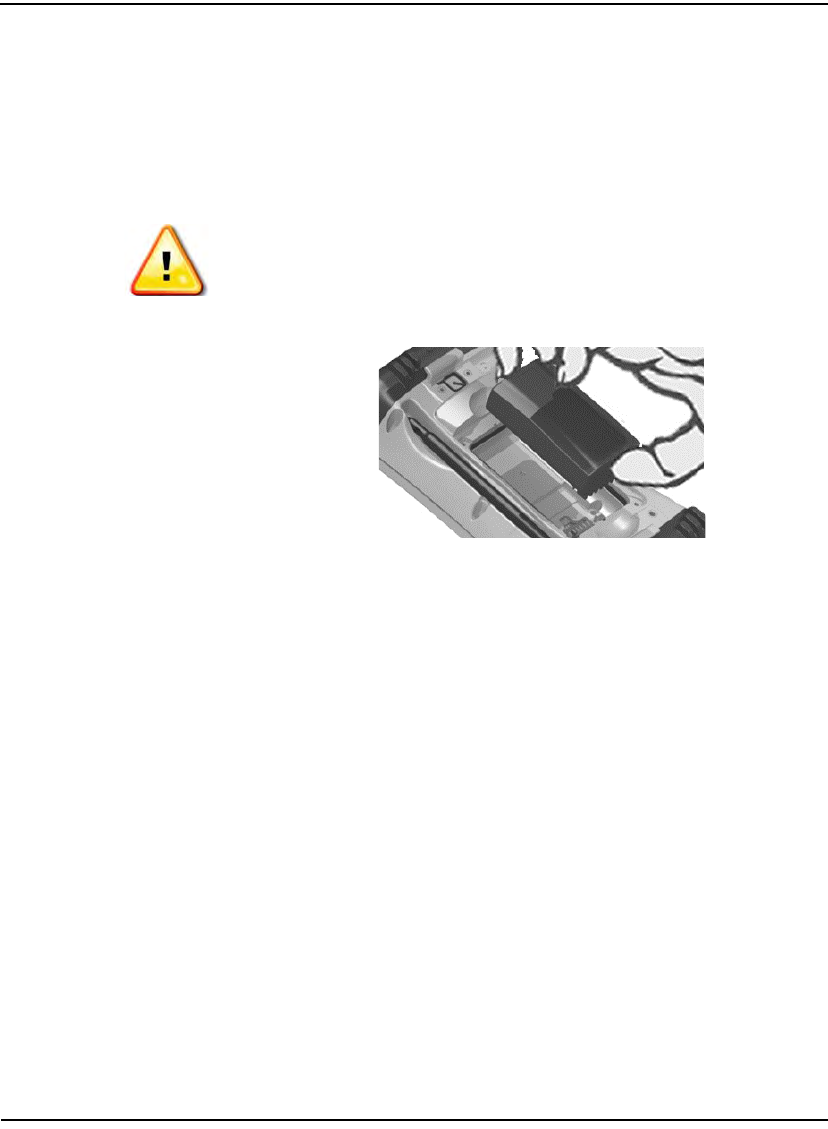
Maintaining and Repairing the Neptune Handheld System
9-16 N_SIGHT R900 User’s Manual for the Neptune Handheld System
Replacing the Battery
The unit was designed to be able to replace the battery quickly without
resetting it. The unit saves enough power (in Replace Battery mode) that
if you swap the battery within approximately one minute, it will not
trigger a reset.
.
Figure 9.12 Changing the Nomad Battery
To replace a battery, perform the following steps.
1 Close open applications and save data in case the battery exchange
takes too long.
2 Remove the hand strap from the unit.
3 Enter the Replace Battery mode.
This ensures that alarms will not wake up the unit while changing
the battery.
4 Press and hold the Power key until you see the five-second prompt
then release. The menu appears and allows you to tap Replace Bat-
tery.
5 Use the supplied stylus or a small #1 Philips head screwdriver to
loosen the four screws in the battery door.
6 Remove the battery from the unit.
7 Quickly insert the replacement battery into the unit.
If the saved power runs out before the new battery is installed, the unit will reset.
This will not impact saved data, programs, or configuration, however unsaved
data will be lost and the time settings will need to be reset.
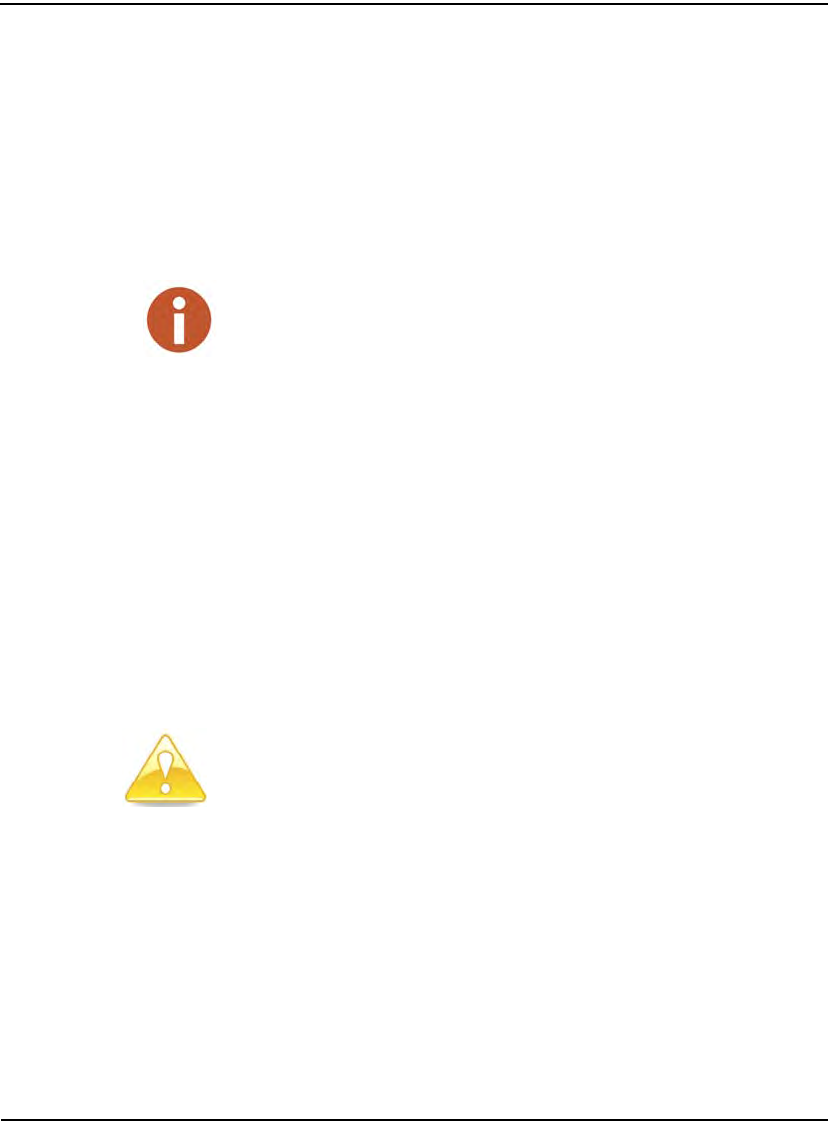
Maintaining and Repairing the Neptune Handheld System
N_SIGHT R900 User’s Manual for the Neptune Handheld System 9-17
8 Place the battery door over the battery, with the flat side of the bat-
tery door at the top of the unit. Use the stylus or screwdriver to fin-
ger-tighten the four screws.
9 Replace the hand strap.
10 Power on the unit to resume operation.
Calibrating the Nomad Battery
The battery has an internal gauge that provides an estimate of the
amount of energy in the battery as it charges and discharges. If your
battery is showing inaccuracy in the power gauge or large jumps in
capacity (such as the power is reading 50% and goes dead shortly
thereafter), it may need calibration.
Tap Start | Settings | System | Power | Calibration to see if the
message reads Calibration recommended or Calibration not necessary. If
calibration is recommended or the battery is reporting inaccurately,
perform the following steps.
1. Use the plug to connect the power supply, or place the handheld in
the cradle.
2. Ensure the temperature is between +32 °F and +113 °F (0 °C and
+45 °C) while charging.
3. Tap Start Calibration.
Neptune recommends calibrating the battery if the battery is deeply
discharged, if it is replaced with a new battery, or once every three months.
The unit must remain connected to the power during the calibration or
you may need to restart the process.
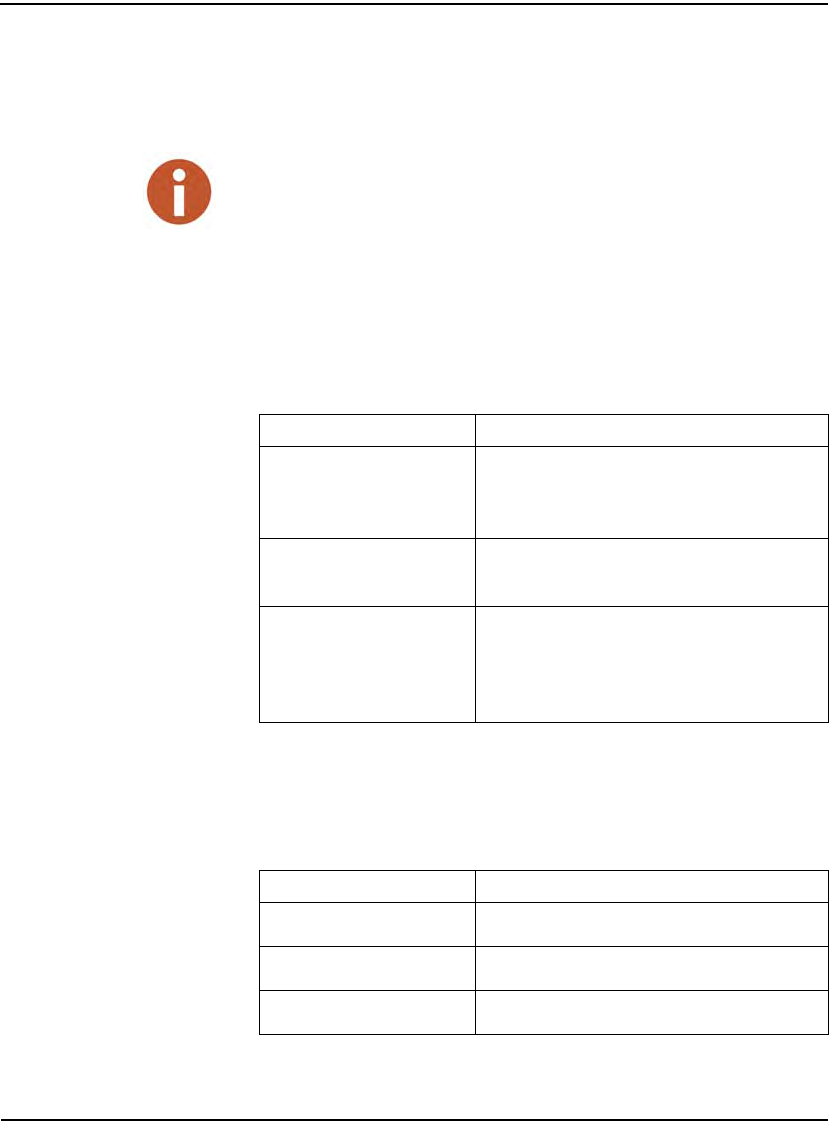
Maintaining and Repairing the Neptune Handheld System
9-18 N_SIGHT R900 User’s Manual for the Neptune Handheld System
During the calibration process, the Power key is disabled
temporarily and the backlight is turned up to 100%.
4. To stop the calibration process, tap Start | Settings | System |
Power | Calibration | Stop Calibration.
Refer to Table 9.1 for possible error messages that can occur during
calibration.
Notification LEDs
At the top of the Nomad are two LEDs that provide status information.
The LED states are shown in the following table.
It takes up to 24 hours to complete the calibration. When finished, a notification
message states that the calibration is complete. Neptune recommends not using your
unit during the calibration process.
Table 9.1 Calibration Error Messages
Error Message Part Solution
Battery is not charging,
aborting Battery temperature may be out of range.
Wait until battery temperature settles and try
again.
Discharge became
invalid, restarting Calibration will restart itself.
AC power is in an
unknown or uncontrolled
state; aborting
Plug in unit and restart calibration. Try a
different power supply and restart
calibration. If it continues to fail, have the
unit serviced.
Table 9.2 Calibration Error Messages
Right LED Function
Off On battery power
Solid yellow Charging on power supply
Solid green Fully charged on power supply
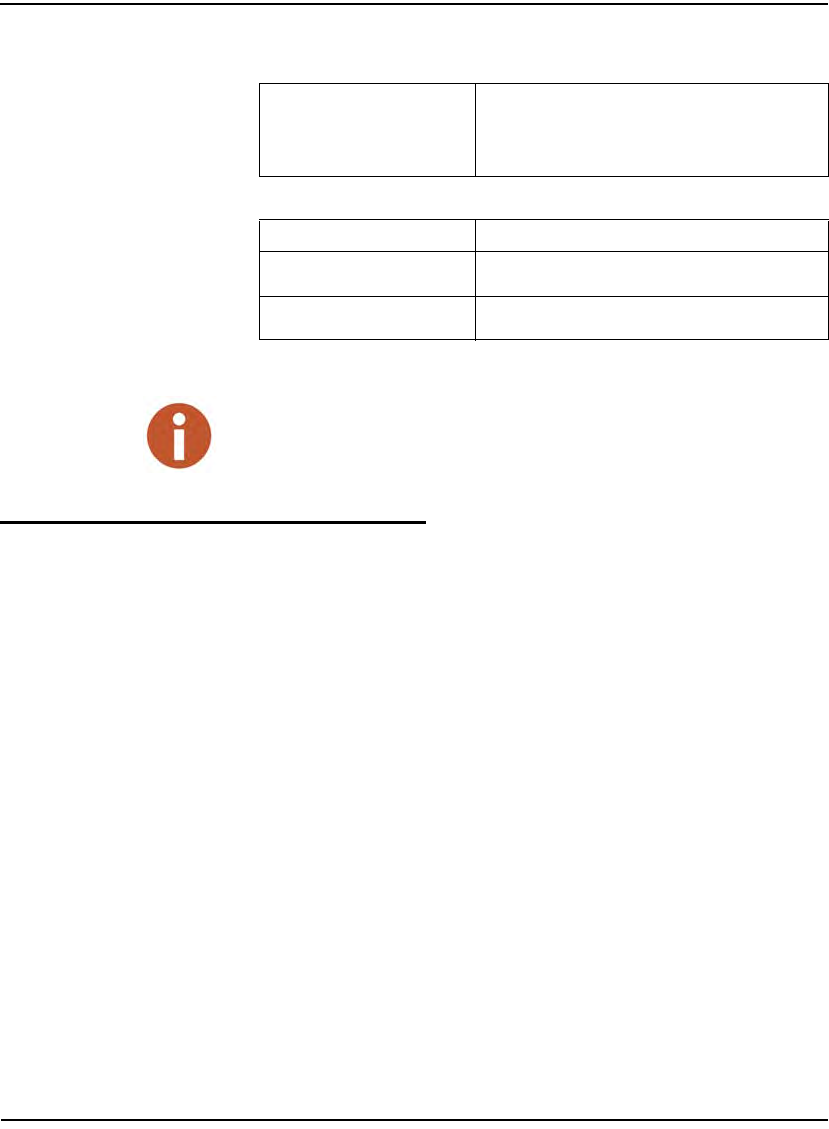
Maintaining and Repairing the Neptune Handheld System
N_SIGHT R900 User’s Manual for the Neptune Handheld System 9-19
Maintaining the R900 Belt Clip Receiver
Recommended Maintenance
To ensure a watertight seal occasionally inspect the battery door gasket
and bottom plug door to make sure they are free from dust and debris.
These can be cleaned by wiping with a damp cloth. If any wear or tear is
observed please contact Neptune Customer Support for repair. Refer to
“Contacting Customer Support,” on page 1-5.
Battery Life
The lithium ion battery life is dependent upon the usage and operating
environment. Under normal operating conditions, the battery should be
replaced every two years.
Blinking yellow Battery problem during charging
(temperature out of range, defective or
missing battery)
Left LED Function
Off No notifications and phone off
Blinking yellow Microsoft notifications
Table 9.2 Calibration Error Messages
If the left LED is blinking green, the battery power is being consumed due to the
cellular modem being turned on, even when the device is suspended.

Maintaining and Repairing the Neptune Handheld System
9-20 N_SIGHT R900 User’s Manual for the Neptune Handheld System
Tips for Extending the Battery Life
Neptune suggests the following tips for the lithium ion battery in your
R900 BCR.
•Room temperature: Try to store the battery at room temperature at
all times.
•Cold temperatures: Keep the unit as warm as possible. If feasible,
keep it inside your coat or a vehicle when not in use.
•Keeping a charge: Try to maintain at least a 40% charge on the
battery to extend battery life.
Charging the Battery
You can charge the battery in the unit or apart from the unit with an
external battery charger (sold separately as an accessory). Connect the
power adapter for your country to the power cord and attach to the
power supply. Plug into an electrical outlet and plug the barrel end of
the power supply into the unit. The unit will be charged in about 4.5
hours.
You can charge the battery for the unit R900 BCR in one of two ways:
• Through the USB port
• Using the external battery charger, (sold separately as an accessory
PN: 13148-001).
Using the USB Port
To charge the battery using the USB port, complete the following steps.
1 Using the supplied USB cable, connect the R900 BCR to a USB
wall or car charger.
The charger must be capable of supplying at least 500 mA to charge the battery while
OFF, and 1A to charge the battery while running. For instructions on using the
standalone charger see the manual included with it.
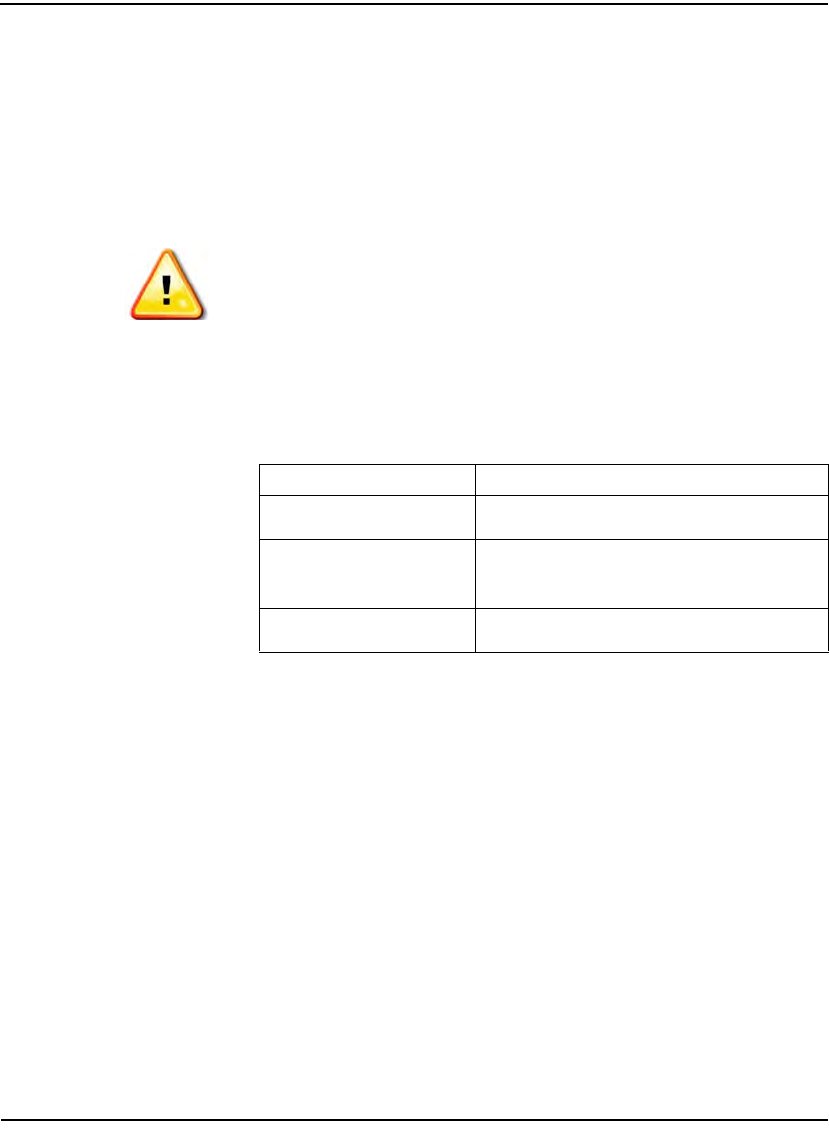
Maintaining and Repairing the Neptune Handheld System
N_SIGHT R900 User’s Manual for the Neptune Handheld System 9-21
2 Connect the power adapter for your country to the power cord and
attach to the power supply.
3 Plug the power adapter into an electrical outlet.
4 Plug the micro USB into the R900 BCR.
The unit is charged in about eight hours.
Charging Considerations
Refer to the following table for charging considerations.
Be sure to only use the power supply included with your unit. Use of
other adapters may void the product warranty.
Table 8.3 Charging Considerations
Consideration Description
Green LED Full charge
Temperature range Recommended between +32 °F and +113
°F (0 °C and +45 °C)
Outside range Battery will not charge
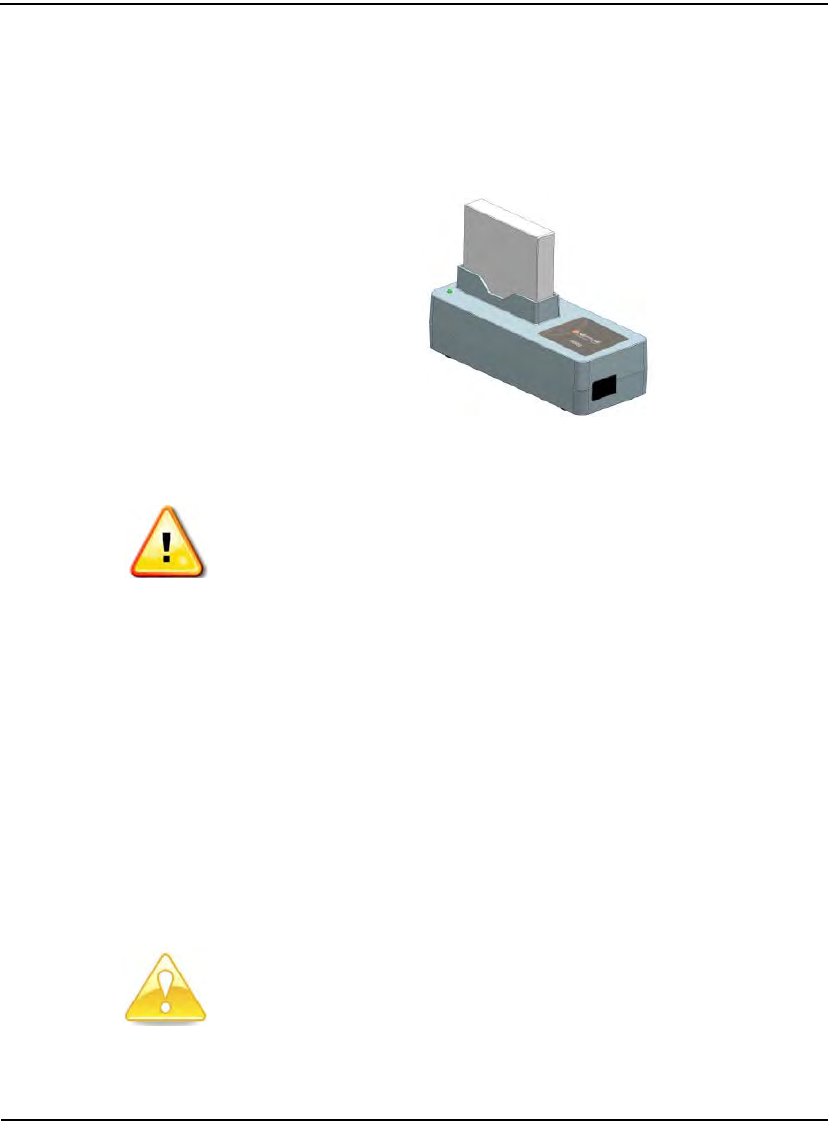
Maintaining and Repairing the Neptune Handheld System
9-22 N_SIGHT R900 User’s Manual for the Neptune Handheld System
Using the Charger
The supported lithium ion battery charger is designed to charge the
Neptune 3.7VDC 5000mAh Li-Ion battery P/N 13143-001. The
following illustration shows the supported external battery charger, sold
separately as an accessory PN: 13148-001.
Figure 9.13 External Battery Charger
To charge the battery using the external battery charger, complete the
following steps.
1 Place the charger on a flat and stable surface.
2 Connect the charger to an AC wall plug using the AC cable deliv-
ered together with the device.
The three colors of the LED flash for about 1 second each (red –
yellow – green). After that, the LED sequence flashes, and the
charger is ready for use.
3 Remove the charger from the wall plug if it will not be used for
long period time.
Do not try to charge any other battery with this device.
If an error is identified, the LED turns red. Immediately remove the
battery from the charger.
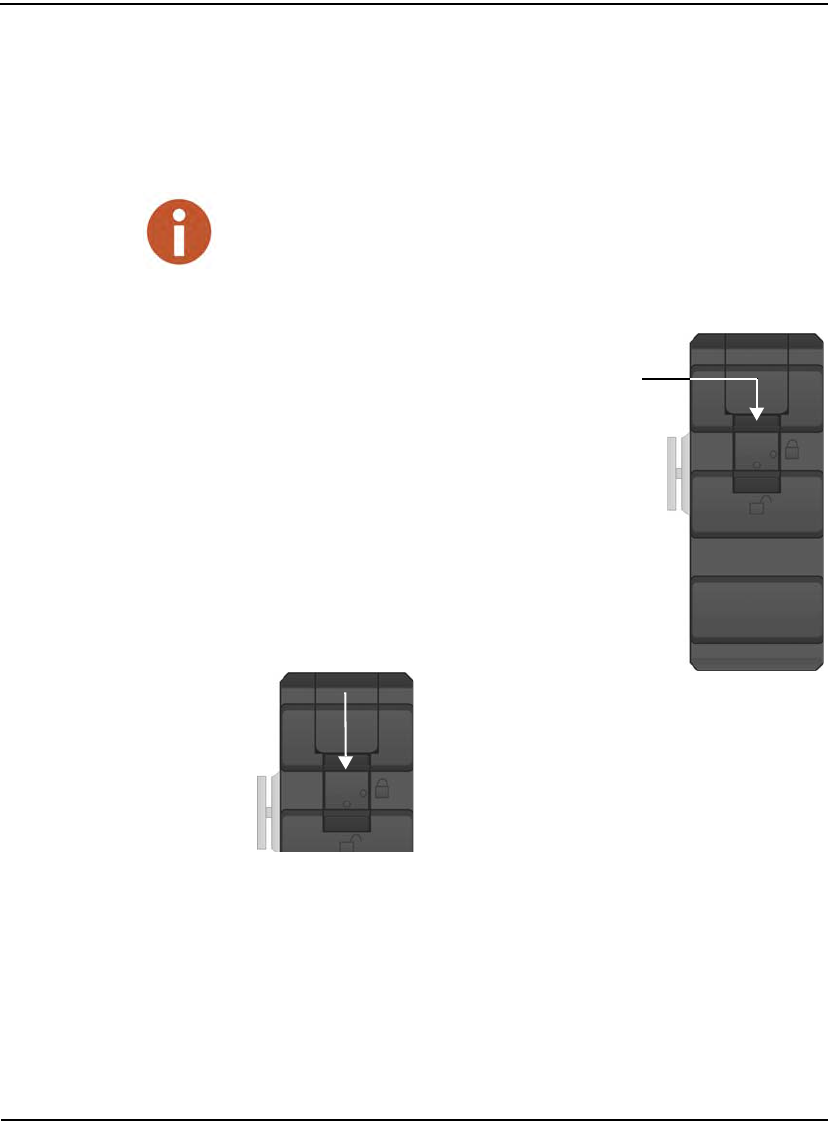
Maintaining and Repairing the Neptune Handheld System
N_SIGHT R900 User’s Manual for the Neptune Handheld System 9-23
Replacing the R900 Belt Clip Receiver Battery
The following section explains how to replace the battery for the
R900 BCR.
Removing the Battery
To remove the battery from the
R900 BCR, complete the following
steps.
1 Hold the R900 BCR firmly with left
side facing up. See Figure 9.14.
Figure 9.14 R900 Belt Clip Receiver Side View
2 Push the lock latch down toward the
unlock symbol. See Figure 9.15.
3 Once the latch is in place, push the latch
button inward to open the battery
compartment door.
Figure 9.15 Latch Direction to Open
Be sure the battery is free of dust and debris, and only replace the battery in a dry
environment.
Battery
door
latch
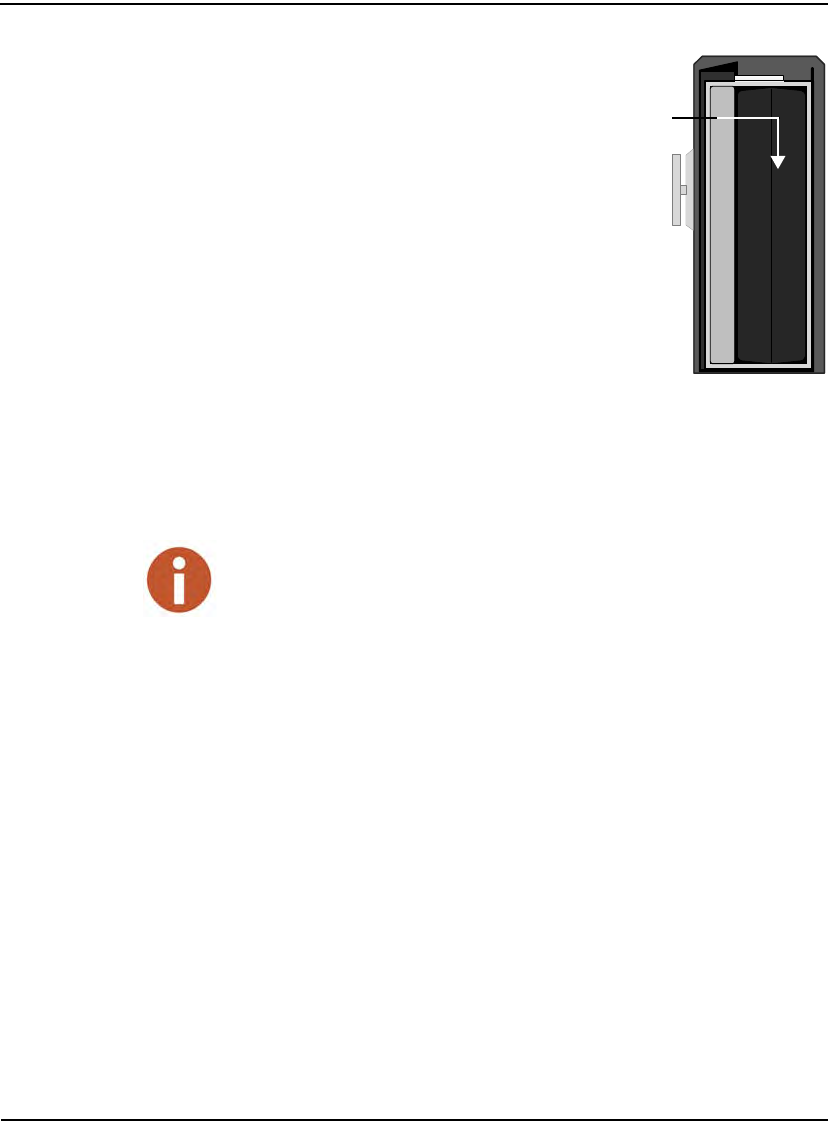
Maintaining and Repairing the Neptune Handheld System
9-24 N_SIGHT R900 User’s Manual for the Neptune Handheld System
4 Pull the door toward you to access
the battery.
5 Hold the R900 BCR vertically, right
side facing up, with one hand over
the open compartment.
The battery is located on the right
side. See Figure 9.16.
Figure 9.16 Battery Inside Compartment
6 Vigorously tap the top of the R900 BCR until the battery loosens
for removal
Replacing the Battery
To replace the battery in its compartment, complete the following steps.
1 Open the battery door of the R900 BCR. See Steps 1 through 4 of
“Removing the Battery,” on page 9-23.
2 Have the front view of the R900 BCR facing up.
3 Hold the battery horizontally with the label facing down.
Battery
inside
The battery can be difficult to remove when fully charged.

Maintaining and Repairing the Neptune Handheld System
N_SIGHT R900 User’s Manual for the Neptune Handheld System 9-25
4 Inset the battery into the R900 BCR until the battery snaps in place.
Figure 9.17 R900 Belt Clip Receiver Battery Inside Compartment
5 Close the battery door, and lock it.
LED Status Indication
The battery charging starts immediately after inserting a battery pack
into the charging cradle. The LED color indicates the status of the
charger and charge process. The LED states are shown in the following
table.
Battery
inside
compartment
Battery
Battery label
underneath
The battery should be replaced every two years.
Table 9.4 LED Status Indicators
LED Indicates
Red, yellow, green, or
OFF Startup initialization when applying power
OFF No battery inserted
Yellow Battery charging
Solid green Battery charged successfully
Red Error condition
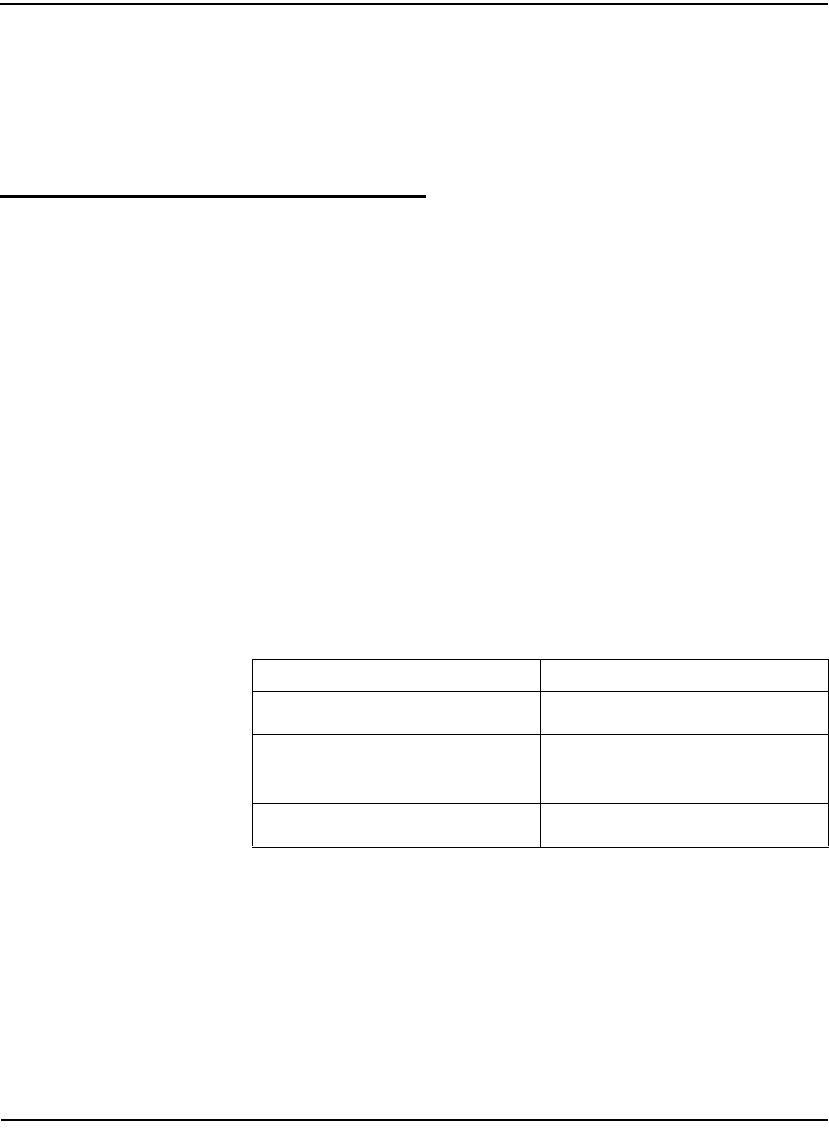
Maintaining and Repairing the Neptune Handheld System
9-26 N_SIGHT R900 User’s Manual for the Neptune Handheld System
Checking the Battery Status
The battery indicator is one of the four visible on the front of the
R900 BCR. The battery percentage can also be seen on the status screen
for the R900 BCR.
Recommended Spare Parts
Ordering Parts
To order new parts for one of the Neptune handheld system devices,
refer to the following tables to find the part number that you need. Then,
place an order for the parts by contacting your local Neptune
Distributor. You may also contact Neptune Customer Service at (800)
645-1892. Business hours are Monday through Friday, 7:30 a.m. to 4:30
p.m. Central time.
CE5320 Spare Parts
Neptune recommends that you keep the following spare parts on hand
for each CE5320 that you have. Use Table 8.5 to find the part number of
the item that you need.
Nomad Spare Parts
Neptune recommends that you keep the following spare parts on hand
for each Nomad that you have. Use Table 9.6 on Page 9-27 to find the
part number of the item that you need.
Table 8.5 CE5320 Part Numbers
Description Part Number
Lithium ion battery 12249-047
Spare hand straps
(package of 4) 13245-008
Spare shoulder strap 12249-014
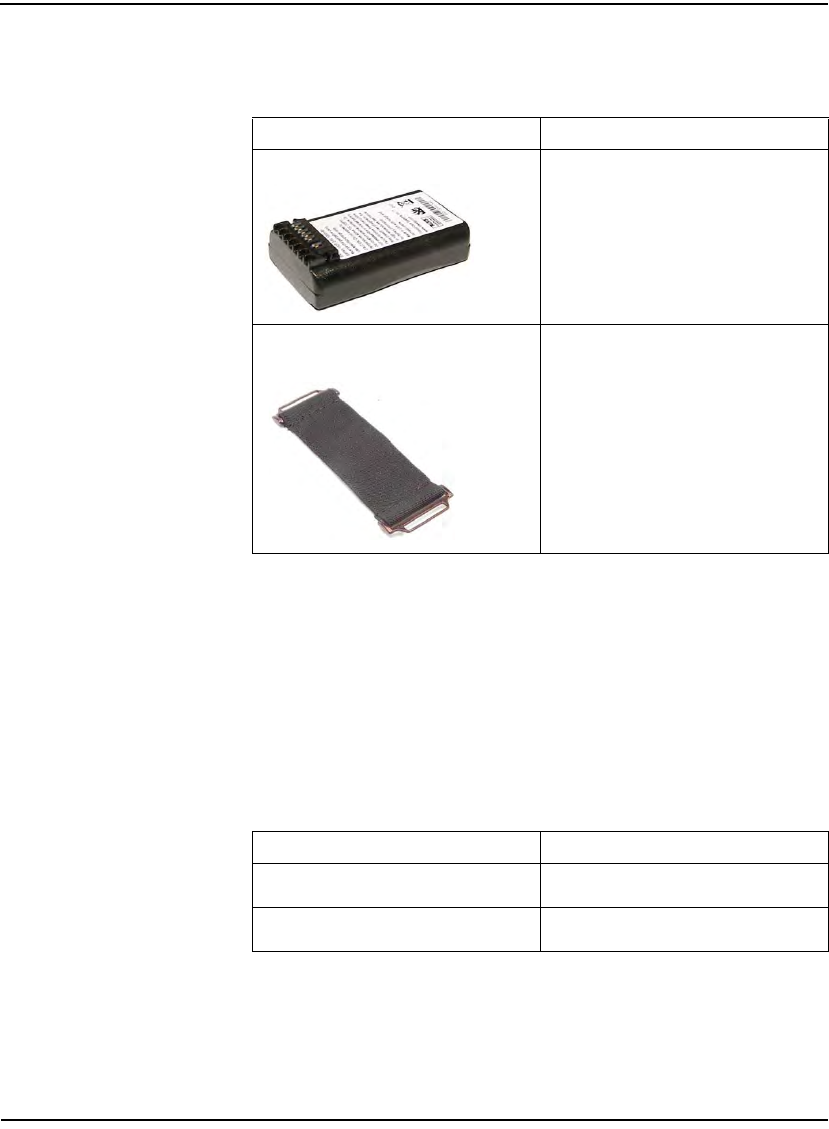
Maintaining and Repairing the Neptune Handheld System
N_SIGHT R900 User’s Manual for the Neptune Handheld System 9-27
To obtain a replacement stylus, Neptune recommends that you purchase
one from a local electronics store. A Belkin model P45470 for the HP
iPAQ 2200 fits into the stylus slot of the handheld.
R900 Belt Clip Receiver Spare Parts
Neptune recommends that you keep the following spare parts on hand
for each R900 BCR that you have. Use Table 8.7 to find the part number
of the item that you need.
Table 9.6 Nomad Part Numbers
Description Part Number
Lithium ion battery 13245-002
Spare hand straps
(package of 4) 13245-008
Table 8.7 R900 Belt Clip Receiver Part Numbers
Description Part Number
R900 BCR spare battery charger 13148-001
R900 BCR replacement battery 13143-001
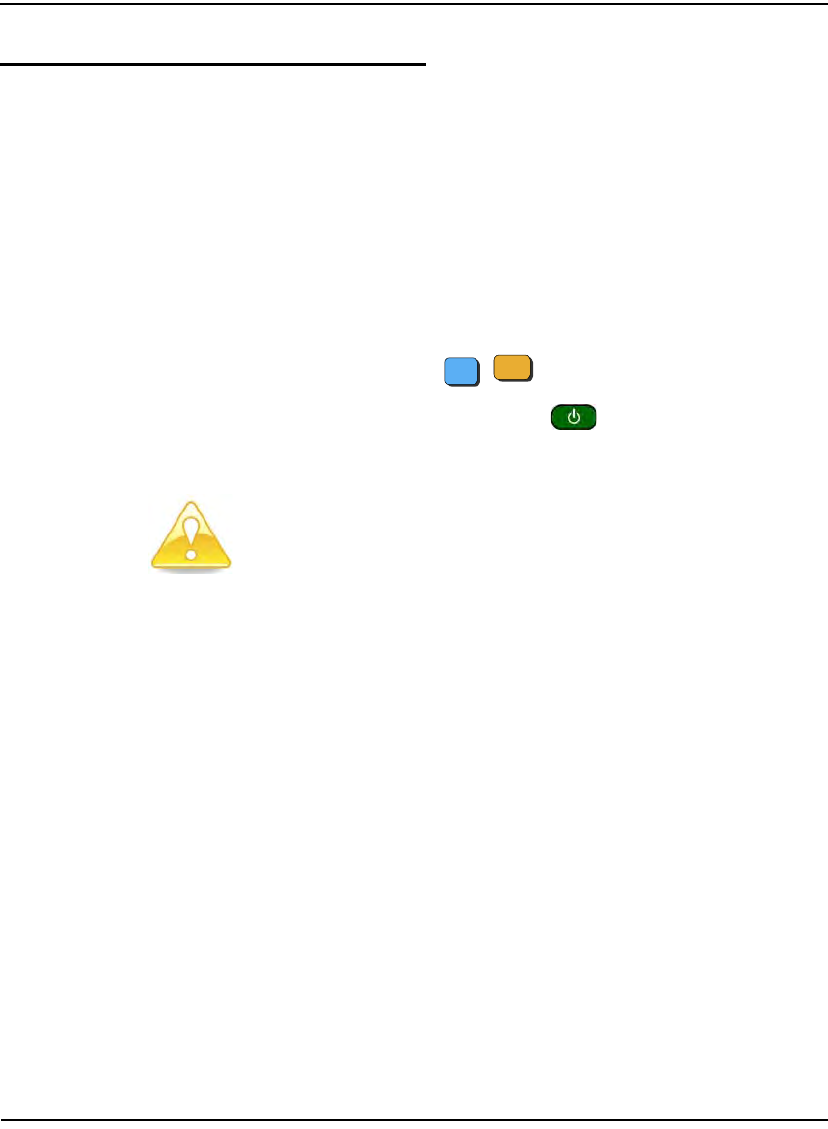
Maintaining and Repairing the Neptune Handheld System
9-28 N_SIGHT R900 User’s Manual for the Neptune Handheld System
Returning your Neptune Handheld System
Use the following procedure to pack the Neptune handheld system so
that it can be shipped without damage to Neptune.
1 Contact a Neptune Customer Support Specialist to confirm whether
or not the handheld should be shipped. Contact Customer Support
at (800) 647-4832 to request a Return Material Authorization
(RMA) number. The RMA number must be legibly printed on the
outside of the box.
2 Turn the handheld off by doing the following:
• Pressing BLUE , on the CE5320 handheld
• Pressing and holding the I/O key on the Nomad handheld
until the five-second message appears then release. Now press
power on the menu and then select Yes to confirm.
3 Repack the handheld in the original packing box that you received
from Neptune, making certain to use plenty of packing material to
absorb shocks and vibrations caused during shipping.
4 Send the package to the address of the repair facility as directed by
Neptune.
F1
Use the original packing box that you received from Neptune. The handling
involved in land and air transport often subjects the handheld to impact
beyond that which occurs during normal use. The original packing box is
designed to reduce the vibrations and shocks caused during shipping. If the
handheld is not properly packaged, it can be damaged during shipping.
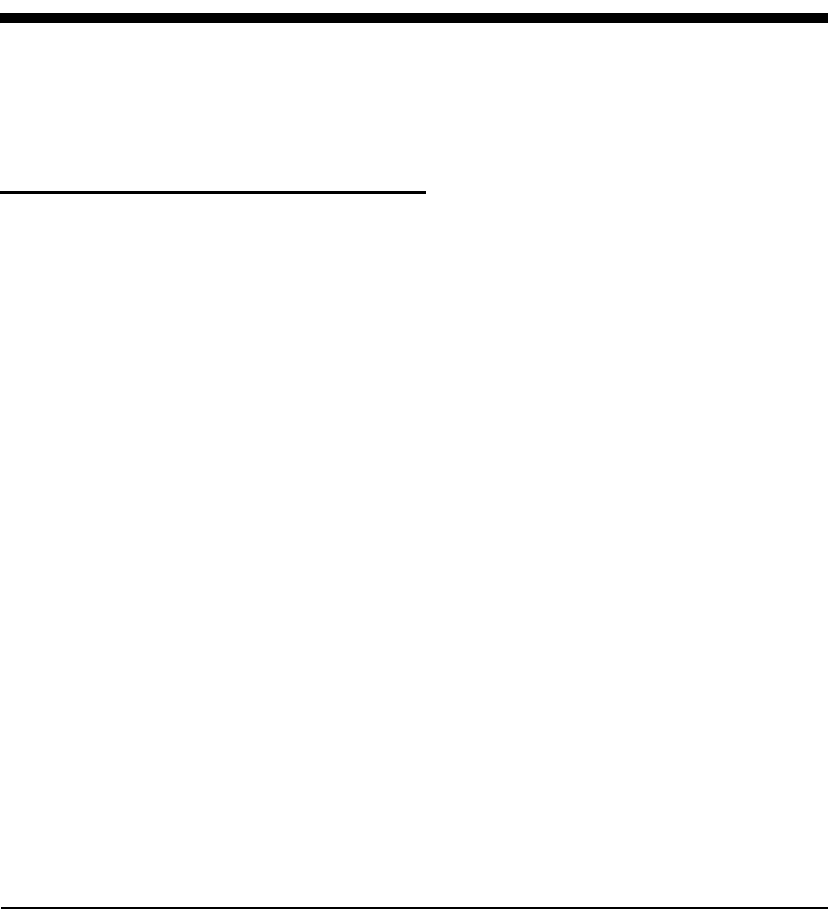
N_SIGHT R900 User’s Manual for the Neptune Handheld System 10-1
10 Troubleshooting
Use the information in this chapter to solve any problems. If you still
cannot solve the problem, contact a Neptune Customer Support
Specialist. For help in contacting Neptune, refer to the topic “Contacting
Customer Support,” on page 1-5.
Troubleshooting the Handheld
This section contains questions and answers for troubleshooting the
Neptune handheld system. It is in the format of questions that can arise
if a problem occurs. Answers represent possible solutions to these
problems.
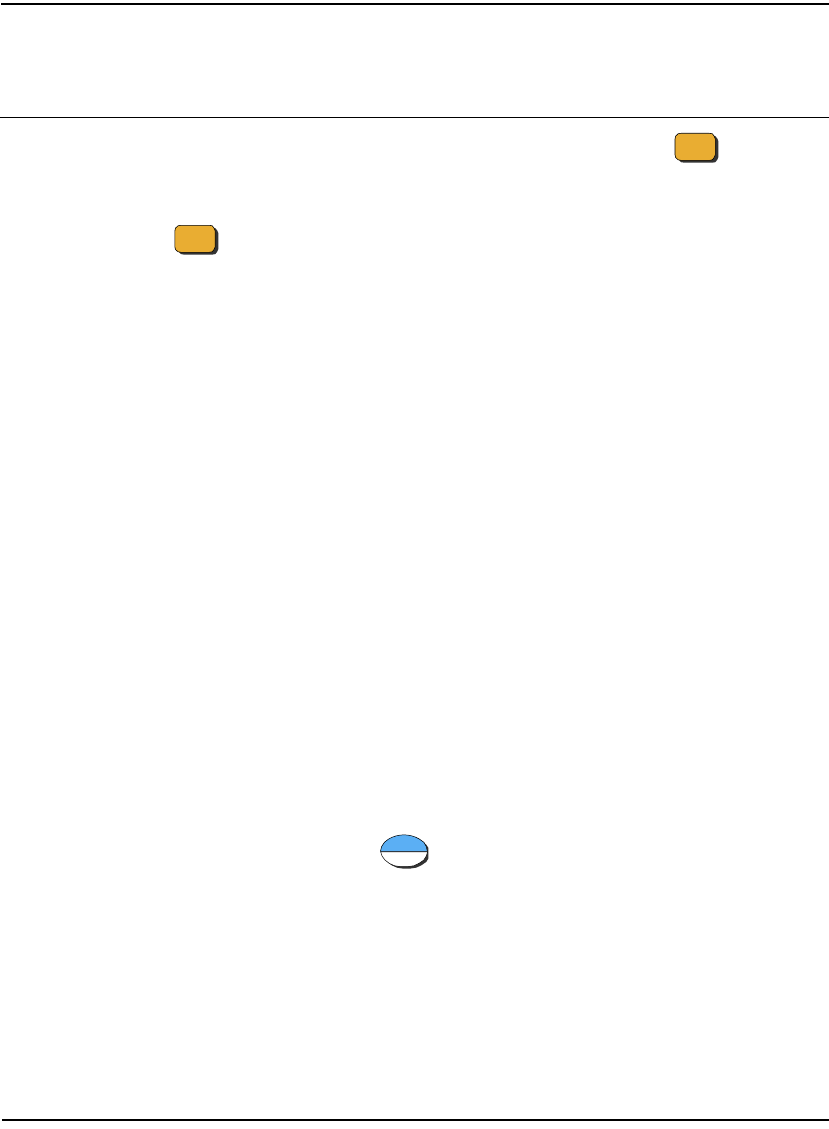
Troubleshooting
10-2 N_SIGHT R900 User’s Manual for the Neptune Handheld System
Basic Tasks for the CE5320B Handheld
Question Answer
The display is empty, and the
CE5320B does not beep when I press
a key.
The CE5320B can be turned off. Press the I/O key to turn
the unit on.
When I press the I/O key, the
CE5320B does not turn on.
The battery can be too low. Place the CE5320B handheld in a
communication cradle. Then, check the color of the battery
indicator in the bottom right corner of the CE5320B handheld. The
indicator turns red if the battery is low.
WARNING: On Battery ___ % (indicating a very low battery life
remaining).
If this message appears, place the CE5320B Handheld in the
cradle and allow it to remain until the indicator turns green,
indicating that the battery is fully charged. Recharging the battery
can take from three to six hours.
The CE5320B does not refresh when I
place it in a communication cradle. If the battery indicator is not red, make sure that the
communication cradle is connected to a proper electrical outlet.
Check that all cables are secure.
When trying to log in, I receive the
error “DB Uninitialized.” Check that a route is loaded to the handheld and the Reader ID is
set up in the N_SIGHT R900 host software.
Reload the handheld.
Add a bullet stating Press Synchronize to communicate with the
database.
The CE5320B handheld locks and
does not respond when I press keys. Press .
Reset the unit. For help with this task, refer to the procedure
“Resetting the CE5320B,” on page 10-7.
F1
F1
ESC
INS
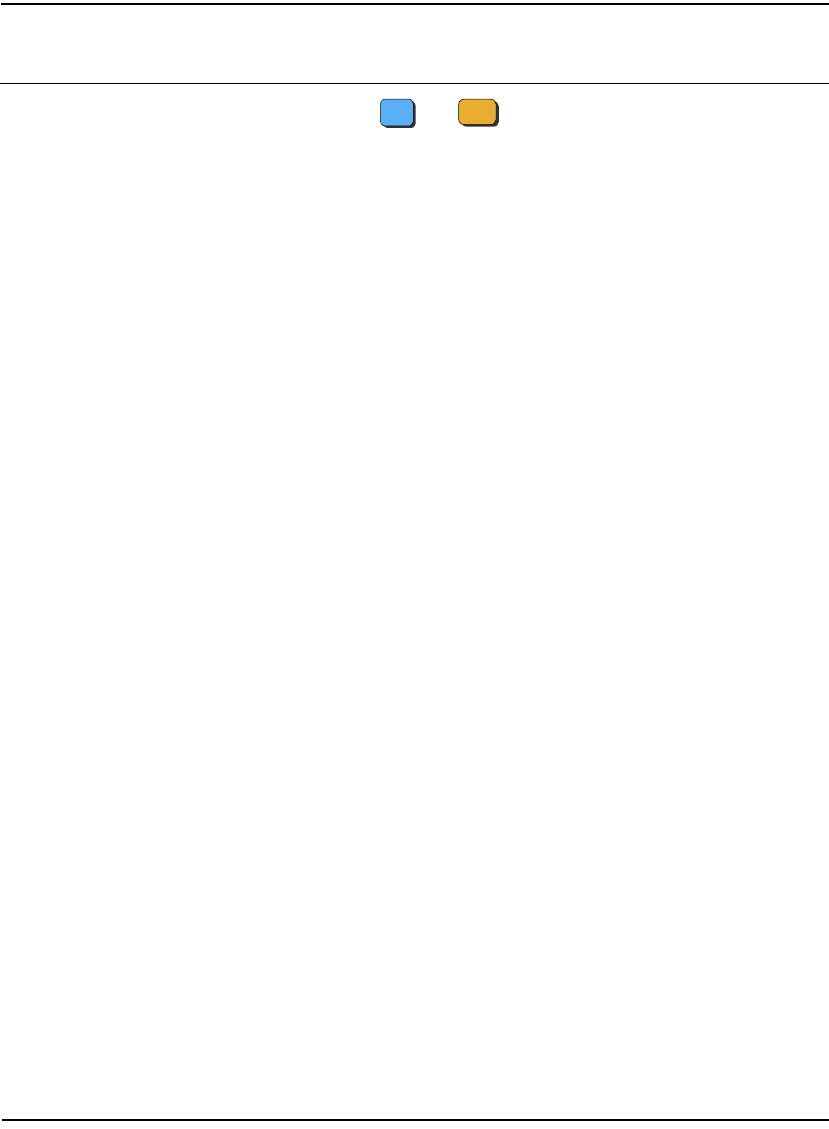
Troubleshooting
N_SIGHT R900 User’s Manual for the Neptune Handheld System 10-3
Question Answer
The display contrast is weak or the
display background is very dark. Press and to brighten the display.
The CE5320B handheld has been exposed to temperatures
outside the range of -30ºC to +50ºC (-22ºF to 122ºF). Short
exposure to temperatures lower or higher than these can cause
the display to turn very dark or very light until the unit returns to the
recommended operating temperature.
The CE5320B handheld does not turn
off automatically or manually. The CE5320B handheld is in a communication cradle, in which
case the CE5320B handheld remains on until you remove it from
the cradle and then turn it off.
When I try to communicate with the
host computer, I receive the error “Last
Sync Failed.”
I am unable to load or unload data to or
from the host computer.
Make sure that you have set up the communications peripheral
you are using according to the directions provided in “Connecting
to the Host Computer and Power Supply,” on page 3-5 or
“Connecting to the Host Computer and Power Supply,” on page
4-4.
Check that all the cables are correctly attached and secure.
At the Synchronize screen (N_SIGHT R900 Login screen), confirm
that the server name is correct.
F3
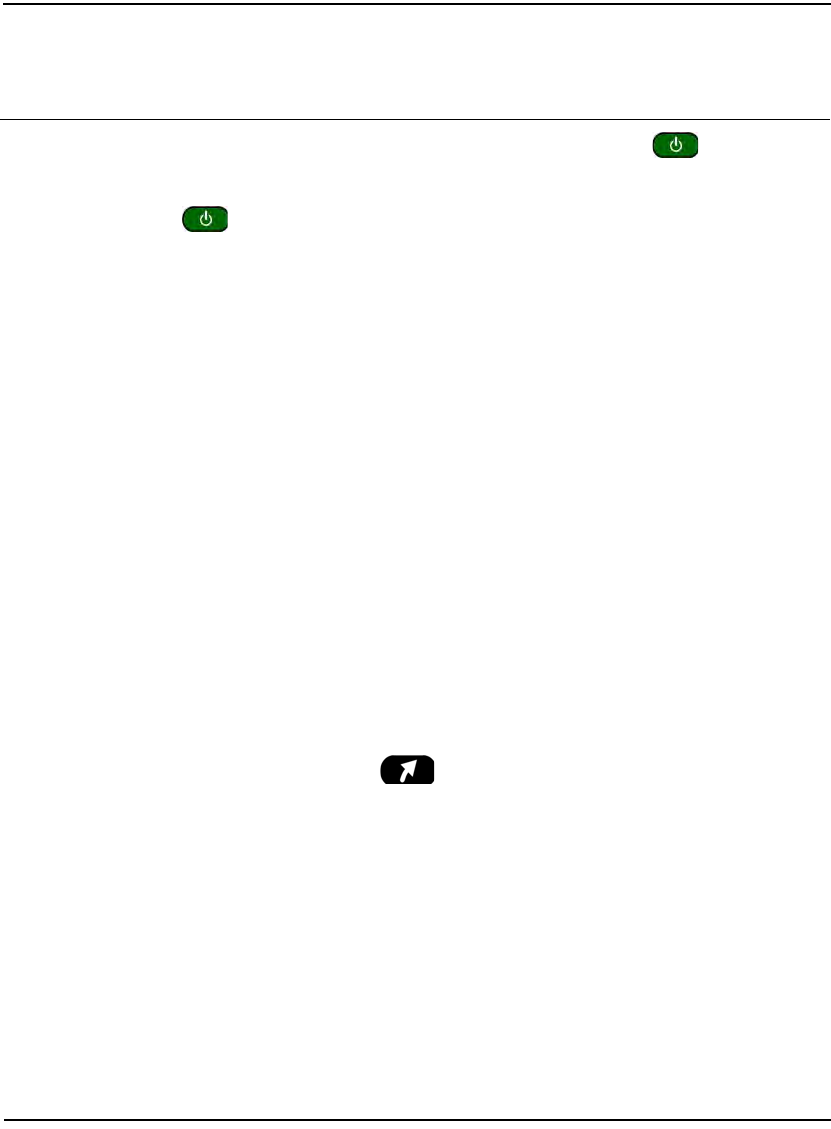
Troubleshooting
10-4 N_SIGHT R900 User’s Manual for the Neptune Handheld System
Basic Tasks for the Nomad Handheld
Question Answer
The display is empty and the Nomad
does not beep when I press a key. The Nomad can be turned off. Press the I/O key to turn the
unit on.
When I press the I/O key, the
Nomad does not turn on.
The battery can be too low. Connect the Nomad to its power. Then,
check the color of the battery indicator in the bottom right corner of
the Nomad. The indicator turns red if the battery is low.
WARNING: On Battery ___ % (indicating a very low battery life
remaining).
If this message appears, place the Nomad in the cradle, and allow
it to remain until the indicator turns green, indicating that the
battery is fully charged. Recharging the battery can take from three
to six hours.
The Nomad does not refresh when I
place it in a communication cradle. If the battery indicator is not red, make sure that the
communication cradle is connected to a proper electrical outlet.
Check that all cables are secure.
When trying to log in, I receive the
error “DB Uninitialized.” Check that the Reader ID is set up in the N_SIGHT R900 host
software.
Reload the handheld.
Press Synchronize to communicate with the DB.
The Nomad Handheld locks and does
not respond when I press keys. Press .
Reset the unit. For help with this task, refer to the procedure
“Resetting the CE5320B,” on page 10-7.
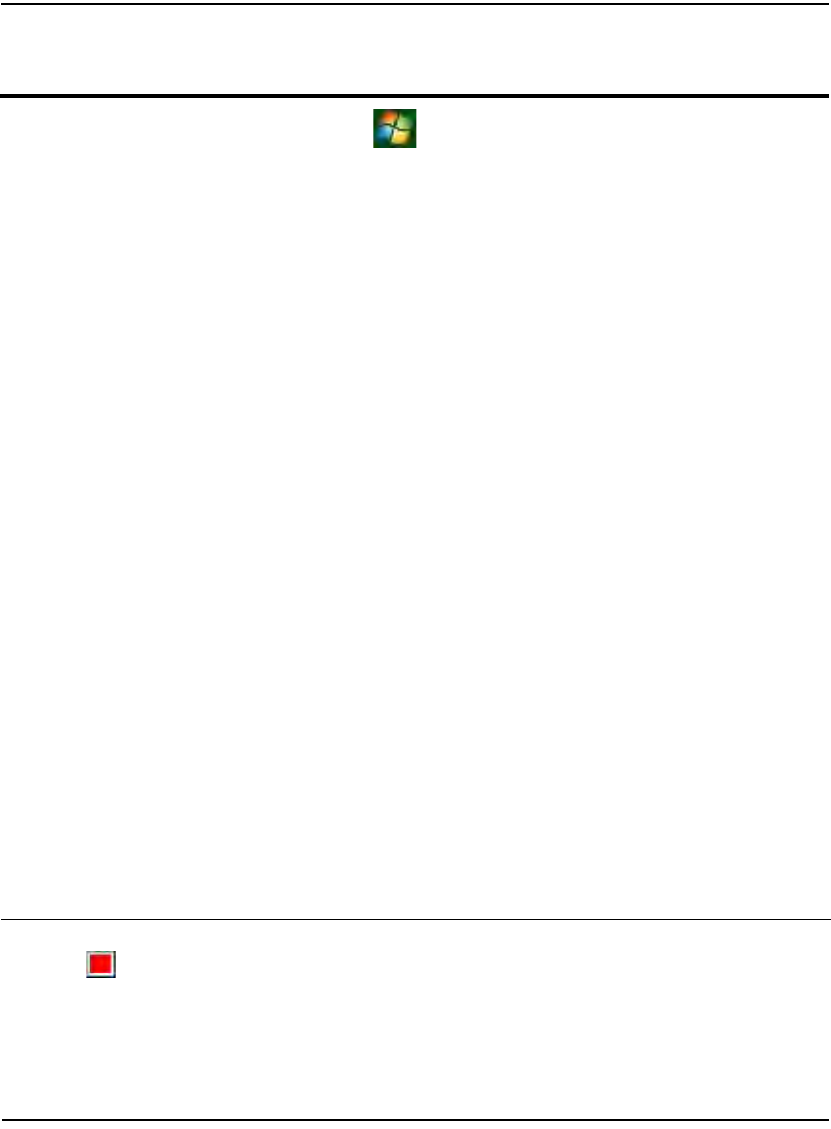
Troubleshooting
N_SIGHT R900 User’s Manual for the Neptune Handheld System 10-5
Reading-Entry Tasks
Question Answer
The display contrast is weak or the
display background is very dark.
Click in the upper left corner.
- Click Settings.
- Click the System tab at the bottom of the screen.
- Click Backlight at top center.
- Click the Brightness tab at the bottom of the screen.
- Adjust with the slider bar.
The Nomad handheld has been exposed to temperatures outside
the range of -30ºC to +50ºC (-22ºF to 122ºF). Short exposure to
temperatures lower or higher than these can cause the display to
turn very dark or very light until the unit returns to the
recommended operating temperature.
The Nomad does not turn off
automatically or manually.Check the screen timeout in the Settings |System |Backlight.
- Select "Turn off backlight if device is not used for."
- Select a time from the drop down.
The Nomad is in a communication cradle in which case the Nomad
remains on until you remove it from the cradle and then turn it off.
When I try to communicate with the
host computer, I receive the error “Last
Sync Failed.”
I am unable to load or unload data to or
from the host computer.
Make sure that you have set up the communications peripheral
you are using according to the directions provided in “Connecting
to the Host Computer and Power Supply,” on page 3-5 or
“Connecting to the Host Computer and Power Supply,” on page
4-4.
Check that all the cables are correctly attached and secure.
At the Synchronize screen (N_SIGHT R900 Login screen), confirm
that the server name is correct.
Question Answer
When I try to tag an account, the tag
indicator does not appear on the
display.
If your display does not show the tag indicator after you tag an
account, the tag option is not selected on the host computer. For
help in selecting this option, the host operator should refer to the
N_SIGHT R900 Online HTML Help.

Troubleshooting
10-6 N_SIGHT R900 User’s Manual for the Neptune Handheld System
Communication Tasks
Starting the N_SIGHT R900 Program
If you quit the N_SIGHT R900 application program by clicking OK in
the upper right corner of the screen, the handheld automatically returns
to the N_SIGHT R900 Login screen.
Loading Data Initially
When your handheld arrives, it should contain the file to load N_SIGHT
R900 and necessary data files to support that executable with those data
files already in their proper locations.
If any of these files are missing when you receive the handheld, or if any
are subsequently erased, several scenarios are possible.
Question Answer
I cannot get routes to load or
readings to unload. The problem can be hardware or software based. Try the following
solutions.
Hardware
Make certain that your system is set up as described in Chapter 3.
Check that cables and connectors are secure.
Software
Make certain that the software is set up as described in Chapter 3.
Check with the operator of the host computer to make sure that the
Communications Manager function or SQL Anywhere service is
running.
Check that routes are properly assigned.
These files do not include your route data that is downloaded from the host system
during the communications process.
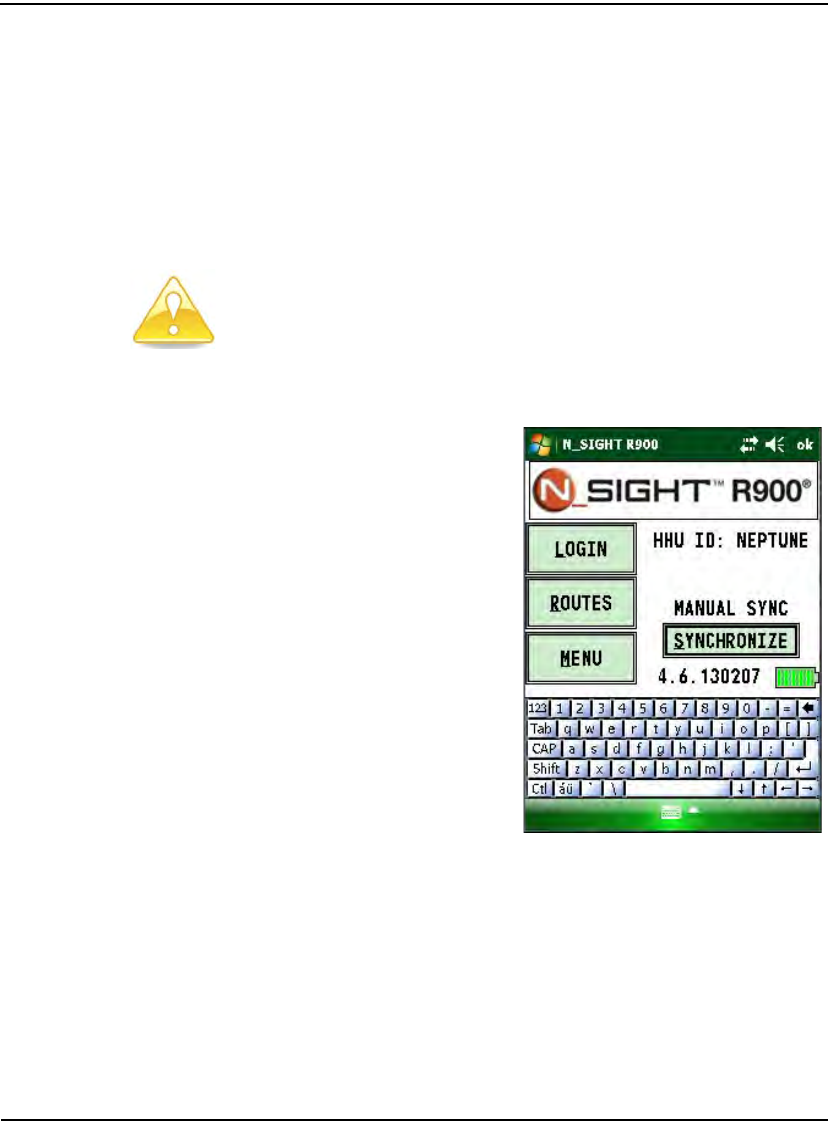
Troubleshooting
N_SIGHT R900 User’s Manual for the Neptune Handheld System 10-7
Missing Route Files
If a complete system is loaded but there are no route data files present,
the DB Uninitialized message appears when N_SIGHT R900 is
executed. Check the Reader ID in the N_SIGHT R900 host software.
Then, reload the handheld.
Resetting the CE5320B
Follow these steps to reset the CE5320B.
1From the N_SIGHT R900
Login screen, touch Menu
or press M. See Figure
10.1.
Figure 10.1 N_SIGHT R900 Login Screen
Never reset the CE5320B without first checking with your supervisor. Under
certain circumstances, resetting the CE5320B will cause you to lose data.
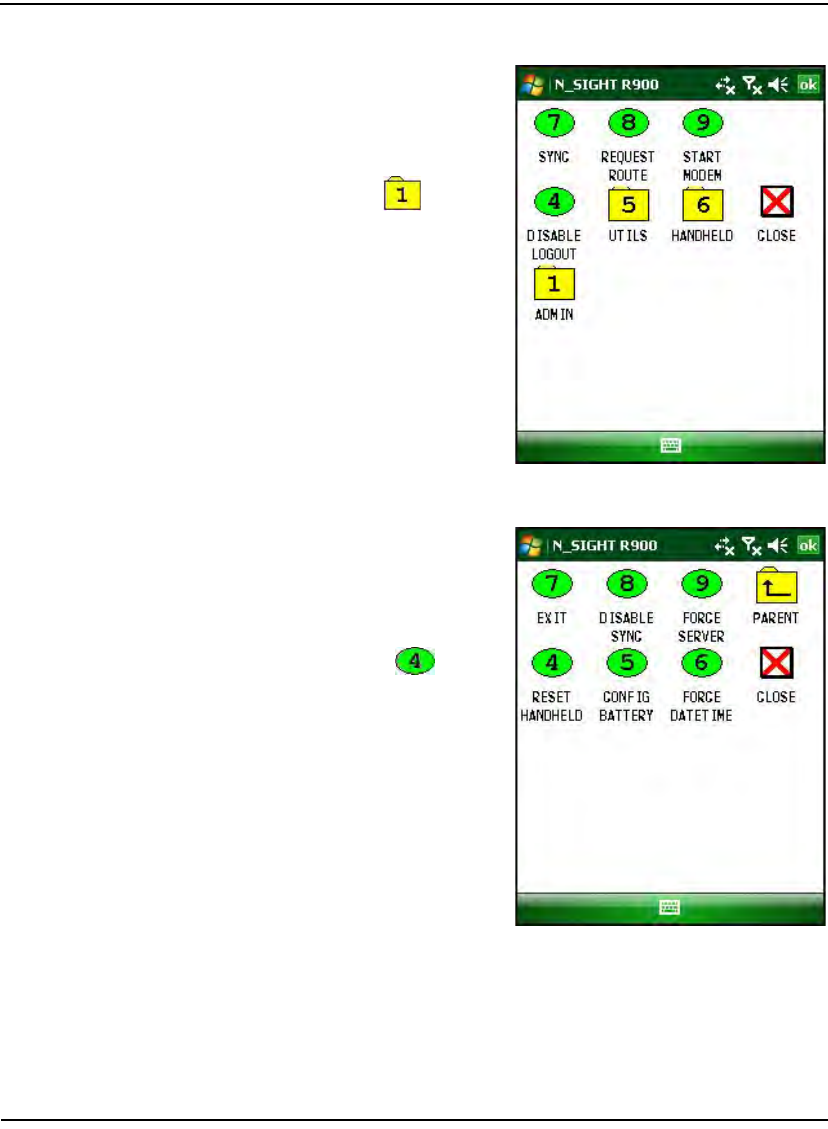
Troubleshooting
10-8 N_SIGHT R900 User’s Manual for the Neptune Handheld System
The N_SIGHT R900
Main Menu appears, as
illustrated in Figure 10.2.
2 Touch ONE for
ADMIN.
Figure 10.2 N_SIGHT R900 Main Menu
The Handheld Menu
appears as illustrated in
Figure 10.3.
3 Touch FOUR for
RESET HANDHELD.
Figure 10.3 N_SIGHT R900 Admin Menu
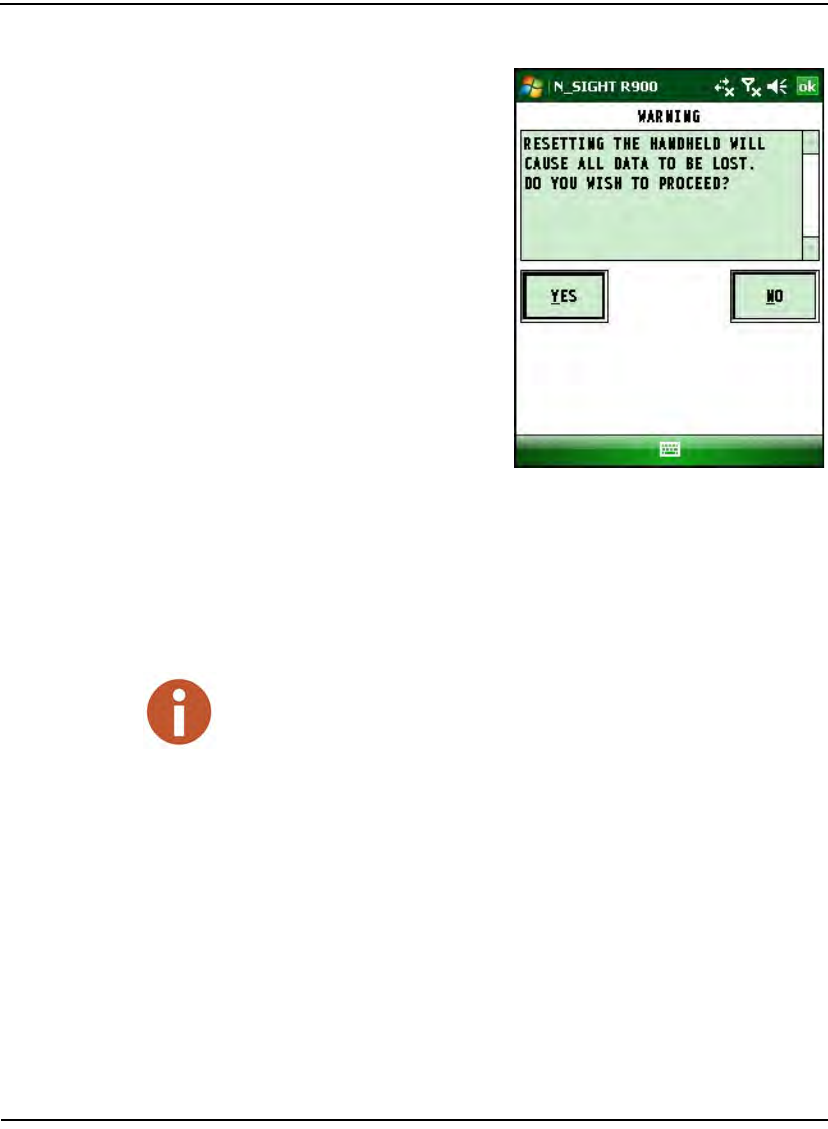
Troubleshooting
N_SIGHT R900 User’s Manual for the Neptune Handheld System 10-9
A warning message
appears as illustrated in
Figure 10.4.
4 Touch YES to proceed.
Figure 10.4 Reset Warning Message
5 Select YES to proceed.
This action clears all routes from the handheld.
Rebooting the CE5320B
Rebooting When Logged into a Route in N_SIGHT R900
Follow these steps to reboot the CE5320B when logged on to N_SIGHT
R900.
Rebooting the handheld differs from resetting the handheld because it does
not delete the routes off the handheld. Only resetting deletes routes from the
handheld.
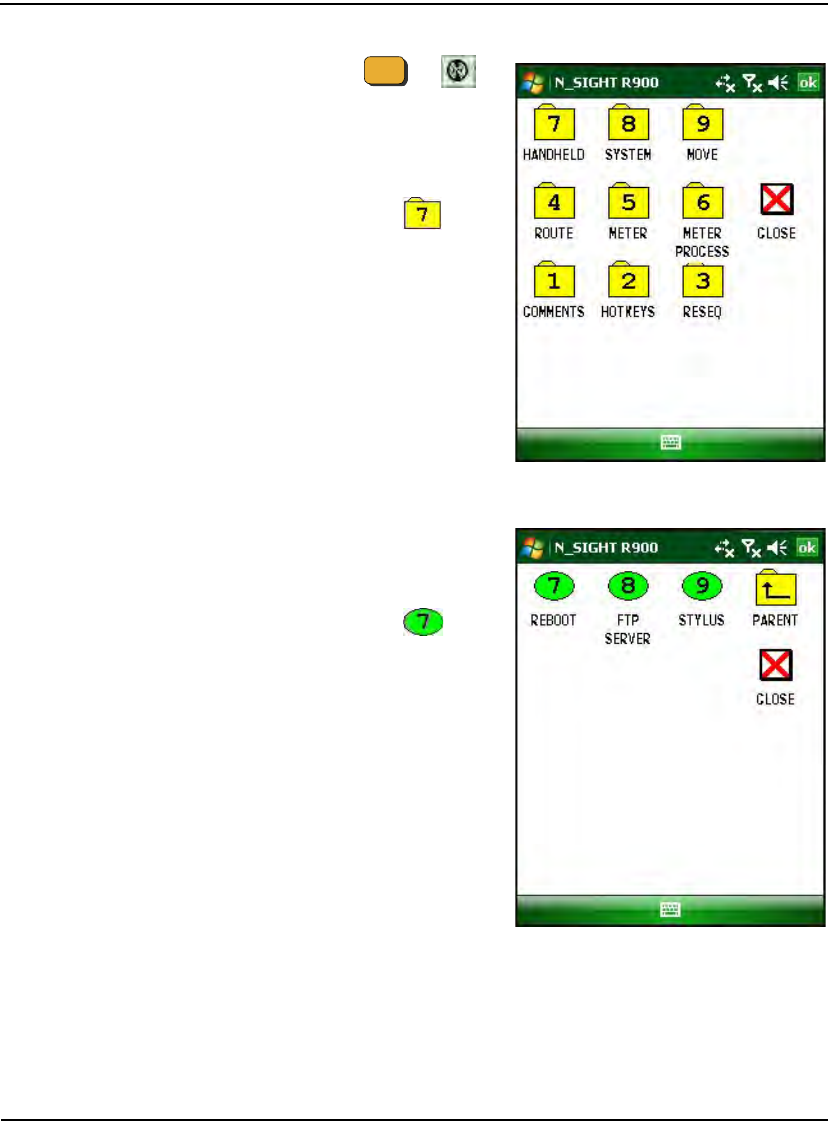
Troubleshooting
10-10 N_SIGHT R900 User’s Manual for the Neptune Handheld System
1Press I/o or .
The N_SIGHT R900 F1
Menu appears, as
illustrated in Figure 10.5.
2 Touch SEVEN for
HANDHELD.
Figure 10.5 N_SIGHT R900 F1 Menu
The Handheld Menu
appears, as illustrated in
Figure 10.6.
3 Touch SEVEN to
REBOOT.
Figure 10.6 N_SIGHT R900 Handheld Menu
F1
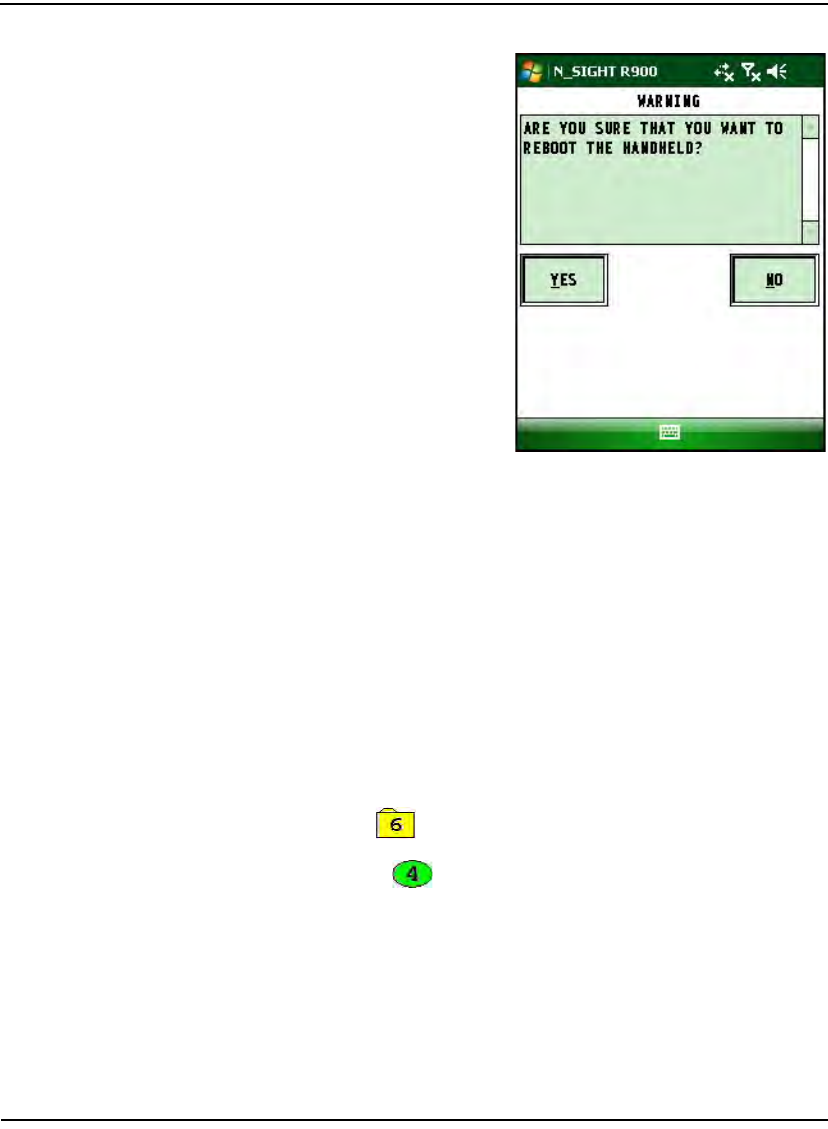
Troubleshooting
N_SIGHT R900 User’s Manual for the Neptune Handheld System 10-11
A warning message
appears as illustrated in
Figure 10.7.
4 Touch YES to proceed.
Figure 10.7 Reboot Handheld Screen
A beep sounds and the N_SIGHT R900 Login screen appears as
illustrated in Figure 10.1 on Page 10-7.
Rebooting When Logged off N_SIGHT R900
Follow these steps to reboot the CE5320B when logged off N_SIGHT
R900.
1 From the N_SIGHT R900 Login screen, touch Menu or press M.
See Figure 10.1 on Page 10-7.
2 The N_SIGHT R900 Main Menu appears as illustrated in Figure
10.2 on Page 10-8.
3 Touch SIX for HANDHELD.
4 Touch FOUR for REBOOT.
A beep sounds and the N_SIGHT R900 Login screen appears as
illustrated in Figure 10.1 on Page 10-7.
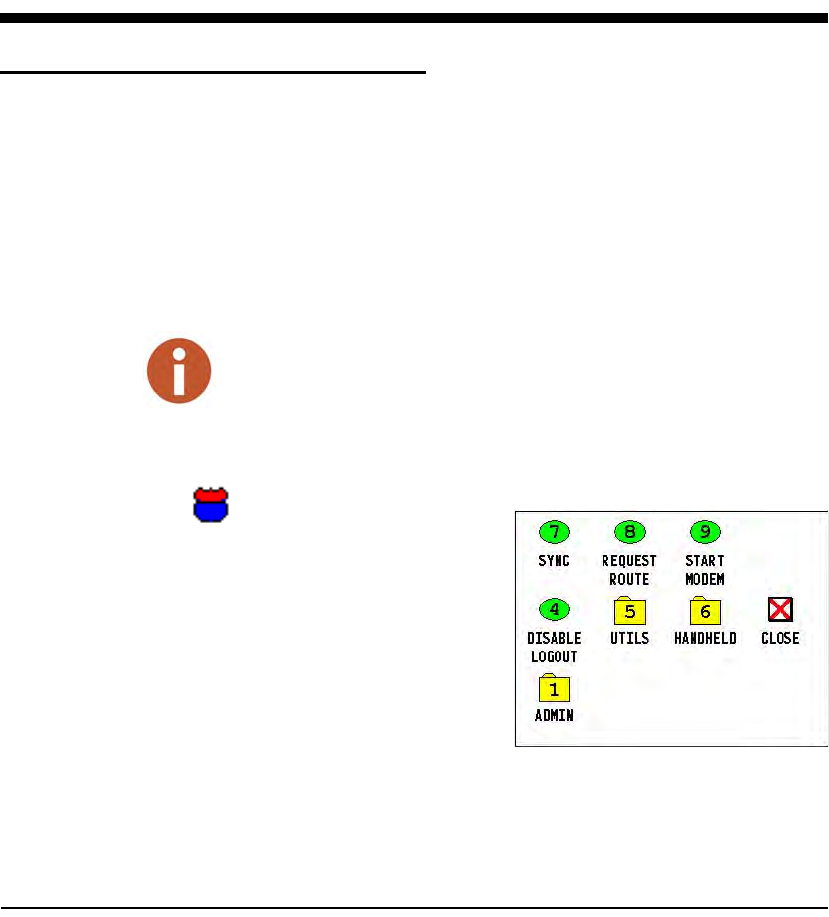
N_SIGHT R900 User’s Manual for the Neptune Handheld System A-1
Appendix A Changing Volume Settings
Adjusting Customized Sounds
The volume of the CE5320 is actually controlled through N_SIGHT
host software and the handheld-specific settings. If you changes the
volume on the handheld, it reverts to the default setting the next time
that the unit synchronizes. The volume on the Nomad is controlled by a
scroll bar.
Changing the Volume Setting on the CE5320
To adjust the volume control setting on the CE5320, complete the
following steps.
1On the N_SIGHT R900
Login screen, press M or
touch Menu.
The N_SIGHT R900
Main Menu screen
appears.
Figure A.1 N_SIGHT R900 Main Menu
The following instructions are for the CE5320 handheld only. To adjust the volume on
the Nomad, see “Changing the Volume Setting on the Nomad,” on page A-5.
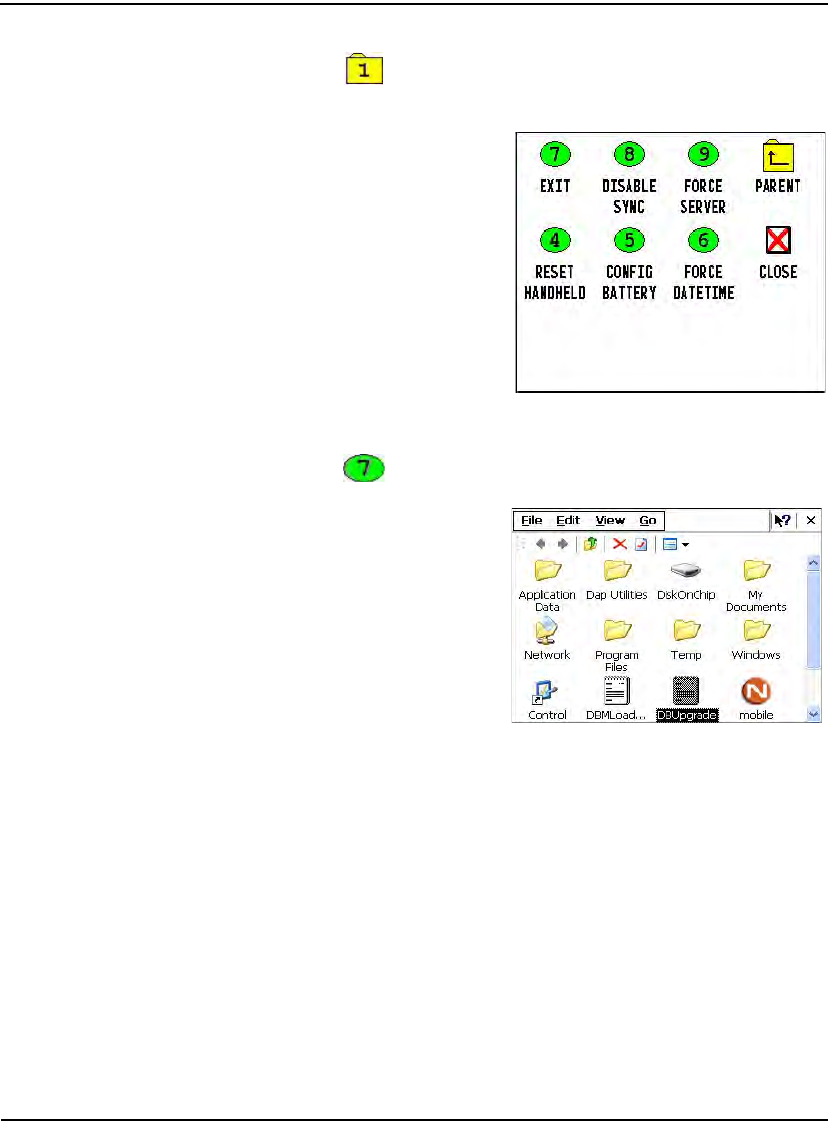
Appendix A: Changing Volume Settings
A-2 N_SIGHT R900 User’s Manual for the Neptune Handheld System
2 Select , Admin.
The Admin Menu appears
as illustrated in Figure
A.2.
Figure A.2 N_SIGHT R900 Admin Menu
3 Select , Exit.
The CE.Net Windows
Explorer screen appears.
Figure A.3 CE.Net Windows Explorer Screen
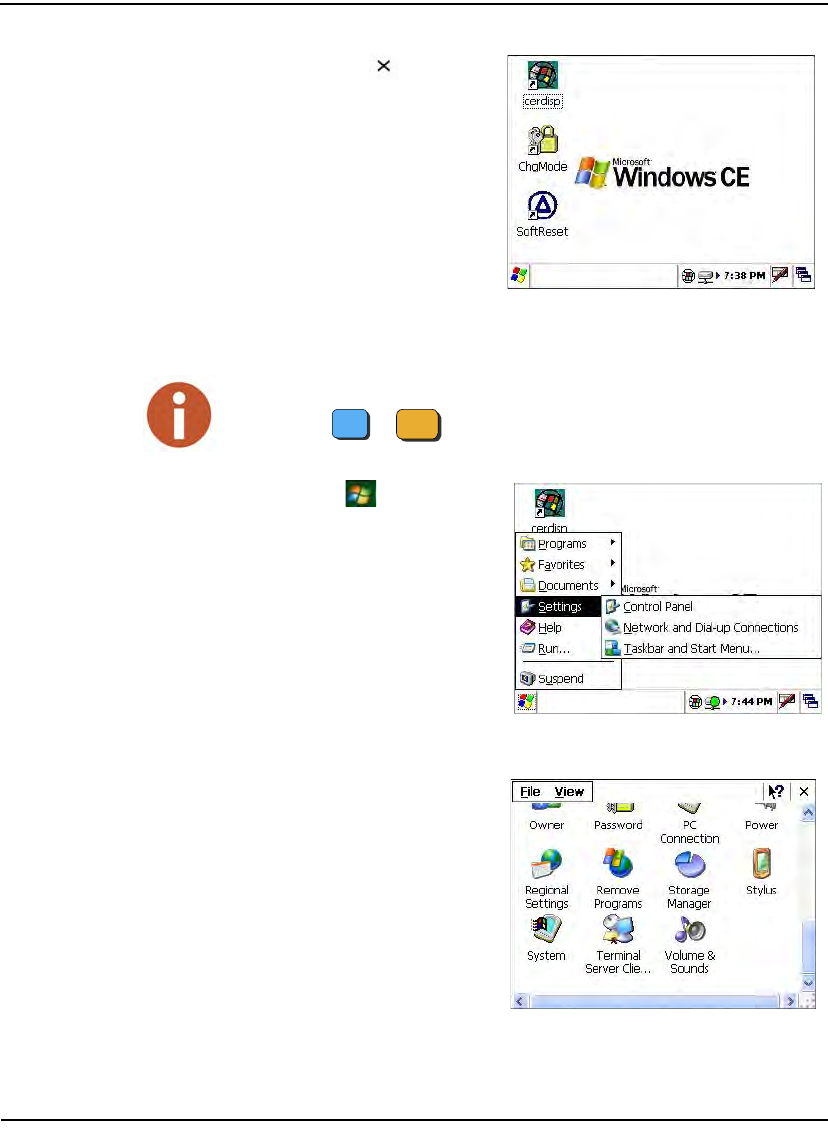
Appendix A: Changing Volume Settings
N_SIGHT R900 User’s Manual for the Neptune Handheld System A-3
4Click the in the
upper right corner of the
screen.
The Windows C. main
screen appears as
illustrated in Figure A.4.
Figure A.4 Windows CE Main Screen
5Touch .
6 Select Settings, and Con-
trol Panel, as illustrated
in Figure A.5.
Figure A.5 Selecting Control Panel
The Control Panel menu
appears as illustrated in
Figure A.6.
Figure A.6 Windows Control Panel Menu
On the CE5320, if the screen backlight goes off, turn it on by
pressing + .
F3
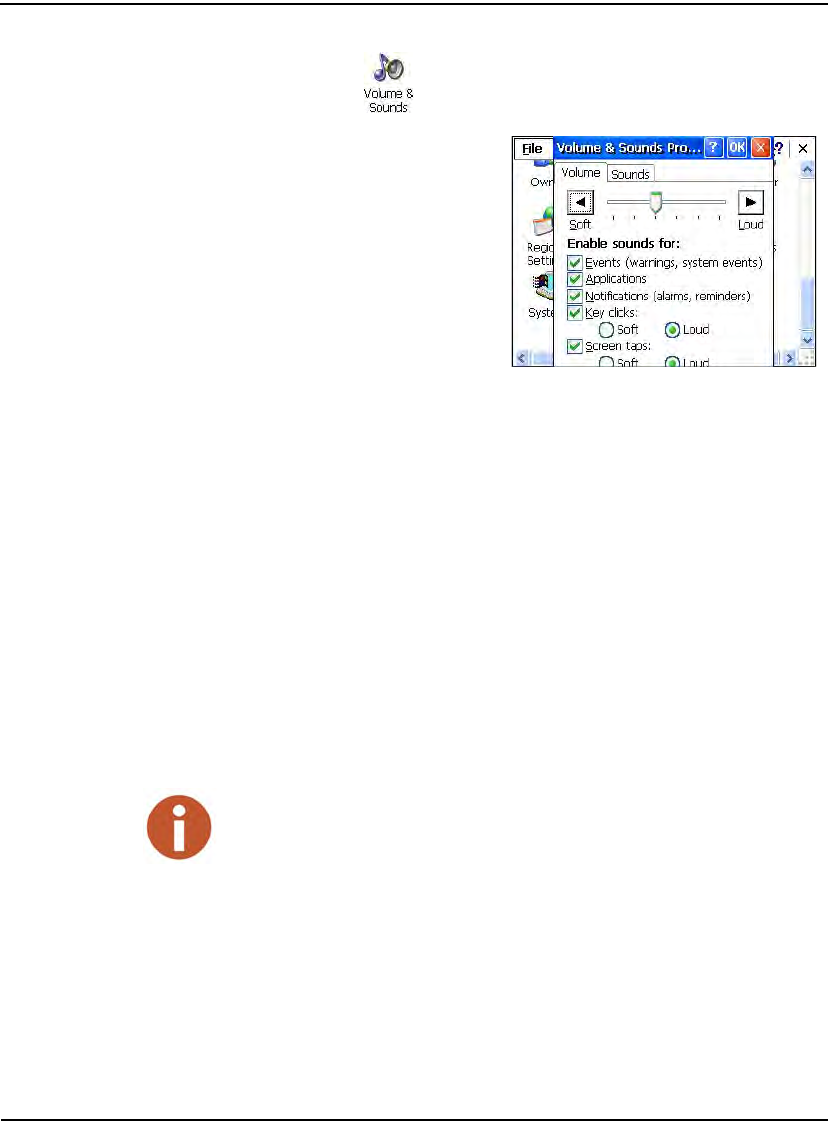
Appendix A: Changing Volume Settings
A-4 N_SIGHT R900 User’s Manual for the Neptune Handheld System
7 Scroll to and touch this icon.
The Volume & Sounds
Properties screen appears
as illustrated in Figure
A.7.
Figure A.7 Volume & Sounds Properties Screen
8On the Volume tab, enable sounds for the following:
• Events (warnings, system events)
• Applications
• Notifications (alarms, reminders)
• Key clicks: (then select soft or loud)
- Soft
- Loud
• Screen taps: (then select soft or loud)
- Soft
- Loud
9 Move the scroll bar to the appropriate volume level, soft or loud.
As you move the scroll bar, you can hear the volume level you
select.
10 Touch OK.
On this screen you are enabling the volume level of the key clicks and screen
tabs to be loud or soft. To turn key clicks on or off in N_SIGHT R900, refer to
“Turning Key Clicks On and Off,” on page A-24 or“Turning Key Clicks On and
Off,” on page A-27.
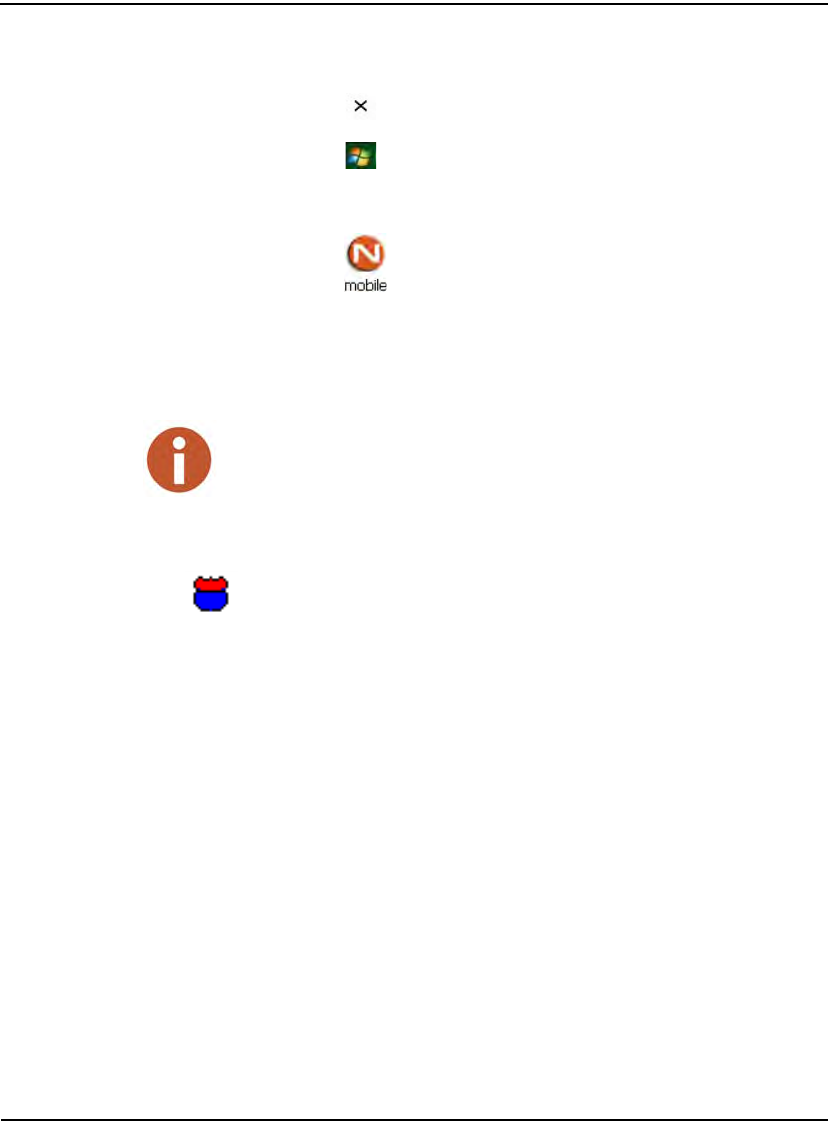
Appendix A: Changing Volume Settings
N_SIGHT R900 User’s Manual for the Neptune Handheld System A-5
11 The Windows Control Panel screen appears.
12 Touch , to return to the Windows menu.
13 Touch .
14 Select Programs | Windows Explorer.
15 Touch to start N_SIGHT R900.
Changing the Volume Setting on the Nomad
To adjust the volume control setting on the Nomad, complete the
following steps.
1 On any screen in N_SIGHT R900, click the volume icon at the top
of the screen. The following drop-down scrollbar appears. See Fig-
ure A.8.
The following instructions are for the Nomad handheld only. To adjust the volume on
the CE5320, see “Changing the Volume Setting on the CE5320,” on page A-1.
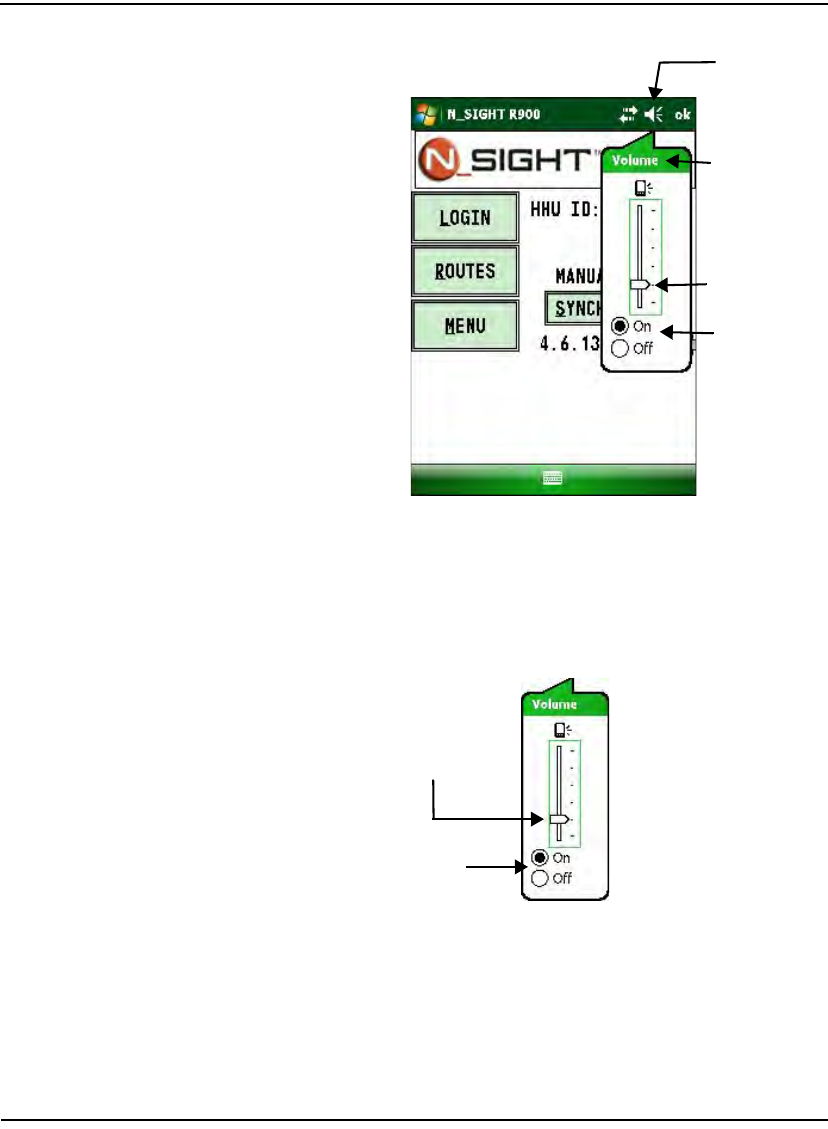
Appendix A: Changing Volume Settings
A-6 N_SIGHT R900 User’s Manual for the Neptune Handheld System
Figure A.8 Nomad Volume Control
2 Referring to Figure A.9, do one of the following.
• Move the scrollbar up or down to adjust the level of sound.
• Click one of the radio buttons to turn the sound on or off.
Figure A.9 Nomad Scrollbar and Radio Buttons
3Click OK.
Volume control
Volume icon
Volume scrollbar
ON/OFF
radio buttons
Volume scrollbar
ON/OFF
radio buttons
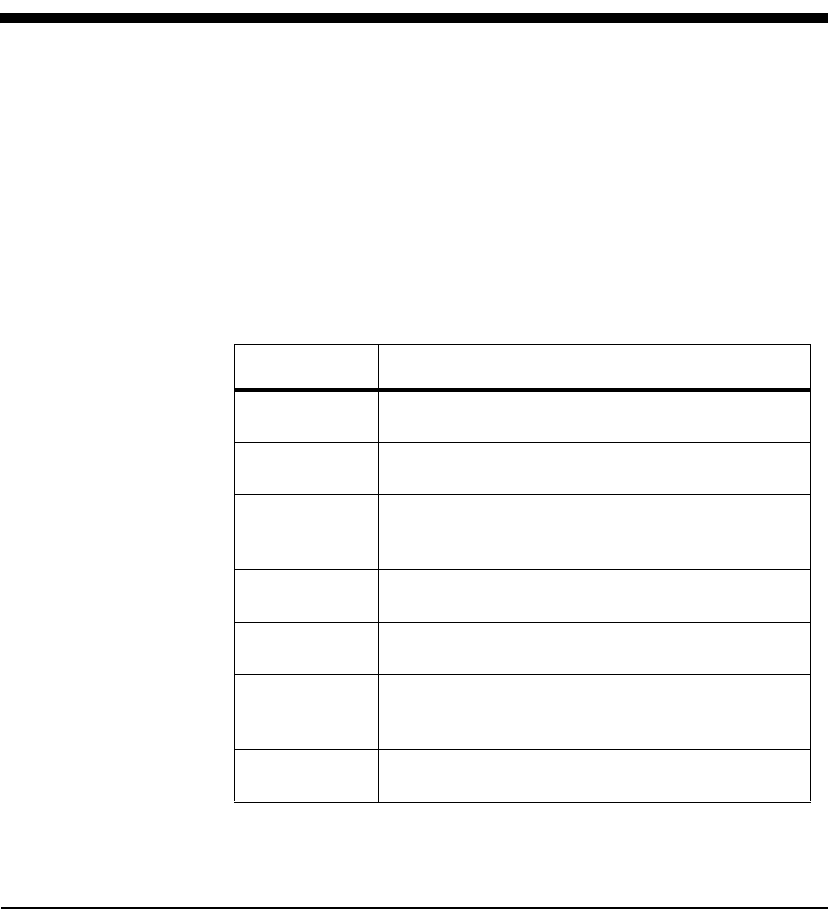
N_SIGHT R900 User’s Manual for the Neptune Handheld System B-1
Appendix B Tokens List for Custom Format Screen
With the Field Programmer, tokens are constants and special characters
used as part of a ProRead format to do the following:
• Indicate a constant value
• Indicate where an inserted value, such as reading or check sum,
goes.
The following table describes tokens used on the Custom Format
screen.
Table B.1 Custom Format Tokens
Token Explanation
STX Starting character (0x02)
ETB End of text block constant (0x17)
CKS Check Sum (programming byte checksum after
eliminating tokens)
ETX End of programming frame
MRT Meter reading token (0x7B)
ID Register ID based on the selection of ID digits on
NewFMT tab (1-10 digits)
NULL Null (0x00)
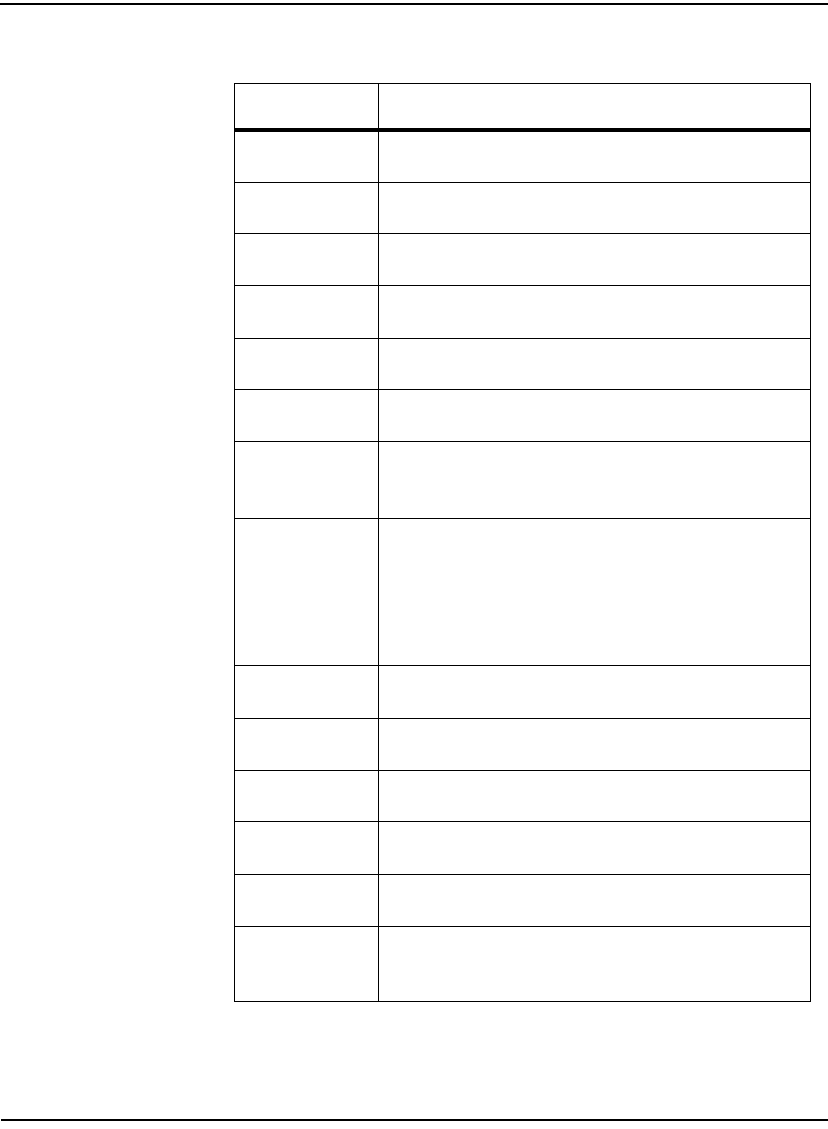
Appendix B: Tokens List for Custom Format Screen
B-2 N_SIGHT R900 User’s Manual for the Neptune Handheld System
USR USR User characters (USR1, USR2, USR3)
CR Carriage returns (0x0D)
LF Line Feed (0x0A)
SP Space Character (0x20)
MID Meter ID (0x4E ('N')
FT Flow Token (0xA0)
NIDS Network ID Size (Two nibbles of values 00 to 99 that
provide network number)
NN Network Number (Net ID constant. Upper digit of
network ID sent to reading equipment, Net ID constant.
Lower digit of network ID sent to reading equipment.
Primary register usually has size of network in these
digits)
MR Mode Flag
RF Read Flag (dial code)
CKST Check sum token (0xFC)
FC Format Constant (0x31 '1'))
MT Meter type (0x57)
Printable
character Any printable ASCII value can be entered in the
character box and it can be added to the list
Table B.1 Custom Format Tokens
Token Explanation
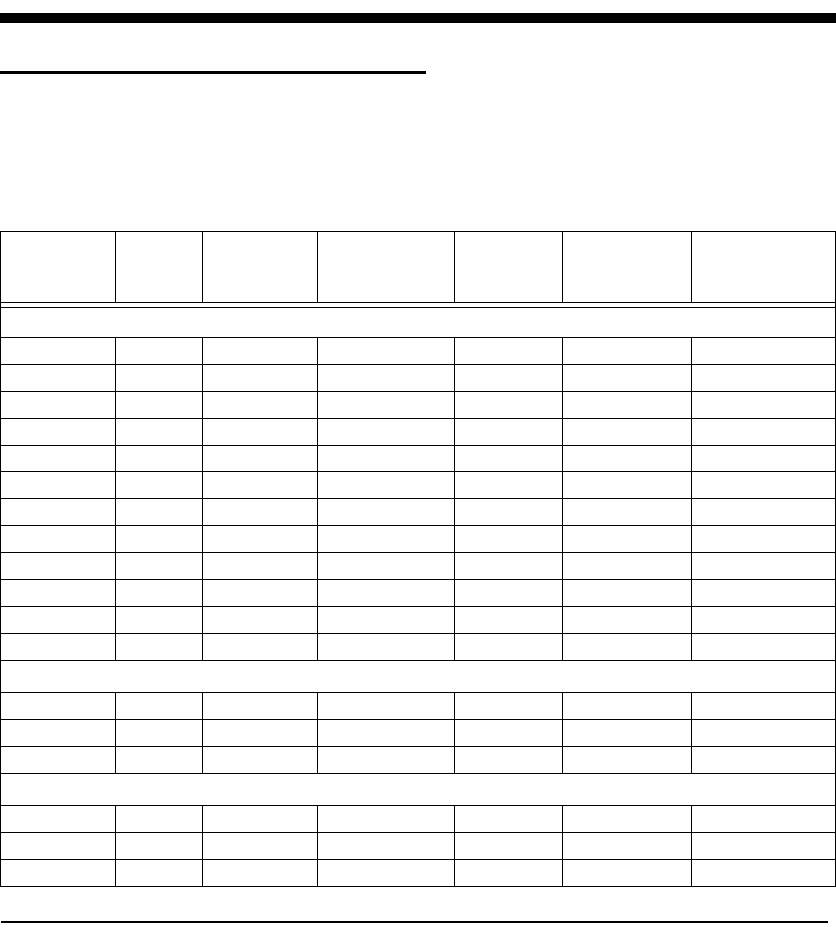
N_SIGHT R900 User’s Manual for the Neptune Handheld System C-1
R900G: 12750-000
Appendix C Pressure Configuration Factor Indexes
Available Formats
The following table is used for selecting gas formats available from
American Meter, Sensus, and Actaris when using the Field Programmer.
Table C.1 Pressure Configuration Factor Index Table
Index Part
Number Drive Gauge
Pressure Atmospheric
Pressure Base
Pressure Actual Gear
Ratio
Pressure
Compensation
Factor
American Meter - AL/AR/AC/AM/AT 175/210/250/350/425/630
52180G066 1 ft32 psig 14.40 14.73 900 1.111111
28538G151 1 ft32 psig 14.73 14.73 883.333333 1.132075
52180G067 2 ft32 psig 14.40 14.73 450 1.111111
04972G116 2 ft32 psig 14.73 14.91 443.055556 1.128527
04972G122 2 ft32 psig 14.40 14.65 445.454545 1.122449
04972G118 2 ft32 psig 14.73 14.73 442.000000 1.131222
04972G124 2 ft32 psig 14.55 14.73 443.055556 1.128527
04972G120 2 ft35 psig 14.40 14.73 381.944444 1.309091
04972G117 2 ft35 psig 14.73 14.91 376.125000 1.329345
04972G119 2 ft35 psig 14.73 14.73 374.305556 1.335807
04972G127 2 ft35 psig 14.40 14.65 376.125000 1.329345
04972G121 2 ft310 psig 14.40 14.73 303.333333 1.648352
Sensus/Equimeter - R-275 / R-315:
001-63-537-48 2 ft32 psig 14.40 14.73 445.867 1.121411
001-63-537-41 2 ft35 psig 14.40 14.73 379.911 1.316098
001-63-537-49 2 ft310 psig 14.40 14.73 300.781 1.662339
Sensus/Equimeter - # 415:
001-41-537-48 2 ft32 psig 14.40 14.73 445.867 1.121411
001-41-537-41 2 ft35 psig 14.40 14.73 379.911 1.316098
001-41-537-49 2 ft310 psig 14.40 14.73 300.781 1.662339
R900G: 12821-000
R900G: 12821-100
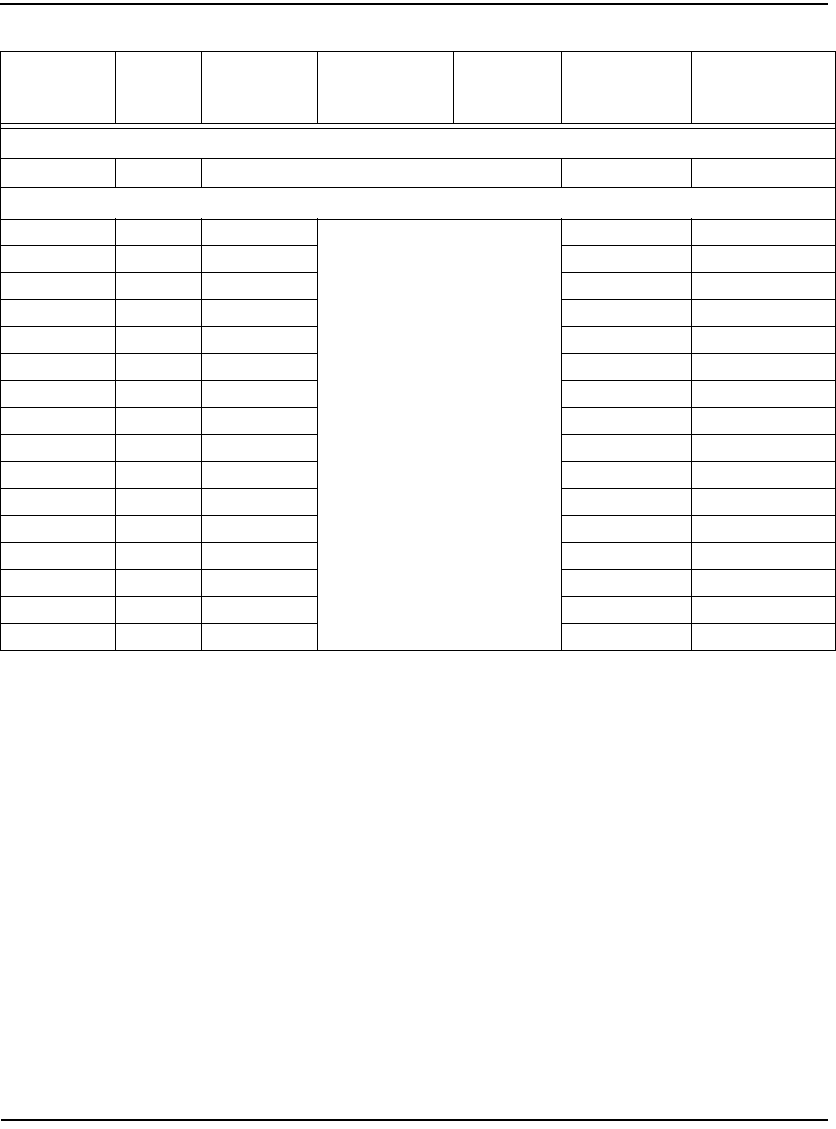
Appendix C: Pressure Configuration Factor Indexes
C-2 N_SIGHT R900 User’s Manual for the Neptune Handheld System
R900G: 12861-000
Sensus/Equimeter - S-275:
Propane 1 ft336.3025 2.7546296
Sprague/Schlumberger/Actaris - 175/240/250/Metris/400A
017289 2 ft32 psig 447.619050 1.1170213
018207 2 ft314” W.C 491.666700 1.0169491
017228 2 ft35 psig 375.000000 1.3333333
017308 2 ft32 psig 447.916700 1.1162790
135543 2 ft32 psig 447.619050 1.1170213
017308 2 ft32 psig 447.916700 1.1162790
037223 2 ft310 psig 293.333300 1.7045456
037234 5 ft32 psig 178.800000 1.1185682
037237 5 ft310 psig 120.000000 1.6666667
017317 2 ft32 psig 447.619050 1.1170213
017318 2 ft314” W.C 491.666700 1.0169491
017366 2 ft32 psig 447.619050 1.1170213
017367 2 ft314” W.C 491.666700 1.0169491
091238 2 ft32 psig 447.619050 1.1170213
091240 2 ft314” W.C 491.666700 1.0169491
135547 2 ft32 psig 447.619050 1.1170213
Index Part
Number Drive Gauge
Pressure Atmospheric
Pressure Base
Pressure Actual Gear
Ratio
Pressure
Compensation
Factor
R900G: 12821-200

N_SIGHT R900 User’s Manual for the Neptune Handheld System G-1
Glossary
alphanumeric Having or using both alphabetical and numerical symbols. For example, an
alphanumeric password contains both letters and numbers.
application program Usually referred to as an application, rather than an application program, it
is a type of software program that performs a specific task useful to the user.
Examples include database management applications, such as
N_SIGHT R900, or word processing applications, such as Microsoft® Word®.
bit Short for binary digit, the smallest unit of information on a machine. A single
bit can hold only one of two values: 0 or 1. More meaningful information is
obtained by combining consecutive bits into larger units.
blank route A route made up entirely of meters for which readings have not been
attempted. Compare with skip route.
broadcast message A statement that is sent from the HOST COMPUTER along with an assigned route
to all handhelds of a specific office. The statement appears on the displays of
each handheld when each meter reader completes the initial daily LOGIN pro-
cedure. Compare with route message and survey message.
central-processing unit Often abbreviated as CPU, the CPU is the brains of the computer. Sometimes
referred to simply as the processor or central processor, the CPU is where
most calculations take place. In terms of computing power, the CPU is the
most important element of a computer system.
code table A group of codes that are classified according to the type of information they
capture. For example, a skip code table contains all of the skip codes used by
a company. Codes allow you to pass on detailed information about a cus-
tomer, meter, or route in an abbreviated form. For example the SKIP CODE
“s1” might indicate that a meter was skipped because the glass of the meter
was fogged and the meter reader could not see the reading.

Glossary
G-2 N_SIGHT R900 User’s Manual for the Neptune Handheld System
communication cradle A device used to charge and exchange data with a handheld. Whenever
a handheld is placed in a communication cradle, the battery of the hand-
held begins recharging, and it is ready to exchange data with the HOST
COMPUTER.
company code In the N_SIGHT R900 APPLICATION PROGRAM, company codes are used to
indicate which company a field office belongs to or to indicate the employees
of an company. Company codes can be two digits, two letters, or a digit and a
letter.
constant A multiplier used to determine the customer’s final bill.
cycle A group of routes that is always processed together. Most utility companies
process 21 cycles each month.
data-entry screen A type of SCREEN used by the handheld. Whenever a data-entry screen is dis-
played, the handheld enables the appropriate keys so that you can enter data
in the handheld.
default setting A computer term that is similar in meaning to factory setting. The default set-
ting is one that the handheld automatically applies to an item. For example,
the default setting for the direction that routes are read is “top to bottom.”
Routes are always displayed in this order unless a meter reader or N_SIGHT
R900 operator changes the setting.
direction key A special key on the handheld keyboard that allows you to move up or down a
list of items and left or right in a data-entry space or through the meters of a
route. This is actually a single key shaped like a cross with arrowheads printed
on it indicating the direction of movement.
display The area at the top of the handheld where information about routes and
meters are shown.
download The process of sending readings and route information from the HOST COM-
PUTER to the handheld.
export A function of the N_SIGHT R900 APPLICATION PROGRAM or the HOST COM-
PUTER. The export function creates a file containing readings and route infor-
mation that is UPLOADED from the handheld. The export file is then sent to your
company’s billing computer.
function key Special keys on the CE5320B keyboard that allow you to perform tasks
quickly. Function keys are the top row of yellow keys labeled F1 to F5.

Glossary
N_SIGHT R900 User’s Manual for the Neptune Handheld System G-3
GB An abbreviation for gigabyte. One gigabyte is equal to 1,024 megabytes.
highlighted Describes an item that is selected. When you select an item in a menu, the
handheld lets you know that it has been selected by accenting the item with a
black band. See also select.
host computer A computer that is accessed by a user working on another PC or WORKSTATION,
for example, the N_SIGHT R900 host computer contains all N_SIGHT R900
data to which the billing computer and other PC operators can connect.
hot key A type of key that allows you to select an item from a list of items by pressing a
single key. The key that you should press is shown next to each item on the
list.
information keys A type of handheld key that allows you to get information about a meter or a
route. Information keys are the letter/character keys that have information
printed in white above them.
LAN See local-area network.
letter/character keys Keys on the keypad of the handheld that allow you to enter a letter or a charac-
ter in the handheld display. Letter/character keys are the small, rectangular
keys on the bottom portion of the keypad.
local-area network A computer network that spans a relatively small area. Most local-area net-
works (LANs) are confined to a single building or group of buildings. However,
one LAN can be connected to other LANs over any distance via telephone
lines and radio waves. A system of LANs connected in this way is called a
wide-area network (WAN).
Most LANs connect WORKSTATIONS and PERSONAL COMPUTERS. Each node
(individual computer) in a LAN has its own central processing unit with which it
carries out programs, but it is also able to access data and devices anywhere
on the LAN. This means that many users can share expensive devices, such
as laser printers, as well as data. Users can also use the LAN to communicate
with each other by sending e-mail.
location code An arrangement of up to four numbers, letters, or both numbers and letters
that tell where a meter is located. For example, a code of “carp” might be used
to indicate that a meter is located in the carport of a home. See also code
tables.
menu screen A type of SCREEN that contains a list of items from which to choose.
message screen A type of SCREEN that displays a message.

Glossary
G-4 N_SIGHT R900 User’s Manual for the Neptune Handheld System
meter number The number by which a utility identifies a meter.
MHz Abbreviation for megahertz. One MHz represents one million cycles per sec-
ond. The speed of MICROPROCESSORS, called the clock speed, is measured in
megahertz.
microprocessor A chip that contains a central processing unit. At the heart of all personal com-
puters and most workstations sits a microprocessor. Microprocessors also
control the logic of almost all digital devices from clock radios to fuel-injection
systems for automobiles.
MIU ID An abbreviation for meter interface unit identifier, which is a discrete number
used to identify a specific meter interface unit.
modem A device that allows two computers to communicate via telephone lines by
modulating and demodulating the signals from each. The name modem is a
contraction of the words modulate and demodulate.
MS-DOS An abbreviation for Microsoft Disk Operating System. Originally developed by
Microsoft for IBM, MS-DOS was the standard operating system for IBM-com-
patible PERSONAL COMPUTERS.
The initial versions of DOS were very simple. However, MS-DOS is still a 16-
BIT operating system and does not support multiple users or MULTITASKING as
do newer OPERATING SYSTEMS such as WINDOWS 95 or WINDOWS NT.
multiple-route assignment A type of assignment in which more than one route is assigned to one meter
reader.
multitasking The ability to carry out more than one task at the same time, a task being an
APPLICATION PROGRAM.
N_SIGHT R900 database
server A type of software that receives, stores, and passes on information. Because
handheld computers cannot send information directly to your company’s billing
computer (and the system cannot send information directly to each handheld
computer), the server is needed to translate information from one source to
another.
number keys Keys that allow you to enter a number in the display of the handheld. Number
keys are the large, white oval keys in upper portion of the keypad.
office code In the N_SIGHT R900 APPLICATION PROGRAM, office codes are used to indicate
the office to which a meter belongs or to indicate the employees of an office.
Office codes can be two digits, two letters, or a digit and a letter.

Glossary
N_SIGHT R900 User’s Manual for the Neptune Handheld System G-5
operating system The most important program that runs on a computer. Every general-purpose
computer must have an operating system to run other programs. Operating
systems perform basic tasks, such as recognizing input from the keyboard,
sending output to the display screen, keeping track of files and directories on
the disk, and controlling peripheral devices, such as disk drives and printers.
Usually, users interact with the operating system through a set of commands.
For example, graphical user interfaces, such as WINDOWS 95 and WINDOWS NT,
allow you to enter commands by pointing and clicking at objects that appear
on the screen. The MS-DOS operating system contains commands such as
COPY and RENAME for copying files and changing the names of files,
respectively.
order A meter reading, service order, or similar transaction that takes place on the
handheld.
PC An abbreviation for PERSONAL COMPUTER.
pop-up A special message that appears (pops up) automatically just before the read-
ing entry screen that is associated with the message. You can control whether
the special message appears as a pop-up message or does not appear.
prompt A symbol, such as “c:\>” that appears on a display, indicating that the com-
puter is waiting for the operator to enter information. Once the computer has
displayed a prompt, it waits for you to enter some information. Generally, it will
wait forever, but some programs have built-in time-outs that cause the pro-
gram to continue after it has waited a specified amount of time.
quick keys Keys that allow you to execute a task quickly by pressing specific keys at once
or in a particular order.
reading-entry screen A specific type of DATA-ENTRY SCREEN used by the handheld. The reading-
entry screen is used to enter readings.
read-type code An arrangement of up to four numbers, letters, or both numbers and letters
that explain how the reading is obtained. For example, a code of “r0” might be
used to indicate that the reading is entered manually. See also code tables.
region code In the N_SIGHT R900 APPLICATION PROGRAM, region codes are used to indi-
cate the regional headquarters for a field office or to indicate the employees of
a regional headquarters. Region codes can be two digits, two letters, or a digit
and a letter.

Glossary
G-6 N_SIGHT R900 User’s Manual for the Neptune Handheld System
route message A free-form statement sent from N_SIGHT R900 operators to the handheld
computers of meter readers assigned to a specific route. A route message can
contain as many as 80 characters. Compare with broadcast message and
survey message.
router One of the most commonly used devices to connect several handheld at a
time. The router device allows you to connect as many communication cradles
to the HOST COMPUTER. Because the router provides communication connec-
tions for the cradles, whenever a handheld is placed in a communication cra-
dle, it is ready to exchange data with the HOST COMPUTER.
screens The graphic portion of a display. N_SIGHT R900 uses three different types of
screens to present the information shown in the display: a MENU SCREEN, a
DATA-ENTRY SCREEN, and a MESSAGE SCREEN.
select To choose an item by using the arrow keys or by using a HOTKEY. N_SIGHT
R900 indicates that an item is selected by highlighting the item. See also
highlighted.
sequence number A number assigned to each meter indicating the location of the meter in rela-
tion to other meters in the route. For example, a sequence number of 000003
indicates that the meter is the third meter of a route. The meter reader may
change the sequence number on the handheld computer, indicating a pre-
ferred placement of that meter within the route.
sign off The act of exiting the meter reading portion of the handheld APPLICATION PRO-
GRAM. By exiting the meter reading portion, you can access the communica-
tion function and send information to or receive information from the HOST
COMPUTER.
sign on The act of accessing the meter reading portion of the handheld so that you
can obtain route assignments or collect readings.
skip code An arrangement of up to four numbers, letters, or both numbers and letters
that explain why a reading was skipped. For example, a code of “s1” might be
used to indicate that a reading was skipped because the glass of the meter
was fogged and the meter reader could not see the usage display. See also
code tables
skip route A route made up entirely of meters for which readings were attempted but
could not be obtained. For example, the glass on the meter may have been
fogged and the meter reader could not see the usage display. Compare with
blank route.
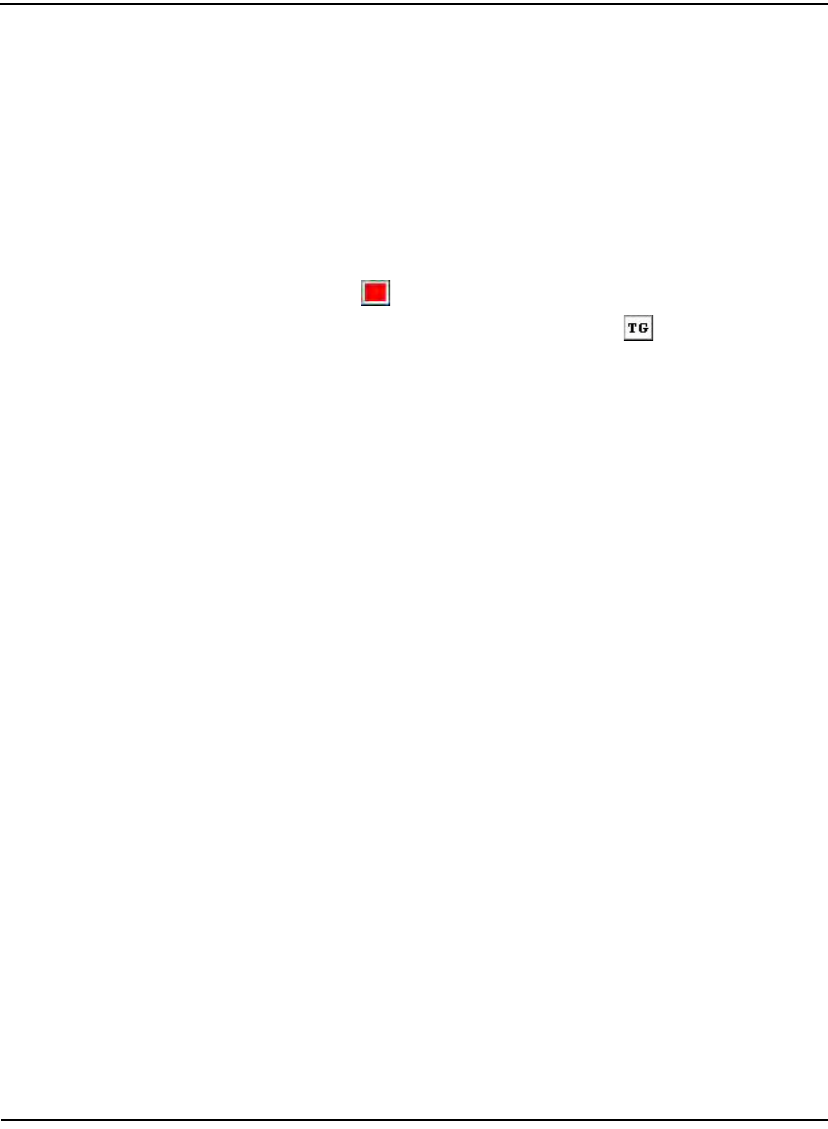
Glossary
N_SIGHT R900 User’s Manual for the Neptune Handheld System G-7
survey message A free-form question sent along with assigned routes to the handheld of a spe-
cific CYCLE. A survey message can contain up to 40 characters. Compare with
broadcast message and route message.
synchronize The process of communications to send readings and route data to and from
the handheld and the HOST COMPUTER.
tag A handheld feature that allows you to tag one or more meters in a route and
then have the handheld display only the tagged meters.
tag indicator An icon that appears in the display of the handheld to indicate that the
meter is tagged. When this symbol appears, the is hidden.
trouble code An arrangement of up to four numbers, letters, or both numbers and letters
that explain why there is trouble with a meter. For example, a code of “t10”
might be used to indicate that the battery of a meter is low. See also code
tables.
upload The process of sending readings and route data from the handheld to the
HOST COMPUTER.
user ID An identifier that is assigned to each user of the handheld. Entering a user ID
number when you LOG IN ensures that only someone with a user ID can use
the handheld. A user ID can contain up to ten digits, ten characters, or a com-
bination of ten digits and characters There can be no spaces in a user ID.
Windows Microsoft Windows OPERATING SYSTEM. Windows supports 32-BIT and 64-BIT
applications, which means that application programs written specifically for
these operating systems run much faster.
workstation A type of computer used for engineering applications, desktop publishing, soft-
ware development, and other types of applications that require a moderate
amount of computing power and relatively high quality graphics capabilities.
Like personal computers, most workstations are single-user computers. How-
ever, workstations are typically linked together to form a LOCAL-AREA NETWORK,
although they can also be used as stand-alone systems.
In networking, workstation refers to any computer connected to a local-area
network. It could be a workstation or a PERSONAL COMPUTER.

Glossary
Notes:
G-8 N_SIGHT R900 User’s Manual for the Neptune Handheld System

N_SIGHT R900 User’s Manual for the Neptune Handheld System I-1
Index
A
A key 3-16, 4-16
access
reading mode 5-13
RF test mode 5-13
access Codes menu 3-16, 4-16
actual gear ratio A-1
add, gas format 8-44, 8-47
adding
meters to routes 6-29
adding meters to routes 6-28 to 6-29
alphanumerics
defined G-1
AMR mode key 3-16, 4-16
application programs
defined G-1
atmospheric pressure A-1
audit failed error message 6-21
auto increment 8-31
automatic off
described 2-7, 2-12
automatic return
described 2-7, 2-12
B
B key 3-16, 4-16
backward keys
illustrated 3-15, 4-12, 4-18
base pressure A-1
batteries
calibrating 9-5, 9-8
charging 9-3
checking status of 9-3, 9-15
compartment (illus.) 9-9, 9-10
conserving 3-20, 4-20
described 2-6, 2-11
life of 9-5
low charge warning 4-30
ordering replacement 9-18, 9-21, 9-25 to 9-27
recharging 9-5
replacing 9-9 to 9-10
status indicator (illus.) 9-3, 9-15
using 4-30
battery
charger 9-4
for CE5320 charger 3-6
Nomad cable 4-6
battery error 5-9
battery recharge contacts 2-6, 2-11
battery status indicators
color of 9-3
described 2-5, 2-10
illustrated 9-3
location (illus.) 2-5, 2-10
using 9-3, 9-15
beepers, described 2-7, 2-12
bits, defined G-1
BKSP key 3-19, 4-19
blank readings, entering 6-11
blank routes
See also skip routes
defined G-1
blue keys
function 3-19, 3-20, 4-19 to 4-20
using 3-13
bluetooth, LED 5-9
bookmarks, problems with 10-5
broadcast messages 3-27, 4-32, 5-11
See also route messages, survey messages
defined G-1
browse key 3-17, 4-17
button, mouse 8-20
C
C key 3-16, 4-16
cable 4-6
charger 4-4
for Bulverde charger 3-4
cable, USB transfer 5-17
calibrating, battery 9-5, 9-8
CE5320
features 2-4, 2-8, 2-13
illustrated 2-4
keyboard 2-4
CE5320, charger 3-3, 3-4, 3-6
central processing units, defined G-1
change modes, R900 BCR 5-4

Index
I-2 N_SIGHT R900 User’s Manual for the Neptune Handheld System
changing
keyboard click setting 3-24, 4-27
keyin direction 6-14
meter information 6-30 to 6-32
route direction 3-24, 4-27
character keys
defined G-3
described 3-15
characters, entering 3-13, 3-15 to 3-16
charger
battery 9-4
cable 4-4
CE5320 3-3, 3-4, 3-6
CE5320 cable 3-4
Nomad 4-3
Nomad battery 4-5, 4-6
Nomad illus. 4-3
Nomad 4-4, 4-5, 4-6
charger, CE5320 battery 3-6
checklist 8-27
clearing readings and skip codes 6-22, 6-24, 6-26,
6-39, 6-41
code tables, defined G-1
codes, see specific code
Codes key 3-16, 4-16
Codes menu, key 3-16, 4-16
collecting meter readings 6-3
color-coding, on keyboard 3-15, 3-19, 4-19
colors, of battery status indicator 9-3
command gas 8-24
communication cradles
as part of system 3-2
defined G-2
with cradle-charging kit 3-3, 4-3
communication methods 7-1, 8-29, 8-40
company codes, defined G-2
components, R900 BCR 5-3
confirmation, off/Level1 8-31
connect to receptacle 8-29
connect, wiring 8-29
connecting
communication cable (illus.) 3-7
multiple devices 3-8
power cable to device (illus.) 3-6, 4-6
power supply 3-5, 4-4
router 3-5, 3-8, 4-5
constants, defined G-2
conventions, used in the manual 1-1 to 1-2
correcting
See also changing
meter information 6-30, 6-32
CPUs, see central processing units G-1
cradle and charging kits
illustrated 3-3 to 3-4, 4-3 to 4-4, 9-15
with communication cradle (illus.) 3-4, 4-4
create format 8-36
custom formats 8-29
customer support 1-5
cycles, defined G-2
D
damage
inspecting for 3-2, 4-1
repairing instructions 9-4
damage, inspecting for 5-2
data-entry screens
defined G-2
described 2-14, 2-16
example (illus.) 2-14
decimal
entering points 3-19, 4-19
using key 3-19, 4-19
default settings, defined G-2
delete
gas format 8-50
ProRead format 8-35
description of
automatic off 2-7, 2-12
automatic return 2-7, 2-12
batteries 2-6, 2-11
battery status indicators 2-5, 2-10
character keys 3-15
communication ports 2-5, 2-10
data-entry screens 2-14, 2-16
direction keys 3-15, 4-12, 4-18
displays 2-14
function keys 3-13
handstraps 2-6
hot keys 3-14, 4-13
information keys 3-16 to 3-18, 4-16 to 4-18
keyboard backlights 2-4, 2-10

Index
N_SIGHT R900 User’s Manual for the Neptune Handheld System I-3
description of (continued)
keyboards 2-4, 2-9
letter keys 3-15
main screens 2-14 to 2-15
menu screens 2-14, 2-15
message screens 2-17
meter reader tasks 2-3
meter readers 1-7
number keys 3-14, 4-12
operator tasks 2-3
operators 1-7
quick keys 3-19, 4-19
devices
connecting 3-5, 4-5
defined G-6
direction keys
defined G-2
described 3-15, 4-12, 4-18
displaying
bookmarked meters 3-19, 4-19
meter information 2-18, 3-19, 4-19
meters 3-15, 4-12, 4-18
meters of a route 2-18, 3-15, 4-12
reading-entry screens 2-17, 2-19, 3-15, 4-12, 6-33
route information 2-18
screens 2-17 to 2-21
displays
defined G-2
described 2-14
problems with 10-2, 10-3 to 10-4, 10-5
down keys, illustrated 2-15, 3-15, 4-18
downloading
defined G-2
problems with 10-6
downloading information
See sending and receiving information
drive A-1
E
edit
gas format 8-44
ProRead format 8-32
Edit key 3-16, 4-16
efficiency 5-14
efficiency, performance 5-12
electromagnetic resistance 2-7, 2-13
e-mail, customer support 1-6
ENTER key 3-19, 4-19
entering
blank readings 6-11
characters 3-15 to 3-16
decimals 3-19, 4-19
letters 3-15 to 3-16
skip codes 6-5 to 6-6
entry key 3-17, 4-17
error codes, LEDs 5-9
error messages, see also troubleshooting
ethernet ports, described 2-5, 2-10
exchanging information
methods of 8-40
exchanging information, see also sending and
receiving information
exchanging information, methods of 7-1, 8-29, 8-40
export, defined G-2
exposure, to temperatures 2-7
F
F key 3-17, 4-16
F1 key 3-13
F2 key 3-13
F3 key 3-13
F4 key 3-13
F5 key 3-13
fax, customer support 1-6
features
automatic off 2-7, 2-12
automatic return 2-7, 2-12
battery 2-6
battery recharge contacts 2-6
battery status indicator 2-5, 2-10
beeper 2-7, 2-12
CE5320B 2-4, 2-8, 2-13
display 2-4, 2-9
handstrap 2-6
keyboard 3-11, 4-9
keyboard backlight 2-4, 2-9
LEMO communication port 2-5, 2-10
manual off 2-7, 2-12
optical-infrared port 2-6, 2-11
Find key 3-17, 4-16

Index
I-4 N_SIGHT R900 User’s Manual for the Neptune Handheld System
firmware
update 5-17
web update 5-16
firmware updates, R900 BCE 5-1
firmware, update 5-15
format
add gas 8-44, 8-47
create 8-36
custom 8-29
delete gas 8-50
delete ProRead 8-35
edit gas 8-44
edit ProRead 8-32
gas 8-46
manage 8-29
name 8-37
save ProRead 8-40
select gas 8-42
select ProRead 8-35
standard 8-34
forward keys
illustrated 3-15, 4-12, 4-18
found meters
found meters, see also adding meters to routes
function keys
defined G-2
described 3-13
G
G key 3-17, 4-16
Gas
preferences 8-41
gas
command 8-24
preferences 8-40
program 8-18
program register 8-40
readings 8-26
gauge pressure A-1
GBs, defined G-3
gear ratio, actual A-1
GoTo key 3-17, 4-16
H
handhelds
dropping 2-8, 2-13
durability 2-7, 2-12
illustrated 2-4, 2-9, 4-10
inspecting 3-2, 4-1, 5-2
shipping to Neptune 3-2, 5-2, 9-28
use with RouteMAPS 2-1
using 2-1
handstraps
described 2-6
on handheld (illus.) 9-11 to 9-13
replacing 9-11 to 9-14
highlighting
See also selecting
defined G-3
host computers
connecting equipment to 3-5, 4-4
defined G-3
exchanging information with 7-1
host computers, exchanging information with 8-29,
8-40
hot keys
defined G-3
described 3-14, 4-13
I
I/O key 3-19, 4-19
index part number A-1
information exchange 7-1
information key 3-17, 4-17
information keys
defined G-3
described 3-16, 3-18, 4-16, 4-18
INS/ESC key 3-19, 4-19
inspecting, equipment 3-2, 4-1, 5-2
installing
battery 9-10
battery, CE5320B 9-10
handstrap 9-11, 9-14
LEMO cable 3-8
power supply 3-5, 4-4
router 3-5, 4-5
interconnect wires, networking 8-29

Index
N_SIGHT R900 User’s Manual for the Neptune Handheld System I-5
J
J key 3-17, 4-17
K
key
browse 3-17, 4-17
edit 3-16, 4-16
entry, manual 3-17, 4-17
for screen information 3-17, 4-17
for Search 3-17, 4-16
GoTo 3-17, 4-16
information 3-17, 4-17
list 3-17, 4-17
Logout 3-18, 4-17
manual entry 3-17, 4-17
Meter 3-18, 4-17
Properties 3-18, 4-17
RF test 3-18, 4-17
Skip 3-18, 4-17
Tag 3-18, 4-17
Tag search 3-18, 4-17
to exit 3-18, 4-17
W, to logout 3-18, 4-17
key AMR mode 3-16, 4-16
key, Find 3-17, 4-16
keyboard backlights, described 2-10
keyboard click, selecting 3-24, 4-28
keyboards
backlight 2-4, 2-10
backlights described 2-4
CE5320B (illus) 2-4
character keys 3-15 to 3-16
character keys (illus.) 3-12, 4-10
color coding 3-13, 3-15, 4-11
described 2-4, 2-9
direction keys 3-14 to 3-15, 4-12, 4-18\
direction keys (illus.) 3-12, 4-10
enabling Keyboard Click 3-24, 4-27
function keys 3-13
function keys (illus.) 3-12, 4-10
illustrated 3-12, 4-11
information keys 3-16 to 3-18, 4-15, 4-18
information keys (illus.) 3-12
letter keys 3-15 to 3-16
letter keys (illus.) 3-12, 4-11
number keys 3-14, 4-12
number keys (illus.) 3-12
quick keys 3-19, 4-19
quick keys (illus.) 3-12, 4-10, 4-11
selecting Keyboard Click 3-24, 4-27 to 4-28
Trimble Nomad (illus) 2-9
keyin direction, selecting 3-23, 4-27
keys, color-coding 3-15, 3-19, 4-19
L
L key 3-18, 4-17
LANs, see local area networks
LED operating modes 5-8
LEDs
bluetooth 5-9
error codes 5-9
explained 5-8
mode 5-8
power 5-8
RF mode 5-9
LEMO connectors, as part of system 3-2
letter keys
defined G-3
described 3-15
illustrated 3-12, 4-11
letter, entering 3-15
list key 3-17, 4-17
local area networks, defined G-3
location codes, defined G-3
login screen 8-30, 8-41
Logout key 3-18, 4-17
long-term storage, preparing the unit for 9-2
low-power state 2-7, 2-12
M
M key 3-18, 4-17
Main Menu screen, illustrated 6-8, 6-16, 6-26, 6-37
main screens
described 2-14 to 2-15
illustrated 2-14 to 2-15
maintenance
frequency of 9-1
proper storage 9-2 to 9-3
recommended 9-1
manage formats 8-29

Index
I-6 N_SIGHT R900 User’s Manual for the Neptune Handheld System
manual entry key 3-17, 4-17
manual OFF, described 2-7, 2-12
menu screens 2-15
defined G-3
described 2-14, 2-15
example (illus.) 2-14
example of (illus.) 2-14
menus
Main 6-37
Utility 3-25, 4-28
message screens
defined G-3
described 2-17
example (illus.) 2-15
messages
e-mail 1-6
See route messages, survey messages, error
messages, broadcast messages
Meter 2-1
meter information, displaying screens with 2-18
Meter key 3-18, 4-17
meter numbers, defined G-4
meter reader tasks
defined 1-7
described 2-3
meter readers
described 1-7
responsibilities 1-8
meter reading cycle, illustrated 5-2
meter readings
See also readings
collecting manually 6-3
meters
changing information about 2-21, 6-30 to 6-32
displaying information 3-19, 4-19
MHz, defined G-4
microprocessors
See also central processing units
defined G-4
MIU IDs, defined G-4
mode LED 5-8
mode, suspend 2-7, 2-12
modems, defined G-4
moderate performance 5-12, 5-14
modes
access RF test mode 5-13
bluetooth 5-9
error codes LEDs 5-9
LED 5-8
LED operating 5-8
normal filtered reading 5-5
RF 5-9
RF performance 5-11
RF test 5-13
SD card error, LED 5-9
unattended 5-5
unfiltered reading 5-5
mouse, button 8-20
moving
in a data-entry space 3-15, 4-12, 4-18
through screens 2-17
within a route 6-33, 6-35
MS-DOS
See also Windows 95, Windows NT, operating
systems
defined G-4
MTR INFO key 3-18, 4-17
multiple-route assignments, defined G-4
multiplier, gas 8-45
multitasking, defined G-4
N
N_SIGHT R900 database server, defined G-4
N_SIGHT R900 status screen 5-7, 5-11
navigating screens 2-17
Neptune key, illustrated 5-7
networking 8-28
new meters
adding 6-28 to 6-29
NEW MTR key 3-18, 4-17
Nomad
charger 4-3, 4-4, 4-5, 4-6
charger illus. 4-3
display 2-9
Nomad, basic features 2-9, 2-12
normal filtered reading mode 5-5
number keys
defined G-4
described 3-14, 4-12
illustrated 3-12, 4-10

Index
N_SIGHT R900 User’s Manual for the Neptune Handheld System I-7
O
office codes, defined G-4
operating mode, LED 5-8
operating systems
See also Windows 95, Windows NT, MS-DOS
defined G-5
operating temperatures 2-7, 2-12
operator tasks
defined 1-7
described 2-3
operators
described 1-7
responsibilities 1-9
options, Customer Support 1-6
order
defined G-5
ordering parts 9-26
overview, R900 BCR 5-1
P
P key 3-18, 4-17
packing the handheld 9-28
pair, R900 BCE 5-10
parts
list of replaceable 9-26
ordering 9-26
recommended spare 9-26
password
Gas login (Field Programmer) 8-41
ProRead login 8-30, 8-41
PCF 8-45
PCs
See also personal computers
defined G-5
performance RF 5-14
performance, best 5-12, 5-14
pop-ups, defined G-5
power supply, connecting 3-5, 4-4
preferences
Gas 8-41
preferences, ProRead 8-30
pressure
atmospheric A-1
base A-1
gauge A-1
pressure compensation factors, table of A-1
Pressure Configuration Factor 8-45
problems
See also troubleshooting
solving 10-1 to 10-6
program
gas 8-18
gas register 8-40
network secondary register 8-28
R900G 8-18
program result, gas 8-20
prompts
defined G-5
Properties key 3-18, 4-17
ProRead
preferences 8-30
query 8-14
read 8-15
select format 8-32
Q
Q key 3-18, 4-17
query ProRead 8-14
query, results 8-15
quick keys
defined G-5
described 3-19, 4-19
illustrated 3-12, 4-11
R
R key 3-18, 4-17
R900 BCR
change modes 5-4
components 5-3
firmware updates 5-1
overview 5-1
pair bluetooth 5-10
read route 5-11
SD card 5-14
status screen 5-11
update firmware 5-15
USB transfer cable 5-17
R900 BCR firmware 5-15
R900 BCR modes
explanation 5-5

Index
I-8 N_SIGHT R900 User’s Manual for the Neptune Handheld System
LED operating 5-8
operation 5-4, 5-7
summary 5-4, 5-7
R900 Belt Clip Receiver
overview 5-1
USB transfer cable 5-17
R900G, program 8-18
ratio A-1
read
gas 8-26
ProRead 8-15
reading a route 5-11
reading mode
access 5-13
reading-entry screens
defined G-5
displaying 2-17, 2-19
example (illus.) 2-18
sample used in manual 6-1
readings
bypassing 6-3
clearing 6-22, 6-24, 6-26, 6-39, 6-41
collecting 6-3
entering into the handheld 6-3 to 6-4
entering skip code 6-5
leaving blank 6-11
problems with uploading 10-6
validating 6-20
readings, store 5-1
readings, validate 6-20
read-type codes, defined G-5
reboot
handheld 10-9
logged off 10-11
logged on 10-9
receiving information from host 7-4 to 7-5
recharging the battery 9-5
refresh, R900G 8-24
region codes, defined G-5
register, program secondary 8-28
registers, network 8-28
removing
battery 9-9 to 9-10
handstrap 9-11 to 9-12
replacing
battery 9-9\ to 9-10
handstrap 9-11, 9-13 to 9-14
reset handheld 10-7, 10-9
resistance
electromagnetic 2-7, 2-13
shock 2-8, 2-13
water 2-7, 2-12
returning CE5320B 9-28
RF mode 5-9
RF performance 5-14
RF test
mode 5-13
RF Test key 3-18, 4-17
RF test mode
access 5-13
rotation, clockwise or counter-clockwise 8-46
route directions, changing 3-24, 4-27
route information, displaying screens with 2-18
route messages
See also broadcast messages, survey messages
defined G-6
router, connecting 3-5, 3-8, 4-5
routes, problems with downloading 10-6
S
save
gas format 8-46
ProRead format 8-40
screens
Beeper Menu (illus.) A-2
data-entry 2-16
data-entry example (illus.) 2-14
defined G-6
entering information in 2-17
GoTo 6-37
Main Menu (illus.) 6-37
menu 2-15
menu example (illus.) 2-14
message 2-17
message example (illus.) 2-15
navigating through 2-17
overview 2-14, 2-17
reading-entry example 2-18
types 2-14, 2-17

Index
N_SIGHT R900 User’s Manual for the Neptune Handheld System I-9
screens (continued)
Utility Menu (illus.) 3-25, 4-28
with meter or route information 2-18
SD card 5-6, 5-14
SD card error 5-9
search, Y key for Tag search 3-18, 4-17
select format
gas 8-42
ProRead 8-32, 8-35
select preferences
gas 8-40, 8-41
ProRead 8-30
selecting
See also highlighting
defined G-6
items from menu screens 3-14, 3-15, 3-16, 4-13,
4-18
Keyboard Click 3-24, 4-27 to 4-28
keyin direction 3-23, 4-27, 6-14
menu items 3-14, 4-12
search feature 6-17
selection list
gas 8-19
gas formats 8-44
ProRead 8-10
tokens 8-39
sending and receiving information
described 7-1
with device 7-4
sequence numbers, defined G-6
setting up, hardware for communication 3-5, 3-8, 4-4
shipping
damage 3-2, 4-1, 5-2
instructions for 9-28
packing required for 9-28
packing requirements 3-2, 5-2
to Neptune 9-28
shock resistance 2-8, 2-13
short-term storage
preparing for 9-2
signing off
defined G-6
how to 3-30, 4-36
signing on 3-26, 4-31
defined G-6
skip code 6-24
skip codes
clearing 6-22, 6-24, 6-26, 6-39, 6-41
defined G-6
entering 6-5
Skip key 3-18, 4-17
skip routes
See also blank routes
defined G-6
sleep mode, gas 8-24
software
finding version number 1-3
resetting 10-7, 10-9
starting from MS-DOS 10-6
SP key 3-19, 4-19
standard format 8-34
status screen, N_SIGHT R900 5-7, 5-11
store R900 readings 5-1
storing
long-term 9-2
short-term 9-2
support, customer 1-5
survey messages
See also broadcast messages, route messages
defined G-7
suspend mode 2-7, 2-12
symbols, used in manual 1-1
synchronize screen 5-7
synchronize, defined G-7
system configuration
communication cradle 3-2
determining 3-1
equipment needed 3-3, 4-3
LEMO connector 3-2
system settings
adjustment options 3-20, 4-22
overview 3-20, 4-22
T
tag
defined G-7
indicators, defined G-7
Tag key 3-18, 4-17
Tag search key 3-18, 4-17
temperatures, operating 2-7, 2-12
test hand, gas 8-45

Index
I-10 N_SIGHT R900 User’s Manual for the Neptune Handheld System
tokens, custom format 8-39
TOTAL key 3-17, 4-16
transporting the PC9800 9-4
Trimble Nomad
keyboard 2-9
trouble codes, defined G-7
troubleshooting
Audit Failed error message 6-20
bookmark feature 10-5
display 10-2, 10-3, 10-4, 10-5
non-responsive unit 10-2, 10-4
unit won't turn off 10-3, 10-5
upload/download unsuccessful 10-6
turning off
automatic return 2-7, 2-12
automatically 3-30, 4-31, 4-36
handheld 4-31
keyboard backlight 3-20, 4-20
manually 3-19, 4-19
problems with 10-3, 10-5
turning on
automatic return 2-7, 2-12
handheld 3-19, 4-19, 4-30
keyboard backlight 3-20, 4-20
U
unattended mode 5-5
unfiltered reading mode 5-5
unloading information, see sending and receiving
information
unpacking, equipment 3-2, 4-1, 5-2
up key, illustrated 3-15, 4-18
uploading
defined G-7
overview 2-1
problems with 10-6
USB mass storage 5-6
USB transfer cable 5-17
user IDs, defined G-7
Utility Menu screen, illustrated 3-25, 4-28
V
validate readings 6-20
validating readings 6-20
version number 3-17, 4-17
volume control
CE5320 A-1
Nomad A-5
W
W key, to exit 3-18, 4-17
wake up, gas 8-24
warranty, voiding 2-5, 2-10
water resistance 2-7, 2-12
Windows
CE.Net screen, illustrated A-2
Windows, defined G-7
workstations, defined G-7
Y
yellow keys, using 4-11

Neptune Technology Group Inc.
1600 Alabama Highway 229
Tallassee, AL 36078
USA
Tel: (800) 633-8754
Fax: (334) 283-7293
Neptune Technology Group (Canada) Ltd.
7275 West Credit Avenue
Mississauga, Ontario
L5N 5M9
Canada
Tel: (905) 858-4211
Fax: (905) 858-0428
Neptune Technology Group Inc.
Ejército Nacional No. 418
Piso 12, Desp. 1201-1202
Col. Chapultepec Morales
Delegación Miguel Hidalgo
11570 México, Distrito Federal
Tel: (525) 55203 5294 / (525) 55203 5708
Fax: (525) 55203 6503
UM Handheld System 12.13 Part No. 11769-016 © Copyright 2005-2013, Neptune Technology Group Inc. Neptune is a registered trademark of Neptune Technology Group Inc
neptunetg.com
TAKE CONTROL
